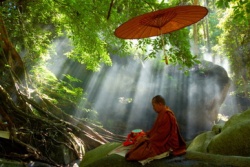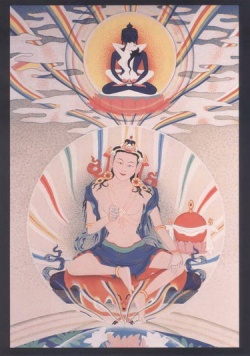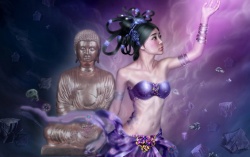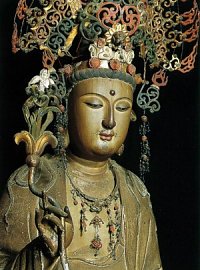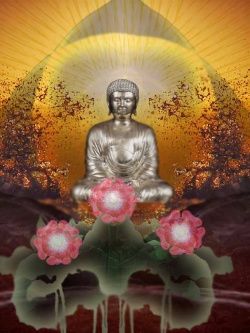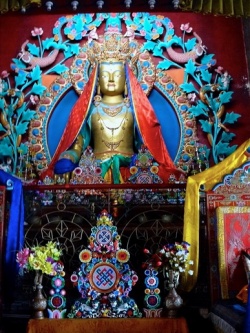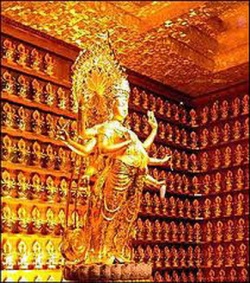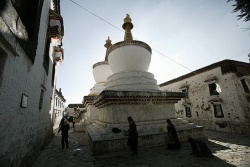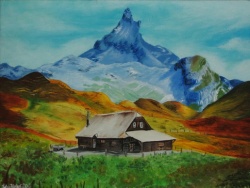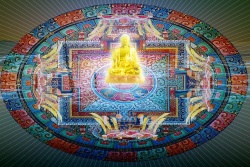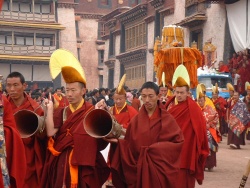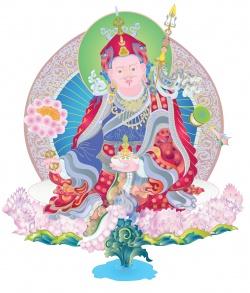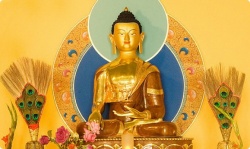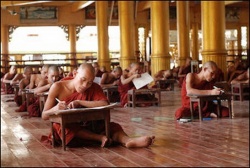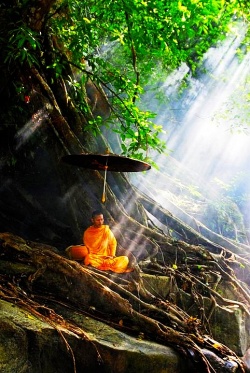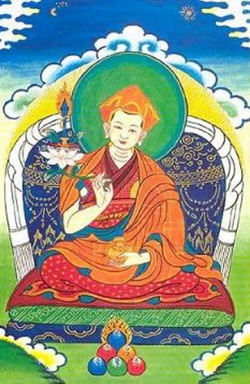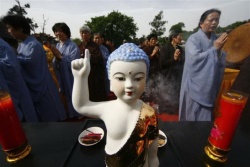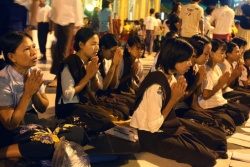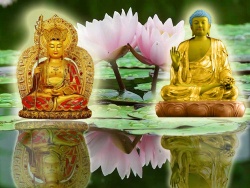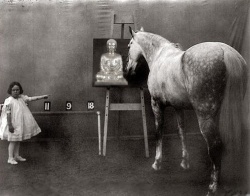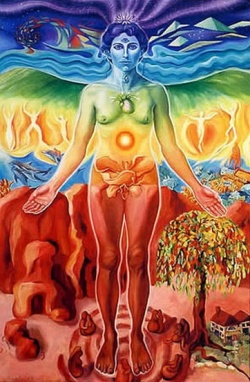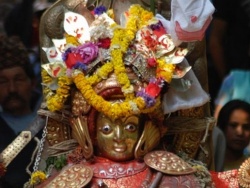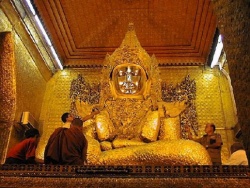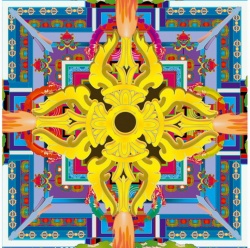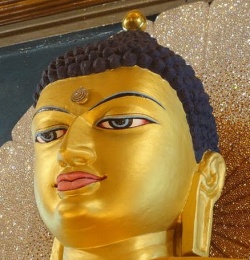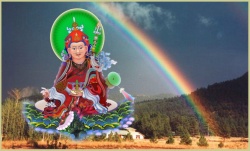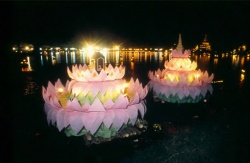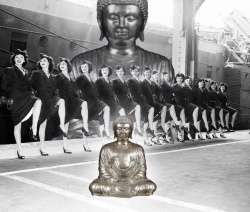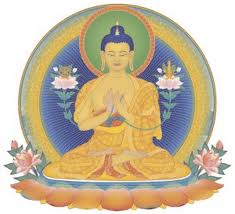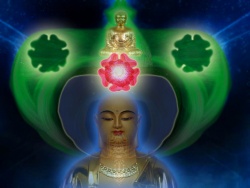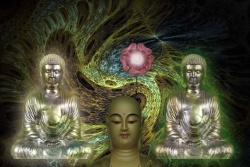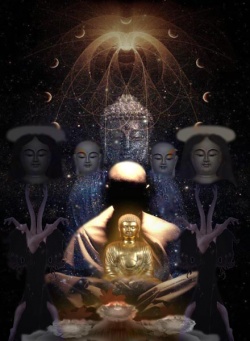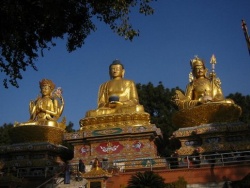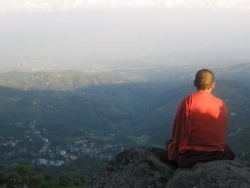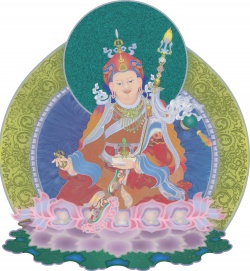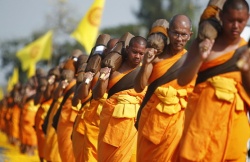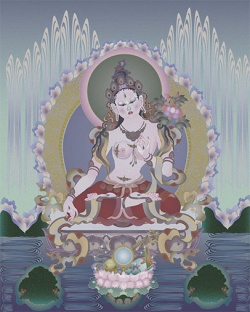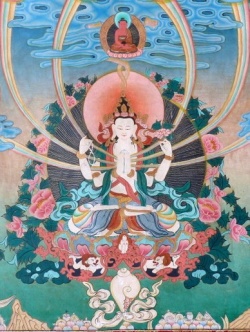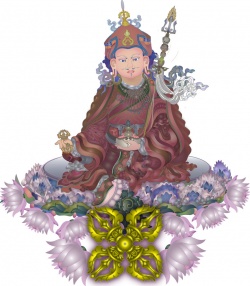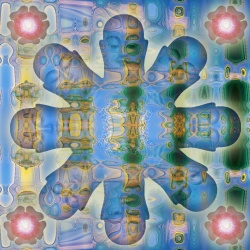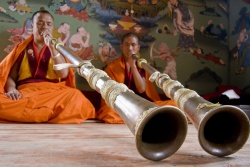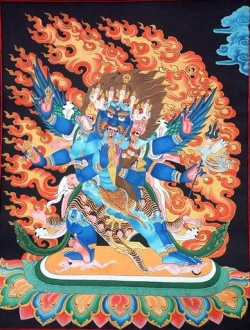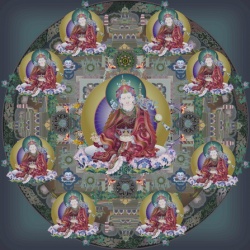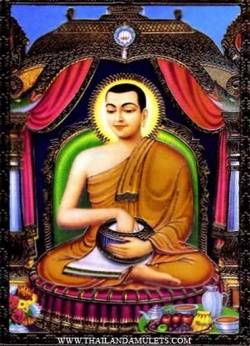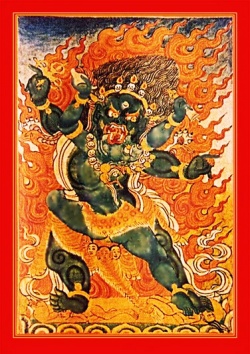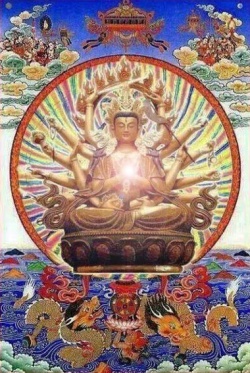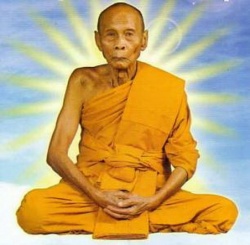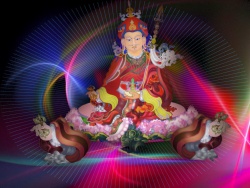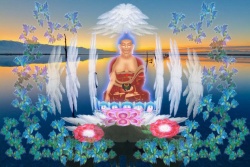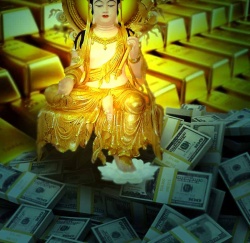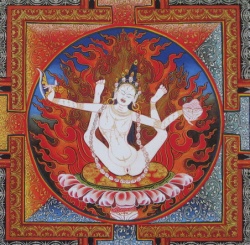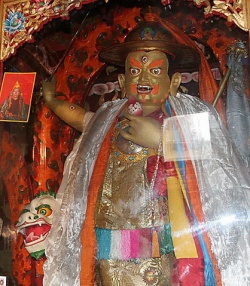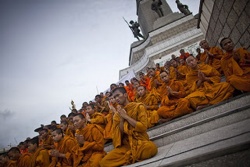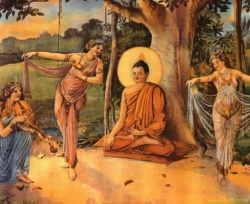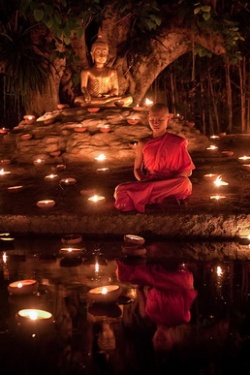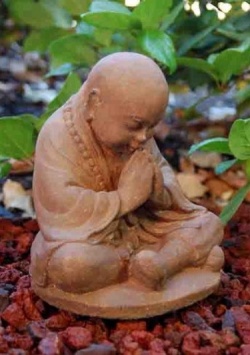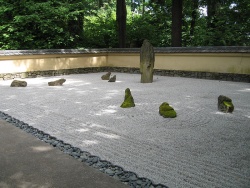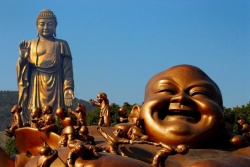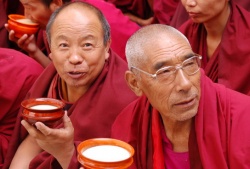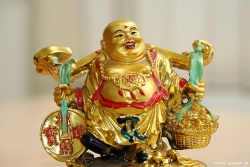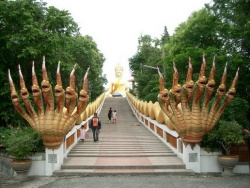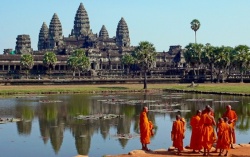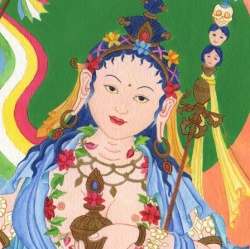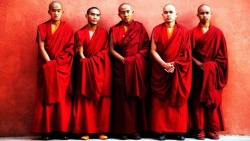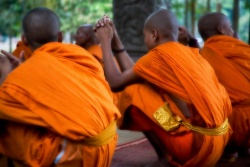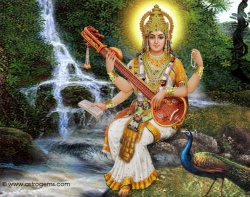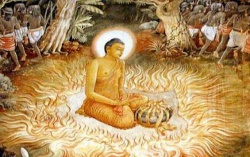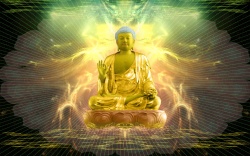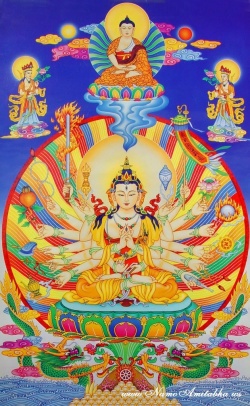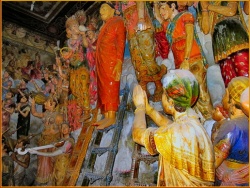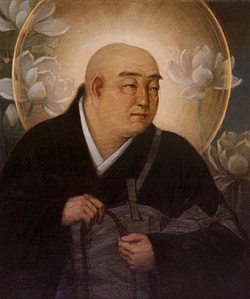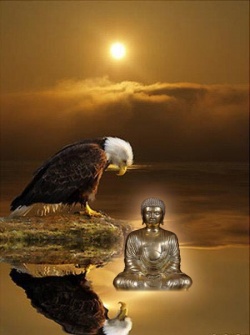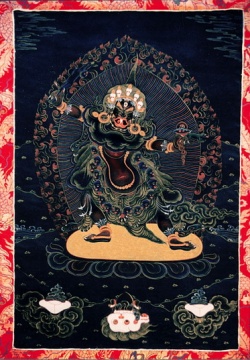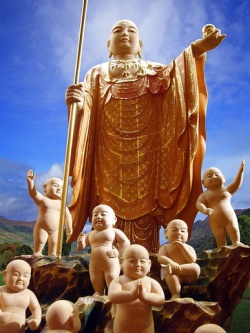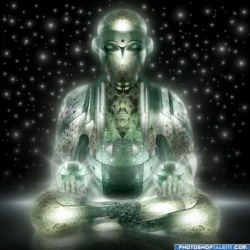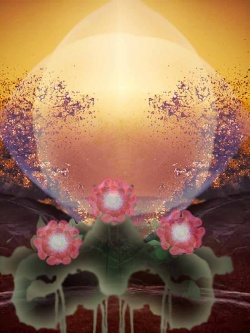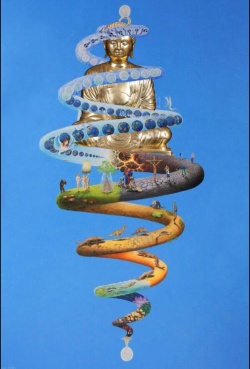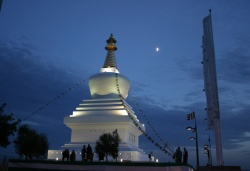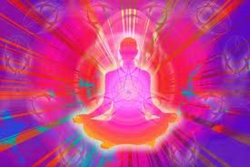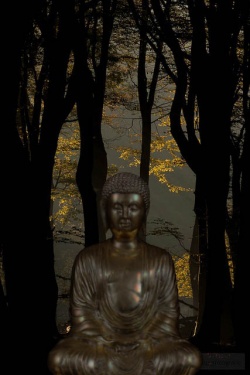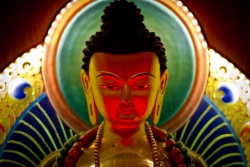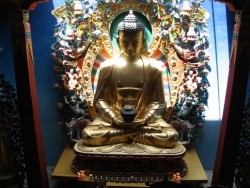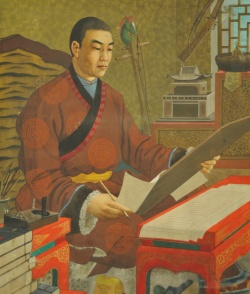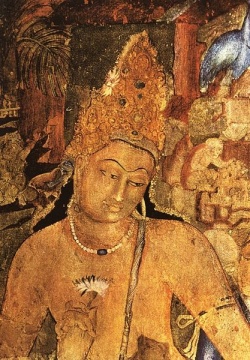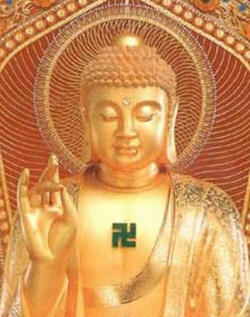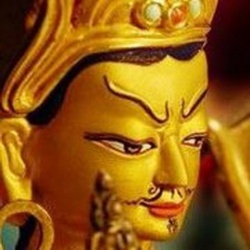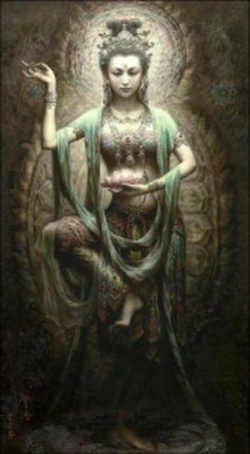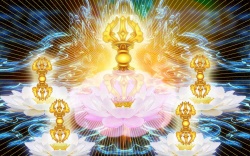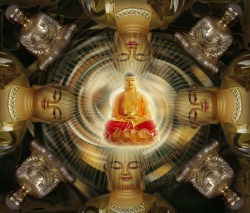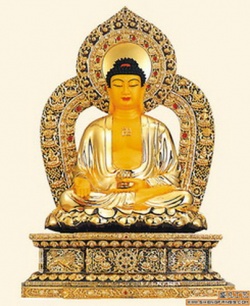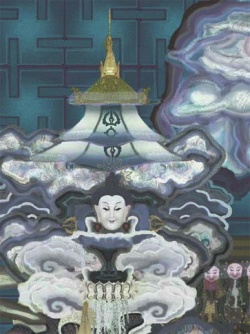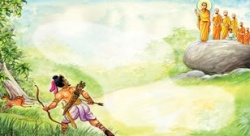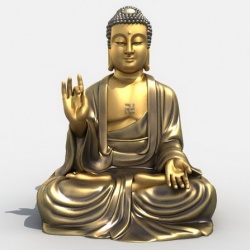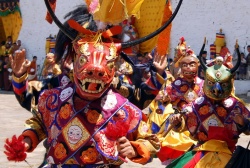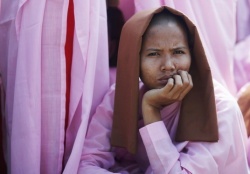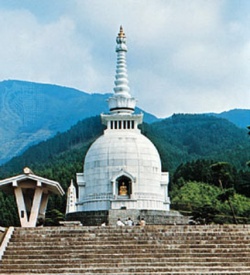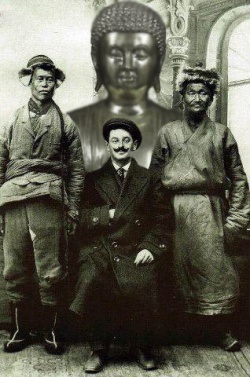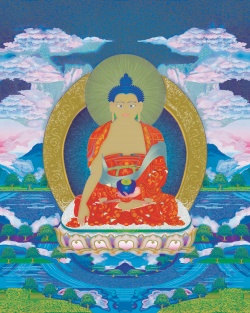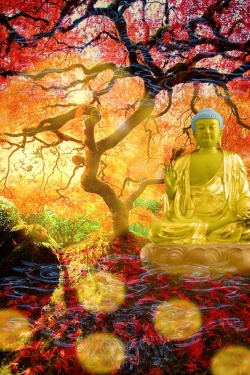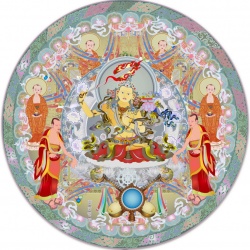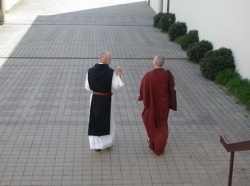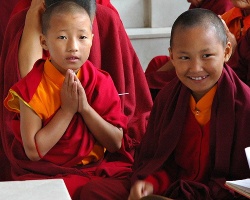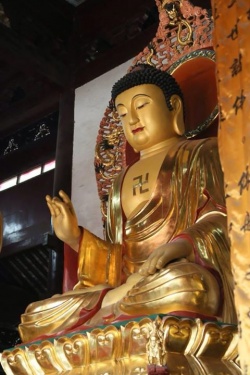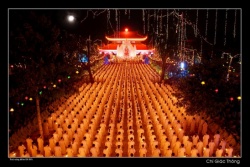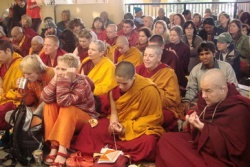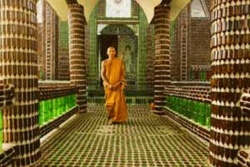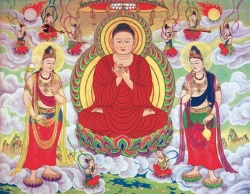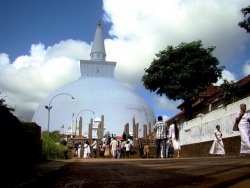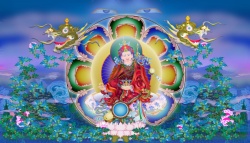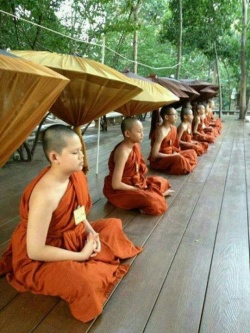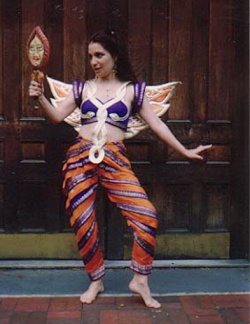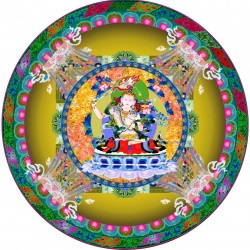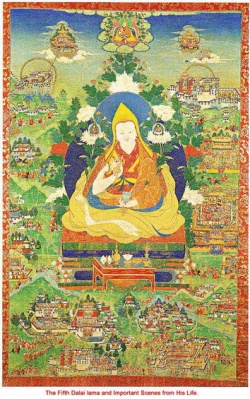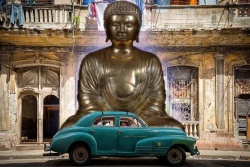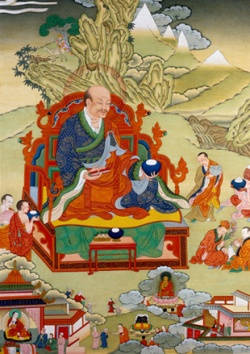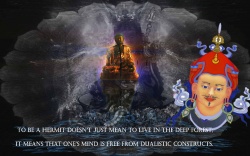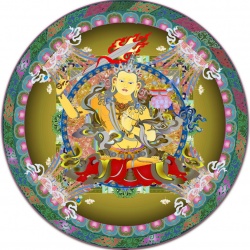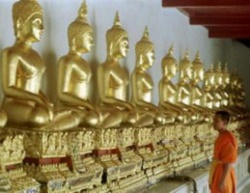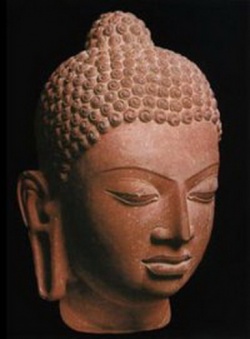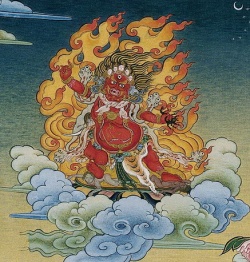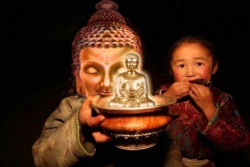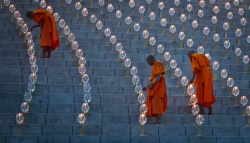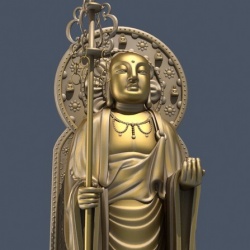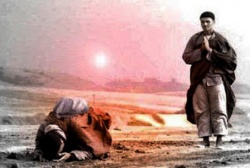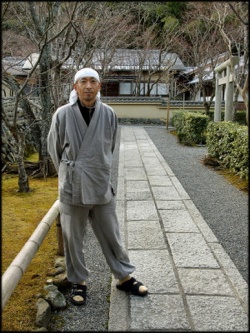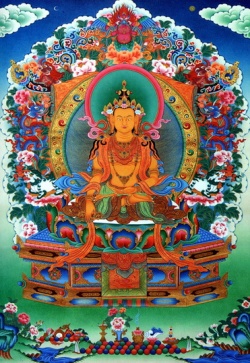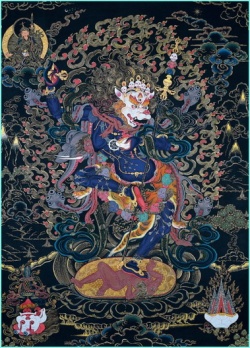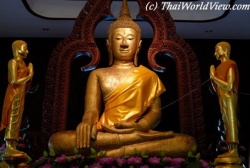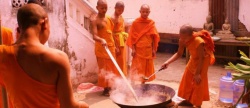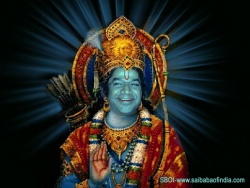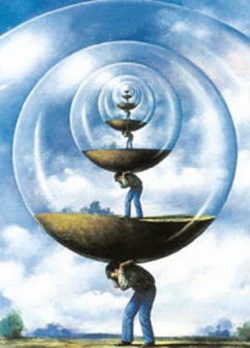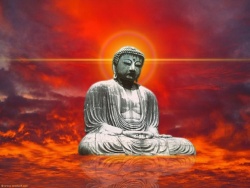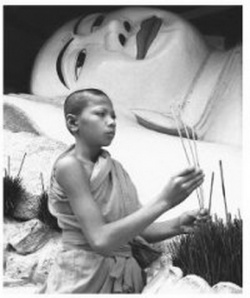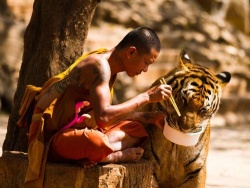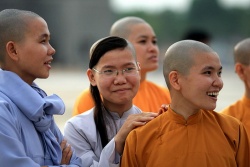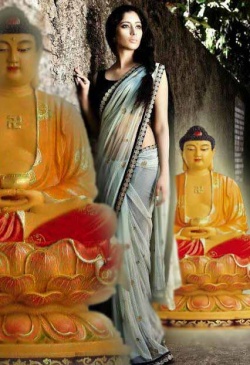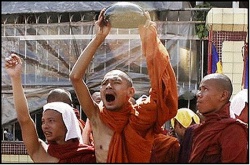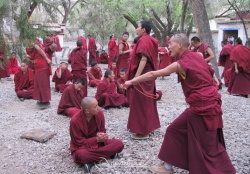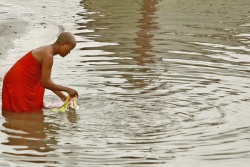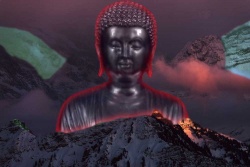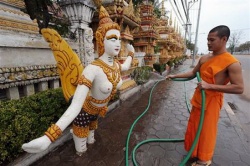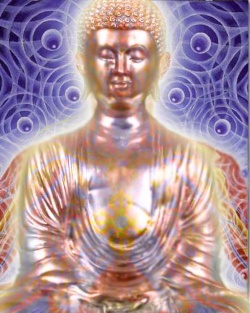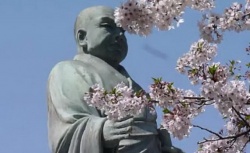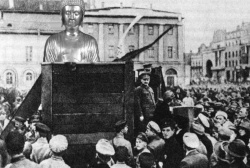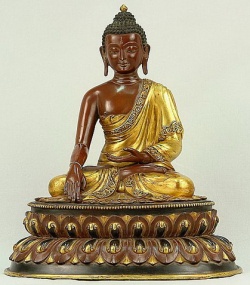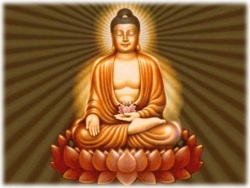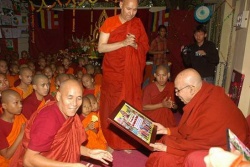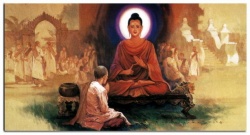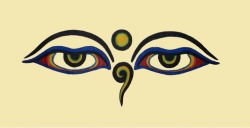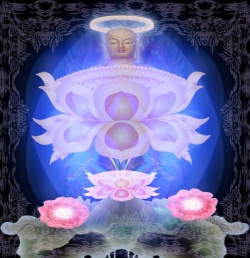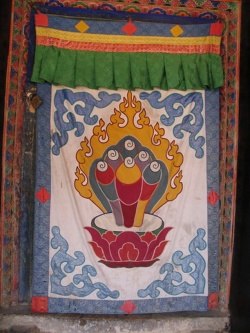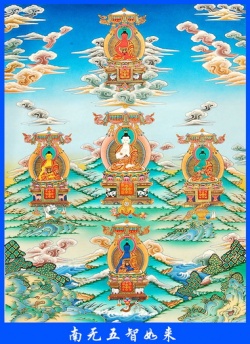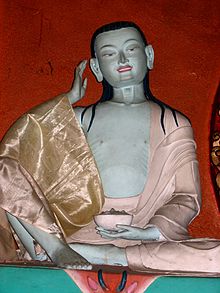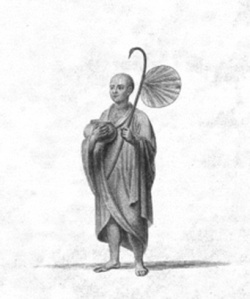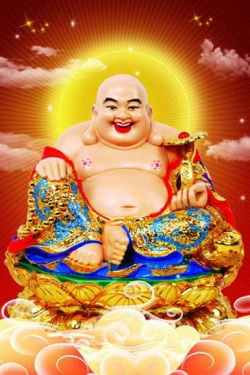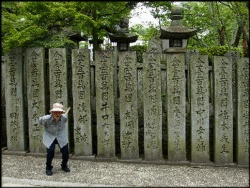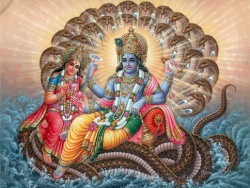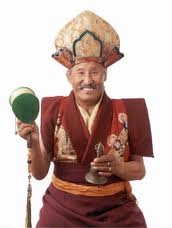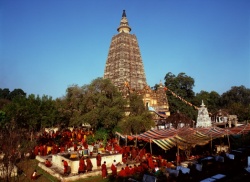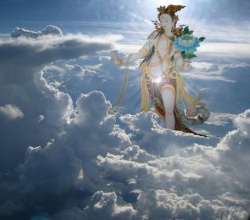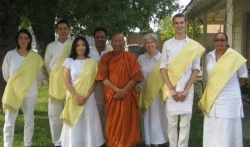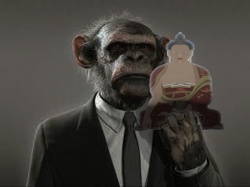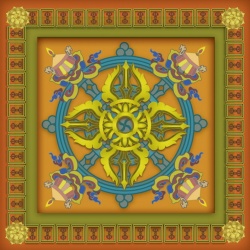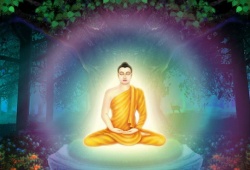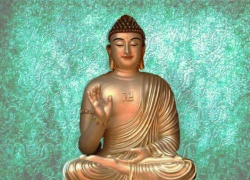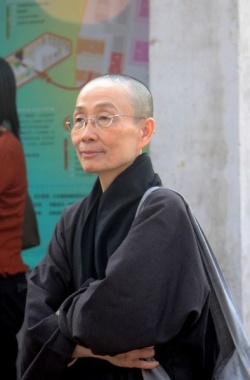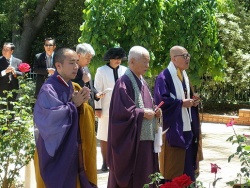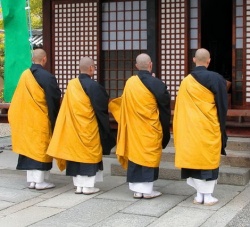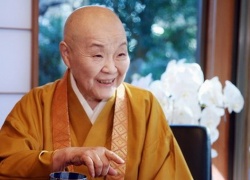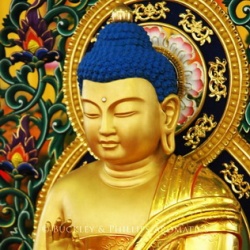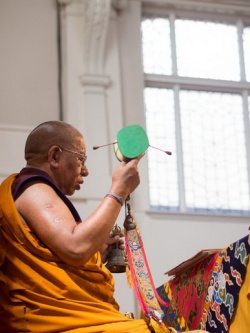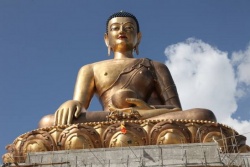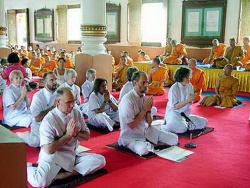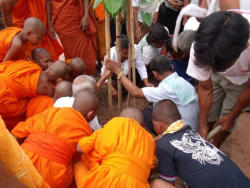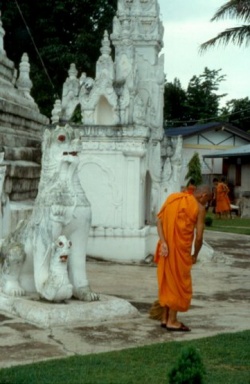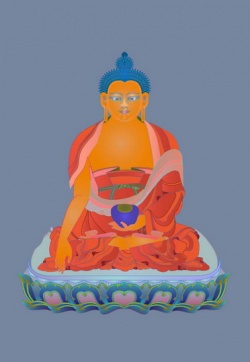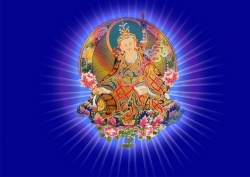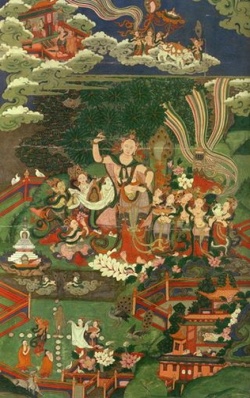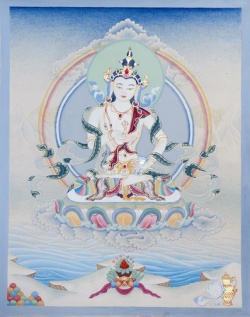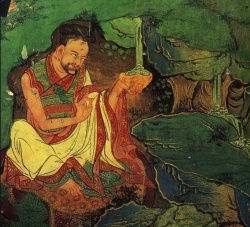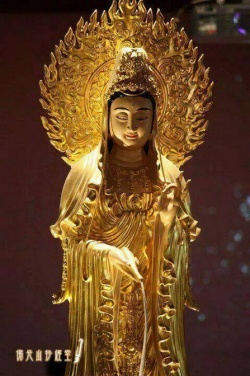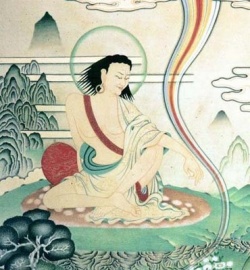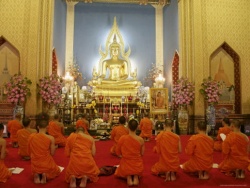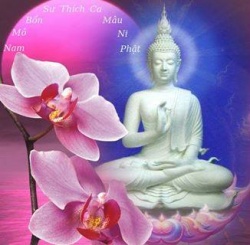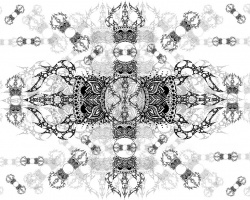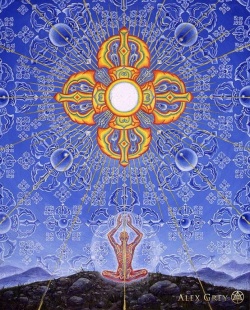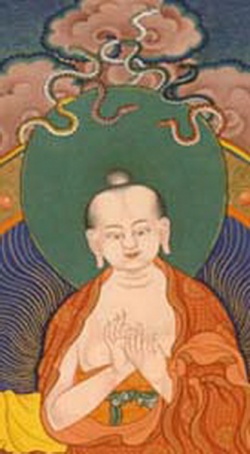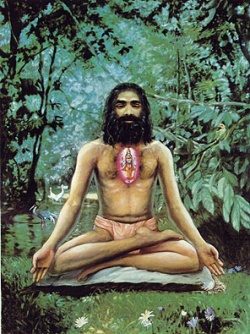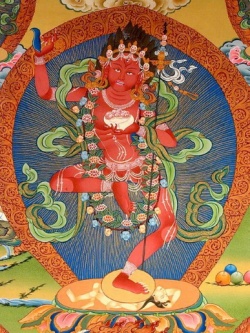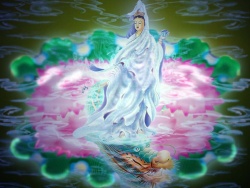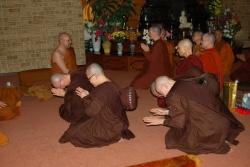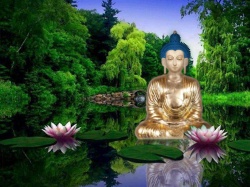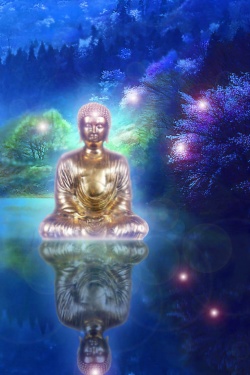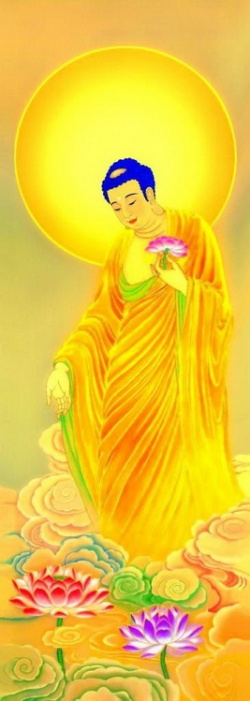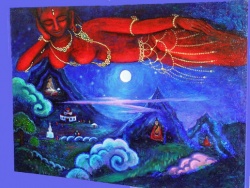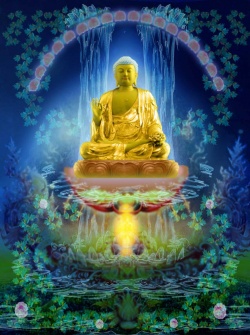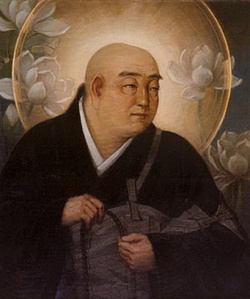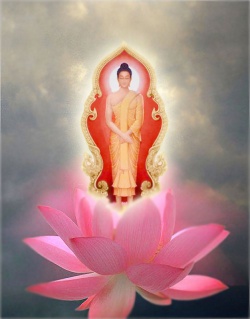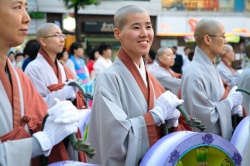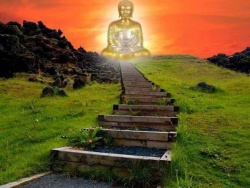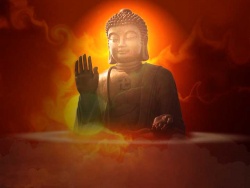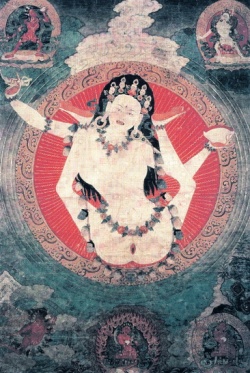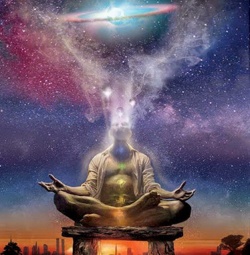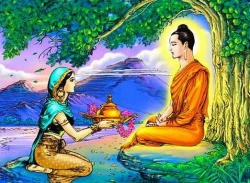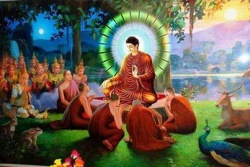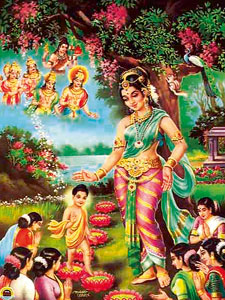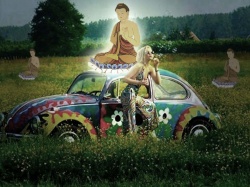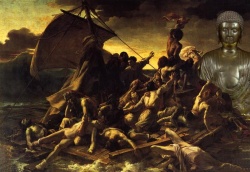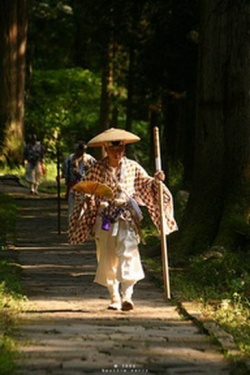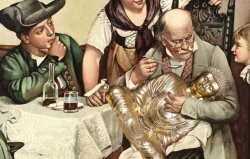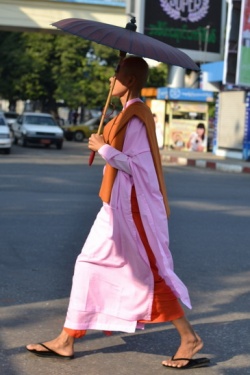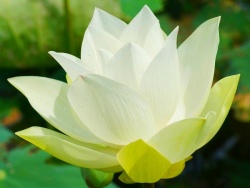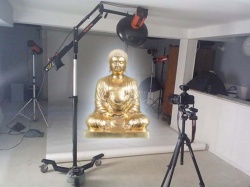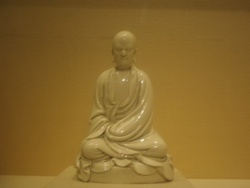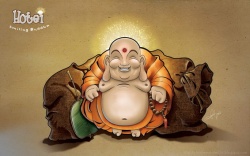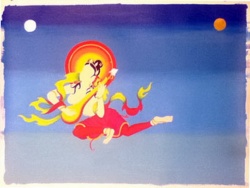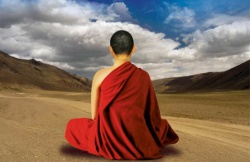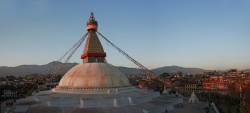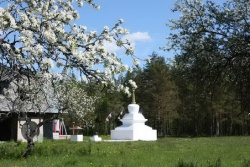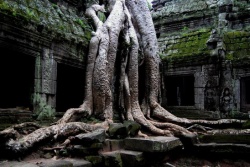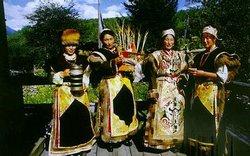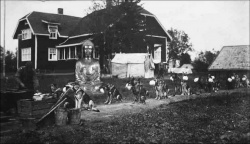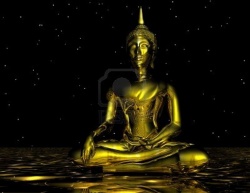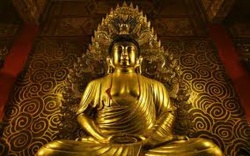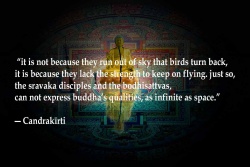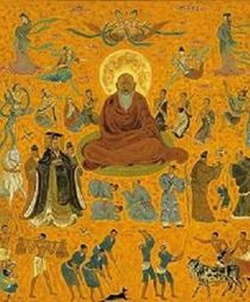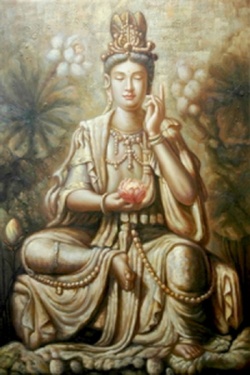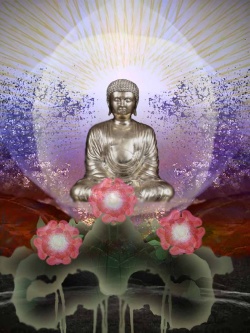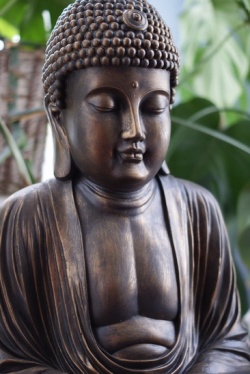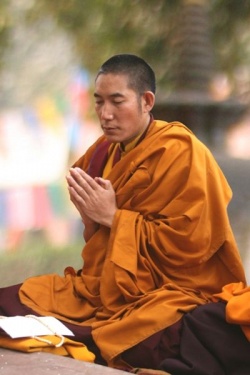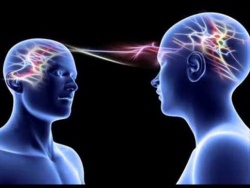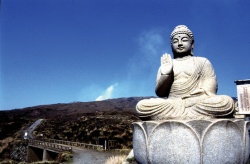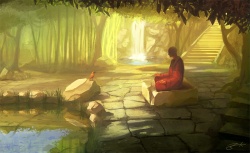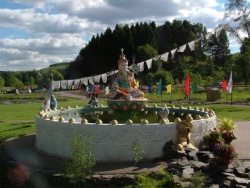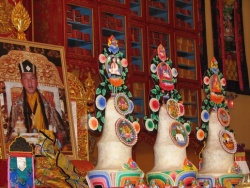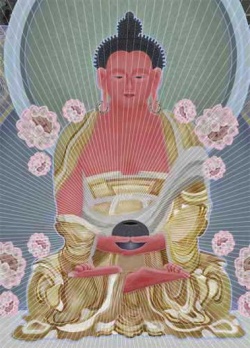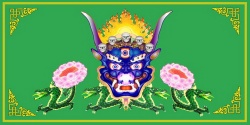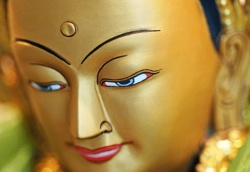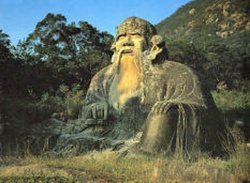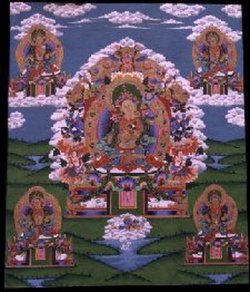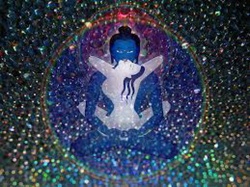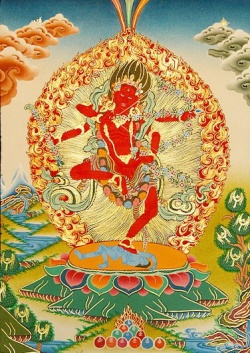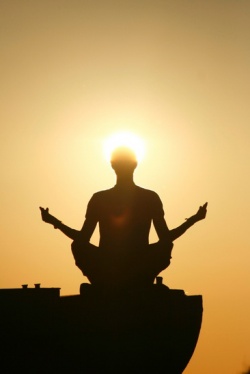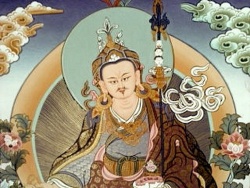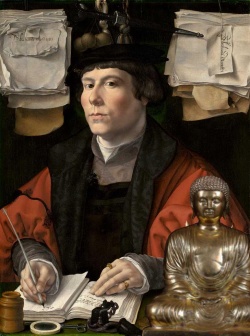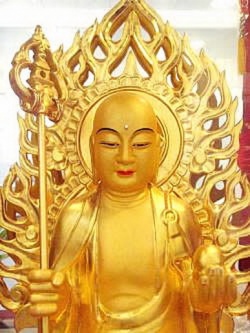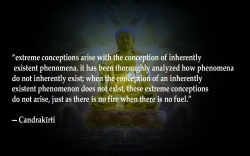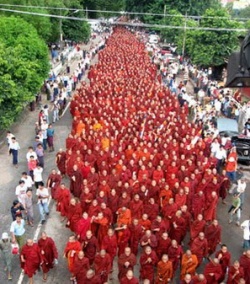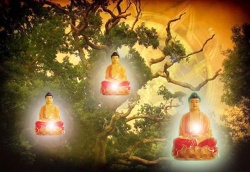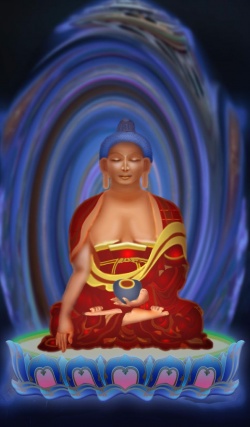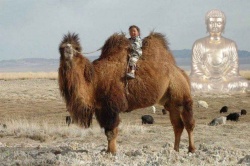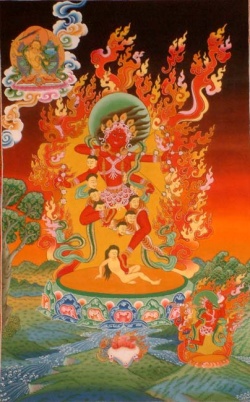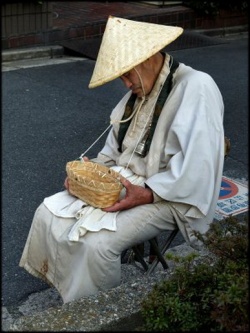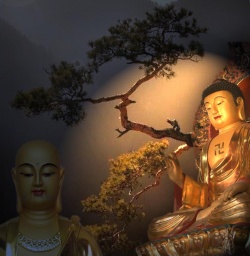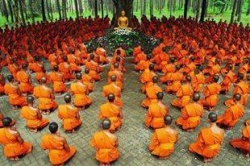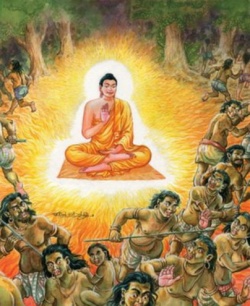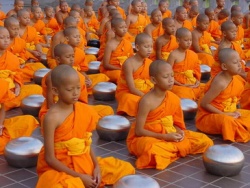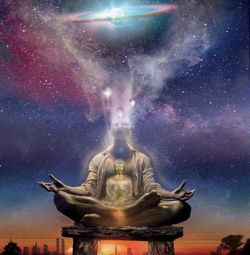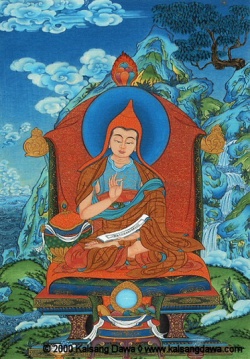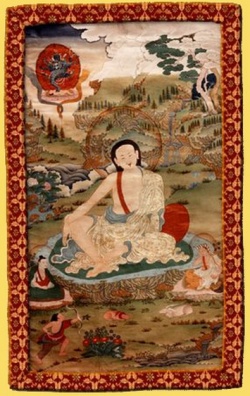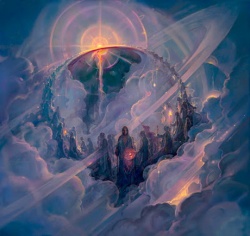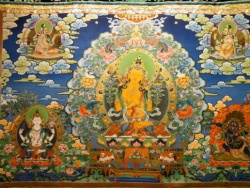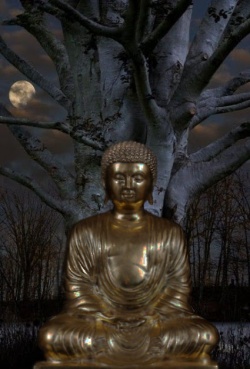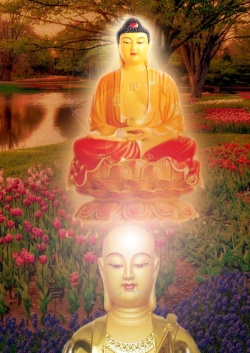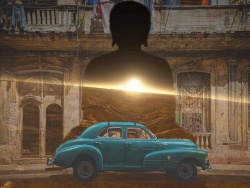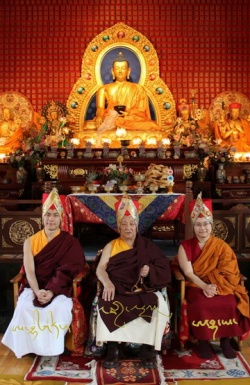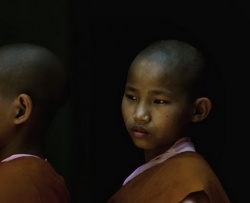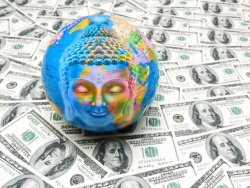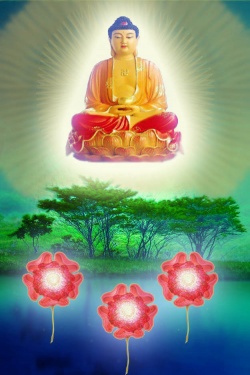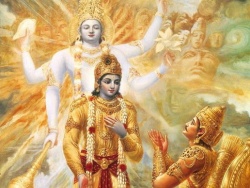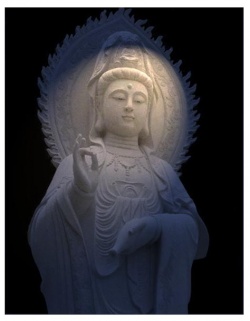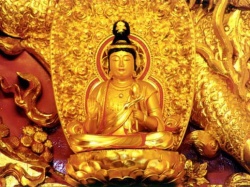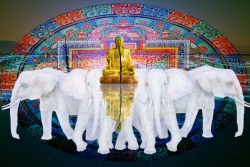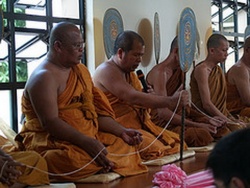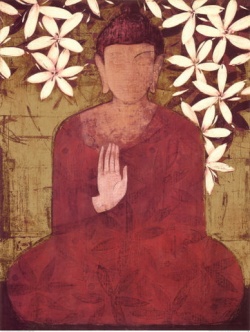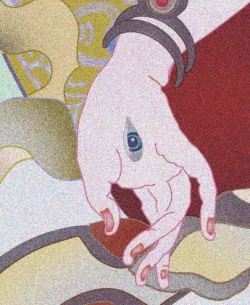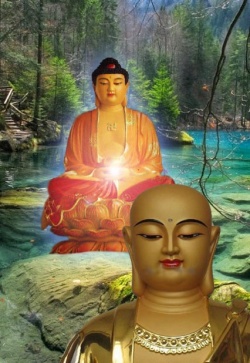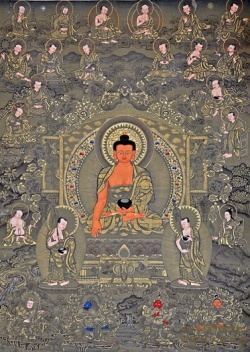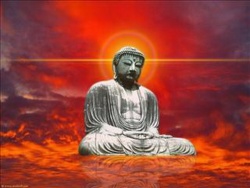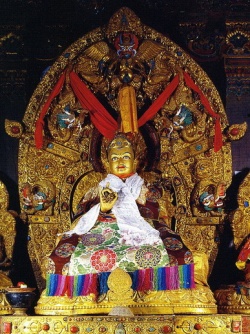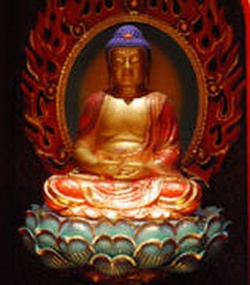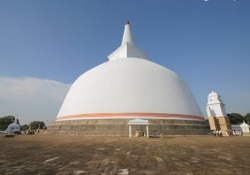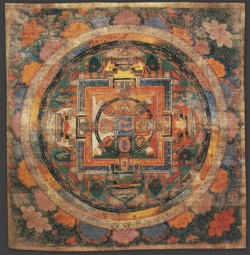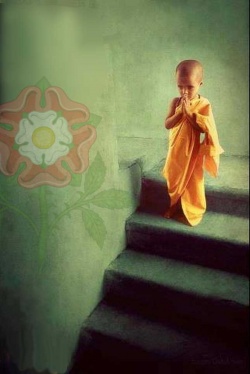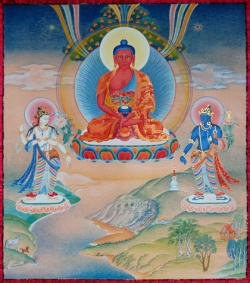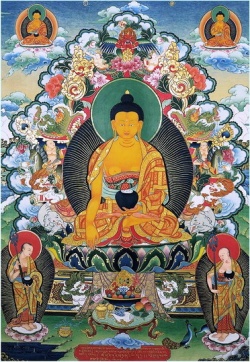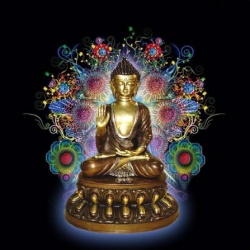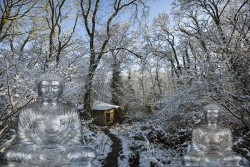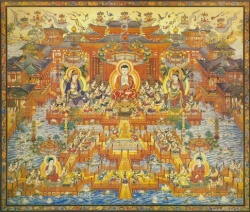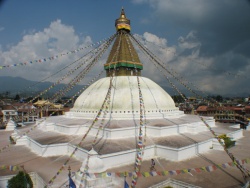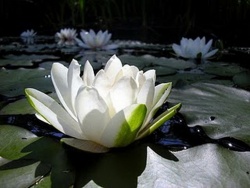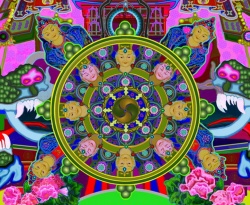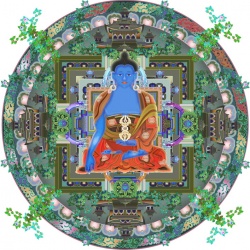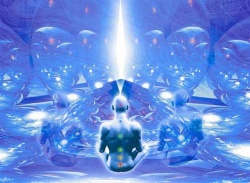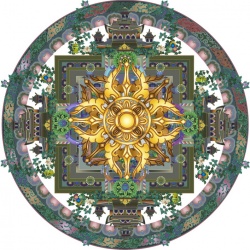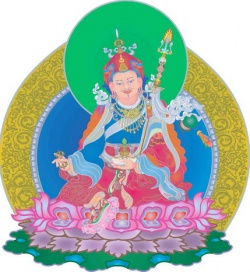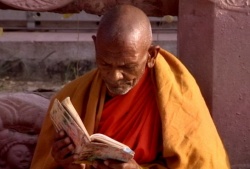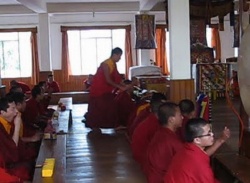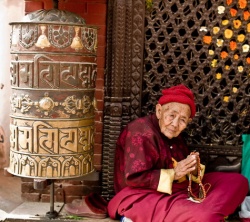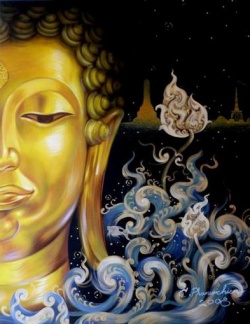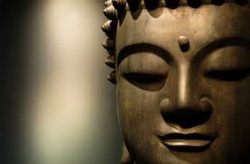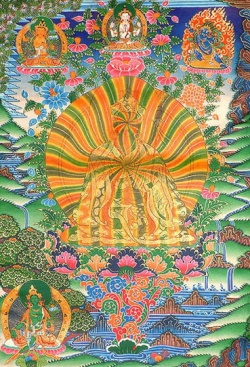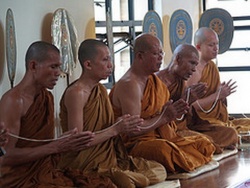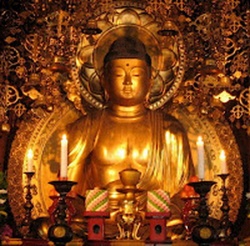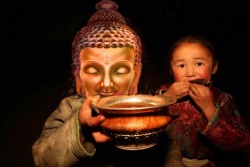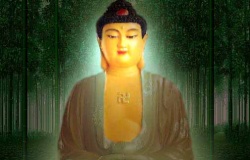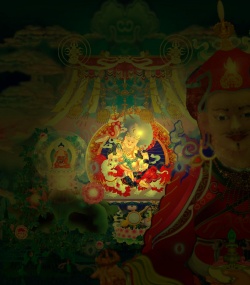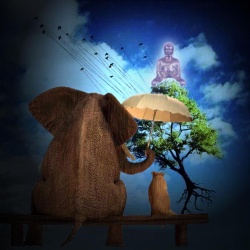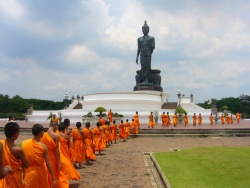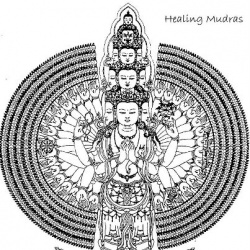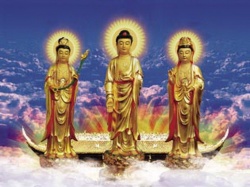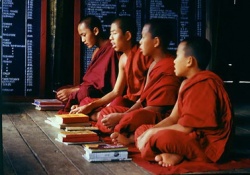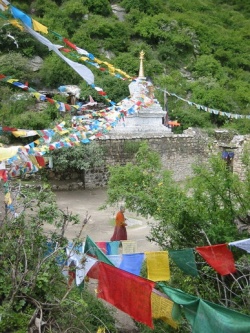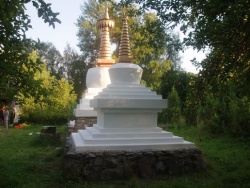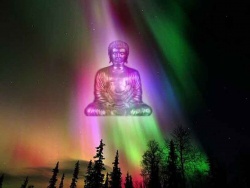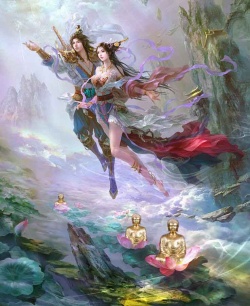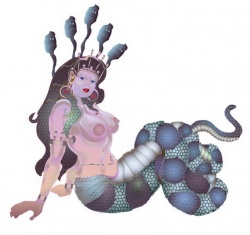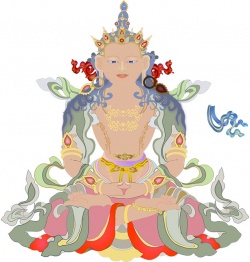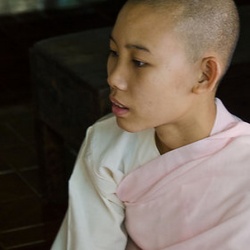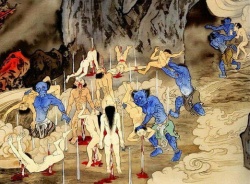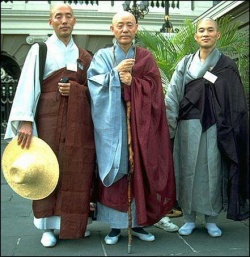Maha Prajnaparamita Sastra Full By Nagarjuna
THE TREATISE ON THE GREAT VIRTUE OF WISDOM OF NAGARJUNA (MAHAPRAJNAPARAMITASASTRA) ETIENNE LAMOTTE
VOL. II CHAPTERS XVI-XXX
Composed by the Bodhisattva Nagarjuna and translated by the Tripitakadharmacarya Kumarajiva
Translated from the French By Gelongma Karma Migme Chodron
INTRODUCTION 490 SUPPLEMENT TO ABBREVIATIONS VOL.11 496 CHAPTER XVI: THE STORY OF SARIPUTRA 499 I. SARIPUTRA AT THE FESTIVAL OF GIRY AG RAM AS AJ A (p. 62 IF) 499 II. SARIPUTRA AND MAUDGALYAYANA AT SANJAYA (p. 623F) 500 III. CONVERSION OF SARIPUTRA AND MAUDGALYAYANA (630F) 505 IV. ORIGIN OF SARIPUTRA' S NAME (63 6F) 510 V. SARVAKARA (p. 640F) 513 VI. SARVADHARMA (p. 642F) 514 VII. WHY DOES SARIPUTRA QUESTION? (p. 646F) 517 CHAPTER XVII: THE VIRTUE OF GENEROSITY (p. 650F) 520 I. DEFINITIONS OF PRAJNAPARAMITA 520 II. THE METHOD OF NON-DWELLING (p. 656F) 525 CHAPTER XVIII: PRAISE OF THE VIRTUE OF GENEROSITY (p. 65HF) 526 CHAPTER XIX: THE CHARACTERISTICS OF GENEROSITY (p. 662F) 529 I. DEFINITION OF GENEROSITY 529 II. VARIOUS KINDS OF GENEROSITY 530 1. Gifts belonging to the three realms 530 2. Pure generosity and impure generosity 530 3. Other kinds of generosity 539 4. Inner generosity 548 CHAPTER XX: THE VIRTUE OF GENEROSITY AND GENEROSITY OF THE DHARMA (p. 692F) 552 I. GENEROSITY OF THE DHARMA 552 II. VIRTUE OF GENEROSITY 559 III. PERFECTION OF GENEROSITY 564 IV. NON-EXISTENCE OF THE THING GIVEN 574 NON-EXISTENCE OF THE OUTER OBJECT 575 1. Debate with the Realist 575 2. Debate with the Atomist 578 3. The object, subjective creation and emptiness 579 V. NON-EXISTENCE OF THE DONOR 581 NON-EXISTENCE OF THE ATMAN 582 1. The atman is not an object of consciousness 582 2. Debate with the Personalist 583 VI. GENEROSITY AND THE OTHER VIRTUES 593 1. Generosity and the virtue of generosity 593 2. Generosity and the virtue of morality 594 3. Generosity and the virtue of patience 596 4. Generosity and the virtue of exertion 596 5. Generosity and the virtue of meditation 601 6. Generosity and the virtue of wisdom 604 CHAPTER XXI: DISCIPLINE OR MORALITY (p. 770F) 607 I. DEFINITION OF DISCIPLINE 607 II. VARIOUS KINDS OF MORALITY 608 III. BENEFITS OF MORALITY 608 IV. DISADVANTAGES OF IMMORALITY 613 CHAPTER XXII: THE NATURE OF MORALITY(p. 782F) 615 FIRST PART: GENERAL MORALITY 616 I. Abstaining from murder 616 II. Abstaining from theft 624 III. Abstention from illicit love 627 IV. Abstention from falsehood 631 V. Abstention from liquor 640 SECOND PART: THE MORALITY OF PLEDGE (SAMADANASILA) 643
I. Morality of the lay person or avadatavasana 643 II. Morality of the monastic or pravrajita 658 CHAPTER XXIII: THE VIRTUE OF MORALITY (p. 853F) 668 CHAPTER XXIV: THE VIRTUE OF PATIENCE (p. 865F) 676 I. DEFINITION AND DIVISION OF PATIENCE 676 II. PATIENCE TOWARD BEINGS 677 1. Indifference toward sycophants 677 2. Indifference toward benefactors 686 3. Indifference toward women 687 4. Withstanding persecutors 694 CHAPTER XXV: PATIENCE TOWARD THE DHARMA (p. 902F) 703 I. GENERAL DEFINITION 703 II. ENDURING OUTER AND INNER SUFFERINGS AND THE AFFLICTIONS 704 [A. Enduring outer sufferings). - 704 [B. Enduring inner sufferings.] - 705 III. PATIENCE IN REGARD TO THE BUDDHADHARMA 710 CHAPTER XXVI: EXERTION (p. 927F) 721 I. EXERTION, FOURTH VIRTUE 721 II. THE BENEFITS OF EXERTION 725 III. PROGRESS IN EXERTION 727 CHAPTER XXVII: THE VIRTUE OF EXERTION (p. 946F) 736 I. THE NATURE OF EXERTION 736 II. THE VIRTUE OF EXERTION 737 III. EXERTION AND THE OTHER VIRTUES 750 IV. BODILY AND MENTAL EXERTION 751 CHAPTER XXVIII: THE VIRTUE OF MEDITATION (DHYANA) (p. 984F) 762 I. NECESSITY FOR MEDITATION 762 II. MEANS OF ACQUIRING MEDITATION 765 A. First Method: Eliminating the sensual desires 765 B. Second method: removing the obstacles 782 C. Third method: Practicing the five dharmas 791 III. DEFINITION OF THE VARIOUS DHYANAS AND SAVlAPATTIS 793 IV. QUESTIONS RELATING TO THE DHYANAS 802 V. DHYANAPARAMITA 809 CHAPTER XXIX: THE VIRTUE OF WISDOM (p. 1058F) 819 CHAPTER XXX: THE CHARACTERISTICS OF PRAJNA (p. 1066F) 827 I. 'GREAT' PRAJNA 827 II. PRAJNA AND THE PRAJNAS 827 1. Prajna of the sravakas 827 2. Prajna of the pratyekabuddhas 829 3. Prajna of the Buddhas and bodhisattvas 830 4. Prajnaof the_ heretics 830 III. THE PRAJNA AND THE TEACHING OF THE DHARMA 833 1. The teaching of the Pitaka 833 2. The Teaching of the Abhidharma 835 3. The teaching of emptiness 836 IV. UNDERSTANDING IDENTICAL AND MULTIPLE NATURES 848 1. Identical characteristics in every dharma 848 2. Multiple natures 852 3. Characteristics and emptiness of self nature 854 V. WAYS OF ACQUIRING PRAJNAPMARAMITA 856 1. By the successive practice of the five virtues 856 2. By practicing just one virtue 857 3. By abstaining from any practice 859
INTRODUCTION In Volume II, the reader will find an attempted translation of chapters XVI to XXX of the MahaprajnaparamitasaOtra. These fifteen chapters, which make up a consistent whole, comment at great length on a short paragraph of the Prajndpdramitadsutra (Pancavimsati, p. 17-18; Satasahasrika, p. 55-56), of which the following is a translation: "Then the Blessed One addressed the venerable Sariputra: 'O Sariputra, the Bodhisattva-mahasattva who wishes to know all dharmas in all their aspects completely should exert himself in the Prajnaparamita.' Then the venerable Sariputra asked the Blessed One: 'O Blessed One, how should the Bodhisattva- mahasattva who wishes to know all dharmas in all their aspects exert himself in the Prajnaparamita?' At these words, the Blessed One said to the venerable Sariputra:
'The Bodhisattva-mahasattva who abides in the Prajnaparamita by the method of non-abiding should fulfill the virtue of generosity by the method of refraining, by abstaining from distinguishing the thing given, the donor and the recipient; he should fulfill the virtue of morality by being based on the non-existence of evil deeds and their contrary; he should fulfill the virtue of patience by being based on non-agitation [of the mind); he should fulfill the virtue of exertion by being based on the non-slackening of physical and mental energy; he should fulfill the virtue of rapture by being based on the non-existence of distraction and rapture; he should fulfill the virtue of wisdom by being based on the non-existence of good and bad knowledges (variant: by not adhering to any system)."
1 The main interlocutors of the Buddha in the Prajnaparamitasutra are Sariputra and Subhuti; chapter XVI of the Treatise is dedicated to their story: it contains a detailed biography of Sariputra and a short note on Subhuti (p. 634F). But it may seem strange that the Prajnaparamitasutra, which belongs to the literature of the Greater Vehicle, should be preached, not by the bodhisattvas affiliated with the Mahayana, but by sravakas, adepts of the Lesser Vehicle.
The reason for this is simple, as the Treatise explains (p. 636F): the bodhisattvas, called upon to dwell among beings whose conversion is their mission, have not entirely eliminated their passions and do not enjoy indisputable authority among men;
if they were responsible for teaching the Prajna, their word could be open to doubt. On the contrary, sravakas like Sariputra and Subhuti who have attained arhathood and destroyed every impurity (ksindsrava) are assured of an unequalled prestige and their testimony cannot be disputed: therefore it is to them that the Buddha entrusted the task of
1 Tatra khalu Bhagavdn dyusmantam Sariputram dmantrayam dsa: Sarvdkdram Sariputra sarvddharmdn i i i ii null E\ am ukta dyusmdn Sdriputro Bhagavantam etad avocat: i avail hodiiisatn \ i arvadhaniiaii abhisamboddluil ' ' van ayusi anputram etad avocat: Iha Sdripuitra bodhisattvena mahdsattvena prajndparainitayani stliitvastlianayogena ddnapdramitd parpurayitawap i ' i dhitdm updddya, silapdramitd paripurayituwa, i > inatdm updddya, \ it/ / natdm updddya, dhydnaparainita i i mirainita paripurayitarya prajuadauspi hit mi (\ in ml: sarvadharmdnahliiiiivesam) upadaya.
preaching the Prajna. Among all the sravakas, the Buddhas chose Sariputra and Subhuti who excelled over all the others, the first by the extent of his wisdom, the second by his acute vision of universal emptiness.
The religious ideal of the sravaka is the destruction of the passions, the arrival at arhathood and the attainment of nirvana; to this end, he practices the Noble Path in its threefold aspect: morality (Ma) which keeps him from any wrong-doing, concentration (samadhi) which purifies his mind, wisdom (prajna) by means of which he understands the general characteristics (sdmdnyalaksana) of dharmas, impermanence, suffering, emptiness and lack of self.
The practice of the virtues occupies only a subsidiary place in the career of the sravaka; his excellent qualities are, however, contaminated at the base by the essentially individualistic and egocentric character of his effort.
The religious ideal of the bodhisattva is quite different: renouncing entry into nirvana for the moment, he seeks to obtain the supreme and perfect enlightenment (anuttarasamyaksambodhi) which characterizes the Buddhas, to conquer the knowledge of all things in all their aspects (sarvadharmdndm sarvdkdrajndnam), knowledge that permits him to dedicate himself entirely to the benefit and welfare of all creatures.
In order to attain this omniscience, the bodhisattva must exert himself throughout his career in the six perfect virtues (pdramitd) which liken him to the Buddha. Among the heretics and sravakas, the practice of the natural virtues is marred by errors and egotism; among the bodhisattvas, on the other hand, the practice of the virtues attains perfection because it is disinterested and based on Prajnaparamita. Chapter XVII explains what this Prajnaparamita means and how to use it.
The Prajnaparamita is not an entity of metaphysical order, an absolute existent to which one could become attached; rather, it is a state of mind, a mental turning of mind which assures a radical neutrality to the person who adopts it. Transcending the categories of existence and non-existence, lacking any characteristic, the Prajnaparamita can be neither affirmed nor denied: it is faultless excellence.
bodhisattva adheres to it by not grasping it or, to use the time-honored expression, "he adheres to it by not adhering to it" (tistaty asthauayogeiia ). Confident in this point of view which is equally distant from affirmation and negation, he suspends judgment on everything and says nothing whatsoever.
Practiced in this spirit, the virtues which, among the religious heretics and sravakas, are of ordinary and mundane (laukika) order, become supramundane perfections (lokottaraparamita) in the bodhisattva.
Besides, since the bodhisattva refuses to conceive of the said virtues and to establish distinctions amongst them, to practice one paramita is to practice them all; not to practice them is also to practice them.
However, as the bodhisattva resides of choice in the world where he daily rubs shoulders with beings intoxicated by the three poisons of passion, hatred and ignorance, it is important to explain to people what distinguishes the paramitas from the profane virtues.
This is the subject of chapters XVIII to XXX. Chapter XVIII-XX. - Generosity (dana), for which great rewards are promised, consists of giving, in a spirit of faith, a material object or a spiritual advice to 'a field of merit', i.e., to a beneficiary worthy of receiving it.
The paramita of generosity makes no distinction between donor, recipient and gift because, from the point of view of the Prajna, there is no person to give or to receive, there is nothing that is given. To understand that is "to give everything at all times and in every way."
Chapters XXI-XXIII. - Morality (sila) makes one avoid the wrong-doings of body and speech that are capable of harming others.
Apart from the general morality making up the rules of innate honesty essential to everyone, it is appropriate to distinguish the morality of commitment by means of which lay people and monastics of all classes solemnly undertake to follow a certain number of rules proper to their condition.
The paramita of morality singularly surpasses this restricted framework: is it based on the non-existence of wrong-doing and its opposite.
The sinner not existing, the sin does not exist either; in the absence of all sins, the prohibitions forbidding it have no meaning. The sinner does not incur our contempt; the saint has no right to our esteem. Chapters XXIV-XXV. - Although early Buddhism condemned anger, it did not attach great importance to patience (ksdnti). On the other hand, the bodhisattva raises it to the rank of paramita.
Nothing moves him, neither people nor things: he keeps a cool indifference towards the people who flatter him, the benefactors who cover him with their gifts, the women who seek to seduce him, the enemies who persecute him. He endures with equal facility the external sufferings caused by cold or heat, wind or rain, and the internal sufferings coming from old age, sickness and death.
It is the same insofar as his own passions are concerned: although he does not give himself up to them unreservedly, he avoids cutting them so as not to be hemmed in like an arhat in an egotistic complete quietude; whatever the case, his mind stays open to movements of great pity and great compassion.
But it is by means of dharmaksdnti that he attains the pinnacle of patience: he tirelessly investigates the Buddhadharma which teaches him not to adopt any definite philosophical position, which shows him universal emptiness but forbids him to conceptualize it. Chapter XXVI-XXVII. -
Throughout the entire Buddhist Path, the adept of the Lesser Vehicle displays a growing exertion (yiryci) in order to ensure himself the conquest of the 'good dharmas' or, if you wish, spiritual benefits.
But the bodhisattva is much less preoccupied with the paths of salvation; in his paramita of exertion, he ceaselessly travels the world of transmigration in order to bring help to beings plunged in the unfortunate destinies. As long as he has not assured the safety of an infinite number of unfortunate beings, he will never relax his bodily and mental exertion. Chapter XXVIII. -
For the purification of the mind, the sravaka had built up a discipline of rapture (dhydna), a grandiose but complicated monument of religious psychology in which India excelled.
The de-intoxication]] of the mind is a long-winded job: the candidate for sainthood must resolutely turn away from the five sense pleasures and triumph over the five faults which constitute an obstacle to concentrating the mind by means of an appropriate method.
Then he must ascend one after the other the nine successive absorptions (navdnupurvasamdpatti) which lead to the destruction of consciousness and sensation (samjndvedayltLinirodhii), a state which constitutes nirvana on earth.
In addition, a large number of secondary absorptions become grafted onto these main concentrations.
In the paramita of dhyana, the bodhisattva manifests a virtuosity much superior to that of the sravaka; he enters at will and whenever he wishes into the concentration of his choice, but his complete disinterestedness prevents him from enjoying its flavor.
The principal aim of his mental form of asceticism is to introduce ignorant and unfortunate beings to the purity of mystical states. Personally, he is disinterested because, from the point of view of the Prajna, distraction and concentration of the mind are equal; the sole motive that guides him is his great pity and great compassion for beings.
Chapter XXIX-XXX. - Religious heretics, sravakas and pratyekabuddhas all boast of possessing wisdom and they actually hold bits and pieces of it, but their wisdoms contradict one another and their partisans accuse one another of madness. If the wisdom of the sravakas and the pratyekabuddhas has an advantage over that of the heretics - the advantage of being free of false views - nevertheless it has the error of defining the general characteristics of dharmas and thus laying itself open to debate and criticism.
In his Prajnaparamita, the bodhisattva knows these wisdoms fully but adopts none of them; his own wisdom is the knowledge of the true nature of dharmas which is indestructible, unchangeable and uncreated. Seen from this angle, the dharmas are revealed as unborn (anutpanna), unceasing (aniruddha), like nirvana; or more precisely, they do not appear at all. Not seeing any dharma, the bodhisattva thinks nothing of them and says nothing of them.
Not recognizing any evidence, not adopting any system, he makes no distinction between truth and falsehood; he does not debate with anyone. The Buddha's teaching presents no obstacle, no difficulty, to the bodhisattva. And yet, what forms this teaching has taken over the course of time!
The Abhidharma sets out to define the dharmas and to specify their characteristics; the teaching on emptiness insists on the inconsistency of the atman and dharmas; the Pitaka defends a point of view sometimes realistic and sometimes nihilistic. Pursued into successive retrenchments, the sravaka no longer knows what to believe and goes from one contradiction to another.
Penetrating deeply into the threefold teaching of the Pitaka, the Abhidharma and emptiness, the bodhisattva, free of opinions (abhinivesa), knows that the Buddha's word never contradicts itself. Cognizing the identical and multiple characteristics of all dharmas, he confronts them with the emptiness of their self nature, but this very emptiness he refuses to consider. In order to acquire this Prajnaparamita, the bodhisattva is not bound to any practice.
The noble practice consists of practicing all the paramitas together or separately, provided that this is done with a detached mind; better yet, the noble practice is the absence of any practice, for to acquire the Prajnaparamita is to acquire nothing.
This brief summary far from exhausts the doctrinal and religious wealth contained in this second volume, but that would go beyond the framework of this introduction which merely summarizes it. It is sufficient to draw the reader's attention to several particularly interesting passages: the attempts to define the Prajnaparamita (p. 650-656F), a well-conducted refutation of the realist doctrine (p. 724-733F) and of the personalist doctrine (p. 734-750F), a comparison of the different prajnas of the sravaka, the pratyekabuddha, the bodhisattva and the heretics (p. 1066-1074F), a very thorough analysis of the threefold teaching of the Buddhadharma (p. 1074-1095F), a detailed description of the transmigratory world and, in particular, the Buddhist hells (p. 952-968F).
Although the Treatise comes under the literature of the Greater Vehicle, the reader will see all the major individuals of early Buddhism pass in front of him. In unedited detail, the Treatise tells the twofold assault against Sakyamuni by Mara and his daughters (p. 880-884F); 986-987F),
the return of the Buddha to Kapilavastu and the efforts of Yasodhara to win him back (p. 1001-1008F), the Devavatara and the culmination at Samkasya (p. 634-636F), the schism of Kausambl (p. 896-898F) and the various attempts perpetrated by Devadatta to supplant the Buddha and to take his life (p. 868-878F). The Treatise dedicates a whole chapter to the story of Sariputra and Maudgalyayana (p. 621-633F); it tells the slander of which these two great disciples were the victims on the part of Kokalika (p. 806-8 13F); it gives the reasons that determined Sariputra to renounce the Greater Vehicle (p. 701F). It narrates several episodes marking the life of the disciples and contemporaries of Sakyamuni; the temptation of Aniruddha by the goddesses of charming body
(p. 651-653F), the involuntary dance of Kasyapa (p. 654F, 1046-1047F), the ostentatious charity of Velama (p. 677-688F), the punishment of Devadatta and Udraka (p. 693-694F), Rahula's lies (p. 813-815F), the trickery of the nun Utpalavarna, the strange propaganda she carried out for the order of bhiksunis and her cruel death (p. 634F, 844-846F, 875F; the inquisitive and futile questions of Malunkyaputra (p. 913-915F0, the fabulous wealth of Mendaka and of king Mandhatar (p. 930-931F), the misadventures of the arhat Losaka-tisya (p. 931-932F), the laziness and frivolousness of the bhiksu Asvaka and Punarvasuka (p. 937F), the visit of king Bimbisara to the courtesan Amrapali (p. 990-992F), the cruelty of king Udayana towards the five hundred rsis (p. 993F), the punishment incurred by Udraka Ramaputra, immoderately attached to his absorption (p. 1050-1052F), the anxieties of the Sakya Mahanaman (p. 1082- 1083F), the humiliating defeat of the brahmacarin Vivadabala reduced to silence by the Buddha (p. 1084- 1090F), the entry into the religious life of the brahmacarin Mrgasiras (p. 1085-1088). By contrast, the present volume is strangely reticent on the lofty individuals of the Mahayana:
it mentions only in passing the name of the bodhisattvas Sarvasattvapriyadarsana (p. 75 IF), Manjusri (p. 754, 903F), Vajrapani (p. 882F), Vimalakirti (p. 902, 1044F), Dharmasthiti (p. 902F) and Maitreya (p. 930F); it is to the latter and to Manjusri that it attributes, without firmly believing it, the compilation of the Mahayanasutras (p. 940F).
The Treatise cites, at length or in extracts, about a hundred sutras of the Lesser Vehicle; the majority are borrowed from the Agama collections; when the Sanskrit version departs from the Pali version, it is always the former that is adopted; furthermore, the Treatise often refers to unknown Pali sutras, such as the Nandikasutra (p. 792-793F, 798F, 803F, 815-816F, 817-818F) and the sutra on Cosmogony (p. 835-837F). Several sutras are cited in the elaborated form which they have received in the post-canonical scriptures: this is notably the case for the Velamasutra (p. 677-688F) taken from a certain Avadanasutra, for the AsTvisopamasutra (p. 702-707F) taken from the Ta pan nie p'an king (see note, p. 705F), and for the Kosambaka (p. 896-898F), probably borrowed from the versified account in the Ta tchouang yen louen king
Although it abundantly cites the sutras of the Lesser Vehicle, the Treatise occasionally calls upon the ppMahayanasutras[[ of which it is the interpreter. We will note only a loan from the Saddharmapundarika (p. 752F), two quotations from the Vimalakfrtinirdesasutra (p. 902, 1044F) and a few vague references to the Pancavimsati (p. 1060F, 1091F, 1112F). However, the Treatise reproduces fully (p. 1060-1065F) the well- known Prajnaparamitastotra of Rahulabhadra, teacher or disciple of Nagarjuna. As P. Demieville has noted, the original Sanskrit of this stotra is reproduced at the head of many manuscripts of the Prajna. Otherwise, the author of the Treatise is by no means sectarian: he understands that many fragments of truth may be found outside works properly Buddhist; free of contradicting them, he does not hesitate to cite the Upanisads (p. 744F, 1073F) and other sutras of the heretics (p. 1073F). In the course of Volume I (see, for example, p. 104F, n. 1), we have noted that the Treatise uses the Sarvastivadin and Mulasarvastivadin Vinayas in preference over all the others. The present volume has frequent recourse to the second; it borrows from it the essence of the teachings on Sariputra (p. 621-633F), Devadarta (p. 868-878F) and Yasodhara (p. 1001-1012F). On the other hand, the author of the Treatise undoubtedly has never had the Pali Vinaya in his own hands.
This volume also contains a good sixty jatakas, avadanas, fables and apologues. The author has drawn heavily from collections such as the Kalpanamanditika, the Asokavadana, the Vibhasa, the Tsa p'i yu king, the Tchong king, etc. Although most of these stories are already familiar to us from the works of Chavannes, the version of the Treatise claims the reader's attention by means of important variants.
Among the tales which, under various titles, are most interesting, we may mention the story of the painter of Puskaravati (p. 672-675F), the Velamavadana (p. 678-688F), the Tittiryitam brahmacariyam (p. 718-721F), the successive lives of Mahatyagavat (p. 755-762F), the Utpalavarnajataka (p. 844-846F), the jataka of the flayed Naga (p. 853-855F), the ruse of the Kasmir arhat (p. 879F) and the story of the impostor brahmcarin confounded by the bodhisattva (p. 980-98 IF).
To facilitate references, the pagination of Volume I has been continued here. The division into chapters adopted by Kumarajiva in his Chinese translation has been retained despite their arbitrary nature.
To keep track of the content of the chapters, the reader is advised to refer to the table of contents.
The present volume has been greatly benefited by help and support which, as a result of circumstances, was cruelly missing from the previous volume.
New tools of research have been used; the list may be found in the supplement to the abbreviations. P. Demieville has been kind enough to review several passages that gave me difficulty and has given me precious references; my colleagues, Professor
A. Monin and J. Mogenet, have corrected the proofs; the Fondation Universitaire of Belgium has generously continued its financial support. To all my devoted friends I give my deepest thanks.
Louvain, 25 January, 1949.
SUPPLEMENT TO ABBREVIATIONS VOL. II AKANUMA = C. AKANUMA, Dictionnaire des noms propres du bouddhisme indien, Nagoya, 1931. Ancient India = Ancient India, Bulletin of the Archaeological Survey of India. Calcutta, from 1946. Arthaviniscaya = Arthaviniscaya, ed. A. FERRARI (Atti d. Reale Accademia d'ltalia, Vol. IV, fasc. 13, p. 535-625), Roma, 1944. BACOT, Documents de Touen-Houang = J. BACOT, F. W. THOMAS, C. TOUSSAINT, Documents de Touen-Houang relatifs a I'Histoire du Tibet (AMG, T. LI), Paris, 1940-46. BARUA, Barhut = B. BARUA, Barhut, 2 vol. (Fine Art Series No 1-2), Calcutta, 1934. BARUA, Gayd = B. BARUA, Gayd and Buddha-Gayd (Indian History Series, no. 1), Calcutta, 1934. Bhiksunikarmavacana = A fragment of the Sanskrit Vinaya (Bhiksunikarma-Vacana) ed. by C. M. RIDDING and L. de LA VALLEE POUSSIN, BSOS, I, 1920, p. 123-143. CODRINGTON, Hist, of Ceylon = H. W. CODRINGTON, A Short History of Ceylon, rev. ed., London, 1947. COEDES, Etats hindouises = G. COEDES, Histoire ancienne des Etats hindouises dExtrlme-Orient, Hanoi, 1944. [See id., Les Etats hindouises d'lndochine el d'lndonesie (Histoire du Monde, T. VIII 2), Paris, 1948]. CUMMING, India's Past = Revealing India's Past. A Co-operative Record of Archaeological Conservation and Exploration in India ami Beyond, ed. By Sir J. CUMMING, London. 1939. Dasakus. = Dasakusalakarmapathah, in S. Levi, Autour d'Asvaghosa, JA, Oct.-Dec. 1929, p. 268-871. Dharmasamuccaya = Dluuinasamuecaya, Compendium de la Loi, ed. by LIN LI-KOUANG (Publ. du Musee Guimet, T. LIII), Paris, 1946. DUTT, Mon. Buddhism = N. DUTT, Early Monastic Buddhism, 2 vol. (Calcutta Or. Series, no. 30), Calcutta. 1941-45. ELIADE, Techniques du Yoga = M. ELIADE, Techniques du Yoga, Paris, 1948. FATONE, Budismo Nihilista = V. FATONE, El Budismo « Nihilista» (Biblioteca Humanidades, T. XXVIII), La Plata, 1941. FILLIOZAT, Magie et Medecine = J. FILLIOZAT, Magie et Medecine (Mythes et Religions), Paris, 1943.
FILLIOZAT, Textes kouteheens = J. FILLIOZAT. Fragments de textes kouteheens de Medecine et de Magie, Paris, 1948.
FOUCHER, La route de I'lnde = A. FOUCHER, La vieille route de I'lnde de Bactres a Taxila, 2 vol. (Mem. de la Delegation arch, franc, en Afghanistan, T. I), Paris, 1942-47. FRENCH, Artpala = J. C. FRENCH, The Art of the Pal Empire of Bengal, Oxford, 1928. GHIRSHMAN, Begram = E. GHIRSHMAN, Begram. Recherches archeologiques et historiques sur les Kouchans (Mem. d. 1. Delegation arch, franc, en Afghanistan, T. XII), Cairo, 1946. Gilgit Manuscripts = Gilgit Manuscripts ed. by N. DUTT, vol. I, II, III (part 2 and 3), Srinagar, 1939-43. GLASENAPP, Indische Welt = H. v. GLASENAPP, Die indische Welt, Baden-Baden, 1948. GLASENAPP, Weisheit d. Buddha = H. v. GLASENAPP, Die Weisheit des Buddha, Baden-Baden, 1946. HOFINGER, Concile de Vaisali, = M. HOFINGEB, Etude sur le concile de Vaisali (BM, du Museon, vol. 20), Louvain, 1946. India Antiqua = India Antiqua. A volume of Oriental Studies presented to J. PH. VOGEL, Leyden, 1947. JENNINGS, Vedantic Buddhism = J. G. JENNINGS, The Vedantic Buddhism of the Buddha, London, 1947. KONOW, CII II = Corpus Inscriptionum Indicarum, vol. II, part. 1, ed. By STEN KONOW, Calcutta, 1929. Kosakarika = The text of the Abitlluirmakosaktirikti of lasuhandhu, ed. By V. V. GOKHALE. Reprint from the Journ. of the Bombay Branch, RAS, N. S., vol. 22, 1946, p. 73-102. [edition of the manuscript of the Abhidharma- kosakarika discovered in 1935 in the Tibetan monastery of Ngor by RAHULA SAMKRTYAYANA] . KROM, Life of Buddha = N. J. KROM, The Life of Buddha on the Stupa ofBarabudur, The Hague, 1926. LAW, India in Early Texts = B. ('. LAW, India as described in Early lexis of Buddhism and Jainism, London, 1941. LAW, Magadhas = B. C. LAW, The Magadhas in Ancient India (RAS Monographs, Vol. XXIV), London, 1946. LAW, Panchalas = B. C. LAW, Panchalas and their Capital Ahichchatra (MASI, no. 67), Delhi, 1942. LAW, Rajagrha = B. C. LAW, Rajagriha in Ancient Literature (MASI, No 58), Delhi, 1938. LAW, Sravasu = B. C. LAW, Sravastiin Indian Literature (MASI, No 50), Delhi, 1935. LONGHURST, Ndgdrjunakonda = A. H. LONGHURST, The Buddhist Antiquities of Nagarfi (MASI, no. 54), Delhi, 1938.
MAJUMDAR, Advanced Hist, of India = R. C. MAJUMDAR, H. C. RAYCHAUDHURI, K. DATTA, Advanced History of India, London, 1946. MAJUMDAR, Guide to Sarnath = B. MAJUMDAR, A Guide to Sarnath, Delhi, 1937. MARSHALL, Guide to Sanchi = Sir J. MARSHALL, A Guide to Sanchi, sec. ed., Delhi, 1936. MARSHALL, Guide to Taxila = Sir J. MARSHALL, A Guide to Taxila, 3th ed., Delhi, 1936. MARHALL-FOUCHER, Mon. of Sanchi = Sir J. MARSHALL, A. FOUCHER, Monuments of Sanchi, 3 vol., Delhi, no date (1938?). MASC = Memoirs of the Archaeological Survey of Ceylon, Colombo, from 1924. MENDIS, Early Hist, of Ceylon = G. C. MENDIS, The Early History of Ceylon, 7th ed., Calcutta, 1946. Oriental Art- Oriental Art, London, from 1948. P. P. hrdaya = E. CONZE, Text, Sources and Bibliography of the Prajhaparamitdhrdaya., JRAS, 1948, p. 38-51. P. P. pindartha = G. TUCCI. Minor Sanskrit Texts on the Prajhaparamita. ). Prajnapciramitci-pindcirtha, JRAS, 1947, p. 53-75. Paramitasamasa = A. FERRARI, II Compendia delle Perfezioni di Aryasura (Annali Lateranensi, vol. X), Citta del Vaticano, 1946. RAMACHANDRAN, Sculptures from Goli = T. N. RAMACHANDRAN, Buddhist Sculptures from a Stupa near Goli I Wage, Guntur District (Bull, of the Madras Govern. Museum, vol. I), Madras, 1929. RAY, Maury a and Suhga Art = N. R. RAY, Maury a and Suhga Art, Calcutta, 1945. SASTRI, Ndlanda = H SASTRI, Nalanda and its Epigraphic Material (MASI, no. 66), Delhi. 1942. SIVARAMAMURTI, AmaravatT = C. SIVARAMAMURTI, Amaravati Sculptures in the Madras Government Museum (Bull, of the Madras Govern. Museum, vol. IV), Madras, 1942. Suvarnaprabhasa tib. = Suvarnaprabhasottamasutra, Die tibetischen Ubersetzungen hrsg. von J. NOBEL, Leiden-Stuttgart, 1944. TAKAKUSU, Buddhist Philosophy = J. TAKAKUSU, The Essentials of Buddhist Philosophy, Honolulu, 1947. THOMAS, Tib. lit. Texts = F. W. THOMAS, Tibetan literary Texts and Documents concerning Chinese Turkestan, Part I (Or. transl. Fund, vol. XXXII), London, 1935. Traite, I = Vol. I of the present work. VOGEL, Buddh. Art = J. PH. VOGEL, Buddhist Art in India, Ceylon and Java, Oxford, 1936, WALDSCHM1DT, Lebensende des B. = E. WALDSCHMIDT, Die Uberlieferung vom Lebensende des Buddha, 2 Teile (Abhandl. d. Akad. d. Wissens. in Gottingen, Dritte Folge, no. 30), Gottingen, 1944-48. WINSTEDT, Indian Art = SIR B. WINSTEDT, Indian Art. Essays by H. G. Rawlinson, K de B. Codrington, J. V. S. Wilkinson and John Irwin, London, 1947.
CHAPTER XVI: THE STORY OF SARIPUTRA
Sutra: The Buddha said lo Sariputra (Tatra klicilu Bhagavan ayiisinanatain Saripiitram cinum travel m asa). Sastra: Question. - The Prajnaparamita is the system (dharma) of the bodhisattva-mahasattvas. Why does the Buddha address himself here to Sariputra and not to the bodhisattvas? Answer. - Of all the disciples of the Buddha, Sariputra is by far the foremost in wisdom (prajna 1 ). A stanza of the Buddha says: "Except for the Buddha Bhagavat, the knowledge (jnana) of all beings would not equal a sixteenth part compared with the wisdom (prajna) and learning {bahusruta) of Sariputra," 3
I. SARIPUTRA AT THE FESTIVAL OF GIRYAGRAMASAJA ( P 621F)
Furthermore, by his wisdom (prajna) and his learning (bahusruta), Sariputra possessed great qualities (guna). In his youth, at the age of eight, he recited the eighteen kinds of sacred books and understood the meaning of all the treatises. At that time, there were two nay i ! inu (/ d>. a ja) n \lo k'ie t'o (Magadha): the first was called Ki li (Giri) and the second A k'ie lo (Agra). 5 They brought the rain at the proper time and the country did not experience the years of famine. The people were grateful to them and regularly, in the [second] month of spring (caitra), they went in a crowd to the nagas to hold a great festival (mahasamdja): they played music (yadyd) and palavered the whole day. From early times up until today,
Cf. Anguttara, I, p. 23 (= Tseng yi a han, T 125, k. 3, p. 557b): eta ihikklun una savakdnam bhikkhunamma,' , u \ hdam Sdriputto. 3 Cf. Divyavadana, p. 394: Sarvalokasya yd prajna sthapayitvd Tathdgatam, Sariputrasya prajfiaya kalani uarhati sodasun. 4 In this paragraph, the Mpps regards Sariputra as a child prodigy; but according to other sources, Sariputra was much older when he was present at the Giryagrasamaja; moreover, he was accompanied by his friend Ylaudgalyayana (ICoIita). During this festival, Ihc two friends exchanged disenchanted thoughts on the worlhlcssncss of human pleasures and decided with one mind to leave the world and embrace the religious life: cf. Mahavastu, 111. p. 57-59; Dhammapadattha, I, p. 89-90 (tr. Burlingame, Buddhist Legends, I, p. 198-199; Fo pen hing tai king, T 190, k. 48, p. 874a-c (tr. Beal, Romantic Legend, p. 325-327); Mulasarv. Vinaya in T 1444, k. 1, p. 1024 a-b, and Rockhill, ii/e, p. 44-45. 5 Misled by the Fan fan yu, T 2130, k. 7, p. 1030b, Akanuma (p. 321a, 7b) restores Ki li as Krimi and A k'ie lo as Agala. But it clearly concerns (he nagas Giri and Agra whose conversion and adventures arc told in Ken pen chouo... yao che, T 1448, k. 4, p. 17a seq. In this translation Yi tsing renders Giri as Chan (46) "Mountain", and Agra as Miao (38 and 6) "Admirable".
this assembly was never missed and to this reunion was given the same name as that of the nagas [namely, giryagrasaindja']. On that day, it was customary to set up four high seat:; (brsi), the first for the king, the second for the crown prince (kumara), the third for the prime minister (mahdmdtya) and the fourth for the scholar (yddin). One day, Sariputra, who was eight years of age, asked the crowd for whom were the high seats set up. They answered that they were for the king, the crown prince, the prime minister and the scholar. Then Sariputra reviewed (pariksate) the people of his time [and saw] that, among the brahmins, etc., nobody surpassed him in intelligence (abhijnd), charm (prasdda) and beauty of appearance; he therefore mounted the seat of the scholar and sat there cross-legged (paryankam baddhvd). The people were astounded; some said: "He is a young fool who does not know anything"; others said: "The measure of his wisdom surpasses that of men". While admiring his bravery, everyone felt uneasy and, out of regard for his young age, abstained from debating with him. Then they sent their young students to engage him in conversation and question him: Sariputra' s answers were perfect and his arguments conclusive, The scholars cried out at this wonder (adbhuta): "Fools [136b] and wise men, great and small, he confounds (abhibhavati) them all." The king quite happily conferred on him a command, the revenue of a village {grdmd) which was ceded to him in perpetuity. The king, mounted on an elephant, rang a bell (ghanta) and proclaimed [the news] everywhere; and in the six great cities of the sixteen great countries (janapada), there was nobody who did not congratulate him. II. SARIPUTRA AND MAUDGALYAYANA AT SANJAYA 8 (p. 623F) 6 According to this cxplan in >n < lip i <\ . 1111 1 1 ivould mean Festival in honor of the Nagas Giri and Agra: again, a false etymology has given rise to a myth. In reality, Giryagrasamaja (giriyagrasamaja in Mahavastu, III, p. 57; / in Avadanasataka, 11, p. 24: gii in in. II, p. 107, 150; IV, p. 85, 267; Jataka, III, p. 538; Dhammapadattha, I, p. 89) means simply a festival reunion on the summit of the mountain. Buddhaghosa was not deceived by it and ht< iK > , I " i < < > ti girimi < i < iamajjo. On the nature of this festival, see E. Hardy in Album Kern, p. 61-66. It was a great seasonal festival (Ta tsie houei) celebrated at Rajagrha and in turn (T 1444, k. 1, p. 1024al9) on each of the five great mountains surrounding the city (T 190, k. 48, p. 874a). The Mpps tells us that it lasted the entire day and took place 'in the second month of spring", i.e., the month of Caitra; this indication allows us to correct the reading of the Avadanasataka, II, p. 24, girivalgusamdgt U i mlgama "leunion [of the month] of Phalguna on the mountain". Like all reunions (sainaja) of this kind, the festival included spectacles, songs, dancing and music (Mahavastu, III, p. 57; Avadanasataka, II, p. 24-25; DIgha, III, p. 183); special seats were reserved for individuals (T 1444, k. 1, p. 1024a). 7 This is probably the natal village of Sariputra, situated a half-yojana from Rajagrha: it was called Nala or Nalanda (Mahavastu, III, p. 56, 1. 6; Fo pen hing tai king, T 190, k. 47, p. 273c; Ken pen chouo... tch'oukia che, T 1444, k. 1, p. 1022b; Fa hien, tr. Legge, p. 81); Kalapinaka (Si yu ki, T 2087, k. 9, p. 924cl4), or also Upatissa (Dhammapadattha, I, p. 99). 8 The conversion of Sariputra (= Upatisya and Maudgalyayana (= Kolita) is well-known in Buddhism; in search of the Immortal, the two friends began first at the school of Sanjaya who was not slow in making them his disciples; one day on th tskirts of Rajagrh riputra met the bhil * jit (= Upascna) vvh hi lin i one tanza, the Buddhist credo: ye dhani a ictt pn >lia ah 'incited to this new faith, Sanputia went immediately to find his
friend Maudgalyayana and they both went to the Buddha who preached his Dharma to them and conferred ordination on them. - This laic has been the object of a twofold tradition: In the old tradition, Saiijay a is presented in an unfavorable light, as an obstinate heretic; in the more recent tradition, to which the Mpps adheres, Sanjaya appears as a precursor of the Buddha. I. Old Tradition. - Pali sources: Vinaya, I, p. 39-44 (tr. Oldenberg, I, p. 144-151); Apadana, I, p. 24-25; Jataka, I, p. 85; Dhammapadattha, I, p. 90-95 (tr. Burlingame, Legends, I, p. 199-202); Suttanipata Comm.
I, p. 326 scq. Sanskrit sources: .Ylahavastu, III. p. 59-65. Chinese sources: Wen fen liu, T 1421, k. 16, p. HOb-c; Sseu fen liuT 1428, k. 33, p. 798c-799b; P'ou yao king, T 186, k. 8, p. 533c; Ta tchouang yen king, T 187, k. 12, p. 613c; Yin kouo king, T 189, k. 4, p. 652a; Fo pen hing tai king, T 190, k. 48, p. 875a seq. (tr. Beal, Romantic Legend, p. 27-331); Fo so hing tsan, T 192, k. 4, p. 33b (tr. I I li In h 'ii '/ h i. in la Orientalia W, 1937, p. 21-23); Fo pen hing king, T 193, k. 4, p. 81b; Tchong pen k'i king, T 196, k. 1, p. 153b; Ta tai king, T 397, k. 19, p. 129a; Si yu ki, T 2087, k. 9, p. 924c- 925a (tr. Beal, II, p. 177-179). According to various sources, Sanjaya, Sariputra's and Maudgalyayana's preceptor, is none other than SanjayT Vairahputra (.Ylahavastu, III, p. 59, 1. 9), Sanjaya Belaniiiputta in Pali, one of the six well-known heretic masters. The agnostic doctrines which he professed (cf. DIgha, I, p. 58) connect him closely with the Amaravikkhepika, crafty sophists who, in debate, 'thrash about like eels' (DIgha, I, p. 27).
Sariputra and Maudgalyayana soon surpassed their teacher and the latter entrusted some of his disciples to them (Dhammpadattha, I, p. 90). Informed about the Buddha by As\ i|i \ nil I il ina decided 1 i I he new faith and invited their former teacher to follow Ihcm: bul Sanjaya tried to hold them back (Vin. I, p. 42; Mahavastu, III, p. 63; Fo pen hing tsi king, T 190, k. 49, p. 877b), or at least refused to accompany them on the pretexl that a teacher such as he could no longer learn from anyone else (Dhammapadattha, I, p. 94).
Finding himself abandoned by Sariputra, MniJ I yana nJ u limn'i' d niln i |i ipl iijaya b n ick "hot blood spmted foith from his mouth" i ihitan t i I i J i i| mini liiil I ) Hi i pen hill i king (I 190. k. 48. p. 877b) adds thai this spitting of blood cost him his life; but according to she Dhammapadattha, I, p. 95, he recovered and those of the disciples who had abandoned him returned. Subsequently, he engaged in debate with the Buddha (DTvyavadana, p. 145). II.
More Recent tradition. It is represented by several late texts, such as the Mpps (k. II, p. 136b-c; k. 40, p. 350a; k. 42, p. 368b), the Mulasarvastivadin Vinaya (T 1444, k. 2, p. 1026a-c; Rockhill, Life, p. 44-45) and also perhaps the Tch'ou fen chouo king, T 498, k. 2, p. 768a-b. Sanjaya, the teacher of S. and .VI. , has nothing in common with the heretic of the same name. He did not belong to the clan of the Vairati, but to a wealthy family of the Kaundinya (cf. T 1444, k. 2, p. 1026b); far from professing agnostic views, he prepared the paths for Buddhism by preaching the ldigious lite, non-h i min i I, celibacy (h i md nin u i ii l\ ill Saii]aya is cared for with great devotion by S. and M.; in front of them, he maintains that he has found the Path, but he announces to them the birth of the Buddha at ICapilavastu. recommends thai they join him and enter his order. S. and M. conduct a spl ndid funeral foi i | i i 111 i I him laving di i 1 1 1 I J 'i ma but of having held it back for himself.
It is then that they take an oath to communicate to each other the seeiei of the Immortal as soon as they have discovered it. It is long after the death of Sanjaya that S. will meet Asvajit, who introduced the two friends to the Buddha. In summary, in this new tradition. Sanjaya appears as the Buddha's precursor, and we may wonder if the theme of precursor, foreign to early Buddhist hagiography. was not introduced at Kapisa Gandhara mid in Kasmir by
s of the Greco -Hadrians. Saka Pahlava and Yue-tche, with other stories - miracles or parables - which were current at the beginning of our era among circles devoted to oriental gnosis. For this subject, sec the significant writing of Fouchcr, Art grcco-houddhique, II. p. 561 -566. i .1 11 i I'ii ii n I ilion ol thi p i n ol tin vhil isar\ \ m i i itin ; to •> ni| iva. It i imilai in all details to the story of the Mpps.
Ken pen chouo... tch'ou kia che, T 1444, k. 2, p. 1026 a-c: At that time there w as a teacher called Chan che yi (Safijaya). Upatisya (= iri] rb i nil oli I (= <A ud l\ i ina) went to him and asked: "Where is the master resting?" They were told: "The master is in his room." Hearing this, they had this thought: "Wc have been here for a long time; we have not heard that he is resting." Then Kolita [and his companion] thought again: "This man is resting; we should not wake him suddenly; lei us wail near his bed and then we will see him." Having said that, they hid behind a screen.
Then Safijaya woke from his sleep and his senses were calmed {viprasanendriya). The two friends, seeing hi i i ipproach J aid I n Ji ou havi In I 'I inn ye (d/itn c )'? Vvh I doctrine do you profess? What u oiu benefits (v/.vi i ' h it i il mi >i di> t {Iva I on practice? What fruition (phala) have you received?" He answered: "This is what I see and this is what I say: Avoid falsehood (mrsavada): do no harm to beings {sattvesv avihimsd); do not be born (anutpddd), do not die (amarana), do not fall (apatana) and do not disappear (anirodhd); be reborn among the two [classes] of Brahmadevas." The two friends asked him the meaning of these words.
He answered: "To avoid falsehood is the religious iile (pravrajya); lo do no harm is the root (inula) of all the dharmas; the place where there is neither birth nor death, neither falling nor disappearance, etc., is nirvana; to be reborn among the two [classes] of Brahmas is the brahmic conduct (hralunacarya) practiced by the brahmins: all seek this place." Ha\ ing heard these words, the two friends said to him: "O Venerable One, we would like to embrace this religious life and practice brahmic conduct."
They entered the religious lile under him and at once the news spread everywhere thai Kolita and [his friend) had entered into religion with Safijaya. One day, Safijaya, who possessed great wealth (lahha), had (his thought: "I used to belong to the Kiao tchou (Kaundinya) family and still today, as a member of this family, I have great wealth. I should not forget these two virtuous companions.
That would not be good on my part." Having thought thus, Safijaya, who had five hundred disciples under his direction, gave them to the two friends: each of them received two hundred and fifty pupils and they agreed to teach them the doctrine. Then Safijaya became sick. Upatisya said to Kolita: "The master is sick. Would you go and look for medicines or do you want U> erne for him?" Kolita answered: "You have wisdom (prajnd); you should care for him; I will go to find medicines." Kolita left to look for herbs, roots, stems, flowers, etc.; he gave them to his teacher who ate them. But the illness grew worse. One day, the master laughed softly. Upatisya said to him: "Great men cannot laugh v, ithout reason; but our teacher has just laughed; what is the reason?" The master replied: "It is just as you said: I need to laugh.
In Kin tcheou (SuvarnadvTpa), there was a king called Kin tchou (Suvarnapati); he died and was going to be cremated; his grieving widow threw herself into the fire. People arc fools (miidlia) and lei themselves be led by desire (kdma). This sickness of dcsn i ( nyadlii) in ih in < uffci Upati i 1 d him n ha n * hat month and what day this event had taken place. Safijaya specified the ycai . (he month, the da\ and the hour.
The two friends took note of this revelation. Again they asked their teacher: "We have left the world {pravrajUa) in order to cut transmigration (sainsara) and the master has welcomed us. We would like him to tell us if he has succeeded in cutting samsara." Safijaya answered: "When I left the world, it was for the same purpose as you; but I have obtained nothing. However, during the posada of the fifteenth, a group of devas in the sky (dkdsa) spoke the following prediction: In
At that time, the master of the oracles had a son whose name was Kiu liu t 'o (Kolita) and the name of the family was Ta mou k'ien lien (Mahamaudgalyayana). Sariputra was his friend. Sariputra was outstanding for his talents and his intelligence, Maudgalyayana for his fearlessness and vivacity. These two children were equal in talent and wisdom and also in qualities and conduct. [They were inseparable]: when they went out, it was together; when they returned, it was together.
When they were a little older, they made an agreement of eternal friendship. Then, both of them experiencing disgust for the world (lokasamvega), they left home (pravrajitd) to practice the Path (mdrga), became disciples of a brahmacarin and diligently sought entry into the Path (margadvara). For a long time this had no result. They questioned their teacher, Chan choye (Sanjaya) by name, who answered: "I myself have spent long years seeking the Path and I do the family of tin. ( / i ik; i i \ mi ; prim (kun has been 1 on l.i I In i> i< i il Mi I lim il i i < In i i i called I'cn Ion (Bhagirathi): on Ihc bank of this river Micro is the hermitage of the rsi Kia pi lo (ICapila).
Brahmins expert in divine signs and omens have predicted that the young prince would become a cakravartin king, but, if he leaves the world, he will become a I ith il ,ih il rmj iksambuddha lenowned foi his ten powers. You should enter into the rel i iou lifi in hi ird I ndpra ti i acarya there. Do not rely on the nobility of your family; practice brahmacarya; tame your senses. With him you will find the marvelous fruition and escape samsara." l-'ollowin Mil pi imbl th c ichci pol lln thai i mskril I d inn nil- J hakra uti,p 4; Nettip. P. 146;
Mahavastu, III, p. 152, 153; Divya, p. 27, 100, 486; JA, Jan-Mar. 1932, p. 29): Sarve ksaydnta nit yah , ktnatdh samucchrayah, i 'prayogat am nam hi jivitam "All that is compounded ends up in destruction: all elevations end up in falling; all unions end up in separation: life ends up in death." Shortly afterward, the teacher died and his disciples. Inning wrapped him with blue (inla), yellow (pita), red (lohita) and white (avadata) wrappings, carried, him into the forest where lhc\ proceeded, to cremate him. Oi d \ brahmin from i n Ivrpa i ncd i fa ( .m il l m I | ha and met U] i i The latter asked him where he came from and he responded that he came from SuvarnadvTpa. "Have you seen something wonderful there'?" asked Upatisya. The brahmin answered: "Nothing but this: when king SuvarnadvTpa died and was cremated, his mourning widow followed him to the pyre." Upatisya asked in what year, what month and what day [that had happened], and the brahmin replied: "It was such and such a year, such and such a month and such and such a day."
Upatisya then examined the secret [w hich Sanjaya had told him]: the words of the master were verified. Then Kolita said to Upatisya: "Our teacher had discovered the Holy Dharma but he held it secret and did not reveal it to us. If the teacher had not realized the divine eye (diryacaksus) and the divine car (divyasrota), he at least knew whal > i h ppenin in foreign r< nci I olita then lid to him 11 Upati li inl lligcnt (medhavin) and wise (prajhavat). He will have found the Hols Dharma with our teacher, but he has not communicated ii to me." Having had this thought, he said: "Let us take an oath that the first [of us] who finds the Holy Dharma will communicate it to the other." Having taken this oath, they left together.
At that time, the Bodhisattva was twenty- nine years old.... 9 Kolita is also the name of the village where he was born (Mahavastu, III, p. 56; Dhammapadattha, 1, p. 88): ii was located a half-yojana from Rajagrha. The leading Kolika is found in the l-'o pen hing iai king, T 190, k. 47, p. 874a5; and the Si yu ki, T 2087, k. 9, p. 924M7; Lin yuan "Forest garden" in the Ken pen chouo... tch'ou kia che, T 1444, k. l,p. 1023cl8.
not even know whether the fruit of the path (margaphala) exists or not. I am not the man you need; I have found nothing." One day their master fell ill.
Sariputra stood at his head and Maudgalyayana at his feet; the teacher gasped for breath and his life reached its end. Suddenly he smiled with pity. The two friends, with one accord, asked him why he smiled. The teacher replied: "The customs of the world (lokasamvrti) are blind and affected by the emotions (anunaya). I see that the king of Kin ti (Suvarnabhumi) has just died and his main wife has thrown herself on the funeral pyre to join him; but for these two spouses, the retribution for actions (karmavipdka) is different and the places where they will be reborn (janmasthana) will be different (visista)."
Then the two disciples put down their teacher's words in writing in order to verify their accuracy [later]. Some time later, when a merchant from Suvarnabhumi came to Magadha, the two friends questioned him discretely; the things their teacher had said had actually occurred. 10 They uttered a sigh of 10 If this story is correct, it proves that the practice of suttee, the w idow offering her life in the flames of the funeral pyre consuming lh< i up ofhcrhn mJ i cm nl in uvarnad tpa h I'i nine of the Buddha.
This is of interest because, in all the Vcdic literature and even in the siitras, this cruel practice is rarely mentioned, and the epics of the Ramayana and the Mahabharata mention it only exceptionally (cf. J. Jolh Ret lit in • Situ , p. 67-69). The oldest and most important evidence is that of the classical writers: Aristotle, contemporary of Alexander the Great, cited by Strabo, XV, 1, 63; Cicero, De nat. deorum, V, 77-78; Valerius Maximus, II, 6, 14.
The Mpps reproduces here almost word-for -word the story in the Mulasarvasth adin Vinaya (see below, p. 626F as note); but, while Kumarajiva, translator of the Mpps, locates the fact in Kin ti, "Land of Gold" (Suvarnabhumi), Yi tsing, translator of the Mulasarvastivadin Vinaya. locates ii in Kin tchcou "Golden Island" (Suvarnadvlpa). As it is a matter of the same story, we must conclude - and this is suspected - that Suvarnabhumi is synonymous with Suvarnadvlpa. We know exactly what Yi tsing means by Suvarnadvlpa: in two passages of his Ta fang si yu k'ieou fa kao seng tchouan, T 2066, k. 2, p. lie, lines 5 and 7, lines 5 and 11, he identifies it as the land of Fo che (cf. Chavannes, Religieux eminents, p. 181 and 182; p. 186 and 187). But at the time of Yi tsing (635-713), the state of Fo che or Che Ufa che (SrTvijaya), as evidenced by the three inscriptions in old Malax dating from 683 to 685 and found at I'alcmbang, Djambi and Bangka, "extended its domination over I'alcmbang (Sumatra).
Bangka and the hinterland of Djambi, conquered Malayou (Djambi) about the same time and in 775 left evidence of its domination over the west coast of the Malay peninsula (Ligur)" (G. Coedes, A propos d'une nouvelle theorie sur le site de SrTvijaya, J. Mai. Br. R.A.S., XIV, 1936, pt. 3, p. 1-9; Etats hindouises, p. 102-105).
It must be left to the historians to explain why the Mulasarv. Vin. and the Mpps insist on establishing a connection between Sahjaya, the preceptor ofS. and M , and u irnad Ppa \ m y recall thai fi tsin mentioi thi pi en ifthi hit usastnada, in the 7th and 8th centuries, in the kingdoms of Sriksetra and SrTvijaya (cf. Coedes, Etats hindouises, p. 94, 105, 109), and that the name of Sanjaya was made famous in the 8th century by the founder of the Javanese dynasty in Mataram (Id., ibid, p. 109 seq.).
However that may be, the Hindu writers have left only a vague idea of the location of Suvarnabhumi (see R. C. Mammd u ' I ! ' Kangacharya i / Ivvpa Aiyangar Comm. Vol, p. 462-482). Gavampati, one of the heroes of the first council (cf. Treatise, I, p. 98-99F), before settling permanently in the \ imana o\ the Sinsa, w cut to the pratyaiitajanapwla or frontier countries, i.e., Suvarnabhumi, by the Buddha's order (Ken pen chouo... tsache, T 1451, k. 5, p. 228a), and to believe the ICarmavibhahga, p, 62, which claims that, in the Land of Gold, the saint Gavampati converted the population for a hundred leagues iji ii iii lually, according to the Burmese tradition: "King Thiri-.Ylatauka had been informed that, after the death of Gaudama, a Rahan named Gambawatti
relief and said: "Perhaps the master hid his secret because we were not worthy." The two friends exchanged the following oath: "The first to find the Immortal (amrta) must communicate its flavor (rasa) to his friend." 11
CONVERSION OF SARIPUTRA AND MAUDGALYAYANA
At that time the Buddha, having converted the Kasyapa brothers and their thousand disciples, was traveling about in various countries and came to the city of Rajagrha where he stayed at the Venuvana. The two brahmacarin masters (Sariputra and Maudgalyayana), hearing that a Buddha had appeared in the world, (Gavampati) had brought thirty-two teeth of the Buddha and placed them in a dzedi (caitya) on Mount Ind-Danou north-west of Thatum (in Pali, capital of Burma, between the mouths of the Siltang and the Saloucn)." (Bigandet, Gaudama, p. 371).
Even today, Gavampati, under iha name Gavompade, is one of the favorite saints of the Vlons and the Taking sof Burma (cf. Duroiselle, cited in Przyluski. Concile, p. 241). - After the third council at Pataliputra, Sona (the Prakrit word for gold) and Uttara went to Suvarnabhumi, rid the land of the pisacas and converted man\ | " pl< ihci (cl I >ip ini \ ill 12 VI a ha im \II, v. 6, 44 seq.; Samantapasadika, I, p. 64. - In the first century of our era, Pomponius Mela (III, 70, Pliny the Elder (VI, 55, 80); the Periple of the Erythrean Sea (§ 56, 60, 63) and losephus (Ant. Jud., VIII, 6, 4) were only vaguely aware of the Chryse Chersonesos.
Whereas Ihc Periple (>j 60) places at ICamara (IChabari of Ptolemy = ICavari-paUinam at the month of the Kaveri), at Podouke (Pondichery) and Sopatma, the three great ports, close to one another, from which the big ships called kolandia (kola in Buddhist Sanskrit texts) set sail for Chryse, Ptolemy (VII, 1, 5) locates further north, near Chicacole, the port of departure (aphtcrioii) of travelers destined for Ihc Golden Chersonesos. It is at Tamralipti (Tamluk at the mouths of the Ganges) that the Chinese pilgrims, fa hicn ai the beginning of the 5th century and Yi- tsing at the end of the 7th century embarked in Ihc return voyages from India to C hina. \\ ithout a doubt, it is also at Tamralipti that, at the time of the compilation of Ihc Jatakas. Ihc merchants [Samkha and Vlaha Janaka) left Benares or Campa, in the Ganges valley, took to sea destined for Suvarnabhumi, the land of gold (lataka, IV, p. 15; VI, p. 34). Finally it is certain thai (he meed ports of the western coast: Bharakaccha (Greek Barygaza, modern Broach), Surparaka (Souppara, Sopara) were connected with the Golden Chersonesos" G. Cocdes, Ltats liindoiiixeex,p. 35).
This is the case notably for the musician Sagga in his search for the beautiful Sussondi, who embarked at Barukaccha destined for Suvannabhumi (.lataka. 111, p. 188). Ihc merchants of (he .Ylahakarmavibhahga" went down to the great ocean, sailed for the Land of Gold and other countries, visited (he Archipelago and made their fortunes (p. 51: mahasamudram avatuya Suvarnahhuiniprahlirtiiii desaiitarani gtitva dvipaiitaraui ca pasyanti dravyopdrjanam ca kurvanti); or also "They visited the Land of Gold, the island of Ceylon, and the rest of the rchipclago" (] ii'in Siniliahuh i vanti).
But the voyage i dangerous: when the sailors have traveled seven hundred leagues in seven days", it is not rare that the ships take on water every vv here and sink in mid-ocean. 11 This covenant between the two friends is also noted in the other sources: cf. Vinaya, I, p. 39: yo pathamam ainatam adhigaccchati so arocetu: .Vlahavastu, 111, p ^ l > vo in J u sval n irmavinayan ... tena aparasya dkhydtavyam. 12 Cf. the parallel sources noted above, p. 623F, n.2
went to Rljagrha together to welcome the news. At this time, a bhiksu named A chouo che (Asvajit), 13 [one of the first five disciples), wearing his robes (civara) and carrying his begging bowl (patra), entered the city to beg for his food. Sariputra, noting his fine manner and his meditative faculties, came to him and asked:
"Whose disciple are you? Who is your teacher?" Asvajit answered: "The crown prince (kumara) of the Sakya clan, disgusted by the sufferings of old age {jam), sickness (vyddhi) and death (marana), has left the world (pravrajita), exerted himself on the Path and has attained complete perfect enlightenment (anuttarasamyaksambodhi). He is my teacher." Sariputra said: "Tell me what is your teacher's doctrine?"
He replied with this stanza: I am still young, My instruction in it is still at its beginning [136c] How could I speak truthfully And explain the mind of the Tathagata? Sariputra said to him: "Tell me its essence in summary (samksiptena)r Then the bhiksu Asvajit spoke this stanza: All dharmas arise from causes; He has taught the cause of these dharmas. Dharmas cease due to causes; The great teacher has taught the truth of them. 14 When Sariputra heard this stanza, he attained the first fruit of the Path [the state of srotaapanna].
He went back to Maudgalyayana who, noticing the color of his complexion and his cheerfulness, asked him: "Have you found the taste of the Immortal (amrtcirasa)! Share it with me." Sariputra communicated to him the stanza he had just heard. Maudgalyayana said to him: "Repeat it again", and when he had heard it again he also attained the first fruit of the Path.
This bhiksu is named isvajit (in Pali, Assaji) in mosl of '.he Chinese and Pali sources, whereas the Mahavastu (III, p. 60) calls him Upasena. He was one of the five Pancavargiyabhiksu, who were the first to embrace the Buddhadharma (Vinaya, I, p. 13). 14 Free translation of the famous stanza of Pratitj asamutpada, the original Pali of which is in Vinaya, I, p. 40: re (iluanina lietiippahliava tesain lietuin tatliagato aha tesan cayo nirodi < vaim 'in asan <
The Sanskrit is in Mahavastu, III, p. 62: re dharina hetiiprahhava lietun tesain tatliagato alia tesdm cayo nirodho evainvadi inahasrainaiiah. In this form, which goes against the meter, the stanza means: The Tathagata, the truly great ascetic, has proclaimed the cause as well as the cessation of dharmas Shad arise from a cause. - For the interpretation, see Kern, Histoire, I, p. 299-300.
The two teachers, [each] accompanied by 250 disciples went together to the Buddha. Seeing these two men coming with their disciples, the Buddha said to the bhiksus: "Do you see these two men at the head of these brahmacarins?" The bhiksus answered that they saw them. The Buddha continued: "These two men will be foremost among my disciples by their wisdom (prajnd) and by the bases of miraculous powers (rddhipada)." 15 Arriving in the crowd, the disciples approached the Buddha, bowed their head and stood to one side.
Together they asked the Buddha: "We wish to receive, in the Buddhadharma, the leaving of the world (tchou kia = pravrajyd) and higher ordination (cheou kiai = upsampada)." 16 The Buddha said to them: "Come, O bhiksu (eta, bhiksavah)." 11 At once their beards and hair fell off, they were clothed in monks' robes, furnished with the robe (civara) and begging bowl (pdtra), and they received ordination. 18 A fortnight later, when the Buddha had preached the Dharma to the brahmacarin Tch'ang tchao
Here the Mpps follows the version of the Mahavastu, III, p. 63, which h lh< \i nMI) i saying: P hipeti hluksavah asauaiii etc Sariputramaudgalyiiyana parivrajaka paincasataparivara agacchanti tidhagatasyantike brahmacaryam caritum yo me bhavi rut i si ivaaijain ign \ ig > >li uh yugo •/ > igro n ih ipi planum aparo agro inaliarddliikdnam. Tr. - "Set out seats, O monks. Here come the an lori iputi ncl .Ylaudgal i\ ana surrounded by five hundred disciples who are coming to the Tathagata to practice brahmic conduct.
For me they will be an excellent pair of disciples. The first will be the foremost of the great sages; the second will be the foremost of those who have great miraculous powers." This last detail which the Mpps has taken care to note, is absent in the canonical version ( I | which simpl l< ivtikti a i 'no Upatisso ca, etamme savukin in Nun < "< >li \ 16 As did all the first disciples, S. and M. asked for lower ordination (pravrajyd) and higher ordination (upasampadd) al the same time. Later, a period of lour months general!} separated these two ordinations (cf. Kern, Manual, p. 77; Oldcnbcrg, Bouddlia, p. 387 -391 ).
Hie request for ordination is formulated differently in the texts. In Pali: Lahheyyal i ivato si m i (el Pali Vin., I, p. 12, 13, 17, 19, 43, etc.): - in Sanskrit hlieyaln i vakliyate d ivraj) upasampadam < i i i ireyain i igavato " rai (cf. Divya, p. 4 1 J 1 ' ul .1 w h III p i 17 The Buddha ordained the two candidates I / i tda or < iln, ition I in n i -ning: "Come, O bhiksu" (cf Kosa, IV, p. 60). Bui here again the formula varies; in Pali, there is Liu hlukkliu 'ti, wakkluiro illiaiiiino, cara brahmacai i kl i kiriyaya 7i (cf. Pali Vin., I, p. 12, 13, 17, 19, 43, etc.); in Sanskrit, Hi' re is Ehi iku rti hraliinat van 18 Ordination by "Ehi bhiksu" is usually accompanied by the putting on of miraculous robes, of which the Pali Vinaya says nothing, but which is described in stereotyped terms in all the Sanskrit texts:
"The Buddha had no sooner uttered these words than the candidate found himself shaved (munda), clothed in the upper robe i j i i 1 1 \i him ih o I Hid i i / mi i i in In hand etc " (cf. DTvya, p. 48, 281, 341). Here the Mpps is in agreement with the Mahavastu, III, p. 65, and the Molasarv. Vin. (T 1444, k. 2, p. 1028a) in mentioning such a miracle; it also reveals its dependence on the Sanskrit sources. However, although the Pali Vin. says nothing about this taking of the miraculous robes, it is noted in the Dhammapadattha, I, p. 95; but recent research has established that the Ccyloncsc commentaries are also themselves largely derivative from the Sanskrit
(DIrghanakha), Sariputra attained arhathood. 19 Now he who finds the Path at the end of a fortnight should, following the Buddha, turn the wheel of the Dharma (dharmacakra), 20 and in the stage of aspirant (saiksabhumi), penetrate directly (abhimukham) all dharmas and cognize them in all their various aspects (nanakaram).
This is why Sariputra attained arhathood at the end of a fortnight. His qualities (guna) of all kinds were very numerous. And so, although Sariputra was an arhat [and not a bodhisattva], it is to him that that the Buddha preached the profound doctrine (gambhiradharma) of the Prajnaparamita. Question. - If that is so, why does the Buddha preach a little to Sariputra and then a lot to Siu p'ou t'i (Subhuti)? 21 If Sariputra is foremost in wisdom, it is to him he should have mainly preached. Why does he also address himself to Subhuti? Answer. - 1)
Among the Buddha's disciples, Sariputra is the first of the sages {aggo mahapannanam), and Subhuti is the first of those who have attained the concentration of tranquility {aggo aranasamadhivihdrinam). 27 By this practice of tranquility, he ceaselessly considers (samanupasyati) beings in order to prevent them from experiencing any passion whatsoever [for him], and he always practices great compassion (karuna).
This compassion is like that of the bodhisattvas who take the great vow (mahapranidhand) to save beings. This is why the Buddha directs him to teach. [137a] 2) [Suhhuli and Utpalavauid at Sdmkasya]. - Furthermore, Subhuti excels in practicing the concentration of emptiness (sunyatdsamddhi). Having spent the summer retreat (varsa) among the Tao li (Trayastrinsa) gods, the Buddha came down into JambudvTpa. 23 Subhuti, who was then in a rock cave
19 Sariputra had become srotaapanna al the time of his meeting « ilh Asvajit; he became ai hal fifteen days after his ordi lion (ardluan iptisa npaima), at the same time as his uncle DIrghanakha entered the Holy Dharma: cf. Avadanasataka, li. p. 104, treatise, I, p. 51. 20 Sariputra, the second master after the Buddha, the greal leader of the Dharma, turned the \\ heel of the Dharma for the second time; cf. DTvyavadla, p. 394: sa hi dvitiyasasta dhannasciiadlupatir dhannacakrapravartanah prajnavatam agro nirdisto Bliagavata: sec also Sutralamkara, lr. Hibcr, p. 190. 21 In the Prajna literature, Sariputra is the first to question the Buddha, but Subhuti is She main interlocutor. 22
For Subhuti, the foremost of tin vi) i e above, Treatise, I, p. 4F, n. 1 23 After having preached the Abhidharma for three months to his mother, the Buddha "came down from the Trayastrimsa heaven to JambudvTpa in the city of Samkasya, into the Apajjura enclosure at the foot of the Udumbara (a\ van de\ liyah sain I I ihai amule).The Devavatara is often represented on the monuments: Cunningham, Barlnit. p: 17: Marshal! -toucher, Man. ofSanchi, II, pi. 34c);
Majumdar, G. to Sarnath, pi. 13e; Vogel, Mathurd, pi 51a I < n hut i / ; ' |>l II d: Griffiths, Ajanta, pi. 54. According to one version, welcomed on his descent from the heaven by a great assembly, the Buddha was first greeted by Sariputra (Dhammapadattha, 111. p. 226), immediately followed by the nun Utpalavarna (Suttanipata Comm. II, p. 570). According to the Tibetische Lebensbescreibung, tr. Schicfncr, p. 272, Udayana, king of KausambI, received him ceremonially. An apparitional (upapaduka) bhiksu invited the Buddha along with the assembly of bhiksus and devas to a splendid repasl (Tsa a han, T 99, k. 19, p. 134c; Avadanasataka, II, p. 94-95; Po yuan king, T 200, k. 9, p. 247a-b). According to some sources, the nun (Jtpalavarna, in order to be the first to greet the Buddha, magically transformed herself into a cakravariin king surrounded bj his thousand sons: Cf. Divyavadana, p. 401: yaddpi,
(sailaguhd), said to himself: "The Buddha is descending from the Trayastrimsa heaven; should I or should I not go to him?" Again he said to himself: "The Buddha has always said: 'If someone contemplates the dharmakaya of the Buddha with the eye of wisdom (prajndcaksus), that is the best way of seeing the Buddha.'"
Then when the Buddha descended from the Trayastrimsa heaven, the four assemblies of JambudvTpa had gathered; the gods saw the people and the people saw the gods; on the platform were the Buddha, a noble cakravartin king and the great assembly of the gods: the gathering (samaja) was more embellished (alamkrta) than ever before. But Subhuti said to himself: "Even though today's great assembly is quite special (visista), its power (prabhava) will not last for a long time.
Perishable dharmas (nirodhadharma) all return to impermanence (anityata) ." Thanks to this consideration of impermanence (anityatdpanksd), he understood that all dharmas are empty {sunya) and without reality (asadbhiita). Having made this consideration, he at once obtained the realization of the Path (mdrgasdksdtkdra). At that moment, everyone wanted to be the first to see the Buddha and to pay their respect (satkdrd) and homage ipujd) to him. In order to disguise her disreputable sex, the bhiksunl Houa so (Utpalavarna) transformed herself into a noble cakravartin king with his seven jewels and his thousand sons. When people saw him, they left their
inaharaja, Bhagarata dcrcsu trayastriiiiscsa varsa usitvd inatur jaiuiyitrya dhannam dcsayitva dcraganaparivrtah Sdmkdsye naga i \ i Utj ilavarnayd ca nirmita cakravi I Sec also the Legend of Asoka (Tsa a han, T 99, k. 23, p. 169c; T 2042, k. 2, p. 105b; T 2043, k. 3, p. 140b), the Dulwa (Rockhill, Life, p. 81) and the comment of Fa hien (tr. Legge, p. 49). A panel of the Loriyan-Tangai rcprodti iny ill D ivatara sho\ i ki rtii I mi nonnl d on an elephant, "a disguise assumed by the nun Utpalavarna for the occasion" (Toucher, Art Grcco-hoaddhique, I, p. 539, fig. 265). -
The commentary of the Karmavibhahga, p. 159-160, adds that the Buddha reproached her for her excessive zeal, for, said he, "It is not by means of homage rendered to my body that was born from my parents that I am truly honored": i i, ' i i < iii^i i Bliagava valokavatii prathainam va i a tustd mayd Bhagavdn prat, i , i yds ca tarn jnatva si or , u etad darsayati. na t taut vaiidito hhavdmi. vena phalam praptani tc nclham vanditah. tad irtliam va c, tatra gitthi ta ttiaiiu vapratil thlieiia svarganani gamanaia ca prthivydm ekardjyaiti ca -.<otapattiphala.mpa.ram. anaiapi karijata dliar/ita era Bliagavatalj sanraiii. Yet other texts - and the Mpps is among them - establish a parallel bctw ecu Utpahn arna and Subhuti.
This bhiksu, instead of going to greet the Buddha on his descent from the heaven, remained quietly in his retreat at Rajagrha where he was meditating on impermanence and the futility of things. He was thus paying homage to the dharmakaya. As this meditation greatly overshadowed the salutations addressed by Utpalavarna to the Buddha's birth-body (janmakdya), it was said that Subhuti and not Utpalavarna had been the first to greet him. Cf. Tseng yi a han, T 125, k. 28, p. 707cl5-708a20; Yi tsou king, T 198, k. 2, p. 185c; T tch'eng tsao siang kong to king, T 694, k. 1, p. 792c-793a; Fen pie kong to louen, T 1507, k. 3, p. 37c-38a; Si yu ki, T 2087, k. 4, p. 893b (tr. Beal, I, p. 205; Walters, I, p. 334). 24 This rock cave, adorned with jewels, is on the Gidhi I i ip n ita n u Rajagrha cf. Tseng yi a han, T 125, k. 6, p. 575bl-2;k. 29, p. 707cl2.
seats and moved away [to give him place]. When this Active king came near the Buddha, he resumed his former shape and became the bhiksunl again. She was the first to greet the Buddha. However, the Buddha said to the bhiksunl: "It is not you who has greeted me first; it is Subhuti. How is that? By contemplating the emptiness of all dharmas, Subhuti has seen the dharmakaya of the Buddha; he has paid the true homage (puja), the excellent homage. To come to salute my birth-body (janmakaya) is not to pay homage to me." 25 This is why we said that Subhuti, who ceaselessly practices the concentration on emptiness, is associated (samprayukta) with the Prajnaparamita, empty by nature.
For this reason, the Buddha entrusted Subhuti to preach the Prajnaparamita. 3) Finally, the Buddha entrusted him to preach it because beings have faith in the arhats who have destroyed the impurities (ksTnasrava): [thanks to them], they obtain pure faith (prasada). The bodhisattvas have not destroyed the impurities and if they were taken as evidence (sdksiri), people would not believe them. This is why the Buddha conversed about the Prajnaparamita with Sariputra and Subhuti. IV. ORIGIN OF SARIPUTRA' S NAME (636F) 26
Question. - Where does the name Sariputra come from? Is it a name given [to Sariputra] by his father and mother, or is it a name coming from some meritorious action that he had accomplished? Answer. - It is a name given to him by his father and mother.
In JambudvTpa, in the very fortunate [region], there is the kingdom of Mo k'ie t'o (Magadha); there is a great city there called Rajagrha; there was a king there named P'inp'o so lo (Bimbisara) and a brahmin, master of teaching (upadesd) [137b] named Mo t'o lo (Mathara). Because this man was very skillful in debate, the king had given him as a privilege a large village situated not far from the capital. This Mathara married and his wife bore a daughter; because the eyes of this young girl resembled those of the Cho li (sari, the heron) bird, she was called Sari; later the mother bore a son whose knee-bones were very big, and for that reason he was called Kiu hi lo (Kausthila).
After this brahmin married, he was busy raising his son and daughter; he forgot all the holy books he had studied and he did not put his mind to acquiring new knowledge. At that time, there was in southern India, a brahmin, a great master of teaching, named T'i cho (Tisya); he had penetrated deeply into the eighteen kinds of great holy books. This man came to the city of Rajagrha; on his head he was carrying a torch 27 and his belly was covered with copper sheets; when he was asked the
This is also what the Buddha said to Vakkali (Samyutta, 111, p. 120): "What is the use of seeing this body of rottenness {putikaydfl He who sees the Dharma sees me..." 26 This paragraph has been translated b\ Cha\ amies, Contes, III, p. 290-294, (he translation of which is reproduced here. - Sariputra, also called Upatisya, was the son of Tisya and Sari. The latter's father was Mathara, a brahmin I) ii i I aid md her broth i vlahakausthila urnamed Dirghanakha. CI vlulasan in. I I Hilt, digit Us of the Vinaya Pitaka, IHQ, SIV, 1938, p. 422-423; Ken pen chou... tch'ou kia che, T 1444, k. 1, p. 1022b seq.; Rockhill, Life, p. 44): Avadanasataka, II, p. 186; Po yuan king, T 200, k. 10, p. 255a; Treatise, I, p. 47-51F. 27 On the theme of the brahmin w ho earrics a torch in full daylight, see Chavanncs, Contes, I, p. 392-393.
reason for the second peculiarity, he answered: "The holy books which I have studies are extremely numerous; thus I fear lest my belly will burst and that is why I have covered it with metal." When he was asked why he carried a torch in the daytime on his head, he answered that it was because of the great darkness. "But", the crowd answered him,"the sun has appeared and illumines us; why are you talking about darkness?" He replied: "There are two kinds of darkness: one is produced when the light of the sun does not illumine us; the other is the evil that comes from the shadows of stupidity (moha). Now, although there is the brightness of the sun, the shadows of stupidity are still profound." The crowd continued: "Have you then not seen the brahmin Mathara? If you see him, your belly will be constricted and your torch will be obscured." When this brahmin heard these words, he went to the drum (dundubhi) that calls to debate and sounded it. When the king heard this sound, he asked who had caused it. His ministers said to him: "It is a brahmin from the south of India named Tisya; he is a great master of teaching; he wishes to ask for a subject of debate and that is why he has sounded the drum." The king was delighted; he gathered the people together at once and said to them: "Let whoever is capable of confounding him debate with him" When Mathara was informed of this, he mistrusted his power, for he said: "I have forgotten everything and I have not busied myself with acquiring new knowledge. I do not know if I am capable of undertaking a debate with this man." However, he forced himself to go to meet him; on the road there were two bulls that were fighting using their horns; he had this reflection: "This bull here is me; that bull over there is this other man. I shall have a portent of who will be the winner." It was the first bull that was the winner and Mathara felt very sad, for he said to himself: "According to this portent, it is I who will lose." When he was about to join he crowd, he saw a woman directly in front of him who was carrying a pitcher of water; she stumbled on the ground and broke her pitcher; he thought once again: "That too is not a good omen", and he was very displeased. When he was in the crowd, he saw the master of teaching whose face and aspect had all the marks of triumph. He recognized then that he was defeated, but as he could not do otherwise, he agreed to debate with him. As soon as the discussion had begun, he fell into contradictions (ranasthana). The king, who was very happy, thought: "An intelligent man endowed with great wisdom has come from afar to my kingdom." He wanted to give him a privilege; but his ministers reprimanded him, saying: "If, because an intelligent man has come, you at once give him as privilege a large village whereas you do not reward your ministers who have served you well and if you reserve all your favors for those who debate, we are afraid that that is not appropriate behavior to ensure the peace of the kingdom and the welfare of your family. Now Mathara has been defeated in the debate; you must remove his privilege and give it to the person who has triumphed over him. If another man comes and in turn is victorious, the same privilege should again be given to him." The king followed this advice and took away Mathara's privilege to give it to the man who had come lately. Then Mathura said to Tisya: "You are an intelligent man; I give you my daughter in marriage; my son will be your assistant. As for me, I wish to retire afar in a foreign land to pursue my own projects." Tisya then took this girl as his wife.
Having become pregnant, this woman saw in a dream a man who, wearing a breastplate and a helmet and carrying a thunderbolt (vajra) in his hand, crushed the ordinary mountains and stood upright at the side of a very high mountain. When she awoke, she told her husband the dream she had had. Tisya said to her: "It is a sign that you will give birth to a son who will crush all the masters in the art of debate; there will be only one man whom he will not be able to overcome and he will become his disciple." During her pregnancy, because of the son she was carrying, Sari herself became very intelligent and very skillful in debate. 28 Each time that her younger brother Kausthila debated with her, he was defeated; he said to himself: "The son whom my sister is bearing is certainly of high intelligence; if he shows himself in this way even before he is born, what will he be like when he is born?" Then Kausthila left his family, gave himself up to study and went to the south of India; he did not cut his fingernails until he had read the eighteen kinds of holy books and had completely mastered them; this is why the people of that time surnamed him the Brahmin with Long Nails (DIrghanakha). 29 Seven days after he was born, the baby boy was wrapped in white cotton to be shown to his father who thought: "I am called Tisya; [this child] will drive out my name; therefore I will call him Yeou po t'i cho (Upatisya), he who casts out Tisya." Such was the name given to this child by his parents. But other people, considering that it was Sari who had given him birth, with one accord agreed to call him Cho lifou (Sariputra), the son of Sari. Later, thanks to the previous vows he had made in many successive lifetimes, Sariputra became foremost of Sakyamuni's disciples in his wisdom; his name was Sariputra; this name thus came to him from the causes and conditions that consist of his previous vows. That is why he is called San puna. Question. - Why not say Upatisya and why limit oneself to saying Sariputra? Answer. - People then highly honored his mother (Sari) who was the most intelligent of all women, and that is why they called this man Sariputra.
Sutra: The bodhisattva who wants to cognize all dharmas in all aspects must exert himself in practicing the ij i i i i i i / Irip sarvatlharman ahhisamhotlclhukamena bodhisattvattvena mahasattvena prajnaparcimiiayain yogah karamyah). Sdstra: See what has been said above on the bodhisattva-mahasattva in the chapter dedicated to the praise of the bodhisattva (Chap. VIII).
On the theme of the woman intelligent because she is pregnant with a sage, see Chavanncs, Contcs, 1, p. 241 244: Treatise, I, p. 47-48F. 29 The story ot K u m'nl. lia Du Inn 1 h 'i I leen told above: Treatise, I, p. 47-5 IF.
Question. - What is it that is called 'all aspects' (sarvakara) and what is it that is called 'all dharmas' (sarvadharmdf!
V. SARVAKARA (p. 640F)
Answer. - The doors of wisdom {prajnamukha) are called aspects (akara). [138a] There are people who contemplate dharmas under a single prajnamukha; others contemplate it under two, three, ten, a hundred, a thousand, ten thousand prajnamukhas, even under a number of prajnamukhas as incalculable (asamkhyeya) as the number of sands of the Ganges (ganganadivaluka). Mere, it is by entering by all the prajnamukhas in all the aspects that we contemplate all the dharmas. This is what is called contemplating under all the aspects (sar\ akmaram). 1) Among ordinary people (prthagjana), there are three kinds of contemplations (anupasyana). To try to escape from desire (kama) and form (rupa), they contemplate the coarseness (parusya), deceitfulness ( vancana) and corruption (kasaya) of the desire realm (kdmadhdtu) and the form realm (rupadhdtu). 2) Among the Buddha's disciples, there are eight kinds of contemplations (anupasyana)'?^ [for them, everything is] impermanent (anitya), suffering (duhkha), empty (siinya), egoless (anatmaka), like a sickness (roga), an ulcer (ganda), like an arrow (salya) stuck in one's body, like an agony (agha). 3) These eight kinds of contemplations, applied to the four noble truths (dryasatya), make sixteen aspects (dkdra) grouped into fours. 32 These are: The four aspects of contemplation on suffering (duhkha): i) anitya, impermanent; ii) duhkha, suffering; Hi) siinya, empty; iv) anatmaka, egoless. The four aspects of the contemplation on the origin of suffering (duhkhasamudaya): i) samudaya, origin; if) hetu, cause; Hi) pratyaya, condition: iv) prahhava, process. The four aspects of the contemplation on the cessation of suffering (duhkhanirodha) : i) nirodha, cessation; ii) santa, tranquility: //'/') praiuta, excellence; iv) nihsarana, deliverance. The four aspects of the contemplation on the Path (mdrga): i) mdrga, Path: ii) nydya, rational; Hi) pratipad, attainment; iv) nairydnika, definitive release.
Actually, the aspects (akara) by nature constiUit the mental factoi ii il r di rnment: cl II. [ 39. 31 As the scnptmes lepeat ad nauseam Blul cato i > > ga to sallato aghato < i i , i ii ii i ii ii I i||niiii I, p. 4 136 00 Vhguttara, II, p. 128; IV, p. 422. 32 For the sixteen aspects of the four truths, cf. Kosa, VI, p. 163; VII, p. 30-34; Mahavyutpatti, no. 1190-1205; Obermiller, Doctrine of P. P., p. 18.
4. In the inbreath and the outbreath (dndpdna) there are also sixteen aspects: i) attention to the inbreath (dsvasdmiti prajanati); ii) attention to the outbreath {prasvasdmiti prajdndti); Hi) attention to the long breath and the short breath (dirgham hras\ im a vasdmi prasvasdmiti prajdndti); iv) [knowledge] that one is breathing in the entire body (sarval i itisamved isvasa \ vasdm Indti); v) [knowledge that one is breathing] while having eliminated the bodily factors (prasrabhya kdyasamskdrdn dsvasdmi prasvasdmiti prajdndti); vi) [knowledge that one is breathing] while experiencing joy (pritipratisamvedy dsvasdmi prasvasdmiti prajanati): vii) [knowing that one is breathing] while experiencing bliss (sukhapratiscmn dy dsvasdmi j < \ litipi ijdndti); viii) [knowledge that one is breathing while feeling the mental factors (c itta tmskd xvedy ds\ isvasa i ajdndti); ix) [knowledge that one is breathing] while gladdening the mind (read sin tso hi: ahliipramoclayan cittam dsvasdmi prasvasdmiti prajdndti); x) [knowledge that one is breathing while concentrating the mind (samddadhah cittam dsvasdmi prasvasdmiti prajdndti); xi) [knowledge that one is breathing] while liberating the mind (yimocayan cittam dsvasdmi prasvasdmiti prajanati); xii) [knowledge that one is breathing] while contemplating impcrmancncc (anitydniiclarsv dsvasmami prasvasdmiti prajdndti); xiii) knowledge that one is breathing] while contemplating disappearance (vyavdnusarsy dsvasdmi prasvasdmiti prajdndti): xiv) [[knowledge that one is breathing] while contemplating renunciation of desire (vairdgvdmiclarsv dsvasdmi prasvasdmiti prajdndti); xv) [knowledge that one is breathing] while contemplating cessation (nirodhdnudarsy dsvasdmi prasvasdmiti prajdndti); xvi) [knowledge that one is breathing]while contemplating renunciation i a ' i i '/I vasd i i i i i Hi) 5. Furthermore, there are six recollections (anusmrti). 34 The recollection of the Buddha (buddhdnusmrti): "The Buddha is arhat, samyaksambuddha ...": ten epithets of this kind [in all]. For the five other recollections, see below. 6. Mundane knowledge (laukikajndna), supramundane knowledge {lokottarajndna), the knowledge of the arhats, pratyekabuddhas, bodhisattvas, Buddhas and the other knowledges of this type cognize dharmas 'in all their aspects' (sarvdkdram):^
VI. SARVADHARMA (p. 642F)
1. The expression sarvadharma means all the dharmas that are the object (alambana) of the consciousnesses (yijnana): 33 The sixteen d , Is ol'tn iitisin in enumerated in many texts, e.g.. .Vlajjhima, I, p. 425; Samyutta, V, p.311- 312; Pancavimsati, p. 204-205; Tsa a han, T 99, no. 83, k. 29, p. 206a-b; Mahavyutpatti, no. 1173-1188: they fully commented on in Visuddhimagga, I, p. 266-293. For a modern adaptation, see G. C. Lounsbcry, La meditation bouddhique, Paris, 1935, p. 161-169. 34 The six recollections have as object, respectively, the Buddha, the Dharma, the Samgha, sila, tydga, and the devatas (cf. DIgha, III, p. 240, 280; Ahguttara, III, p. 284, 312 seq., 452; V, p. 329 seq.); Visuddhimagga, I, p. 197- 22S. dedicates a chapter to them, 35 Cf. Kosa, VI, p. 142.
The visual consciousness (caksurvijnana) concerns color (rupa); the auditory consciousness (srotravijnana) concerns sound (sabda); the olfactory consciousness (ghranavijnana), odor (gandha); the gustatory consciousness (jihvavijnana), taste {rasa); the tactile consciousness (kayavijnana), touch (sprastavya); the mental consciousness (manovijnana), dharmas. [This last one] concerns equally the eye (caksus), color (rupa) and the visual consciousness (caksurvijnana), the ear (srotra) and sound (sabda), the nose (ghrana) and smell (gandha), the tongue (jihva) and taste (rasa), the body (kaya) and touch (sprastavya), and so on up to: it concerns the Manas, dharmas and mental consciousness (manovijnana)? 6 This is what is meant by 'all dharmas': these are the dharmas that are the object of the consciousnesses. 2. Furthermore, 'all dharmas' means the dharmas that are the object of the knowledges (jnana); the knowledge of suffering (duhkhajnana) knows suffering; the knowledge of the origin (samudayajnana) knows the origin (samudaya); the knowledge of cessation (nirodhajnana) knows cessation (nirodha); the knowledge of the Path (margajnana) knows the Path (marga)?' the mundane knowledge (laukikajnana) knows suffering, the origin [of suffering], the cessation [of suffering] the Path, and also space (akasa) and the apratisamkhyanirodha. These are the dharmas that are the object of the knowledges. 38 3. Furthermore, the groups 39 of two dharmas include (samgrhnanti) 'all dharmas'. These are the dharmas having form (rupadharma) and the dharmas without form (arupidharma); the visible (sanidarsana) dharmas and the invisible (anidarsana) dharmas; the resistant (sapraiigha) dharmas and the non-resistant dharmas (apratigha); the impure (sasrava) dharmas and the pure (anasrava) dharmas; the conditioned (samskrta) dharmas and the unconditioned (asamskrta) dharmas; the dharmas associated with the mind (cittasamprayukta) and the dharmas not associated with the mind (cittaviprayukta); the dharmas associated with action (karmasamprayuktd) and dissociated from action [138b] (karmaviprayukta); near dharmas
36 Classical theory of consciousness frequently explained in Ihc scriptures, e.g., Majjhima. Ill, p. 221. There are six consciousnesses. The first five, viz., the visual, auditory, olfactory, gustatory and tactile, each depends on a particular organ simultaneous with li (eye, ear, nose, tongue and body) and each bears upon a special object (color, sound, smell, ta i nul tangible). Ill i ill it iousm ill i i< m il .n i hi <t (; viji I, dcpci J u\ < the Manas, i.e., on whichever of the six consciousnesses that has just occurred and w liich immediately precedes it in time (cf. Kosa, I, p. 31 ) / i uiaiitarati main (In iiialfy. it has as object all dharma iz., th six consciousnesses, the six organs and the six objects, perceptible objects, color, etc., as well as non-perceptible objects (dharmas properly called the 46 caittas, the 14 cittaviprayuktas, the 3 asamskrtas and the avijnapti): cf. Stcherbatsky, Central Conception, p. 97. Thus, whereas the first five consciousnesses are strictly limited to their own object, the mental consciousness also bears upon the objects of the other five consciousnesses. This is expressed in an oft repeated canonical formula (Majjhima, I, p. 205: Samyutta, V, p. 217-218): "The five organs, each their own object and their own field, do not perceive the object-field of the others, whereas the Manas perceives the object-field of all ot tin u i < / / gocaravisayam paccanuhhonti ... inano c iravisaya i icigcr, Pali I) liinchen, 1926, p. 80). 37 On these four knowledges, see Kosa, VII, p. 5. 38 Obviously the mundane know k d e (laukit I acquired in cuti el I Ilia) to the supramundane knowledge (lokotl i l 11m I | I 39 The Treatise, I, p. 53-54F, has already enumerated these various groups of dharmas.
515
(antike dharmdh) and distant dharmas (dure dharmdh)]. These various groups of two dharmas include all dharmas [Note: close dharmas are present dharmas (pratyutpanna) and the Asamskrta; distant dharmas are future (andgata) and past (atTta) dharmas)]. 4. Furthermore, the groups of three dharmas include 'all dharmas'. These are good (kusala), bad (akusala) and indeterminate (avydkrta) dharmas; the dharmas of the saiksa, the asaiksa and the naivasaiksanasaiksa; the dharmas to be abandoned by seeing the truths (satyadarsanaheya), to be abandoned by meditation (bhdvandheya) and not to be abandoned (aheya). There are again three sorts of dharmas: the five aggregates (skandha), the twelve bases of consciousness (dyatana) and the eighteen elements (dhdtu). These various groups of three dharmas include all dharmas. 5. Furthermore, there are groups of four dharmas: past (affta), future (andgata), present {pratyutpannd) and neither past nor future nor present dharmas; dharmas belonging to the desire realm (kdmadhdtvavacara), to the Form realm (rupatlliutvavacara), to the formless realm (drupyadhdtvavacara), belonging to no realm (anavacara); dharmas resulting from a good cause, a bad cause, an indeterminate cause, a cause neither good nor bad nor indeterminate; dharmas that are object condition (dlambanapratyaya), that are not object condition, that are both object condition and not object condition, that are both neither object condition and not object condition. These groups of four dharmas include all dharmas. 6. There are groups of five dharmas: substance (rupa), mind (citta), dharmas associated with the mind (cittasamprayukta), dharmas dissociated from the mind (cittaviprayukta) and unconditioned (asamskrta) dharmas. These various groups of five dharmas include all dharmas. 7. There are groups of seven dharmas: dharmas to be abandoned by seeing suffering (duhkhadarsanaheya); dharmas to be abandoned, respectively, by seeing the origin | ami layi ) th ui ( irodha) and the Path (mdrga); dharmas to be abandoned by meditation (bhdvandheya) and dharmas not to be abandoned (aheya). These various groups of six dharmas and the innumerable other [groups] of dharmas include all dharmas. That is what is meant by sarvadharma Question. - The dharmas are very profound (gambhtra), subtle (suksma) and inconceivable (acintya). If all beings together do not succeed in cognizing them, how then could a single person claim to cognize them all? It is as though one wanted to measure the earth (prthivf), count the drops of water (bindu) in the ocean (samudra), weigh Mount Sumeru, know the limits of space (dkdsdnta) and other similar things, likewise unknowable. How can all dharmas be known in all their aspects? Answer. - The darkness of ignorance (mohatamas) is very painful (duhkha), and the brilliance of wisdom (prajndprakdsa) is very blissful (sukha). Now all beings try to avoid suffering and seek only happiness. This is why the bodhisattvas wish above all to have great wisdom (mahdprajnd) and wish to know all dharmas from every point of view. The bodhisattvas who have produced the great mind (mahdeittotpddika) seek great wisdom in the interest of all beings. This is why they wish to know all dharmas in all their aspects. If a physician (vaidya) takes care of one or two sick people, it is enough for him to use one or two remedies (bhaisajya); but if he wishes to cure all beings who are sick, he has to use all the types of
remedies. In the same way, the bodhisattva who wishes to save all beings wishes to know all dharmas in all their aspects and, since the dharmas are profound (gambhira), subtle (suksma) and innumerable (apramana), the wisdom of the bodhisattva, it too, will be profound, subtle and immense. Above, (Trade, I, p. 153F), in replying to attacks directed against the Omniscient One (sarvajna), we have already treated the subject fully: [there we commented] that if the letter is big, the envelope also will be big. [138c] Furthermore, if all dharmas are examined unsystematically (nydya), nothing will be found; but if the search is methodical, the results will be faultless. In the same way, if in order to produce fire by friction, arani is used, fire is the result; but if one tries to make fire with damp wood, the fire will not catch. Similarly also, the great earth (mahdprthivi) has limits (anta); but, if one is not omniscient {sarvajna) and one does not have great miraculous power (rddhibala), one will not know them. On the other hand, if the power of the superknowledges (abhijndbala) is great, one knows that the trisahasramahasahasralokadhatu is the limit of the earth, that this great earth rests on [the circle] of diamond (vajramandala) and that at the four sides of the trisahasramahasahasralokadhatu there is space (dkdsd). 40 This is knowing the limits of the earth. And it is the same when one wishes to weigh Mount Sumeru. As for wishing to measure space, that is out of the question [for the question does not come up] "Space not being a dharma, there can be no question of measuring it." VII. WHY DOES SARIPUTRA QUESTION? (p. 646F)
Sutra: Sariputra said to the Buddha: Bhagavat, how must the bodhisattva-mahasattva who wishes to know all the dharmas in all the aspects exert himself in practicing the Prajnaparamita? (Evam ukte ayusman Sariputra bhagavantam etad avocat: Katham bhagavan bodhisattvena mahasattvena sarvakaram sarvadharmdn cihhisainhochllnikdmena prajndpdramiiciydin yogah karcinFycih). Sdstra: Question. - The Buddha, who wanted to preach the Prajnaparamita, manifested all kinds of miracles (prdtihdrya). Having manifested them, he ought to speak. Why was he questioned by Sariputra first and then speaks? Answer. - 1) Because the answer comes after the question; it must be so in the Buddhist texts [as everywhere else]. 2) Furthermore, Sariputra knows that the Prajnaparamita is profound (gambhira) and subtle (suksma), and that this doctrine without characteristics (aluksunaclharma) is difficult to understand (durvigahya) and difficult to know (durjneya). By the power of his knowledge (jndnabala), he meditates on it (bhavayati) in various ways; he wonders if contemplating impermanence (anityata) of dharmas is indeed Prajnaparamita; but he is unable to decide by himself. This is why he asks. 3) Finally, Sariputra is not omniscient (sarvavjild); in wisdom he is but a little child compared to the Buddha.
" See Kosa, III, p. 138 seq.
[Avadana of the pigeon]. 41 - Thus it is told in the A p'o fan na king (Avadanasutra): The Buddha was in the Jetavana; towards evening (sdydhnasamayam), he started out with Sariputra walking behind him. At that moment a hawk (syena) was chasing a pigeon (kapota); the pigeon fell in front of the Buddha; when the Buddha, continuing his walk, came abreast of it and his shadow covered the pigeon, the bird became calm (santd), its fears disappeared and it stopped crying. Later, when Sariputra's shadow covered the pigeon, it began to cry and tremble again. Sariputra asked the Buddha: "The Buddha and myself are both free of the three poisons (trivisa). Why does the pigeon stop its fear and crying when the Buddha's shadow covers it and begin to tremble and cry when my shadow covers it?" The Buddha said: "In you the impregnations (vdsand) of the threefold poison (trivisa) are not yet destroyed (ksina); that is why, when your shadow covers it, the pigeon's fears do not disappear. Examine the avadanas of the pigeon in its previous existences (purvanivasa); for how many lifetimes has it been a pigeon?" Then Sariputra entered into the concentration of knowledge [which has as its object] previous existences (purvanivasajndnasamddhi) and saw that the pigeon had always been a pigeon for one, two, three lifetimes and so on, for 80,000 great kalpas; but beyond that, he stopped and could see no further. Having come out (vyutthaya) of the concentration, Sariputra said to the Buddha: "This pigeon has always been a pigeon for 80,000 great kalpas, but beyond that, I do not know." The Buddha continued: "If you cannot know to the very end of past existences (atitajanman), try then to see after how many future existences (anagatajanman) the pigeon will escape [from its animal destiny]." Sariputra then entered into the concentration of the knowledge [that has as its object] aspirations (pranidhdnajndnasamddhi) and he saw that this pigeon would not escape its destiny as a pigeon for one, two, three existences, and so on for 80,000 great kalpas; but beyond that, he stopped and could see no further. Having come out of the concentration, he said to the Buddha: "I see that this pigeon will not escape from its destiny as a pigeon for one, two, three existences, and so on for 80,000 great kalpas; but beyond that I know no further. I do not know the limits (maryada) of the past and the future, I do not know when this pigeon will escape [from its animal destiny]." The Buddha said to Sariputra: "The [existences] of this pigeon surpass the limits knowable by sravakas and pratyekabuddhas. This [pigeon will constantly have pigeon existences for great kalpas as numerous as the grains of sand of the Ganges (gangdnadivdlukopama). When its sin (dpatti) has been expiated, it will come out and will transmigrate (samsdrisyati) in the five destinies (pancagati); then it will be a human (manusya) and, at the end of five hundred [human] existences, it will acquire keen faculties (tiksnendriya). At that time there will be a Buddha who, having saved innumerable (apramand) and incalculable (asamkhyeya) beings, will enter into nirvana without residue (nirupadhisesanirvdna), but his spiritual legacy will remain in the world and our man will become a lay adherent observing the five precepts (pancasiksaparigrdhakopdsaka); hearing a bhiksu praise the qualities of the Buddha, he will first produce the mind of bodhicitta {prathamacittotpdda), then make the aspiration (pranidhdna) to become a Buddha; then for three incalculable periods (asamkhyayakalpa), he will practice the six virtues (satparamita); finally, when he has attained the tenth bhumi, he will become Buddha and, after having saved innumerable beings (apramanasattva), he will enter into nirvana without residue (nirupadhisesanirvdnd)." Then
The avadana of the pigeon is reproduced in the King Liu \ i siang, T 2121, k. 48, p. 254b-c; Kosa, VII, p. 72 makes a brief allusion to it.
Sariputra made his confession (desandkarana) before the Buddha and said: "If I do not succeed in understanding the avaddnas of a bird, how could I understand all the dharmas? Now I know how far the knowledge of the Buddha extends. In order to possess such knowledge, I would be willing to fall into the Avici hell and suffer torments for innumerable kalpas, and I would not consider that to be difficult." It is because he does not understand the dharmas of this kind that Sariputra asks questions.
CHAPTER XVII: THE VIRTUE OF GENEROSITY (p. 650F)
Sutra: The Buddha said to Sariputra: The bodhisattva-mahasattva who abides in the Prajnaparamita by the method of non-abiding (asthdnayogend) should fulfill the virtue of generosity by the method of refraining (aparityagayogena), by refraining from distinguishing the donor, the recipient and the gift given (Evam ukte Bhagavan clyusmantam Sdripuiram etad uvocat: Ilia Sariputra bodhisattvena mahasattvena prajnaparamitayam sthitvasthdiiayogeiia ddnapdmitd paripurayitavya aparityagayogena ddrakapratigrd/iakaderdiiiipalahdliitdni updddni).
. DEFINITIONS OF PRAJNAPARAMITA 42
Sastra: Question. - What is Prajnaparamita? Answer. - 1. Some say: The root (inula) of pure wisdom (andsravaprajm) is the distinctive characteristic of Prajnaparamita. Why? Because the foremost of all the wisdoms (prajna) is called Prajnaparamita. The root of pure wisdom is the [139b] foremost wisdom. This is why the root of pure wisdom is called Prajnaparamita. Question. - How can the bodhisattva who has not cut the bonds (bandhana) practice a pure wisdom (aiidsravaprajiid)'? Answer. - a. Although the bodhisattva has not cut the bonds, he practices a semblance of pure Prajnaparamita; this is why it is said that he practices pure Prajnaparamita. It is like the sravaka who practices [the four nirvedhabhaghlyas] called heat (usman), summit (murdhan), patience (ksanti) and supreme mundane dharma (laukikdgradharma): at the beginning, he practices a semblance of the pure dharmas (andsravadharma) and later it is easy for him to produce the acquiescence that gives rise to the knowledge relating to suffering (duhkhe darmajndnaksdnti). 43 b. Furthermore, some say that there are two kinds of bodhisattvas: the one who has cut the fetters (samyojana) and is pure (visuddha), and the one who has not cut the fetters and is impure. Only the bodhisattva who has cut the fetters and is pure can practice the pure Prajnaparamita. Question. - But if the bodhisattva has cut the bonds and is pure, why does he still practice the Prajnaparamita?
These definitions are continued and developed below in chaprters XXIX and XXX. 43 The four nirvedhabh gij /s are the preparatory path (prayogamdrga) leading to 'understanding of the truths' ii i I In and i 1,1 I'll i pin i i in ol in i I ,i liou h 111 lust is duhkhe dharmajnanaksanti by means of which the practitioner destroys any doubt thai may remain relative to the suffering of Kamadhatu. Cf. Kosa, V, p. iv-v; VI, p. 179; above, Treatise, I, p. 214F, 395F.
Answer. - a. Although he has cut the bonds, he has not yet perfected the ten bhumis (dasabhumi) [which constitute the great bodhisattva's career], nor has he adorned (visayana) the buddhafields (buddhaksetra), nor com cried ( vinayunu) beings; this is why he still practices the Prajnaparamita. b. Furthermore, there are two ways of cutting the bonds: 1) cutting the three poisons (trivisa) [of passion, aggression and ignorance] and detaching one's mind from the five objects of enjoyment (panca kamaguna) favored by men and gods; 2) while being detached from the five objects of enjoyment favored by men and gods, not being detached from the five objects of enjoyment that are the fruits of retribution (vipdkaphala) of the bodhisattva qualities (guna). This is why the bodhisattva must still practice the Prajnaparamita.
[The temptation of Anuruddha], - Thus, when the ayusmat A ni lou teou (Anuruddha) was sitting in
The visit of the Manap ■!. tyika d( Has to Anuruddha is told in a surra in the Ahguttara, IV, p. 262-266 which, errors excepted, has no correspondent in the Chinese likottaragama. Here is a condensed translation: One day, the Buddha was residing at ICosambi in the Ghosita park. At that time, the venerable Anuruddha had withdrawn and was resting; then mm i i >u Imiu with harmin; o li (in lakayi le\ a) came to him, greeted him and stood to one side, saying to the venerable Anuruddha: Venerable Anuruddha, we are the deities of charming body; our sovereignty and our power extend in three areas: We are able spontaneously (thanaso) to assume whatever color (varnd) we wish; we are able spontaneously to produce whatever sound ( vara) we wish; we are able to obtain whatever bliss (sukha) we wish. O venerable Anuruddha, we arc the deities of charming form and we extend our sovereignty and power in these three areas." Then the venerable Anuruddha said to himself: "May these goddesses become all blue (nila), with blue faces, blue garments and blue ornaments." And these goddesses, know ing his mind, became all blue, with blue faces, blue garments and blue ornaments. Then he thought: "May they become all yellow {pita) ..., all red (lohitd) ..., all white (odata), with white faces, white garments and white ornaments." Immediately, knowing his mind, they transformed them i l - 1 iccordin; to hi i li Then one of the goddesses sang (gdyi), another danced (nacci), yet another snapped her fingers (accharikam vadesi) ... But the venerable Anuruddha averted his senses {indriydni okkhipf) from them. At once, understanding that the \ cnerablc Anuruddha w as displeased, they disappeared. Other details may be found in the Anuruddhasutia of the Samyutta, I, p. 200 (cf. Tsa a han, T 99, no. 1336, k. 50, p. 368c; T 100, no. 356, k. 16, p. 490b), and in the commentary of Buddhaghosa in SaratthappakasinI, I, p. 293-294. Here, in italics is the translation of the sutta, and in roman letters, the translation of the commentary. Once the vein / ( I i i i alas in a forest. Then a certain deity, belonging to the Tavatiinsa gods, called Jamim, who was formerly, in the immediately pi u ling life! inn / liiurud > \ able Anuruddha. Having approached him. she spoke the following stanzas to him: Turn your mind to where you have formerly lived, Among the Tavatiinsa gods, whose every wish is fulfilled; Accompanied and (Anuruddha replied]: The daughters of the gods have an unfortunate destiny, established in a corporeal existence And those who ilc -i ■ tin dangh rsoftln gods have a had destiny. [Mini] answered]: Thost who do mn < tin Mandana /j irk/ fin bode of divine heroes, The glorious Thirty-three Gods, do not know bliss. [Anuruddha replied]: foolish one, you do not understand the meaning of the arhats ' saying: . ill formations are transitory, given up to arising and cessation: As soon as they arise, tin t c < use; to pacify them is bliss. [For me] now there is no further rebirth among the gods. When he had said this, the goddess JalinI felt a powerful attraction for the venerable one and she did not have the strength to separate from him. Endlessly returning, she swept his cell, brought water for him to rinse his mouth, a toothpick, food and drink. The venerable one did not spurn her but accepted her gifts. One day, the venerable one,
absorption (dhydna) in a forest, some goddesses (devata), the beautiful Nga\ (Tri ria) etc., with their beautiful and wonderful pure bodies, came to tempt him. Anuruddha said: "Let these sisters (bhagini) become blue (nilavarnd) and not show any mixed colors (misravarna)." He wanted to contemplate the impurities (asubha) [of their bodies] in this way, but he did not succeed in seeing any. And it was the same when, at his request, they took on a yellow (pita), red (lohita) and white (avaddta) color. Then Anuruddha closed his eyes and did not look at them. He said: "May these sisters go away." At that moment, the goddesses disappeared. - If their celestial shapes (divyasamsthdna), the reward of their merits (punyavipaka) intruded [on Anuruddha] in this way, what could be said about the five objects of enjoyment (panca kamaguna) that are the fruit of retribution (vipdkaphala) of the immense qualities (apramdnaguna) of the bodhisattvas, [except that they solicit the bodhisattva even more]? [The Dance ofMah q i] 4 " - When [Druma], king of the Kimnaras along with 84,000 Kimnaras came to the Buddha to play the lute, sing verses and pay homage to the Buddha, Sumeru, king of the mountains, all the trees on the mountains, the people and animals all started to dance. The assembly surrounding the Buddha, including Mahakasyapa, could not sit still on their seats. Then the bodhisattva T'ien siu asked the ayusmat Mahakasyapa: "Old man, previously you were foremost among those who observe the twelve dhutas; why can you not sit still on your seat?" Mahakasyapa answered: " The five objects of enjoyment of the threefold world (traidhdtuka) cannot make me agitated, but the superknowledges (abhijhd) of the bodhisattva [Druma], by virtue of the fruit of retribution of qualities (gunavipdkabatat), put me in such a state that I am no longer myself and I cannot stay still."
whose robe \\ is n onl i ing his 1 u nd: she laid I 1 I in i / i n i | ! i ubage and went away. Seeing this garment, the \ cncrablc one gathered ii up; examining it and recognizing that it was a garment that would suit him, he took it away. Out of it he made the threefold monastic robes: two disciples of high rank joined Anuruddha in making the robe; the teacher furnished the needle. The robe having been made, when the venerable one went on his begging round, the goddess procured alms for him. Sometimes alone, sometimes with another, she stayed close to the venerable one. Finally, with two companions, she went to the cell of Anuruddha and said to him: "We are the [goddesses] of charming body (maiuipakayika) and we lake every imaginable shape." Anuruddha said to himself: "They speak thus; I must lest that: may they become all blue (inlalai)." Knowing the vcncrablc's mind, they became all blue. Then they became yellow (pita), red (lohita) and while (odata). They thought: "The venerable one appreciates our beauty", and they began a show: the first one san | I ih ond d need I ci) and the third one snapped her lingers (accharam pahari). Bui the venerable one averted his senses (indriyani akkhipi). Then, understanding that the venerable one did not appreciate their beauty and. not receiving any affection or sweetness from him, they gave up and went away. Seeing them depart, the venerable one w ished that they would never return and, defining his arhathood, he spoke this stanza: The cycle of births is destroy ed; there now is no further rebirth. On this JalinI, see also Theragatha, v. 908; Dhammapadattha, II, p. 173-175 (tr, Burlingamc, Legends, 11, p. 201-202). 45 On Kasyapa's dance to the music of Druma, see above, Treatise, I, p. 615F, n. 2. - On Druma, ibid., p. 609F, n. 4.
[139c] The winds that arise from the four cardinal directions cannot shake mount Sumeru, but, at the end of the great kalpa, the P 'i Ian (Vairambha) winds 46 arise and blow on mount Sumeru like a pile of straw. This is why we know that [in the bodhisattva] one of the two categories of bonds has not been broken. The bodhisattva must therefore still practice the Prajnaparamita. This is what the A p'i Van (Abhidharma) explains. 2. Others also say: The Prajnaparamita is an impure wisdom (sasravaprajna). Why? Before the Bodhisattva cut his bonds under the bodhi tree, he already had great wisdom (mahdprajnd) and immense qualities (apramdnaguna), but his passions (klesa) were not yet cut. This is why they say that the Bodhisattva's Prajnaparamita is an impure wisdom (sasravaprajna). 3. Others also say: During the interval of time between the first production of the mind of bodhi (prathamacittotpdda) until his [enlightenment] under the bodhi tree, the wisdom possessed by the Bodhisattva is called Prajnaparamita; but once the Bodhisattva becomes Buddha, this Prajnaparamita changes its name and is called Sap'oja (sarvajna or omniscience). 4. Yet others say: Impure wisdom (sasravaprajna) and pure wisdom (anasravaprajna) are together called Prajnajnaramita. Why? The bodhisattva contemplates nirvana and travels the Path of the Buddhas; this is why his wisdom (prajna) is necessarily pure (anasravd). On the other hand, as he has not yet cut the fetters (samyojana) and thus has not yet done what has to be done (akrtakrtya), his wisdom must have the quality of being impure (sdsrava). 5. Others also say: The bodhisattva's Prajnaparamita is pure (anasaravd), unconditioned (asamskrta), invisible (anidarsana) and free of opposition (apratigha). 6. Others also say: This Prajnaparamita does not have a nature that is perceptible (anupalabhalaksana): [it cannot be said to be] existent (sat) or nonexistent (asat), eternal (nitya) or transitory (anitya), empty (sunya) or real (bhuta, satya). This Prajnaparamita is not included in the list of aggregates (skandha), elements (dhatu) and bases of consciousness (dyatana). It is neither conditioned (samskrta) nor unconditioned (asamskrta), neither a dharma nor a non-dharma; it is neither grasped (grhita) nor abandoned (hata), neither arisen (utpanna) nor ceased (niruddhd); it eludes the four alternatives (cdtuhkotika) of existence; it encounters no attachment. Just as the flame of a fire (agnijvala) cannot be touched (sprsta) anywhere because it burns the hand, so the Prajnaparamita cannot be touched because the fire of false views (mithyddrsti) would burn [the person who would want to grasp it]. Question. - Among all those who have just defined the Prajnaparamita, who are correct? Answer. - a. Some say that each of them is right and that they are all true. This is like in the surra where five hundred bhiksus are debating, each in turn, on the two extremes (antadvaya) and the Middle Way (madhyamd pratipad) and where the Buddha declares: "All are right." b. Others say that it is those who have answered last who are right. Why? Because they can be neither contradicted nor refuted. If it concerned some dharma, no matter how trifling, those who would admit its 46 These winds have already been mentioned above. Treatise, I, p. 5591', n. i .
existence would be making a mistake and could be contradicted; those who denied its existence could also be contradicted. But in this Prajna, there is neither existence nor nonexistence, neither nonexistence nor not-nonexistence. In this way, speech (vyavahdm) is no longer valid; it is called tranquility (santi), immensity (apramdna), dharma eluding vain proliferation (nisprapancd). This is why it can [140a] be neither contradicted nor refuted; it is called the true Prajnaparamita. It is faultless excellence (pravara). Just as a noble cakravartin king subdues his enemies without ever boasting, so the Prajnaparamita can contradict all speech (abhildpd) and vain proliferation (prapanca) without itself ever being contradicted. c. Finally, in the following chapters, all kinds of explanations (arthamukha) will deal with the Prajnaparamita and its true nature. II. THE METHOD OF NON-DWELLING (p. 656F)
"Abiding in the Prajnaparamita by the method of non-dwelling (asthdnayogena), the bodhisattva is able to perfect (paripuri) the six virtues (satpdramitd)." Question. - What does this phrase mean? Answer. - The bodhisattva who sees (samanupasyati) that all dharmas are neither eternal (nitya) nor transitory (anitya), neither painful (duhkha) nor pleasant (sukha), neither empty (sunya) nor real (bhuta), neither with self (dtmari) nor selfless (andtman), neither arising-ceasing (utpannaniruddha) nor unborn- unceasing (ciinitpcinndniriiddha), dwells in the profound Prajnaparamita without grasping at its characteristics (uimittoclgrahana). This is called residing in it by the method of non-dwelling (asthdnayoga); if one grasped the characteristics of Prajnaparamila, that would be residing in it by the method of dwelling (sthdnayoga). Question. - If one does not grasp the charaUen- . i i ita the mind is without attachment (dsakti, adhyavasdna). Thus the Buddha has said: "All dharmas have desire (kdma) as their root." How can the person who does not grasp [the characteristics] perfect (paripuri) the six virtues? Answer. - Out of compassion (karund) for beings, the bodhisattva first makes the vow (pranidhdna) to liberate all beings. By the virtue of exertion (viryapdramitd), and even though he knows that all dharmas are unborn (anutpanna), unceasing (aniruddha), like nirvana (nirvdnaiama), he continues to exert his qualities (guna) and he fulfills the six virtues. Why? Because he abides in the Prajnaparamita by the method of non-dwelling. This is what is called abiding in the Prajnaparamita by the method of non- dwelling.
CHAPTER XVIII: PRAISE OF THE VIRTUE OF GENEROSITY (p. 658F)
Question. - What are the benefits i , irnsa) oi tierosity I land) that make the bodhisattva dwelling in the Prajnaparamita perfect the virtue of generosity (ddnapdramitdp. Answer. - Generosity presents all kinds of benefits. Generosity is a precious treasure (ratnakosd) that always follows its originator; generosity destroys suffering and brings happiness to people; generosity is the kind tutor who shows the path to heaven (svargamarga); generosity is the good prefect who seduces (samgrhnati) honest people [note: generosity captivates honest people, that is why it is said to seduce them]; generosity is a safe haven (yogaksema): when the end of life approaches, the mind [of the donor] is free of fear (visarada); generosity is a mark of loving-kindness (maUrmimitta), capable of saving all beings; generosity is an accumulation of happiness (sukhasamuccaya), capable of destroying suffering; generosity is a great general (sendpati), able to vanquish avarice (mdtsarya); generosity is a wonderful fruit. Loved by gods and [140b] men, generosity is a pure path (visuddhimdrga) traveled by the noble aryas; generosity is an accumulation of good (kusalasamuccaya), the entryway to the qualities (gunadvara); generosity is a good action (kusalacarya), the seed of a marvelous fruit; generosity is a meritorious action (punyakarmd), the mark of an honest man; generosity destroys poverty (daridya) and suppresses the three lower destinies (durgati); generosity protects the fruit of merit; generosity is the prime condition (prathamapratyayd) for nirvana. Generosity is the rule for entering into a group of honest people; it is a reservoir of praise (stud) and eulogy (varnana); it is the virtue that permits easy entry into assemblies; it is the house where the mind is without regret (vipratisara); it is the root of good dharmas and of practicing the Path (margacarya); it is the jungle of many joys (nandana); it is the field of merit (punyaksetra) that assure wealth, nobility and safety (yogaksema); it is the bridge (setu) for obtaining the Path (mdrgalabha) and nirvana; it is the favorite practice of the aryas, of great men (mahapurusa) and sages (jnanin); it is a model proposed for men of little virtue and little intelligence.
The five bciun I rosily ( I been pointed out by the Buddha in Ih (Ahguttai III, p. 38-41); Tseng yi a han, T 125, k. 24, p. 680c; k. 51,p. 826a); the first four concern the present life (saditthika), the fifth, the future life (sainparayika): the generous teacher of generosity (diiyu/ai daiuipati) is cherished and appreciated by many people bahuno janassa piyo hoti manapo), good honest people love him (santo sappurisd hhajaiiti) mi ii in repute is attached to his name (kal\ < cci hatcver a nil 1 lie enters, he enters fearlessly and without worry (yan nad eu/ p \ ainai'ikuhhuto): after the destruction of his body after death, he is reborn in a blessed heavenly realm (kayassa bhedd parammarana su lokam upapajjati). This chapter of the Mpps develops these five points somewhat; this is one of the homilies on generosity so often encountered; cf. Siksasamuccaya, p. 19-34; Bodhicaryavatara, chap. II, v. 2-23; Divyavadana, chap. XXXIV, p. 481-483; sermons on generosity, morality, heaven, preached to lay people, Kosa, IV, p. 70, n. - Modern works: Oltramare, Theosophie, p. 408; Dutt, Aspects, p. 297; Lav., Morale bouddhique, p. 50-51.
[The sage and the fool in the firef* - When a house is burning, the sharp-witted man perceives clearly under what conditions the blaze is developing and, before the fire reaches him, he hastens to retrieve his wealth; although his dwelling is completely consumed, he has saved all his precious belongings; he can then rebuild a new home. In the same way, the generous man knows that his body is perishable and fragile and that his wealth is not eternal; he profits from the right moment to cultivate merit (punyabhavana), just like the man who saves his wealth from the fire; in his future existences he will enjoy happiness, just like this man who rebuilds his home, resumes his business and quite naturally enjoys happiness and profit. As for the stupid man, he knows only how to hold greedily onto his house; in his haste to make plans to save it, he panics, loses all acuteness and, under the action of the violent wind and inaccessible flames, the earth and bricks of his house are completely burned; in the space of a murmur, the destruction is complete. As he has saved nothing in his house, his wealth also is destroyed; suffering from hunger and stiff with cold, he is unhappy and attacked by suffering until the end of his life. This is likewise the miserly man (matsarin); he ignores the fact that his body and his life are not eternal and that, in the space of a moment, it becomes impossible for him to save them; instead of (busying himself) with that, he amasses (riches) and guards them jealously; but death overtakes him unexpectedly and suddenly he dies; his physical shape melts away into the earth; his wealth with all its appurtenances leave him; he is like the fool who is unhappy and crushed by suffering for having lacked foresight. The man with clear intelligence, on the other hand, is able to understand; he knows that the body is like a magic show (maya), that wealth cannot be kept, that everything is impermanent (anitya) and that only meritorious action (punya) offers stable support; therefore he works to draw men from the ford of suffering and he penetrates into the great Path. Furthermore, the great man who, with his great mind, practices great generosity, serves himself; but the mediocre man who, out of weakness, serves nobody does not even assure his own interest. 49 And just as a hei I i ) eing his enemy, is inevitably drawn to destroy him, so the wise man who, in his prudence, has understood his duty well, no matter how violent his enemy greed (matsaryd) is, he is capable of subduing it and will inevitably bend it to his wishes. Finding a field of merit (punyaksetra) and meeting the propitious occasion [note: i.e., the time when it is proper to give; when one encounters it and does not give, one 'misses the opportunity'], and he understands what has to be done and with the right mind (samyakcitta), he practices great generosity. Finally, the man who practices sublime generosity is venerated (satkrtd) by people; like the newly arisen moon that everyone admires, his good renown [140c] and fame spread throughout the world; he is trusted by everyone. The person who practices sublime generosity is esteemed by the noble ones and respected by the lowly; when the end of his life approaches, his heart has no fear. These are the fruits of reward {vipdkaphala) obtained in the present existence (ihajanma): like the flowers and fruits of the trees, they innumerable (aprameya). Likewise in the future existence (pararajanma), the 48 Here the Mpps reproduces the text of the first page of the Tchong king siuan tsa p'i yu, T 208, no. 1, k. 1, p. 531 (cf. Chavannes, Contes, II, p. 68-69, the translation of which is used here). This compilation is the work of the Indian (?) monk Tao li; It was translated by Kumarajiva in 405. the same year as the Treatise. 49 Kosa, IV, p. 234, explains in w hat conditions generosity is of benefit to oneself, to others, to both, to none.
merit [will be rewarded]. When the wheel of samsara turns, one is led to the five destinies (pancagati); there are no relatives to support one; there is only generosity that counts. If one is reborn among gods (deva) or men (manusya) and one obtains a pure fruit (visuddliapluila), it is due to generosity; if, as an animal (tiryagyoni) - elephant or horse - one is well-stabled and well-fed, that too is a result of generosity. The virtue of generosity (ddna) is [to procure] wealth, nobility and joy. The person who keeps the precepts (sila) is reborn among the gods; trance (dhydnd), knowledge (jndna), purity of mind (cittavisuddhi) assure nirvana. The merit inherent in generosity is the equipment (sambhdra) for the Path of nirvana: indeed, by thinking of the gifts [which one has made], one rejoices; by rejoicing, one settles one's mind (ekacitta); by settling the mind, one contemplates impermanence (anityatd) of birth and death (utpddanirodha); by contemplating the impermanence of birth and death, one obtains the Path (mdrga). When one wants to have shade (chdya), flowers (puspd) or fruit (phala), one plants a tree. It is the same when one is looking for reward (vipdka) by means of generosity: happiness in the present lifetime (ihajanma) and future lifetime (aparajanmci) is like the shade; the state of sravaka and pratyekabuddha is like the flower; the state of Buddha is like the fruit. These are the various qualities (guna) of generosity.
CHAPTER XIX: THE CHARACTERISTICS OF GENEROSITY (p. 662F) I. DEFINITION OF GENEROSITY Question. - What is ddnal Answer. - Dana means generosity; it is a good volition associated with the mind (cittasamprayuktakusalacciana). Some say that a physical or vocal action (kdyavdkkarmari) that comes from this good volition is also called dana. 50 According to others, when there is a person endowed with faith (sraddhavat), a field of merit (punyaksetra) and a material object (dmisadravyd), and when these three things are brought together, the mind (citta) produces a thought of renunciation (paritydgadharma) capable of destroying avarice (mdtsarya), which is called dana. Just as by means of the dharma of loving-kindness (maitridharma), the mind conceives loving-kindness (maitri) by considering the happiness of others (sattvasukha), so by means of the mental event (caitta or caitasikadharma) called generosity, when the three things come together, the mind produces a dharma of renunciation (purityuguclluuinu) that is able to destroy greed (mdtsarya). 51
Generosity is an action consisting essentially of 'the volition to give'; from this volition there can follow a physical action, the gesture of giving a gift, or a vocal action, e.g.. She preaching of the holy Dharma. It is in this way that the volition of giving, which constitutes the properly called generosity, can be completed by an effective action, the gift or the preaching. This is in agreement with the definition given by the Buddha in Ahguttara, III, p. 45: i kkliavc / i 1,1 1 kamm ri vacaya ma 1 say, O m< n' lh i action is volition: having wished, one acts with body, speech or mind." The correct interpretation of this text is in Madh. karika, XVII, v, 2-3: Cetana cetayitva ca karmaktarn paramarsind ... tatra vac cetanety iiktam karma tan mdnasam smrtam, cetayitva ca yat tuktam tat tu kdyikavdcikam: "Volition and action-after-having-willed, the supreme Sage has said ... On the one hand, the action called volition is called menial (mdnasd); on the other hand, the action-after-having-willed is physical (kayika) or vocal (vacika)." And the Madh. vrlli explains (p. 306-307): "Because it is achieved by the mind (manas) alone, because it does not depend on the activity of the body and the voice, volition (cetana) associated with just the mental consciousness (manovijnana) is called 'mental action' (manasam karman). However, the second, called 'action-after-having-willed' (cetayitva /airman) is, for its part, physical (kayika) and vocal (vacika). I he action that one carries out after having mentally said to oneself I will act in such and such a way with body and speech". Shis action is called 'action-after-having-willed'. The latter is twofold, physical and vocal, because it is related to the body and to the speech and because it is achieved thanks to them. Thus, action is threefold: bodily, vocal and mental." - On this subject, see also Kathavatthu, II, p. 393; AthasalinI, p. 88; Karmasiddhiprakarana, p. 8, 63; Madh. avatara, p. 190 (tr. Museon, 1 9 1 1 ,p. 245; Panjika, p. 472; Kosa, IV, p. 1-2. - Modern works: Lav. Morale bouddhique, p. 122-126. 51 In other words, when there is a donor (dayaka), a thing to give (deya) and a recipienl (pratigrdhaka), in the donoi's mind theie is pioduced a dharma ot renuncial in f, va rmd), i \ Ihi n to give which
II. VARIOUS KINDS OF GENEROSITY
1. Gifts belonging to the three realms. There are three types of gifts: those that belong to the desire realm {kdmadhdtvavacara), those that belong to the form realm (rupadhatvavacard) and those that do not belong to any realm (anavucuru).
Generosity, a dharma associated with mind {cittasamprayuktadharma), functions with the mind (cittaparivartin) and arises with it (cittasahaja). This is not a substantial dharma (rupadharma) playing the role of condition (pratyayd); it is not an action (karman) or an associate of action (karmasamprayukta) functioning with the action and arising with it; it does not come from retribution of previous actions. This is all explained fully in the Abhidharma. 2. Pure generosity and impure generosity There are two other kinds of generosity, pure generosity (visuddhaddna) and impure generosity (avisuddhaddna). Impure generosity is generosity [141a] improperly carried out. Generosity that has as its motivation interest, arrogance, aversion, fear, desire to seduce someone, fear of death, teasing, the wish to claim equality with wealthy people, rivalry, jealousy, pride (abhimdna) and the desire to elevate oneself (dtmotkarsa), desire for fame, spells, the anxiety to avoid misfortune and to gain benefit, the wish to influence an assembly, or again generosity carried out in a trifling and disrespectful way, all these are also called impure generosity. 52
•s the gift propci h pi 1 m IV in ril prodn J I' in >n ol il t i nit >iii ij (tya mvin ipn mi) results from this willingness to give, a merit which results from the sole fact of abandoning. To the latter, may be added another: the in i i i i I II i i in i ii ih in i ill ii i ii li in ili nf • ii nl by the person who receives, of the object given (cf. Kosa, IV, p. 244). But it is not indispensable and often will be absent, e.g., in the gift given to a caitya, where no one is favored by the gift. Nevertheless, because of the devotion of the faithful one who is giving to the caitya, the gift to the caitya keeps the fundamental merit resulting from the fact of renunciation. This is similar to the meditation on lo\ ing-kindness (maitri) where no one receives and yet a merit is born for the benevolent one by means of the very power of his mind of loving-1 indn ii o i, IV, p. 244-245). 52 The various motivations that can inspire the giver are listed in a list of eighl danavastus that may be found, with some variations, in Digha, III, p. 258; Ahguttara, IV, p. 236-237; Kosa, IV, p. 239. According to the latter source, the following should be distinguished: /) the asadya gift (the gift between persons close to one another; ii) the gift given out of fear (what a person does who sees that the object is about to cease); Hi) the gift given "because he has given to me" (tidini me daiiain iii daiiain): iv) the gift given "so that he will give to me" (dasyati); v) the gift given "because mv 1 nh id my grandfathci t / in I I il i given to attain heaven (svargdrtham); vii) the gift given with an eye to repute (kirtyartliain); viii) the gift given to adorn the mind i l dan mi i of the / // to rip n <\\ mil J l i i i of m nbcis of the Path; to equip with the view of practice (n unh in un) lo all hi i' npi m oal (i \inartlia va priiptaye).
Pure generosity is that which shows characteristics opposite to those just mentioned. Furthermore, pure generosity is the gift made in view of the Path (mdrga); having arisen from a pure mind, (visuddhacittotpanna), free of the fetters (samyojanarahita), not looking for happiness here below or up above (ihaparatrasukha), a gift made with respect (satkdra) and out of compassion (karuna). 53 This pure gift is a provision (sambhara) for the Path and for nirvana; this is why we said that it is made in view of the path. Although one has not attained nirvana, generosity is the cause of a happy retribution (sukhavipdka) [in the world of men (manusya) and of gods (deva)]. The perfume (ydsand) of the fruit of retribution (vipdkaphala) obtained by pure generosity, made in view of nirvana, is comparable in its purity and its freshness to the fragrance of a garland of flowers (puspamukuta) barely opened and not yet faded. The Buddha said: "In the world, there are two men hard to find (durabhisambhava): i) among the mendicants (pravrajita), a definitively liberated (asamayavimukta) bhiksu; ii) among the householders (grhasthdvaddtavasana), a man who knows how to practice pure generosity." 54 This pure generosity extends over innumerable lifetimes (aprameyajanman); it does not disappear from lifetime to lifetime; it is like a contract that never expires. 55 This generosity bears its fruit [when it meets] the complex of conditions (pratyayasdmagri) and favorable time (kdla); 56 it is like the tree (vrksa) that, in season, produces leaves i.e., to attain the quality of arhat or nirvana. - See also Ahguttara, IV, p. 61. - Only the gift made in view of the Path incl of nin .ii i trul; pun n I n i p I in J crib d in Bodh bhiimi p ! I . 53 The excellence of a gift is partially due to the excellence of the donor; the good donor is the one who gives with faith i Idliaya) uli respect l rtya) ith In hand i i I at the ri ui linn (k i i \ ithout harming i ii f / / ' i i ! ii II i ii in u III [i I I i> ha IV, p. 235. 54 Ahguttara, I, p. 49: Dit main ' isanihl i mi dve? Yan ca gihfnam agaram ajjhavasatam avarcq licsaj japan t padhanam yan t i pahhajitanani sahhi \ Two kinds of efforts, O monks, are hard to realize in the world: the exertion of householders to provide clothing, food, seats, medicines and provisions; the exertion of those who have left home and embraced the w andcring life to escape from all the conditionings of existence." 55 The comparison of action to a contract, a debt, is used by the Sammitlyas to illustrate their doctrine on the 'non- cessation' (avipranasa) of actions; cf. Madh. vrtti, p. 317-318: " "When action arises, it engenders a non-cessation (avipranasa) of itself in the series of the agent, an entity dissociated from the mind and comparable to the page on which debts (rnapattra) are recorded. Therefore we know thai the avipranasa is like the page and the action giving rise to this entit\ till d aviprai < like the debt. And just as a rich man does not lose his money when he lends it because the debt is written down on the page, just as he will recover his money fivefold at the desired time, so the action that has ceased, being recorded in the avipranasa entity, brings the proper fruit io the agent. Just as the page on which the debts are inscribed expires when the money is repaid to the lender and is no longer able - whether it exists or no longer exists - to cause the money to be repaid again, so the avipranasa - whether it exists or no longer exists is incapable of causing a new retribution, like an expired debt." On this theory, which almost all the Buddhist schools reject, see also Madh. avatara, p. 126, 1. 12 (tr. Museon, 1910, p. 318); Karmasiddhiprakarana, p. 86 seq.; above, Treatise, I, p. 347F. :e of the well-known stanza of the Vinayas, She Divyavadana and She Avadanasataka: na pranasyanti karmani kalpakotisatair api, ■iamagnm prapya kalain ca plialanti kiialu deiiinam.
(parna), flowers (puspa) and fruit (phala); even though the season has not come, the cause (hetu) remains, but there is no fruit. This dharma of generosity favors the adept (read Tao Jen) if he seeks the Path. Why is that? Nirvana is called the cessation of the fetters ( samyojananirodha). Now, when generosity is practiced, the afflictions (Mesa) diminish. 57 Thus generosity favors nirvana. Actually, ;') by sacrificing the thing to be given (deyadravya), greed (mdtsarya) is opposed; ii) by honoring the receiver of the gift (pratigrdhaka), envy (Trya) is opposed; in) by giving with the right mind, hypocrisy (mraksa) is opposed; iv) by giving resolutely (ekacitta), discursiveness (read Tiao, 64 and 8 = auddhatya) is opposed; v) by giving after deeply reflecting (gambhiramanasikdra), regret (kaukrtya) is opposed; vi) by appreciating the qualities of the receiver, lack of respect (anarcand) is opposed; vii) by concentrating the mind, shamelessness (dhrikya) is opposed; viii) by knowing the fine qualities (guna) of people, impudence (anapatrdpya) is opposed; ix) by being detached from material goods (amisadravya), craving (trsna) is opposed; x) by having compassion (karund) for the receiver, anger (krodha) is opposed; xi) by paying respect to the receiver, pride (abhimana) is opposed; xii) by knowing how to practice the good dharmas, ignorance (avidyd) is opposed; xiii) by believing in the fruit of retribution (vipdkaphala), wrong \ iew (mithyadrsti) is opposed; xiv) by knowing the inevitability (niyama) of retribution (vipdka), doubt (vicikitscl) is opposed. All these kinds of bad afflictions are decreased when generosity is practiced and all kinds of good dharmas are acquired. [141b] When generosity is practiced, the six sense organs (sadindriya) are purified (prasanna) and a good mind of desire (kusalakdmacitta) is produced. When this is produced, the inner mind (adhydtmacitta) is purified. When the virtues (guna) of the fruit of retribution (vipdkaphala) are considered, a mind of faith (sraddhacitta) is produced. The body (kdya) and the mind (citta) become softened (mrdutaruna), joy (dnanda) arises. Joy having arisen, a 'single-mindedness' (ekacitta) is obtained, thanks to which real wisdom (bhutaprajnd) is produced: these are the good dharmas that are acquired. Furthermore, when generosity is practiced, the mind realizes a type of eightfold noble Path (dstdngikamdrga): 5S i) by believing in the fruit of generosity (ddnaphala), right view (samyagdrsti) is obtained; ii) because the thinking (manasikara) inherent in this right view is not disturbed, right concept (samyaksamkalpa) is obtained; Hi) because physical activities are purified (kdyacaryd), right action is obtained (stimytikktirnmuima); v) because reward (vipdka) is not sought after, right livelihood (samyagdjiva) is obtained; vi) because one gives with diligence, right effort (samyagvyayama) is obtained; "Actions do not perish even after millions of cosmic periods. Meeting with the complex of conditions and the favorable time, they hear fruit for the possessor of the body." 57 Great fruits are promised for the generosity accomplished by a person endowed with morality (silavaf) who, according to the Anguttara, is free of the five faults and provided with five qualities. The five faults, viz., sensual desire (kiinui) and (he desire of action (cliuiidii): maliciousness (vytiptidti): laziness (styaiui) and languor (niiddliu): agitation (auddhatya) and regret (kaukrtya) and finally, doubt (viciMtsa) arc borrowed from the list of paryavasthanas w hicli the practice of gencrosih helps to eliminate. I he .Ylpps has already given a complete list of the (cf. Treatise, I, p. 424F). 58 This astahgikamarga is frequently mentioned and explained in the canonical scriptures; sec Rhys Davids-Stede, s.v. magga.
vii) because one is not scattered in thinking about generosity, right attention (samyaksmrti) is obtained; viii) because the settling of the mind (cittasthiti) is not disturbed, right concentration (samyaksamddhi) is obtained. - In the same way, when generosity is practiced, something similar to the thirty-seven good dharmas (kusaladharma) 59 are produced in the mind. Furthermore, some say that generosity is the cause and condition {hetupratyaya) for obtaining the thirty- two marks (clvcltrimsallaksana)." 1 ' Why is that? 1) When one gives, it is with a firm mind (drdhacitta) and one obtains the mark consisting of having the (bet well-planlcd (siipratistliitapticltitaki). 2) When one gives, one provides five things to the receiver 61 and, as a result of these provisions (parivdra), one obtains the mark consisting of having wheels on the soles of the feci (uclhustdt puclutaluyos cakrejdte). 3) By giving with heroic strength (mahdsurabala), one obtains the mark consisting of having a broad heel (dycitcipdchipdrsni). 4) Because generosity wins people over (samgrhnatf), one obtains the mark consisting of having webbed hands and feet (jdldngulihustupuclu). 5-6) Because one gives tasty food {madhurasdhdra), one obtains the marks consisting of having soft and delicate hands and feet (mrdutai unapdnipdda) and the seven parts of the body well-rounded (saptotsada). 7-8) Because the gift serves to maintain life, one obtains the marks consisting of having long fingers (dfrghdnguli) and the body tall and straight (brhadrjukdya). 9-10) When one gives, one says: "May I be useful", and the generous disposition (ddnacitta) increases; this is why one obtains the marks consisting of having a high instep (utsarigacarana) and hair standing up (urdhvdgraroma) . 11) Before giving, one listens attentively (ekacittena) to what the supplicant is asking and, as one takes care that he acquires it quickly, one obtains the mark consisting of having limbs like an antelope (aineyajangha). 12) As one does not become irritated and one does not treat the supplicant lightly, one obtains the mark consisting of having the arms come down to the knees {jdnupralambabd.hu).
59 These are the I'lii l\ even hodhipal ikudh i w,, listed and discussed in, e.g., Visuddhimagga, p. 678 seq. 60 The thirty-two marks of the Grcai Man have already been described in detail in the Mpps (cf. Treatise, I, p. 272- 279F). That generosity favors their attainment has been noted by the Lakkluauisutta of the Digha, III, p. 145, 146, which note thu by dislri uti n i i l, one obtains the marl isisting of having th I i th feet well-planted on the ground; that by making gifts with 11 thcii rics ( i I one obtains the mark of having wheels on the soles of the feet, etc. But we should not forget thai other virtues also contribute to the production of the thirty two marks: see among other texts. Abhisamayalamkaraloka, cd. Wogihara, p. 918-919. 61 "The generous donor, by giving food, gives five things: life, color, strength, pleasure and intelligence"; passage from Anguttara, III, p. 42, already cited by the Mpps (c. Treatise, I, p. 218F).
13) As one gives according to the wishes of the supplicant and without waiting for him to speak, one obtains the mark consisting of having [one's privy parts] enclosed in a sheath (kosagatavastiguhya). 14-15) As one gives fine garments (vastra), scats (sayandsana), gold and silver (suvarnarajata), pearls and jewels (maniratna), one obtains the marks consisting of having a golden-colored {suvarnavarna) body and fine skin (suksmacchavi). 16-17) As one gives in such a way that the recipient (pratigrdhakd) alone enjoys full ownership (aisvarya), one obtains the marks consisting of having a hair growing from each of one's pores (ekaikaroma) and a tuft of white hair between the eyebrows (urnd bhruvor madhyejdta). 18-19) One finds out what the supplicant wants and gives it to him. For this act, one obtains the marks consisting of having a chest like a lion {simhapurvdrdhakdyd) and perfectly rounded shoulders (susamvrttaskcindha). 20-21. Because one has given medicines (bhaisajya) to the sick {gland) and food (ahara) to those who are hungry and thirsty, one obtains the marks consisting of having the bottom of the armpits plump (citdntardma) and obtaining the best of tastes (rasarasdgraprdpta). 22-23) When one is giving, one encourages people to take comfort by practicing generosity. Thus preparing the way for generosity, one obtains the marks consisting of having the head crowned by a protuberance {u$nTsdsTrsa) and the body rounded like the nyagrodha tree (nyagrodhaparimandala). 24-26) When one agrees to give what the supplicant wants and if one expresses oneself delicately with gentleness in true words (satyavddd), without resorting to lying (mrsdvada), one obtains the marks consisting of having a broad tongue (prabhutajihvd), a brahmic voice (brahmasvard) and a voice pleasant like that of the sparrow (kalavinkabhdna). [141c] 27) While giving, when one expresses oneself in words in harmony with the truth and loving-kindly speech, one obtains the mark consisting of having the jaw of a lion (simhahanu). 28-29) When one gives, one honors the recipient and, as the mind is pure (yisuddha), one obtains the marks consisting of having white teeth (sukladanta) set very close together (aviraladanta). 30) When giving, if one expresses oneself truthfully (sutyuvuclu) in coherent speech (samghdtvdda), one obtains the mystical mark of having forty teeth (catvdrimsaddanta). 31-32) While giving, if one is not irritated, is detached, has an even mind (samacitta) while thinking about one's neighbor, one obtains the marks consisting of having blue eyes (abhimlanetra) with eyelashes like those of the king of the oxen (gopaksmanet) a). Thus generosity plants the causes and conditions (hetupratyaya) for the thirty-two marks.
Finally, by means of the generosity of the seven jewels (saptaratna): people (jana), vehicles (ydna), gold and Iti! \ i i i i /i In i ( clFpa), hou ( / i icrfi /) and flowers (puspa), one becomes a cakravartin king furnished with the seven jewels. 62
Furthermore, the reward ( vipaka ) attributed to generosity increases (vardhate) in the following cases: 63 1) When the gift is made at the appropriate time (kdladana). The Buddha said: "Giving to the one who is going afar (gamika), giving to the one who gas come from afar (dgantukd), giving to the sick {gland), giving to the care -giver (gldnopasthdyaka), giving during difficult times of wind (vdtalikd) or cold (sitalika): these are gifts given at the desired time (kdladana). 64
The seven jewels of the cakravartin are the wheel (cakra), the elephant (liastin), the horse (asra), the treasure (mani), the queen (stri), the majordomo (grliapati) and the minister (pariiiaraka). They aie listed in DIgha, II, p. 16 seq.; II, p. 172 seq., Ill, p. 59; Majjhima, III, p. 172; Samyutta, V, p. 99; Lalitavistara, p. 14-18; Mahavastu, I, p. 108. 63 The question ifth increa if merit (y < rrddhi)\ ludicd in Ah uiciii , hich ha no, hing in common with the Mahacuiidasiitta of the Ahguttara, III, p. 355 seq, nor with the Cundasutta of the Suttanipata, verse 83-90, but has been preserved for us in the Kosavyakhya, p. 353-354, and in two Chinese translations: Tchong a han, T 26, no. 7, k. 2, p. 427c; Tseng yi a han, T 125, k. 35, p. 741c. Here is a summary: "There are seven meritorious material actions (aupadh / ) hen a faithful person ' ) son or daughter ot noble lamily, is invested with them, whctl u I) i liking < mdi.i" lecping or waking, the merit incn i i hliirardliatc) with unceasing intensity (satatasainita): (lie m i M i] l ra pi i "• n I th i i i n ' I The son or daughter of noble family: /. gives a garden to the Assembly of monks of the four directions (cdturdisaya ' ddayati); 2. builds a monastery in this garden (tasminn svdrdme vihdram pratisfhapayati); 3. provides seats for this monastery (tasminn eva vihdre sayandsanam prayacchati); 4. provides generous alms for thi monastery l i in vati) 5. gives gifts to strangers and travelers (agaiitukara gainikara va daman dadati); 6. gives gifts to the sick and to the care-taker (gldndya i ' i / hen it is cold ( indy (ratal iki) or i ursi i , \ In pi in i l> and gives food, sweets or boiled rice (bhaktani va tarpanani va yavdgdpdndni va tdni samghava bhinirl irtr n, tpnn icci iti) to the Assembly." In the explanation that follows, the Vlpps will mention more of these material virtuous acts. 64 In this definition of ka/adana, the Vlpps mentions the fifth, sixth and seventh materia! meritorious actions listed in the preceding note. - Another definition occurs in Ahguttara, III, p. 41: Pain \ i iiiavii Katamdiii i i i i i i i i ,' i i i * i i i i nii narapliala i i there arc, ( mo I ill it ' ippropri im \ n it are these five? One gives to the one who is arriving, one gives to the one who is departing, one gives to the sick, one gives at time of famine, the first fruits of field and orchard one gives first of all to virtuous people." - The same phrase in Tseng yi a han, T 125, k. 24, p. 6811' \ nti Ih follow in lo th in in u mi' Id and oi hard ai pi entcd first of all to is and vigorous (viryavaf) people: only afterwards does one eat them oneself."
2) When one is directed, in one's gifts, by the needs of the region.
3) When one gi 4) When one gi 5) When one gi 6) When one 7) When one 8) When one
ves on a desert trail. ves ceaselessly and uninterruptedly. ves according to the desires of the requester. ves things of value. ves gardens (annua), pools (hrada), etc., to the good people of the monasteries (vihara). ves to the Community (sa"gha).
9) When the giver (dayaka) and the receiver (pratigrdhaka) are both virtuous. [Note: if these are the buddhas and bodhisattvas who give out of loving-kindness (maitricitta), they are the 'donors'; but if it is to the buddhas and bodhisattvas, the arhats and pratyekabuddhas that one is giving, they are the 'recipients'.] 10) When one honors the recipient in all manners of ways. 11) When one gives rare (durlabha) things. 12) When one gives absolutely all that one has.
65 In MajjhimaJII, p. 257, it is said thai the gift given by a detached person to a detached person is the best of material gifts (yo vitarago < i ii i ilso Kosa, IV, p. 25H.
[The complete gift of the painter Karna]. 66 - Thus in the city of Fou kai lo (Puskaravati) 67 of the Ta Yue tche, there was a painter (citrakard) named Ts 'ten na (read Kie na - Kama) 68 who went to the kingdom of To tch 'a che lo (Taksasila) 69 of the eastern region {purvadesa). Having painted there abroad for thirty years,
The story of Kama is told in the following sources: A very mutilated fragment of the Kalpanamanditika, ed. Luders, p. 148-149; Ta tchouang yen louen king, T 201, no. 21, k. 4, p. 279a-280a (tr. Huber, Sutralamkara, p. 1 17- 119); Tsapao tsang king, T 203, no. 4A k. 4. p. 468a b (tr. summarized in Cha\ amies, Contes, III, p. 40); Ling liu yi siang, T 2121, k. 44, p. 228c (reproducing the present passage of the Vlpps). 67 Kama was a native of Puskaravati (T 201), "of the country of Gandhara and the city of Puskaravati" (T 203). Here the Mpps is more precise: Kama is a native of the city of Puskaravati 'of the Ta Yue-tche'; he came to the kingdom of Taksasila 'in the eastern direction'; there, 'abroad', he painted for twelve years. This passage sheds some light on the place of origin and the date of the Mpps. A text thai situates Taksasila in the eastern direction can hardly have been composed anywhere but in Kapisa or in Gandhara. According io '.lie Chinese custom, KumarajTva, the translator of the Mpps, here means, by Ta Yuen-tchc. the ICusana monarch. Actually, w hcrcas "various countries all call [this land] the country of the king of Kouci chouang (ICusana), (he Chinese, departing from the old name, [continue to] say the Ta Yue-tche" (Heou-Han chou, , tr. P. Pelliot, Tokharien et Koutcheen, JA, Jan. -Mar. 1934, p. 38). The story of Kama takes place at a time when the Kusana ahead) reigned in Gandhara but did not yet extend their sovereignty over Taksasila. Thus we are in the reign of the Kusana monarch Kujula Kadphises. Actually, K'ieou tsieou A > (Knjnl ICadphisi ii il>> ovcrcigi ho in iA d h ■ m-s (1'arthia) cized the territory of Kao-fou (Kapisa) and conquered P'ou-ta and Ki-pin (ICasmir)" (cf. A Chavanncs, Les pays (/'Occident d'apres le Heou-Han chou, T'oung pao, series II, VIII, p. 190 scq.). A little later, the same monarch added Gandhara and probably also Taksasila to his crown; the inscription of Panjtar (south of Mahaban, in eastern Gandhara) tells us that: "In the year 122, the first day of the month of Sra\ ana, under tin i i n of tin r< it kin Gti in 'hi > istcrn n ion of [Ka ?]sua was made propitious ground by Moika, son of Urumuja" (Stcn Konow, CII, II, p. 70). Although this inscription uses the era of Azes I (57 B.C.), it establishes that in the year 122-57, i.e., the year 65 A.D., Gandhara belonged to the l "1m n ! mi ICujul 1 idphisi (i K Ghirshman, B it,,' liro 1946, p loo 1 h 68 The name of the painter was indeed Kama, as the fragment of the Kalpanamanditika, p. 148 (aham Karna iti) and the transcriptions Kina (122 and 12; 163 and 4) and fie na (123 and 9; 163 and 4) of the T 203 and 201 say, I.e. 69 The Tsa pao tsang king (I.e.) does not mention Taksasila; it says only that Karna worked abroad for three years. According to the Ta tchouang yen louen king (I.e.), Kama had decorated a vihara in the kingdom of Che che (112; 40 and 6); in these two characters which mean 'House of stones', Hubcr {Sutralamkara, index, p. 473) sees Asmaka or Asmaparanta; others see Tashkent (Foucher, Ait G/k > it II qt II p o J L ihii hman '> am, p. 149), but comparison with the Fa tch'a che lo transcription of the Mpps indicates thai Che che. the first character of which means 'stone' (in Sanskrit, ■iila) conceals an original Taksasila. Here Kumarajrva lenders taksasila by To ich'a else lo (36 and 3; 18 and 6; 70 and 5; 122 and 14), whereas in his translations of other works (e.g., T 201, k. 5, p. 282c 1 9 20), he uses (he more usual transcription I d ich'a che lo (60 and 8; 20 and 1; 44; 122 and 14) which also occurs in the Chinese Ekottara (T 99, k. 23, p. 162c29) and in the legend of Asoka (T 2042, k. 1, p. 100c2; T 2043, k. 1, p. 133a6). Hiuan tsang (T 2087, k. 3, p. 884b28) uses the characters Ta tch 'a ch lo (30 and 5; 29 and 1; 38 and 5; 122 and 14). Besides these transcriptions, there are also Tso che (167 and 19; 112) 'Dressed stone' in T 2043, k. 10, p. 166c7; Tou che (32, 112) 'Earth and stone', i.e., construction materials (taksana) in T 2043, k. 10, p. 166cl2; Sio che (18 and 7; 112) 'Cut stone' in T 190, k. 38, p. 831M1.
he received thirty ounces of gold. Returning with it to his own native land, Puskaravaff, he heard the drum being beaten to announce a great gathering (mahaparisad). He went to see the assembly (samgha) and in the purity of his faith (sraddhdcittavisuddhi) he asked the karnuidclnci:' "What is needed to feed this assembly for a day?" The karmadana answered: "Thirty ounces of gold is enough to feed them for a day." Then the painter gave his thirty ounces of gold to the karmadana, saying: "Furnish the assembly with food for me for one day; as for myself, I will go away tomorrow." And he went home empty-handed. His wife asked: "During these twelve years, what did you earn?" He replied: "I earned thirty ounces of gold." His wife said: "Where is this gold?" He answered: "I have planted it in a field of merit (punyaksetra)." His wife asked what was this field of merit. He replied: "I gave it to the Assembly (samgha)." Then his wife bound him in chains and brought him before the judge to punish him [142a] and decide the matter. The great judge asked what was the problem. The woman said: "My husband is a madman: in twelve years abroad he earned thirty ounces of gold and, having no compassion for his wife and children, he gave it all away to strangers. Basing myself on the law, I immediately bound him up and brought him here." The judge asked the husband: "Why did you give to strangers instead of bringing it back to your wife and children?" He answered: "During my previous lifetimes (purvajanman), I had never practiced virtue (guna) and that is why, in the present lifetime (ihajanman), I am poor (daridra) and suffer all the hardships (arta). In the course of this lifetime, I have come across a field of merit (punyaksetra): if I had planted nothing in it, I would still be poor during my future lifetimes and my successive poverty (ddridryapruhandlui) would never come to an end. Wanting to escape poverty, I have given all my gold to the Assembly." The great judge was an upasaka and his faith in the Buddha was pure; having heard the painter's reply, he congratulated him: "That was the deed of a hero: the small sum that you so painfully earned, you have given it all to the Assembly, You are an honest man." Then the judge removed his necklace (mukuta) and gave it to the poor man along with the horse that he rode and a village {grama). Then he said to him: "You have just made a gift to the Assembly; the Assembly has not yet eaten; the seeds have not yet been sown; but when the shoots come forth, you will have a great fruition in future lifetimes." 71
Taksasila (the Greek Taxila, the actual Sarai'kala, 26 miles northwest of Rawalpindi), was the capital of eastern Punjab. Its long history is mixed up with that of all of India. Sir John Marshall who excavated there for about thirty years, has recorded his results in a work of three volumes (cf. JRAS, 1947, p. 3). See also Marshall's Guide to Taxila, Delhi 1936; Gumming, India's past, p. 142-146. 70 The karmadana is the monk who 'assigns the jobs'. The Pali sources do not mention him, but the Sanskrit sources do so (cf. Vial utapatti, no. 9362) i>ul I > ih ( him mrci hi iln >rd is transcribed by i < / or translated by Tche che (1 1 1 and 3; 6 and 7) 'director of business'. Here the Mpps designates him by the characters Wei na (120 and 8; 163 and 4), a hybrid expression consisting of wei which means 'law, rule', and the Sanskrit ending na CI t'i I in in Cha inn / | 9 mil I'akakiisn ord of Budd Kthgion,v. 148; S. Levi, Quelqucs titres euiginatiques dans la hierarchic ecclesiastique. J A, 1915, p. 202, 204, 210. 71 According to the Mpps and the Tsa pao tsang king, Kama was acquitted by the judge and richly rewarded; the ICalpanamanditika and the Ta tchouang yen louen king (I.e.) add that he went home clothed in rich garments and riding a horse. His wife and his relatives did not recognize him, but he explained thai his generosity had borne fruit in this life, and thai the wealth the judge had bestowed on him was the reward of his generosity towards the
This is why it is said that to dedicate completely the goods that one has earned with hardship constitutes very great merit. 3. Other kinds of generosity There is also mundane generosity (laukikaddna) and supramundane generosity (lokottaraddna), the generosity approved of by the aryas (dryavarnitaddna) and the generosity disapproved of by the aryas (dryavarnitaddna), the generosity of the buddhas and bodhisattvas (buddhabodhisattvaddna) and the generosity of the sravakas (srdvakaddna). 1) What is mundane generosity {laukikaddnajl Mundane generosity is the generosity of ordinary people (prthagjanaddna) and also the generosity used by the aryas with an impure mind (sdsravacitta). Some say that [only] the generosity of worldly people constitutes mundane generosity, whereas the generosity of the aryas, even though carried out with impure mind, is supramundane because their fetters (samyojand) are cut (chinnd). Why? Because these aryas have obtained the concentration of non-thought (apranihitasamddhi). 12 Furthermore, mundane generosity is impure (avisuddha), whereas supramundane generosity is pure (visuddha). 13 There are two kinds of letters (samyojanci): i) those that depend on craving (trsndpeksa); ii) those that depend on wrong views (drstyapeksa). 14 When these two kinds of fetters are present, the generosity is mundane; when they are absent, the generosity is supramundane. When the three obstacles (dvarana) 5 fetter the mind, the generosity is mundane. Why? Dharmas, resulting from causes and conditions (hetupratyaya) are truly without substantial self (andtmaka); nevertheless, we say: "I am giving and someone is receiving"; this is what is called mundane generosity. Besides, [the notion] of self (atman) has no precise attribution (aniyatasthdna): sometimes it is the self that is taken as
Assembly. His wife was won over and she acknow lodged that "as soon as one has decided to give alms, the reward is already imminent." 72 See above, Treatise, I, p. 322-323F. 73 Impure generosity, practiced by worldly people, rests on belief in the atman and in dharmas, for the donor says to himself: "It is /who am giving something. Actually, there is no atman and no dharmas, for everything is transitory (anitya) lmpun i ihlia) cmpl ( / mcl ithoul til iind If I mal I i upramundan cnei il which the Mpps has described above (Treatise, I, p. 297F), the 'higher gift', is based essentially on knowledge i h mi concept ( i ' i i i liii h mal it triply pure (ti daliij I ai d In 1 insist of making no distinction between giver (dayaka), the thing given (deya) and the recipient (pratigrahaka). Cf. i in .miii .ii i 64 ii , i'i n] i p 9 Bodhii iryavatar, I I l( P mjika, p. 604; Uttaratantra, p. 120, 254; Samgraha, p. 185, 225; Siddhi, p. 629 as note. 74 See above, Treatise, I, p. 424F. 75 The three obstacles that render the gift mundane consist of the belief in the atman and dharmas which makes the donor say: "It is /who am giving something to someone." The supramundane gift makes no distinction between donor, recipient and gift, is free from these three obstacles and is "triply pure' (triinandalaparisuddha). See also below, p. 724F.
atman and not as other; sometimes it is other that is taken as atman and not as self. ' As a result of this imprecision, there is no true atman. Moreover, the thing given (deyadravya) exists solely as a result of the complex of causes and conditions (hetupratyayasdmagrT) and all the dharmas are in themselves nonexistent (anupalabdha). They are like a cloth (pata) that results from a collection of causes and conditions but which ceases to exist as soon as one pulls out the silken thread or threads of which it is composed. In the same way the dharmas have as sole characteristic the absence of own-characteristic [142b] (animittalaksana); they are eternally empty of self nature (svabhdvalaksana). But people have hallucinations (abhiprdya) and take them to be existent. This mistake (viparydsa) and this error characterize the mundane generosity. - But when the mind is free of the three obstacles (avarana), the characteristic of dharmas (laksanadharma) is truly cognized and the mind is free of error {viparydsa): then generosity is supramundane. 2) Supramundane generosity is the generosity approved of by the aryas (dryavarnitaddnd); mundane generosity is the generosity disapproved of by the aryas (dryavarnitaddnd). Moreover, pure (visuddha) generosity free of stains (yimala) and conforming to the true nature (bhutalaksana) of dharmas is the generosity approved of by the aryas; the impure (avisuddha) generosity, mixed with fetters (samyojana), errors (viparydsa) and obstinacy (cittasangha) is the generosity disapproved of by the aryas. Finally, the generosity associated with the knowledge of the true nature (bhutalaksanaprajnd) is the generosity approved of by the aryas; in the contrary case, it is disapproved of by the aryas. 3) When one gives without seeking [the welfare] of beings or without wanting to know the true nature (hliutulaksana) of dharmas, but only for the purpose of escaping from birth (jdti), old age (jara), sickness (vyadhi) and death (marana), this is the generosity of the sravakas. When one gives for all beings or again in order to know the true nature of dharmas, this is the generosity of the Buddhas or bodhisattvas. When one is incapable of fulfilling (paripurna) all the qualities (guna) [required for true generosity] but one is seeking to obtain a small portion of them, this is generosity of the sravakas. When one wishes to fulfill all the qualities, this is generosity of the Buddhas or bodhisattvas. When one gives out of fear of old age, sickness and death, this is generosity of the sravakas; when one gives to acquire buddhahood, to convert beings and without fear of old age, sickness and death, this is generosity of the Buddhas or bodhisattvas. 77 At this point, the story of the P'ou sa pen cheng king (Bodhisattvajatakasutra) should be told.
On i i ih> l'( in i 'i i ;, i ) .n i i precisely of I ikin ' , ell ih il In li i i ol iiii II i >' ti vipallaso); cf. Anguttara, II, p. 52; Kosa,V, p. 2 1 ; Siksasamuccaya, p. 198, 1. 11. 77 Generosity of the bodhisattvas has as its aim the welfare of all beings and perfect buddhahood; cf. Kosa, IV, p. :>3x.
[The sumptuous alms of Velama]. - The A p'o t'o na king (Avadanasutra) tells the following: Once in JambudvTpa, there was a king named P'o sa p'o (Vasava); at the same time, there was a brahmin-
The sumptuous alms of Velama to which the Mpps will return later (k. 33, p. 304c22-24) are described in the Velamasutta of the Ahguttara, IV, p. 392-396 (tr. Hare, Gradual Sayings, IV, p. 262-265), of which there are five Chinese versions: two of these versions have been incorporated into the collections of the Tchong a han, T 26, no. 155, k. 39, p. 677a-678a, and the Tseng yi a han, T 125, k. 19, p. 644b-645a respectively; the other three have been the object of separate translations, entitled San konci wonkiai is cu sin yen li king ( T 72), Siu taking (T 73) and Tchang tcho chc pao king (I 74) respectively. The same sutra, scarcely modified, has been incorporated into the Lieou tou tsi king, T 152, no. 17, k. 3, p. 12a-b (tr. Chavannes, Contes, I, p. 65-68). - The story of Velama is told in detail in the Vlanoratha, IV, p. 180-183: son of a chaplain (puroliita) of Benares, be accompanied the crown prince to the university of Taksasila, where he pursued the course of a famous master. Having in turn become teacher, he had 84,000 crown princes among his students. Having returned to Benares, he became the king's chaplain. Each year, the 84,000 princes went to Benares to greet the king. The people grumbled about their expensive visits and, ai the king's request, Velama assigned a province to each of the 84,000 princes, who then lived each off their own domain. The Manoratha does not mention the name of the king of whom Velama was the chaplain; according to the Mpps, he was called Vasava, a name well known in early legends (cf. Divyavadana, p. 62 seq.; T 152, k. 8, p. 48a; T 184, k. 1, p. 461; T 190, k. 3, p. 664a; T 1428, k. 31, p. 782a; T 1448, k. 6, p. 25b). - References to Velama or to the Velamasutra occur in the texts: Jataka, I. p. 228: Saiimahgala, I, p. 234; Papanca, I, p. 135; Manoratha, I, p. 56; Khuddhakapata Comm., p. 222: Vibhahga Comm. p. -114: ICarmavibhahga Comm., ed. Levi, p. 163; P'i p'o cha, T 1545, k. 32, p. 165a4; k. 130, p. 678a23. Finally, there are also the Vailamikadanas in the ins ii|n n i huh 1 'id i i i 1 I i i i/mnda, EI, XX, l,p. 33. The Velamasutta is cas\ to interpret In ii> of hi i irlicr < i It n il imiini i tin biahmin Velama (aham tena sail ' i i) he made sumptuous gifts, but when he gave alms, there was nobody worthy of receiving this gift: there was nobody to sanctify this girt (tasmiiii na koci dakkiuneyyo ahosi, na tarn koci dakl Im I ). N lli n n id i di merit inherent in the gift depends not only on the qualities of the donor or the importance of the object given but also on the excellence of the 'Tick! of merit", i.e., the recipient (cf. Kosa, IV, p. 234). The alms of Velama were not very fruitful because there was nobody worthy to receive them. And the Buddha himself, in the Velamasutta, established the conditions which would have made Velama's alms fruitful: "If Velama had fed a single person endowed with right view, his generosity would have been fruitful", etc.; the best gift would have been to nourish a tathagata-arhat samyaksambuddha raid to take refuge in him. We must interpret the story of Velama, such as it is told by the Mpps, differently. Hie bodhisattva Velama, who was one day to become the Buddha Sakyamuni, in order to accomplish generosity truly worthy of a bodhisattva, would have to fulfill two conditions: i) he would have to give for the benefit of beings and from compassion for them; if) he would have to give in view of attaining buddhahood one day. From the start, he fulfilled the second condition for, as he will explain to a brahmin magicall) created by the Suddhavasika gods, it is not in order to become acakrakravartin king, an India or a Brahma that he made gifts, but in order to attain buddhahood some day. As for the first condition, Velama did not fulfill it immediately: when he had prepai d li' gifts, he wanted to distribute them to an assembly of brahmins because, he thought, "they were worthy of receiving his respects." Now, only a Buddha or a future Buddha was worthy to receive them. Velama understood when he tried to transfer the ownership of all his goods to the brahmins by a symbolic act customary in India which consists of emptying water from a golden b in ( injti 'igii l held in th ri hi h nd of the donor onto the hands of the recipient. Velama
bodhisattva named Wei lo ma (Velama): he was the king's teacher (sastri) and he taught him to follow the rule of the noble chakravartin kings. Velama, who was immensely rich (dhana) and whose treasury was full, thought one day: "People call me noble, my wealth is immense; for the benefit of beings (sattvarthakriya) now is the time to make great gifts. Wealth and nobility are pleasant things, but everything is impermanent (anitya). The common [victim] of the five classes 79 causes the human mind to be scattered, to run wild, without ever staying steady, like a monkey (markatd) thai cannot be still in one place for an instant 80 ; a person's life passes and disappears like a flash of lightning; the human body is perishable (anitya); it is the reservoir of all the sufferings. This is why it is necessary to practice generosity." Having thought thus, he opened his hands and proclaimed everywhere, to all the brahmins and all the monks (pravrajita) in JambudvTpa: "I would like all of you to condescend to come to my house; I would like to spread out fine gifts." For twelve years, he distributed floods of cream (dadhi), mountains of grain (yava) and waves of oil (taila); garments (vastra), food (dhdra), seats (sayandsana) and medicines (bhaisajya), all of which were excellent. At the end of twelve years, he set out to make great gifts: 84,000 white elephants (pdndarahastiri) with [142c] armor of rhinoceros skin (gandavarman) and golden ornaments (suvarndlamkdrd), with great golden banners (suvarnadvaja) covered with jewels and a necklace made of the four jewels (ratnacatuskdlamkdra); 84,000 horses (asva), also with armor of rhinoceros skin, golden ornaments and a necklace made of the four jewels; 84,000 chariots (ratha) adorned with gold (suvarna), silver (rupya), beryl (vaidurya) and crystal (sphutika), covered with lion skins, tiger skins and leopard skins (simhavydghradvipicarmaparivdra), provided with magnificent hangings was unable to do it; first, the water held back by the Suddhavasika gods refused to flow; then, when Velama had thrown it up in the air, instead of falling down onto the hands of the brahmins, it poured down into Velama' s own left hand, thus proving he alone was worthy of recening uch umptuou ill ,'i-i ill i 1/ mnoiin ing that he would one day become Buddha. The water ha\ ing thus given him a sort of prediction | vydkarana), Velama understood that the brahmin assembly "was incapable of receiving his gifts." Thus it was no longer out of esteem for this assembly but "out of compassion thai he made the gifts that he had prepared." Velama thus fulfilled the first condition of the generosity of the bodhisattva, namely, giving out of compassion, with the view of the welfare of beings. 79 The characters Won Ida so kong, which literally mean 'the entire five classes', probably translate the Sanskrit compound pancasddhdrana 'the community of the five'. The expression indicates the collection of wealth of the world envied by the five classes of beings which she Mpps \\ ill mention below at k. 13, p. 156c2-3: the king (rdjan), thieves (caura), iiie (ugiii) . water (udaka) and the prodigal heir (apriyudayiidu). this may be compared with a text in i mil i III , ) lich h ii o [Mi! nt in tin in u I'anc'im \ hogasu. Katame i liisaa >ga, udakasad, >ga, i orasaddhwai. hhoga, appiyehi i, i , nja hlioi there arc, O monl live dra i i ! I • calth. What ai lln fivc'.M ,lili i exposed to fire, to water, to the king, to robbers and to bad heirs." Sec also the Aputtakasutta of the Samyutta, I, p. 90, where i i id >li ii [lh i not u J II 'ni i ii ii n /) 'h |i i v i ; / unti), fire burns it (aggi vd dahati), water carries it away (udakam vd vahati) or bad heirs waste it (appiyd vd ddydddd haranti). - lh ! dhi in ,i humi | i 10 pi ik ol in pi >ii clion assured to bcin igainsl irious dangci i / 'in/ "' 'gin irajacorodal i.gii) ulikehhyo vi itrchliyo hlun than :",< ",,', <,/; /; il ■ 80 The distractions of the mind are often compared to the gamboling of a monkey; cf. Treatise, I, p. 489F.
(parivara) of white linen (pdndukambala) and other varied ornaments; 84,000 palanquins (paryanka) with ribbons of various colors (misravarnajdla) and all kinds of rugs (astarana), soft and fine, as ornaments; cushions of red silk {lohitapadhdna) were placed at both ends of the palanquins, cloths and precious garments were also piled there; 84,000 golden vases filled with silver (suvarnapdtrarupyapurna); 84,000 silver vases filled with gold (rupyapatra suvarnapurna); 84,000 vases of beryl filled with crystal (yaiduryapdtra sphatikapurna); 84,000 crystal vases filled with beryl (sphatikapdtra vaiduryapurna); 84,000 cows (dhenu) giving a bucketful of milk at one milking (kclmsyopadohana), their horns and hooves adorned with gold and dressed in white cotton; 84,000 young maidens (kanyd), beautiful and virtuous, their bodies decorated with rings set with pearls and precious stones (ui inuiijira I i ' 1 1 i a summary of [the great gifts made by Velama]; the details could not be described. Simultaneously, king
81 Part of this description is directly taken from the Veldm i i oi th ' n uttara, IV, p. 393-394: So evarupam :iui adasi suvannpurdni, caturasiti kamsapdtisahassani addsihiraitnnpurdni, caturasiti hatthisahassani adasi sovaiinalanikaraui sovaiiiiadhajaiii lieniajalasancliaiiiiaiii, caturasiti ratliasahassaiii adasi siliacainniapariv vyagghacammaparivarani dipica iniaparivaraiii / inhala iraui si danikai i i ija ificliaiiua i i i : ii d iii i i i i i i ii i ( to be corrected to i mill i ill the Chinese versions;, caturasiti i ' pallafikasahassani adasi gonakatthatdni patikatthatani patalikattliatani kadaliinigapavarapaccattliaraijani sa-uttaraccliadaui uhhatolohitakupadliaiiaiii, caturasiti vattliakotisaliassaiii adasi khomasui i i i i i > pan cade annassa pdnassa kliajjassa Icyyassa pcyyassa iiajjo marine vissandati. "He made the following great gifts: 84,000 golden vases filled with silver, 84,000 silver vases filled with gold; 84,000 bronze vases filled wilh precious metal: 84,000 elephants with golden ornaments, golden banners and covered with golden ribbons; 84,000 chariots with coverings of lion, tiger and leopard skins, with coverings of white wool, with golden ornaments, golden banners and hangings of gold thread: 84,000 cows wilh tethers (?) of jute fiber, giving a full bronze bucket of milk; 84,000 young maidens adorned with rings of precious pearls; 84,000 palanquins laden with long fleecy covers of white wool embroidered with flowers, with carpets and magnificent antelope skins, screened at the top and with red cushions at each end of the palanquin: 84,000 measures of fine linen, fine silk, fine wool and fine cotton, to say nothing of the food and drink, snacks and candies, solid and liquid, which flowed like [Note: In the translation oi' the epithet kainsupadliarcna, applied to (lie milk-cows, I (Lamotte) have departed from Buddhagho i intcrpi lation: rajata yak ipatict itikt lu m null Itmkcts made of silver" and the translations proposed by T. W. Rhys-Davids (Dialogues, II, p. 221): "with horns tipped with bronze", Nyanatiloka (Kcdcn do Buddha, V. p. 201 : "mil Bronzcglocken bchangt", and E. M. Hare (Gradual Sayings, TV, p. 263): "with milkpails of silver". The correct interpretation of katnsupadohana giving a full bucket of milk at one time", proposed by H. Kern, Tocrocgsclenop ',< IVoordchock van C/iildcrs Amsterdam, 1916, p. 142, should be adopted. Chinese versions of the Velamasutta have understood the text. - As for this description of Velama's fabled generosity, it is made up of borrowed pieces anil fragments that may be found throughout the texts; cf. DIgha, II, p. 187-188; Samyutta, III, p. 144-145; Ahguttara, IV, p. 94. The description of the palanquins occurs even in the Sanskrit Sukhavati\ yuha, 5 41, bul in a very corrupted form.]
Vasava (read P'o sa p o) and the 84,000 minor kings, together with the ministers (amatya), the people, soldiers and merchants, each offered a hundred thousand gold pieces. When Velama had made the usual offering (dharmayajnaf 1 and prepared these gifts, Che t'i p'o na min (Sakra devanam indra), spoke this stanza to the bodhisattva Velama: The wealth of the universe, so difficult to acquire, Can make the whole world rejoice. Today, all that you have acquired, You have given to attain buddhahood. At the same time, the gods of the pure abodes (suddhdvasadeva), appearing in corporeal form, praised him and spoke this stanza: You have opened the gate to the great gifts. That which you have done Is out of compassion (anukampa) for beings, And in view of attaining buddhahood. Then the gods had this thought: "We will block up his golden vase (suvarnabhrngara) in such a way that the water cannot flow out of it. Why? Although there is a donor (dayakd) here [namely, Velama], there is no field of merit (punyaksetra) [i.e., an individual worthy of receiving his gifts]." 83 Then king Mo (Mara) said to the Suddhavasika gods: "But all the brahmins [invited here by Velama to receive his gifts] have all gone forth from home (pravrajita), observe the pure precepts (silasuddhi) and have entered the Path (marga). How can you say that they are not a field of merit?" The Suddhavasika gods said: " The bodhisattva [Velama] is giving gifts with the view of obtaining buddhahood, whereas all these men are [blinded] by wrong views (mithyadrsti). This is why we say that there is no field of merit." King Mara replied: "How do you know that Velama is making these gifts in view of obtaining buddhahood?" Then the Suddhavasika gods created, by metamorphosis (nirmana), a brahmin carrying a golden vase (suvarnabhrngara) and holding a golden rod (suvarnadandd) who approached the bodhisattva Velama and said: "What benefits do you hope to obtain by means of these great gifts, by renouncing [143a] things that are difficult to give up? Do you want to become a noble cakravartin king, possessing seven jewels, a thousand sons and ruling the four continents (cdturdvipakafl" The bodhisattva answered that he was not seeking that. - "Are you seeking to become Che t'i p 'o na min (Sakra devanam indra), the husband of eight 82 Velama's alms arc often designated b\ (he nami ill l il icrifi < >i v lama (Vcluniumin triria) 83 The brahmins to whom Velama's generosity was addressed were a bad field of merit because they did not practice the eightfold Path il up in i i hguttara IV.] ; kluive sainaii i honti micchasa • nice vacci licchai taut inicchavMayama iniccl < niccl nadhino Evam i / ' lanisamsam na inaliajutikain no inohovipplioroin.
thousand nayuta of goddesses {devif!" Velama answered no. - "Do you want to become king of the six classes of gods of the desire realm (kdmadhdtudeva)? ,,M - Velama replied no. -"Do you want to become Brahmadevaraja who rules the trisahasramahasahasralokadhatu and who is the grandfather of beings (sattvapitamaha)l" Velama again answered no. - "Then what do you want to become?" Then the bodhisattva spoke this stanza: I seek the place free of desire, Escaping from birth, old age, sickness and death. I want to save all beings; Therefore I seek buddhahood. The fictive brahmin {nirmitabhrdmana) answered: "Master of generosity (ddnapati), buddhahood is difficult (durlabha) to attain and demands great hardships (drtd). Your mind is soft (mrdukd), accustomed to pleasure, and is certainly not capable pf aspiring to that state. As I said before, the states of noble cakravartin king, of Sakradevanam indra, of king of the six classes of Kamadhatudeva and of Brahmadevaraja are easy to obtain. It's not necessary to seek buddhahood." The bodhisattva answered: "Listen then to my fully considered oath (ekacittapranidhi): Even if a wheel of burning iron (usnayascakrcif~ Was spinning on top of my head, I would seek buddhahood resolutely (ekacittend) With no regret. Even if I had to undergo immense sufferings In the three bad destinies (durgati) or among men, I would resolutely seek buddhahood And never depart from this resolve.
84 Mara is king of the Paranirmitavasavartins and consequently the head of the six classes of gods of the desire realm; cf. above, Treatise, I, p. 340F, 695F. V wcll-kno n punishment which .Vlaitrakan ika ( laitrayajha) onc< , in front of him hi in < II becoming the victim of it; cf. DTvyavadla, p. 604; Avadanasataka, I, p. 202; Karmavibhanga, p. 53. Here is the description of the punishment in the A\adn laka I c: purusani inaliapraiiiauaiii inurdliiii casyayoinayain cakram bhramaty adiptam pradiptam un \ mtam, tasyasiraso yat puyasonitam pragharati so 'syaharah: "Maitrakanyaka saw a tali man on whose head a red-hot iron wheel, all afl inn i pinnin th pus and blood flowing onto this man's head constituted his food." - See also Chavannes, Contes, I, p. 135; III, p. 11. The punishment is represented on the frescos ot Chin. 1 mi t i ,n i i M linn !■ Guild ;/..., pi. 32b, 33b.
Then the Active brahmin said: "Master of generosity [patron] (danapati), it is good (sadhu), it is very good; then seek to become Buddha." And he added this stanza of praise: The power of your exertion (virya) is great, Your have compassion for all beings. Your wisdom (prajna) is free of hindrances (dvarana) You will become Buddha before long. Then the gods rained down flowers to worship the bodhisattva. As for the Suddhavasika gods who had blocked up Velama's vase so that the water did not flow out, they had hidden themselves and disappeared. Then the bodhisattva went to the brahmin who was the oldest (brdhmanasthavira) [of all those who had been invited] and, with his golden vase (suvarnabhrngdra), wanted to pour the water over him [meaning to transfer full ownership over all the benefits that he was distributing to the brahmin by means of this libation,] 86 ; but the water was blocked and did not flow out. The crowd was astonished: "All kinds of great gifts have been prepared and the virtues of the patron {danapati) are also great. Then why does not the water flow out?" The bodhisattva said: "It is not their fault. Was not my mind impure {avisuddhaj! Have I not kept something back that I should have given? Why is this happening to me?" He consulted the treatises on sacrifice (yajnasutra) and the sixteen volumes [and he saw] that his purity (visuddhi) was faultless. Then the gods said to the bodhisattva: " Don't worry: there is nothing that you have [143b] not planned for. The fault is with these bad impure brahmins [whom you wished to gratify]." Then the gods spoke this stanza: In men, the net of wrong views (mithyddrstijdld) And passions (klesha) have destroyed right knowledge (samyagjndna). Having wandered away from pure morality These wretches will fall into various [bad] destinies. "This is why," they added, "the water [that you wanted to pour over their hands] is blocked and does not flow." Having said this, they suddenly disappeared.
86 In order to make the transfer ine\ ocable, the donor pours a little water over the hands of the receiver (cf. Jolly, Recht und Sitte, p. 112). See, e.g., the gift of the Jetavana in Nidanakatha, p. 93: Andthapindiko... in ihliiinkai i i i i i it lakaiii patch i etarana haram dgatdndgatassa catuddisassu In i Unit last - the gift of the Venuvana in Vinaya, I, p. 39: Atha kho raja Magado Biinhisaro sovaniiaiiia) ' i taliani hhante Veluvanam uwa i * >ua painukliassa il i i damnuti"; - the gift of his wife by Ugra in Ahguttara, IV, p. 210 / / kko i hinena hatthena hliii'igaraiu <j-alietva his-.ii purissassa onojesim. Lacking (he golden vase, Visvamtara used a gourd to give his two children to a brahmin, cf Jatak imal 62: li > i i avar/jayani asa > in doh - The vase that serves to accomplish the ritual of aspersion is often represented on Buddhist monuments; cf. Foucher, . in Give o-houddliique, I, p. 474, 475, 487, 491 .
At that moment, the six classes of gods of the realm of desire (kamadhatudeva) shone rays of light (rasmi) of all kinds and lit up the assembly; addressing themselves to the bodhisattva, they spoke this stanza: Wandering in the ocean of evil They are not following your straight path. Of those who receive your gifts There is no one like you. Having said this, they suddenly disappeared. Hearing this stanza, the bodhisattva had this thought: "In this assembly is there really nobody who is my equal, and is that why the water is blocked and does not flow?" And he spoke this stanza: In the universes of the ten directions, If there are marvelous pure beings, I take refuge (sarana) in them and I bow down to them Holding the vase in my right hand, I pour the water into my left hand And I take the vow (pranidhi) to be the only man Who is worthy to receive such great gifts. At once the water in the vase rose up into space (dkdsa) and, falling from above, poured into the bodhisattva's left hand. 87
87 In the Manoratha, IV, p. 183, there is no fictivc brahmin and things happen in a more simple way: Veldmo ikarahl vnnaiiisanattl ' i ' i imasmim loke sace imam pati vi ' / inhatu at < n ' atthi, evain eva titthatu " gahitam viya ahosi. Bodhisatto "suui'io vai i i nun vuttarupo n 'atthi " 'ti vippatisarani akatva "sace dayakassa vsenayani dakkhina visujjhissati, udakani inkkhaiiutva patliaviiii ganhatu ti contest. Phalikavattisadisani I \ * i i divase danam dvyati... Dane diyamane yeva sattavassaui sattamasd atikantd. Tr.: "Velama, clothed in all his adornments, wished to test his generosity : having filled a golden vase with water the color of crystal, he made the following vow: "In this world, if there is a person worthy of homage, able to receive this gift, may the water coming from this vase spread over (he earth; il'lhcrc is no-one, may the water remain in the vase." At once he turned the vase upside down; the water was retained as if b\ a Biter, the Bodhisattva then said: "So lambudvlpa is then empty; there is not even a single person capable of receiving my offering." Nevertheless, without regret he added: " If my offering is purified by the action of the donor, may the water coming out of the vase spread over the earth." At once, the water, flowing out of the vase like crystal, spread out over the earth. He resolved then to fulfill his alms and distributed his gifts. The distribution lasted for seven years and seven months."
Seeing this wonder, king Vasava felt great respect (arcana, satkdra) and spoke this stanza: Great master of brahmins Water the color of pure beryl (vaiduiya) Flowing down from above Has fallen into your hand! Filled with respect and joining their hands as a sign of homage, the great assembly took refuge (sarana) in the bodhisattva. Then the bodhisattva spoke this stanza: The gifts that I make today Do not have as their goal the merits of the threefold world (traidhdtukapunya): They are for [the benefit] of all beings And in order to seek for Buddhahood. When he had said this, the great earth (mahdprthivi), the mountains (parvata), the rivers (nadi) and the trees (yrksa) trembled in six different ways (sdclvikdram akampanta). ss At the beginning, Velama had given alms to the assembly [of brahmins] with the idea that they were worthy of receiving his homage ipuja); afterwards, when he had understood that this assembly were unworthy, it was out of compassion [and no longer from respect], that he gave them gifts that they had already received. 89 Jatakas and avadanas of this type relating to all kinds of gifts could be cited at length here. Those are outer gills (hdhyacldna), but what arc inner gifts (aclhyatmikaclana)'f' {)
4. Inner generosity Inner generosity consists of giving one's life (dyus) to others without any regret, as is told in the Jatakas and Avadanas.
On this sixfold trembling of the earth, see above, Traite, I, p, 473-474F. 89 See the interpretation proposed above, p. 679F, note. 90 Outer and inner gifts are defined in Bodh. bhumi, p. 114-115: tatra sarvadanam katamat. sarvam ucyate samasato dvividlutiu deya\ ca haliyam , xl kevaladhyatinikavastuparityaya ity ucyate. yat piuiar hodlusattvo vaiiitasijiviiuiiii sattvanam artlie hhuktva hhuktva annapanam vamati tat sainsrstain adliyatinikahaliyavastudaiiain hodhisattvasycty ucyate. etad yathoktam sthapayitvapausi taa tuptii i ha istupa i aa,a evety ucyate.
1. [The king who set fire to his body so as to hear a Buddhist stanza]. 91 - The Buddha Sakyamuni
Condensation of a long jataka told in detail by the la feng pien fo pao ngen king, T 156, k. 2, p. 131c-132b: A cakravartin king, whose name is not given, met a brahmin in a small frontier kingdom who knew the well-known stanza summai l m Ihc Buddha's Icachin tavyayad hi nirudhyante tesam vyutpasamah sukham (cf. DTgha, II, p. 157; Samyutta, I, p. 6, 158, 200; II, p. 193; Theragatha, no. 1159; Jataka, I, p. 392 Visuddhima i,p >27 i tanza endli I lepioduccd in Buddhist inscriptions: cf. E.I., IV, p. 64). To obtain this stanza from She brahmin. Ihc king had Ihc upper part of his body cut in a thousand places by a candala, the wounds filled with oil with cotton wicks inserted in them. When the brahmin had revealed the second part of the stanza, the king set fire to these wicks. Then, in the presence of Indra, he testified thai his sacrifice had no other purpose than to obtain supreme complete enlightenment. He said: "If I speak the truth, may my blood turn into milk and may my wounds be healed. Immediately, the desired miracle was accomplished and Indra announced to the king that before long he would be Buddha. - The same jataka with a few variations occurs in the P'ou sa pen hing king, T 155, k. 1, p. 1 12c- 1 13c; Hien yu king, T 202, k. 1, p. 349b-350a (repeated in King liu yi siang, T 2121, k. 25, p. 136b-c): The king called Ton did na sie li (in T 155), or K'ien cho nip'o li (in T 202) - perhaps Kancanasrl - cut a thousand lamps into his own body in order to obtain from the brahmin Lao ton tch 'a (Raudraksd) another famous stanza: sarve A i nicchrayah, samyogu viprayt i hi jivitam (cf. Sanskrit Udanavarga, I, 22, ed. Chakravarti, p. 4; Nettip., p. 146; Mahavastu, III, p. 152, 183; Divya, p. 27, 100, 486; JA, Jan.-Mar. 1932, p. 29). Buddhists have always loved the stanzas: in the Greater Vehicle, the greatest rewards have been promised to the sons and daughters of good family who learn, repeat, understand or explain to others even one four-lined stanza taken from the I'rajhaparamita ( Vajracchcdika, p. 46: ittih I'rajhaparainitaya dharmaparyayad antasas catuspadikain dpi gathain udgrhya dharayed uddesayed vacayel paiyavapnuyat parehhyas ca vistarena samprakasayet) . A whole series of exploits accomplished by the future Buddha in order to obtain one stanza could be cited: we limit ourselves to mention several: -Ta tch'eng pen cheng sin ti konan king, T 159, k. 1, p. 194a; Tapan nie p'an king, T 374, k. 14, p. 449b-451b; T 375, k. 13, p. 691b-693b; King liu yi siang, t 2121, k. 9, p. 43a-c: A young brahmin, practicing austerities on Mount Himavat, strongly wished to know the Buddhist doctrine. Wanting to test the sincerity of his w is!), India appeared to him in the form of a hideous raksasa and recited the first part of the stanza to him: aiutya hata sainskarah. The brahmin, enchanted, requested the second part, but the raksasa, before 1 1 1 ill' in I in id ! ih 'in i hi i i ii him hi id food the brahmin agreed and after the second part of the stanza had been recited io him. he climbed up into a tree and threw himself down at the feet of the raksasa, but the latter, resuming his form as India, caught him in his fill anil paid homage io him. Hiuan Tsang who summarizes this exploit (T 2087, k. 3, p. 882c24) locates it 400 // south of Mong kie li (Mangalapura), on the mountain Hi lo (Ham, 2500 m. high, in Buner. The jataka is depicted on the Formosan pagodas (cf. Ecke-Demieville, Twin Pagodas, p. 42 and pi. 32. 1) and on the Tamamushi altar. - P'ou sa pen hing king, T 155, k. 2, p. 119M5-16; Hien yu king, T 202, k. l,p. 350a-b; King liu yi siang, T 2121, k. 25, p. 136c-137a: King P'i leng kie li drove a thousand nails into his body to obtain from the brahmin i li v i hi ' i IJiu i ill ityii ha i ' - Avadanasataka, no. 35, 1, p. 187-193 (tr. Feer, p. 128-131); Siuan tsi po yuan king, T 200, no. 34, k. 4, p. 218c-219b; Dvavimsatyavadana. eh. 23: Hien yu king, T 202, k. 1, p. 349a-b; King liu yi siang, T 2121, k. 25p. 140a-b: The king of Benares, Surupa (variant) Kurupa) offered his son, his wife and his own body as food to Sakra transformed into a yaksa, m order to hear the stanza: priyehhyo jayatc soktih, priyehhyo jayate hhayain; priyebhyo
was once a bodhisattva. At one time when he was [143c] the king of a great country, there was neither Buddha nor Dharma nor Samgha of monks. Having gone forth four times to seek the Buddhist Dharma, the king understood that he would not find it. A brahmin said to the king: "I know a stanza of the Buddha (buddhagdthd); if you pay homage ipuja) to me, I will give it to you." The king asked: "What homage do you want?" The brahmin replied: "If you give the upper part of your body (purvakdya) and cut the flesh into the shape of a wick (dipavarti) and pay homage to me with it, I will surely give you [the stanza)." The king said to himself: "My body is fragile and impure; from one lifetime to the next, it experiences innumerable sufferings. On the other hand, the Buddhist Dharma is a rare thing (adbhuta); today when I am beginning to be able to use it, why should I regret its loss?" Having thought thus, he called on outcaste (canddla) who cut the upper part of his body, made a wick out of it, bound his flesh with white cotton and poured oil (taila) over it. At once the [king's] body burst into flame and [the brahmin) gave him the stanza. 2. [Jdtaka of the Pigeon]. 92 - The Buddha was once a pigeon (kapota) living in the Snow Mountains (himdlaya). On stormy day, a man lost his way; miserable (daridrd) and exhausted (drta), hunger (bubhuksd) and cold (sita) had brought him to his last moments (muhurta). Seeing this man, the pigeon
i i ii i (cf. Dhammapad 12 I ika I, p. 191). - According to the Mahavastu, II, p. 225-257, the same (?) Surupa, head of a herd of antelope, gave up his own body to Sakra disguised as a hunter for (lie pri f the gall / i I ihdndya sa giri sokavardhanah. - Avadanasataka, np. 38, I, p. 213-222 (tr. Feer, p. 142-138); Siuan tsi po yuan king, T 200, no. 35, k. 4, p. 219b- 220b: The son of Brahmadatta, king of Ben ,i c Dharma i in or ■iubhasitaga in ilucw himself into blazing coals to hear from the mouth of Sakra, disguised as Guhyaka, the stanza: dliannaiii caret sucaritam nainam duscaritam an uit klian n lot tru ca (cf. 1 li iiinn ipada, v. 169; Av. sataka, I, p. 220). King liu yi siang, T 2121, k. 8, p. 41b-c, which refers to P'ou sa kiue ting king, ch. 1: The bodhisattva Chan sin learned that a woman from the east kept the memory of half of a Buddhist stanza once preached by a Buddha. He went out to seek her and having miraculously crossed a vast morass, he discovered at the back of a cave near the city of Chan tchou (Supratistita) an ugly woman who agreed to recite the beginning of the stanza: sahhapapassa akarauain kusalassa upasampada, sacittapariyodapaiiain eta Buddliana sasasam (cf. Uigha, II, p. 49; Dhammapada, v. 183; Nettipakarana, p. 43, etc.) - Ling liu yi siang, T 2121, k. 3, p. 42c-43a: A man living at the foot of a precipice knew a Buddhist stanza. The bodhisattva Lo fa (Dharmalrata), in exchange lor this stanza, promised him his golden cloak and his pearl necklace and, to prove the sincerity of his intention, had no hesitation in throwing himself over the precipice. The Caturmaharajika devas caught him in his fall. - Below, T 1509, k. 16, p. 178c: A bodhisattva, whose name varies according to the sources, used his skin as parchment, one of his bones as brush and his blood as ink to write (he stanza: dliarmani caret sucaritam. Tsa pao tsang king, T 203, no. 49, k. 4, p. 469c -470a (tr. Chavannes, Contes, III, p. 43-46): The Buddha himself shows how much he appreciated the value of one stanza: four brothers having given him offerings, he leaches each of them a phrase incomplete in itself: mil b\ joining these lour phrases, she brothers succeeded in reconstructing the Buddhist creed: anityct bata samskard. 92 This jataka is repeated in King liu yi siang, T 2121, k. 48, p. 254b.
flew to look for fire (agni), collected some kindling (indhana) and lit it. Then the pigeon threw itself into the fire and gave its body to the famished man. In the same way, the Bodhisattva gave his head (siras), his eyes (nayana), his marrow (majja) and his skull (mastaka) to beings. 93 It would be necessary to list fully the various Jatakas and Avadanasutras here. All of that is called inner generosity. The immensity of these inner (ddhyatmika) and outer (bahya) gifts is the nature of generosity.
See references in Traite, I, p. 143F, n
CHAPTER XX: THE VIRTUE OF GENEROSITY AND GENEROSITY OF THE DHARMA (p. 692F) I. GENEROSITY OF THE DHARMA 4 Question. - What is meant by generosity of the Dharma {dharmadanaj! Answer. - Here are various opinions: 1. All speech well-spoken (subhdsita), all useful (arthasahita) speech constitutes generosity of the Dharma. 2. Generosity of the Dharma consists of preaching the Holy Dharma (saddharma) explained by the Buddha (huddhakanthokta) lo people. 3. Generosity of the Dharma consists of teaching people the threefold Dharma: 7) the Sieou tou lou (Sutra); 2) the P 'i ni (Vinaya; 3) the Ap'it 'an (Abhidharma). 4. Generosity of the Dharma consists of teaching people the four Baskets of the Dharma (dharmapitakd): 7) the Sieou tou lou tsang (Sutrapitaka); 2) the P'i ni tsang (Vinayapitaka); 3) the A p'i fan tsang (Abhidharmapitaka); 4) the Tsa tsang (Samyuktapitaka). 95 5. Generosity of the Dharma consists of teaching in brief form the twofold Dharma: 7) the sravaka Dharma; 2) the Mahayana Dharma.
The distinction between matcri If icrosily and gencrosi I Dharma (dliarmaddna) is of canonical origin: cf. Ahguttara, I, p. 91; Itivutlaka, p. 98: Tseng \ i a han, T 125, k. 7, p. 577b. To these two types of generosity, the Mahayana treatises, especially those of the Vijhanavadin school, add a third, namely, the generosity of safety (abhayaddna): cf. Dhann . m raha h p s mdhinirmo nil I 3am i ha, p. 190-191; I lidharma imuci ,, ivy ikhya, T 1606, k. 12, p. 749c; Siddhi, p. 620; Bodh. Bhumi, p. 133: dmisaddnam dharmaddnam abhayaddnam ca samdsatah iliainutrasukliani amisadanam dliannaddnam abhayaddnam i i i 'pit tin villi yd mdtsaryamalam i ' an ca d i , iiiayah ci rahaparityagata idliiinaUiriiiayi ' i vetlihn , i siinliav) , i apai ttrdnatayd veditavyah dim lanain tt\ tudi < i.yayopadcst ad I u< < ladhyanlav ibhaga p. 206-207:, ugi t i i kavsatuiiii it pratyupakann ii o u/ia cetanayd parityajati kdyavdkkarmand ca pratipddayattdam bodliisattvasyainisadaiiain... sattvai ntpaghdtakdndm ajivasastrakalaiiipiiiuiiiaiii kaninapurvakaiiain upadesah sugatiinoksainan.yipadesas ca dltarinadaiiain... rdjacauraddyadi u dadihi , n tchliyo vimoksai, hliayadaiian 95 The question has already been raised (Traite, I, p. 596F) of the four Dharmapitakas: on the fourth "the Mixed Basket", see Przyluski, Concile, p. 1 19-120.
Question. - But T'i p'o ta (Devadatta), Ho to (Hatthaka, should be Udraka) , etc., have also taught people 97 the Tripitaka, the four Baskets, the Dharma of the sravakas and that of the Mahayana; nevertheless, they fell into hell (niraya). Why? Answer. - The sins of wrong view (mithyddrstydpatti) in Devadatta were [144a] numerous; in Ho to, the sins of falsehood (mrsdvdda) were numerous. [Their sermons] did nor constitute a gift of the pure Dharma (visuddhadharmadana), made with the Path (mdrga) in view; they sought only honors (yasas), wealth (labha), the signs of respect (satkara, arcana) and homage (puja). Because of these bad intentions, Devadatta was reborn in the hells (niraya). 9S Furthermore, it is not enough to preach to fulfill generosity of the Dharma. In order for it to be true generosity of the Dharma, it is necessary to teach everyone with a pure mind (visuddhacitta) and good intention (kusalacetana). Just as the material gift (dmi$addnd) is not meritorious if it is not inspired by a
Ho to (30 ami 5: 36 and 3) may transcribe an original llattaka (cf. Akanuma, p. 222a); bill the censure addressed here to Ho to does not fit in any way the famous disciple of the Buddha Hatthaka Aiavaka (cf. Traite, I, p. 562- 565F); it actually does apply to Udraka. First of all, the Mpps blames Devadatta and Ho to of giving alms, not in view of the Path, bill to acquire benefit, honor and fame (lahhasatkarasloka, ci'. .Vlajjhima, I, p. 192, etc.). Now we know, from the Adhyasa i im od ill i it I mi um il imuci i\ p In ih I the search for profits and honor causes men to fall into the hells, into the animal destinies or into the world of Yama, and makes him similar in lduct lo Devadatta and Udraka" I i i utloi ' I I ndly, the Vlp] ill i d hi i i lo I di I in lie numerous"; now this is precisely the reproach that could be addressed to Udraka Ramaputra. w hose teachings the Buddha had followed when he was still the Bodhisattva. The Buddha was full of respect for his old teacher and, if he had been still alive, it was lo him and to .Mara ICalama thai he would have preached the Dharma in the first place (Vinaya, I, p. 7; Mahavastu, III, p. 322-323; Laliiav istara, p. 403), but that does not prevent him from disputing Udraka's false pretenses in Samyutta, IV, 83: Tain o pa i i > Ramaputto a\ i i i i mo i edagusmiti hhdsati; asahha \ i ati; apah \ ' i ' bhdsati: "Although Uddaka Ramaputta had not attained supreme wisdom, he pretended io have attained it; although he was not a universal conqueror, he pretended io be one; although he had not uprooted the root of evil, he pretended to have uprooted it." We may note also that the .Vlahav \ utpatti, no. 3516, places Udraka Ramaputra in the list of the Tirthikas. 91 A sermon of Devadatta is mentioned in the Tsa a han, t 99, no. 499, k. 18, p. 131; Ahguttara, IV, p. 402-403; ■id i pni ummari/ i foi - riputta in tin i \ rd <'i i.tti. n a ' uin in i > , , lam deseti: yato kho dvuso bin! I tain paria I na jati vusitam hralun il an in i i t re is how Devadatta pi lies the Dharma to the monks: When the mind of a bhiksu, O monks, is full of understanding, he is allowed to say: Rebirth is destroyed, sainthood is fulfilled, duty is accomplished; there is no further return to this world." We may add that the orthodoxy of this sermon is indisputable. Udraka taught the doctrine professed by his father Rama, a doctrine that led to the state of neither perception nor n in i i i i i i \ i it hidn . i (p ijd) to them; each day he had beside him, in turn, a Dharma teacher (dharmacarya) who preached the Dharma to him. There was a young tripitakadharmacarya, intelligent (medhavin) and handsome (abhirupa); when his turn came to preach the Dharma, he was seated beside the king and his mouth exhaled a thousand perfumes (gandha). Astonished, the king said to himself: "This is not good. With
This anecdote is borrowed from the Ta tchouang yen louen king, T 201, no. 55, k. 10, p. 309c-310b (tr, Huber, Sutralamkara, p. 273-278). which in nun is derived from the A yu wang tchouan, T 2042, k. 7, p. 128b-c (tr. Przyluski, Asoka, p. 41 1-412). In the latter source, the hhiksu is named Utpala. - A slightly different version is in the Tchong king aiuan tsa p'i yu king, T 208, no. 41, k. 2, p. 541c-542a (tr. Chavannes, Contes, II, p. 130-133): King Asoka had taken away from Kasmir the wife of an upasaka: having become queen, she durst into tears on smelling a beautiful flower that reminded her of the perfume of her former husband who, in the meantime, had become a sramana and had attained arhathood. the king had him come into his presence and determined that the body of this monk was more perfumed than the lotus. In a previous lifetime, this monk had paid homage to a bodhisattva who was reciting sacred texts and haul burned incense in his honor: the pleasant smell that he exhaled was the reward of this offering. - It is not impossible that Asoka had a Kasmirian woman among his queens: the Rajatarahgini, 1, v. 108 sq., knows of a Jalauka, son of Asoka, who reigned in Kasmir. - Besides, it is a well known theme of Buddhist hagiography thai a pleasant smell came from the bodies of saintly individuals; this was the case of the Sugandhas or Sugandhins mentioned in the Avadanasataka, I, p. 350-353; Kalpadrumav., chap. 16: Thcragatha, v. 24 (tr. Rh. i) , Brethren, p. 28-29); Apadana, II, p. 459-463. 100 On these 84,000 stupas of Asoka, cf. Divya, p. 381; Tsaahan, T 99, k. 23„ p. 165a; Ayu wang tchouan, T 2042, k. 1, p. 102a (tr. Przyluski, Asoka, p. 243-244); A yu wang king, T 2043, k. 1, p. 135a; DTpavamsa, VI, v. 96; Mahavamsa, V, v, 175-176.
this perfume, he will trouble my palace people." And speaking to the bhiksu, h said: "What do you have in your mouth? Open your mouth so I can see." The bhiksu opened his mouth and the king saw that there was nothing there. He made him rinse his mouth with water, but the perfume remained as before. The king asked: "Bhadante, have you always had this perfume?" The bhiksu replied: "I have had it for a long time." The king asked: "Since when?" The bhiksu answered with this stanza:
Since the time of the Buddha Kasyapa I have had this perfume; It has lasted since then And seems always to be renewed. The king said: "Bhadante, you speak [too] briefly (samdsatah), 1 do not understand; explain more fully (vistarah)." The bhiksu replied: "O king, listen carefully (ekacittena) to my words. Once, at the time of the Buddha Kasyapa, I was a bhiksu preacher (dharmadesaka). In the great assembly (mahaparsad), I always had great pleasure in describing the immense qualities (apramdnaguna) of the bhagavat Kasyapa as well as the true nature (bhutalaksana) of dharmas; in innumerable sermons (dharmaparyaya) I took care to celebrate [the Buddha) and teach all beings. Since then I have always possessed the wonderful fragrance that [144b] comes from my mouth; from lifetime to lifetime, without interruption, it has been as it is today." And the bhiksu spoke this stanza: This fragrance surpasses and eclipses The perfume of all the flowers of the vegetable kingdom; It can make all hearts rejoice; From lifetime to lifetime, it continues ceaselessly. Then the king, with mixed shame (apatrdpa) and joy (prill), said to the bhiksu: " It is wonderful (adbhuta) that the virtue of preaching (dharmadesandguna) can bear such great fruit!" The bhiksu answered: "That is its flower (puspa) but not its fruit (phala)." The king said: "What are its fruits? Please explain to me." The bhiksu answered: "In brief (samdsatah), its fruits are ten in number: listen well, O king." And the bhikshu spoke these stanzas: 1) Great reknown (mahayasas), 2) beauty (jmistlda),
3) The conquest of happiness (sukhaldbha), 4) the signs of respect (satkdra), 5) A majestic light like the sun and the moon, 6) The love of all people, 7) The art of speech (pratibhdna), 8) possession of great knowledge (mahajnana), 9) Disappearance of all the bonds (sarvabandhaksaya), 10) Destruction of suffering {duhkhanirodha) and acquisition of nirvana: These are the ten fruits [of preaching]." The king asked: "Bhadanta, by celebrating the qualities of the Buddha, how did you obtain the ten fruits a reward?" Then the bhiksu answered with these stanzas: In celebrating the qualities of the Buddha, I did it so that everyone heard everywhere. As reward for this merit I obtained great fame. In celebrating the true qualities of the Buddha I did it so that everyone rejoiced. Because of this merit I have always, from one lifetime to the next, been handsome. In speaking to people about sins (dpatti) and merit (punya), I made them obtain the place of happiness (sukhdvatf). As a result of this merit, I enjoy happiness and am always content. In celebrating the power of the Buddha's qualities,
I overcame all their hearts. Because of this merit, I ceaselessly gather the signs of respect. By lighting the lamp of preaching, I illumined all beings. Because of this merit, '• I m m tic light shines like the sun. In celebrating the Buddha's qualities in all ways, I satisfied all beings. As a result of this merit, I am always loved by people. In celebrating the Buddha's qualities with skillful speech I have set neither bounds nor limits. As a result of this merit, My eloquence (pratihlitina) is inexhaustible. In celebrating the wondrous attributes of the Buddha I commit no errors. As a result of this merit, [I have acquired] great purity of knowledge. [144c] In celebrating the Buddha's qualities I have decreased people's afflictions (klesa). As a result of this merit, My bonds are broken and my stains destroyed.
By the breaking of the two types of bonds I have realized Nirvana. Thus, when the rain pours down The fire is extinguished, there is no more heat.
He spoke again to the king: "If there is something you have not understood, this is the time to overcome the army of your doubts (samsayasend) with the arrows of knowledge (jndnasara)r The king said to the Dharma master: "I have understood well; I have no more doubt. The Bhadanta is a virtuous man, skilled in celebrating the Buddha." Preaching the Dharma by means of all kinds of Nidanas of this kind is to save people and this is what is called generosity of the Dharma. Question. -Which is more important, material generosity (dmisaddna) or generosity of the Dharma (dharmadana)? Answer. - As the Buddha has said: "Of the two generosities, generosity of the Dharma is more important." 101 Why? 1) The fruit of retribution (phalavipdka) of material generosity occurs in the desire realm (kdmadhdtu), whereas the fruit of retribution of generosity of the Dharma is in the threefold world (traidhdtuka) or above the threefold world. 102 2) Moreover, words (vac) that are pure (visuddha) reach the central point of the reasoning (yukti) and the mind (citta) attains it also. This is why they surpass the threefold world. 3) Moreover, material generosity is limited (sapramdna), whereas generosity of the Dharma is limitless (apramana); material generosity is exhausted, whereas generosity of the Dharma is inexhaustible: it is like a fire (agni) fed by kindling (indhana), the light of which is always increasing. 4) Moreover, the retribution (vipdka) of material generosity involves mediocre purity (visuddhi) and many stains {mala), whereas the retribution of generosity of the Dharma has few stains and great purity. 5) Moreover, carrying great gifts requires (apeksate) a great show of power, whereas the gift of the Dharma depends on nothing other than realization. 6) Moreover, material generosity can bring about the increase (vrddhi) [only] of the four great elements (caturmahdbhuta) and material organs (indriya), whereas generosity of the Dharma leads to the perfection 101 Anguttara, I, p. 91; Itivuttaka, p. 98; Tseng yi a han, T 125, k. 7, p. 577b: Dve 'mani bhikkhave ddndni. Katamdni dvc? Amisad Iiuani klio ikkhave imesam dvinnam danam in yadi am laiiam 102 Compare Bodh. Bhumi, p. 133: amisabhayadanam saprabhedam ihasukham, dharmadanum punah saprabhedam amutrasukham.
(paripuri) of the pure organs (anasravendriya), the powers (bala) and the Path of enlightenment (bodhimdrga). 7) Moreover, whether there is a Buddha [here below] or not, material generosity always exists in the world; on the other hand, generosity of the Dharma can be practiced only if there is a Buddha in the world. This is how we know that generosity of the Dharma is very rare. Why is it rare? Even the pratyekabuddhas [do not practice it], because they cannot preach the Dharma. They [are limited] to practicing mendicancy (pindapata) correctly and to converting beings by flying (patana) or by transforming themselves (parinama) m 8) Moreover, material gifts can be derived from generosity of the Dharma, and one can equal the sravakas, pratyekabuddhas, the bodhisattvas and even the Buddhas. 9) Finally, generosity of the Dharma can analyze (vibhaj-) all dharmas: impure (sasrava) and pure (andsrava) dharmas, material (rupidharma) and immaterial (drupyadharma) dharmas, conditioned (samskrta) and unconditioned (asamsakrta) dharmas, good (kusala), bad (akusala) and indeterminate (avyakrta) dharmas, permanent (nityd) and impermanent (anitya) dharmas, existent (sat) and non-existent (asat) dharmas. The true nature (bhutalaksana) of all dharmas is pure (visuddha), indestructible (abhedya) and unchangeable (avyaya). The brief explanation (samksepa) of all these dharmas makes up the eighty- four thousand Baskets of the Dharma (caturashitidharmapitaka): the developed (vistara) explanation is limitless (apramana). All these dharmas are analyzed (vibhakta) and cognized (vijndta) thanks to the generosity of the Dharma; this is why generosity of the Dharma is the higher gift. These two generosities, [material and Dharma), together form "Generosity". When one practices this twofold generosity while wishing to become Buddha, one is able to lead people to the state of Buddha and, all the [k. 12, p. 145a] more so, to other states. Question. - Four kinds of abandonings (tydga) consititute generosity, namely: abandoning material goods (amisatyaga), the gift of the Dharma (dharmatydga), the gift of of safety (abhayatydga) and abandonment of the afflictions (klesatydga). Why mention only the [last] two tydgas here? Answer. - Because the gift of safer) (abhayatydga) is not distinct from the virtue of morality (sila), we do not speak of it here. On the other hand, as [we will deal later with the virtue) of wisdom (prajna), we do not speak of the abandonment of the passions (klesatydga) here. If we were not going to deal with the six virtues (paramita), it would be necessary to mention these four abandonments together. II. VIRTUE OF GENEROSITY
Question. - What is meant by Ddnapdramita (Virtue of generosity)?
l! ' On the pratyckabuddha I i 1 i ^ ill 1 i ran I I' \ p 152-154; Malalasckcra. 11, p. 94-96.
Answer. - The meaning oidana (generosity) has been explained above (chap. XIX). As for paramita, here: 1) Para, in the language of Ts'in, means "the other bank"; mi, in the language of Ts'in, means to "arrive at". Therefore the expression means: "To cross over the river of generosity (ddnanadi) and to attain the other shore." 104 Question. - What is meant by: "Not attaining the other shore"? Answer. - Not to attain the other shore is, e.g., beginning to cross a river and turning back before arriving. (Sariputra renounces the Greater Vehicle). 105 - Sariputra, who had practiced the bodhisattva path for sixteen kalpas, 106 wanted to cross over the river of generosity. One day a beggar came to him and asked for his eye (nayand). Sariputra said to him: "My eye will be of no use to you; why do you want it?" But if you asked me for my body (kaya) or my goods (dmisadravya), I would give them to you immediately." The beggar answered: "I do not need your body or your goods; I only want your eye. If you really practice generosity, you will give me your eye." Then Sariputra tore out one of his eyes and gave it to him. The beggar took it and, in front of Sariputra, h e sniffed it, spat upon it with disgust, threw it on the ground and stamped on it with his feet. Sariputra said to himself: "People as vicious as this are hard to save. My eye was of no use to him at all but he demanded it violently and, when he got it, he threw it away and stamped on it. What can be more vicious? Such people cannot be saved. It is better to tame oneself; one will free oneself sooner from samsara." Having had this thought, Sariputra left the bodhisattva path and returned to the Lesser [145b] Vehicle (hinaydna). This is what is called not reaching the other shore. But if one travels one's path directly without turning back (avinivartana) and reaches Buddhaood, that is called reaching the other shore. 2) Furthermore, having done what had to be done (krtakrtya) 101 is "to reach the other shore". [Note: In India, it is commonly said of someone who has accomplished that which had to be done, that he has reached the other shore.] 3) Furthermore, "This shore" [the shore from which one is departing], is greed (matsaryd); the river is generosity; and "the other shore" is Buddhahood. 4) Furthermore, "this shore" is the wrong view of existence and non-existence (bhavavibhavadrsti) m ; "the other shore" is wisdom (prajha) which destroys the wrong view of existence and non-existence; the river is the diligent practice of generosity.
For the etymology of the word paramita, see Kosa, IV, p. 231; Madh. avatara, p. 30 (tr. Lav., Museon, 1907, p. 277); Samdhinirmocana, IX, §13; Sutralamkara, ed. Levi. XVI, 15; Samgraha, p. 186; Abhidhaima-. imiu cayav\ khya, T 1606, k. 11, p. 748a; Siddhi. p. 628. 105 The story of the downfall of Sariputra, who abandoned the Greater Vehicle to return to the Lesser Vehicle, is repeated in ICinu lin yi siang, T 2121, k. 14, p. 69b. 106 On the sixteen kalpas of Sariputra's career, cf. P'i p'o cha, T 1545, k. 71, p. 366c; k. 101, p. 525b. 107 For this expression, see above, Traite, I, p. 212-215F. 108 Cf. Traite, I, p. 423F, n.l.
5. Finally, there are two types of gifts: the gift of Mara and the gift of Buddha. Mara's gift is accompanied by fetters (samyojana), theft (harana), sadness (daurmanasya), confusion (updydsa) and fear (bhima); it is called "this shore". Buddha's gift is pure generosity (visuddhaddna), free of fetters and objects of fear, leading to Buddhahood; it is called "the other shore" and it constitutes the Paramita.
[Asivisopcinuisutrci] "
l! " I a 11 o] im i mi ii lal a [l >m n\ i i ulta, IV, p. 172-174 (tr. Woodward, Kindred Sayings, IV, p. 107- 110). It also occurs in the Samyukta and the Chinese Ekottara: Tsa a han, T 99, nO. 1 172, k. 43, p. 313b-315a; Tsing yi a han, T 125, k. 23, p. 669c-670. These two versions correspond in essence to the Pali text. The Pali Samyutta and the Tseng yi a han place the AsTvisopamasutra in Sravasti, in the Jetavana in the mathapindadarama, while th< I i a han placi it at 1 uisambi in the Gh< itarama The Chinese versions have some details lacking in the Pali texl bul which appear in the Mpps. The Tsa a han and the Tseng yi a han note thai the four venomous snakes arc in a trunk Ik 7c) or a chest (han), symbolizing the human body, the receptacle of the lour greal elements. Moreover, the Tseng yi a han, like the Mpps, has a king ordering the hero of the story to feed and bathe the snakes ai a certain time. In the Pali Samyutta and the two Chinese versions, the hero, in his (light, successively meets five deadly em in i vad ct i umli idi nil i" lar assasin l \ haka), an empty illage l «), robbci [.ill igcrs of villa (co , i ai i vast expanse ol iter {ma 'atiji. ) In the Mpps, the adventures are slightly different: the hero successively meets five lined i in nt by the king to catch him, a false friend, an empty village, a good counsellor, a great river. - Moreover, the interpretation of the parable varies from one source to the other: the Pali Samyutta and the two Chinese versions see in the vast expanse of water an allegory symbolizing the four streams of desire (kama), existence (bhava), wrong view (ditthi) and iiwi m ( a ) ! hi \1' i m lb i ii n i i ii u i null iii Ihii i i i These significant differences show that the Mpps instead of being directly Inspired by the canonical texts of the Pali Samyutta, the Tsa a han or the Tseng yi a han, has borrowed its parable from other sources. In fact, the AsTvisopamasutra, as told here by the Mpps, is taken almost textually from a chapter of the Mahaparinirvanasutra (T 374, k. 23, p. 499a-b; T 375, k. 21, p. 742c-743a), of which here is the translation: i 1 m nil d i Irui I nil lb n i i nn his (ash i) si n I mini tided a m m to i d them, put them to sleep and wake them, rub (heir bodies. He ordered: "If anybody infuriates one of these snakes, I will takes steps to have him put to death and his body exposed in a public place." Then on hearing the royal decree, our man became frightened, abandoned the trunk and fled. At once the king ordered live Candidas to draw their swords and pursue him. Looking back, our man saw them and fled even more quickly. Then the five men, resorting to a trick, hid their swords which they were carrying and sent after him an individual >,\ ho, pretending to be his friend, said to him: "You can turn back." But our man did not believe them and took refuge in a village (grama) where he tried to hide. Coming into the village he furtively inspected all (he houses, but saw no one: he took some containers (hliajana) but they were empty. v\ ithout contents. Seeing nobody and not finding any provisions, he sat down on the ground. In the sky he heard a voice that said: "Hey, man! This village is empty and without inhabitants, but tonight six great thieves (mahdeaura) will come; If you ever encounter them, your life will not be spared. How then will you escape them?" Then our man, his fear increasing, took flight. On his road he found a ri\ cr w ith choppy \\ atcr, but he had no boat [to cross it].; feverishly, lie gathered all kinds of material and built a boat (kaula). He thought: "If I stay here, I will be
In the Fo chouo tou cheyu king (Asivisopamasutra), it is said: A man who had committed an offence against the king was commanded by the latter to take a chest containing four venomous snakes and to guard them and take care of them. The man said: "It is dangerous to come near these four snakes; they kill anyone who approaches them. It is impossible to feed even one of these snakes, let alone four at once." Then he threw away the chest and fled. The king ordered five men to take their swords and pursue him. Thereupon, an individual, of attractive speech but inwardly hostile, said to the man: "It would be reasonable to feed these snakes; that would not cause any harm." Smelling a rat, our man went his own way and saved his life by fleeing. He came to an empty village where an honest man skillfully (upayena) said to him: "Although this village is empty, it serves as a stopping-place for thieves. If you stay here, you should watch out for the robbers. So don't stay here." Then our man came to a great
the victim of the four poisonous snakes, the five candalas, the false friend and the six great thieves; if I cross the river and my boat does not hold, I will fall in the water and drown. I prefer to fall in the \\ atcr and die rather than be the victim of the snakes and the robbers." At once, he pushed his straw rail into the water, seated himself on it and paddling with his hands and feet, he reached the other shore [where he found] peace (ksema) and safety; his mind (cittd) was calmed and his fears disappeared. The Mahaparinirvanasutra follows (his apoploguc wish a long interpretation that can be summarized as follows: the body is like the trunk; earth, water, fire and wind the loui venemous snakes; she five candalas, the five ! i ill) Ih ill i friend / i 1 ni] y cilia the si hyatini i /.v: the rivci ih kit sas, the raft, vimukti, jndna-darsana, the six pdramitas and the thirty-seven bodhi . ik harmas; the other shore, nityasukhanirvdna. The Asivisopamasutra seems to have been particularly well-known in north-west India, a region with which the Mpps shows so much acquaintance. According to the Samantapasadika, I, p. 66, the Chan ken liu p'i p'o cha, T 1462, k. 2, p. 685b; and the Mahavamsa, Xll, v. 26, the sthavira .Yladhyanyika (thcra .Ylajjhantika) preached it to the naga king Aravala and the people of ICasmira Gandhara: eighty four thousand listeners w ere converted to Buddhism and a hundred thousand received ordination. It should be noted, however, that this preaching of the AsTvisipamasutra is not mentioned in the i 'i i iin I < Ji ilin * mi tin iii i i n in i i mil I VI idh mtil ! i n pen chou... tsa che, T 1451, k. 49, p. 410c -41 lb (tr. Przyluski, Le Nord-Ouest de I'Inde, JA, 1914, p. 533-537); A yu wang tchouan, T 2042, k. 4, p. 1 16b-c (tr. Przyluski, Asoka, p. 340-342); A yu wang king, T 2043, k. 7, p. 156a-b. The Asivisopamasutra should not be confused with the IsTvisasutta of the Anguttara, II, p. 110-111 ) tr. > lodward. Gradual i>m 11 i 11 I 16) another important suti hi h ' no parallel in th Inn i I ripital but which is often cited in the Pali sources: cf Puggalapahhatti, p. 48: Sullanipata, comm., p. 458. Finally, we note that the four great elements entering into She bodily composition are often compared to poisonous snkes; cf. Traite, I, p. 8iF; Sutralamkara, tr. Huber, p. 153, 387; VimalakTrtinirdesasutra, T475, k. 1, p. > - ' i K! parti ni ni d idl 11 th im < iparison utralamkara, ti Huber, ) I I The apologue of the fom poisonou- 1 1 1 1 on lined in thi i isopama itra ho u aits in common with the parable of "the man in the well", which has four snakes (i.e., the four elements) threatening to bite a man clinging to a root on the edge of a well; cf. Chavannes, Contes, II, p. 83-84; III, p. 257; IV, p. 158, 235-238; J. Ph. Vogel, The Man in the Well, RAA, XI, 1937, p. 109-115.
river, on the other shore of the river (para), there was a foreign land, a very happy country (sukhavati), peaceful, pure and free of torment. Immediately, our man gathered materials and ropes and built himself a raft. Using his hands and feet, he paddled across the river and reached the other shore, Sukhavati, free of torment. The king is king Mara; the chest is the human body; the four poisonous snakes are the four great elements (caturmahabhuta); the five solders with drawn swords are the five aggregates (pahcaskandha); the individual with fine words but bad intentions is attachment (sanga); the empty village is the six attractions (ruci); the thieves are the six sense objects (sadbahyayatana); the honest man who addresses him with compassion is the good teacher; the great river is thirst (trsna); the raft is the Noble eightfold Path (astahgikaryamarga); paddling with hands and feet is exertion (yirya); this shore is the world (loka); the other shore is nirvana; the man who crosses over is the arhat who has destroyed the defilements (ksinasrava). It is the same for the bodhisattva. If his generosity comes up against three obstacles (avarana) [which consist of saying]: "It is / who am giving such and such a thing to this recipient, he falls under Mara's power and he does not escape from difficulties. But if the bodhisattva' s gift is triply pure (trimandalaparisuddha) and free of these three obstacles (avarana), 1 10 he reaches the other shore and is praised [145c] by the Buddha: this is called Danaparamitd, this is arriving at the other shore [of generosity]. The six Paramitas allow people to cross the great ocean of the afflictions (klesa) - greed (matsarya), etc. - and attachment (sanga) and lead them to the other shore.
Question. - But arhats and pratyekabuddhas also reach the other shore. Why do we not speak of the Paramitas [in their regard]? Answer. - The arhats and pratyekabuddhas reach the other shore just like the Buddha reached the other shore; but, although the words are the same, the reality is different. The shore [that they leave] is samsara; the shore [that they reach] is nirvana; however, they do not reach the other shore of generosity [like the Buddhas and the bodhisattvas]. Why? Because they are not able to give everything (sarva) at all times (sarvatra) in every way (sarvend). Even supposing they do give, they are not motivated by the great mind [of Bodhi]. Practicing generosity, sometimes with a neutral mind (avyakrtacitta), sometimes with a good but impure mind (sasravakusalacitta), sometimes with a pure mind that lacks compassion (andsravacitta mahdkarundrahita), they are unable to "give for all beings". But when the bodhisattvas give, they know that the gift has no birth (anutpanna), does not perish (aniruddha), is free of stains (andsrava), is unconditioned (asamskrta) and like nirvana (nirvanasama), and they know they are giving for all beings. This is what is called danaparamita.
See above, p. 676F, n. 2.
Others call danaparamita the fact of dedicating all wealth, all inner and outer goods to generosity, without seeking for reward (phalavipaka). Finally, the fact of being inexhaustible (ah ayatvi I i on tituti d in ipai imita Why? When one knows that the thing given (deyadravya) is absolutely empty (atyantasunya), like nirvana (nirvdnasama), and in this spirit, one gives alms to beings, the reward of generosity (ddnavipdka) is called danaparamita. Just as a sage (rsi) having the five supernatural powers (abhijnd) hides a precious object in the rock and, to preserve it, he crushes diamond and coats it so as to make it indestructible, so the bodhisattva coats his generosity with the wisdom of the true nature of nirvana so as to make it inexhaustible. Moreover, the bodhisattva gives for all beings and as the number of beings is inexhaustible, his gift also is inexhaustible. Finally, the bodhisattva gives in order to acquire] the attributes of Buddha and, as these attributes are immense (apramdna) and infinite (ananta), his gift too is immense and infinite. This is why, although the arhats and pratyekabuddhas reach the other shore [of nirvana], it cannot be said that they have reached the other shore [of generosity]. III. PERFECTION OF GENEROSITY
Question. - What is meant by perfection of generosity (danaparipuri)! Answer. - As we have said above, the bodhisattva practices all the generosities. Whether it is a matter of inner (ddhydtmika) goods or outer (bdhya) goods, great (mahat) or small (partita), numerous (sambahula) or few (alpa), coarse (sthula) or subtle (suksma), valued (adhyavasita) or scorned (anadhyavasita), useful (arthika) or useless (apdrthika), the bodhisattva abandons all of these. His mind is without regret (vipratisdra) and even (sama) towards all beings. He does not make considerations such as the following: "It is necessary to make large gifts, not small gifts; one should give to monastics (pravrajita) and not to lay people; one should give to humans (manusjya) and not to animals (tiryagoni)." He gives to all beings with [146a] perfect equanimity (samacittatd); he gives without seeking any reward (vipaka) and realizes the true nature (bhutalaksana) of generosity. This is what is understood by perfection of generosity. Furthermore, he keeps no count of time (kdla), day (ahar) or nighl (rdtri), winter (hemanta) or summer (gnsma), favorable or unfavorable moment; he gives equally at all time, and his heart feels no regret. He even goes so far as to giving up his head (siras, his eyes (nayana), his marrow (majjd) and his skull (cf Traite, I, p. 143F). This is the perfection of generosity. Furthermore, some say: During the interval of time between the first production of the mind of Bodhi (prathamacittotpada) up to the thirty-four minds under the Bodhi tree, 111 the generosity practiced by the bodhisattva is perfect generosity.
For these tlin i foul minds, of which sixteen are d i wrg md i hi n u havanamarga, i Traite, I, p. 434, n. 2.
Furthermore, in the seventh bhumi (saptamabhumi), 112 the bodhisattva obtains the knowledge of the true nature (satyalaksana) of dharmas. From then on, he adorns (alamkaroti) the buddhafields (buddhaksetra) converts (vinayati) beings, worships (pujayati) the Buddhas and acquires great miraculous powers (mahdbhijna): he divides his own body into innumerable bodies and rains down the seven jewels (saptaratna), flowers (puspa), perfumes (gandha), banners (patakd) and garlands (nicaya) from each of these bodies; he transforms himself into a great lamp (dipa), like Mount Sumeru and pays homage to the Buddhas and assemblies of bodhisattvas of the ten directions. Then in marvelous accents, he celebrates the qualities of the Buddhas in verse; he pays homage (vandana) to them, worships ipuja), respects (satkara) and welcomes them (j > ■,< Ig mana) He causes a rain of all kinds of food (ahara) and clothing (vastra) to fall on innumerable lands of the hungry ghosts (pretavisayd) of the ten directions, enough to fill them fully. Having been filled to satisfaction (trpti), all the pretas produce the mind of supreme and perfect enlightenment (anuttarasamyaksamhoclhi). Then he goes to the animal realm (tiryagyoni); he commands the animals to improve themselves and to cast aside all feelings of mutual hostility; he chases away their fears (bhaya) and each is gratified according to their needs. Having obtained satisfaction, all the animals produce the mind of anuttarasamyaksambodhi. Among the damned (narakd) plunged in the immense torments of the hells, he causes the extinction of the hell fires and the cooling of the boiling water. When their punishment has ceased and their hearts are healed, the damned feel neither hunger (bubhuksd) nor thirst (pipdsa); they obtain rebirth among the god or humans and that is why they produce the mind of anuttarasamyaksambodhi. To the poor people (daridrd) of the ten directions, the bodhisattva gives good fortune; as for the rich (dhanya), he rejoices them by satisfying them with various flavors (rasa) and colors (rupa); this is why they all produce the mind of anuttarasamyaksambodhi. The bodhisattva goes to the gods of the desire realm (kamadhdtudevd) and makes them renounce their heavenly sense pleasures (kdmasukhd); he rejoices them by giving them this wondrous jewel that is the bliss of the Dharma (dharmasukhd); this is why they all produced the mind of anuttarasamyaksambodhi. Finally, he goes to the gods of the form realm (rupadhdtudevd) and destroys their attachment to pleasure of meditative concentration (samddhisukhdsvadand); he rejoices them by means of the dhyanas appropriate to bodhisattvas. This is why thess gods produce the mind of anuttarasamyaksambodhi. This [activity] which is continued until the tenth bhumi (dasamabhumi) is called the perfection of the virtue of generosity (danaparamitapuri).
For the conduct of the hodhisattva in the seventh bhumi, called "Far-Gone' (duramgama hhiimi), Dasabhumikasutra, p. 55-63 and Introduction by J. Rahder. Other references in Samgraha, p. 38-39.
Furthermore, the bodhisattva has two kinds of bodies (kdya): 1) a body born from bonds and actions (bandhanakarmajakdya) and 2) a body of the Dharma (dharmakdya). 113 The perfection of the virtue of generosity that he practices in these [146b] two bodies is called paripurnaddnapdramitd. Question. - What is meant by virtue of generosity belonging to the body born of bonds and actions? Answer. - Without having attained the Dharmakaya and without having broken his fetters (ksinasamyojana), the bodhisattva is able to give all his precious goods (ratnadravya) unreservedly, his head (siras), his eyes (nayana), his marrow (majja), his skull (mastaka), his kingdom (rdjya), his wealth (dhana), his wife (ddra), his children (putra), his internal (ddhyd >r external a) possessions, without his mind feeling emotions. [Visvantarajdtaka 114 ]. - Thus the prince (kumdra) Siu t'i na (Sudinna?), in the language of Ts'in "Excellent Generosity", gave his two children {putra) to a brahmin, and then he gave his wife, without his heart being upset by emotion.
113 To understand this text and the developments that follow, it is useful to compare othei pa ; . ige! of the Mpps that deal with the two bodies of the Bodhisattva. Sonic ha\ e ahead} been listed in Hobogirin, p. 141, and in the appendix to the Siddhi, p. 780f. In order to justify my [Lamotle j translations, I would like to mention that de La Vallee Poussin, Notes bouddhiques, VIII,BCLA, 1929, p. 218, has established thai the fa-sing (61 and 4) of Kumarajlva which, in Hiuan-tsang's versions, corresponds to dharmata, translates dharmadhatu here. Dharmadhatu may be translated as Absolute; according to the explanation of the Samgraha, p. 12 i , ii is called thus because it is the cause (dhdtu = hetu) of pure dharmas (vaiyavaddnikd). T 1509, k. 28, p. 264b: We have already said that the Bodhisattva entering into the dhariniivasthd, abiding in the avaivartikabhumi, acquires a body born of the Absolute I tujakdya) hen his last fleshly body (mil ' li diaustcd, I m iliiiou 'i In in u< ii| Mi miction ( I, the ] rfumin (vctsana) of the il li tic i i m iim I'iii he tal innadiia /, not an i nee in tl tin c i >ld world (traidlia i i) T 1509, k. 30, p. 283a-b: Although the Bodhisattva has not attained cither acquiescence of non-production Uiiuitpadaksdnti) or the five abhijnas, his fleshly body of birth am! death (cyiitupapattiinwnsakdya, or samsdramdmsakdya) possesses a mind of great comp \on (inahaka n ml and is able to give beings all the inner and outer goods that he possesses. T 1509, k. 30, p. 284a: When the Bodhisattva enters into nydma, he abandons the body of birth-and-death (c i ' uui i ] lin h I'M form of th i ilu i i 114 The Mpps will return to this jataka later (k. 33, p. 304c): "The bodhisattva Siu ti nien na (Sudhinna) gave a fine white elephant to an cncm\ family: withdrawn into the depths of the mountains, he gave twelve ugly brahmins his two dear sons; then he gave his wife and his eves to a fictivc brahmin, then the earth shook violently, the heavens rolled with thunder and the ether rained down a rain of flowers." We are dealing with a qui i' pi ial n ension of tin II-known\i urtaiajataka Whereas Visvantara is elsewhere called Sudaiui "Excellent generosity" (T 152, k. 2, p. 7c29; T 171, p. 418cl6), Sudanta or Sudamshtra "With Beautiful Teeth" (T 2087, k. 2, p. 881b8; Rastrapalapariprccha, p. 22., 1. 18; Lalitavistara, p. 167, 1. 21), here he is surnamed Sudinna "Excellent Generosity". In the other sources, it is to a single brahmin diat he gives his children and not to, as here, "twelve ugly brahmins". Finally, the mention of the gift of the eyes, after that of the wife, occurs only here.
The story is well know n: "\ isvantara, or V essantara, w as a young prince who had a passion for generosity. He had a white elephant endowed with the magical power of bringing the rains. A neighboring king whose land was afflicted with aridity, asked for the animal. Visvantara gave it to him; his countrymen were furious and demanded his punishment. The generous prince had to leave in exile, accompanied by his wife Madrl who wanted to share his exile and their two children, Jalin and Krsnajina. On the way, two brahmins demanded the horses of his chariot: he gave them away; a third demanded the chariol itself: he gave it. At the cost of a thousand sufferings, the exiled family finally arrived at the forest of Vahka chosen for his exile. They lived there in a hut, eating roots and wild fruits. The trees, moved by compassion, bent down their branches to offer their fruit to the two chikdren of Visvantara and Madrl. But a new brahmin named Jujaka arose and demanded that the father give him the two children to be his servants. Despite their terror, despite the desolation, he gave them. The god Indra, disguised as an ascetic, came and demanded his wife as slave: he gave her also. Finally India made himself known and gave back to the hero his family and his goods." (R. Grousset). Here is a summary of the main sources: Pali sources: Jataka no. 547, VI, p. 479-596; Cariyapitaka, I, no. 9, p. 78-81 (tr. Law, p. 100-105). - Many allusions or references: Jataka. I, p. 47; Milinda, p. 1 12, 274; Samantapasadika, I, p. 245: Dhammpadattha, I, p. 69; Vibhahga Comm., p. 414; Mahavamsa, XXX, v. 88; Colavamsa, XLII, v. 5. Avadanakalpalata, no. 23, vol. I, p. 646- 1 llnsions in Rastrapalaparipi 1 i p II L:\lita\istara, p. 167, 1. 21. Tibetan sources: Dulwa, tr. Schiclhcr-Ralston, Tibetan Tales, no. 16, p. 257-272; J. Bacot, Drimedkundan, Une version Ti In i << lu Vessain ' taka, JA, 1914, p. 221-305. Chinese sources: Lieou tou tsi king, T 152, no. 14, k. 2, p. 7c-l la; T'ai tseu siu ta na king, T 171, p. 418c- 424a (tr. Chavannes, Contes, 111, p. 362, 395; Ken pen chou... yao che, T 1448, k. 14, p. 64c-69a; Ken pen chouo... p'o seng che, T 1450, k. 16, p. 181a-184b; King liu yi sinag T 2121, k. 31, p. 164c-166c. - The Chinese pilgrims described at len i'> tin pi i i iii> nn il i s l i mtara i rifn < ony i nn, Lo yany k*ic Ian ki, (tr. Chavannes, BEFEO, III, 1903, p. 413-414; 419-420); Hiuan tsang, Si yi ki, T 2087, k. 2, p 881b (tr. Beal, I, p. 1 1 1-113; Watters, I, p. 217-218;): they locate, respectively, the legend at Fo cho fou and at Po lou cha, which Foucher locates at Shahbaz-garhl. >o di ii onn ( L ; . Bcnvcnist ! < mtara .land I \ > I Ui In Cambodia: A. Leclerc, Le livre de Vesandar, le roi bi pi i c iboddgienne, L. Finot, BEFEO, III, 1903, p. 320-334. In Laos: S. Karpelcs, Clironique de I'Ecole Francaise d'Extrliue-Orient, Laos, BEFEO, 1931, p. 331 (local holiday at Vieng Chan in honor of the reading of the Vessantarajataka). Iconography: for Bharhut, see Memoires concernant I'Asie orientale, III, pi. 2,1); Barua, Barhut, III, pi. 91; JRAS, 1928, p. 390-398. - Marchall-Foucher, Mon. ofSanchi, I, p. 225-226; II, pi. 23a 1, 25 (1), 29 (3), 31 (1). - Foucher, Art Greco-bouddhique, I, p. 284, fig, 144; AR Arch. Surv., 1907-1910, pi. 17 (a, c). - STvaramamurti, Amaravartx, p. 260-262; pi. 63(5). - Ramachandran, Sculptures from Goli, p. 7-12, pi. IV- VI; - Ajanta, cave XVII.
[Sarvadajdtaka]. Thus, king Sa p 'o ta (Sarvada), "Universal Generosity" in the language of Ts'in, having been conquered by an enemy kingdom, hid in a forest. A brahmin of a distant region came to beg alms of him. The king, whose kingdom was lost, his home destroyed and who was in hiding by himself, took pity on the fatigue (drta) of this man who had come so far without receiving anything, and said to this brahmin: "I am king Sarvada; the new king has enlisted men to search for me and places great importance [on my capture]." At once he chained himself and gave himself up to the brahmin who led him to the new king and was given a big reward. [Candraprabhajdtaka]. 116 - Again, prince (kumdra) Yue koiiang (Candraprabha) went out for a ride one day. A leper (pdmavat) saw him, stopped his chariot and said to him: "I am gravely sick (gland), tired (drta) and in pain. Will the prince, who rides for pleasure, be the only one to enjoy himself? I would like him, with a mind of great compassion (mahdkarundcitta), to cure me." Having heard this, the prince questioned his physician (yaidya) who told him: "The blood (sonita) and marrow (majjd) are needed of a man who, from his birth up to his adolescence, has never been angry (dvesa); we will smear {the sick man with this marrow] and give him to drink [this blood]; then he will be cured." The prince said to himself: "Supposing such a man existed, he will hold onto his life and preserve it. What can be done? It is impossible to find someone who will sacrifice his body spontaneously." Then the prince commanded a candala to cut into his flesh, break his bones (asthi), extract the marrow (majjd), smear the sick man with it and give him his blood to drink.
115 Later, at k. 33, p. 304c, the Mpps will return to this jataka; here the king has the name Sa p '<> ta to (Sarvamdada). The same jataka is taught in the Ta tchouang yen louen king, T 201, no. 70, k. 15, p. 339b-340a (tr. Huber, Sutralamkara, p. 416-421), Tsa p'i yu king T 207, no. 34, p. 530a-c (tr. Chavannes, Contes, II, p. 59-61). In these two collections, the story has a favorable ending: the usurper king re establishes Sarvada on the throne and goes home. On the other hand, in the Lieou tou tsi king, T 102, no. 10, k. 1, p. 5a()6a (tr. Chavannes, Contes, 1, p. 8-45), the good king is put to dath by the usurper. In the same collection, T 153, no. 11, k. 2, p. 6a-c (tr. Chavannes, Contes, I, p. 46-49), the good king, called Po ye this time, docs not wait to be handed over to the brahmin, but gives him his head on which a reward had been set: the conqueror, touched by such virtue, replaced the head of the former king back on his body, covered his entire body with gold leaf and seated him in the place of honor. See also P'ou sa pen yuan king, T 153, k. 1, p. 55sq; King liu yi snag, T 2121, k. 26, p. 141b-142b. - Hiuan (sang. Si yu ki, T 2087, k. 3, p. 883a (tr. Beal, I, p. 124; Watters, I, p. 232-235), locates the feat of Sarvamdada at the Mahavana monastery on the side of a mi ntai n I ill | i i II nigral 116 Here the Mpps seems to have grouped into a single story two jatakas from the Ratnakuta (cf. Ta pao tai king, T 310, k. 1 1 1, p. 640c9-631a22; Maitreyapariprccha, T 349, p. 188b21-188c8; see also Ling liu yi sinag, T 2121, k. 10, p. 55bl7-55c2): the first jataka tells how prince Kien yi ts 'ieyi (Sarvarthadarsana)took his own blood to give a sick man a drink; the second, how prince Miao houa or Lien houa ( Qtpala) broke one of his bones and took the marrow to smear over a sick man. The Mpps attributes both of the exploits to pronee Candraprabha, also mentioned in the Ratnakuta (T 310, k. 1 1 1, p. 631a25-631bl2; T 349, p. 188c9-18) as having given his eyes to a blind man. However, Utpala seems to have the monopoly of "the gift of the marrow", for it is he again who writes a text of the holy Dharma with one of his broken bones as pen, his marrow as ink and his skin as parchmenl (see traite, I, p. 144-145, as note: '1 he gift of the marrow ).
By giving his life, his wife and his children in this way, the bodhisattva spares them no less than he would pieces of rubbish. Considering the things that he gives, he knows that they exist due to conditions (pratyaya) and that, if one looked for a reality in them, one would find nothing: [indeed] everything is pure (visuddhi) and like nirvana. Until he attains the acquiescence of the non-production of things (anutpattikadharmaksanti), this is how his body born of bonds and actions (bandhanakarmajakdya) practices the perfection of generosity (ddnapdramitdparipuri) . Question. - How does the Dharmakaya bodhisattva practice the perfection of generosity? Answer. - Having reached the end of the fleshly body (mamsakaya), the bodhisattva attains the acquiescence of the teaching of the non-production of things (anutpattikadharmaksanti); he abandons his fleshly body and acquires the body of the Dharma (dharmakaya). In the six realms (sadgati) of the ten directions, he converts beings by means of emanated bodies (nirmdnakdya) and avatars (avatdra); he gives all kinds of pearls and jewels (maniratna), clothing (vastra) and food to all; he gives his head (siras), his eyes (nayana), his marrow (majja), his skull (mastaka), his kingdom (rajya), his wealth (dhand), his wife (ddra), his children (putra), his inner (ddhydtmika) and outer (hdliyti) possessions unreservedly. [Saddantajataka]. 111 - The Buddha Sakyamuni was once a white elephant with six tusks
For this well-know n jataka, see (he follow ing sources: Pali sources: Jataka. no. 514, vol. V, p. 36-37. Sanskrit sources: Kalpadrumavadanamala, no. 22 (cf. Mitra, Nep. Buddh. Lit., p. 301-302); Avadanakalpaiata, no. 49. but this avadana is absent from tin Pari VIS (J 1'illio I, Catalogue du l-'oi Sanskrit, p 4, no. 8) and in the edition of the Avadanakalpaiata in the Bobliotheca Indica by S. C. Das and H. M. Vidhyabhusana, 1888 and 1918; It may be found in the Cambridge MS, Add. 1306 and 913 (cf. Foucher, Beginnings ofB. Art, p. 204, n. 1). Chinese sources: Lieou tou tsi king, T 152, no. 28, k. 4, p. 17a-c (tr. Chavannes, Contes, I, p. 101-104); Ta tchouang yen louen king, T 201, no. 68, k. 14, p. 336b-338a (tr. Ffuber, Sutralamkara, p. 403-411); tsa pao tsang king, T 203, no. 10, k. 2, p. 453c-454b (tr. Chavannes, Contes, IV, p. 100-102); Mo ho seng k'i liu, T 1425, k. 2, p. 240b-241a (tr. Chavannes, Contes, II, p. 289-293); Ken pen chouo... yao che, T 1448, k. 15, p. 71a- 72a; Hiuan tsang, Si yu ki, T 2087, k. 7, p. 906a (tr. Beal, II, p. 49; Watters, II, p. 53). Iconography: Cunningham, Barhut, pi. 26 (6): cf. also Liidcrs, Bliarhut una die huddli. Literature, p. 155- 159; Marshall-Foucher, Mon. ofSanchi, I, p. 224; II, pi. 15, 29, 55: Coomaraswamy, Bodhgaya, p. 27-28, pi. 48 (1); Sivaramamurti, Amardvati, pi. 26 (2), but see note p. 218; Ramadhandram, Sculptures from Golf, pi. I (c, d); Foucher. Art Greco-bouddhique, p. 272, fig. 138; Griffiths, Ajanta, cave X, col. I, pi. 41 and fig, 21; cave XVII, vol. I, pi. 63 and p. 37, fig. 73. Works: L. Feer, Le Chaddantajataka, JA, 1895, p. 31-85; 1895, p. 189-223; J. Speer, Uber den Bodhisattva als Elefant mit sechs Hauzahnen, ZDMG, LVII, p. 305-316; A. Foucher, Melanges S. Levi, 1911, p. 231 ii / in I lit 1917, p. 185-204. In this work, Foucher shows how this jataka has evolved in a parallel way in (he literal') texts and (he archcological documents. 1) The hunter cuts the elephant's tusks w illi a knife: Stanzas from the Pali jataka. 2) The hunter cuts the elephant's tusks with a saw: Bharhut medallion (2 nd century B.C.), Amaravati medallion, fresco from grotto X at Ajanta and Gandharan bas-relief (2 nd century A.D.), Goli frieze (3 rd century A.D.). Lieou tou tsi king (translated into Chjnese in 280). 3) The elephant himself saws off his tusks: Pali prose commentary 5 th century).
(saddantapdndragajapota); a hunter (ludhaka) who was on the lookout for him shot him with a poisoned arrow (visasara); the other elephants ran up with the intention of killing the hunter by trampling him under their feet, but the white elephant pushed them away with his body; he protected this man and had compassion for him as for his own son; after having sent away the herd [146c] of elephants by his exhortations, he quietly asked the hunter: "Why did you shoot me with an arrow?" The hunter asnwered: "I need your tusks." At once the white elephant wedged his tusks into a hole in a rock [and broke them off] so that the blood and the flesh ran out at the same time; then he took the tusks in his trunk and gave them to the hunter. Although here it is a matter of an elephant, a thought imposes itself: we should know that this elephant is not an ordinary animal (tiryak) [the existence of which is due] to retribution for actions (sumskuravipdka); and as the same greatness of spirit is not found among the arhats, we should know that this elephant is a Dharmakaya bodhisattva.
4) The elephant himself breaks his tusks against a. rock (Kalpadrumabadana, Ylahaprajriaparamitasastra (translated into Chinese between 402 and 405). 5) the elephant himself breaks his tusks against a tree: Tsa pao Isang king (translated into Chinese in 472). 6) The elephant himself tears out his tusks with his trunk: Sutralarnkara (translated into Chinese about 410), fresco in cave XVII at Ajanta (6 lh century). For the Bharhut medallion, see also Liiders, Bharhut und buddh. Lit., -p. 155-159.
[Tittiriyam bralimucariyam] . There was a time when the men of Jambudvipa were unaware of the
This well-known apologue is cm Ml d Reli ion lii ol il« Phi i ml / ( an in Pali, Tche fan hing in Chinese. The Buddha preached it to his monks to encourage ihcm to practice respect towards their elders. The apologue has three or four animals, a bird, a monkey and an elephant, to which some sources add a hare. The bird is sometimes a pheasant (tittiriya in Pali: telic (172 and 8) in Chinese), sometimes a francolin ('.') (kapinjala). sometimes also the To-bird (36 and 3, or 196 and 8). a kind of pigeon that lives in the Gobi desert. In order to determine their respective ages, these three animals went to a large tree, either a nyagrodha (Ficus indica) or a pippala {Ficus religiosa) which some sources locate on the side of the Himavat others on the shore of the sea. A comparative study of the various sources allows us to classify them as follows: 1 st Three Vinayas, the Pali Vin. (II, p. 161-162), the Mahlsasaka Vin. (T 1421, k. 17, p. 121a), the Dharmaguptaka Vin. (T 1421, k. 17, p. 121a) as well as the Tch'en yao king (T 212, k. 14, p. 686a) present the apologue in the form of a simple fable. 2 nd The Mahasamghika Vin. (T 1425, k. 27, p. 446a-b) presents the exploits of the pheasant and his friends in the form of a jataka, in the sense that the parts played by the heroes of the fable are proposed as having been lived by the Buddha and his contemporaries in the course of a previous life. According to this Vimaya, the elephant was none other than the Buddha. 3 rd The Sarvastivadin Vin. (T 1435, k. 34, p. 242b-c) and the Mpps (T 1509, k. 12, p. 146c) both show the story in the form of a jataka, bul identify the pheasant as the Buddha this time. Moreover, they develop the apologue considerably, the three animals, perched on on top of the other, go to preach to the other animals and to people. 4 th The Tittirajataka of the Pali Vin. I, p. 218-219) reproduces, almost word for word the text of the Pali \ hi Im uli h » f the Sarvastiva lm \ n ii ul nlifyi th lcphanl I i i I ' ma the monkey as Sariputra nd the pheasant as the Buddha. 5 th The Mulasarvastivadin Vin. (original version in Gilgit Manuscripts, III, part 3, p. 125-131); Tibetan version in Schiclhcr-Ralston. Tibetan Sales, p. 302-307) has four animals: a francolin (kapinjala), a hare (sasa), a monkey (markafa) and an elephant (gaja), which il identifies (p. 131) with the Buddha, Sariputra, Maudgalyayana and Ananda, respectively. This Vin. brings a new detail: il is the king and the people of Benares who are converted by the example of the four animals. 6 th The oral traditions collected by Hiuan tsang also relate this jataka with Benares. Acording to the Life (T 2053, k. 3, p. 235c) and the Memoirs (T 2087, k. 7, p. 906a) of this pilgrim, there was a sffipa built to commemorate the virtuous pheasant in the neighborhood of Benares. See a comparative study of the various recensions in La condui i i \ dam les textes bouddhiques, Museon, LIX, 1946, p. 641-653. See also Ecke-Demieville, Twin Pagodas, p. 58 and pi. 39 (1). Most of the Vinayas add that the elephant places the monkey on his head and the monkey placed the pheasant on his shoulder: they walked together from village to village preaching the Dharma. the Sarvastivadin \ in. continues: Eaih' i ill ilin nun I njo d killin livin beings l < ta), st< lin (ad ui), engaging in sex (kamamithyaeara) and lying (mrsarada). They had this thought: "Why do we not renounce our bad actions?" Thinking thus, they renounced killing, stealing, sex and falsehood: among the animals they were unequalled in observing the four precepts. After theii death, they were reborn in the here, ens At thai time, the code of the pheasant was propagated and spread, it was manifested among gods and men People thought: "Why do the animals do good deeds and not pillage our crops to feed themselves?" And they also thought : I f the animals show so much respect, all the more reason we should show mutual respect." From then on, people showed respect to one another, practiced
respect due to the venerable aged ones (vrddhabhadantd); it was impossible to convert them by words. Then the Bodhisattva changed himself into a kia p 'in cho lo bird (kapinjala or francolin). This bird had two friends (mitra), a great elephant (mahdhastin) and a monkey (markafa); they lived together under a pi po la tree (pippala or Ficus religiosa). One day they wondered: "We do not know who is the oldest of us." The elephant said: "Earlier, when I saw this tree, it came to under my belly (udara) and today it is the size that you see. From that I conclude that I am the oldest." The monkey said: "Once, when I was kneeling on the ground, my hand reached the top of this tree; from that I deduce that I am the oldest." The bird said: "In a gig-tree forest, one day I was eating a pippala fruit; a seed sprouted from my droppings (varcas) and that produced the tree that you see; from that I deduce that I am by far the oldest." The bird also said: "The antiquity of my previous births (purvey anmapaurana) gives me the right of respect (puja)." At once the great elephant put the monkey on his back, the bird perched on the monkey and they went to walk about. All the birds and animals, seeing them, asked: "Why are you doing this?" They answered: "This is how we pay respect (satkdrd) and homage (puja) to the elders." The birds and animals accepted the lesson and began to respect [their elders]; they stopped invading the fields of the people and destroying the lives of animals. People found it strange that all the birds and animals had stopped doing harm. Having entered the forest, a hunter (luhclhaka) saw the elephant carrying the monkey who was carrying the bird; he told the country people that the practice of [mutual] respect had transformed beings and that all of them were busy doing good. The people rejoiced saying: "Today the great peace begins; the birds and animals are becoming civilized." In turn, the people imitated the animals and all practiced respect [toward their elders]. From that ancient event until today, the thousand lifetimes have elapsed; we should know that this [francolin] was the Dharmakaya Bodhisattva. Finally, in the space of a moment, the Dharmakaya Bodhisattva transforms himself (parinamute) into innumerable bodies (asamkhyeyakdya) and pays homage (pujayati) to the Buddhas of the ten directions (dashadigbuddha); in one moment, he can create immense riches (apramdnadhana) and give them to beings; in the space of one moment, he can preach the Dharma to all in harmony with high, medium or low tones (agramadhydvarasabda); and the Bodhisattva follows these practices until he sits under the Bodhi tree (bodhivrksa). It is by means of these kinds of practices that the Dharmakaya Bodhisattva practices the perfection of the virtue of generosity (ddiuipdramitdparipuri). Furthermore, there are three kinds of generosity: 7) material generosity (dravyaddna), 2) the generosity of homage and respect (pujdsatkdraddna); 3) the generosity of the Dharma. (dharmaddna). What is material generosity? Material [147a] generosity consists of giving unreservedly all the inner (adhyatmika) and outer (bdhya) goods that one possesses, such as precious stones and jewels (maniratna), clothing (vastra), food (ahara), head (siras), eyes (nayana), marrow (majjd) and skull (mastaka). - The generosity of respect consists of shows of respect (satkdrd) and veneration (yandand) inspired by pure faith (prasddacittavisuddhi): to accompany (parivdra) someone, to go to meet them (pratyutdgamana), to load them with praise (varnana ), to pay homage to them (pujana ) and other things the code of the pheasant widely and carefully observed the five prcccpl (pancasila). Vftci Ihcir death, they were reborn in the heavens.
of this type. - The generosity of the Dharma, having as object the beauty of the Path (mdrga), consists of instructing (uddesa), teaching (upadesa), explaining (bhdsana), discoursing (lapana), removing hesitations (vicikitsanihsarana), replying to questions (prasnavyakarana) and telling people about the five precepts (pancasila): all these instructions given with the view of Buddhahood are called generosity of the Dharma. The perfection of these three kinds of generosity is called the perfection of the virtue of generosity. Furthermore, three causes and conditions give rise to generosity: 7) the purity of the mind of faith (prasddacittavisuddhi); 2) the material object (amisadravya); 3) the field of merit (punyaksetra)} 19 a. There are three kinds of minds: compassion (karund), respect (satkdra), and respect joined with compassion. Giving to the poor (daridra), to the humble {hind) and to animals {tiryagyoni) is a generosity inspired by compassion (karundddna); to give to the Buddha and bodhisattvas is a generosity inspired by respect (satkdraddna); to give to the arhats and pratyekabuddhas, to the elderly (vrddha), the sick (glaiui), the poor (daridra) and the exhausted (drta) is a generosity inspired by both respect and compassion. b. The object given (deyadravya) is pure (visuddha) when it is neither stolen, nor pilfered but given at the proper time (kale)., without seeking for renown (yasas) or gain (labha). c. The greatness of the merit (punya) obtained comes either from the mind (citta), or from the field of merit (punyaksetra) or from the value of the gift given: It comes first from the mind when, for example, [the latter has] the fourfold evenness of mind (samatdcitta) or the meditative stabilization of the recollection of the Buddha (buddhdnusrtisamddhi)} 20 Thus, when the [Bodhisattva] gives his body to the tigress (vydghri), 121 it is the mind that provides the greatness of his merit. There are two kinds of fields of merit (punyaksetra): 1) the pitiful field of merit (karundpunyaksetra), 2) the venerable field of merit (satkdrapunyaksetra). The pitiful field of merit provokes minds of compassion, whereas the venerable field of merit provokes minds of respect: this was the case for the king A chou k'ie (Asoka), ["Without Care" in the language of Ts'in], when he gave to the Buddha the gift of earth (pdmsupraddna). 122
In other words, three factors concur in the production of generosity: I) the donor (dayaka) who is inspired hy motivations of compassion, respect or compassion joined villi i pi i l tin >hin< iven ( vti) lm h may he more or less pure; 3) the recipienl I ati hat hen ailed Held of merit" because it is in him that the donor plants merit; this recipienl provokes the gill cither by inspiring compassion due to his misfortune, or by inspiring respect by his moral qualities. 120 Above, I, p. 325-327) the Treatise has defined the evenness of mind and the recollection of the Buddhas (I, p. 409-415). 121 For the "gift of the body" to the famished tigress, see the references in Treatise, I, p. 143, n. 1. 122 One day, the Buddha was walking with Ananda in the streets of Rajagrha. in passing, they saw two little boys, layaand Vijaya, who were at play, building a city of earth, making houses and granaries and making the grain which
Finally, [the greatness of the merit] is derived from the object given. Thus the woman whose wine (madya) had disturbed her mind and who heedlessly gave her necklace made of the seven jewels (saptaratnamayakeyurd) to the stupa of the buddha Kasyapa, was reborn among the Trayastrimsa gods by virtue of this merit. Gifts of this kind are called material gifts (dravyaddna). IV. NON-EXISTENCE OF THE THING GIVEN
Question. - Generosity is the renunciation of wealth (dhanaparitydga); why then do you say that the perfect gift (paripura) involves a thing to be abandoned (parityaktadharma)? Answer. - 1. There are two kinds of generosity, supramundane (lokottara) and that which is not supramundane. 123 Here we are talking about supramundane generosity, which is without marks (animltta); being without marks, it does not involve anything abandoned. This is why we say that perfect generosity does not involve renunciation. 2. Moreover, it does not involve renunciation because the material object (amisadravya) is non-existent (anupalabdha): this object is empty (sunya) in the future (andgata) and the nasi (affta); in the present (pratyutpanna), it has no defined property (niyatadharma). This is why we say that there is no renunciation. 3. Moreover, the agent (kdraka), when he renounces his riches, says to himself: "My alms have great value (mahdgunay and thereby gives rise to pride (uhhimunu) and bonds of thirsi (/; snuhandhana). This is why we say that [the perfect gift] does not involve a thing abandoned. Since nothing is abandoned, all pride is excluded; pride being absent, the bonds of thirst do not arise. [147b] 4. Moreover, there are two kinds of donors (ddyaka), mudane (laukika) donor and supramundane (lokottara) donor. The mundane donor renounces his riches (dhana) but does not renounce his generosity they put into the granaries with earth. The two children, seeing the Buddha, were filled with joy. Then Jaya, taking from the granary the earth which he called grain, he rcpcclfully offered it to the Buddha, while V ijaya, with palms joined, agreed wish has friend. Having given alms wish She earth, young Java, made She vow of having the power in the future to protect Ihc entire universe under his royal umbrella. So recite gathas and to make offerings. The Buddha accepted the handful of earth which the little boy offered him and began to smile. He explained to Ananda who asked for the reason for the smile: "A hundred years after my Nirvana, this little boy will be a holy cakravartin king, master of one of the four continents. In the city of Kusumapara (Pataliputra), he w il! be a king of She true Dharma with the name of Asoka. Having divided up my relics, he will build 84,000 precious stupas for the benefit and prosperity of beings." This anecdote, known under the name of she She gill of she earth (paiiisupradaiuivadaiia) is told in Divyavadana, p. 364-382; Tsa a han, T 99, no. 604, k. 23, p. 161b-165b; A yu wang tchouan, T 2042, k. 1, p. 131b-135b; Hien yu king, T 202 (no. 17), k. 3, p. 368c-369a. - Iconography: Foucher, Art Greco-bouddhique, I, p. 517; fig. 255, 256; Lou hui i \ ".'/ uiiakon p 37; pi. 35b. 123 See above p. 675F,
(ddna), whereas the supramundane donor renounces both his riches and his generosity. Why? Because the material object (amisadrvaya) and the concept of generosity (ddnacitta) are both non-existent (anupalabdha). This is why we say that the perfect gift does not involve renunciation. 5. Finally, in the Prajnaparamita, it is said that three things do not exist (anupalabdha), namely, the object given (amisa), the donor (dayaka) and the recipient (pratigrd/iaka). 124 NON-EXISTENCE OF THE OUTER OBJECT 5 1. Debate with the Realist.
The Realist. - But these three things must be joined in order that there be generosity (cf. p. 663F), and now you say that they do not exist! What is meant by the perfection of the virtue of generosity
Cf the passage of the I'ahcavimsati, p. 264, relative to lokottara danaparamita: Tatra katrama lokottard danaparamita yaduta trimandalaparisuddliih. tatra katamd trimandalaparisuddliih. tatra katama trimandalaparisuddliih. ilia hodhisattvo nialiasattvo dana/u dadat natmanam upalahhatc pratigraliakani nopalabhate ddnam ca nopalabhate. 125 In this section, the Mpps argues against the realism of the Lesser Vehicle (Sarvastivadin and Sautrantika) which believes in the existence oi' nipas or material objects. Two types of rupa should be distinguished: 1) subtle rupa, i.e., the atoms (paramdnu), 2) massive rupa or coarse matter consisting of atoms. According to the Sautrantika, the subtle rupa alone is real, but the ma i < , , lm h lo< noli u I ipart from tin ublli ,, i fictivc (samvrta): according to the Sarvastivadins, both rupas are real. The Mpps begins by attacking massive rupa, accepted by the Sarvastivadins who, adopting the positions I rtain hci i ka and othci laim that massi i i I' cloth) is real (a) I cause it bears a name (ndman) producer of an idea (e.g., the name of cloth), (b) because it is the seat of certain qualities (size and color in the case of cloth) and the result of certain causes (the thread making up the composition of the cloth). - Borrowing its refutation from the Sautrantikas, the Mpps comments: (a) there may be a name, an idea, without a corresponding reality (we have the notion of the horns of a rabbit, while the rabbit has no horns): (b) the qualities that we find in the objects have only relative value and these objects, since they do not exist apart from the ultimate atoms of color, smell, taste and touch that constitute them, have only nominal existence. Then the Mpps goes on to attack these ultimate atoms which, the Sautrantikas claim, arc not derived from a complex of causes and conditions like the cloth but constitute the final result of the analysis of the substance. According to the Sarvastivadins, the atom has no extension - is just a point - and these atoms do not touch one another (cf. Kosa, 1, p. 89): on the other hand, according to the Sautrantikas, the atom, which entails spatial division (dibhdgabheda, dig\ • <h ig i). i < tli nded, <n>l the atoms touch one another as a result of their extension (Kosa, I, p. 89). It is this last definition which the Mpps opposes mainly; it shows that the concept of an extended atom is intrinsically contradictory, Finally, in the spirit of the Greater Vehicle, the Mpps shows that the object, being capable of giving rise to h i ii onti li ii r\ i on pi ha mh ibj n li i'J i i II mpl ( / l
(tlaiuiparamitaparipuri) if not the presence of a material object (dmisadravya), a donor (dayaka) and a recipient (pratigrdhakayl Why do you say that these three things are non-existent? The cloth (pata) that is offered as a gift nevertheless really exists. Why? 1 st Argument. - Since the cloth has a name (ndman), a reality, cloth (pafadharma), exists. If the reality cloth did not exist, the name cloth would not exist either; but since the name exists, there is necessarily the cloth. 2 nd Argument. - Moreover, the cloth is long (dirgha) or short (hrasva), coarse (sthula) or fine (siiksma), white (avaddtd), black (krsna), yellow (pita) or red (lohita); it has causes (hetu) and conditions (pratyaya); it has a maker (karaka) and a destroyer (bhedaka); it has an effect (phulu) and, according to the properties it possesses, it arouses concepts. - Indeed, it is long if it is ten feet, short if it is five feet; it is coarse if its threads (tantu) are heavy, fine if its threads are thin; it has the color that the dye gives it; it has threads as cause and weaving as condition; these causes and conditions being brought together, there is cloth. For maker, it has the professional weaver, for destroyer , the person who tears it; for effect, it protects the body from cold (sfta) and heat (usna). The person who finds it experiences joy (muditd); the person who loses it experiences sadness (daurmanasya); the person who gives it as a gift gains merit that will be of profit on the Path (mdrga); the person who steals it is killed, exposed in the market place, and after death, falls into hell (niraya). For all these reasons, we know that the cloth exists and we assume a dharma cloth. ANSWER: Refutation of the 1 st argument. - You say that the thing exists because the name exists: this is not correct (ayukta)\ Why? There are two kinds of names: the kind that corresponds to a reality and the kind that does not correspond to a reality. Thus, there is a plant (trna) called Tchou li (cauri) - CaurT, in the language of Ts'in, means "thief; although this plant does not rob, does not pilfer, and is not really a thief, nevertheless it is called "the thief. Again, the horn of a rabbit (sasvisdna) and the hairs of a tortoise (kurmaroma) are only names and have no reality. Although the cloth is not non-existent in the same way that the horn of a rabbit or the hair of a tortoise, it exists [only] as a result of the complex of causes and conditions (hetupratyayasdmagrT) and, when these causes and conditions disappear, it no longer exists. It is the same for the forest (vana), the chariot (ratha), etc., which all have a name but have no reality. In a mannekin (kasthapurusa) that is, however, given the name of a man (purusa), human properties (purusadharma) cannot be found; similarly, in the cloth, that also is given a name, no reality cloth can be found. In the human mind, the cloth can produce the causes and conditions (hetupratyaya) productive of a concept since, when someone finds the cloth, they are happy whereas, when someone loses the cloth, they are sad. But the cloth is only the cause and condition generating a concept [and there is no cloth in itself]. 126
On the relationships between the name and the thing that it designates, sec Samgraha, p. 118, 174, 237; Tattvasamgraha, I, p. 274-366 (Sabd v i lha ivartam, 1 \l in J. Bihara and Orissa, XXIII, 1937, Part III (appendix) and translation by S. Y'amaguchi, JA, Jul. -Sept., 1 929, p. 1-86; or G. Tucci, Pre-Dinnaga, p. 1-77.
There can be two kinds of causes and conditions for the arising of a concept: some concepts stem from a reality, others from a non-reality, such as the visions in a dream (svapnadrsta), the moon reflected in water [147c] (udakacandra) 121 or the tree-stump seen in the darkness and mistaken for a man. Such names come from non-realities but are able to provoke the arising of a concept. Conditioning is not fixed (niyata) and it cannot be said that, because a concept is produced, there exists a corresponding substance. Real existence must not be sought in that which exists by virtue of causes and conditions productive of a concept. Thus, when the eye sees the moon reflected in the water, a concept is produced which is expressed by saying: "This is the moon", but the so-called moon resulting from this concept is not a real moon. Refutation of the 2 nd argument. - Furthermore, there are three kinds of existence (bhdva): 1) relative existence (pcira.ipardpcksikabhdva), 2) nominal existence (prajiiaptiblulva), 3) real existence (dharmabhdva). 1) For example, length (dirghatva) and shortness (hrastva), the qualty of being "this" or "that", etc., have relative existence. In reality, there is neither length nor shortness, neither distance nor closeness; it is because of mutual relationship that we speak thus. Length exists as a result of shortness, and shortness exists as a result of length; "that" exists as a result of "this" and "this" exists as a result of "that". If I am east of an object, it will be looked upon as "western"; if I am west of an object, it will be looked upon as "eastern"; distinctions (bheda) between east and west exist in relationship to one and the same object; but even though they have a name, they are not reality. That is what is meant by relative existences; no true reality is found there and they are not comparable to colors (rupa), smells (gandha), tastes (rasa) tangibles (sprastavaya), etc. 2) Nominal existence (prajnaptibhdva), milk, for example, which has four factors: color (rupa), smell (gandha), taste (rasa) and touchable (sparstavya). When these causes and conditions (hetupratyaya) come together, we commonly speak of milk. The milk exists, but not in the way dharmas coming from causes and conditions (pratityasamutpannadharma) exist; the milk does not exist, but not in the way that the horns of a rabbit (sasvisdna) or the hair of a tortoise (kurmaroma) are non-existent. It is only as a result of the complex of causes and conditions (hetupratyayasdmagrt) that we commonly say that milk exists. 128 It is the same for the cloth. 3) Moreover, it is as a result of color, smell, taste and tangible in the state of ultimate atoms (paramdnu) that particles of hair (romahhdga) exist; as a result of the particles of hair, there are hairs (roman); as a result of hairs, there is fluff; as a result of fluff, there is thread (tantu); as a result of thread, there is cloth (pata); as a result of cloth, there is a garment (vastra). - If the causes and conditions, namely, color, smell, taste and tangible in the state of ultimate atoms were lacking, there would be no hair particles; the hair particles not existing, there would be no hair; the hairs not existing, there would be no fluff; the fluff not existing, there would be no thread; the thread not existing, there would be no cloth; the cloth not existing, there would be no garment.
For svapna and udakacandra, sec above, Traite, 1, p. 364F, 373F. Compare Kosa, IX, p. 239.
2. Debate with the Atomist.
The Atomist. - It is impossible that every object (drvaya) exists indiscriminately only by virtue of the complex of causes and conditions (hetupratyayasdmagri). Thus, the ultimate atoms, because of their extreme subtlety (paramasuksmatvdt), have no parts (bhdga, avayava) and, having no parts, have no complex (samagri). Being coarse (sthula, auddrika), cloth is susceptible to being torn (rupand), but how could the ultimate atom, that has no parts, be broken? ANSWER: 1. The extremely tiny does not exist; this is said mistakenly. Why? Because coarseness {sthulatvu) and subtleness (suksmatvd) are relative concepts (paraspardpeksika). The subtle exists in contrast with the coarse and this subtle always has something more subtle than itself. 2. Moreover, if there existed a substance (rupa) in the state of ultimate atom (paramdnu), it would entail tenfold spatial division (clcisciclighhlulgahhcckiy™ but if it entailed the tenfold sparial division, it would not be a question of the ultimate atom. On the other hand, if there is not tenfold spatial division, it is not a question of matter. 130
129 In his Wei che eul che louen (T 1599, p i <i Hiuan I ei rcndci Hi < pn ion / igabheda of the Vimsika (ed. Levi, p. 7, 1. 19) as Fang fen (70; 18 and l. Hci di li>| | il ol / ihlwda, tenfold spatial division in reference to the four cardinal directions, the Tour intermediate directions, the zenith and the nadir (cf. Traite, I, p. 446F, note). - We have just seen that, according to the Sautrantikas (cf. Kosa, I, p. 92), the atom entails spatial division or "extension" 130 The concept of material atom is intrinsically contradictory. The atom, not susceptible to deterioration, not nsccplibl to l istancc (prai hata)\ by definition, free from breakage (rupana) and i ind >i ibk (cf Kosa, I, p. 25). Matter (rupa), on the other hand, is essentially subject to deterioration, breakage, by virtue of the definition ' , n (Kosa, 1, p J If, as the Sautrantikas would have it (cf. Kosa, I, p. 89), the atom is extended, i.e., entails spatial division, it is divisible and thus is not an atom. If, as the Sarvastivadins would have it (cf. Kosa, I, p. 89; Siddhi. P. 39), the atom is not extended, it will appear like space, like emptiness, and will no longer be able to be called rupa. Compare Vimsika, p. 7: digbhdgabhedo yasyasti tasyaikatvam na yujyate. anyo hi paramanoh urvadigh > yavad adho tga iti i idatinakasya para i < mam yoksyate: "That which has spatial division constitutes a unity. If the ultimate atom has a part oriented io the cast (another to the west), up to a pan oriented io the nadir, how could the unity of the ultimate atom be possible with such diversity of orientations?" The atomic theories of the Lesser Vehicle are explained and refuted in Siddhi, p. 44-47.
3. Furthermore, if the ultimate atom existed, it would have spatial subdivision (dkdsapariccheda); 131 but if there is subdivision, it cannot be a question of the ultimate atom. [148a] 4. If the ultimate atom existed, color (riipa), smell (gandha), taste (rasa) and touchable (sparstavya) would occur as a function of the parts (bhdga); but it cannot be a question of the ultimate atom there where color, smell, taste and touchable function as parts. 132 Try as one may to argue about the ultimate atom, this is why it cannot be established. The sutra says: "All matter (riipa), whether coarse (auddrika) or subtle (suksma), inner (adhydtman) or outer (bahirdhd), if considered generally, is transitory (anityd) and non-substantial (anatmaka)", 133 but it does not say that ultimate atoms exist. This is called the emptiness of the division into parts. 3. The object, subjective creation and emptiness. 134
Moreover, for those who contemplate emptiness (sunyatddarsiri), matter exists as a function of the mind (eittanitparivartiri). Thus these contemplatives (dhyayin) see matter as being earth (prthivi), water (ap-), fire (tejas) or wind (vayu), as being blue (nila), yellow (pita), red (lohita) or absolutely empty
131 There is dkdsa-fen-ts'i (18 and 2; 210) il cl i i i ordin lo Suzuki Index to the Lahkdvatdra, p. 238. 132 One can reply to that, along with the Kosa, II, p. 148-149, note) that an atom never exists in isolation, but that there is a minimum of seven atoms. The molecule of derived matter (atom of color, or atom of smell, etc.) entails 1379 atoms, and as all dcri\ cd matter has color, smell, taste and touchable, this number must be multiplied by four to obtain (he smallest part of mailer existing in (he isolated siate. 133 Cf. Vinaya, I, p. 14; Samyutta, II, p. 252, 253: III, p. 47, 68, 80, 89; IV, p. 332: Yam kind rupam \ / \ ; i t in i a yam dure santikc yd, sahhain rupam n ' etani mania, n ' eso 'ham asmi, na so attd 'ti. 134 This paragraph seems to take its inspiration in part from the "Sutra of Four Knowledges", popular in the idealist school; cf. Samgraha, p. 104-105, 250-252, 421-423. The bodhisattva who possesses the lour knowledges takes into account the non-reality of outer objects: 1) ViruddhavijMnanimittatvajndna: he knows that one and the same object can give rise to absolutely opposite concepts. 2) Andlambamn tyu, ulhih na he knows that one may have concepts that do not conform to any reality. 3) Aprayatndvipantatyajnana: he knows that if the object were real, his consciousness would require no effort and would not be subject to error. \) Tn'yii < tyaji h kno ihnili. >Im cl n be bent I ilv in d oflhi kinds of minds: (a) to appear as they wish to bodhisattvas and meditators endowed with mastery of mind (cetovasita); (b) to appear to yogins endowed with sainatha and yipasyana at the moment when they think of it; (c) to not appear at all to the mi ho n i [nil d ii ii ii know led (niryikalpala i)
(atyantasunya). 135 And in the same way they can contemplate the ten views of the object as totality of the object (krtsnayatanci)}^ [Darukkhandhakasutta]. 131 - The Buddha, who was dwelling on Grdhrakutaparvata, went one day to the city of Rajagrha along with the assembly of bhiksus. Seeing a large piece of wood (change ta houei "great water" to ta mou "big piece of wood" or "mahadclruskandhd") in the middle of the path, 138 the Buddha spread out his mat (nisadana), sat down and said to the monks: "A bhiksu entered into trance (dhydnapravista) and, endowed with mastery of mind (cetovasiprdpta), would be able to change this big piece of wood (read ta mou) into earth (prthivi) and this would be real earth. Why? Because the earth element exists in the wood. He would also be able to change it into water (ap-), into fire (tejas) into wind (vdyu), into gold (suvarna), into silver (rajata) and into all kinds of precious substances {ndndvidharatnadravya); and they would all be real. Why? Because the elements (dhatu) of all these things exist in the wood (read mou)." 2. Moreover, it is the same as in the case of a beautiful woman; the voluptuous man (kamesu mithyclcarin) who sees her, takes her to be a pure wonder and his heart clings to her; the ascetic given to contemplation of the disgusting {asubhabhdvana), on looking at this woman, finds all sorts of defects without any beauty; her rival, when she sees her, feels jealousy (irsyd) hatred (dvesa) and bad feelings; she does not want to look at her, as if she were ugly. 139 - On looking at this woman, the voluptuous man
Lo The contcmplativcs (dhyayiii) who practice the trance stales (dhyaiia) obtain master)' of mind (cctovuslita), a mental capability, (cittakarmanyata) thai makes them able to cause whatever they wish to appear by the power of iln n i piratioi i < // unit >ai , li n. ih. y chan i i nth mi > , ad r. cl • I ',! idh ival i i. p. 163 (tr. Lav., Museon, 1916, p. 346-347): Samgraha, p. 106, note. - The power of the contemplative is described by the Bodh. bhumi, p. 352, in the following way: yatepsitam ca sarvanlt ikarya , i ru haiuai samrdhyanti, yayad eva vastu yathadliiituicyate tat tatliaiva hhavati: "He performs all his miracles according to his wish, all his wishes come about as he desires; every object becomes exactly what he wants it to be." 136 The ten krtsnayatanas are studied in Kosa, VIII, p.213-215. 137 Cf. the Darukkhandhakasutta of Anguttara, III, p. 340-341 (tr. Hare, Gradual Sayings, III, p. 240-241), or Tsa a han, T 99, no. 494, k. 18, p. 128c-129a, and Kosa, II, p. 147. But according to the canonical version, this sutra was pronounced by Sariputra and not by the Buddha. 138 The reading of the TaisB: Ta houei (37; H5) large piece of water", is unacceptable. It is absurd that the Buddha would have spread out his mat on a piece of water and that then he would proclaim, as an extraordinary feat, the possibility of changing this piece of water into water. All these absurdities disappear if we adopt the variant Ta mou (37; 75) " large peice of wood'" this variant is attested in the Yuan, Ming and Sung editions as well as the Tempyu Ishiyama-dera monastery Mss; besides, it is the reading adopted in the Pali and Chinese versions of the / " l) III 4 Kill •'• 'i- U I I. 139 If the object were real, it would not be the object of such diametrically opposite conceptions, but it would be seen by everyone in the same way. Now the concepts relating to one and the same object van according to the categories or dispositions of the pcrcen ing subjects. In order to illustrate the theme, the texts resort especially to two examples, that of the woman and that of water.
feels pleasure (sukha); the jealous, sadness (duhkha); the ascetic finds the Path (mdrga); the unprejudicd man feels neither attraction nor repulsion: it is as if he was looking at a piece of wood. If this beauty were truly pure, the four men who were looking at it should all see it as fine (subha); if it were truly ugly, all should see it as ugly (asubha). But, [as this is not the case], we know that beauty and ugliness are in the mind (citta) and outwardly (bahirdhd) there is nothing fixed (niyata). It is as if one were looking at the void (siinya). 3. Finally, because the eighteen emptinesses (astadasasunyatd) are found in matter, it appears as empty (siinya) on being examined; being empty, it is non-existenl (anupalabdha). In the same way, all wealth (dmisadravya) resulting from causes and conditions (pratityasamutpanna) is empty (siinya) and absolutely non-existent (atyantanupalabdha).
V. NON-EXISTENCE OF THE DONOR ° A given woman is a beauty to her lover, a frightful skeleton to the ascetic, a horror to her rival, a tasty mouthful for the dog, etc. A well-known stanza, cited in the commentary to the Samgraha, p. 106, note, and in the 3ai idai ana imgraha cd of tin uianda rama, p 12 :\ Parivrdtkdmukasuiuan ekasyain pramaddtanau / kunapah kamini bhaksya iti tisro vikai a , "The ascetic, the lover and the dog have three different conceptions of the same female body: for the ascetic, it is a corpse; for the lover, it is his mistress; for the dog, it is a good mouthful." As for the example of the water, here is the commentary of the Samgraha, p. 105, n.: "There where the pretas, by the power of retribution of ihcir actions, see a river full of pus, the animals - fish, etc., - see a drink, a home, and they settle down in it. People sec delicious, pure and clear w ater; they use i'i to w ash. to quench their thirst and to bathe in it. As for the gods in the sphere of the infinity of space, they see only space there, for they have no physical sensations. Now, it is impossible to have so many opposing consciousnesses on one and the same thing if this thing were real." The same example is given in Madh. avatara, p. 164, 1. 12 (tr. Museon, 1910, p. 348), the Vimsika, p. 4 i ( >\v I\ i\ i irtilil up 8 1. 12, 140 In this section, the Mpps argues inst the belief in il i l, the belief in individa In i which finds adherents, not only among heretics, but also among certain Buddhists, mainly the VatsTputrTya- SammitTyas (cf. above, Traite, I, p. 43F, n.) In the refutation presented here by the Mpps, wc have changed slightly the banalities current among the opponents of the Atmavada w ho plagiarize one another at every opportunity: Canonical and post-canonical sources: Vinaya, I, p. 13-14; Milinda, p. 25 sq; Kathavatthu, I, p. 1. Sarvastivadin and Vaibhashika: Vijnanakaya in L. de La Vallee Poussin, La Controverse du temps et du Pudgala dans le Vijnanakaya, EA, p. 358-376; Kosha, IX, p. 227-302. Madhyamika: Madh. karika and vrtti, p. 340-381; Chatuhsataka, ed. P. Vaidya, p. 83-89 (tr. p. 138-142), ed. Bhattacharya, p. 19-101; Madh. avatara, p. 233-287 (tr. Lav., Museon, 1911, p. 282-328); Bodhicaryavatara, IX, v. 73, and Panjika, p. 471-484. Vijnanavadin: Sutralamkara, ed. Levi, p. 154-160 (tr. Levi, p. 259-265); Siddhi, p. 14-15; Tattvasamgraha, I, p. 125-130 (tr. S. Schayer, Kamalasilas Kritik des Pudgalavdda, RO, VIII, 1932, p. 68-93; tr. Jha, I, p. 217-226). It should be noted that the Mpps, attributed right ly or \\ rough, lo Nagarjuna, shows no special resemblance in its refutation of the atman to the Madh. karika of Nagarjuna, and, in a word, seems to ignore it whereas, in other
Why is the donor (dayaka) non-existent? Because, like the cloth (pata), he exists as a result of the complex of causes and conditions (hctypratyayasclmagri). If we examine the cloth part by part (hhugusuh), we see that it is non-existent; it is the same for the donor. We call a portion of space (akasa) enclosed within the four great elements (mahabhuta) body (kdya); when this body thinks, moves about and acts, when it walks, stops, sits down or arises, we commonly (prajnaptitah) call it a man (pudgala). But considering it part by part, it is non-existent (anupalabdha) Moreover, the atman is absent in all the aggregates (skandha), elements (dhdtu) and bases of consciousness (urn/ana). Since the atman does not exist, the donor does not exist. Why? Because the atman is given all kinds of nami hi ) lan (/; usya), god (deva), male (purusa), female (strf), donor (dayaka), recipient (pratigrahaka), suffering person (duhkhasamvedin), fortunate person (sukhasamvediri), animal (tiryagyoni), etc.; there are only names (namari), there is no true reality in them (bhutadharma). [148b] Question. - If the donor does not exist, who is this bodhisattva who is practicing the virtue of 11 i I ! '/ / i I ) Answer. - He is a simple name (namasamketa) existing as a result of the complex of causes and conditions (hetupratyayasamagrt), but with no more reality than a house (grha) or a chariot (ratha). NON-EXISTENCE OF THE ATMAN 1. The atman is not an object of consciousness. Question. - Why does the atman not exist? Answer. - We have already said above [when we were explaining the phrase) Evain mayd srutam ekasmin samaye (cf. Trade, I, p. 67-69F), but we will repeat it. The Buddha spoke of six consciousnesses (vijnana): 1) the eye consciousness (caksurvijnana) and the dharmas associated with the eye consciousness (caksurvijnanasamprayukyakadharma) together take color (rupa) as object (cllainhana), but are not concerned with houses {grha). cities (nagara) and other nominal fictions of all kinds; 2-5) similarly, the consciousnesses of ear, nose, tongue and body i rotnighniiuijihvuku) ivijhuna) [are concerned with sound (sabda), smell (gandha), taste (rasa) and touchable (spastavya) repectively]; 6. the mental consciousness (manovijnana) and the dharmas associated with the mental consciousness (manovijnanasamprayuktakadharma) cognize the eye (caksus),
places, it frequently has recourse to it (cf. Traite, I, p. 36F, 37F, 69F, 367F, 378F, 396F). We have already determined above, Traite, p. 614F, n., that the Mpps, at certain places, departs from the doctrines of the Madh. karika.
color (rupa), the eye consciousness (caksurvijndnd), and so on up to : they cognize the mind (manas), dharmas and the mental consciousness (manovijndna). 141 The things that are the object (dlambana) of these consciousnesses (vijndna) are all empty (siinya), impersonal (andtman) and perish after their arising (utptiimtiniritddha); they are not independent (svatantra). Neither can an atman cannot be attributed to unconditioned dharmas (asamskrtadharma) ul , for they experience neither suffering (duhkha) nor happiness (sukha). If an atman were needed in all of that, there must be a seventh consciousness to cognize this atman; but this is not the case. Therefore we know that there is no atman.
2. Debate with the Personalist.
The Personalist. - How do you know there is no Atman? 1 st Argument. - Each person in particular conceives the idea of atman in respect to his own person (svakdya), and not in respect to that of another. Therefore if he wrongly considers as atman the non- atman of his own person, he ought also to wrongly consider as atman the non-atman of another. 2 nd Argument. - If there is no inner (ddhydtma) atman, (given that) the cognition of colors arises and perishes from moment to moment (kscinotpannciniriiddha), how does one distinguish and recognize the color blue (nila). yellow (pita), red (lohitd) or white (avaddtd)! 3rd Argument. - If there is no atman, and since the evolving human consciousnesses (pravrttivijndna), constantly arising and ceasing, all disappear with the life of the body, who is bound by the actions - sins (dpatti) or merits (punyaf! Who endures sufferin (dul I o happ i khay Who is liberated (vimukta)? For all of these reasons, we know that the atman exists.
According to the Kosa, IX, p. 238, the \ at ipulri'ya bclii < (hat tin Iman or putlsjafa is cognized by the visual consciousness. When the visual consciousness, they say, cognizes color and shape, i.e., the body, they secondarily I nn lit / ivati) - Here the Mpps establishes that the object belonging to the six consciousnesses is empty and does not constitute an atman; it will add that there is no seventh consciousness to cognize the atman. This difficulty v. iil later lead the idealist school to posit a seventh i which they call the Stained by belief in a self, this has the store- (alayaviji ) object hich it wrongly takes to I in atman (el imgraha, p. 16 I'rimsika, p 22-24; Siddhi, p. 225-288). 142 These asamskrta dharmas are space (akasd), cessation (= nirvana) due to wisdom {pratisamkhyanirodha) and the cessation not due to wisdom (ap, iti in n u rodi I .1 Kosa, I, p. 8.
ANSWER: Refutation of the I s ' Argument. - 1) The difficulty is common to us, for if the man conceived the idea of atman with reference to another person, one must still ask why he does not conceive the idea of atman in reference to his own person. 143 2. Furthermore, arising from causes and conditions (pratityasamutpdnna), the five aggregates (skandha) are empty (siinyd) and are not atman. 144 But because of ignorance (avidya), the twenty kinds of satkdyadrsti (belief in "me" and "mine") arise. 145 This satkdyadrsti arises relative to the five aggregates. Since it arises from the five aggregates, it is these five aggregates and not the person of another that is considered to be the atman, and that is due to the impregnations { vdsand) of [ignorance]. 3. Furthermore, if there were any atman [whatsoever], the atman of a third person should exist; but without even knowing if your own atman exists or not, you are questioning me about the atman of a third person. It is as if somebody, questioned about the horns of a rabbit (hasvisdna), should answer that they are like the horns of a horse (asvavisdna). If the horns of a horse really existed, one could resort to them to establish [the existence] of the horns of a rabbit; but if the horns of a horse are also uncertain (avyakta), how could one resort to them to establish the horns of a rabbit? 4. Furthermore, it is because the man conceives the idea of atman in reference to his own person that he himself affirms the existence of the atman. But you are speaking of a universal (vydpin) atman which should also be attributed to other people. This is why one cannot say that the fact of conceiving the idea of atman in reference to one's own person and not in reference to [148c] another's person proves the existence of the atman.
143 Aryadeva meets this objection in his Catuhsataka, v. 228 (cited in Madh. vrtti, p. 199): va avatina nainai , tina e • n nil i " a nan n nunv anityesu hhavesu iiaina jayate. "What is self for you is non-self for me; therefore it is not certain that it concerns a self. Do these hypotheses not arise on the basis of impermanent things?" 144 To understand the discussion that follows, one should remember that the idea of the self applies to the five skandhas, the elements constituting the individual, namely, substance or body (rupti), perception (saiiijha), feeling (vedand), formations (samskdra) and consciousness (vijhdna). A synonymous expression is "name-and-form" (namarupa) which the Vlpps will use later. Naiiian is she four non-material skandhas, perception, feeling, formations and consciousness; Riipa is the material skandha, the both' or substance, 145 Satkdyadrsti, the etymology of which is obscure (cf. Kosa, V, p. 15, n. 2) means the belief in "me" and "mine" (dtmdtmfyagrdha). See .Vlajjhima, 111, p. 17: Samyutta, 111, p. 16; Vibhaiiga, p. 364: DhammasaiigaEni, p. 320; Patisambhida, I, p. 143-149; Mahavyutpatti, no. 1684-4704; P'i p'o cha, T 1545, k. 8, p. 36-49 (tr. J. Rahder, La satkdyadrshti dapres Vibhdsd, 8, in MCB, I, 1931-32, p. 227-239; Kosa, V, p. 15-17; Siddhi, p. 348 The satkdyadrsti takes as atman cither the live skandhas or incofthel it has twenty aspect or "points" on which scholars disagree: (he Pali system counts four different aspects for each of the five skandhas: 1) riipa is atman I i ml > I in I illun ih i in i hin nd o I for each of the oilier four skandhas. The Abhidharma system is explained in \'lahav\ utpatti and Vibhasa (I.e.) and is more complicated.
5. Furthermore, there are people in whom the idea of atman arises in reference to something [other than themselves]: thus, heretic contemplatives (ffrthikadhydyiri), practicing the seeing of the totality of earth (prthivikrtsnayatana), see the earth as being the atman and the atman as being the earth, 146 and the same also for water, fire, wind and space. But it is out of error (viparyasa) that the idea of atman is conceived in reference to another. 6. Moreover, there are circumstances (samaya) where the idea of self is conceived in reference to another. [The man whose limbs were replaced by those of a corpse]. 147 Thus, a man who had undertaken to go on a long journey spent the night alone in a deserted house. In the middle of the night, a demon, carrying a dead man on his shoulder, was about to set the corpse down in front of him; then another demon angrily chased the first one saying: "That dead man belongs to me; why are you bringing him here?" The first demon replied: "He is my property; it is I who took him and brought him here myself." The second demon continued: "No, it was I who brought that dead man here." Each seizing the corpse by one hand, the two demons argued with each other. The first demon said: "There is a man here and we can ask him." The second demon began to question him. The man thought: "These two demons are very strong; whether I tell the truth or I lie, my death is certain; in either case, I can't escape. What is the use of lying?" Then he answered that it was the first demon that had brought [the corpse]. Immediately, very angry, the second demon seized the man by the hand which he tore off and threw on the ground; but the second demon took an arm of the corpse which he fitted onto the man by slapping it on. In the same way he substituted the two arms, the two legs the head and the sides [of the corpse]. Together, the two demons devoured the man's body which they had replaced [by that of the corpse], and after wiping their mouths, they went away. Then the man thought: "With my own eyes, I saw the demons devour the body which my mother and father gave to me; now my present body consists completely of another's flesh. Do I really have a body now, or am I only a corpse? If I think I have body, it is entirely another's body; if I think I don't have one, there is, however, a body that is visible." Having had these thoughts, he was very worried and became like a man who has lost his mind. The next morning, he resumed his journey. Having arrived at the kingdom that was his destination, he saw an assembly of monks around a Buddhist stupa, and he asked them whether his body existed or not. The monks asked him: "Who are you?" He answered: "I don't even know if I am a man or not." He told
146 On the power of these contemplatives, see above, p. 73 IF. 147 In its version of this macabre story, the Mpps is very close to Tchong king siuan tsa p'i yu king, T 208, no. 3, p. 531c-532a (tr. Cha\ amies, Contes, II, p. 72-74). The story is summarized in King liu yi siang, T 2121, k. 46, p. 241a- b. - According to the legend of Asoka, the victim of the story was the son of a noble family of Mathura: he had become a monk under Qpagupta, but decided to return to the world; on going home, he stopped for the night in the temple of a deva, where two yaksas appeared and substituted his body for that of a corpse. The next day, he returned to Upagupta and. completely detached from his both', he attained arhathood: cf. A yu wang tchouan, T 2042, k. 6, p. 122b (tr. Przysluski, Asoka, p. 381-382); A yu wang king, T 2043, k. 9, p. 165b.
the assembly all that had happened. The bhiksus said: "This man knows for himself the non-existence of a self; he will easily be liberated." Speaking to him, they said: "From the very beginning until today, your body was always without atman, and it is not just coming to the present moment [that that is so]; it is simply because the four great elements were combined that you thought: 'This is my body.' There is no difference between your previous body and that of today." The bhiksus converted him to the Path (mdrga); he cut through his passions and became an arhat. Thus there are circumstances where one conceives the idea of self in reference to another. But under the pretence that there are distinctions between "that" and "this", one cannot say that there is a "me". 7. Finally, the true nature (bhutasvabhdva) of the atman cannot be established with precision (niyama); one cannot establish whether it is eternal (nitya) or transitory (anitya) independent (svatantra) or dependent (asvatantra), [149a] active (kdraka) or inactive (akdraka), substantial (rupin) or non- substantial (ampin), and other characteristics (nimitta) of this kind. Where there are characteristics (nimitta), there is reality (dharma); but without characteristics, there is no reality. Since the atman has no characteristics, we know that it does not exist. a. If the atman were eternal (nitya), the sin of murder (vadhdpatti) would not exist. Why? The body can be killed bcause it is transitory, whereas the atman would be indestructible because eternal. Question. - Without a doubt, the atman which is eternal cannot be killed, but the sin of murder is only killing the body. Answer. - If killing the body were murder, why does the Vinaya say that suicide (dtmavadha) is not murder? 148 Sin (dpatti) and merit (punya) result from evil done to another (paivrilict/iana) or good done
148 I (Lamotte) strongly doubt that the Vinaya says that "suicide is not murder", but it is certain that Buddhism has never condemned suicide as such. It seems that it is wrong that de La Vallee Poussin, in his article Suicide in ERE, Xll, p. 25, claimed the contrary. In fact, the third Paarajika, to which he refers, docs nisi condemn suicide itself, but the encouraging of others to kill themselves, which is quite different: "If a bhiksu gives a knife or had a knife given to someone and tells them to kill th mseh if h pra death to them; if he says for example; "What use is this miserable life? It is better to die than to live" ... and aftcrvv aids this man. because of that, dies, this bhiksu is guilty of npdrdjika sin" (Vinaya, III, p. 72; L. Finot, Le Prdtimoksasutra des Sarvdstivddin, JA, Nov.-Dec., 1913, p.477-478). As the Mpps comments here, suicide, which harms no one else, is not a sin since sin consists of harming others, just as merit consists of doing good to others. But although suicide itself is not to be condemned, that does not mean that it should be recommended to all. A reasonable action in some, in others it can be madness. Among successful suicides, we may cite that of the Buddhas who turned the wheel of Dharma and converted disciples, that of pratyekabuddhas who judged the time had come to enter into nirvana, that of arhats who destroyed their passions and "did what had to be done" (krtakrtya); finally, that of bodhisattvas who sacrificed their lives in honor of the Buddha or for the good of creatures. Thus, Sakyamuni, having decided to die, spontaneously renounced his life foicc f i i Digha, II, p. 106). Pratyekabuddhas in groups or singly, judging that the time had come, rise up into hi 1 ii i th m I i into fin ind i ei parinii Lna (cl Traite, I, p. 182F, n. 2; p. 392F). At the death of Sakyamuni, eighteen arhats entered nirvana with him | Traite, I, p. 89, n. 2) while
to another (parahita) respectively. It is not by taking care of one's own body or by killing one's own body that one gains merit or commits a sin. This is why the Vinaya says that suicide is not a sin of murder but is tainted with ignorance (moha), desire (rdga) and hatred (dvesa). If the atman were eternal, it would not die and would not be reborn. Why? Because according to your system, the atman which is eternal, completely fills the five destinies (gati); how would there be birth and death? Death (cyuti) consists of leaving this place, and birth (upapatti) consists of appearing in that place. This is why it cannot be said that the atman is eternal. If the atman were eternal, it would be unable to experience sorrow (duhkha) and happiness (sukha). Why? When sorrow prevails, one is sad, and when happiness prevails, one is joyful. But that which is modified (vikrta) by sorrow and joy is not eternal. If the atman were eternal, it would be like space (dkdsasama); rain would not moisten it and heat would not dry it up. There would be no hither (ihatra) or thither (paratra) in it. If the atman were eternal, it could not be reborn over there or die here. If the atman were eternal, the view of sell (dtmadr$ti) would exist permanently and one would never be able to attain nirvana. If the Atman were eternal, it would be without arisin > (i pdda) indi i ingl t dha) and there would be no falsehood or error, for there must be non-self (andtman) and impermanence (anitya) for there to be forgetfulness and error.
Subhadra voluntarily preceded him in death (Traite, 1. p. 2 1 01'). Vakkhali, who was suffering from a painful illness, received asssurance from the Buddha thai his death would be innocent (apapika), recited the Buddhist credo for the last time and stabbed himself (Samyutta, III, p. 1 19-124; Tsa a han, T 99, no. 1265, k. 47, p. 346b-347b; Tseng yi a haii, II ' 1' p. 642b-643a). Go Ihil i I pairiin ol ttainin lefiniti lelivcranci lit hi throat it oik obtainedarhathood and entered into nirvana (cf. Traite, I, p. 21 IF, n.). Ylahaprajapati Gautami and her friends voluntarily entered nirvana with (he Buddha's permission (Traite, I, p. 587F, n.). Both the Lesser and the Greater Vehicle unreserved!) praise the charitable deeds of the bodhisattvas who sacrifice their life for the bene fit of beings or to pay homage io the Buddhas. We may recall the '"gift of the body" and the gift of the head" made by the future Buddha Sakyamuni (Traite, I, p. 143-144F, n.), the deed of the bodhisattva Sarvasattvapriyadarsana who, to celebrate the Buddha and the Saddharmapundankasutra. filled his body w ith oil. set it on fire and burned for twelve years {Traite, I, p. 579, n.; below, p. 751F). Suicide seems to be reserved for very saintly and very virtuous people; others would do best to abstain. Often, the untimely attempl ai suicide fails, not without, however, assuring the hopeless one of considerable spiritual benefits. Siha. hopeless ai no! progressing on (he spiritual path, wished to hang herself; hardly had she knotted the cord around her neck than she attained arhathood; the cord loosened from her neck and fell to the ground (Therfgatha, v. 77-81). Sappadasa. feeling unable to arrive at meditative stabilization, was about to kill himself with a razor when he suddenly attained insight (Theragatha, v. 405-410). Vakkhali, regretting not seeing the Buddha, wished to throw himself down from a high rock; ai that moment the master appeared and prevented him from prematurely ending his days (Apadana, II, p. 465-468; Manorathha, I, p. 248-251; Dhammapadattha, IV, p. 118-119. ti Burlingam d II! p 6 6 I hcra itha ran. in Rh.-D., Brethren, p. 197-199).
Therefore the atman is not eternal and, for many reasons of this kind, we know that the atman is not eternal. b. If the atman were transitory (anitya), there would, again, be neither sin (dpatti) nor merit (punya). The body being impermanent and likewise the atman, both would perish together [at death) and final annihilation (uccheddnta) would be reached. Swallowed up in this annihilation, one would not go on to future existences (parajanman) and undergo there [the retribution] of sins and merits. If this annihilation were nirvana, it would not be necessary to cut the bonds {bandhanadamuccheda), and one would only commit sins and merits, the causes and conditions {hetupratyaya) of future existences. For many reasons of this kind, we know that the atman is not transitory. c. If the atman were independent (svatantra) and active (kdraka), it would be able to have everything according to its desires. Now it does not [always] get what it wants and it [often] gets what it does not want. If the atman were independent, no one would commit evil deeds and fall into the bad animal destinies {tiryagyonidurgati). Furthermore, every being hates suffering (duhkha); but whoever seeks happiness (sukha) finds suffering. This is how we know that the atman is neither independent nor active. [149b] Moreover, out of fear of punishment, people make an effort to practice the good. If it were independent, why would it be forced to cultivate merits (punyabhdvana ) out of fear of punishment? Finally, beings do not realize their wishes (manorathd); they are pulled about (dksipta) by the afflictions (klesa) and the bonds of craving (trsndbandhana) For many reasons of this kind, we know that the atman is neither independent nor active. d. Is the atman dependent (asvatantrd) and inactive {akdrakajl No, those are not the characteristics of the atman. What is called the atman is not different from the six consciousnesses (sadvijndna). Moreover, if the atman is inactive, why does king Yen lo (Yama) 149 ask the fisherman: "Who commanded you to commit this sin?" And the fisherman answered: "I myself committed it." This is why we know that the atman is not inactive e. It is not correct that the atman is substantial (rupiri). Why? Because all substance is transitory (anitya). Question. - Why do people say: substantiality is one of my own characteristics? Answer. - Some say that the atman resides in the mind (citta) and that it is as fine (suksma) as a mustard grain (sarsapa): pure (visucldha), it is called subtle material body (jirasaclarupakaya). According to other opinions, it is like a grain of wheat (yava), a bean (mdsa, masura) half an inch high (ardhdngustha), an
Yama, king of death and the hells in Hindu mytholog) (cf. Macdoncll, Vedic Mythology, p. 171-174; Hopkins, Epic Mythology, p. 107-116): he plays only a minor role in the Buddhist pantheon (see Malalasekera, II, p. 680-681; Akanuma, p. 777a).
inch high (angustha). As soon as it takes on a body, it resumes its former form, the way the skeleton of an elephant (gajdsthi), when it has reached its complete form, is like that of the entire elephant. Some say that the size [of the subtle body) corresponds to that of the human body and that after death the dimensions re -appear. But all of that is wrong (ayukta). Why? Because all matter (rupa) is made of the four great elements (mahdbhuta); being the result of causes and conditions (pratityasamutpanna), all matter is impermanent (anitya). If the atman were material, since matter is transitory, the atman too would be transitory. For this hypothesis, see what has been said above (p. 743F). Question. - There are two types of bodies (kdya), the coarse body (sthulasmfra) and the subtle body (suksmasanra). The coarse body is transitory (anitya), but the subtle body is the atman; eternally it passes from existence to existence and penetrates the five destinies (gati). 151 Answer. - This subtle body does not exist (nopalabhyate). If the subtle body existed, there should be a place (sthdnd) where it could be found, as is the case for the five internal organs or the four parts of the body. But we may search for it everywhere without finding it. Question. - This subtle body is extremely fine (paramasuksma). At death, when it has gone, how would you see it if, during life, you couldn't find it? Besides, the five organs can neither see nor cognize this subtle body; only the arya endowed with the superknowledges (abhijnd) could see it. Answer. - If that is so, it is no different than nothing at all. When a person, at the moment of death, abandons the aggregates (skandha) of the present existence to enter into the aggregates of the intermediate existence (antardbhava), 152 there is no relationship of anteriority or posteriority between the
150 Here we have a very clear allusion to the speculations of the Upanisads w hich often contrast the Brahman, world soul, with the brahman, the psychic principle; as such the Being dwells in the citadel of the body (purisayah purusah: Prasna Up., V, 5), in the loin of the heart ( / / tnd< I 111 1, I). It is tiny (vdmana: Katha Up. V, 3) a span in length ( lesamal nil i ya Up. V, 18, 1), an inch high (angusthamatra: Katha Up. IV, 12), smaller Shan a grain of rice, than a grain of wheat, than a millet seed aniyaydn vriher yavdd i a irsupad v< undka ttt Ui va - i Up III 14 I thi izi it mei I! point (drdgramdtra: Candogya Up. V., 8). It is « in vital \ ind in , a I in it il i Up III, 9), the witness (sdksin), the person who appears in the pupil of the eye (ya eso ksani , in li \ a Up. Iv, 15, 1). In the Buddhist texts references are rarely found as clear as in (he rantings of the Upanisads. 151 The Vedanta accepts the existence of this subtle body; at the same time as the indriyas, the seeds of the organs of the coarse body, the soul carries w ith il al death the subtle body composed of subtle particles of the elements, which will be the seeds of a new coarse body. The subtle body is materia! but transparent; thus no one can see it when it exits. The animal heat belongs to it: if the corpse is cold, it is because the subtle body, enveloping the soul and the organs, has abandoned the coarse body. Cf. Samkara ad Brahmasutra, I, 4, 1: IV, 2, 9; P. Deussen, Das System des Vedanta, 1883, p. 399-404. - The Samkhya also believe in the existence of a subtle body that does not come from the parents but results from a projection; cf. Samkhyapravachanabhasya, III, 7, cd. R. Garbc, p. 89; Samkhyasutra, V, 103, ed. R. Garbe,p. 241. 152 Some Buddhists are of the opinion that between existence-death and existence-birth there is an intermediate existence (antardbhava) - a body, five skandhas - that goes to the place of rebirth; this theory is proposed mainly by
moment when the body of the actual existence disappears and when it assumes the body of the intermediate existence: the birth occurs at the same time as the disappearance. It is as if one presses a wax seal (mudra) onto clay and, the clay having received the imprint, the imprint were to be broken at once; the impression and the disappearance of the imprint are simultaneous, without anteriority or posteriority. At the very same moment when one takes on the aggregates and the mode of being of the intermediate existence, one abandons the aggregates of the intermediate existence (antardbhava) to assume the mode of being of existence-birth (upapattibhava). You say that the subtle body constitutes this intermediate existence, but this [alleged] body of intermediate existence comes [from nowhere] and goes [nowhere]. It is like the burning of a lamp (dipci) characterized by a succession of productions and disappearances (utpddanirodha-prabandha), without permanence (sdsvata), but also without interruption (uccheda). 153 [149c] Finally, the Buddha said: "Whether past, future or present, coarse or subtle, all substance is transitory." 154 Therefore your [alleged] subtle matter constituting the atman would also be transitory and perishable. For many reasons of this kind we know that the atman is not substantial. / Neither is the atman non-substantial (ariipin). The four aggregates {skandha) 155 and the three unconditioned (asamskrta) factors are non-substantial. The four aggregates in question, being impermanent (anitya), dependent (asvatantra), dependent on causes and conditions (hetupratyaydpeksa) cannot be the atman. As for the three non-conditioned factors, they cannot be considered as being the atman because they are not taken on (updtta). For many reasons of this kind we know that the atman is not non-substantial.
the Sammitlyas (cf. Kathavatthu, II, p. 361). But most of the sects do not agree, deny this antarahhava (see Kosa, III, p. 32, n) for the good reason that birth immediately follows the death. 153 In its reasoning and its examples, the Mpps seems to take its inspiration directly from the Madh.vrtti, p. 544: tatrabimbapratibimbanydyena svddhyin uiudrapi , i.ydyena vd marandntikesu skandhesu nirudhyamdnesv ekasminn eva ksani tuldda i iai\ ivpapa i ikdh skandha yathakarmdksepata upqjdyante: In the example of the image and the reflection or the example of reading and the lamp, the seal and the impression, etc., when the present skandhas arc destroyed at death, at (hat very moment, as is the ca.se for the (simultaneous) rising and falling of She pans of a balance, the skandhas relating to birth arc produced hy a projection in harmony with the actions. For the example of the image and the reflection (himhapratihimha), sec Kosa. Ill, p. 34: for the example of the seal and the n ion ( Lalitavistara p 176, 1. 15; Madh. vrtti, p. 428, 551; for the example of the pan of a balance (nil I, VI >lli itara, ] 4 Or. La luseon, 1910, p. 291-292). Also according to the Visuddhimagga (p. 604), birth immediately follows death and there is no intermediary (tesam antarikd natthi). 154 Cf. Vinaya, I, p. 14; Samyutta, II, p. 252, 253; III, p. 47, 68, 80. 89; IV, p. 382: Yam kind rupam ti ' c< i , ii, , m ihiddhd i ilarii vti Im < i , • \ id, > it ike vd, sabbam rupam n ' etain mama n ' eso 'ham asmi na me so attdti. 155 I.e., samjhd, vedand, samskard and vijndna; cf. above, p. 77F, n. 2.
Search for the atman in the heavens or on earth, inside (adhyatmam) or outside (bahirdhd), in the three times (tryadhva) or the ten directions (dasadis), you will never find it anywhere. Only the coming together of the twelve bases of consciou n [< vdd 1 ma, i.e., the six sense organs and their respective objects] produce the six consciousnesses (sadvijnana). The coming together of the three [trisamnipata, or the coming together of the organs, the objects and the consciousnesses] is called contact (sparsa). Contact produces feeling {vedana), concept (samjnd), the act of attention (cetand) and other mental dharmas (caitta, caitasikadharma)} 56 According to the Buddhist system (ihadharma), it is by the power of ignorance (avidyd) that satkdyadrsti (belief in me and mine) arises. As a result of satkdyadrsti, the existence of atman is affirmed. This satkdyadrsti is destroyed by seeing the truth of suffering (duhkhasatyadarsana, the knowledge of the law relating to suffering {duhkhe dharmajndnd) and the subsequent knowledge relating to suffering {duhkhe 'nvayajndna). When satkdyadrsti is destroyed, one no longer believes in the atman. Refutation of the 2 nd argument. - Above (p. 736F) you said: "If there is no inner (adhyatma) atman, given that the consciousness of colors arises and perishes from moment to moment (ksanotpannaniruddhd), how does one distinguish and cognize the color blue, yellow, red or white?" But if the atman existed, neither could it cognize it by itself; it would have to depend (dsri) on the visual consciousness (caksiurijiiuna) to be able to cognize it. If that is so, the atman is futile {nisprayajana). The visual consciousness cognizes color; color arises and perishes, and [the visual consciousness] arises in similarity with it and perishes in similarity with it. However, in the mind that [immediately] follows, there arises a dharma called memory (smrti); this memory is a conditioned (samskrta) dharma; although it perishes and disappears, this memory is capable of cognizing. 157 In the same way that the arya, by the power of his wisdom (prajndbald), is able to cognize future things {andgatadharma), so successive moments of memory are able to cognize past moments (atitadharmd). On disappearing, the previous visual consciousness gives birth to the subsequent visual consciousness. This subsequent visual consciousness is endowed with power by the energy of its activity (pravrttiksnatvdt) and, although the color is temporary and unstable, it can be cognized thanks to the energy of memory. This is why, while arising and ceasing from moment to moment and despite its impermanence, consciousness can distinguish and cognize color. Refutation of the 3 rd argument. - You said (p. 736F): "If there were no Atman, since the evoking human consciousnesses {pravrttivijndna), which are always arising and perishing, all disappear with the life of the body, who then is related to actions - sins or merits? Who endures the suffering (duhkha) or enjoys the happiness {sukhaj! Who is liberated {vimukta)?" Now we will reply.
Extract of a siilra the Sanskrit version of which is known to us by the Vijiianakaya fir. Lav., EA, I, p. 370) and Kosa, III, p. 105; IX, p 245 ca/< nji cotpa rvi ruyii ipa i ih tli i i In hi h hi I lin hi i in i luitta, II, p. 72; Iv, p. 33, 67-69, 86- 87, 90: cakkhmi icca r'upc ca u t i ' laccaya vedana, redanapaccaya tanlia, ayain klio dukkhasso samudayo. 157 For the problem of memory, see Kosa, IX, p. 273 sq.
1. In the person who has not yet obtained the true Path (mdrga), the afflictions (klesa) cover over (avrnvanti) the mind (citta); he performs actions (karman) that are the causes and condition for his rebirth (jdtihetupixityaya): alter death, the five aggregates [of the future existence] arise from the series of five aggregates (pancaskandhasamtdna) of the present existence in the same way that one lamp lights another. And in the same way that, in the production of rice (sail), three causes and conditions intervene, namely, soil (bhumi), water (vdri) and seed (by a), so for a future existence to be produced, a body (kdya), defiled actions (sdsravakarman) and the fetters (samyojana) are necessary. Of these three causes and conditions, the body and actions cannot be cut through, cannot be suppressed; only the fetters can be cut through. When the fetters are cut through, even though a body and actions remain, one can obtain liberation [150a] (vimukti). If there is a rice seed (sdlibvja) and earth (bl , i) bu - il r (vdri) is missing, the rice will not grow. Similarly also, despite the presence of a body (kdya) and despite the presence of actions (karman), one is not reborn when the water of the fetters (samyojana) has dried up. Thus, even though there is no atman, one can obtain liberation (i in kti) I ond ij i (t andhana) is due to ignorance (avidyd); liberation is due to wisdom (prajnd); the atman plays no part. 2. Finally, the complex of name-and-form (ndmarupasdmagri) is commonly (prajnaptitah) called pudgala (person, individual). This pudgala is chained by all the bonds (bandhana); but when it has found the tab of pure wisdom i rai ;' a) it unties all the knots; from that time onward, this person has found liberation (vimukti). It is like a rope which one knots or unknots (rajjuninirmocana): the rope is the knot, and the knot is not something distinct (bhinnadharma); but in common usage (loka), we say: to tie the rope, to untie the rope. It is the same for name-and-form (ndmarupa): the coming together of these two things, i.e., name (ndman) and form, is commonly called (prajnaptitah) pudgala, but the fetters are not something different from name-and-form. With regard to name-and-form, it is just a matter of being chained [by the fetters] or liberated [from the fetters]. It is the same for receiving punishment or reward. Although no dharma is truly pudgala, it is by means of name-and-form that one gathers the fruit of sins and merits; and yet the pudgala has the name of the gatherer. It is like the chariot (ratha) that carries goods: by examining it piece by piece, there is no real chariot [distinct from its constitutive parts]; nevertheless, the chariot has the name of the transporter of goods. In the same way, the pudgala receives punishment and reward [in the sense that] name-and-form receive punishment or reward, whereas the pudgala has [merely] the name of receiver. It is the same for what feels suffering or happiness. For many reasons of this kind, the atman is non-existent. [Here] atman means the donor (ddyaka), but it is the same for the recipient (pratigrdhaka). According to you, the atman is the pudgala. This is why the pudgala who gives is non-existent and the pudgala who receives is non-existent. For many reasons of this kind, it is said that the thing given, the donor and the recipient do not exist. Question. - If, among all the dharmas, the gift has as the true nature as its characteristic (tathatdlaksana), if it is indestructible, non-perishable, unborn and uncreated, why do you say that the three elements [of which it is constituted], namely gift, donor and recipient] are broken and non-existent?
Answer. - If ordinary people (prthagjana) \ think] they see a donor, a recipient and a gift, that is an error (viparyclsa) and a wrong view (mithyddrsti); they are reborn in this world (loka) and enjoy happiness here; but when their meril (punya) is exhausted, they go backward. This is why the Buddha wants to lead the bodhisattva to follow the true Path (satyamdrga) and obtain the true fruit of reward (vipdkaphala). The true fruit of retribution is Buddhahood. To destroy wrong views, the Buddha says that the three things (donor, beneficiary and gift] do not exist and are truly indestructible. Why? Because from the very beginning (dditah), all dharmas are absolutely empty (atyantasunya). For innumerable reasons of this kind, they are non-existent, and that is what is meant by perfection of the virtue of generosity. VI. GENEROSITY AND THE OTHER VIRTUES
Moreover, if the bodhisattva practices the virtue of generosity, he will be able to give birth to the six virtues (pdramitd), and this will then be the perfection of the virtue of generosity. 1. Generosity and the virtue of generosity. How does generosity engender the virtue of generosity? Generosity is lower (avard), middling (madhyd) or higher (agrci); from the lower generosity comes the middling generosity and from the middling generosity comes the higher generosity. Giving food (dhdra) and [other gross] objects (auddrikadravya) with gentleness (mrducitta) is lower generosity. [150b] Advancing in the practice of generosity (ddnabhdvandvardhana) and giving garments (vastra) and [other] precious objects (ratnadravya) is middling generosity, the result of lower generosity. Progressing in the generous motivation {ddnacittavardhana) \\ ithout sparing anything, giving one's head (siras), one's eyes (nayana), one's blood (sonita), one's flesh (mdmsa), one's kingdom (rdjya), one's wealth (dhana), one's wife (ddra) and children (putra) unreservedly, this is higher generosity, coming from middling generosity. [Gifts practiced by Sakyamuni in his jatakas]. 15 ^ [1. Lesser gifts]. - Thus, when the Buddha Sakyamuni produced the Bodhi mind (prutamucittotpddukule) for the first time, he was a great king called Kouang ming (Prabhasa) - seeking Buddhahood, he practiced generosity more or less. - When he took on a new existence, he was the master-potter (kumbhakdra) who gave bath utensils and honey syrup to another Buddha Sakyamuni and
In the course of his previous existences, Sakyamuni made countless offerings to the Buddhas, seeking for enlightenment in order to liberate beings. The Mpps limits itself here to mentioning several of these offerings, but a much longer list may be found in Lalitavistara, p. 171-172 (tr. Foucaux, p. 153-154).
his samgha. - Then when he was reborn, he was the wife of a great merchant (mahdsresthibhdryd), who offered a lamp to the buddha Kiao tch 'en jo (Kaundinya). Various deeds of this kind are called lesser gifts of the Bodhisattva. [2. Middling gifts]. - In his previous existences, the buddha Sakyamuni was a merchant's son who gave a garment to the buddha Ta yin cheng (Mahaghosa) and built ninety stupas to him fter his parinirvana. - Then, when he was reborn, he was the great king who offered to the buddha Che tseu (Simha) garlands made of the seven jewels {saptaratnamayanicaya). - Finally, when he was reborn, he was the great merchant (mahasresthin ) who offered to the buddha Miao mou (Sunetra) an excellent palace and lotuses made of the seven jewels (saptaratnamayapadma). Deeds of this kind are called middling gifts of the Bodhisattva. [3. Higher gifts]. - In a previous existence, the buddha Sakyamuni was a recluse (rsi) who, seeing the grace and beauty of the Buddha Kiao tch 'en (Kaundinya) threw himself at the feet of this Buddha from the top of a high mountain; then, with peaceful body, he stood to one side. - He was also the bodhisattva Tchong cheng hi kien I Jan isatt\ ipriyadai .ma) who offered his body as a lamp to the Buddha Je yue kouang to (CandrasuryavimalaprabhasasrT). 160 Various deeds of this kind, where the Bodhisattva sacrifices his body (kayajivita) to offer it to the Buddhas, are the higher gifts of the bodhisattva. These are the three gifts of the Bodhisattva. It is the same also when the bodhisattvas, from their first production of Bodhi mind (pruthumuhodhicittotpudu), make gifts to beings; first, they give food (dhdra); then their generous intentions increasing (ddiuicittcivtirdluiiui), they give them the flesh of their body (kayamamsa). First, they give all kinds of excellent drinks; then, their generosity increasing, they give them their body's blood (kdyasonita). First they give them paper, ink and canonical texts, then they give the dharma teachers the fourfold offering (pujd) of garments, robes, food and drink; finally, having obtained the dharmakdya, they preach all kinds of sermons {dharma) to countless beings (aprameyasattva), thus practicing generosity of the Dharma (dharmadand). It is by means of such [progressions] that, from the virtue of generosity, there ensues [an increase of] the virtue of generosity.
2. Generosity and the virtue of morality.
How does the generosity of the bodhisattva give rise to the virtue of morality (sFlapdramitd)? The bodhisattva says to himself that, if he does not give anything to beings, he will be poor in the following existence; because of this poverty, thoughts of stealing (adattdddnd) will arise in him; in the course of these thefts, he will commit murder (prdndtipdta). As a result of his poverty, he will have insufficient pleasure; since these pleasures are insufficient, he will engage in illicit lovemaking (kdmamithydcdru).
159 On the gift of the Buddha to the former Sak> amuni, see above, Traite, I, p. 225F and notes. 160 The action of this bodhisattva who later became the Buddha Bhaisaraja is fully described i Saddharmapundarrka, p. 405-408. See text, Traite, I, p. 579.
Because of his poverty, he will be a man of [150c] low condition (hina); fearful of the fact of this lowly condition, he will speak falsehoods (mrsavada), etc. Thus in the course of his poverty, he will commit the ten bad paths of action (akusalakarmapatha). 161 [On the other hand], if he practices generosity, he will be reborn wealthy, and having riches, he will not commit sins (adharma ). Why? Because one has no needs, then the five objects of enjoyment (panca kdmaguna) are assured. [The snake, the frog and the rat] 162 . - In a previous existence, T'i p'o ta (Devadatta) was once a snake (sarpa). This snake lived in a pool (hrada) in friendship along with a frog (manduka) and a tortoise (kurma). In time, the water of the pool dried up completely, but there was nobody the snake could blame for the famine (duribhiksd) and distress; however, he sent the tortoise to call the frog [intending to eat the latter). But the frog sent the tortoise back with this stanza:
When one becomes poor, one forgets previous dispositions. One forgets earlier values; eating becomes the main thing. Remember my words and repeat them to the snake: The frog will never return to you.
If one develops generosity, one will become rich in future existences and never have needs; then one will be able to keep morality (Ma) and avoid all these sins. Therefore generosity can engender the virtue of morality. Furthermore, generosity leads to the alleviation of the bonds of immorality (cluuhsFlyu): it increases the mind of morality (sUacittd) and brings about its strengthening (drdhatva). Thus generosity is the cause and condition (hetupratyaya) that advances (yardhand) morality. Furthermore, the bodhisattva who gives always feels sentiments of goodwill (maitri) and compassion (karuna) towards his beneficiary. Detached from riches, unsparing of his own goods, how could he steal? Full of loving-kindness and compassion towards his recipient, how could he have the intention to kill? This is how generosity impedes immorality and gives rise to morality. By practicing generosity, all
The ten good and bad paths of action have been listed above. Traite, I, p. 50 IF. 162 This jataka occurs in a shorter form in King liu yi siang, T 2121, k. 48, p. 257a (cf. J. Hertel, ZDMG, 1914, p. 67). A more developed form in Mul isarva ti\ tdin ' in i\ i (ken pen chouo... p'o seng che, T 1450, k. 17, p. 188c- 189a, tr. Chavannes, Contes, II, p. 398-400; Dulwa in Schiemer-Ralston, Tibetan Tales, p. 308) which has, not a snake, a frog and a tortoise, but a mongoose, a rat and a snake. These three animals took refuge in the same burrow. A famine breaks out: the rat Gahgadatta goes to look for food, in his absence, the mongoose declares that he will eat him if he returns without bringing anything brick: the snake Nadascna sends a letter to the rat to warn him of the danger. The rat announces that he will not return because in times of famine, beings listen only to their bellies and lose all feeling of kindness; he does not want to be the victim of the mongoose.
thoughts of miserliness (matsaryacitta) are suppressed, and henceforth morality (sihi), patience (ksanti), zeal (virya) and the other (virtues) are readily practiced. [The gift of Manjusri). - Wen chou che li (Manjusri) was once a bhiksu a long time ago - these are long kalpas. Having gone to a village to beg alms, he succeeded in filling his bowl (patrd) with sweet cookies {p. 754F} of a hundred flavors (satarasamodaka). In the town, a little boy insistently asked him for one of [these cookies] but Manjusri did not give him any. However, having come to a sttipa of the Buddha, Manjusri took two cookies in his hands and said to the boy: "If you can eat one of these cookies yourself and give the other one to the Samgha, I will give them to you as a gift." They agreed and the boy made a gift of one cookie to the Samgha. Then in the presence of Manjusri he received ordination {up as amp add) and made the aspiration to become Buddha. This is how generosity can lead to obtaining morality and to making the decision to become Buddha. Therefore generosity gives rise to the virtue of morality. Finally, as reward for generosity, one obtains the fourfold offering, a fine kingdom, a good teacher and one has no needs. Under these conditions, one [easily] keeps morality. Besides, as reward for generosity, the mind becomes gentle; the gentleness of the mind gives birth to morality; thanks to this morality, one can maintain one's mind free of bad dharmas (akusaladharmd). For many reasons of this kind, generosity engenders the virtue of morality. 3. Generosity and the virtue of patience. How does generosity gives rise to the virtue of patience (ksantipavamitaV- [151a] 1) If the bodhisattva gives a gift and his recipient (pratigrdhaka) rebuffs him, either by asking for too much or by asking at an inopportune time (akdle), the bodhisattva has the following thought: "If I give gifts, it is to attain Buddhahood; no one forces me to give. Acting by myself, why should I get angry?" Having reasoned in this way, he practices patience; thus generosity engenders the virtue of patience. 2) Furthermore, if the bodhisattva gives and his recipient becomes annoyed, the bodhisattva thinks in the following way: "At this moment I am giving my inner and outer wealth (ddhydtmikabdhyadhand); I relinquish that which is hard to abandon. Then why should I endure vain insults (siinyasabda)? If I did not have patience, the gifts that I would be making would be impure (asuddha). Giving without patience is to act in exactly the same way as a white elephant (pdndaragaja) going to take a bath in the river who, as soon as he comes out, goes to roll in the dirt." Having reasoned in this way, he practices patience. For many reasons of this kind, generosity engenders the virtue of patience. 4. Generosity and the virtue of exertion.
How does generosity engender the virtue of exertion (viryaparamita)'? In making gifts, the bodhisattva always uses his exertion. Why? At the moment when the bodhisattva produces the mind of Bodhi (prathamachittotpada) for the first time, his resources (guna) are not great. And so, when he wants to practice the twofold generosity and gratify the wishes of all beings, since his resources (dravyd) are insufficient, he is forced to acquire wealth (dhand) so as to give sufficiently.
[The lives of Mahatyagavat] 163 II i Jin « (Capable of giving) d nil K is the I mlln ill Ta (Gi il I ralil \ 'i >m Ih Ylpps has already praised (cf Traitc, I. p. 265) as a hero of vigor. The same individual also appears, under the name P'ou che (Universal liberality) in the Lieou tou tai king and, under the transcription Mo ho cho kia fan (Mahatyagavat), in the Hien yu king. The acts of the bodhisalh I lm igavat ai 11-kno n in tin i ill in < vl ihavastu, II, p. 89- 91; Lieou tou tsi king, T 152 (no. 9), k. 1, p. 4a-5a (tr. Chavannes, Contes, I, p. 30-38); Hien you king, T 202 (no. 40), k. 8, p. 404b-409c (cf. Chavannes, Contes, IV, p. 90-91; Schmidt, Der Weise u. d. Thor, p. 227-252); King liu yi siang, T 2121, k. 9, p. 47b-48a. - In summary, Mahatyagavat, the son of the brahmin Nyagrodha, is a kind of hero of generosity. As hi forlun id thai I In i II i insufficient, he undcrlal | u i Oni'ii. way he meets first the brahmin Kia p 7 \\ ho promises him his daughter in marriage. Having come lo the sca-shoi e, he joins some travelling companions, and on the seventh day, the last anchor holding the ship was cut. They came to the land of jewels; his companions, having made their fortunes, leave Mahatyagavat who alone sets out to look for the cintamani pearl in the palace of the nagas. Having triumphed over the poisonous serpents and the raksasas, Mahatyagavat comes in turn to citk il I i lapi li ul eid iol I li u li ith i '<iili u p ills On his way back, they arc stolen from him while he sleeps by She nagas. To gel them back, he undertakes io empty the water of the ocean; his pearls arc returned lo him. Having come back to his homeland, he finds his aged parents and marries his fiancee. The deeds of Mahatyagavat as they appear in the aforementioned sources are reproduced here incompletely by the Mpps which is silent about the mai l ' i "i !<hii igaval md bout hi ouragcous action of emptying the water of the ocean with a gourd. The latter detail, however, is not unknown to the Mpps because it mentions il in another place (Traite, I, p. 265F). On the other hand, here it introduces a series of episodes as the deeds of Mahatyagavat that earlier are foreign to him; thus, after a shipwreck, during a period of seven weeks, Mahaly agavat has to overcome a whole series of obstacles in order to reach the naga palace. These new episodes are borrowed partially from another cycle of legends closely related to that of Mahatyagavat, the legend of the two brothers Kalyanakarin and I'apakarin, of which the following is a summary: The king of VaranasT had two sons, Kalyanakarin and Papakarin. The king of another land, Li che Po (Rsabha) promised his daughter in marriage io Kalyanakarin who was a hero of generosity and who, in order to satisfy his leanings, went to seek his fortune beyond the seas; his brother I'apakarin accompanied him. He came in turn to the cities of gold, of silver, of lapis-lazuli, and finally, after a thousand obstacles, the palace of the naga king. Kalyanakarin obtained from the naga the cintamani pearl, but his brother stole il from him after having put out his eyes. The brother returned first and made pretensions to the throne. The blind Kalyanakarin returned to the court of the king who had promised him his daughter, and the filler, although not recognizing him. declared that she wanted to marry only him: Kalyanakarin regained his sight and, having driven away his borthcr, the usurper, mounted the
The Buddha Sakyamuni in one of his previous existences (purvqjanmari) was a great physician-king (mahtlvaidyardja) who healed all the sick people (vyddhi), not with pride (sloka) or self-interest (labha) but with compassion (anukampd) for all beings. But as the sick were too numerous, he was unable to heal them all. He worried about the whole world and worry did not leave his mind. He died of sadness and was reborn in the heaven of the Tao li gods (Trayastrimsa). Then he thought: "Here I have become a god; but by enjoying the reward of my merits (punyavipdka) alone, I have not advanced." By his own means, he chose to die and renounced the divine longevity (devdyus). He was reborn in the palace of the Naga king P'o kia t'o (correct So k'ie lo = Sagaranagaraja; cf. Traite, I, p. 294F, 288F) as naga-prince (ndgakumdra). When he was grown up, his parents loved him very much, but he resolved to die and gave himself up to the king of the golden-winged birds (garuda). The bird carried him away and devoured him at the top of a cottonwood tree (sdlmali). His parents wept, moaned and lamented. After his death, the naga-prince took rebirth in JambudvTpa as the crown prince of a great king (mahdrdjakumdra). He was called Neng che (Tyagavat) and was able to speak as soon as he was born. He asked everywhere what wealth there actually was in the land so as to take it and distribute it as gifts. Frightened, the people avoided him and fled from him. Out of compassion and affection, his mother alone stayed to care for him. He said to his mother: "I am not a demon (rdksasa); why do people run away from me? In my previous existences (purvanivdsa), I always loved to give and I surpassed everyone by my gifts." Hearing these words, his mother repeated them to peopple, and everyone returned. His mother raised him with love. When he had grown up, he gave [151b] away everything he possessed; then he went to find his father and asked him for riches to distribute. His father gave him a portion, and he spent it also in liberality. Seeing how many people in JambudvTpa were poor (daridra) and unfortunate (drta), he still wished to give to them, but his wealth was not enough. He began to weep and asked people: "By what means (updya) could one get enough wealth for everyone?" The astrologers answered: "We have heard at one time that there is a cintdmani (philosopher's stone); if one could get it, throne. - The story of the two brothers is found in the followiing sources, collated by Chavannes: Hicn yu king, T 202 (no. 42), k. 9, p. 410a-415b (cf. Schmidt, Der Weise u. d. Thor, p. 261-282); Ta fang pien fo pao ngen king, T 156, k. 3, p. 142c-147a; Dharmagupta Vin., Sseu fen liu, T 1428, k. 46, p. 910c-913a; Mulasarvastivadin Vin. in T 1450, k. 15, p. 178c-180a (tr. Chavannes, Contes, II, p. 389-397), and Schiefher-Ralston, Tibetan Tales, p. 279-285; C. Huart, Le ton ot <qi d leu ti n i urqt et en earaeteres < on I t I iii i I h'l J p 58; P. Pelliot, La version < hist \ il t'apaiul Poiing I'ao I'M' , 272. - See also the Mahajaiuikajataka. Pali Jalaka, VI, p. 30-68. But the cycles of Mahatyagavat and that of the two brothers are not enough to account for all the episodes told by the Mpps which, from borrowed bits and pieces, succeeds in giving its own tale the aspect of an original story. Indeed, all the tales of sea voyages use the same themes; only the choice and arrangement of the anecdotes differ a little. Another story of travel, built up \\ iih the same action, is thai of Maitrakanyaka, otherw isc Maitrayajna, in Pali Mittavindaka, to which S. Levi has brought abundant documentation in his edition of the Karmavibhanga, p.
one could obtain all that one desires." Having heard these words, the bodhisattva said to his parents: " I want to go to sea to look for this cintdmani on the head of the Naga king." His parents replied: "You are our only son; if you go down to the bottom of the sea, it will be hard for you to escape dangers; 164 if we ever lose you, what is the use for us to live on? You must not go. In our treasury (kosa) there is still some wealth; we will give it to you." The son replied: "Your treasury is limited, but my aspirations are limitless: I want to satisfy the whole world so that there will be no more needs. I would like to have your permission (anujha). If I can follow my original intention, I will satisfy everyone in Jambudvlpa." Seeing the gravity of his resolve, his parents dared not hold him back and allowed him to depart. At this moment, out of respect for his great qualities, five hundred merchants were very happy to follow him. Knowing the date of his departure, they assembled in the port. The bodhisattva, who had heard that there was a cintdmani in the head of the Naga king Sagara (read So k'ie Id), asked the crowd: "Does anyone know the way leading to this Naga's palace?" A blind man (andhapurusa) 165 named To cho (Dasa), who seven times previously had been on the high seas 166 knew the sea route in question. The bodhisattva asked him to accompany him. He answered: "I am old and my eyes have lost their light; although formerly I went several times, today I can no longer go." The bodhisattva said: " If I am undertaking this journey now, it is not for myself; it is in the interests of all that I am going to look for the cimtdmani. I wish to satisfy people so that their bodies have no more suffering." Then by means of a sermon on the Path {ma i irn ipi vdyd) [the bodhisattva] converted the [old pilot]: "You are a wise man, how could you deny that? How could my vow be accomplished without your help?" Dasa heard his appeal, warmly embraced the bodhisattva and said: "I will accompany you and set sail with you on the great ocean. As for myself, I will surely not return. You must gather my ashes and leave them on the island of golden sand (suvcirncivcilukciclvfpci) that is in the middle of the great ocean." 167 When the gear for the voyage had been gathered together, they cut the seventh anchor 168 ; the ship set forth, pitching and heeling and arrived at the island of precious stones. The merchants argued about the seven kinds of jewels (saptaratna) and, when each had had enough, they asked the bodhisattva why he did not take any. The bodhisattva asnwered: "What I want is the cintamani; these jewels are impermanent things and I don't want them. But each of you should [151c] limit yourselves so as not to weigh down the ship which cannot withstand it." But the merchants said: "Bhadanta, make some wishes for us so that we will be safe (yogaksema)." Then they went away. Dasa said to the bodhisattva: "Let us
Parents always try to discourage their children from the business of the < f. Ma i ij ika, Pali Jataka, VI, p. 34 165 Suparaga, the master manner from Bharakaccha, had also himself become blind; but his services being revealed as indispensable, he agreed to lead an expedition on the high seas: cf Pali Jataka. IV. p. 138-139; Jatakamala, p. 88. 166 Seven voyages on the high seas are a record, since, as Purna comments in the Divyavadana, p. 34: "Has anyone ever seen or heard of a man who has returned from the great ocean six times bringing his ship back safe and sound and who goes to sea. again for the seventh time?" 167 This is cvidcntl) Sn\ arnadvipa or Sn\ arnabhumi, cf. above, p. 628F. 168 The ship had been anchored to the quai by seven anchors; once the departure was decided on, one anchor per day was cut; cf. Chavannes, Contes, II, p. 243; IV, p. 90, 129.
keep the dinghy separately and we will go another route. Let us wait seven days for the wind. We will sail along the southern coast; we will reach a dangerous place; there will be a craggy shore with a forest of jujube trees the branches of which extend down to the water. A heavy wind will blow our boat and it will break up. You must try to grab a branch and you will be able to save yourself. As for me who have no eyes, I will perish. Beyond the reef there is an island with golden sand and you must bury my body in the sand; this golden sand is pure and that is my wish." As he had said, the wind arose and they sailed off. They came to the craggy shore and according to Dasa's advice, the bodhisattva tried to grab a branch and succeeded in saving himself. He took Dasa's body and buried it in the Golden Island (Suvarnabhumi). Then he went on alone according to the instructions previously given. For seven days he swam in deep water; for seven days he waded in water up to his neck (kantha); for seven days he waded in water up to his thighs (kati); for seven days he waded in water up to his knees (janii); for seven days he walked in mud (kardama). Then he saw beautiful lotuses (utpala), fresh and delicate, and he said to himself: "These lotuses are too fragile; it is necessary to enter into the meditative stabilization of space (dkdsasamddhi)." Having made his body light [by means of this meditative stabilization], he walked on these lotuses for seven days. Then he saw venomous snakes (asivisa) and he said: "These poisonous snakes are very formidable"; he entered into the meditative stabilization of loving-kindness (maitricittasamddhi) and he walked on the heads of these venomous serpents for seven days: all the snakes raised their heads and presented them to the bodhisattva so that he could walk thereon. 17 ° When he had overcome these obstacles, he found a city made of the seven kinds of jewels (saptaratnamayanagara) fortified by seven moats; three great nagas guarded the gates. Seeing this handsome (abhirupa), graceful (prdsddika) bodhisattva adorned with the major and minor marks {laksandnuvyanjan-dlamkrta) who had overcome all the obstacles to come to them, these nagas thought: "This is not an ordinary man (prthagjana); this must be a bodhisattva, a man of great merit (mahdgunapurusa)." They allowed him to enter into the palace. The naga king and queen had recently lost their son and were still mourning him in their hearts. Seeing the bodhisattva coming, the naga queen, who possessed the superknowledges (abhijnd), recognized that this was her son, and the milk spurted from her breasts. 171 She asked him to be seated and said to him: "You are my son; when you left me, where did you take rebirth?" The bodhisattva who, for his part, kept the memory of his previous existences (purvanivdsdnismrti), recognized that these were his parents and answered his mother: "I took birth in JambudvTpa as the crown prince of a great king {mahdrdjakumdra) Out of compassion (anukampd) for the poor (daridrd) who are unable to overcome the suffering of hunger (bubhuksa) and cold (sita), I have come here to look for the cintdmani." His mother said to him: "There is a [152a] cintdmani on your father's head as an ornament (cuddmani), but it will be difficult to 169 The favorable wind was known by the name ira, the propeller; cf. Cim amies, Contes, II, p. 243. 170 Usually it is at the end of seven days and aftei sailing seven hundred leagues dial she ship is shipwrecked (cf. Pali lataka, IV, p. 16; VI, p. 34). To reach the marvelous city, (he castaway musl still struggle against all kinds of obstacles for seven weeks: one week of swimming, etc. See a development of very similar points in Sseu fen liu, T 1428, k. 46, p. 912al4. 171 This is the theme of The Mother's Milk, cf. Chavannes, Contes, I, p. 83; III, p. 12; IV, p. 98.
get it. Your father will certainly take you to the treasure-house where he keeps his jewels and will certainly give you them at will; you must answer: 'I do not need these assorted jewels (misraratiia): 1 want only the presious jewel on the head of the great king; if he understands my compassion [for beings], he will consent to giving it to me. ' This is how you will be able to get it." The bodhisattva went to his father who was deeply moved and whose joy was boundless. Full of pity for his son who had endured so many dangers to come to him, he showed him magnificent jewels and said: "I give you anything you wish; take what you want." The bodhisattva answered: "I have come from afar to visit the great king in order to look for the cintdmani winch is on his head. If he understands my compassion [for beings], he will give it to me; if he does not want to give it to me, I have no need of anything else." The naga king replied: "I have only this single stone which always serves me as head- adornment (cuddmani); the inhabitants of JambudvTpa are unfortunate and miserable; you should not go back to them." The bodhisattva replied: "But that is why I endured so many dangers and braved death to come so far. The inhabitants of Jambudvlpa are unfortunate and miserable and I want to fulfill their desires with the cintdmam?' Then with a sermon on the Buddhist path {buddhamdrgaparydya), the bodhisattva converted his father. The naga king, giving him the stone, formulated one condition: "Here, I give you the stone; but when you are dead, you will return to me." The bodhisattva answered: "I will conform with the king's words with respect." Taking the stone, the bodhisattva flew up into the sky (dkdsa) and in the time it takes to stretch out one's arm, he returned to JambudvTpa. His human parents, the king and queen, seeing their son return safe and sound, joyfully embraced him and asked: "What have you found?" He ansered: "I have found the cintdmani." - "Where is it?" - "In the lining of this garment." - "How big is it?" - "Because of its marvelous qualities, it does not take up much space." And the bodhisattva said to his parents: "Command that the inside and outside of the city be cleaned and that incense be burned, that banners (patdka) be hung, that the fast {posadhavdsd) and the vows be observed (silasdddna)." The next day, early in the morning, he set up a great pole as a monstrance and attached the pearl to its summit. Then the bodhisattva made the following vow (pranidhdna): "If I attain buddhahood and save all beings, may this stone obey my wishes and make all precious things (ratnadravya) appear; may it fulfill all the needs of people." Immediately a dark cloud spread and rained down all kinds of precious objects, garments (civard), food (dhdra), beds and seats (saydsand), medicines (bhaisajya) and all the materials (pariskdra) that people need. And to the end of the [bodhisattva' s] life, this rain never stopped. This is how generosity gives rise to the virtue of exertion in the bodhisattva. 5. Generosity and the virtue of meditation. How does generosity give rise to the virtue of meditation {dhydnapdramitdyl 1) When the bodhisattva gives, he eliminates miserliness (mdtsaryd) and greed (lobha). Having eliminated avarice and envy by this generosity, he fixes his attention (ekacitta) and progressively
eliminates the five hindrances (nivarana). 112 [152b] Elimination of the five hindrances is what is properly called meditation (dhyana). 2) Moreover, it is by the support (asritya) of generosity that the mind (citta) goes from the first dhyana up to the dhyana of the absorption of the cessation (nirodhasamapatti)" . m How is [generosity] a support? When the bodhisattva gives a gift to a person deep in meditation, he says to himself: "Because this person is practicing meditation and absorption (samapatti), I am making the offering with good intention (visuddhacitta ). What can I do now to replace the meditation [from which I have just distracted him]? " Immediately, he concentrates his own mind and practices meditation. - When the bodhisattva gives to a poor person (daridra), he recalls the previous existences of this poor person [and says to himself]: "It is because he has committed errors (akusala), because he has not concentrated his mind (ekacitta) or practiced meditation that he is at present (ihajanmari) poor." As a result of that, [the bodhisattva] himself tries to practice the good, to fix his attention, and he enters into the dhyanas and the absorptions.
[Mahasudassanasuttanta]. ' This is what has been told: The eighty-four thousand vassals of the noble king Hi Men (Sudarsana) 175 came one morning to offer him precious things made of the seven jewels. The king said: "I have no need of them. Each of you should cultivate merit (punya)." The petty kings had the following thought: "Even though the great king does not want to accept [our gifts], it is not fitting that we should use them 172 These are fully studied below, chap. XXVIII. 173 These are the nine anupurvavihdra listed in DIgha, II, p. 156; III, p. 265, 290; Ahguttara, IV, p. 410. They ii 1m, I lh( foul ' i iIm i mi rupyasaina i nd iU i < irodh iniapatti 174 The Mahasi i ita, of which the present passage is a somewhat variant version, is a separate surra in the Pali DIgha, II, p. 169-199 (tr. Rh. D., II, p. 198-232), whereas the Chinese DTrghagama and related sources incorporate it into theMaliaparinirvaijasutra: cf. Tch'ang a han, T 1, no. 2, k. 3, p. 21b-24b; Fp pan ni yuan king, T 5, k. 2, p. 169c-171a; Pan ni yuan king, T 6, k. 2, p. 185b-186c; Ta pan nie p'an king, T 7, k. 2 and 3, p. 200c-203a; Ken pen chouo... tsa che, T 1451, k. 37, p. 393a-394b. - However, an independent version of the Mahasudassana is in the Tchong a han, T 26, no. 68, k. 14, p. 515b-618c: and Ta tcheng kiu wang king, T45, p. 831a seq. The story of Sudassana is also summarized in DTgha, II, p, 146-157; Sam\ ntla. III. p. 144: Pali lataka, I, p. 391-393. 175 Sudarsana is here rendered as //; kicn (30 nd 9; 147); elsewhere as Chan kicn (30 and 9; 147) or Miao kicn (38 and 4; 147). - This cakravartin Mahasudarsana belongs to the royal lineage of Ylahasammala from which the Buddha came: cf. DTpavamsa, III, v. 8; Mahavamsa, II, v. 5; Mahavastu, I, p. 348; Mahavyutpatti, no. 3570; Tch'ang a han, T 1, k. 22, p. 149a8; Ken pen chouo... p'o seng che, T 1450, k. 1, p. 101c27. - In mythical times, he reigned in KusavatI, in the actual location of Kusinagara. This city and its splendid palaces arc fully described in the various versions of the Mahasudassanasuttanta mentioned above; see also Divyavadana, p. 227; Divyavadana, p. 227; P'o p'o cha, T 1545, k. 76, p. 395c. The Dharmaprasada was built following to the model of the cakravartin's city; cf. ["rzyluski. La \ a in Ko hi 1 i )> \> nl \ 1927, p. 165-185.
ourselves." Thereupon, they set to work together to build a palace (prdsdda) made of the seven jewels (suptarutnamaya); they planted rows of trees (vrksapankti) 116 made of the seven jewels and built pools (puskirinif 11 made of the seven jewels. In this palace they built eighty-four thousand floors (kiitdgdra) m made of the seven jewels; on each floor was a bed (paryanka) made of the seven jewels; cushions of different colors {misravarnopadhdnd) were placed at the two ends of the bed; they had banners (dhvuju) and flags (patdkd) hung and incense (dhupd) was spread on the ground. When all was ready, they said to the great king: "We would like you to accept this Dharma-palace (dhurmuprdsdda) with its precious trees and its pools." The great king accepted by remaining silent; then he thought: "I must not be the first to live in this new palace and devote myself to pleasure; I am going to look for holy people (sajjana) ii im m.i and brahm mas to be the first to enter the ceremonies (pujd); only afterwards will I myself live there." 179 Then he joined the holy men who were the first to enter into the precious palace, filled with offerings of all kinds (ndndvidhapujd) and splendid accessories ipariskdra). When these men had gone, the king entered the precious palace 180 , ascended to the floor of gold {suvarnakutdgdra), sat down on the silver bed (rupyaparyanka) and, meditating on generosity, eliminated the five hindrances (pancanTvarana), concentrated his six organs (sadydtmikdyatana), swept away the six sense objects (sadbdhydyatana), experienced joy ipnti) and happiness (sukha) and entered into the first dhyana (prathamadhydna). - Then he ascended to the floor of silver {rupyakutdguru), sat down on the golden bed (suvarnaparyanka) and entered the second dhyana (dvitiyadhydna). - Then he ascended to the floor of beryl (vaiduryakutdgdra), sat down on the crystal bed (sphatikaparyanka) and entered into the third dhyana (trtiyadhydna). Finally, he ascended to the crystal floor (\/ ', .,', kutdgdra) sat down on the beryl bed (vaiduryaparyanka) and entered into the fourth dhyana (caturthadhydna): he spent three months in solitary meditation. 181 The queen Yu niu pao (Strfratna) 182 and her eighty-four thousand followers (upasthdyikf) who had all adorned their bodies with the White Pearl jewel (maniratna ) came to the great king and said: "For a long time you have been averse to visits from your family and we have come to ask why." The king answered: "Sisters (bhagini), you should change your feelings and be friends, not enemies, to me." In " Seven rows of palm trees (tdla); cf. Dlgha, II, p. 171-172. These pools were placed between the rows of palm trees (talantarika) at a distance of a hundred bow-lengths [dhamnusata); each pool had four staircases ( sopaiia) and t\\ o balustrades i vcdi/ai), of \\ Inch the uprights (stambha), i'i n pieces! uci) i'iiM t , u ,li ,[| (usiji • < r< of dill i nt metal cf. Di ha II p 1" I 79 For these stones {kutai i) ei Digha, II, p. 182. The inauguration of palaces was reserved for monastics, f. Digha, II, p. 185. According to Digha, II, p. 186-187, (he king first practiced the four din anas and the four hrtilmitivilitirtis and only after that did he receive the queen. On the oilier hand, in the Mpps, the king iirst practiced the four dhyanas then repulsed the requests of the queen; after her departure, he devoted himself to the practice of the four brahmaviharas . 181 This manner of practicing the four dhyanas is described in similar words in Digha, II, p. 189-195. 182 Compare the visit of queen Subhadra in Digha, II, p. 189-195.
tears, queen Striratna said: "Why does the great king call me 'sister'? Surely he has a hidden motive; I would like to know the meaning. Why doe he order us to be his friends and not his enemies?" The king replied: "For [152c] me, you have been the cause of rebirths; together we give ourselves up to pleasure; while giving me joy, you are my enemies. If you could wake up [to the doctrine] of impermanence (anityatd), know that the body is like a magic show (may a), cultivate merit (piinya), cultivate the good (kusala) and give up the satisfactions of desire (kdma), you would be my friendss." The women agreed: "We will obey your orders with respect." Having spoken thus, they took their leave and went away. When the women had gone, the king ascended to the floor of gold (suvarnakutagara), sat down on the silver bed (rupyaparyanka) and practiced the absorption of loving-kindness (maitrisamadhi). - Then he went to the floor of sih n pyak ta Ira) it down on the golden bed (suvarnaparyanka) and practiced the absorption of compassion (karunasamadhi). - He went up to the floor of beryl (vaiduryakutdgdra), sat down on the bed of crystal (sphatikaparyanka) and practiced the concentration of joy (muditdsamddhi). - He went up to the floor of crystal (sphatikakutagara), sat down on the bed of beryl (vaiduryaparyanka) and practiced the concentration of equanimity (upeksasamddhi). 183 This is how generosity gives rise to the virtue of meditation in bodhisattvas.
6. Generosity and the virtue of wisdom.
How does generosity give rise to the virtu of wisdom (prajnaparamitaj! 1) When the bodhisattva practices generosity, he knows that this generosity will necessarily have its reward (vipdkaphala) and he is free of doubts (samsaya, vicikitsd); he destroys wrong views (mithyddrsti) and ignorance (avidyd). This generosity gives rise to the virtue of wisdom. 2) When the bodhisattva cultivates generosity, he knows clearly that an immoral (duhsTla) person who strikes, beats or imprisons, but who practices generosity, nevertheless has broken the law to obtain wealth, is reborn among the elephants (hastin), horses (asva) and oxen (go-); while taking on an animal existence (tiryugyonisumsthunu) where he is burdened down with loads, beaten, fettered and used as a mount, he will always have good shelter, be well-fed and will be respected (gurukrta) by men who will take good care of him. He knows that an evil bad-tempered man, but one who practices generosity even though it be for tortuous and indirect intentions, will be reborn among the nagas where he will have a palace made of the seven jewels, good food and beautiful women.
This royal manner of practicing the four hraliiiiaviluira.s, inaitn, etc., is described in DIgha, II, p. 186-187; cf. Kosa, VIII, p. 196-203; Traite, I, p. 163F. 1 i I ih ud i havin culti I J ih I mi <i maviharas died soon after and was reborn in the Brahmaloka, cf. Digha, II, p. 196.
He knows that a proud man, but one who practices generosity even though it be ostentatiously (abhimdna), is reborn among the golden-winged birds (garuda), where he will always have power (aisvarya), possess the philopher's stone (cintamani) in place of a i ing (keyura ). succeed in having all his needs satisfied, suffer nothing contrary to his wishes, and can manage everything. He knows that a minister (amdtya) who wrings money out of people and plunders them of their goods illegally, but one who practices generosity, is reborn among the Kouei chen (asura) where he is the demon Kieou p 'an tch 'a (Kumbhanda), 184 who enjoys himself by carrying out multple transformations (pcirindma) on the five outer objects (pancabdhydyataiia). He knows that a very ill-tempered and wicked man who loves good wine and good cheer, but one who practices generosity, is reborn among the Ye tch 'a, the terrestrial yaksas (bhumya), where he always has varied pleasures, fine music (vddya) and good food (dhdra). He knows that an unfeeling and violent man, but one who who satisfies by gifts [his army, for example] his chariots (ratha), his cavalry (asva) and his infantry (pattika), is reborn among the heavenly yaksas (vihdyasayaksa), 1S5 where he possesses great power (mahabala) and moves like the wind. He knows that a jealous man who loves to dispute but who can give fine houses (grha), beds and seats (saydsana), clothing (vastra) and food (dhdra), will be reborn among the yakshas who fly about in palaces and temples where they enjoy all kinds of pleasures and material advantages. That is what the bodhisattva knows completely when he cultivates generosity. Therefore, generosity gives rise to the virtue of wisdom in bodhisattvas. [153a] Furthermore, when one gives food (bhojana), one obtains strength (bala), beauty (varna), long life (dyus), happiness (sukha) and good servants (upasthala). - By giving clothing (vastra), from birth one knows modesty and honor (hnrapatrapya), power (anubhdva), beauty (prasddd) and comfort of body and mind (kayacittasukha). - By giving a house (grha), one obtains a palace made of the seven jewels (saptaratnamayardjakuta), and one possesses the enjoyment of the five pleasurable objects (pancakdmaguna) automatically (svatah). - By giving a well (kupa), a pool (taddga), a spring (udbhida), water (udaka) or any kind of juices, at birth one obtains freedom from hunger (ksudh) and thirst (pipdsk) and the five pleasurable objects (pancakdmaguna) are assured. - By giving a bridge (setu), a ship (nau) or shoes (upandh), at birth one obtains a whole set of chariots and horses (rathasvasambhara). - By giving a pleasure-garden (annua), one gets to be an eminent servant of refuge for all (sarvdsraya), and one receives [one's share] of beauty of body (kayaprasada), joyous mind (cittasukha) and freedom from sadness. These are the various benefits obtained by generosity in human existences.
Class of dem . i h \ J il< ig ilh Ih yal i isnni iuJ n i a I'hc; In i'i Mu miii md their king is Virudha (DIgha, II, p. 257; III, p. 198). They are so called because their genitals (anda) are as large as pots (kumbha): cf. Sumahgala, III, p. 964. 185 The Mpps distinguishes three kinds of yaksas: terrestrial (bluiiiivti) yaksas. heavenly (viliaytisayaksa) yaksas and the yaksas who haunt palaces and temples. Other types are mentioned in Digha, II, p. 156-257. The Pathavatthu < mm [i L calls them bin i vai terrestrial di is i>n
The person who cultivates (bhdvayati) merits (punya) by his gifts, who abhors the conditioned (samskrta) and conditioning (samskara) life, is reborn in the Caturmaharajika heaven. - The person who, by his gifts, increases the care (pujd) for his parents, his uncles and aunts and his brothers and sisters, the person who, without anger (dvesa) or hatred (pratigha), abhors arguments (kalaka) and is unhappy to see people who are arguing, is a person who obtains rebirth among the Trayastrimsa, Yama, Tusita, Nirmanarati and Paranirmitavasavartin gods. The bodhisattva distinguishes all these gifts, and this is the way generosity gives rise to the virtue of wisdom in the bodhisattva. If a person gives with detached mnd (asaktacitta), out of distate for the world (lokanirveda), with the view of the happiness of nirvana, this is the generosity of an arhat or pratyekabuddha. - If a person gives with the view [of attaining) buddhahood and for the welfare of beings, this is the generosity of a bodhisattva. The bodhisattva knows all these gifts, and this is how generosity gives rise to the virtue of wisdom. 4) Moreover, when the bodhisatva gives, he reflects {manasikaroti) on the true nature (bhutalaksana) of the three elements [of the gift, namely, the donor, the recipient and the gift given], as has been said above (p. 724F). In this way, generosity gives rise to the virtue of wisdom. 5. Finally, omniscience (sarvajna), the prime quality [of the Buddhas), takes its origin in generosity. Thus, the thousand [latest] Buddhas, at the moment when they [each in turn] first produced the mind of Bodhi (prathamdbodhicittotpddakdle), were in the process of offering something to the Buddha [who was their contemporary]: one offered a lotus (utpala), another a garment (civard), a third a tooth-pick (dantakdstha); and it is by giving this gift that they produce the mind of Bodhi. These different gifts prove that generosity gives rise to the virtue of wisdom in the bodhisattva.
CHAPTER XXI: DISCIPLINE OR MORALITY (p. 770F)
[153b] Sutra: The virtue of discipline must be fulfilled by basing oneself on the non-existence of sin, wrong-doing, ami 11 opposil i i •> < i i i lyitvyd dpattyaiuipattyana-clliydpattitdmupdddya). I. DEFINITION OF DISCIPLINE 6 Sastra: Sila (discipline), in the language of Ts'in, is called innate goodness (prakrtikausalya). Wholeheartedly following the good Path (kusalamdrga) without allowing any faults (pramada) is what is called sila. Practicing the good (kusala), whether one has taken the precepts (samdddnasila) m or not, is called sTla. In brief (samdsatah), the [ethical] discipline of body and speech (kdyavdksamvara) is of eight kinds: 1) abstaining from killing (prdndtipdtavirati), 2) from theft (adattdddna), 3) from forbidden love (kdmamithydcam), 4) from falsehood (mrsdvdda), 5) from slander (paisunyavdda), 6) from harmful speech (pdrusyavdda), 7) from idle gossip (sambhinnapraldpa), 8) from the use of liquor (madhyapdna); and to resort to pure ways of life (parisuddhajiva): 1 ™ these are the characteristics of discipline (sTlanimitta)} w>
186 Discipline {sila) is the virtue that consists of abstaining (virati) from sin, wrong-doing. There are two kinds of discipline: general discipline, natural honesty which consists simply of avoiding sins, or, as the Chinese translate it. ill he pi | ' / i 1 1 1 1 ( nd led Im niu i isda): in ( lnni.se cheou kiai: 29 and 6, 62 and 3), resulting from a previous vow: in Buddhism, it is encountered among the lay adherents (iipasakam uptn II as in the monastics (si n ! ; / / / aid />//// ;/) who, when they take their vows or at ordination, formally pledge themselves to adopt certain rules of life i , / i Hi i In o c charactci ml (29 ind 6, 6 ml ivc tin mskrit cxpn ion sail ' < (pledged discipline), but they arc also used to denote the monastie ordination (npasainpada) conferred on monks after their "leaving the world" (Sanskrit, pravrajya: Chinese, tch 'mi Ida: 17 and 3, 40 and 7). See above, p. 632F, n. This chapter is concerned only with general discipline, the pledged discipline bciny treated in detail in the following chapter. For the Lesser Vehicle sila, consult She Pali sources indicated in Rhys Davids-Stcde, s.v. sila, and mainly the detailed description in Patisambhida, Im p. 42-48, and the Visuddhimagga, I, p. 6-58 (tr. Nyanatiloka, I, p. 11-85). For the sila of the Mahayana, refer to the texts studied in Hobogirin, Bosatsukai, p. 142 seq. as well as explanations in Madh. avatara, p. 32-45 (tr. Lav., Museon, 1907, p. 280-293), Bodh. bhumi, p. 137-188; ' i' : unuccaya, p. 69-72 (tr. Bendall-Rouse, p. 73-77); Bodhican avatara and Pahjika, chap. V (tr. Lav., p. 30-48); Bodhisattvapratimoksasutra (ed. N. Dutt, IHQ, VII, 1931, p. 259-286). - Works: L. de La Vallee Poussin, Le Vinaya et lapurete d 'intention, BCLS, June 1929, p. 201 -2 17: Moral,- hondclhique, p. 46: Opinions, p. 302, 334; Oltramare, Theosophie, p. 379; Dutt, Mahayana, p. 290. 187 I.e., whether or not one has pledged to avoid sins. 188 General morality, simple innate honesty (prakritikausalyd) forbids to everyone the eight sins listed here and in Anguttara, IV, p. 247-248 (tr. Hale, Gradual Sayings, IV, p. 169) taken up again partially in the Sanskrit
To violate these precepts, to neglect them, is immorality (dauhsrfya); the person who violates the precepts falls into the three bad destinies (durgati). II. VARIOUS KINDS OF MORALITY ° By means of lower morality (hinasila), one is reborn among humans (manusya); by middling morality (madhyasila), one is reborn among the six classes of gods of the desire realm (kdmadhdtudeva); by superior (pranitasUa) morality, one courses through the four dhydnas and the four absorptions of emptiness (sunyasamdpatti) and one is reborn among the pure gods (suddhdvdsadeva) of the form realm {riipadhdtu) and the formless realm (drupyadhdtu). Superior morality (pranitasTla) is of three kinds: 1) as a result of lesser pure morality {hinaparisuddhasila), one becomes arhat; 2) by medium pure morality (madhyaparisuddhasila), one becomes pratyekabuddha; 3) by higher pure morality (pranitaparisuddhasila), one obtains buddhahood. Detachment (asanga), disinterestedness (anisraya), absence of transgression (abhedana) and absence of defect (avaikalya), so lauded by the holy men (arya) [in the cultivation of morality], constitute the superior pure morality. 191 If one has loving-kindness {maitri) and compassion (karund), if one wants to save beings and if one understands the true nature (satyalaksana) of the precepts, the mind is completely disinterested (nirdsanga): observing the precepts in these conditions is going directly to buddhahood: this is what is called the morality that realizes the unsurpassed state of the Buddhas. III. BENEFITS OF MORALITY.
Karmavibhanga, p. 33. These eight precepts are repeated and developed in the various rules (pratimoksa) of the "pledged discipline". The Mpps thinks it proper to add, from now on, the moral pledge to resort exclusively to pure ways of life (pai iliajiva) > i oid d> il i in rm in li n I ,n in fl h m i n,i ilii 1 poison i 189 Cf. Ahguttara, IV, p. 247, or Karmavibhanga, p. 33, where it is said that killing, etc., practiced and repeated, leads to hell to an animal or hungry ghost rebirth ( / iivartamyo hliavati, tirya'.iyoiiisaiiivartaniyo hliavati, pretavisayasaiiivartamyo 'pi hliavati): those are the three "bad destinies". 190 The Visuddhimagga, p. 13, has an entire paragraph on the various degrees of morality. "Lower" is the morality based on a mediocre enthusiasm (cliauda), intention (citta), energy (viriya) or insight (viniaiiisa); the morality that pursues a goal of fame (yasakamatal; the morality that is aimed at exalting oneself and putting down someone else (attukkamsana-i th mot ilii thai n till from the desire for profit or wealth (bhavabhoga). - "Middling" is the morality that seeks to gather reward for good actions | / i \oildly (lokiya) morality, the morality that is aimed at individual! liberation {attain) viniokklia). Superior" is the morality that results from the spirit of duty and holiness (kattabbam e\ ulan ti i >liava) upramundan (lo ttara) morality, morality thai aims lo assure She salvation of all (sahhasattvaviinokklia). These three moralities are rewarded differently in the human world and in the heavenly realms described above: cf. Traite, I, p. 517F, 605-607F. 191 The Greater Vehicle insists above all on the altruistic nature of morality. See Hobogirin, Bosatsukai, p. 142.
The person who wants great benefits must keep the precepts firmly as if he were guarding a precious treasure (kosa) or defending his life (kdyajTvita). Why? Just as everything (sakaladravya) on this great earth (mahaprthivi ) that has form subsists by being supported (asritya) by the great earth, so morality is the seat (aspada, adhisthana) of all good dharmas (kusaladharma). Just as it would be futile to try to walk without feet, fly without wings or make a crossing without a boat, so it is futile to want to obtain the good fruits [of the Path) without morality. The person who has rejected morality, even if he is an ascetic 192 in the mountains (parvatatapasvin), eating fruits (phala) and grasses (osadhi) 193 , is no different from the animals (tiryagyoni). 194 Some men have as their rule of conduct the custom of swallowing [153c] nothing but water (udaka), milk (ksira) or air (dhuma); 195 they cut their hair, wear it long or keep only a little bit of hair on their head; they wear the yellow robes (kasaya) [of the Buddhists) or the white robes (svetambara) [of the Jains), wear a garment of grass (kusacfvara) or of tree bark (rcilkcilcicFrcira); 196 in v« inter (hemantu), they go in the water; in summer (grismd), they roast themselves at the fire; 197 they throw themselves over cliffs; they wash in the Ganges;
In this passa >li ii i i irguin i 111 i i In vi ol crtain brah lai iik 1 raman (mainl lli ii i ndi and the Ajlvikas) who, denying (he precepts of the moral law, believe that purity consists only of purely external practices, such as food, hail dress, clothing, ascetic practices or ritual actions. Before his conversion, the Buddha himself had participated in this training and practiced - without success - the external mortifications. He soon determined that these austerities did not lead to "the supramundane qualities of the noble knowledge of noble vision" (najjhagamam uttarim manussadhamma alamariyananadassana-viscsam) and he condemned them later in many sutras: cf. Digha, 1. p. 168 scq.' .Ylajjhima, i, p. 77 seq, 238, 342; II, p. 161; Tch'ang a han, T 1, no. 25, k. 16, p. 103; Tseng yi a han, T 125, k. 23, p. 670c-672a; Lalita, p. 248-250 (tr. Foucaux, p. 214-216). Without listing all the ascetic practices condemned by the Buddha in the texts cited, the .Ylpps limits itself to mentioning the most characteristic. 193 Digha, I, p. 166: "He cats vegetables (saka). wild nee (saiiiaka), nivara seeds, peelings (daddu/a), the waterplant called 'hata', the fine powder adhering to seeds of rice inside the spike (kana), the scum from boiled rice (acama), the starch of oily seeds (pinnaka), grass (tina), cow manure (gomaya), forest roots and fruits (vanamahiphata), windfalls (pavattapliala)" 194 This passage is to be taken literally because according to the Majjhima,I, p. 387 and the Lalita, p. 248, certain i >v d (vrtii l to Ii' liki i .i izclli d>> wild b u monki oi lcphanl 195 Lalita, p. 249: They drink hot water (usnodaka), rice water (hiijiiduloduku), filtered through felt (paiisravitakdmbalika), boiled in a cauldion (sthalfpaniya) th drinl milk | " a), curds (dadhi), better (sarpih)... ; they drink smoke (dluanapaiia). 196 Lalita, p. 249: They have one, two, three, four, five, six, seven or more garments: they remain naked... ; they wear their hair long, braided and piled up in a crest... ; they smear their bodies with dust, feces, mud; they wear animal skins, human skulls, hair, claws, a lower garment made only of bones... they wear ashes, colored marks, reddish garments, tridents: they shave their heads, etc. 197 By practicing the pancatapas or the austerity of the five fires: cf. Tseng yi a han, T 125, p. 671b; Lalita, p. 249; Sutralamkara, tr. Huber, p. 48.
they bathe three times per day; they make repeated offerings to the fire (agniparicarya); with many sacrifices (yajna) and magical formulas (mantra), they carry out ascetical practices (duskacarya). But because they have no morality [all these efforts] are vain and futile. - Other people, living in great palaces or great houses (grha), wearing fine clothes and eating exquisite food but capable of exercising morality, succeed in being born in a good place and win the fruits of the Path (mdrgaphala). Whether one is noble (pranita) or lowly (hind), small (hrasva) or great (mahat), provided that one observes pure morality, one always obtains great benefits. But if one violates morality, neither wealth nor humbleness, neither greatness nor smallness, will allow one be reborn at will (yathdkdmam ) in the blessed abodes (sukhavihara). Furthermore, the immoral (duhsila) man is like a clear pool (prasannataddga) filled with venomous snakes (asivisa): one does not bathe there. He is like a tree bearing beautiful flowers (puspa) and fine fruits but full of cruel thorns (kantaka). Although born into a noble family (uccaihkula), with fine body (abhiriipakAa), learned (paribhavita) and wise (bahusruta), the man who does not conform to morality does not know the loving-kindness and compassionate mind (maiti ikan n 7. itta) [of the saint). As a stanza says: Nobility without knowledge (Jndna) is a failure; Knowledge increased by pride (abhimana) is a failure also; The person who has taken the precepts but who violates them Is bound for complete failure here and in the beyond. Despite his poverty or lower rank, the person who observes morality is superior to wealthy people and noblemen who live in immorality. The perfume of flowers (puspagandha) and of the Tagara does not spread very far; the perfume of discipline spreads throughout the ten directions. 200 198 A practice known as ;/ ill n i i il thin tin lim i ii f. Di'gl I, p. 167; Samyutta, I, p. 182; Anguttara, i, p. 296. The Udakorahakas form a class of ascetics: Majjhima, I,p. 281; Samyutta, IV, p. 312; Anguttara, V, p. 263. 199 On the brahmanical cult of Fire, see Majjhima, 1. p. 32; Anguttara, V, p. 263; Dhammapadattha, II, p. 232. 200 Literally, the perfume of flowers and the scent of woods, hut Mou hiang (75; 186) "scent of woods" assumes an original Sanskrit Tagara (cf. Rosenberg, Vocabulary, p. 248); this is a highly-scented tree known as Tabernaemontana coronaria (see above, Trade, I, p. 600F, n. 2). The present comparisons are borrowed from a stanza of the Gaiidliasiitta (Anguttara, 1, p. 226: Dhammpada. v. 54: Dhammapadattha, I, p. 422; Jataka, III, p. 291; Vlilincla, p. 333; Kosha, III, p. 163 inskrit I china' in up I libctan Uclana irga p 6) \ * j rpp , ig ' id io i iti\ na tin i ii Na candanam tagaram mallika va; ndho sabba disa sappuriso pavdti. In Sanskrit: \ pusp ,' ,', dh ih pi , atdi eti
The moral person (silavat) is full of happiness (sukha); he is famed (kirtisabda) far and wide; he is esteemed by gods and men; in the present lifetime he obtains all kinds of happiness and, if he wants to find wealth, nobility and long life (dirghdyus) among gods and men, he finds it easily. When morality is pure, one finds everything one wishes. Moreover, the moral man who sees the immoral man struggling with all kinds of problems - punishments, imprisonment, searches, despoliation - and who knows himself to be sheltered from such troubles, experiences great joy (muditd) thereby. On the other hand, seeing the good person (satpurusa) obtain fame (kirti), glory (yasas) and happiness (sukha), he says to himself: "If he can obtain fame, I also can have some." At the end of his life (jTvitparyavasdna), when the knife (sastra) and wind (vdyu) dissolve the body (kdya) and the veins (sird) are broken, 201 the moral man has awareness of the purity of his discipline (silavisuddhi) and his mind is without fear (bhaya). Thus a stanza says:
is a remedy (bhaisajya); ian (pdki): is a lamp (pradipa);
In great sickness (vyddhi), discipline is In great terror (bhisana), it is a guardia In the darkness of death (marana), it is In evil rebirths (durgati), it is the girder of a bridge; In the ocean of death (maranasamudra), it is a great ship (nau). [154a]Furthermore, In the present lifetime (ilia/unman), the moral man will receive people's homage (pujana); his mind (citta) will be joyful and without worry (avipratisdra); he will never lack clothing i ui vali ni /at tagarac caiidanad va sataiii tii gandhah prativatani cti ■Kuril (lisalj satpiirusalj pravati. The GandhasuUa from which this stanza is borrowed explains that plant perfumes go with the wind and not against the wind (anuvatam gacchati na pativatam), whereas the perfume of a virtuous man who observes the five sUa goes with the wind, against the wind and in both directionsal the same time (anuvatam pi gaccchati, pativatam pi gacchati. anuvatapativataiii pi gacchati). Wc have seen above (Trade, 1, p. 5231') that among the Trayastrimsas, the perfume of the I'arijataka flowers is propagated a hundred yojanas with the w ind, fifty against the The Gandhasutta has come down to us in several versions: Anguttara, I. p. 225- 226; Tsa a han, T 99, no. 1073, p. 278c-279a; T 100, no. 12, k. 1, p. 376c-377a; Tseng yi a han, T 125, k. 13, p. 613b-c; Kiai to hiang king, T 116, p. 507b-c; Kiai kiangking, T 117, p. 508a-b. 201 The end of a cosmic ige I |i marked by three scourges: the knife (sastra), sickness (roga) and famine (durhhiksa): cf Anguttara, !. p. 159; Di'gha, 111, p. 70 (which mentions only the first scourge); Kosa, III, p. 207. - The disappearance (samvartana) of the world is caused by fire (agni), water (atnbu) and wind (raw): cf. Kosa, III, p. 184, n. 4; 187, n. 4; 209-210.
(civara) and food (dhdra); after death he will be reborn among the gods and will then attain buddhahood. There is nothing that the moral man will not obtain; as for the immoral man, he loses everything.fr/ze Vase of miracles) 202 . - Thus, there was a man who constantly made offerings (pujd) to a god; this man was poor (daridra); having made offerings wholeheartedly for twelve years, he asked for wealth and power. The deva took compassion on him and, taking a visible form, came to ask him: "What do you want?" The man answered: "I want wealth and power. I would like to get everything my mind desires." The deva gave him a vase (bhajana) called the Vase of miracles (bhadraghata), saving: "The things that you need will come from this vase." Then the man was able to obtain, as he fancied, everything he wished for; when his desires were realized, he made a fine house, elephants, horses and chariots appear; the seven jewels (saptaratna) were given to him in abundance; he entertained gusts (atithi) without lacking anything. His guests asked him: "Formerly you were poor; how does it happen that today you have such riches?" He answered: "I have
202 The Vase of miracles i i i i) also called the vase of abundance (purnaghata) is a theme of ui Indian folklore. Like the Tree of desire and the Philosopher's stone (see above, p. 758F), it is supposed to fulfill all the desires of its possessor: the Pali Jataka, II, p. 432, defines it as sahhakamadada kuinhha. As a result of their wondrous effects, certain doctrines or certain practices arc compared to the Vase of miracles: (his is the case mainly of bodhicitta (Gandavyuha, T 279, k. 78, p. 430a, cited in Siksasamuccaya, p. 6: Parijika.p. 23), she worship of the four great disciples, .Ylahakatyanana, etc. (T 1796, k. 8, p. 665a) and the Dharma of the Three Vehicles (T 411, k. 5, p. 748b;); cf. Hobogirin, p. 267. The Vase of abundance is used in cult ceremonies (Atharvaveda, III, 12, 8), feasts and consecrations (ibid., I "ii lain [I ii non "ii i li imul (asta l: th nlJiu Is n II nhance their feasts and decorate their houses (Jataka, 1, p. 62: Dipavamsa, VI, v. 65: Sumarigala, I, p. 140). The Vase of abundance has thus become one of the main decorative motifs of Buddhist and Indian art. Its form is essentially that "of a flower vase combining an inexhaustible spring of water with an eternal vegetation or with the tree of life"; it occurs on almost all the Buddhist monuments at Sanchi, Vlathiira, Amaravati, Sarnath, Aniiradhapiira, Dcodarh, Borobudur, etc. (cf. A, Coomaraswamy, Yaksas, II, 1931, p. 61-64, and pi. 28-33; Vogcl, Mathurd, p. 28, and pi. 7a and b). The vase with the lotus or w ith spouting w atcr is represented from the earliest times in all eastern ail and later in western art (cf. Combaz, Inde et Orient, I, p. 174-177; II, pi. 1 19-122). Ih' i n I'm Ii Iso occui in I il>l di I tilii nil i iii I i MT - II 2) lh' ipologue related here by the Mpps has as its theme: "The vase of miracles broken by the frivolousncss of its owner." It is found, told in similar words and detail in Tchong king sinan tsa pi yu, T 202, no. 4, k. 1, p. 532a-b (tr. Chavanncs, Contes, II, p. I 6). Hi h did no. 291 of the Pali collection (II, p. 431-432), is a variation on the same theme: In one of his previous existences, the Bodhisattva was a rich merchant, father of a single son. After his death, because of his merits he \\ as reborn in the form of Sakra, king of the gods. His son who was still alive spent all of his fortune and so Sakra gave him the gift of a miraculous vase, warning him to take care of it. But one day, in a fit of drunkenness, the son amused himself by throwing the vase up and catching it; the vase fell out of his hands and Another theme is that of the "Hidden Vase", which is found in a tale of the King liu yi siang, T 2121, k. 44, p. 232c-233a (tr. Chavannes, Contes,, III, p. 256-257). A man receives as a gift from a monk a miraculous vase that gives him everything he \\ ishes. A king takes it away by force. The monk gives the man another vase that spouts forth stones and weapons thai kill all (lie king's men. Hie iniquitous king is forced to restore the vase to its lawful
a heavenly vase; this vase can produce all sorts of things and that is how I am rich now." His guests continued: "Bring us this vase and show us how it produces things." He brought the vase and made it produce all kinds of things; in a fit of pride (abhimdna), this man danced on the upper part of the vase; the vase broke and everything [it had produced] disappeared in an instant. 203 It is the same for the moral man: he has at his disposal marvelous pleasures and there is no wish (pranidhi) that he does not realize; but if he violates the precepts, his pride puffs up, he becomes licentious and is like the man who broke his vase and lost all his treasures. Moreover, the perfume of glory (yasogandha) of the moral man, here (ihatra) and in the hereafter (paratra), extends everywhere (samantdt) in the heavens and among men. Moreover, the moral man is pleased with generosity (ddnci) and is unsparing of his riches (vasu); even though he does not follow after ordinary interests (laukikdrtha), he lacks nothing; he is reborn among the gods; in the presence of the Buddhas of the ten directions (dasadighuddha), he enters the path of the Threefold Vehicle (ydnatraya) and attains liberation (vimoksa). Many wrong views (mithyddrsti) disappear after taking the precepts. Furthermore, without going forth from the world (pravrajita), the person who observes the rules of discipline will also be reborn among the gods. The person whose discipline (sila) is pure (parisuddha) and who practices meditative stabilization (samddhi) and wisdom (prajnd) seeks to free himself from the misfortunes of old age (jard), sickness (vyddhi) and death (maraud): he will necessarily realize this wish (pranidhana). 204 Even though the moral man has no weapons (dyudha), wicked people do not attack him. Morality is a treasure (vitta) that cannot be lost; it is a parent (jndti) who does not abandon you even after death; it is an adornment (dlamkdra) that surpasses the seven jewels (saptaratna). This is why morality must be guarded as if one were defending the life of the body (kdyajivita) or as if one were watching over a precious object. The immoral man endures ten thousand sufferings; he is like the poor man who broke his vase and lost his wealth, This is why pure discipline must be observed. IV. DISADVANTAGES OF IMMORALITY
[154b]Moreover, seeing the punishments suffered by the immoral man, the moral man must try to observe discipline carefully (ekacittend). What are the punishments of the immoral person?
In the Tchong king sinan tsa p'i yn (I.e.) the man began In dance \\ ith the vase and dropped it; in the Pali Jataka, he threw it up in the air and finally Icl il fall. 204 Morality, under various titles, is profitable to the lay person and to the monastic: the lay person who aspires to heaven (svarga) is reborn among the gods: the monastic who practices the Path in its three essential elements, sila (discipline), samadlii (meditative stabilization) and prajna (wisdom) will escape from old age. sickness and death and will attain nirvana.
The immoral person is not respected (satkrta) by people; his house is like a cemetery (smasana) into which people do not go; he loses all his virtues (guna) like a rotten tree that people despise; he is like a frozen lotus that gives people no pleasure to see; filled with evil thoughts (dustacitta), he is dreadful like a demon (raksasa); people do not turn to him, no more than a thirsty (pipdsita) man goes to a poisoned well (kupa); his mind is always disturbed like a guilty man who always fears the approach of punishment; he is like a field (ksetra) covered with hailstones over which nobody can venture; he is like bad grain, having the outer appearance of good seed but which is inedible; he is like a den of thieves (cauranigamd) where it is not good to stop; he is like a great sickness (vyddhita) which no one dares to approach; he does not succeed in avoiding suffering; he is like a bad path difficult to travel on; he is dangerous to visit like an evil thief whom it is difficult to befriend; he is like a big ditch (garta) that people who walk avoid; he is bad company like a poisonous snake (asTvisa); he is impossible to approach like a great fire; he is like a wrecked ship on which it is impossible to set sail; he is like vomit that cannot be swallowed back. In an assembly of good men, the immoral man is like a bad horse in the midst of good horses, like a donkey in a herd of cows (go-). In an assembly of vigorous men (viryavat), he is like a weak child among robust men. Even though he has the external appearance of a bhiksu, one would say he is a corpse (kunapa) in the midst of sleepers. He is like a false pearl (mani) among real pearls, like a castor-bean tree (eranda) in a sandalwood (canadana) forest. Even though outwardly he looks like an honest man, inwardly he is without good qualities (kusaladharma). Even though he is called bhiksu because he has a shaved head (munda), the yellow robe (kasaya) and presents his 'ticket' (saldkdm grhndti) in the proper order (anukramena), 205 in reality he is not a bhiksu. If the immoral man takes the monastic robes, these are like burning brass for him, like an iron ring around his body; his alms bowl (patra) is like ajar (bhdjana) Tilled with melted copper; when he takes his food, it is as if he were swallowing balls (pinda) of burning iron or drinking boiling brass; the people paying homage (pujd) to him with their offerings (dana) are like the guardians of hell (narakapdla) watching over him; when he enters the monastery (vihdra), it is as though he were entering the great hell (mahdniraya); when he sits on the monastic benches (samghakancaka), it is as if he were taking his place on a bed of burning iron. [154c]Finally, the immoral person is always fearful (bhaya), like a sick man who constantly fears the approach of death, or a person guilty of the five sins leading to immediate (dnantarya) damnation and who always says he is the enemy of the Buddha. He hides himself and lies like a brigand fearful of being taken. Years, months and days pass; he never finds any safety (yogaksema). Although the immoral man may get honors (pujd) and bench: ,/,</"', r) in h i] pin . I kha) is impure: it is as though madmen had dressed and adorned a corpse (kunapa), and wise people, who know it, do not want to look at it. These are the many (nanavidha) innumerable (apramdnd) punishments of immorality; all of them could not be enumerated. The ascetic will therefore carefully (ekacittena) observe the precepts.
The salaka is a wooden card that allows its holder to participate in a vote or in the distribution of food; it is a sort of method of supervision. To vote is called s<// i to hold one's 'ticket' ": cf. Vinaya, I, p. 117; II, p. 199, 205; Anguttara, I, p. 24.
CHAPTER XXII: THE NATURE OF MORALITY( P . 782F) 2C
~ 16 Preliminary note. - In order to understand the technical explanation which follows, it is useful to define the notion of sin, wrong-doing (papa, akusald) and of morality or discipline (sila) in the Sarvastivadin-Vaibhasika system from which the Mpps is derived. 1. Sin (murder, theft, lust, falsehood, drunkenness) and the state of sin resulting assumes three things: a. A mental action (inaiiaskarinan) consisting of an evil volition (ahisalacetand). the resolution to kill, to lie, etc. b. A bodily actioi (ka\ inn l 01 o e i lioi ( ikka Kin) i murdcrou id or fa I peech derived from the preceding volition and win h i it to otheis Because of tin d rti n it is called "information" (vijnapti). c. A substance derived from the five great ehiu ui variipa) ul lantial but in i .hie, pio]ected by the bodily or vocal action, which transforms the person into a murderer or a liar. Since this substance, although it is material, is invisible and docs not make itself known to others, it is called "non-information" (avijilapti). In away, it is a perpetual action thai classifies the person within the framework of guilt and continues to exist within him even when the person is inactive. This state of sin, understood in a material way, is ended only by death, by formal renunciation (virati) of sin, and by physical or vocal actions directly opposed to its nature. 2. Morality consists of abstaining from sin and its sequel. But abstaining from sin does not have the same value in all people. There can be a fortuitous and purely negative abstention: e.g., a person does not sin because he has no occasion for it, or because his condition renders him incapable of committing a fault. Secondly, there is a conscious and willed abstention, e.g., from simple innate taste or out of more or less noble motives, by oneself one makes the resolution to avoid sin in general or a particular sin. Finally and thirdly, abstention from sin may be derived from religious motives and from a public formal pledge in the course of a ceremony of taking vows: this ilu ul I mil if moralil haractcrizi Buddhist practitionci 1 i i ; na) II as monastic l \ it In Buddhism there are two kinds of lay people and four kinds of monastics. Among the lay people, the following should be distinguished: 1) those who undertake to observe, for their their cntin If <h 11 vi h>IJ disciplim l '«) incumbent on tin ipasaka (la\ dept) Ihosi ho pledge to observe the eight precepts of the "one day and one night discipline" (rdtridivasasamvara) incumbent on the upavasthana (faster) every fourth, sixth or fifteenth day of the month. Among the monastics the following are to be distinguished: I ) those who undertake to observe, for their entire life, the "ten ]>i< cp i < ada) in uml ri on ll i n (novice) 2) those who undertake to ob i i < for thcii ntin lifi ill i irticd \ Idi or ruli >Mli k i (pro! itioncr) l those who undertake to observe, for their entire life, the 'five hundred articles" (pancasatadlianna) of the bhiksunT (nun) rules; 4) those who undertake to observe, for their entire life, the "two hundred and fifty articles" of the rules of the hluksu (monk). The process resulting in the creation of an upasaka, upavasastha, sramanera or bhiksu is exactly parallel with that which makes a man a murderer or a liar: a. The candidate for the religious state of upasaka. etc.. mentally makes the resolution (cittotpdda) to avoid the sins that are contrary to that state. b. At the time of the initiation or ordination (upasanipadai ceremony, by means of certain gestures and certain words, he pledges publicly and solemnly to avoid sin: this is the "pledge'" morality which was mentioned
FIRST PART: GENERAL MORALITY
Question: - Knowing the various marvelous fruits (ndndvidhagunavipdka) of morality, what is its nature ( Ink sana )'? Answer. - The nature of morality is the cessation of sin, wrong-doing (pdpdsamatha) and its non- reappearance. The suppression of sins of body and speech (kdyavdkpdpasamitd), whether it be the making of a resolution (cittotpada), a verbal promise (vagukti) or a pledge before a third person (paratah samddanam), constitutes the nature of morality (silalaksana),.
I. Abstaining from murder. 1 . Required conditions for murder. 207
c. This ritual pledge induces in him a "non-information" (avijnapti) of a special kind, material substance. but invisible, called discipline" (sanivara) which, according to the pledges made by him, make him an upasaka, an upavasastha. a siamancra or a bhiksu. this quality of upasaka, etc., continues to exist and to develop in him as long as he has not forsworn it by a public statement, or as long as it has not been destroyed by a physical or vocal action contrary to its nature. An upasaka who commits murder, a bhiksu who lacks chastity ceases to be an upasaka or bhiksu, because these faults arc directly opposed to their discipline. Clearly, discipline as ii has been described here can be possessed only by people living in the realm of desire. Does this mean thai (he gods of the form realm anil 'she formless realm as well as the saints free of all stains do not possess any kind of discipline? No, ami this leads the scholars to distinguish three new kinds of discipline: 1) i 1 i s j iplii ii ul {pratim i i i) I In i the morality of the i ilm of kam idli Uu ih hud lily < bcin ol this world; 2) the discipline produced by heavenly dhyana, the morality of rupadhatu: 3) [sure {anasrava) discipline which arises from the Path, pure morality. The theories summarized here which are the basis for the laborious studies of the Mpps are those of the n i i lin v libhasikas; they are explained in detail in Kosa, IV and in the introduction of the Karmasiddhiprakarana. They are not accepted by all the Buddhist schools. Thus the Sautrantikas deny the existence of he avijnapti as a material substance, for them, sins or renunciation of sins (virati) induce a subtle change t , * i aid i' i [ ii < i i 1 a >fu n i i am i i m if I il < .|n iln ol intv i >i ol m> ■ ii on i (cf. Kosa, IV, p. 22; Karmasiddhiprakarana, p. 88-89). 207 According to traditional Buddhism, five conditions must be present for there to be murder. These are explained in the Dasakusalakarmapathah, attributed by the Kanjur (Mdo, XXXIII, 39 and XCIV, 23) to Asvaghosa, found in a Nepalese manuscript published by S. Levi, Autour d 'Asvaghosa, JA, Oct-Dec. 1929, p. 268-269: ra katliain praijatipati hhavati, praui ca i ivafi, vadhakat mam ca bhavati, upakramam ca karoti, jTvitddvyavaropayati: etdhpanca [sambhdrah] pranapate: "How is one a murderer? There is
What is sin (papa, akusald)! If there is really a living (prana) being, if one knows that there is a living being, if one makes the decision to kill it, and if one takes its life (jivita), one is committing a physical act (kayakarman) consisting of derived matter (upadayarupa) 20 * which is called murder (pranatapatti). All the rest, such as being put under arrest (bandhana nirodha) and flogging (kasaprahara) [that accompany killing] are auxiliaries of murder. Moreover, to commit murder, it is necessary to kill another person (paropaghata); to kill oneself (dtmopaghata) is not murder. For there to be murder, it is necessary to kill that which one thinks is a living (prana) being. If in the dark, one takes a man to be a tree-stump and one kills him [believing him to be a tree-stump], the destruction of this living being is not murder. This is not unreasonable because in order for there to be murder, it is necessary to kill in full awareness. Distraction (viksepa) or error (moha) exclude guilt. For there to be murder, it is necessary that the vital organ (^Tvitendriya) 109 [of the victim] be cut. The bodily action that inflicts only a woumd (vrana) is not murder; a word of command alone, an encouragement alone [to kill] is not murder; the resolve [to kill] alone is not murder. These are the (conditions) for there to be murder. Abstaining from this sin is called morality (sila).
2. The vow not to kill. Sometimes a person pledges [publicly to observe] morality (Mam samadadati) and expresses his resolve (cittotpada) aloud: "From today on, I will no longer kill living beings"; sometimes, without moving or speaking, he just ratifies his resolution by means of a personal oath: "From today on, I will no longer kill living beings": this is called the morality of abstaining from murder (prdndiii)d(u:>rativiratisTla)} w
a living being, one knows that there is a living being, one has the intention to kill, one proceeds to attack, one deprives it of life: these are the five things needed for there to be murder." this teaching is repeated and completed by Buddhaghosa in Sumahgala, I, p. 69-70; Atthasalim, p. 97 (tr. Tin, Expositor, I, p. 129): 'Passu pauca samhliara lionti: pan/), pauasaunita, vadhakacittani, upakkamo, tena maranan ti. Ch itthiko, a > iko, tlidvaro anayo, kldi uiyo ti: "Five things are necessary for murder: a living being, Ihc awareness that a sentient being is there, the intention to kill, attack and the death that results. There are six ways of realizing it: with one's own hand, by instigation, by weapons, by stratagem, by trickery or by supernatural means." See also Kosa, IV, p. 153; 1 ibctan Karmaprajnapli, .Vklo 62. chap. XI; Hardy, Manual, p. 461 Bk nidi I, G mdama,p. 417. 208 On the nature of this bodil i t\ mallei ! <u\cd from the great elements, see Kosa, IV, p. 4; Karmasiddhiprakarana, p. 64-68. 209 Murder assumes Ihc destruction essentially of Ihc vital organ (/ivitendriya), w hich has been discussed in Kosa, II, p. 105, 123; IV, p. 154. 210 The solemn statements in the course of the refuge (saranagamand) and ordination (upasampadd) ceremonies will be described in the second pari of the presenl chapter, Bui in the preliminary note , we have seen that abstaining from sins may be derived from a simple inner resolution independent of any statement. It seems that at the beginning, the practitioners of the Greater Vehicle "took the precepts" by means of personal oath (cf. Hobogirin,
According to some, this abstention from murder is someetimes good (kusala), sometimes neutral [i.e., undefined from the moral point of view (avyakrta)]. 3. Why abstention from murder is sometimes neutral. 211 Quesion. - In the Abhidharma it is said that every moral discipline (sarvasilasamvara) is good (kusala): why is it said here that it is [sometimes] neutral (avyakrta)! Answer. - It is in the Katyayanlputra Abhidharma that it is said that it is always good; but in the other Abhidharmas, it is said that abstention from murder is sometimes good, sometimes neutral. Why? If abstention from murder is always good, the person who abstains from killing would be like a practitioner of the Buddhist path (labdhamdrgapurusa) and would never fall into the bad destinies (durgati). This is why there can be the case where abstaining from murder is neutral; being neutral, it does not involve any fruit of retribution (vipakaphala) and therefore does not lead to rebirth among the gods (devd) or men (manusya). Question. - One does not fall into the hells because the morality of abstention is neutral, but rather because there had been, in addition, the production of an evil mind (clustacittotpacla). [155a] Answer. - 1) Abstention from murder produces an undefined merit (apramdnakusala) because, whether there is action (kriya) or abstention (kriya), a merit (punya) always results. If one commits a slight error (ksudrapatti), [the resulting demerit] will be quite limited (saparyanta) and quite definite (sapramana). Why? Because [the demerit] is proportional to a determinate [fault] and not to an indeterminate fault. This is why we know that abstention from murder is sometimes neutral. 2) Moreover, there are people who pledge to observe the precepts and who limit themselves to formulating mentally (cittend) a personal oath, saying: "From today on, I will no longer kill living beings." Such an abstention is sometimes neutral (avyakrta).
4. The "realm" of abstention from killing. Question. - To which realm (dhatu) does abstention from murder belong? Bosatsukai, p. 142); later, they had a separate ceremony, otherwise closely copied from the ritual of the Lesser Vehicle (cf. Bodhisattvapratimoksasutra. ed. N. Dutt, IHQ, VII, 1931, p. 259-286). 211 If I [Lamotte] correctlyunderstand the problem studied here, three cases should be distinguished: a. Pure and simple abstention from murder, not inspired by any elevated motivation, has no moral value; it is neither good nor bad, but neutral (avyakrta). b. The abstention from murder that comes from a resolution, from a formal pledge {sainadcma) but which is tainted by a wrong notion, is not capable of directly and absolutely opposing sin. Thus, infidels (bahya) can possess the morality of pledge, but as they remain in the false view of existence (bhavasamnisrita), they are incapable of rejecting, of absolving from sin. Therefore it is not really good. Cf. Kosa, IV, p. 48-50. c. The abstention from murder to which the Buddhists pledge themselves by the Pratimoksa directly iJ merit bcin |u ilifi d i >od (A alu i
Answer. - In the Katyayanlputra Abhidharma it is said that all morality of pledge (samdddnasamvara) belongs to the desire realm (kamadhatuvacara); but the other Abhidharmas say that it belongs to the desire realm or that it belongs to no realm (anavacara). To speak truthfully, it is of three kinds: it belongs either to the desire realm (kamatllititvavacard), or to the form realm (rupaclhdtvavacara), or to the pure realm (andsravacara). The killing of living beings (prdndtipdta) involves the desire realm; abstention from killing, corresponding to it, is in the desire realm. It is only the absence of killing in the form realm or the absence of killing in the pure (andsrava) realm which, by pushing it away {yipakrstah at), constitute the true morality of abstention from killing. Moreover, there are people who, from birth onwards, without pledging to observe the precepts, have come to abhor killing; sometimes good (kusala). sometimes neutral (avyakrta), this [abstention from killing] is described as undefined.
5. The nature of abstention from killing. This abstention from killing is neither mind (citta), nor mental event (caitta), nor associated with mind (cittasamprayuktd); sometimes it arises with the mind (cittasahaja), sometimes it does not arise with the mind. In the Katyayanlputra Abhidharma, it is said that abstention from killing is a bodily or vocal action (kdyavdkkarman), sometimes with derived matter (upddayarupa), sometimes without derived matter; sometimes concomitant with mind (cittdnuvartin), sometimes non-concomitant with mind. It is not the reward (vipdka) of actions carried out in previous existences (purvajanmakarmari). It is of two kinds, i.e., practice (bhdvand) or intended to be practiced (bhdvitavya), and realization (sdksdtkdra) or intended to be realized (sdksdtkurtavya) ... [The moral discipline) of ordinary people {bald) and the aryas is a material dharma (rupadharma), sometimes visible (sanidarsana), sometimes invisible (anidarsana); sometimes offering resistance (sapratigha), sometimes non-resistant (apratigha); it is a dharma that involves retribution (savipdka) and involves fruit (saphala); it is a defiled (sdsrava) conditioned (samskrta) dharma which has others beneath it (sottara); it is not an associated cause (samprayuktakahetu). These are the categories that constitute the morality of abstention from murder. Question. - In the Noble eightfold Path tui \ ngamarga) tnoralil la) also consists of the banning of the killing of living beings. 212 Why do you speak only of the morality of abstention from murder which involves retribution (vipdka) and defilement (dsravdf.
The eightlol I n ! ISn I Path, 1 in ribin ri hi speech ( i c) ri hi lion ( i nCmta) and right means of livclih. >■ > 1 I i • n I in alleles 3, 4 and 5, forbids by that very fact the sins of body (murder, theft and lust) and the sins of speech (falsehood, slander, harsh speech and idle gossip). But we have seen above that the morality arising from the Path constitutes pure discipline (aiiasrarasamvara) and consequently transcends the mechanism of retribution: li leads directly lo nirvana.
Answer. - Here we are speaking only of the discipline of the morality of pledge (samadanasilasamvara); we are not speaking of the discpline of pure morality. Moreover, in the other Abhidharmas, it is said that abstention from murder does not always follow mind and is not [always] a physical or vocal action (kdyavdkkarman); not being concomitant with mental action {cetahkarmanuvartin), sometimes it involves retribution (vipdka), sometimes it does not involve retribution; not being associated with mind (cittasamprayukta), sometimes it is impure (sdsrava), sometimes it is pure (andsrava). These are its distinctive attributes; and it is the same for the other [abstentions]. Finally, some say that the Buddha and the saints (dryci) avoid all futile disputation (prapanca) on the dharmas. It is obvious that each being in particular [155b] [tries to] preserve its own life; also, the Buddha said that another's life must not be taken and that if one takes it, one will undergo all the sufferings (duhkha) from one lifetime to the next. As for the existence or non-existence of beings, that will be discussed later.
6. Benefits resulting from abstention from murder. Question. - By one's strength, a person can overcome people, conquer kingdoms and kill enemies; the income that he derives from the meat and hides of game animals is considerable. What benefits (labha) does he find in not killing living beings? Answer. - 1) He derives confidence (vaisaradya), happiness (sukha) and fearlessness (abhaya). [He says to himself]: "Since I am not tormenting these beings, they will not torment me either." This is why he is fearless. The person who loves to kill, even if his position places him above kings, never enjoys the same peace as the moral man: even though he walks alone and in isolation, the latter has no worries to be fearful of. 2) Moreover, in the case of the murderer, all creatures (jiviri) around him (parivdra) have a horror on seeing him; but all beings willingly visit the person who does not love to kill. 3) Moreover, at the end of his life (jfvitparyavasdna), the moral person has a peaceful heart and is not worried or afraid. Whether he is reborn among the gods (devci) or among men (manusya), he will have a long life (dirghdyus) which is the cause and condition (hetupratyaya) of obtaining the Path (mdrgaldbdha); having reached Buddhahood, the length of his life is limitless (apramdna). 4) Moreover, in the present (iha) lifetime and in future (paratra) lifetimes, the murderer will undergo all kinds of suffering of body and mind {kdyacittaduhkha); the man who has not killed does not have all these worries; this is a great benefit. 5) Moreover, the ascetic (yogin) has the following thought: "I spare my own life, I love my own body, and it is the same for them; how are they any different from me? This is why I must not kill a living being." 6) Moreover, the murderer is decried by good people (satpurusa) and envied by wicked people. Being guilty of the death of a man, he will always be afraid of being despised by them. At the time of his death,
his mind dread is of falling into the hells (naraka) or into the animal destinies (tiryagyonigati). If he were to reappear amongst men, he would always have a short life. 7) Moreover, supposing even that, in the future lifetime, he does not undergo punishment, that he is neither decried by good people nor envied by the wicked, he should not even then take the life of another. Why? Because this conduct is not appropriate for an honest person. All the more reason (prdk) he should abstain from it when, in both lifetimes, [[[Wikipedia:present|present]] and future], he must suffer the [[[Wikipedia:punishment|punishment]] for his fault. 8. Moreover, murder is the most serious (garistha) of all sins (dpatti). Why? When people are in danger of death, they sacrifice their treasures and keep their safety as primordial thing. [The joy of the merchants saved from shipwreck]. - Some merchants (vanij-) who had gone to sea and gathered precious substances were about to set sail again when their ship was wrecked. Their precious stones (maniratna) were lost; nevertheless they congratulated themselves and, raising their hands, they said: "Happily have we sacrificed our treasures!" The astonished crowd said to them: "You have lost your riches (vitta) and, quite naked (nagna), have you found safety. Why do you rejoice saying: 'Happily have we sacrificed our treasures!' " They answered: "Of all treasures, the life of a person is the foremost treasure. It is for life that people search for treasures, but they do not sacrifice their life for treasures." This is why the Buddha said that, of the ten bad paths of action, {dasdkusalakarmapatha), the sin of murder takes first place and, of the five precepts (sila), that [which prohibits] murder also is in first place. 213 The person who, in many ways, practices (bhdvayati) all the meritorious virtues but who does not have the morality of abstention, does not derive any benefit. [155c] Why? One can have wealth, nobility, rank, power and bravery; but without a long life (dirghdyus), who could enjoy it? This is how we know that, of the sins (dpatti), the sin of murder is the most serious; of all the virtues (guna), abstention from murder is the foremost. In the world (loka), anxiety for life is primordial. How do we know that? All people suffer punishments (dandd) willingly, ruin, house-search, pillage, provided that they can preserve their life. 8) Moreover, the person who pledges to observe morality (samdddnasild) and has made the resolution to no longer kill any living being has already given to numberless beings the most important gift that they wish for , and the merits that he has attained are immense. Thus the Buddha said: "There are five great gifts (mahdddnd). What are they? Abstaining from killing living beings is the first great gift, and so on for renunciation of theft, lust, falsehood and the use of intoxicants." 214
The Buddha put murder at th< to] flh< li t of tin ten akusuh nu tlia (cf. J I, p 'Ml i md I lention from murder is the first obligation that he imposed on all his adepts, la\ as well as monastic: pranatipatavirati is the first of the pancasila and the dasasila. 214 Extract from siitra in Anguttara, IV, p. 246, which does not seem to have a correspondent in the Chinese canon. "Monks, there are five great gifts, known from the beginning, known for a long time, known to tradition, ancient, unadulterated: not having been adulterated in the past, they are not now and never will be adulterated: they i n ii ! 'i d b\ mo 1 ,!ii nb In n d bi han -i What arc these five?
9) Finally, the merits (punya) of those who practice the meditative stabilization of loving-kindness (maitnsamadhi) are immense: water and fire cannot harm them, soldiers cannot wound them, poisons have no effect on them. These are the benefits of the five great gifts. 7. Punishments for killing. Furthermore, in the three times (tryadhvari) and the ten directions (dasadis-), veneration of the Buddha is primordial. Now, as the Buddha said to the upasaka Nam t'i kla (Nandika), 215 the killing of living beings has ten punishments. 216 What are these ten? 1) The mind is always infected by poison (visa) from lifetime to lifetime without interruption. 2) Beings abhor [the murderer] and feel no joy in seeing him. 3) [The murderer], always full of evil intentions, contemplates evil things. 4) Beings fear him, as though they saw a snake (sarpa) or a tiger (vyaghra). 5) During sleep (middha) his mind is disturbed; when awake (avabodhi), he is not at peace. 6) He always has bad dreams. 7) At the end of his life (jTvitaparyavasdna), he dreads a bad death. Monks, the noble disciple renounces murder and abstains from it. Because he abstains, he gives fearlessly to innumerable beings, he gi\ es w ithout haired; lie gives w ilhoul malevolence; giving thus, he lakes part in immense confidence, tin. n J I • > iidleiln. Hi mi l! i Ih fn i ill 111 first gi I ill kno n n mi (he beginning,.. Such, monks, is the fourth result in merit and kindness, the food of happiness, heavenly, rewarded by happiness, leading to the heavens, leading to [all] that is pleasant, lovely, admirable good. Next, monks, the noble disciple renounces theft and abstains from llicft..., renounces forbidden love and abstains from it..., renounces falsehood and abstains from it..., renounces She use of intoxicants, , the cruises of weakness, and abstains from them..." Towards the end of the 10 th cebtury, the present extract was translated into Chinese by Che hou (Danapala) a monks who was native of Uddiyana in northern India, w ho acted as translator in K'ai fong from 982. The work is entitled Wou ta che king (T 706). 215 There are numerous references in the Buddhist texts to the Nandikasutra (cf. Kosa, IV, p. 85; Kosavyakhya, p. 380, 381; Karmavibhanga, p. 33, 42). However, the original Sanskrit is lost and ihc sutra is known only by a Tibetan translation entitled Dgah ba can gyi mdo (Kanjur Mdo XXVI, no, 31: cf. OKC, no. 1000; Csoma-Feer, p. 281). One of the Karmavibhangas in Chinese, the Fen pie chan ngo pao ying king, T 81, is very close in content to the Nandikasutra. The upasaka Nandika (in Pali Nandiya) belonged to the family of the Sakyas; he had at least two conversations with the Buddha; one, on the various kinds of disciples, took place in Kapilavastu in the Nyagrodharama (Samyutta, V, p. 397, 403; Tsa a han, T 99, no. 855, k. 30, p. 217c; T 99, no. 856,, k. 30, p. 218a; Nan t'i cho king, T 113, p. 505b): the oilier, on the eleven conditions needed to destroy evil, took place al Sravasti, during the rainy season (Anguttara, V, p. 334; Tsa a han, T 99, no. 858, k. 30, p. 218b). 216 Cf. Nandikasutra in Feer, Extraits, p. 244-245; T 81, p. 899M2-15.
8) He plants the causes and conditions (hetupratyaya) leading to a short life (alpayus). 9) After the destruction of the body (kayabheda) at the end of life (jTvitaparyavasdna), he falls into hell (niraya). 10) If he reappears among men, he always has a short life. Moreover, the ascetic says to himself: "All living beings (jTvin) = including insects (krimi) hold onto their life. Why clothe and feed oneself if, for one's own existence, one kills living beings?" Finally, the ascetic must always cultivate (siksate) the virtues (dharma) of Great Men (mahdpurusd). Of all the Great Men, the Buddha is the greatest. Why? He is omniscient (sarvajhd), he has the fullness of the ten powers (dasabalapaiipui-isaiiuiiirdgala), he can save beings and always practices loving-kindness (maitri) and compassion (karund). By observing morality and abstaining from murder, he has become Buddha; he also teaches his disciples (srdvakd) the practice of this loving-kindness and compassion. The ascetic who wants to engage in the practices of the Great Man should also avoid murder.
8. Better to die than to kill. Question. - The taste for murder is easily eliminated in those who do not harm themselves [by not killing]; but if, [in order to avoid murder], one must expose oneself to torture (yihethand), violence (bddhana) and insults (abhibhavana), what should one do? Answer. - One should estimate the relative importance [of the solutions with which one is faced]. Before sacrificing oneself, the person will pay attention (manasikr-) to the benefits of safeguarding morality or safeguarding one's life, to the drawbacks (hdni) of violating morality or losing one's life. Having [156a] reflected in this way, he will know that it is more important to safeguard morality than to save one's life. If one is in a hurry to save one's body, what advantage will one have? This body is a reservoir of old age (jam), sickness (vyddhi) and death (marand) and must necessarily perish. But if one sacrifices one's body to preserve morality, the benefit [that one will derive from it] will be very great. Pursuing these thoughts (manasikdra), one thinks: "Before as after, I have sacrificed my life for innumerable existences, in the form of a brigand (caurd) or an animal (tiryagyoni), following only the evil goal of enriching myself. Today, having succeeded in keeping pure morality (parisuddhasTla), I will not spare my body. I will renounce my life in order to keep morality. [By acting thus], I will surpass a hundred times, a thousand times, ten thousand times, those who violate their vows (yratd) in order to save their lives." It is necessary to sacrifice one's life thus resolutely to keep pure morality. [The suicide of the Candala). - A certain srotaapanna had taken rebirth in an outcaste (candala) family. Time passed and he attained a man's years. When he had to practice his family's craft, he refused to kill living (prana) beings. His parents gave him a knife (sastra) and closed him up in a room with a sheep (edaka), saying: "If you do not kill this sheep, you will not be allowed to go out to see the light of day (read: je ming) and get food." The son thought and said to himself: "If I kill this sheep, I would end up by practicing their trade. Even for my life, how could I commit such great crimes?" Then he killed himself
with the knife. When his parents opened the door to look in, the sheep was standing up in a corner of the room (ekdntena) and their son was dead. At the moment he died, he took rebirth among the gods. A person like that sacrifices his own life to safeguard pure morality, and this is the sense in which we speak of the morality of abstaining from murder. II. Abstaining from theft
1 . Definition of theft. 211 Taking what is not given (adattdddna), knowing that an object belongs to another (paraparigrhitasamjnd), forming the intention to steal it (steyacetandsamutthdpana), taking the object (dravyagrahana) and leaving the original place, saying: "This object belongs to me": that is theft (steya). Not doing that is abstaining from theft. The rest, viz., stratagems (updya), plots (nirupana), up to the fact of laying hands on some land that is not abandoned (aparityaktahhiimi) arc auxiliary lo theft (stcyopukilrii). There are two kinds of wealth (vasu), that which belongs to another (paratantra) and that which does not belong to another (aparatantra). The fact of taking (graharia) an object belonging to another constitutes the sin of theft (steydpatti).
217 Se the canonical definition of theft in Majjhima, I, p. 286; II,p. 46, 54; Ahguttara, V, p. 264; Tsa a han, T 99, no. 1039, k. 37, p. 271b: 4dn lot! issa paravitttij i vii am agdtam vd, tarn adinnam iheyya i ha i id I hi il thiei ith ill in n 1 i\ handonth I \ hich has not been given to him, on another's property who is in the village or in the jungle." Five conditions are needed for there to be theft: they are explained in the Dasakusalakarmapathah of Asvaghosa, JA, Oct.-Dec, 1929, p. 269: [Tatra katham adattajdayi bhavati: parakfyam ca bhavati, parapailgrliitasaiiijh >litn 'ti i icittain ha pin ipa thitainhhtn <ti upakramam ca karoti, sthdnac ca ..., nvagatah adutra in' >ha\ H i >n< i din 1 ' There is the property of another, one knows that it is the property of another, one li i thi intention •! tealing mi goi il u id to carry it out and [one changes] the position [of the object]. That fulfills [the five conditions] to be a thief." This teaching is repeated and developed by Buddhaghosa in Sumahgala, I, p. 71; AtthasalinI, p. 98 (tr. Tin, Expositor, I,p. 130): Panca sambhara honti: pa I tasannnita theyyacittam, i i kadayova. Te cakhoyatham i ni tlieyyavai pasayhavaha.ro paticchannavaha > parikappava > iraliaro ti iinesa n ivatttr. "There arc i factoi constituting [theft]: another's possessions, the awareness that ii is another's possessions, the intention to steal, the execution and removal that results. There are six ways of stealing: with one's own hand, etc. One or another of these ways will be carried out according to the circumstances, dealing in false weights and measures, by force, by fencing stolen objects, by intrigue or by forgery." - See also Kosa, IV, p. 155-156; Hardy, Manual, p. 465-467; Bigandet, Gaudama, p. 417.
There are two kinds of objects belonging to another (paratantradravya): i) that which is in a village (grama) and ii) that which is in a forest (aranya)}^ Taking them with the intention of theft (steyacitta) is committing a sin of theft (steydpatti). If the object is in the forest, an enquiry (nirupana) should be made to know which kingdom it is neighboring and, if this object has an owner, it is forbidden to take it. In the Vinaya, all kinds of renunciations of theft that are characteristics (laksana) of honesty are dealt with.
2. Benefits of renouncing theft. Question. - What are the benefits of not stealing? Answer. - A man's life (manusyajivita) has two aspects, i) inner (aclliydtmika) and ii) outer (bdhya). To take his wealth (vasu) is to deprive him of his outer life (bdhyajTvita). Why? Because life is maintained thanks to (dsritya) to food (dhdra), clothing (vastra) bedding, etc.; to steal them or remove them from the person is to deprive him of his outer life. A stanza says:
All beings subsist Thanks to clothing and food. To take them away or to steal them Is to deprive them of life.
[156b] This is why the wise man (jnanin) does not steal them. 2) Furthemore, the wise man says: By taking an object by theft and appropriating it, one will be able to live in abundance, but soon one must die and after death, one will fall into hell (niraya). Even if the family and relatives have enjoyed the larceny with you, one will be alone in suffering the punishment and one will be unable to avoid it." With such thoughts on these matters, the wise man will be incapable of committing theft. 3) Furthermore, there are two ways of taking what has not been given, (adattdddna): i) by larceny, ii) by pillage; the two together are called adattaddna. In regard to adattdddna, theft (steya) is more serious. Why? Because it is very vile (asubha) to commit burglary (samdhicchedana) or to steal (steya) the wealth (dhana) which people need to live. Why? Because it is stealing from weak people (nirbala) who are threatened by death. Of all plundering, theft is the most serious. Thus a stanza says:
See the preceding note that distinguishes the goods of anothci ■ nagi i ... itaiu \ Buddhaghosa in Papanca, II, p. 329 | I in i it i i \ m ogam i lhapil im / va ti i pahhatainatthakadisu tliapitain.
In time of famine (durbhiksa), when the body is starved And one is suffering great torment, The wealth of others must remain untouchable Like a great mass of blazing coals. If one takes another's wealth. The owner weeps and mourns; Even if he were the king of the gods He would feel as much torment.
Although the fault of the murderer is serious, he is the enemy only of his victim; the thief, however, is the enemy of everyone who possesses something. Those who violate the other rules of morality can find people in other countries who would not find them guilty; the thief, on the other hand, is punished in every country. 219 Question. - However, there are actually people who praise the heroism of brigands; then why not indulge in brigandage? Answer. - Taking what has not been given is bad in itself (akusalanimitta). Although brigandage has special (i7.sV.yc/) characteristics, it itself is bad. It is like good food mixed with poison (yisasamkirna) and bad food mixed with poison; although the good food and the bad food are different, the poison mixed with them does not change. Or it is as if one were walking in fire, [sometimes] in the daytime (tejas) and [sometimes] in the dark (tamas); although day and night are different, one's feet get burned in the same way. But actually fools (bald) are ignorant, in this life and the beyond (ihaparatra), of the retribution (yipdkd) of merits (punya); lacking loving-kindness (maitricitta), when they see people using force to encroach upon one another and rob another's wealth, they praise the violence. The Buddhas and the saints (arya) who are full of love and compassion (karuna) for the entire world understand well that the misfortune of the three times (tryadhvaduhkhd) [which threatens thieves] is inevitable and there is nothing in brigandage to boast
The Hindus arc impressed by the immorality of certain foreign customs: the Vibhasa (T 1545, k. 116, p. 605cl7) mentions the existence in the West of Mlcccha, called Mou kit: ( 109; 162 and ?): in Sanskrit Maga, magi) who belive that "those who kill their decrepit father and mother and sick people obtain merit and not sin"..., "that there is no sin in having sexual intercourse with one's mother, sisters and sisters-in law". The Kosa, IV, p. 145, 147, and ICosavyakhya, p. 394. blame the Parasika (Persians) with the same deviations. The Divyavadana, p. 257, confirms that in the frontier regions, it is a custom for the son to have sexual intercourse with his father's wife: pratyatesu janapadesu dhcu Hitainii k ictti tarn eva putro py adliigacchati. But, as the Mpps c< here, there is no country in w hich thefl is not condemned.
about. This is why we know that brigandage is bad; good people (satpurusa) and ascetics iyogin) do not indulge in it.
3. Punishments for theft. As the Buddha said, theft (adattadand) has ten punishments: 220 1) The owner of the object (dravyapati) is always angry [with the thief). 2) The thief experiences great anxiety. 3) He acts inopportunely (read: fei che king) and without thinking things out. 4) He is associated with evil people and avoids honest people. 5) He violates the rules of morality (kusalanimitta). 6) He is punished by the king. [165c] 7) He does not retain any wealth. 8) He plants the causes and conditions (hetupratyaya) of actions engendering poverty (daridrya). 9) After death, he falls into hell (nlraya). 10) If he is reborn among men and manages with difficulty to obtain wealth, the "group of five" (pancasddhdrana) 221 will be the prey of the king (rdjan), thieves (centra), fire (agni), water (uclalai) or the prodigal son (apriyaddydda); even [treasures] buried in the earth are lost. III. Abstention from illicit love.
1 . Definition of illicit love. 121
220 Nandikasutra in Feer, Extraits, p. 245; T 81, p. 899M6-18. 221 I.e., his entire fortune, see above, p. 679F, n. 1. 222 See the canonical definition of illicit love In Majjhima, 1, p. 286; III, p. 46, 54; Anguttara, V, p. 264; Tsa a han T 99 no ML 1 ', 1 >7 p 271b Kim su nit liacari idio pana lioti vii tti inaturakkiiita piturakkiiita inatapiturakkiiita I t I i hi antamaso i utparikkltii itliariij in aj tii lioti: '"In lov< <ln i n illici practii >i> > r< ourse with girls who are undci thi u trdi n hip li i in ith i i i ithi i i moth i ind i ith i i brother, a sister or relatives, with girls who are under the protection of the law, already promised to a husband and protected by the ring, or even with maidens garlanded with flowers [of the betrothed]." Later sources such as the Dasakusalakarmapatha, JA Oct.-Dec, a929, p. 269; Kosa, IV, p. 157-158; the Siksasamuccaya, p. 76; Mahavyutpatti, eh. 280; and in part, Samangala, I, p. 72 and AtthasalinT, p. 98 (tr. Tin, Expositor, I, p. 130) consider as illicit:
"Illicit practice of sexual activity'" (kamumaitliyticara): 1) If a woman (stri) is under the protection of a father (pitrraksita), a mother (mdtr-), a brother (bhrdtr-), a sister (bhagini-), a husband (pati-) or a son (putraraksitd), or under the protection of the people's laws (lokadharma) or the king's laws (rdjadharma) and one has intercourse with her, that is illicit sexual activity. Even if a woman has no protector, the law holds her under protection. Who are the women protected by law? All women who have gone forth from the world (pravrajitastrf) and those who, still staying at home (grhasthd) have taken the "morality of a day and night" (rdtridivasasila) 223 are protected by law. [It does not matter whether one has intercourse with them] by force (bala), by means of a gift of money (dhana) or by deception (vancana). 2) If one has intercourse with one's own wife (kalatra) when she has taken a vow (samdddnasila), is pregnant (garbhini) or is nursing a child (pdyayanti) - or in a forbidden way (amdrga) - that is the illicit practice of sexual activity. Intercourse with these women, including courtesans (ganikd, vesyd) crowned with a flower garland (mdldgunapariksipta) 224 as a sign of being betrothed, is called the practice of illicit sexual activity. Not to I in ' in , thy dear avirati.
a. Intercourse with a forbidden woman (agamya), - Kosa: Another's wife, mother, daughter, paternal or maternal relative; - Dasil us.: San II \ \ i i "Another's wife, she who has the banner of the law, who is protected by her clan, the courtesan whose hand has been promised, she who has been bought;" - Mahavyut., no. 9456-9463, continues the canonical list from pitrraksita up I i i i ii 1 1 n ili li ! Villi; ilini ( < i on ul> i i illi it ten 1 ifunmarri d women and ten classes of married women. Intercourse wuith animals is included as illicit also along with intercourse with prohibited women; cf. Dasaku il i imuccaya, p. 76. b. Intercourse with one's own wife in a piolubitcd way I i.e., an bin that is not the yoni. Dasakuv.: muklia, van < vlaha ul a > < > 922'/ ': pravistah varcomdrge va. c. Intercourse in an inappropriate place (adesa): - Dasakus,: bodhisattvdlaya- ii i 1 1 \ i n ii i itrpiti a i i ' h Hi i! IIiii ol iMiJln ill ii i mothci i idler or a guru": - Kosa (I.e.); In an open place, a temple (caityd) an hermitage (aranya). d. Intercourse at an inappropriate lime (akala): ■ Kosa: When the woman is pregnant, when she is nursing her baby, when she has taken the vow of an upavasa 223 This is the vow of one day and one night, or upvasa, taken for tewnty-four hours, six days per month; see below, p. 826F. 224 Malagunapariksipta is an accepted expression: cf. Majjhima, I, p. 286; III, p. 46, 54; Ahguttara, V, p. 264; Mahavyutpatti, no. 9463: Tsa a han, T 99, k. 37, p. 271b24-25; Vibhasha, T 1545, k. 1 13, p. 585b4. - According to i' i pi i in .'I ol Buddh ii !o in 1 ipanca, II, p. 113, p. 585b4, it is a woman on whom someone has thrown a
Question. - If a woman is under the protection of a man (purusaksitd) and the man is angry, if she is under the protection of the law (dharmaraksitd) and the law is violated, [all intercourse with her] merits the name of illicit sexual activity (kdmamithydcdra); but if it is her own husband (bhdryd, kalatra), what intercourse is illicit? Answer. - 1) If she has been permitted to take the vow [of chastity) for one day, she falls under [the protection) of the law (dharma): even though being married previously, today she is not free (svatantra). But beyond the time of the vow, she is no longer protected by the law (dharmaraksitd). 2) The pregnant wife (garbhini bhdryd) has a heavy body and feels loathing for previous delights. Moreover, [conjugal intercourse] might injure the fetus. 3) When she is nursing a baby and one has intercourse with her, the mother's milk (stanya) dries up. Moreover, if her mind is attached to sexual pleasures, the woman will not look after her child. 225 4) By a forbidden manner (amdrgasthdna) means anything that is not by way of the female organ (yoni) 226 The mind of the woman loathes [such practices] and to force her to such improprieties merits the name of illicit sexual practice. Avoiding all of that is called renunciation of illicit sexual practices (kdmamithydcdravirati). Question. - But if the husband (pad) does not see, does not know, or does not deplore [the unfaithfulness of his wife], of what is the lover guilty? Answer. - 1) It is as a result of a basic mischief (mitydtva) thai illicit sexual activity (kdmamUhydcdra) is spoken of; this mischief is not gotten rid of [by the ignorance or the silence of the husband]; therefore there is a fault. 2) Moreover, it involves all kinds of guilt: the pleasure of the married couple is to be two bodies in one and the same flesh; to remove that which the other loves and destroy this deep feeling (maulat itta) is a crime,
2. Punishments for prohibited sexual activity. [This sin) involves serious punishments: bad reputation, bad name, people's hatred, few pleasures and many fears; one is afraid of being chastised and insulted. Since one is afraid of being discovered by the husband or the companions, one multiplies the lies (mrsdvdda). Blamed by the aryas, [prohibited sexual activity) is the sin of sins. simple garland in the idea that she will become his wile (esa mehluiriya hhavaissati ti sai'u'iaya tassa upari kenaci iiuiUiguijaiii kliipaiitena iiuilaguiuiiiuitteiiapi parikkliaitta lioti). i ! > i \ i 1 h\ p. 4()( trhlti i irhl i ' i intistuiiyopohlh i tlulputrika stn tilv ilnn ic in i I I iiitcieourse with a pregnant v\ oman, there is clanger for the fetus. 1 he w oman w ho is nursing (payayanti oi apyayanti) is one who has a son taking his mother's milk; if she gives herself up to pleasure, her milk will dry up or is not such as can nourish the child." 226 See above, p. 799F, n. 1.
The libertine should say to himself: "My wife and the wife of another are equally women; there is no difference in body and in passions between the one and the other. Under these conditions, why should I have violent and anxious thoughts? The man who follows bad thoughts and profligacy destroys the happiness of the present existence (ihajanmari) and future existences (aparajanman)." - [Note: Good name, good reputation, physical and mental well-being are obtained in the present lifetime; rebirth among the gods, acquisition of the Path and nirvana are obtained in future lifetimes.] - Moreover, putting oneself in another's place, the libertine controls his mind; he says to himself: "If that man took my wife, I would be angry; if I take his wife, why would he be any different from me? I shall master myself as I would like others to master themselves in what concerns me; this is why I will not commit (adultery)." Moreover, as the Buddha said, the libertine will fall into Kien chou ti yu (Asipattraniraya) 227 where massive sufferings are prepared to welcome him. If he is reborn among men, the hall-ways of his home are disordered; dissolute women and people of damaged reputation are always encountered there. Illicit sexual relations are a calamity (upadrava) like a poisonous snake (asivisa) or a great fire (mahagni); if it is not quickly avoided, misfortune and suffering will ensue.. According to the Buddha, there are ten punishments for illicit sexual relations: 228 1) The deceived husband seeks revenge. 2) The libertine has a badly kept wife who always quarrels (vivdda) with him.
Cf. Suttanipata, v. 673: Asipattavanam pana tinham tain pavisanti samaci liidagatta; jivham balisena gahetva in '(i/a) •dtajayd vihananti. "Next they go into the cutting forest the leaves of which are swords and their limbs are cut off. [The guardians] seize their tongue with a hook and rain blows upon it." In their dictionary, Rhys Davids-Stcdc present Asipatta as "a late feature in the descriptions of 'Purgatory' in Indian speculative theology." Actually this hell is an integral part of the early Indian cosmography, whether Brahmanical , Buddhist or Iain (cf. Kirfel, Kosmographie, p. 148, 151, 152, 156-158, 162, 165, 167-172 for Brahmanism; p. 200, 204, for Buddhism; p. 326 for lainism). As far as Buddhism is concerned, Asipattavana is mentioned in sources as early as the Suttanipata, v. 673, and the Dcvadutasutta (.Ylajjhima, III, p. 185; Tchong ha han , T 26, no. 64, k. 12, p. 505M0; Teng yi a han, T 125, k. 24, p. 676a9). According to the latter sutra, the great hell (mahdniraya) has four gates that each open onto four secondary hells: Guthaniraya, Kukkulaniraya, Sumbalivana and Asipattavana. The latter is defined: Tassa vatcritani pattaiu hattham pi chindadanti padain pi cliindanti liattliapadani pi cliindanti kaiiiiain pi cliindanti nasaiii pi cliindanti kannanasaiii. So tattlia dukklia tippa katuka vedand vedati na ca tdva kdlam ydva na tarn pa\ x \b} < Hie li \ cs of this forest, agitated by the wind, cut the hands, feet, cars, nose and nostrils. The tortured criminal experiences painful feelings, sharp and bitter, but he does not die before having expiated his sin." - In later cosmography, the Asipattavan is part of the sixteen utsdda situated, four by four, at the cardinal directions of the eight hells: cf. ivosa. 111, p. 150-151; Przyluski, Ashoka,p. 132-136; below, k.16, p. 176c-177a. 228 Nandikasutta, in Feer, Extraits, p. 245-246; T 81, p. 899M9-23.
3) The bad dharmas (akusaladharma) increase from day to day and the good dharmas (kusaladharma) diminish from day to day. 4) He is unable to defend his life; his wile (bharya) and, children (putra) are left alone. 5) His wealth (dhana) is spent in one day. 6) His business goes badly; he is always suspected by people. 7) He is not loved by his relatives (jnati), his neighbors (parivdra) and his friends (mitra). 8) He plants the karmic causes and conditions (karmahetupratyaya) that produce disrupted homes. 9) At the destruction of the bod} (kayasya bheda) at the end of his life (jivitaparyavasdna), he dies and falls into hell (niraya). 10) If he is reborn as a woman, many men share her; if he is reborn as a man, his wife will be unchaste. These are the various reasons for not committing [this sin]. And this is what is meant by renunciation of illicit sexual practices (kunuiinithyucurtivirtiti).
IV. Abstention from falsehood.
1 . Definition of falsehood. 2 '
' See the canonical definition of a liar in Ylajjhima, !. p. 226; III, p. 47, 55; Anguttara, V, p. 264; Tsa a han, T 99, no. 1039, k. 37, p. 271b: Musdvd i i imqjjhagato vd rajakiilamajjliato va ahhiiiito sakkliiputtlio: evain hlio purisa vain janasi tain vadcluti, so ajanain va alia: janainiti, jdndm vd aha i jaiian n va a, i i \ i < vaparaliet va dm tincikkhaht I i ajdnart \ >. < hoti "He is a liar: summoned to appear before an assembly, a gathering, a family circle, a guild or a tribunal, and interrogated as a witness to tell what he knows, he says that he knows when he does not know, he says that he does not know when lie know s;he sa\ s that he has seen when he has not seen, he says that he has seen when he has not seen; thus he consciously tells lies sometimes for himself, somclincs for others, for some material advantage." Later scholasticism determines the conditions necessary for there to be falsehood: Dasakus., JA, Oct-Dec. 1929, p. 269: Tatra ka \ inrsava i vastii t i / i / i hliarati, viti inijm ca bhavati, i i / ; i / i \ i \adi hliarati: "How is one a liar? There is something true, there is something false, he knows that it is false, he has the intention to deceive and he speaks a lie: the person who fulfills these five conditions is a liar." Biiddhaghos i in Siimahgala, 1, p. 72; AtthasalinI, p. 99 (tr. Tin, Expositor, I, p. 131/- Tassa cattdro sabhdrd honti: Atatham vatthu /i / i t ^ \ i i i ' i va kavapati addhena vd vdcdyo vd pai ilschood has four constitutive factors: a false thing, the intention to deceive, a corresponding effort and communication to another. There is only one way to lie: personal action. This should be understood as the fact of deceiving another either by body or something in
"Falsehood" {mrsavada). - With an evil intention (asubhacitta), wishing to deceive another, concealing the truth (satya), offering words different [from the truth]: this is called falsehood (mrsavada). The sin of lying arises in dependence on the intelligibility (samavabodha) of the words pronounced, for if these are not understood, there could be an incorrect comment (vitathavdkhya), but it would not be a lie. 230 "When one knows, to say that one does not know; when one does not know, to say that one knows; when one sees, to say that one does not see; when one does not see, to say that one sees; when one understands, to say that one does not understand; when one does not understand, to say that one understands: this is what is called falsehood." 231 Not to act in this way is to abstain from falsehood (mrsavadavirati).
2. Punishments for falsehood. Question. - What are the punishments for falsehood? Answer. - The liar first deceives himself, then he deceives others. He takes the true to be false and the false to be true. Deception relating to true and false {anrtasatyaviparyasa) prevents the gathering of good dharmas (kusaladharma); ii is like a closed vase (praticchannaghata) where water cannot penetrate. The mind of the liar is without shame (apatrdpya) or modesty (hri); he closes the door to the divine destinies (dcvagati) and to nirvana. When one thinks about these punishments, one does not lie anymore. Consider also true speech {satyavdk) and how great are its advantages (anusamsa): these advantages arise by themselves and are easy to obtain: they are the power of all monastics (pravrajita); virtuous lay people (gunin grhastha) also share them with the monastics. Moreover, the truthful person has a straightforward mind and, by this straightforwardness, he easily succeeds in escaping from sorrow. It is like a thick forest: if the direction followed is correct, one comes out of it easily. Question. - If falsehood brings such punishments, why do people lie? Answer. - There are fools (mudhd), people of little knowledge who, upon [157b] meeting with some difficulty, an enemy, or an obstacle, try to escape from it by lying. They ignore that their difficulties will increase and that they will be punished in this very life (ihajanman); they ignore that the future life connection with the hody, or hy speech." - See also Kosa, IV, p. 158 seq.; Hardy, Manual, p. 468; Bigandet, Gaudama, p. 418. 230 Cf. Kosa, IV, p. 156-159: In order that there he a lie, the interlocutor must understand She meaning of the words pronounced; if he does not understand them, il is frivolous speech ( samhhinnapralapa) but not a lie. 231 Free quotation from a sutra on the sixteen "vocal conducts" (vyavahdra): - eight bad (andryd) ones: not having seen heard, known, felt, to say that one has seen heard, known, felt; - eight good (iirya) ones, the opposite of the preceding. Cf. Digha, III, p. 232; Majjhima, III, p. 29; Ahguttara, II, p. 246, IV, p. 307; Tch'ang a han, T 1, k. 8, p. 50b; Tchong a han, T 26, k. 49, p. 732b-c: Vibhasha, T 1545, k. 171, p. 861c; Kosa, IV, p. 159-160: cattato anariyavohdi a , liavadita. a < i u >liiksui aincintya sukram visarjayet svapnantariit patayantika: "Si qua religiosa voluntarie semen emiseit, aliter ac in somno, erit patayantika." 238 The elements of the second portion are found in three small sutras of Samyutta, I, p. 148-149 (Kokalika, Tissako and TudubrahmS), Ihc extreme disorder of which reveals the activity of awkward diascevasts. In the Chinese Samyukta, these three small sutras are joined into one single story in which the lucidus ordo leaves nothing to be desired: cf. Tsa a han, T 99, no. 1 193, k. 44, p. 323b-c; Pie tsa a han, T 100, no. 106, k. 5, p. 41 lb-c. 239 Cf. Samyulta, 1
Is only a stupid layman.
Having spoken this stanza, Brahma went to the Buddha and told him what had happened. The Buddha said: "Good! Very good! You have spoken well." And the Buddha repeated the stanza: 240
To want to measure the immeasurable Dharma When one is unable to grasp its nature! The person who wants to measure the immeasurable Dharma Is only a stupid layman. Brahma devaraja, after hearing the words of the Buddha, disappeared suddenly and returned to the heavens. 3. [The obstinacy of Kokalika, his death and fall into hell). 241 . Then Kokalika went to the Buddha and, having bowed his head to the Buddha's feet, he stood to one side (bhagavatah pddau sirasd vanditvaikante 'sthdi). The Buddha said to Kokalika: "Sariputra and Maudgalyayana have pure sweet and gentle minds (yisuddhamrdutarunacittd). Say nothing bad about them for, during the Long Night (dirghardtra) you will suffer." - Kokalika said to the Buddha: "I dare not disbelieve the Buddha's word (buddhavacana); however, I know what I saw with my own eyes; I know perfectly well that these two men actually committed the sin." Three times the Buddha reprimanded Kokalika in this way, and three times Kokalika did not believe him. Rising up from his seal (utthdydsandt), he went away. When he went back to his cell, pustules (pidaka) appeared on his body: the size of a grain of mustard seed (sarsapa) at first, they grew bigger and bigger to the size of a bean (mudgd), a jujube (kola), a mango (dmalaka). When they were as large as a bilva fruit, they exploded all together (prabhid-) like a blazing mass. With tears and cries, Kokalika died that very night and went to the Lien houa ti yu (Padmaniraya) hell. During the night, a Brahmadeva went to the Buddha to say: "Kokalika has died." Another Brahmadeva said: "He has fallen into the great Padmaniraya." 240 Cf. Samyutta, I, p. 148, 149: Appameyyam paminanto ko dha vikappaye. appameyyam pama\ -inain nibutam marine akissavan ti. 241 This third part reproduces tcxtually the ICokalikasutta of the Samyutta, I, p. 149-153 (tr. Rh, D., Kindred Savings. I, p. 188-191; Geiger, I, p. 234-239); Anguttara, V, p. 170-174 (tr. Woodward, Gradual Sayings, V, p. 113-116); Suttanipata, III, 10 (tr. Chalmers, p. 156-163; Hare, Woven Cadences, p. 97-102); Pali Jataka, IV, p. 242 seq.; Tsa a han, T 99, no. 1278, k. 48, p. 351b-352a; T 100, no. 276, k. 14, p. 470a-b; Tseng yi ahan, T 125, k. 12, p. 603b-c.
When the night had passed, the Buddha asked the community (samgha) to assemble and said: "Do you want to know how long is the life (dyuhpramdna) in the hell (niraya) where Kokalika has fallen?" - The bhiksus answered: "We would joyfully learn it." The Buddha answered: "If there were sixty measures (drona) of sesame seeds and a man came every hundred years and removed one sesame seed (tild), these measures would be exhausted before the stay in the A feou t 'o (Arbuda) hell would be ended. - Twenty stays in the Arbuda equal one stay in the Ni lo feou t'o (Nirarbuda) hell. - Twenty stays in the Nirarbuda hell equals one stay in the A lo lo (Atata) hell. - Twenty stays in the Atata hell equals one stay in the Ap'o p 'o (Hahava) hell. - Twenty stays in the Hahava hell equals one stay in the Hieou hieou (Huhuva) hell. - Twenty stays in the Huhuva hell equals one stay in the Ngeou po lo (Utpala) hell. - Twenty stays in the Utpala hell equal one stay in the Fen t 'o li kia ( Pundarika) hell. - Twenty stays in the Pundarika hell equals one stay in the Mo ho po t 'eou mo (Mahapadma) hell. Kokalika has fallen into the Mahapadma hell. 242 His great tongue (mahajihva) has been stretched out and nailed [to the ground] with a hundred spikes; five hundred plows are plowing it. 243 Then the Buddha spoke these stanzas:
[158a] At man's birth An axe is put into his mouth With which he cuts himself When he speaks wrong words. 244 242 These are the cold hells (sitaniraya). The Pali sources (Samyutta, I, p. 152; Anguttara, V, p. 173; Suttanipata, III, 10) list ten whereas the Mpps and the other Chinese sources (T 99, p. 351c; T 100, p. 470b) list only eight. Thus they reveal then affinil * ilh lln Sanskrit Sa isti iJmi h iol hi h ! nows only eight cold hells: cf. Divya, p. 67; Avadanasatka, I, p. 4, 1. 9; Vibhasa, T 1545, k. 172, p. 266a; Kosa, III, p. 154; Dharmasamgraha, ch. 122; Ylaha\ \ ulpatti, no. 4929-4936. - On the other hand, the cosmography o the Chinese Dirghagama (T 1, k. 19, p. 125c; T 23, k. 2, p. 286c; T 24, k. 4, p. 329a) knows ten cold hells, like the Pali sources; this is easily explained because the Dirghagama belongs to the Dharmagupta school (cf. Watanabe in Hocrnle, Remains, p. 18; Bagchi, Le canon bouddhique, I, p. 202-203; Przyluski, Concile, p. 354, seq.; F. Weller, Die Ueberlieferung des alteren Id) ci i sia Major, 1928, p. 180). According to corroborating accounts, (Dipavamsa, V, v. 45, 47: Vlahavamsa, V, v. 6, 8; Kathav. Comm., p. 3; Vasumitra, p. 16; Paramartha, in P. Demieville, L'origine des sectes, MCB, I, 1931, p. 23, 59-62; Bhavya in Walleser, Sekten, p. 81, Yi tsing, tr. Takakusu, p. 20), the Dharmaguptas descend in direct line, by the intermediary of thi VI thi i I i, fiom the early Buddhism of the Sthaviras whose Pali scriptures arc supposed to represent the authentic traditions. The similarities between the Pali scriptures and those of the Dharmagupta are thus natural!) explained: this has already been noted for the Vinaya (cf. E. Waldschmidl / ' /ins LLL1926, p. 187; Przysluski, Concile, p. 314-315. 243 Cf. T 125, k. 12, p. 603b25: "A hundred oxen were plowing his tongue"; and Suttanipata, v. 673b-c: jihvam haliscna ahetva, arajayarajaya vihananti. 244 SamyuttaJ, p. 149, 152; Anguttara, V, p. 171, 174; Suttanipata, v. 657; Nettipakarana, p. 132: Purisassa hijatassa
When he praises that which deserves blame When he blames that which deserves praise, He accumulates sins by way of his mouth And will never see happiness. 245 If he is reborn in the Arbuda, For thirty-six And five more existences He will undergo the poison of sufferings. 246 With his mind fixed in wrong views He struggles against the words of the saints. Like a bamboo breaking up its own shape As soon as it produces its fruit. 247 kutjtan jmayatc iiiuklie, ydya chindati attdnam bdlo dubbhdsitam bhanam. 245 Samyutta,I, p. 149, 152; Anguttara, II, p. 3; V, p. 171, 174; Suttanipata, v. 658; Nettip., p. 139. Yo nindiyam pasamsati, tarn vd nindati yo pasamsiyo, vicindti mukhena so kalim, la/Unit taut siiklunii ita viiulati. 246 Samyutta, I, p. 149, 152; Anguttara, II, p. 3; V, p. 171, 174; Suttanipata, v. 660; Nettip. P. 132. Satam sahassdnam Nirabbuddnam, cliattiinsa ctt pai'tca ca Ahhiidani, yam ariya nirayain upcti vacant manaft ca panidhaya pdpakam. 247 The story of Kokalika has a sequel, told by the Tseng yi a han, T 125, k. 12, p. 603M9 seq. in these words: Then Maudgalyayana said to the Bhagavat: "I would like to go to this hell to convert this man." The Bhagavat answered: "Maudgalyayana, one should not go there." Again Maudgalyayana said to the Bhagavat: "I would like to go to this hell to convert this man." Then the Bhagaval remained silent and did not oppose him. At once the venerable viand ii a i is quickly as a stron maul l J In inn l vati t hala\ hi usmareyya),left Sravastl and cam lo tin i it I'admaniraya it that tim the bil u Kokalika \ i I in burned ind i hundred oxen were plowing his tongue Seated in the an with ciosscd legs ( / | I i I 1 ma snapped his
If by consciously (samcintya) nourishing defamatory suspicions in this way, one ends up by persuading oneself (niscaya), it is just the same as a lie. And the liar ends up by not trusting the words of the Buddha (buddhavacana); he will suffer the punishments we have spoken of. This is why one should not lie. [Exhortations to Rahula).' 4 *
fingers lo sneak lo the bhiksu who looked at him and said: Who arc you?" Ylaudgalyayana answered: kokalika, 1 am a disciple ol Hi 1 uUh • ikyamuni I m ill dM ud il i n of tin ilita famib lmm ill tcly, the bhiksu, looking at Maudgalyayana, ipal this insult at him: "Now that I have fallen into this bad destiny, at least could I not avoid your presence':' Hardly had he said these words when a thousand oxen were working on his tongue. Seeing this, Maudgalyayana became even more sorrowful and felt remorse. He disappeared and returned to SravastI to the Bhagavat; having bowed his head down to he Buddha's feet, he stood to one side. Then Maudgalyayana told this story to the Bhagavat who said to him: "I told you that you should not go to see that wicked man." 248 In the Calcutta Bairal rock-edicl (Hultsch, laser. ofAsoka, p. 172-174), Asoka ventures to "show what, in the scriptures, will contribute to the long life of the Dharma." He recommends seven holy texts, of which (no. 7): "the Sermon to Rahula on falsehood pronounced by the Blessed Buddha". The present passage of the Mpps answers to this definition perfectly, better than the Ambalatthika- Rahulavadasutta (Majjhima, no. 61) with which the '"sermon on falsehood" has been identified as early as 1879 by H. Oldenberg in his edition of the Vinaya Pitaka, p. XL, n. 1: The Buddha went to Ambalatthika to his son and washed his feet in front of the latter. Then the Blessed One spilled a thin stream of water into his basin {parittam udakavasesum i i ne thapeh tying to 1 ihul Do iu thi 'Inn stream of water? As thin as this is the faith of those who are not ashamed of a deliberate lie (evam parittam tesam samaniiani vesain na 'ttlii anpaja ' n (jjii) 1 1) n h mpli I mi i thin Ircam ol r (tain , i iva letva) and said "Do you see this thin stream of water being emptied? As discarded as this is the faith of those who are not ashamed of a del ibcrati h I hi n In turned tin b in up >l. lown (;/ < ' uaiii lukujjih i and lid I >\ i see this upside-down basin? So inverted is She faith of those who are unashamed of a deliberate lie." Finally he placed the basn i'i ii iii * , . iani .\ , /) and said: "Do you see this empty (rittain tuccham) basin? As empty like this is the faith of those who are unashamed of a deliberate lie." After this short introduction on falsehood, by means of the comparisons of the elephant in battle and the mirror, the Buddha taught his son to look at his thoughts, his words and his actions, to exert himself day and night in the good dharmas and to purify all his actions. The Chinese concspondent of the imbalatthil " foi is in Ti hon i Inn, T 26, no. 14, k. 3, p. 436a-437b, which S. Levi has translated in .Notes surdiverse.s inscriptions de I'iyadasi. JA, May June, 1896, p. 475- 485. The two recensions are essentially identical. R. Senart, Les inscriptions de Piyadasi, II, 1886, p. 206, comments: The sutra does not take falsehood solely as its subject but rather as a point of departure; one could say that the exhortations on lying which form the entrance into the subject, are submerged in the bulk of the sutra. But comparison between Majjhima, no. 61 and Tchong a han, no. 14, does not exhaust the problem: the "Exhortations to Rahula" with which we are concerned also occurs in two Chinese texts that have not yet been examined. These are two versions of the Dharmapada, the Tch'ou yao king, T 212, k. 11, p. 668a and the Fa kiu p'i
When Lo heou lo (Rahula) was a child, he was careless about his speech. [When the Buddha was present] and someone came to ask Rahula: "Is the Buddha here?", Rahula answered mischievously: "He is not here." When the Buddha was absent and someone asked Rahula: "Is the Bhagavat here?", he answered mischievously: "The Buddha is here." Some people reported this to the Buddha, who said to Rahula: "Go and get some water in a basin (uddkadhdna) and wash my feet." - When Rahula had washed his feet, the Buddha said to him: "Put a cork in the basin (( im dakddhdnam)." Rahula obeyed this order and put a cork in the basin. The Buddha said: "Pour out the water." When Rahula had emptied the water, he asked him: "Has the water come out?" Rahula answered: "It has not come out."- Then the Buddha said to Rahula: "In those who have no shame (lajjd) falsehood (mrishavada) empties the mind and the elements of the Path (mdrgadharma) cannot penetrate it." It is the same here.
As the Buddha said, falsehood has ten punishments. What are these ten? 1) The mouth has a foul odor, 2) The good deities avoid the liar; the Amanusyas use him as their messenger. 3) Even when he tells the truth (satyavac), people do not believe him. 4) He never takes part in the councils of the wise. 5) He always meets with criticism (abhydkhydna) and his bad reputation spreads everywhere. king, T 211, k. 3, p. 599c-600a. There also the Buddha uses his basin to instruct his son but, whereas T 212 has i iu ill ih Hi i copi Ih ' i .I ili !i||liuui the T 21 I contains no formal condemnation of lying: "When Rahula had washed his feet, the Buddha said to him: Do you see the water in which you washed my feet in this basin? - Rahula answered that he saw it. - The Buddha continued: Could this water be used again to drink or to wash? - Rahula answered: This water cannot be used again. Why? Although this water was initially pure, it has been soiled by washing the feet; this is why it cannot be used again. - The Buddha said to Rahula: It is the same for you. Although you are my son and grandson of the king (Suddhodana), although you have renounced worldly pleasures to become a monk, you have not applied yourself zealously to guard your body and your speech; the defilements of the three poisons (trivisa) fill you up and enmesh you; like this water, you cannot be used for anything." The fundamental ubj ct of tin Vmbalallhil i-K iinl ida i Hi reflection w hi h the monks should bring n II hi i lio is, physical, vocal or mental (pttcctn itvti kaycua vtica anina tin) Under these conditions, can it reasonably be assumed that by recommending to monastics and lay people of both sexes to study and meditate on the Sermon to Rahula on falsehood", the emperor Asoka had in mind the ml latthil I hula\ I ' Vinl rnitz in History if h u Litera re, 1933, p. 607, says that by specifying "on falsehood", Asoka meant to contrast Majjhima no. 61 and Majjhima no. 62 (which also has the title of Rdhulavdda) and that "consequently Asoka must have known both texts." On the other hand, the exhortations to Rahula told here revolve exclusively around falsehood and answer pciTccll ii ill B lii ii umm i 249 Nandikasutra, in Feer, Extraits, p. 246; T 81, p. 899b23-26.
6) People have no respect for him and even if he has some authority, nobody obeys him. 7) He is always sad (daurmanasya). 8) He plants karmic causes and conditions [which will merit his] being criticized. 9) At the dissolution of the body (kdyasya bhedaf) at the end of life (jivitaparyavasdne), he will fall into the hells (niraya). 10) If he is reborn among men, he will always suffer criticism. Not committing all these lies is "to abstain from falsehood" (mrsdvddavirati), and this is called the proper discipline of speech (vdksamvara). V. Abstention from liquor. 250 1. Various kinds of drinks. "Not to drink wine" (madyavirati). - There are three kinds of wine: i) cereal wine (surd), ii) fruit wine (phalamadya), Hi) herb wine (osadhimadya). Fruit wine. - Grapes (drdksd), berries of the A li tcha (aristaka) tree, and other similar fruits give fruit wine. [158b] Herb wine. - Any herb mixed with rice flour (read mi mien = saktu) or sugarcane (iksurasa) juice can change into wine. Also the wine derived from the milk (ksira) of hoofed animals: any fermented milk can give wine. Briefly (samasatah), liquors, dry or wet, clear or cloudy, that cause excitation (kampana) or weakness (pramdda) in the human mind are called wine. They should not be consumed, and this is what is called abstaining from liquor (madyavirati). Question. - Wine can combat cold (sita), strngthen the body and rejoice the mind. Why not drink it?
The classical formula (e.g., Anguttara, IV, p. 248; Mahavyutp. no. 8505) is: suramaireyaimu 1 ' i renouncing I rm m In rink (si nd ll i >mciitcd drink of ingredients (maireya) when they are still intoxicating (niadya): because ihcy are the cause of all failings (pramadasthana); cf. Kosha, IV, p. 85-86. The Mpps recognizes three kinds of intoxicating drinks: a. The liquor of grains, in Sanskrit sura, in Tibetan, hbruhi chari (Mahavyut, no. 8505 is, in the strict sense, the fermented drink of nee (annasava). arack. b. The wine from fruits, extract (if raisins {<// tiksd) or berries. c. The intoxicating drink from any fermentation process whatsoever, such as sugar cane juice (iksurasa).
Answer. -The benefits of wine for the body are very rare, but the damages (upaghdta) are very numerous. This is why it should not be drunk. Wine is like excellent food into which poison has been mixed. What are these poisons?
2. Disadvantages of liquor. As the Buddha said to the upasaka Nan t'i kia (Nandika), wine has thirty- five disadvantages. 251 What are these thirty-five? 1) In the present (iha) lifetime, wealth (vasu) is exhausted. Why? When one drinks wine and becomes intoxicated, the mind loses any moderation (mdtra) and one spends without reckoning. 2) Drink is the door to all illnesses (sarvavyddhidvdra) 3) It is a source of quarreling and disputes ( vigrahavivddamula) 4) The drunkard is not ashamed of being seen naked (nagna). 5) He has a bad name, bad reputation and is not respected by people. 6) Drink ruins knowledge. 7) The drunkard does not get the good things that he should obtain, and he loses those that he has already obtained. 8) He tells people all his secrets (guhya). 9) He misses all kinds of business and realizes nothing. 10) Drunkenness is a source of grief (sakamuld). Why? Drunkenness involves many lapses (hdni) and when one awakens, there is shame {hri), confusion (apatrdpya), sadness (cluuiiiuinusya) and grief (soka). 11) Physical strength (kdyabala) progressively diminishes. 12) Beauty (rupa) changes. 13) The drunkard no longer respects his father. 14) He does not respect his mother. 15) He does not respect monastics (sramana). 16) He does not respect brahmanas. 17) He does not respect his uncles or old peopple. Why? Because, in his grief and the troubles of drunkenness, he no longer makes distinctions. 1 8) He no longer venerates the Buddha.
1 Cf. Nandikasfitra, in Feer, Extraits, p. 247; T 81, p. 89%26-c
1 9) He no longer respects the Dharma. 20) He no longer respects the Community (samgha). 21) He mixes in the intrigues of evil people (durjana). 22) He distances himself from beauty (bhadra) and wholesomeness (kusala). 23) He becomes an immoral person {duhsilapurusa). 24) He has neither shame (hri) nor embarrassment (apatrdpya). 25) He does not guard his six sense organs. 26) He lets himself go (read tsongki: 120 and 11, 49) and neglects himself (pramdda). 27) People hate him; they are not pleased to see him. 28) He is rejected by serious people, his relatives (jndti) and his friends (mitra). 29) He cultivates bad dharmas (akusaladharmd). 30) He abandons good dharmas (kusaladharma). 31) He does not enjoy the trust (prasdda) of intelligent (medhdviri) and learned (pandita) people. Why? Because of the lapses {pramddd) due to wine. 32) He is far from nirvana. 33) He plants the causes and conditions (hetupratyayd) for madness (unmdda). 34) At the destruction of the bod} (kuyuhheclu) ai the end of his life (jivitapary the bad destinies (durgati), into hell (niraya). [158c] 35) If he succeeds in being reborn as a man, he will always be mad (unmatta). These are the various faults of drink. This is why one should not drink. Some stanzas say: Wine wastes the intellect (buddhi), Beauty (rupa) is changed and is ruined, The mind is agitated and disturbed Shame (hri) is diminished. Wine ruins memory (smrti) and excites anger (krodhd), It ruins joy (muditd) and breaks up families. What is called "drinking" Really is taking the poison of death (nrtyuvisa).
One is worried when one should not be worried, Then one laughs when one should not laugh, One cries when one should not cry, One strikes when one should not strike. One speaks when one should not speak, One is no different from a madman. Wine removes all good qualities (guna). The person who has self-respect does not drink.
SECOND PART: THE MORALITY OF PLEDGE (SAMADANASILA) 22 I. Morality of the lay person or avadatavasana § 1. - The fivefold discipline of the upasaka. 1. The PahcasTla. Abstention from the five sins (apatti), [murder, theft, illicit sex, use of intoxicating drinks], constitutes excellent physical discipline {kdyakusalasamvara); abstention from falsehood (mrsdvdda) constitutes the excellent discipline of speech (vdkkusalasamvara); the whole thing is called 'discipline of fivefold morality characteristic of the lay practitioner' (updsakapaiicasFlasamvara). Question. - If the eightfold discipkine (astavidhasamvara) and the means of pure livelihood (parisuddhajTva) constitute morality (cf. p. 77 IF), why is not the upasaka, in his discipline of speech
? l-'or Ih i il ii) in is i i ili '/ ri (Ai'igil l v | (I Samyulla, V, | 395; Tsa ahan, T 99, no. 927, 928, k. 33, p. 236b-c), widely cited by Buddhaghosa in Sumangala, I, p. 235; by the Kosa, IV, p. 70; and by the Kosavyakhya, p. 376-377. - In all the manuals, ii concerns the important role played by the upasaka in the Buddhist community; we may note particularly dc La Vallcc Poussin, Notes sur le clicniiii tin Nirvana, § 3. -Les fldeles laics ou Upasaka, BCLS, 1935, p. 15-34; Buddhism, in Legacy of India, 1937, p. 165-170.
(vaksamvara) not subject to the threefold discipline [which forbids slander, harmful speech and thoughtless speech, cf. p. 771F] and is not subject to the means of pure livelihood {parisuddhajivdf! Answer. - 1) Lay people (avaddtavasana) residing at home (grhastha) who enjoy worldly pleasures (lokasukha) and at the same time cultivate fully both wealth (vitta) and virtue (guna) are unable to practice the laws of morality (siladharma) completely; this is why the Buddha has them observe [only] five precepts. 2) Moreover, of the four sins of speech (caturvidhavdkkarman), [lying, slander, harmful speech and frivolous speech], lying is the most serious (garista). 3) Moreover, lying is [always] cultivated (kou tso = samskrita) by the [wicked] intention (cittotpdda) [from which it originated]; the other [sins of speech, sometimes are refined, sometimes not refined. 4) Moreover, it is enough to list falsehood to include the very fact of the other [sins of speech]. 5) Moreover, of the good dharmas (kusaladharma), truth (satya) takes first place. Speaking true words (satyavdk) is observing entirely the four kinds of right speech (samyagvdk). 6) Finally, lay persons [avaddtavasana] living in the world are officially called to busy themselves with family affairs and to give commands; this is why it is hard for them to observe the rule [forbidding the speaking] of harmful speech (pdrusyavdda). But lying, a serious fault due to its refinement, should never be committed.
2. Five kinds of upas aha. 253 There are five ways of taking (samdddna) these five precepts (Ma) which makes five kinds of upasakas: 1) upasaka of a single practice (ekadesakdrin), 2) upasaka of limited practice (pradesakdrin), 3) upasaka of developed practice (yadbhuyaskdrin), 4) upasaka of complete practice (paripurnakdrin), 5) upasaka who has renounced sexual activity (samucchinnardga). 1) The ekadesakdriri takes (samddaddti) only one of the five precepts (pancasild) and does not pledge to observe the other four. 2) The pradesakdrin takes either two or three precepts. 3) The yadhuyaskdrin takes four precepts. 4) The paripunakdrin takes all five precepts.
253 This distinction is taken from Mahanamasutra in its Sanskrit version; cf. Kosa, IV, p. 73; Kosavyakhya, p. 377. See also Mahavyutpatti, no. 1609-1613. According to the Mpps, it seems thai some upasakas choose from the five rules constituting the discipline of the upasaka and observe only one, two, three, or fpouir rules. In this case, one wonders if they deserve the name of upasaka. According to Kosa, IV, p. 73, ever) upasaka pledges to observe the five rules, but may transgress one or another subsequently, and il is this breach thai makes the distinction among the various classes of upasaka.
5) The samucchinnardga is the person who, having taken the five precepts, makes the following oath (pranidhana) in the presence of the teacher (dchdrya): "I will not have sexual relations with my own wife." These are the five precepts (pancasila). 3. The reward of the upclsaka. [159a] Some stanzas say: Not killing, not stealing, Abstaining from forbidden sex, Telling the truth, not drinking wine, Living correctly (samyagjiva) constitutes the pure mind. The person who practices these In both lifetimes escapes from sadness and fear, The merit of morality (silapunya) becomes attached to him, He is always accompanied by gods and men. In the world six seasons 254 are necessary For flowers to develop their bright colors. But one has these annual flowers In one single day in heaven. The heavenly tree 255 spontaneously produces Flowers, garlands (mulyu) and necklaces (keydra). The red flowers are like the brightness of a torch (dipajvdla), All the colors are intermingled in them.
254 The Indian year is divided into two, three, five or six seasons (ayana). The six seasons are known in the Brahm mas: beginning with spring. lhc\ ai i i ' i I i I Astrologie, Astronomic ami Matiicmatik, 1899, p. 10-11; Yi tsing, transl. Takakusu, p. 102. 255 This is the Parijataka
There are heavenly garments in immense quantities. Their colors appear in every hue. Their cool whiteness provides shade from the sun, They are light and [their texture] is unbroken. Their gold threads make embroidery pale Their decoration is like vapor: These wondrous garments All come from the heavenly tree. Brilliant pearls (mani), ear-rings Precious rings to ornament the hands and feet At will, all these desirable things Are given by the heavenly tree. Golden lotuses (suvarapadmd) with stems (dandd) of vaidurya, With diamond (yajra) stamens, Tender and fragile, with penetrating perfume Are produced by the celestial pools. /i ng and I , i heoi uiil n Set with the seven jewels (saptaratna), Marvelous instruments with pure sounds, All come from the heavenly tree. The Po li tche tou tree (Parijatakap 256 Chinese guitars having five, twelve and twenty-three strings respectively (cf. F. S. Couvreur, Dictiommairc classique de la langue chinois, Sien-Hsien, 1930, p. 594a, 680b, 680a). But KumarajTva seems to be too precise in his translation, and the musical instruments used by the Hindus at this time were undoubtedly simpler: see M. I iiil» i o i ii i iiisique figures duas I'art plastit hide a ic, BAA, XI, p 1-9
King of all the heavenly trees, Is found in the Houan hi (Nandanarama) garden. There is none like it. Observing morality is working the field In which the heavenly tree grows. Heavenly food has the taste of ambrosia (amrtarasa); Taking it chases away hunger and thirst. The heavenly maidens (apsaras) have no eunuchs to guard them; They are free of the problems of pregnancy. 258 Pleasure and debauchery are but joys for them. After a meal, one does not have a bowel movement. He who observes morality, always concentrating his mind Can be reborn in the land (bhumi) of his choice. He is free of difficulties and problems And will always enjoy the four happinesses. With the gods, he enjoys sovereignty (aisvaira): Sadness and grief no longer arise for him. The objects of his desires arise as he wishes, The light of his body illuminates the shadows. 257 The Parijataka (in Pali, pdricchattaka) is a magnolia [kovidam) thai grows in the Nandanavana of the Trayastrimsa gods; its roots are fifty yojanas deep, it is one hundred yojanas high and its foliage extends to fifty yojanas: it is the foremost place for pleasure and love. In Sansknl besidi i ka, the l idin oariyatraka also occurs (cf. Divyavadana, p. 194, 195, 219). Here are some references to this tree: Vinaya, I, p. 30; Ahguttara, IV, p. 117; Jataka. I, p. 40, 202; II, p. 20; VI, p. 265, 278; Dhammapadattha, I, p. 273; Atthasalini, p. 298; Visuddhimagga, p. 206; Kosa, III, p. 162; Cosmogony of the DIrgha (T 1, p. 115c, 131c; T 23, p. 278a, 295a; T 24, p. 311c, 342a; T 25, p. 366, 397): ling chcng sang yin yuan king, T 165, k. 3, p. 398b; Tsie wa, nang. la lien tscu king, T 595, p. 129b. 258 Actually, all the gods are "apparitional" (upapaduka); sec Kosa, III, p. 27, 165.
All these various joys Result from generosity and morality. [159b] Whoever wishes to have such a reward Should exert themselves zealously.
Question. - Here it is a matter of the virtue of morality (sUapdramita) by means of which one attains buddhahood; then why praise heavenly happiness (divyasukha) [which rewards simply morality and nothing else]? Answer. - The Buddha said: "Three things (vastu) necessarily and inevitably bring fruit of retribution (vipdkaphala): by means of generosity, great wealth (mahddhanya) is obtained; by morality (sila), rebirth in fortunate places is obtained; by meditation (bhavana), deliverance (vimoksa) is obtained." 259 When one limits oneself to practicing morality, one is reborn in fortunate places; when meditation (bhavana), wisdom (prajna) and loving-kindness (maitrikarund) are joined, one obtains the path of the threefold Vehicles (yanatrayamarga). Here we are limited to praising morality [which ensures], in the present lifetimes, virtue (guna), knowledge (bahusrutya) and happiness (sukha) and, in the future lifetime, a reward like that celebrated in the [preceding] stanzas. Just as sugar is put into a bitter medicine so that the child can swallow it, so morality is praised above the other virtues so that people can observe it; when a person observes it, he will make the great resolve (pranidhana) to arrive at buddhahood. This is how morality (sila) engenders the virtue of morality (sUapdramita). Moreover, all people are attached to happiness (sukha). Of all worldly happiness (laukikasukha), heaven (svarga) is the greatest. If a person hears about the many kinds of happiness in heaven, he will busy himself in observing morality. Then, when he hears speak of the impermanence of heaven (svarganityata), he will feel distaste (nirveda) and will seek for deliverance (vimoksa). Finally, when he hears about the infinite virtues (apramdnaguna) of the Buddhas, he will develop loving-kindness (maitri) and compassion (karund) and, based on the virtue of morality (sUapdramita), he will reach the state of buddhahood. This is why there is no fault in speaking about the reward for morality here.
§ 2. - The eightfold morality of the upavasastha. 2 '
Dana, sTla and hluivana make up the three meritorious actions (piinyakriyavastu) studied in DIgha, III, p. 218; Ahguttara, IV, p. 241; Itivuttaka, p. 5 1 ; Nettipakarana, p. 50, 128; Kosa, IV, p. 231. In the Vcdas, upavasatha is the day of preparation preceding the Soma sacrifice. The word has passed into Buddhism, not without having gone through transformations: in Pali, uposatha: in Sanskrit, uposadha (.Vlahavastu, 1, p. 155, 1. 13; II, p. 177, 1. 20; III, p. 97, 1. 20; III, p. 98, 1. 2; Avadanakalpalata. VI, v. 76, p. 197), and, more frequently, posadha (Lalitavistara, p. 25, 41, 55, 76; Divyavadana, p. 116, 1. 21; 121, 1. 18; Mahavyutpatti, no. 9101, 9287). In Jaina Prakrit, there is posalia. Hence the tradtitional Tibetan translation gso-shyofi "that which nourishes
Question. - For the lay person (avaddtavasand) living at home (grhasta), is there not the fourfold morality [of the upasaka] or are there yet other rules? Answer. - There is also the "morality of a day-and-a-night" (rdtradivasasila). If it is observed during the six fasting days (iipavclsadivasa) of the month, the merit (punyd) is immense (apramdna). 261 If one pledges (samddaddti) to observe it, during the twelve months [of the year], from the 1st to the 5th of each month, the merit is even greater. 262 1. The taking of vows by the Upavasatha. 263 Question. - How does one take this discipline of one day? Answer. - Here is the rule for taking the discipline of one day: Bending one's knee (jdnumandalam pratisthdpyd) and joining one's palms together (afijalim pranamyd), one should say the following: (gso = posa) the merits and which washes (sbyoh = dhav) sins". The person who is practicing upavasa is called uposadhika (Vlahavastu, I, p. 205, 1. 7; II, p. 8, 1. 20), posadhika (Mahavyutpatti, no. 8726), posadhosita (Divyavadana, p. 1 18, 1. 27) or upavdsastha (Kosa, IV, p.44). In early Buddhism, the word designated the day preceding the lunar quarters, a sacred weekly day or Sabbath. The early religious communities prior to Buddhism used these days to explain their doctrines (cf. Vinaya, I, p. 101). The Buddhists followed their example and, on the fifteenth day of the lunar fortnight, they held a chapter of She order on which She Dharma was explained (Vinaya, I, p. 103). They also chose one or another of the upavasa days for the l eci i i ii ratimol During the i// i i I I [ < I often took it upoi themselves to fast and observe some limitations. This practice is called 'discipline of a day and a night' (ratridivasTla), for it is taken for 24 hours only on the 4 th , 6 th or 15 th days of the month; it is also called eightfold morality (astangasUa) for the layperson pledges to observe eight interdictions olhci than the fast (upavasa). It is this morality that is in question here. The main text is the Ahguttara, I, p. 205-215 (tr. Woodward, Gradual Sayings, I, p. 185-195), summarized in the Tseng yi a han, T 125, k. 16, p. 624b-526a. - See also P'i p'o cha, T 1545, k. 125, k. 124, p. 647b; Kosa, IV, p. 64-69. 261 The Mpps will explain (p. 835F) the origin of these days of fast. The four fasting days are the 8 th and the 14 th day of the dark fortnight (kalapaksa), the 8 lh and the 15 th of the bright fortnight (suklapuksu): sec Yi tsing, tr. Takakusu, p. 63, 188. But the texts prefer six days of fast per month, the 8 th , 14 th , 15 th , 29 th and 30 th days: cf. Hiuan tsang, tr. Watters, I, p. 304; Chavannes, Contes, I, p. 24, n. 2; Demieville, Versions chinoises de Milindapahha, XXIV, 1924, p. 77 262 This was the half-month uposadha of the Bhagavat, in Mahavastu, III, p. 97. The lengthened fast is of Jain inspiration. 263 The Mpps here adopts the ceremony in use by the Sarvastivadins, a ceremony recorded in the Che song kie mo pi k'ieou yao yong, T 1439, p. 496b 3-20. It consists of the following rituals: i I taking refuge in a humble posture, 2) declaration that one has taken refuge: 3) confession of past sins. 4) taking the eight vows. 5) taking the fast, 6) declaring one's intention. - See details in text; cf. Kosa, IV, p. 65.
I, so-and-so (amukha) today, for one day and one night, take refuge in the Buddha, take refuge in the Dharma, take refuge in the Samgha. - This is repeated a second and a third time. I, so-and-so, have taken refuge in the Buddha, have taken refuge in the Dharma, have taken refuge in the Samgha. - This is to be repeated a second and a third time. Today, with a sincere heart, I, so-and-so, confess (prutiscsaytimi) every bad physical action, every bad vocal action, every bad mental action that I have committed, out of desire (rdga), hatred (dvesa) or delusion (moha), in the present life or in past lives. 264 With pure body, pure speech and pure mind, I pledge (samadadami) to observe the eightfold discipline (astangasila) that constitutes the upavasa [in the language of Ts'in: dwelling in common]: 1) Just as the Buddhas, to the end of their life, abstained from killing living beings, so I too, so-and-so, for a day and a night, will abstain from killing living beings. 2) Just as the Buddhas, to the end of their life, abstained from theft, so I too, so-and-so, for a day and a night, will abstain from stealing. 3) Just as the Buddhas, to the end of their life, abstained from sexual activity, so I too, so-and-so, for a day and a night, will abstain from sexual activity. [159c] 4) Just as the Buddhas, to the end of their life, abstained from lying, so I too, so-and-so, for a day and a night, will abstain from lying. 5) Just as the Buddhas, to the end of their life, abstained from drinking wine, so I too, so-and-so, for a day and a night, will abstain from drinking wine. 6) Just as the Buddhas, to the end of their life, did not sit on high and elevated seats, so I too, so-and-so, for a day and a night, will not sit on high and elevated seats. 7) Just as the Buddhas, to the end of their life, did not wear flower garlands, did not anoint their bodies with perfume, did not wear perfumed clothes, so I too, so-and-so, for a day and a night, will not wear flower garlands, will not anoint my body with perfume and will not wear perfumed clothes. 8) Just as the Buddhas, to the end of their life, did not sing or dance, did not play music and did not go to shows, so I too, so-and-so, for a day and a night, will not sing or dance, will not play music, and will not go to shows. 265 After having undertaken the eightfold discipline (astangasila), [he continues]: Just as the Buddhas, until the end of their life, did not eat past mid-day, so I too, so-and-so, will not eat. 266
See also this confession of sins followed by a declaration of purity in the Tseng yi a ban, T 125, k. 16, p. 625b. 265 These eight vows, in slightlj different form, occur in Ahguttara, I, p. 211-212 (Tseng a han, T 125, k. 16, p. 625b-c); Anguttara, IV, p. 255-256 (Tchong a han, T 26, no. 202, k. 55, p. 770b-c; Tchai king, T 87, p. 91 la-b; Yeou p'o yi to cho kia king, T 88, p. 912b-c; Pa kouan tchai king, T 89, p. 913a-b.)
I, so-and-so, pledge (samadadami) to observe the eightfold discipline and to imitate (anusiks-) the qualities of the Buddha. This is the upavasa: making the vow of observing it is meritorious: during successive lifetimes, one will not fall into the three unfortunate destinies (durgati) or into the eight difficult situations (aksana)} b I no longer seek the worldly happiness of a noble cakravartin king, of a Brahma or a Sakradevendra. I wish for the cessation of my afflictions (klesa), I wish to arrive at omniscience {sarvajnana) and to attain Buddhahood.
2. The taking of vows of the upasaka. 2 '
In agreemcn! w ilh the Sarvastivadin-Vaibhasikas, the .Ylpps makes (he fast or upavasa, in (he proper meaning of fast, consist of the renunciation (if taking a meal outside of the proper time: the other eight renunciations are the membeis ot tin. i i i I. Th in iniikas do not hold this opinion for, they say, according to the surra, immediately after the renunciation of having a meal outside of the time, the person fasting should say: "By this eighth member, 1 am imitating the rule. I am conforming to the rule of the Arhats." Cf Rosa, IV, p. 68. 267 For these eight aksanas, see Traite, I, p. 479F, n. 2. 268 Here also the Mpps adopts the ceremony used by the Sarvastivadin school which is more complicated than the old ceremony. a. Originally, it seems that one became upasaka simply by taking refuge: cf. Ahguttara, IV, p. 220; Samyutta, V, p. 395; Sumahgala, I, p. 234: "How, O venerable one, does one become upasaka? .Ylahanaman, one becomes upasaka by the mere fact that one has taken refuge in the Buddha, in the Dharma and in the Samgha." However, in some old canonical texts we see that the candidate, having taken refuge, them asks the Buddha or the preceptor to consider him as an upasaka. in the Sanskrit version of the Mahaiiamasutra (cited in Kosavyakhya, p. 376, 1. 31-32) and its Chinese translation (Tsa a han, T 99, no. 928,k. 33, p. 236cl5-16), the mdidati ill i (akin i fugi i; to tin Buddha u, I • Ihaim Con idci mi i u u] isaka" Similarly in DIgha, I, p. 85; Samyutta, IV, p. 113; Ahguttara, I, p. 56; Vinaya, II, p. 157, the candidtae says: Aham hliagaraiitain saraijain gaccliaini dliaininani ca hliikkhusangjiain ca; upasakani main hliagava dliaretu ajjatagge panupetain saranain gataiii: .1 lake refuge in. the Buddha, the Dharma and the Samgha: may the Bhagavat consider me as an upasaka from (his day on as long as ! live (panchi upctam), [as] an upasaka v\ ho has taken refuge." b. The ceremony is more complicated and the vows more strict in the Sarvastivadin sect, as may be seen according to pu < n p . >l li vlpp li 1 i i m i Hi u i Jin n n' he song liu, T 1435, k. 21, p. 149c; Che song kie mo pi k'ieou yao yong, T 1439, p. 496a): 1) In a humble posture, the candidate lakes the triple refuge: 2) He declares that he has taken (he triple refuge and asks to be considered as an upasaka; 3) The ordination master gives him the IT pro pis ( isila) in uml m m in upa i 1 i inJ iIm mdidal lv> hi i i i ment with each of them. c. If the two rituals are compared, it may be said that there are two kinds of upasaka, the one who has merely taken refuge, and the one who, having taken refuge, has further vowed to observe the five precepts. This distinction is made in the lol i imm nta on th . ta iha ril i ed *\ i ihara p 331, 1. 22: One is an upasaka because one has taken lire triple refuge or because one has [further] taken the live precepts. Thus there arc two kinds if upasaka irJing to the twofold rcadin nested in th inaya VI ay the masl insider iw in u] il ho
Question. - How is the fivefold discipline (pancasila) taken? Answer. - Here is the ceremony for taking the fivefold discipline: Bending one's knee (janumunclulum pnitisthupya) and joining one's palms {anjalim prdncimya), one says: I, so-and-so, have taken refuge in the Buddha, have taken refuge in the Dharma, have taken refuge in the Sa a gha. - to be repeated a second and a third time. I am an upasaka of the Buddha Sakyamuni: may I be considered as someone who has taken refuge from today until the end of my life. The master of discipline ( silacarya) then says: You, the upasaka, listen: The Tathagata, arhat, samyaksambuddha, who knows and sees beings, has set five precepts for the upasaka; you will observe these rules for the rest of your life. What are these five? 7) It is a rule for upasakas, as long as they live, not to kill living beings. This is why, as long as you live, you will no longer consciously kill living beings. If the upasaka is capable of observing this rule, he should say yes. 2) It is a rule for upasakas, as long as they live, not to steal. This is why, as long as you live, you will no longer steal. If the upasaka is capable of observing this rule, he should say yes. 3) It is a rule for the upasakas, as long as they live, to abstain from illicit sexual relations. This is why, as long as you live, you must abstain from forbidden sexual relations. If the upasaka is capable of observing this rule, he should say yes. 4) It is a rule for upasakas, as long as they live, to abstain from lying. This is why, as long as you live, you should no longer tell lies. If the upasaka is capable of observing this point, he should say yes. [160a]5) It is a rule for upasakas, as long as they live, not to drink wine. This is why, as long as you live, you must not drink wine. If the upasaka is capable of observing this rule, he should say yes.
has taken the triple refuge", or else. "May the master consider me as an upasaka who has taken the triple refuge raid who has taken the live precepts," d. Hence the discussion amongst the scholars. The Aparatakas (scholars from Konkan) and the Sautrantikas, basing themselves on the old formulas brought together under a, think that one becomes upasaka just by taking refuge. On the other hand, the Sarvastivadins and the Vaibashikas from Kasmir, reasoning from their more complicated ceremonial, are of the opinion that one can only be upasaka by possessing the discipline, i.e., by taking the fi\ c precepts. The arguments may be found in P'i p'o cha, T 1545, k. 124, p. 645 seq.; Kosa, IV, p. 71-76.
This is the fivefold discipline that the upasaka undertakes to observe (samadadati) during his life. He will pay homage to the Three Jewels (triratna), the Jewel of the Buddha, the Jewel of the Dharma and the Jewel of the Samgha of bhiksus; he will exert himself energetically in meritorious actions (punyakarman) and so reach the state of Buddhahood.
3 . Why celebrate the upavasa of six days of fasting. Question. - Why are the six fasting days (upavdsdsivasva) chosen to take the eightfold discipline (astdhgasila) and to cultivate merit? Answer. - During those days, the evil demons pursue people and try to take their lives; sickness and calamities make these days unfavorable (asiva) for people. This is why, at the beginning of the cosmic period (kalpa), the saints (dryd) recommended that people keep the fast (upavasa), cultivate goodness and gain merit (punyd) [during these fasting days] in order to avoid calamities. At that time the rule of fasting did not involve the observance of the eightfold discipline; the fast consisted merely of not eating for one day. Later when the Buddha appeared in the world (prddurbhuta), he gave people the following advice: "For one day and one night (rdtridivasa) you should observe the eightfold discipline in imitation of the Buddhas and you should abstain from eating past mid-day." 269
Such virtue will lead people to nirvana.
[The Caiiinicvai aitisiiira]. Thus the Buddha said in the Sseu t 'ien wang king (Caturdevarajasutra):
Fasting and observation of the Sabbath had a popular origin; they were adopted by various religious Hindu orders before becoming a Buddhist institution. The Buddha distinguished since kinds of uposatha: that of the cow herd {go, 'Ay/), being inspired I f-inlcrcsl: thai of the Jains (;;/'; t), formal rather than sincere; that of the saint (ai ya ) n i aii i | i ition ( i loflh ntii I in (el K u it ra, 1, p 05-207; Tchong a han, T 26, no. 202, k. 55, p. 770a-b). Moreover, as the park rajakas and the tirthikas look advantage of the fast days to recite their scriptures in public, the Buddha followed their example: he ordered his monks to dedicate their fast days to recite the Pratimok i to ill i to read the Dharma and to preach (cf. Vinaya, I, p. 101-102). 270 This surra is part of the Chinese Agamas: Tch'ang a han, T 1, no. 30, k. 20, p. 134bl4-135b7; Tsa a han, T 99, no. 1117, k. 40, p. 295c-296a; T 100, no. 46, k. 3, p. 389a-b; Tseng yi a han, T 125, k. 16, p. 624b-625a (incomplete). It is reproduced in the Li che a p'i fan louen, T 1644, K. 2, p. 184b9-185bl3. Furthermore, it was subject to a separate translation entitled Sseu t'ien wang king, T 590 by the efforts of Tchc yen and Pao yun, who visited Kasmir in 394 and 397 respectively, then returned to C hina where they worked at Tch'ang ngan. - The corresponding Pali version is in two consecutive sutras incorporated in Ahguttara, I, p. 142-145.
During the monthly six days of fast, 271 the messenger-princes (dutakumard) and the four kings of the gods (caturdevaraja) 212 examine (anuvicaranti) beings. If the people who cultivate generosity, observe morality and honor their parents are few in number (alpaka), they go to the Tao li gods (Trayastrimsa) and inform Ti che (Sakra); Sakra and the gods 273 are unhappy {anattamanas) and say: "Surely the armies of the asuras are increasing and the armies of the devas are decreasing." If the people who cultivate generosity, observe morality and honor their parents are many (bahu), the gods and Sakra are happy and say: "The armies of the devas are increasing and the armies of the asuras are decreasing." One day, seeing the joy of the gods, Che t 'i p 'o na min (Sakra devanam indra) spoke this stanza:
He who, for six days and the marvelous fortnight, Pledges to observe pure morality, To the end of his life Will be my equal in virtue. 274
The Buddha said to the bhiksus: "Sakradevendra should not have spoken this stanza. Why? Sakradevendra has not expelled the five obstacles (read: wou chouai) nor the three poisons; 275 How could he claim that by
Whereas the Caturdcvarajasutra speaks of a fortnight (paksa), the Vlpps speaks of a month: whether there are three days of fast per fortnight or six days of fast per month, the result is the same, but there is a change in the calculation. 272 According to the sutra, thi 1 lini tei proceed v ith thi ^animation on the 8 th and the 14 th day of each fortnight, the i mi in .i I in on the 1 5 lh da the paiji i npi ith i 273 Sakra and the Trayastrimsa gods assemble for the occasion in the Sudharmd, the meeting hall, situated south-east of the city Sudarsana, on the summit of Mount Meru. For Sudlianna, sec Digha, II, p. 268; Majjima, II, p. 79; Samyutta, I, p. 221; Anguttara, I, p. 143; Tch'ang a han, T 1, k. 10, p. 63a; k. 20, p. 131b; Tchong a han, T 26, k. 33, p. 637b; Tsa a han, T 99, k. 40, p. 292b; Tseng yi a han, T 125, k. 26, p. 697b; Mahavastu, I, p. 32; III, p. 198; Divyavadana, p. 220; P'i p'o cha, T 1545, k. 133, p. 692a; Kosa, III, p. 163. 274 This stanza is repeated four times in Anguttara, I, p. 144-146: ChdtuddasT pancadasi vara pakkkassa atthami patihahyapakklHin ca attliaiigasusamagatani uposssatliani upavaseyya yo passu inMadiso naro ti. With the exception of the last line, it also occurs in Samyutta, I, p. 208; Suttanipata, v. 402; Therlgatha, v. 31, p. 126; Dhamadaddattha, IV, p. 21. - "He who observes the uposatha with its eight aspects, on the 14' , 15 th and 16 th day and dm in thi pdtihdrij k Pratihdryapaksa i it m .lated into Chinese as chenpienyue (113 and 5; 149 and 16; 74) in T 99, p. 296a7; as chen tsouyue (113 and 5; 157; 74) in T 1509, p. 160al8; according to the suggested explanations of Buddhagh.- i (Sai 'i!u I, p. 307). ii is the additional fasts prcci dm ; (/ a < "" i uui 'l md following (am • in i) tin usual h >i ibstincn i
observing the discipline of one day that a man would definitely be like him in virtue (guna) and in reward for merit {punyavipdkaj! The man who undertakes to observe this discipline will definitely (read/?/, 61 and 2, instead of sin, 61) be like the Buddha: this is true (satyavdc). As for the great gods, because of the joy that they experience, they will obtain an increase of merit (punyavarclhaiia)."
Furthermore, during the six days of fast, the evil demons torment people and spread trouble everywhere. But if there is some place, a hamlet, a village, a town, a district, a country or a city, where people observe the fast, observe the discipline and cultivate goodness, the evil demons are driven away and the region remains in peace (yogaksema). This is why, by keeping the fast and the precepts during these six days, one obtains increase in merit.
4. The origin of the six fasting days. Question. - Why do the evil demons choose these six days to trouble people? Answer. - The Tien ti pen k'i king "Sutra on Cosmogony", 276 says: During the first phase of the cosmic period (kalpa), there was a son of a Fan t'ien wang [160b] (Brahmadevaraja) who was father of the demons and who practiced the asceticism (duskaracaryd) of the brahmacdrin. For twelve heavenly years, he spent the six days in carving up meat, drawing blood and offering them to the fire (agni); this is why the evil demons had a sudden renewal of power (sthdma) during these six days. 275 According to the Caturdevarajasutra, more detailed, the five obstacles would be jdti, jam, marana, soka, parideva; and the three poisons, rciga. dvesa and moha (see text above, p. 844F, as n.). However, wou chouai, "five obstacles" ma\ tin m Ih n < ignsofdi ilh imong the lower gods: see Kosa, III, p. 136. 276 By T'ien ti pen k'i king "Sutra on the origin of heaven and earth: the Mpps means the Buddhist Cosmogony, the original Sanskrit of w hich is lost, but w hich is known by four Chinese versions, one connected to the Tch'ang a han, under the name of Che ki king (T 1, k 18-22, p. 1 14-149). the others transmitted separately under the name of la leou fan king (t 23), K'i che king (T 24), K'i che yin pen kirn/ (T 25). Although the legend told here does not occur there, it concerns demons and gods (cf. T 1, k. 20, p. 135a-b). Neither the Dlghanikayan or the DTrghagama of the Sarvastivadins contain this Cosmogony. If it did have it, the Mpps, according to its custom, would be referring to the DTrghagama and not, as it does here, to the Sutra on Cosmogony, for our author prefers to give the title of the general collection (againa ) rather than that of the surra in which it is incorporated. Thus, quoting a passage pf the Atanatikasiitra twice, it refers its reader simply to the DTrghagama (see Traite, I, p. 300F, 544F). On the other hand, this Cosmogony has been incorporated into the Chinese Dirghagama, or Tch'ang a han (T 1), but this work is not of Sarvaslix adin pro\ cnancc. and c\ crything points to its Dharmagupta origin (see above, p. 81 IF, n. 1).
Question. - Why did the father of the demons busy himself during the six days with cutting up meat, drawing blood and putting them in the fire? Answer. - Mo hi cheou lo ( Mahesvara) 277 is the foremost and greatest of the gods. Each of the gods has his share of days: i) Mahesvara, as his share, has four days per month, the 8 th , the 23 rd , the 14 th and the 29 th day; ii) the other gods have two days per month, the first day, the 16 th , and the second day, the 17 th ; Hi) the 15 th and the 30 th day are dedicated (apeksante) to all the gods together. Mahesvara is the chief (pati) of the gods; since he has the largest number of days, the four days that belong to him are counted as days of fasting (upavdsadivasa); also counted as fasting days are the two days belonging to all the gods together: [this is how there come to be six fasting days per month, the 8 lh , 14 th , 15 th , 23rd, 29 th and 30 th ]. This is why the demons gain sudden strength during these six days. So the demon-father was busy during these six days cutting up meat, drawing blood amd offering them up in the fire. After twelve years, [Brahma], king of the gods, came down from heaven and said to his son: 'What do you want to get?" He answered: "I would like to have a son." The king of the gods said to him: "Among recluses (rsi), the rule about worship ipuja) is to offer incense (gandha), sweet fruits and other pure things. Then why do you put meat and blood into the fire? That is a faulty practice. Because you have infringed on the holy ritual and are involved in bad practices, you will father a bad son who eats meat and drinks blood." Hardly had he said this when eight big demons who were in the fire arose, their bodies black as ink, their hair yellow and their eyes red; they glowed brightly. All demons have come from these eight. And so, if during these six days, meat is cut up, blood is drawn and they are put in the fire, they regain strength. In the Buddhadharma there are no good or bad days; but in order to conform (anuvartana) to what [is thought to be] bad days, it is advisable to keep the fast and to take the eight precepts [during these six days].
5. Comparison between the pahcasila of the upasaka and the astahgashila of the upavasastha. Question. - Which is preferable, the fivefold discipline [of the upasaka] or the [eightfold] discipline of one day [taken by the upavasastha]? Answer. - There are two reasons (hetupratyaya) for considering the two disciplines as equivalent. 1) Only the fivefold discipline (pahcasila) is observed for one's entire life (yuYujjFvum), whereas the eightfold discipline (astangashila) is observed for one day [for six days of the month.] But if the fivefold morality is great by reason of the duration of its perpetual observance, it is small by reason of the number of rules [which are only five]; on the other hand, the morality of one day lasts for a very short time but involves more rules, [eight].
On Mahesvara or Siva, see references in Traite, I, p. 137-139F.
2) Furthermore, if one is lacking a high ideal (mahdcitta), one will be able to observe the [five] precepts as long as one lives, but one will not be the equal of the person with a great ideal who observes [the eight] precepts for one day only. Thus, if the general is a feeble man, were he commander of soldiers for his entire life, his lack of skill and bravery would prevent him from earning the title entirely. On the other hand, a brave, courageous, zealous man who stands up in the midst of chaos is able to conquer the world by his deeds of a single day.
6. The four levels of the lay person 's discipline. [160c] These two kinds of disciplines, \pancasTla of the upasaka and ahtdngasUa of the upavasastha], make up the rule I dh a ma I for upasakas living at home (grhastha). The morality of the householder is of four kinds: lower (avara), middling (madhya), higher (agra) or absolutely highest (atyagra): 7) The lower person observes morality in order to enjoy the present lifetime, out of fear for his reputation or his renown, by domestic discipline, to adapt himself to the opinions of another, to avoid subordinate employment, or to escape from difficulties. The lower person observes morality for all of these reasons. 2) The middling person observes morality to enjoy wealth and nobility, happiness and power among men. Or else, in the hope of future happiness (paratrasukha) he tames himself and attempts mortification to get a considerable result in a short time. In this state of mind (manasikdra), he observes discipline strictly. Just as a voyage to distant regions is worth considerable profit to a merchant, so the merit of morality assures the enjoyment of future happiness to a man. 3) The superior man observes morality in order to reach nirvana, to know the universal impermanence (anityatd) of all dharmas, to escape from suffering and to enjoy the unconditioned (asamskrta) eternally. Besides, the moral man has no regret; having no regret, he acquires joy (muditd); having joy, he acquires one-pojntedness of mind (ekacitta); having one-pointedness of mind, he acquires true knowledge (satyajndna); having true knowledge, he experiences revulsion (nirvedacitta) [for the world]; feeling this revulsion, he acquires renunciation (vairdgyd); having renunciation, he acquires deliverance (vimoksa); having deliverance, he reaches nirvana: thus morality is the root of all good dharmas (sarvakusaladharmamula). Finally, morality is the gateway (dyatana) of entry into the eightfold Buddhist path (drydstdngamdrga); by working with it, one necessarily arrives at nirvana. Question. - In [the list] of the eight branches of the Path, right speech (samyakvdk) and right action (samyakkarmdnta) [which constitute morality or sila] are placed in the middle [in 3 rd and 4 th place, respectively], whereas right vision (samyagdrsti) and right intention (samyaksamkalpa) [which constitute wisdom or prajna] are placed first [1 st and 2 nd place, respectively]. Then why do you say that morality is the doorway of entry into the eightfold Buddhist Path? Answer. - In the list [of the eight branches of the Path], the most important is put first, namely, right vision (samyagdrsti). Moreover, before undertaking the Path, it is first necessary to 'see'. But in the order of things (dharmas amkrama), morality comes first. It is like when a house is being built: although the ridge- pole is the most important piece, one begins by taking the ground.
4) The absolutely superior person observes morality because he wants to reach Buddhahood out of his compassion (anukampa) for beings; because, knowing all dharmas, he is seeking their true nature (satyalaksana). He does not fear the unfortunate destinies (durgati) and does not seek happiness. The absolutely superior person practices morality for all these reasons. In general (sdmdnyatah), ihis fourfold discipline is called the morality of the upasaka.
II. Morality of the monastic or pravrajita.
There are four kinds of disciplines (hla) among monastics (pravrajita): 1) discipline of the sramanera (novice) and sramanerika, 2) discipline of the siksamana (probationer). 3) discipline of the bhiksunl (nun), 4) discipline of the bhiksu (monk).
1. Superiority of the monastic vows over the lay vows. 2
' '" Can the upasaka obtain the fruits of the religions liie (sraniunyupluilu), reach arhathood and obtain nirvana? Or are these benefits reserved for the monastic alone, for the bhiksu? For this question, see Oldenberg, Bouddha, p. 358-359; Rh. D., Dialogues of the Buddha, III, p. 5; Oltramare, Theosophie, II, p. 131; L. de La Vallee Poussin, in Kosa, IV, p. 69, n. 2; Demieville, Les versions chinoises de Milindapanha, BEFEO, XXIV, 1934; N. Dutt, Place of laity in Early Buddhism, IHQ, XXI, 1945, p. 180-183. We are asked to distinguish between the Theravadin position and that of the Sarvastivadins, but it seems that Buddhists never differed on this question; their thesis is very simple and can be summarized in two words: Theoretically, the upasaka can gain all the perfections of the bhiksu. but practically, his spiritual progress will be slower and less certain. I) In theory, the upasaka can obtain aii the fruits of the religious life: The samgha of lay upasakas is based on the view of nirvana, just like thai of she bhiksus: "Just as the Ganges river bends, inclines and flows down to the sea, so Gautama's congregation, lay as well as monastic, bends, inclines and flows toward nirvana" (cf. Majjhima, I, p.493, and T 99, k. 34, p. 247al6: Seyatha pi Ganga nadi samuddamnna samuddaj i mult ihhliard evam evayam Gotain t pari ilia ipahha nibbananinna nihhanapoija i lihbanapabbhara. It is a matter of course thai (he ordinary upasaka. no different from the bhiksu of middling virtue, will not attain nirvana straight away. The majority of upasakas.. not having broken the fetter of the lay life, will be reborn after death in the heavens" (Majjhima, I, p. 483: bhiyyo va ye gihi gilusamyojanamappalHiya kayassa bheda saggupaga ti); and we have seen above (p. 8221) thai celestial bliss and particularly rebirth in the paradise of the Travasti imsa gods are the usual rewards for lay morality. Nevertheless, all the canonical scriptures, Pali as well as Sanskrit, agree in saying that there are many especially worthy upaskas who have access to the first three fruits of the Path and who become srotaapanna, sakridagamin and anagamin:
a. "Many arc the upasakas, disciples of the Buddha, householders, wearing the white robe and cultivating the sense-pleasures ... who adapt their life to Ihc teachings of the master j Vlajjhima, i, p. 49 i. hhiyyo va yen upasaka mama savaka n odatavasa < i ). Such a person "brcakin (he three fetters (kdyadrsti, vicik /a taparamai 11 >u m-cnlci i i not ubj I to I u m in the lower destinies, is assured of deliverance) and destined to obtain supreme enlightenment" (cf. .Vlajjhima, I, p. 467, and T 99, k. 34, p. 247a5-7: tiijijaiu saiuyojaiianaiu parikkliaya sotapaiuio avinipatadliammo inyato samhodhiparayano). b. The same canonical sources also praise the upasaka who "by breaking the three fetters and reducing passion, aggression and ignorance has become a oncc-rcturncr: after having returned to this world once, he will attain the end of suffering .vlajjhima, I, p. 467, and T 99, k. 34, p. 246c29-247al: tinnam samyojananam parikkhayd rdgadi tmoliaiiaiutan lat , va imam I antra dukl antam karissati). c. Finally, many are the upasakas, disciples of the Buddha, householders, wearing the white robe, but observing chasti ho, by breaking the fiv< iai fetters ( rsti, vie davi pat i kamacchanda and vydpdda) have become beings who are reborn in the world of the gods and who attain nirvana; they are not subject to returning to this world" (.Vlajjhima, I, p. 490. and T 99, k. 34, p. 246cl9-20: bhiyyo va ye upasaka mama savaka gihT <>< ralimacarino paiicannam o hay a opapdtikd tatthaparinibb avian anavattidhamma tasmd lokd). On the attainmeni of these three fruits by (he upasaka, see also Tchong a han, T 26, k. IX. p. 546b. But can the upasaka also obtain the fourth and last fruit of the Path, viz., arhathood and nirvana? Yes, iiiiln itatin i> i iln Uttarapath 1 i in ih ' ithavatthu l,p. 167: "The lay person can become arhat" (gihT 'ssa arahd ti). But the Thcravadins hesitate, quibble and disagree with a text of the Majjjima, I, p. 483, that says: "Without having bi oken (he letter « hich binds the lay person, no lay person can, ai'tei death, put an end to suffering" (\ atthi koa , i i liaya i i i i I. But that i nol In qn Hon the main thing is w lusher the lay person, w hile remaining a lay person, can break the fetter that binds and thus put an end to suffenm T that i i po ibl fnol is; i hat tin I h , Iwi i'i nsclvi impli ill; i ( nizi ictually, in their Anguttara, II, p. 45, (hey lis! about twenty lay people, Trapusa and Bhallika at (he head of (he list, who have attained cesation (nistlia). immortality (amrta), without ever having being ordained. In Samyutta, V, p. 410 and Tsa a han, T 99, no. 1128-1129, k. 41, p. 298c, they recognize that the reverence of honest people, the hearing of the holy Dharma, righl reflection and conformity v\ iih the precepts of the Dharma - qualities thai arc w ithin the reach of the upasaka as well as of the bhiksu- are sufficient lo assure the obtaining of the four fruits of She Path including the state of arhat. 2) But if lay discipline correctly practiced leads to sainthood, what is the use of becoming a monastic? This question was asked by Menander of Ayupala who did not know how to answer (cf. Milinda, p. 19-21); it was Nagascna who provided the solution for this difficulty to the king: Ihc monastic attains sainthood more quickly and more assuredly than the lay person (cf. Tsa pao tsang king, T 203, no. Ill, k. 9, p. 492c; tr. Chavannes, Contes, III, p. 120-123). This is the position of all the other Buddhist authors who never fail to underline the dangers of the lay life and the benefits of ihc monastic life. Although he is a disciple of the Buddha, the lay person is always troubled by passion, aggression and ignorance. This is because he is not yet free of depravity for, if he were fee of it, he would no longer sla; at home and would not eat as he pleases (Majjhima, I, p. 91). The wise man should renounce the world and leave his family: "Let him leave his son and his wife, his father and mother, wealth and harvests, friends and all objects of desire, lei him wander alone like the rhinoceros. Lei him say: family life is a bond; there is little happiness there, little joy, many problems; it is fish-hook; let him wander alone like a rhinoceros" (Suttanipata, v. 60 seq). The monastic life offers immense benefits to those who thirst for salvation; they are fully described in
Question. - If the morality practiced by those who remain at home (grhasthasTla) already allows rebirth in the heavens (svarga), of finding the Path [161a] of the bodhisattvas and of reaching nirvana, why resort to the monastic discipline (pravrajitasfla)? Answer. - 7) Salvation is found by these two moralities, but with greater or lesser ease. Those who remain at home (grhastha) are overloaded with business during their lifetime; if they want to apply their minds to things of the Path (mdrgadharma), their domestic affairs decline; if they want to busy themselves with their dometic affairs, the Dharma things suffer from it; observing the Dharma without adding anything and without subtracting anything is difficult. But for the monastic (pravrajita) who has renounced the world and made a break with all the causes of restlessness, practicing the Path by exclusive exertion (aikdntikodyama) is easy. 2) Besides, those who remain at home are troubled with many cares and preoccupations; [these are] a cause of fetters (samyojana) and an occasion for faults that constitute a problem. The monastic is like a person who has withawn into the forest (aranyci) beyond any human habitation; he can fix his mind one -pointedly (cittaikdgratd); when he has neither thought (cintana) nor speculation (tarka), his inner consciousness (ddhydtmikasamjnd) vanishes and outer objects (bdhyavastu) disappear. Some stanzas say:
Withdrawn into the forest, Alone, he wipes out his faults. In calm and rest, he attains single-mindedness (ekacitta); His happiness is greater than divine. People seek wealth, nobility and profit, Fame, garments and comfortable beds, But their happiness is not peace (yogaksema): The search for profit is insatiable. detail in the Samahhaphalasutta (Digha, I, p. 47-86). Very rare are the lay people who reach sainthood while remaining in the world. Besides, if they reach this sainthood, which is the aim of monastic life, they arc not strictly speaking lay people but truly monatics: the Milinda (p. 264-265) claims that at the moment when the lay person attains arhathood, he enters into an ascetic brotherhood. The .Ylpps, which is here examining (he respective values of the two moralities, monastic arid lay, is of the opinion that "one finds salvation by these two moralities, but with greater or lesser ease." In his journey to santhood, the lay person encounters more difficulties than the monastic: he is loaded with material responsibilities and exposed to the committing of many faults. The monastic, on the other hand, is freed of any material worries; he dwells in concentration, is subject to a more complete discipline which requires sustained effort: the faults that he may commit arc somewhat neutralized by his vows that he has professed: they delay but do not prevent his spiritual progress.
He who wears the robes (pdmsukulika) and begs his food Does not know restlessness; his mind is always fixed. With the eye of wisdom (prajndcaksus) He contemplates the True (nature) of dharmas. Into all kinds of sermons (dharmaparydya) He penetrates with the view of sameness (sampasyana). Wisdom (djndna) and peace of mind (cittasdnti) Have no equal in the threefold world (traidhdtuka). From that we know that the morality observed by the monastic makes the practice of the Dharma easy. 3) Besides, the cultivation of morality by the monastic earns him an infinite discipline (apramdnakusalasamvard) and the fulfillment of all the equipment for salvation (sarvasambhdraparipuri). This is why the lay person {avaddtavasana) likewise should leave the world (pravraj-) in order to acquire perfect morality (paripurnasila). 4) Besides, in the Buddhadharma, the monastic life (pravrajyd) is extremely difficult to practice (paramaduskara) . [Jambukhddakasutra] , 279 Thus the brahmacarin Yenfeouk'ia (Jambukhadaka) asked Sariputra: "What is most difficult in Buddhism?" Shariputra replied: "The religious life is difficult." Jambukhadka continued: "But where is the difficulty?" - "For the monastic, compliance with the Dharma (dharmdbhirati) is difficult. The cultivation of all the good dharmas (sarvakusiilacllianiuihhdYaiiiDlXQ is difficult." This is why the religious life should be embraced.
This sutra, entitled Dukharam "Difficulty", is taken from a chapter of the Samyutta, the Jambukhadakasamyutta, telling about a conversation between Sariputra and his nephew, the chunnuparihhiuuka Jambukhadaka. In the Chinese version (T 99, no. 490, k. 18, p. 126a), the Dukkarasttanta is at the beginning of the chapter; in the Pali version (Samyutta, IV, p. 260), it is placed at the end. 280 This reading is vouched for in the Chinese version T 99, k. 18, p. 126al 1; in the Pali version there is the variant / / ' li mi i n in i in 1 1 ii in i il'i Hi Mini, Cf Gcigcr, / 1 1 mnma, p. 115.
5) Moreover, when a person becomes a monastic (pravrajati), king Mara, frightened and saddened, says: "The fetters (samyojana) will diminish in this person; they will cerainly attain nirvana and increase the ranks of the Jewel of the samgha (samgharatna)." 6) Moreover, in Buddhism, the monastic who violates the precepts and undergoes punishment will attain deliverance once this punishment has been undergone.
[Utpalavama Jataka\.2%\ The Yeou po lo houa pi k'ieou ni pen cheng king (Utpalavarnabhiksunljatakasutra) says: When the Buddha was living in this world, this bhiksunl had become an arhaff possessing the six superknowledgcs (sadabhijna). She was dwelling in the house of a [161b] nobleman and endlessly praised the monastic life (pravrajyd). She said to the women of this nobleman: "Sisters, you should become nuns." The women said to her: "We are young and our faces are beautiful; it would be difficult for us to observe the precepts (sila); we would violate them sometimes." The bhiksunl answered: "Just bcome nuns and, as for violating the precepts, violate them!" They said: "But if we break the precepts, we will fall into hell. Why could we violate them?" - "As for falling into hell, fall into hell!" The nobleman's women made fun of Utpalavama and said to her: "In hell one suffers punishment; why should we fall into hell?" The bhiksunT replied: "I remember my previous lives (jnirvtiniivusuintsmrti). Once I was an actress (kndanikd) and I told old stories in all kinds of costumes. One day as a joke, I put on the robes of a novice nun, and because of that, at the time of the Buddha Kasyapa, I myself became a bhiksunl. Proud of my noble lineage and my beauty, I developed pride (abhimana) and violated the precepts. As punishment for this, I fell into hell and there I suffered all kinds of punishment. Once the expiation was over, I met the Buddha Sakyamuni; I became a nun and now I possess the six superknowledges (abhijnd). Know then that by becoming a monastic and taking the precepts - even if one breaks them subsequently - one will attain arhathood thanks to them. But if one is content to commit sins without having taken the precepts, one will never attain the Path. 282 And so, from very early times, from one lifetime to the next, I fell into hell; when
This is aboul the nun Utpalavama who has already been considered above, p. 636F, and about whom there is a lot of information; cf. Malalasekera, I, p. 418-421; Akanuma, p. 715-716; Chavannes, Contes, IV, p. 155; Watters, On Yuan Chwang's Travels, I, p. 334, 337. Nevertheless, to my [Lamotlc] knowledge, the presenl jataka does not occur elsewhere. 282 In order to ensure his final salvation, a criminal had better become a monastic than remain in the world. On this subject see Dhammpadattha. T. p. 147: "Having seen his [criminal] state, the Tathagata ordained Devadatta. Actually he said to himself: If Devadatta does not leave the world and remains a layman, since he has committed such serious crimes, he will will be unable to see his future lifetimes with confidence; but if he enters into religion, no matter how grave the actions he has committed, he will be able to look upon his future lifetimes with confidence. This is why the teacher ordained
I came out of hell, I was an evil man and, when this evil man died, he fell into hell again, and all that without the least benefit. Know then that the monastic who has taken the precepts, even if he breaks them subsequently, will nevertheless obtain the fruit of the Path (margaphala) thanks to them.
(Ordination of an intoxicated brahman). - While the Buddha was at Tche houan (Jetavana), a drunk brahman approached him and asked to become a bhiksu. The Buddha ordered Ananda to shave his head and give him the monk's robes. When his intoxication had worn off, the brahman was frightened, did not want to be a bhiksu any longer and fled. The monks asked the Buddha: "Why did you allow this drunk brahman to become a bhiksu?" The Buddha replied: "For numberless kalpas, this brahman did not even have the idea of becoming a monastic. Today, as a result of his drunkenness, he made a small resolution (suksmacittotpada) thanks to which, later, he will leave the world and obtain the Path." For all of these reasons, the religious life has many benefits and this is why the lay person (avadatavasana), even though he has the fivefold discipline (pancasila) is not like a monastic (pravrajita). The discipline (samvara) of the monastic is of four kinds, namely, the discipline of the sramanera (novice) and the sramnerika, that of the siksamana (probationer), that of the bhiksunl and, finally, that of the bhiksu (monk).
2. Morality of the sramanera. 283 How do the samaneras and sramanerikas take the precepts (silam samadadati) when they leave the world (pravrajyaf! The lay person who wishes to leave the world should find two masters: i) a preceptor (upadhyaya), ii) a tutor (ucaryu).~ S4 The upclclhyclya will lake the place of father for him and the acarya, that of mother: since he is abandoning his natural parents, he must seek parents in the religious life. 285 Devadatta. Actn lb ifl i i hundred thou md kalpas the lattei will become a piatyekabuddha with the name Atthissara." 283 In its description of the ordination of the sramanera, the siksamana. the bhiksuni and the bhiksu, the Mpps is directly inspired by the Sarvastivadin Vina;, a ('1' 1535) which contains an entire ordination ritual, a summary of which may be found in the Che song kic mo pi k'ieou yao yong, T 1439, p. 496 seq. 284 The novice then becomes the sardhaviharin of the upadhyaya and the antevasin of the acarya, but we do not know what distinguishes Ihcsc l\\ o teachers. The duties of the sardliaviluirin tow aids the upadln a\ a (Pali Vinaya, II, p. 222-231) are exactly the same as those of the antevasin towrds the acarya (ibid., II, p. 231). Nevertheless, the upadhyaya seems to have had more importance than his colleague: he plays the principal role in the ordination ceremonies (Vin., I, p. 56-57) and his responsibility therein is more binding (Vin. IV, p. 114-115). Buddhist scriptures have retained lists of upadhyayas who followed one after another in the course of time (cf. Przyluki, Asoka, p. 46-48), but have not transmitted the names of acaryas to posterity. In Brahmanism, on the other hand, the acarya was more imprtant than the upadhyaya ( Vlanu. 11, 1 45: Yajiiavalkya, I, 35). - Cf. Oldenberg, Vinaya Texts, I, p. 178, n. 2).
Having put on the yellow robes (kdsdydni vatthdni acchdddpetvd) and having cut one's hair and beard (kesamassum ohdrdpetvd), with his two hands he should grasp [161c] the feet of his upadhaya (upajjhayassa pdde vandapeti). 2ie Why grasp the feet? In India, it is the custom to grasp the feet as a sign of respect and supreme veneration (paramdrcanapujd). The dcdrya should teach (siksate) him the ten rules (das as iks tip add) 2 * 1 according to the ordination rite i upa sampadddharma). It is the same for the sramanerika except that [in place of a bhiksu) she has a bhiksunl as upddhydyikd.
3. Morality of the siksamana.'"' The siksamana pledges to observe the six rules (saddharma) for two years. 289 Question. - The sramanera, possessor of the ten precepts (dasasiksdpadd), is able to directly take the full discipline of the bhiksu (paripurnasild) [without passing through an intermediate stage). Why must [the sramanerika), in the career of the bhiksunl, go through a stage of siksamana in order to take the full discipline [of the bhiksunl later]? Answer. - When the Buddha was in this world, the wife of an eminent man (sresthidaharti), unknowingly pregnant (garbhini), left the world and took on the full discipline [making her a bhiksunl]. Subsequently when her pregnancy became noticeable, all the nobles blamed (jugupsd) this bhiksunl. Because of that, it was established that, for two years, women should practice the discipline (silam siks-) by taking the six precepts [of the siksamana) and only after that could they take the full discipline of the bhiksum. 290
285 Cf. Vin. I, p. 60: dcariyo bhikkhave antevdsikainlii piittacittani upatthapcssati, untevusiko dchariyamhi pitucittam upatthapcssti. 286 Ceremony oi 1 1 i i| In ii in ly times was confused with that of upasampada (cf. I, p. 22). 287 The ten siksdpada of the novice are well known in the texts: cf. Vin. I, p. 83-84). The novice must refrain from: I) killing (panapata): 2) theft (adinnadaiia): 3) impurity (ahraiiinacariya): 4) falsehood (inusavada): 5) intoxicating liquoi (suraiiicra) > ma lau I; 6) itin < it di ii M < propi i lim (vikal u> i ittcndin ildh nl rtainmcnl (nac ' \, u in un u n | rfunn i id imam ni l the I >J (mala llim par/a raijama iiiavih/iu hi) >) I > ping on a high or wide bed (net i i ii< i i i i ill, i i ptin ild r silver (jatai iraja ui il i) 288 Cf. T 1439, p. 497a. 289 The six rules of the siksamana are the same as the first six siksdpada of the sramanera. thus the siksamana vows to refrain, for two years, from killing, stealing, impurity, lying, intoxicating frinks and eating outside of the proper time. Cf. Vin. IV, p. 319. 290 The story of the pregnant bhiksunl is told in Pali Vin, IV, P- 317; Mahlsasaka Vin. T 1421, k. 12, p. 92a-b; Dharmagupta Vin. T 1428, k. 27, p. 754b; Miilasarvastivadin Vin., T 1443, k. 18, 1005c. According to the latter text, it concerned the bhiksunl Sthulananda, known in the Vinaya for her breaches of all kinds of disciplines. See E. I>l limidl > il i i lii i i i i i is 1926, p. 135.
Question. - But if she is blameworthy, why does not the siksamana wipe out the blames [in the same way as the bhiksum]? Answer. - Because the siksamana has not taken the full discipline. She is like a child or a sevant whom people do not blame even if they misbehave. In the siksamana, this is the taking of the six rules. There are two kinds of siksamana: i) those who take the six rules when they are young girls of eighteen years of age (paripurndstadasa kumdrikd); ii) those who take the six rules when they are women having ten years of married life (grhosita dasavarsa). 291
4. Morality of the bhiksum. 191 When a woman wants to take full ordination [which will make her a bhiksum], in the presence of the two assemblies (ubhayasamgha), 293 she must be furnished with the fivefold robes (pancacFvaiv), 2 4
291 In the Pali Vin, the 71 st and 72 nd pacittiya condemn those who confer ordination on a girl less than twenty years ol i i {mini i h 1 1 Ii Lady twenty years old, has not followed, for two years, the six rules imposed on the siksamana (paripiujnavisativassani kuinarihhutain dve vassani chasu dhammesu asikk i uun \ i <, I I li Vin., IV, p. 327-328, and for the other Vinayas, Waldschmidt, Bhiksuuipratiinoksa, p. 140-141. In the same Pali Vin., the 65 th and 66 th pacittiya condemn those who give ordination to a woman with less than ii ii f married life ( i i i l or who, having been married for twelve years has not, for two years, followed the six lules imposed on th il tnana I ri i id\ ddasavassam gihigatam dve vassani chasu dlianuncsu asikkhiasikkhaiu vuttliapcyya). Cf. Pali Vin., p. 322-323. Thus there are two kinds of siksamana according to whether it is a matter of a girl of less than eighteen years or a married oman who has been married I than tci u in ill iksamana stage la loi two years, it follows that one can become a bhiksum at twenty years old if it concerns a girl, after twelve years of married life, or if it concerns a married woman. Actually, the Sanskrit fragment of the Bhiksuntvacana published by C. M. Ridding and de La Vallee Poussin, in BSOS, I 1920, p. 133, 1. 2 distinguishes two kinds of bhiksum', namcK . (he '.yhoshita dvadasavarsa and the kiunarika paripurnaviiiisativarsa. 292 Cf. T 1439, p. 498; Bhiksunlkarmavacana, BSOS, I, 1920, p. 123-143; Pali Vin. II, p. 271-274. 293 Ordination must be sought from the twofold assembly, that of the bhiksunls and that of the bhiksus; cf. Vin., II, p. 255: uhhato » t , I n esitabha. - An ordination is not complete if it has not benn conferred by the bhiksu assembly; cf. Vin., II p. 257 hiikki hi i ipadetum. - At the time of her ordination, the future nun, after having been received into the community of nuns, comes before the communityof monks and says: "I, so-and-so, wishing to receive ordination from you, having already been ordained i i ii> ii i ml 1 it I Ii I un, i ' I i I and having been declared pu f an hindrance, ask for ordination from your assembly": cf. Vin., II, p _ 7 S ! Bhil Mini irmavacana, p. 133. 294 The five robes of the bhiksum are: 1) the un ih (coat), 2) tin uttara (upper robe), 3) the antaravdsa (lower robe), 4) (he saiukaksika (garment covering the sides). 5) the kusulaka (skirt). - Cf. Vin. II, p. 272; Bhiksunlkarmavacana, p. 130, 1. 9-10; Mahavyutpatti, no. 8922-8936; Wou fen liu, T 1421, k. 29, p. 187cl9; Mo ho seng k'i liu, T 1426, k. 30, p. 472b21-22; Sseu fen liu, T 1428, k. 48, p. 924cl3-14; Che song liu, T 1435, k. 41, p. 296a5; Yi tsing, tr. Takakusu, p. 78-79.
bowl (patra), a bhiksuni as preceptress (upddhdyika ) and tutor (dcdrint), a bhiksu as "master of discipline" (sildcarya), etc., in accordance with the ordination ritual (upasampadddharma). Generally (samdsatah), the discipline of the bhiksuni consists of 500 rules; in detail (vistaratah), of 80,000 rules. 295 After the third official proposal (tritiyd karmavciccma)"' she obtains the immense discpline (apramdm amvara) thai makes her a bhiksuni.
Generally, it is accepted 111 ii ill* di ipli u >I iln bhiksu in olv< Oral thai >i ih bhil unf 500 rules (see also P'i ni mou king, T 1463, k. 8, p. 850cl5-16; Wei Annals, ch. 114); but these round numbers are not exact. According to Waldschmidi. Bhiksuiupratimoksa, the exact number of rules in the Pratimoksa of the various schools is as follows: i Inih. >. Vii ,i-n .idiii _'- ; " il'liil.-ui. ><o i I'liil.- i Sanskrit Sarvastivadin: 263: - Chinese Mulasarvastivadin: 245; 354 Tibetan " : 262; 371 Mahavyutpatti " : 255; — Mahlsasaka:251;380 Mahasmamghika: 218; 290 Dharmagupta: 250; 348 Pali: 227; 311 296296296296 "phc bhil u iiillh 1 mum i i i irdination b\ mi in .i ill' ii < / uii man, "the ecclesiastical act where the motion (jnapti) is fourth (caturtlia)", which means: the (threefold) act which, with the motion, makes four. The act of ordination consists of a motion (jnapti) followed by three proposals (kannavacana) related to the acceptance of the motion by the community: a. The motion. - The community is requested by a learned and capable monk who says: "Let the community listen: So-and-so, present here, who is a student of the venerable so-and-so, wishes tp receive ordination. If the community is willing, let ii confer the ordination: this is the motion." b. The three proposals. - The monk continues: "Let the community listen: So-and-so, present here, who is a student of the venerable so-and-so, wishes to receive ordination. The community confers ordination to so-and-so with so-and-so as preceptor. Whoever is in i eemenl thai ordin ti in bi i inferred , let him be silent. Whoever disagrees , let him speak." This proposal (karmavacana) is repeated three times. After the third proposal (trtiya kannavacana), if the community is silent, the ordination is acquired and the monk says: "So-and-so has received ordination from the community with so-and-so as preceptor. The community is agreed; (hat is why they are silent: thus do I understand." On these ceremonies, cf. Vinaya, I, p. 56. 95 (for the bhiksu); II, p. 274 (for the bhiksuni); J.Filliozat, Frag, du Vin. des Mulasarv., JA, 1938, p. 50: Oldenberg, Bouddha, p. 390. In acts of lesser importance, the motion may be followed by a single proposal instead of three; this is call d vit'n irma the ecclesiastical act when 'it mi ii i i nd". i i'i ( imj Ic) I which i h th motion, makes two. Cf. Oldenberg, Vinaya Texts, I, p. 169, n. 2.
5. Morality of the bhiksu 291 As for the bhiksu, he [must] hnave the three robes (tricivara), the begging bowl (patra) 29 * three masters and a chapter often monks (dasavarga) 299 conforming to the ordination ritual (upasainpadcidharma). On the whole, the discipline of the bhiksu involves 250 rules; in detail, 80,000 rules. 300 After the third proposal (trtiya karmavdcana), 301 he obtains the immense discipline [that makes him a bhiksu]. In general, that is what is called morality or sTla.
297 Cf. T 1439, p. 500c-5o3a: Pali Vin., I, p. 56, 94-97; F. Spiegel, Kammavakva, Lihcr dc officii s sacerdptum buddhicorum, 1841. 298 The tradition of the beggiing bowl and the three robes is part of the ritual; cf. Vin., I, p. 94: pa thamam upajjham ga/iapctahhc iipajjliani galia/ tvii / iftacn 'rain 'cikkhil hhain yai n path) yams inghati " am uttarasango, , a n a i a i] a a a '■ i, , ha an umiii < at i tit i " iti 299 The Chinese character seng (9 and 13) is the usual equivalent of the Sanskrit lamgha, but when preceded by a number, it rcndci tin mskril n haptcr often monk (i i I'illiozal / n nts du Vin. des Sarv., JA, 1938, p. 50, n. 4. According to the Vinaya, the chapter must consist often monks to confer ordination (Vin., I, p. 319); however, in central India (m " i napadd)\ heie there are fewer monks, a chapter of five monks can validly confer ordination (Vin., I, p. 197, 319). 300 See above, p. 850F, n. 2. 301 See above, p. 850F, n. 3.
CHAPTER XXIII: THE VIRTUE OF MORALITY (p. 853F)
[162a] Question. - Now that we know the characteristics of morality (shilalaksana), what is the virtue of morality (s Tlapurum itd)'? Answer. - 1) Some say that the virtue of morality is the morality of the bodhjsattva who prefers to lose his life rather than break the smallest precept. As was said above in the Sou t'o sou mo wang king (Sutasomarajasutra) 302 , the bodhisattva sacrifices his life to keep the precpts. [Jdtaka of the flayed Naga]. 303 - In a previous lifetime, the Bodhisattva was a very powerful poisonous dragon (visandga). All beings perished before him, the weak merely at the sight of him, the strong, at his breath. Having undertaken the discipline of one day {rdtridivasasila), this naga started to look for a retreat and entered the forest. Having remained in meditation (manasikdra) for a long time, he tired himself out and fell asleep. Now it is the rule among the nagas, when they sleep, to take the form (samsthdna) of a snake. The body of he naga bore an inscription in which the seven jewels (saptaratna) mingled their brilliance. Some hunters (vyddha, lubdhaka), seeing him, were astonished and said: "Such a skin (tvac-) is extraordinary (adbhuta) and rare (durlabhd); should we not offer it to the king as an adornment?"
The Sutasomajataka has been recounted fully above, finite, I, p. 260-263F. In addition to the references already given, we may add Rastrapalapariprccha, cd. Finot, p. 22; P'ou sa pen hing king, T 155, k. 2, p. 1 19b; Che teou sou t'o so king, T 164, p. 392. 303 This jataka shpows some resemblance to the Campeyya (no. 506) and especially to the Bhuridattajataka (no. 543): theie too the nagas aie piacli ng th i i 1 i ilei to those who want them then skin their muscles, their bones and their blood (cf. Pali lataka, VI, p. 169); their deeds are presented as illustrations of sflaparamita (cf. Cariyapitaka, p. 85-86; tr. Law, p. 108-109). However, the present tale seems to evoke a famous site near Bamyan, well- known from descriptions given by Foucher, Notes sur t'itineraire de Hiuan tsang en Afghanistan, Etudes Asiatiques, I, p. 261-262: La vielle route de I'Inde de Bactres a Taxila, I, 1942, p. 130-132, pi. 28. To the west of the city, below the confluence of l\\ o streams, there is a rocky cliff three hundred meters long and facing north-south; red lichens cover its sides: a long fissure splits the rock in two; the southern end is whitened by many deposits of coarse mineral. With the help of imagination, the Buddhists of the I s ' century were able to see, in the rocky cliff, the giant snake of the present jataka or another analogous to ii: the fault in the rock evoked for them the knife that will begin his torture; the red lichens recalled "his bloody flesh scattered about on the ground"; wanting to get the mineral deposit to plunge his body into it to the quick. She snake, attacked by insects, immobilized himself so as not to crush them. - It is true that at the time of Hiuan tsang, this rocky cliff, to Buddhists, evoked rather the gigantic image of a Buddha in nirvana: "Two or three li to the east (correction?, to the west) of the royal city, in a samgharama. (here is a recumbent statue of the Buddha in nirvana, more than a thousand feet long" (Si yu ki, T 2087, k. 1, p. 873b). But She old jataka of the flayed naga has passed into Muslim legend as the dragon Ajdaha, a legend which archeologists have collected on the spot from the natives of Bamyan: the rocky crest is none other than the corpse of Ajdaha, the ureal dragon thai desolated the country and which Hazrat Ali. the cousin and son-in- law of the Prophet, had already slain.
Immediately they crushed the snake's head with a stick and cut off his skin with a knife. The naga said to himself: "My strength is miraculous (rddhika); if I spread out over this land, it would be turned over like one's hand. How can these men, tiny things, engage me? But today when I am observing the discipline, I have no care for my life; I will follow the teachings of he Buddha (buddhavacana)." Thereupon, fortifying himself with patience, he closed his eyes and did not look; he held his breath and did not breathe for, out of compassion {anukampd) for these men, [he wanted to spare them]. To keep the discipline, he resolutely (ekacittena) suffered the torture of flaying, without feeling any regret. Thus he lost his skin and his bloody flesh was scattered on the ground. When the hot sun started its journey around the earth, the naga wanted to get to a large expanse of water [to cool off]; he then saw that small insects (krmi) were coming to eat him; to keep the discipline, he dared not move [out of fear that he would crush them]. He said to himself: "Today I give the gift of my body to the insects; it is in order to reach buddhahood that I give my flesh and sacrifice my life; later, when I am a Buddha, I will follow this [good] resolution by practicing the generosity of the Dharma (dharmadana)." After taking this oath (pranidhdna), his body dried up and he died. He was then reborn in the second heaven (svarga), that of the Trayastrimsa. The poisonous dragon of that time was the Buddha Sakyamuni; the hunters were Devadatta and the six heretic masters; the little insects were the [162b] 80,000 devas who found the Path when the Buddha Sakyamuni turned the wheel of Dharma the first time. In order to keep the [precepts, the bodhisattva sacrifices his life; he is steadfast (niyata) and without regret. That is why it is called the virtue of morality. 2) In order to reach buddhahood, the bodhisattva who observes morality makes the following great vow {pranidhdna): "I wish to save beings; I am not seeking the happiness of the present existence nor of future existence (ihaparatrasukha); I do not seek glory (yasas) or fame (prasamsa). I do not seek to enter nirvana later; I have in view only the beings fallen into the great stream (mahasrotas) [of transmigration], deceived by desire (kdma) and bewildered by stupidity (moha); I wish to save them and lead them to the other shore (para). I will observe morality attentively {ekacittena) in order to be reborn in a good place (kusalasthana); being reborn in a good place, I will meet good people (satpurusa); meeting good people, I will give rise to wisdom (prajna); giving rise to wisdom, I will come to practice the six virtues (satparamita); practicing the six virtues, I will reach buddhahood." Such morality is called the virtue of morality. 3) Furthermore, the mind of the bodhisattva who is observing morality is good (kusala) and pure (parisuddha); he is not afraid of the unfortunate destinies (durgati) and has no wish to be reborn among the gods; he seeks only goodness and purity and perfumes (vasayati) his mind with the aid of morality so as to make it better. That is the virtue of morality. 4) Moreover, the bodhisattva who observes morality in the spirit of great compassion (mahdkarunacitta) reaches buddhahood, and that is what is called the virtue of morality. 5) Moreover, by observing morality, the bodhisattva gives rise to six virtues and this fact constitutes the virtue of morality.
a. Why does morality give rise to morality? On leaving the fivefold morality [of the upasaka], one reaches the tenfold morality of the sramanera. On leaving the morality of the sramanera, one takes up the morality of discipline (samvarasila) [that characterizes the bhiksu]. On leaving the morality of discipline, one reaches the morality resulting from dhydna. On leaving the morality of dhydna, one reaches pure morality (aiulsravasTla). In this way morality gives birth to morality. b. How does morality give rise to generosity (ddna)? There are three kinds of gifts: i) the material gift (amisaddna), ii) the gift of the Dharma {dluirnuiddiui), and /;'/) the gift of fearlessness (ahhuyaclunu). The morality that abstains from encroaching on the good of others constitutes the "material gift". - Beings who witness this value this behavior. [By means of his example], the moral person preaches the Dharma to them and opens up their intellect. He says: "By carefully observing pure morality, I will be a venerable field of merit (punyaksetra) for all beings; thus all beings, [being inspired by my example], will earn immense merit (apvamdnapunya)r All beings fear death; morality which forbids tormenting them constitutes the "gift of fearlessness." Moreover, the bodhisattva says: "I will observe morality and, as reward for this morality, for all beings I will be a noble cakravartin king or a king of JambudvTpa. If I become a king of the gods (devardja), I will load all beings with wealth and there will be no more poor people; later, seated under the Bodhi tree, I will conquer king Mara and destroy his armies; I will realize supreme buddhahood, I will preach the pure Dharma to all beings and will take [162c] innumerable beings across the ocean of old age (jatd), sickness (vyddhi) and death (marana)." This is how morality gives rise to the virtue of generosity. C. How does generosity give rise to patience {kshdnti)! The moral person says to himself: "Today I am observing morality to control my mind. If this morality is without patience, I will fall into hell. Even by not violating the precepts, if I have no patience, I will not escape the evil destinies. How then can I give myself up to anger and not control my thoughts since it is only because of the mind that one enters into the three evil destinies? This is why one must love individual effort, diligence and cultivate patience. Besides, the ascetic who wishes to affirm his moral virtue must exercise patience. Why? Because patience is the great power that consolidates morality and makes it immutable. "Also he says: "Today that I have abandoned the world (pravrajita) and my appearance distinguishes me from a worldly person, how could I give myself up to my emotions like people of the world? It is necessary to try to arm one's mind with patience. By means of patience of body and speech (kdyavdkksdnti), the mind acquires patience. If the mind is not patient, the body and speech are not either. This is why the ascetic must use patience of body, speech and mind to break any movement of anger (krodha). Besides, in general (samdsatah), this morality involves eighty-four thousand items; in detail (vistararah), an immense number (aprameya) of items. What should I do in order to observe the innumerable rules of morality at once? It is only by patience that I will have command over all morality." When a person has committed a crime against the king, the king takes the guilty person and puts him into a cart armed with swords; on the six sides of the cart there are sharp points leaving no spaces; the cart goes off at a gallop without choosing a path. If the man succeeds in staying alive without being wounded by the swords, it will be as though he had been put to death but without dying. It is the
same for the moral man: his morality is the sharp swords; patience keeps him alive. If his patience is not strong, morality will wound this man. An old man or a night-walker stumbles if he has no stick; patience is the stick of morality that helps that man reach the Path; being the cause and condition of happiness, it is immutable. This is how morality gives rise to the virtue of patience. d. How does morality give rise to exertion {yirydft The moral person excludes all carelessness (pramada); by personal effort, he cultivates the peerless Dharma (anuttaradharma); he renounces worldly happiness and penetrates into the holy Dharma; he makes the resolution to seek nirvana and save all beings; with this great thought, he has no more laziness, for he seeks the Buddha above all. This is how morality can give rise to exertion. Moreover, the moral person abhors the sorrows of the world (lokaduhkha) and the sufferings of old age, sickness and death; he develops exertion to free himself and save beings. [The exertion of the jackal]. - A jackal (srgala) was living in a forest with the lions (siinha) and tigers (vyaghra), looking for the prey left by these animals. Once when he was hungry and tired, in the middle of the night he jumped over the ramparts of the city and entered into a house. Not finding the meat he was looking for, he went to sleep in a hiding-place (rahasisthdna) and did not awaken until night had passed. Frightened and bewildered, he did not know what to do: to leave was to risk not being able to escape; to stay was to condemn [163a] himself to death. Finally he resolved to die and he lay down on the ground. Some passers-by saw him; one of them said that he needed a jackal's ear (karna) and cut off his ear; the jackal said to himself: "Cutting off an ear is painful, but I am happy to save my life." Another man said that he needed a jackal's tail (puccha), cut off his tail and went away; the jackal said to himself: "Painful as it is to have my tail cut off, that is only a small thing." Finally, a third passer-by said that he needed a jackal's tooth (danta); but the jackal said to himself: "The enthusiasts are too many; if they want to take my head, my life is over." Immediately he got up and using the power of his wisdom, he jumped across an irrigation ditch and was able to save himself. It is the same for the ascetic who wants to escape from suffering: when old age (jara) comes, he tries to reassure himself; he does not become saddened and applies exertion; also in the case of sickness (vyadhi), as long as there is hope, he does not worry; when death (marand) comes and he knows there is no more hope, he exerts himself and, arming himself with courage and zeal, he redoubles his energy; from the sphere of death, he will finally reach nirvana. The practice of morality is like drawing the bow. The archer first looks for even ground; once he is on even ground, he fixes his attention; having fixed his attention, he bends the bow fully; having bent the bow, he releases the bow-string. Here the level ground is morality; the bow is fixed attention; the bending of the bow is exertion; the arrow is wisdom; the enemy is ignorance. If one can use one's strength and exertion thus, one will certainly reach the great Path and will save beings. Finally thanks to exertion, the moral person controls his five instincts and does not feel the five objects of desire (pahcakamaguna). When his mind escapes from him, he grabs hold of it and brings it back. Morality keeps guard over the senses (indriya); guarding the senses, it gives rise to rapture (dhyana); producing rapture, it gives birth to wisdom (prajnd); creating wisdom, it leads to Buddhahood. This is how morality gives rise to the virtue of exertion.
e. How does morality give rise to rapture {dhydndft There are three actions (karman) by which a person does good; if the physical action (kdyakarmari) or the vocal action (vdkkarmari) is good, the mental action (manaskarmari) tends spontaneously (svatah) towards the good. A twining plant (kutilatrna) growing in the midst of hemp is stunted in its growth; thus the power of morality can destroy all the fetters (samyojana). How does it destroy them? When one does not observe morality, as soon as a reason for hatred (dvesavastu) arises, a thought of killing (atipatacitta) is produced; as soon as a reason for desire arises, a thought of lust is produced. On the other hand, even if he experiences a little anger, the moral man does not conceive any thought of killing; even if he experiences sensual attraction, he feels no lust. This is how morality leads all the fetters to destruction. When the fetters are destroyed, rapture (dhydna) and concentration (samddhi) are easy to obtain. Just as death takes place easily for a sick person or an old person who has lost their strength, so rapture and concentration are easy to obtain when the fetters are destroyed. Moreover, the human mind always and incessantly seeks for pleasure and debauchery; the ascetic who observes morality renounces the worldly joys and his mind is without carelessness (apramdda); this is why he obtains rapture [163b] and concentration easily. Moreover, the moral person obtains rebirth among humans, then among the six classes of gods of the desire realm (kdmadeva), then in the form realm (rupadlidiu); if he breaks the characteristic marks of matter (riipanimitta), he is reborn in the formless realm (drupyadhdtu); if his morality is pure (parisuddha) he breaks all the fetters {samyojana) and attains arhathood; if he observes morality with the great mind [of Bodhi] and has compassion for all beings, he is a bodhisattva. Moreover, morality moderates coarse (sthula) appetites and rapture accommodates subtle (suksma) appetites. Moreover, morality governs body and speech while rapture stops distractions (viksiptacUta). Just as a man whose room is upstairs cannot get up to it without a staircase so, without the ladder of morality, one cannot reach rapture. Finally, the wind of the fetters (samyojanavdyu) is violent and scatters the mind in the person who transgresses morality; his mind being scattered, he does not reach rapture. In the moral person, the wind of the passions (klesavdyu) is weak and does not scatter the mind too much; rapture and concentration are easy to obtain. For all these reasons, morality gives rise to rapture. / How does morality give rise to wisdom (prajnaft The moral person sees the characteristics of morality and knows from where it derives its existence. He knows that it derives its origin from sins (apatti) for, if there were no sins [killing, etc.], there would be no morality [abstention from killing, etc.]. Such is the nature of morality: it is the result of causes and conditions (hetupratyaya). Then why become attached (abhinivesa) to it? It is like the loins {utpala): it comes from the foul mud; beautiful as its colors may be, its place of origin is impure; from that we understand that one should not be attached to it. This is how morality gives rise to wisdom.
Moreover, the moral person says to himself: "We claim that morality is noble (pranita) and that we should keep it, that immorality is vile {hind) and that we should avoid it. Such an idea does not correspond to wisdom. According to the judgment of wisdom, the mind is not attached to morality; there is nothing there to grasp, nothing to let go of." This is how morality gives birth to the virtue of wisdom. Moreover, the person who does not observe morality, even though he has keen knowledge (tiksnajndna), seeks common occupations and keeps busy in every way finding means of livelihood; the organ of knowledge (jndnendriya) becomes dulled little by little, like a slicing blade, if used to cut clay becomes more and more chipped. The monastic who observes morality and is not occupied with the business of the world always contemplates (samanupasyati) the absence of characteristics (animitta) which makes up the true nature of all dharmas. Even though originally he has only weak faculties (mrdvindriya), [his knowledge] becomes sharper gradually. For all these reasons, one can say that morality gives rise to the virtue of wisdom. Thus the virtue of morality gives rise to the six virtues. 6) Furthermore, the bodhisattva who observes morality does not know fear (bhaya); he is free of confusion (moha), hesitation (kdnksd) and doubt (samsaya); he does not aspire personally for nirvana; he observes morality solely in the interests of all beings, in order to reach buddahood and acquire all the Buddha attributes. This characteristic constitutes the virtue of morality. 7) Moreover, [in the words of the sutra, above, p. 770F], the bodhisattva "is based on the non-existence of sin and its opposite" (apattyaiulpattyanadhyapattitam upcldaya), and this constitutes the virtue of morality. [163c] Question. - If morality consists of avoiding evil and practicing good, why speak of the non- existence of sin and its opposite? Answer. - Speaking of their non-existence is neither wrong view (mithyddrsti) nor gross conception (sthulacitta); if one penetrates deeply into the nature of dharmas and if one cultivates the meditative stabilization of emptiness (sunyatdsamddhi), one sees by the eye of wisdom (prajndcaksus) that sin (dpatti) does not exist. If sin does not exist, its opposite, absence of sin (andpatti) doe not exist either. Besides, if the being does not exist, the sin of killing (atipdtdpatti) does not exist either; if the sin does not exist, the discipline (sila) that forbids it does not exist either. Why? There must be a sin of killing in order that the forbidding of killing exist; but since there is no sin of killing, its forbidding does not exist. Question. - Beings presently exist; would you say that they do not exist? Answer. - That which is seen by the fleshly eye (mdmsacaksus) is not right seeing (darsand); if one uses the eye of wisdom (prajndhaksus), one will see that there are no beings. As was said above (p. 724F) in regard to generosity, there is neither donor (ddyakd) nor recipient (pratigrdhaka) nor thing given (deya); it is the same here. Moreover, if the being (sattva) existed, it would be the same as the five aggregates (skandhd) or different from them. If it were identical with the five skandhas, the skandhas being five and the sentient being being one, five would equal one and one would equal five. An exchange market where five would equal one would find no taker. Why? Because one does not make five. This is why we know that the five skandhas do not make up one single being. - Moreover, the five skandhas that arise (utpanna) and perish (nintddha) are
of impermanent nature (anityalaksana), whereas the being's nature is to pass from one existence to the next by accumulating sins (dpatti) and merits (punya) in the three worlds (traiclhatuka). If the five skandhas are confused with the being, the latter would be like plants (trna) and trees (kdstha) which, arising spontaneously and perishing spontaneously, are unaffected by the bond of sin (dpattibandhana) and by liberation (vimoksa). Thus we know that the five skandhas are not the being. That a being exists outside of the skandhas has already been refuted above when it was a question of the eternity and omnipresence of the atman (cf p. 740F). Besides, the view of sell' (dtnuulrsti) docs not arise outside of the five skandhas. If a being existed outside of the five skandhas, it would be eternal and, if it were eternal, it would escape birth (Jdti) and death (marana). Why? Because birth is to be after not having been, and death is to perish after having been born. If beings were eternal, they would fill up the five destinies (pahcagati). Being eternal from the very beginning, would they return into existence? Free of birth, they would also be free of death. Question. - It is certain that the being exists; why do you say that it does not exist? There is a dharma, 'being', that has the five skandhas as causes and conditions (hetupratyaya), just as the dharma 'hand' exists as a result of the five fingers (ariguli). Answer. - This statement is false. If a dharma, 'being', existed as a result of the five skandhas, the existence of this dharma 'being' would not be conceived apart or outside of the five skandhas. The eye (caksus) sees color (riipa), the ear (srotra) hears sound (sabda), the nose (ghrdna) smells odor (gandha), the tongue (jihvd) tastes flavor (rasa), the body (kdya) feels touch (sprastavya) and the mind (manas) cognizes dharmas; but all of that is empty [164a] (sunya) and free of substantial self (andtman). There is no being distinct from these six things. The heretics (tirthika), who believe the reverse, claim that the being is the eye that sees colors, etc., up to,., the mind that cognizes dharmas. Or else, they are of the opinion that the being is the mind that experiences suffering or pleasure. Those who share this view do not know the reality of the being. [The trick of the self-interested disciples]. - There was a very virtuous venerable disciple. The people who claimed he was an arhat brought him masses of offerings. Later, he became sick and died. Fearing to lose the offerings [that were brought to him], his disciples took away his body during the night and arranged the coverings and pillows on his bed so that one would have said that the teacher was there lying on his bed. To those who came to ask about the condition of the sick man, the disciples said: "Don't you see his bed- clothes and pillows on the bed?" Without looking into the matter, the foolish people thought the teacher was sick and in bed, and went away after having made their offerings. This happened several times. There was, however, an intelligent man who came to enquire about him; the disciples gave him the same answer. But this intelligent man replied: "I didn't ask you about the bed-clothes and the pillows on the bed; I asked you about the man." Taking away the covers, he looked for his teacher, but there was no one there. [Here too], outside of the six objects, there is no atman. Similarly, there is no individual who cognizes (jhdnin) or who sees (darhin). Furthermore, if the being existed in the five skandhas as in its causes and conditions (hetupratyaya), the five skandhas being transitory, the being also would be transitory. Why? Because there is a similarity
(sadrsya) between result (phala) and its cause (hetu). Being transitory, this being would not go on to a future existence (aparajanman). Furthermore, if, as you claim, the being existed eternally from the very beginning, then the being would have to give birth to the five skandhas, whereas the five skandhas could not give birth to the being. Now as causes and conditions, the five skandhas give rise [only] to a metaphor of being (sattvanamasamketa), and the fool chases after this name in search of a reality. This is why the being is really non-existent. Since the being does not exist, there is no sin in murder, and since murder does not exist, there is no discipline (Ma) to forbid it. Furthermore, if one examines the five skandhas deeply, one will know by the analysis that they are empty (sunya) like visions in a dream (svapnadarsana), like reflections in a mirror (adarsanabimbd). In killing a vision in a dream or reflection in a mirror, one is not committing murder. Similarly, by killing a being, i.e., the five skandhas that have emptiness as nature (sunyatdnimittd), one does not commit a fault. Finally, the person who hates sin (apatti) and is attached to its opposite (anapatti), feels scorn (avamdna) and pride (abhimdna) when he sees someone transgress the precepts; he feels affection (anunaya) and respect (satkdra) when he sees an honest man observing the precepts, Such a morality is a generating cause (dpattisamutthdpakahetupratyaya) of sin. Consequently we say [with the sutra] that it is necessary to fulfill the virtue of morality by being based on the non-existence of sin and its opposite.
CHAPTER XXIV 304 : THE VIRTUE OF PATIENCE (p. 865F)
[164b] Sutra: It is necessary to fulfill the virtue of patience by being based on non-turbulence of the mind (ksdntipdramiid paripurayitcivyd aksohhanatam iipdddya).
I. DEFINITION AND DIVISION OF PATIENCE
Sastra. - Question. - What is ksdniH Answer. - In the language of Ts'in, ksdnti means patience. There are two kinds of patience: i) the patience toward beings (sattvaksdnti); ii) the patience toward the Dharma (dharmaksanti). The bodhisattva who practices patience toward beings acquires immense merit (apramdnapunya); the bodhisattva who practices patience toward the Dharma acquires immense wisdom (apramdnaprajhd) . Endowed with these two benefits, merit and wisdom, he obtains the realization of all hi:; wishes (yathestasidclhi): he is like the person who, having eyes and feet, can go wherever he wishes. The bodhisattva who encounters insult or injury, who is struck by sword or stick, knows, on thinking about it, that the cause of it is his [previous] actions, that the dharmas, both interna! (adhydtmam) as well as external (bdhyam) are absolutely empty (atyantasunya), without substantial self (andtman), not possessed by a "me" (andtmyd). The threefold seal of the Dharma (dharmamudrd) 303 is imprinted on all dharmas and, although they have the power to bring a painful retribution, the bodhisattva withstands them without feeling annoyance (dustacitta) or speaking abusively. At the same time, patience is called the production of a certain mental event (caitasikadharma): when one has it, patience and knowledge become stable, like a painting owes its resistance to the glue.
The virtue of patience does not play a large role in the Lesser Vehicle: a short praise in Digha, 11, p. 49: khanti paramam tapo t ikkha nihhanai < Liuddi mil in im utta I [ <• Id / iy, iliiyyo na vijjati; a brief (I il iti n in I h mm in mi 0: Ya Id all acandikkain ana uropo attamanata cittasa, ayam viccati khanti. But the opposite sin, anger, hatred or aversion (krodlia. dvesa, pratigha) is often condemned. the Greater Vehicle, on the other hand, attaches great importance to patience: ii distinguishes three main kinds: riij ika a n i ksdnti, paidomng mjunes, did tin inak idi landing suffering; dharmanidhydnddhimoksaksdnti meditating on thi Dharma and adhering to it. See, among other sources, Sutralamkara, ed.Levi, p. 108; Bodh. bhumi, p. 189-199; Siksasamuccaya, p. 179-188 (tr. Bendall-Rouse, p. 175- 183); Bodhicaryavatara and Panjika, ch. VI (tr. Lav. O. 49-69); Samgraha, p. 191; Siddhi, p. 621; Ta fang kouang, T 279, k. 44, p. 232b sq. 305 The three seals of the Dharma will be defined below, k. 15, p. 170a.
Some say that there are two kinds of good mind:, (kusalacitta), one coarse (sthula), the other subtle (siiksma), the former being patience, the latter, rapture (dhydna). As long as one has not acquired rapture, spiritual joy (pnti) is only able to mask (praticchadana) sins: this is called patience; when one has acquired rapture, this joy can avoid all sin: this is called rapture. Patience is a mental event (caitasikadharma) associated with the mind (cittasamprayukta) and accompanying the mind (cittdnusdrin); it is not an action (karman) or the retribution of an action (karmavipdka) but a companion of action (karmasnusarin). According to some, it belongs to two realms (dhdtudvaydvacara) (desire realm and form realm]. According to others, it belongs only to the desire realm {kdmadhdtvavacara) or to no realm (anavacara); [it would be foreign to the form realm] for there are no external annoyances to be withstood in the form realm (riipadhdtu). Patience is impure (sdsrava) or pure (andsrava), for it is found among worldly people as well as in the saints (dry a). The patience that puts an obstacle (dvrnoti) to the bad instincts of one's own mind or the mind of another (svaparacittdkusaladharma) is said to be good (kusala). Since it is good, there is suppression (samuccheda) or non-suppression (asamuccheda) of thinking (manasikdrd). All this is fully analyzed in the Abhidharma. II. PATIENCE TOWARD BEINGS
Question. - What is patience toward beings {sattvaksdntVp. Answer. - There are two kinds of beings for the bodhisattva: i) those who cover him with respect (satkdra) and veneration (pujd), ii) those who hate him, insult him, strike him and torment him. The bodhisattva is able to withstand both kinds: he does not like the man who flatters him; he does not hate the man who harms him. That is patience toward beings.
1. Indifference toward sycophants. Question. - Can there be patience in the face of respect and veneration? Answer. - There are two kinds of fetters: i) those that depend on affection (anunayapatita); ii) those that depend on aversion (pratighapatita). Respect and veneration do not give birth to aversion but lead to affection (anunaya) and attachment (ahinivesa); these are skillful seducers and this is why it is necessary to cultivate indifference toward them without becoming attached to them and without liking them. How does one remain insensible to them? By thinking about their impermanence (anityatd) and [by knowing] that they are a source of fetters (samyojanopapattisthdna). Thus the Buddha said: "Profit and honors (labhasatkdm) are a deep wound (yranci). Just as a wound cuts through the skin (chavi) into the flesh (mdmsa) to the bone (asthi), breaks the bone and penetrates to the marrow (asthiminja), so the man
attached to profit and honors cuts the skin of morality (sFlacchavi), breaks the flesh of rapture (dhyanamamsa), crushes the bone of wisdom (prajnasthi) and loses the marrow of the subtle good mind ( suksnudwscdacittaminja)." '"'"
[164c] [Devadatta, the victim of profit and honors^
Actually, the Buddha did not compare greed and ambition to a wound but to the torture of a hair-rope (vaUirajju): see the Rajjusutta of Samyutta, II, p. 238, which the Mpps has cited more accurately above, Trade, p. 234F. 307 The story of Devadatta is of considerable interest from the point of view of the formation of Buddhist legends and scriptures; see Kern, Histoire, I, p. 186-206; Manual, p. 38-40; T. W. Rhys-Davids, Devadatta, ERE,IV, p.676- 677. Thomas, Life of Buddha, p. 1 3 1- 1 38. Here is a brief account of the sources: 1) The Suttapitaka makes only brief allusions to Devadalia: the Di'gha has not a single word about him; the Majjhima and the Samyutta know him as a man of evil desires (Sam.,II, p. 156), lost in greed and ambition (Maj., I, p. 192); Sam, II, p. 240-242), condemned to hell (Maj., I, p. 392). The Ahguttara is better informed; but, except for a single passage (Ah., IV, p. 402 seq.), all the places dealing with Devadatta seem to be borrowed word for word from the Pali Vinaya (An., II, p. 73 = Vin, II, p. 188; Ah„ II, P, 123 = Vin., II, p. 185; Ah, IV, p. 160, 164 - Vin, II, p. 202) and may be considered as interpolations. Similarly, the Lfdana, p. 60, is taken from Vin, II, p. 198; Ittivuttaka, p. 85 is taken from Vin, II, p. 203. The Chinese Agamas do not seem to know the famous heictic any better, except for the Ekottara of late date and encyclopedic nature, which tells the story of Devadatta in lull detail (T 125, k. 47, p. 803b-806a). The Mahasmghikas are limited to presenting Devadatta as the Buddha's cousin and rival in childhood (cf Mahavastu, II, p. 74; III, p. 176 seq.; Fo pen hing tsi king, T 190, k. 12, p. 705b-c), but seem to be unaware of the schism he provoked in the community; according to them, Devadatta was not part of the order because the Buddha had refused to ordain him: cf. Mahavastu, III, p. 181, 1. 3; T 190, k. 59, o. 923c (tr. Beal, Romantic Legend, p. 380). It ma\ be that the Ylahasa a ghikas separated from the Sthaviras before the legend of Devadatta was completed. 2) The Vinayas and the sources that depend on them give us plenty of information on the collusion between Devadalia and Ajatasatru, the schism which he caused in the community, the plots which he concocted against the Buddha, as well as his fall into hell. But here again it is necessary to distinguish between two groups of Vinaya: a. The Pali Vinaya (II, p. 182-203; tr. Rh. D-Oldenberg, III, p. 224-265) as well as its two tributaries, the Vin of the MahTsasakas (T 1421, k. 25, p. 164a-166b) and that of the Dharmaguptas (T 1428, k. 46, p. 909b-910c), know the main features of the legend only. It seems thai in the Pali language these became congealed in the Vinaya, for later sources such as the Jataka II, p. 355-358; Iv, p. 158-159; V, p. 333-337; VI, p. 129-131, and the Dhammapadatthakatha, I, p. 133-150) show no appreciable evolution. b. On the other hand, the Sarvativadin sources developed the story of Devadatta considerably and inserted a number of unedited episodes. To be convinced of this, it is enough to glance at the lengthy pages which the Sarvastivadin Vinaya and related texts have dedicated to him: Sarvastivadin Vin, T 1435, k. 257a-271a; Mulasarvastivadin Vin, T 1450, k. 13-14, p. 168a-174c; k. 20, p. 203; T 1464, k. 2, p. 859a-860a(cf. Rockhill, Life, p. 83-87, 92, 94, 106-107). From these developed sources, the Mpps has borrowed the complete biography of
[Vocation]. - When the Buddha returned to the land of Kia p'i lo p'o (Kapilavastu) for the first time, he was accompanied by 1250 bhiksus, all brahmacarins; since they had been worshippers of fire (agni), their appearance was miserable; since they had practiced fasting and asceticism, their bodies were emaciated. King T sing fan (Suddhodana) said to himself: "My son's companions (parivara), although animated by pure intention (cittavisuddhi), are really not good-looking. I am going to choose among my sons and grandsons; each family will give one of their members to be a disciple of the Buddha." Having had this thought, he published an edict in the land enjoining certain young men of the nobility of the Sakyas to leave home and go forth ipravrajya), 308 It was then that Devadatta, son of king Hou fan (Dronodana), 309 left home practiced the Path and recited the 60,000 items of the Dharma (dharmaskandhaf 10 . For twelve years he pursued his efforts zealously. 311
Devadatta of which it gives a summary here. The Memoirs of Hiuan Tsang repeat it in almost the same words: Cf. Si yu ki, T 2087, k. 5, p.899a-900a (tr. Beal, II, p. 8-9; Watters, I, p. 390). 308 On the forced vocation of 500 young Sakyas, see above, Traite, I, p. 176-177F and the notes. Suddhodana's intervention was unfortunate for . among these young men, "some of them, well disposed, tasted the joy of the path, others found no joy in it." The Buddha did not approve of his father's initiative; three limes he advised Devadatta to remain in the world, but the latter 'shaved his head and beard and put on the kasaya of the monk"; then he studied with She bhiksu Sicou h i 'o (Suradha) who taught him the precepts ami She discipline (silasanivara) and the bases of miraculous pow cr (rddlupada): Tseng yi a han, T 125, k. 47, p. 802b-c. 309309 According to the Mpps (T 1509, k. 3, p. 83cl; k. 14, p. 164c7) and Hiuan tsang (T 2087, k. 6, p. 900a2), Devadatta was the son of Dronodana. Other sources say thai his fathei was Suprabuddha (Mahavamsa, II, v. 21, p. 14; Dhammapadattha, III, p. 44), Amrtodana (K'i che king, T 24, k. 10, p. 364b5-6; K'i che yin pen king, T 25, k. 10,p. 419b7-8; Che eul yeou king, T 195, p. 146c9-10; Ken pen chouo ... p'o seng che; T 1450, k. 2, p. 105al8; Rockhill, Life, p. 13) or Suklodana (Wou fen liu, T 1421, k. 14, p. 101M7). 310 Thus he knew three-quarters of the Dharma which consists of 80,000 items (see Kosa, I, p. 46). The Tch'ou yao king, T 212, k. 14, p. 687bl 1, also attributes 60,000 items to Devadatta, but Hiuan tsang (T 2087, k. 6, p. 900a3-4) says 80,000. 311 Devadatta's efforts lasted twelve years. This detail is also found in Che song liu, T 1435, k. 36, p. 257a8, and Si yu ki, T 2087, k. 6, p. 900a2.
[Conquest of the supernatural powers]. 312 Later, coveting honor (satkara) and gain (labha), he went to find the Buddha to ask him to teach him the supernatural powers (abhijita). 3 ' 3 The Buddha said to him: "Gautama, consider the impermanence of the five aggregates (pancaskandhdnityata): this is how you will be able to find the Path and, at the same time, obtain the supernatural powers"; however, the Buddha did not teach him the means of acquiring them. Devadatta went away and made the same request of Sariputra, Maudgalyayana and up to five hundred arhats, but all of them were silent about the method, saying: "Consider the impermanence of the five aggregates: you will thus find the Path and at the same time acquire the supernatural powers." Devadatta wept with vexation and, going to Ananda, begged him to teach him the supernatural powers. At that time, Ananda did not yet have the knowledge of another's mind (paracittajnana); however, out of consideration for his brother and on the advice of the Buddha, he taught Devadatta the means of acquiring the supernatural powers. Devadatta withdrew to the mountain and soon acquired the [first] five powers. [Connection with Ajdtasatru]. - Once in possession of these five powers, he said: "Who should be my benefactor (danapatif. Prince A cho die (Ajatasalru) has the marks (iiimitta) of a great king; I want to make him my friend." At once he went to the heaven [of the Trayastrimsas] and took the celestial food (divyahara); M4 on his return, he went to the Yu tan lo yue (Uttaravatl) and gathered the rice [growing there] spontaneously; 315 finally he came to the Yen feou (Jambuvana) forest and there he gathered the fruit of the rose-apple (jambuphala). He gave all of these to prince Ajatasatru as a gift.
One day when the Buddha was at Rajagrha, a famine broke out. The bhiksus who had magical powers went to various mythical regions. Jambudvipa, I'urvavidcha, Aparagodana. Uttarakuru, the Trayastrimsa heaven, to gather the marvelous foods and fruits which these regions produced anil distributed them to the community. Envious of their powers, Devadatta asked the Buddha to teach him magic, but the Buddha advised him rather to work for his own salvation. L n - datta then ddn cd th real bhik i Sariputra Viand lya ma and up to mi u hats, but all of them refused him. In despair, Devadatta (hen had recourse to his brother Ananda who, giving in to his entreaties, gave him the secrets of magic and other miraculous powers. - Cf. Che song liu, T 1435, k. 36, p. 257a-b, which the Mpps follows almost textually here; Pi nai ye, T 1464, k. 2, p. 859b; Tch'ou yao king, T 212, k. 14, p. 687b-c. In the Mulasarvastivadin Vin. (T 1450, k. 13, p. 167c-168b; Rockhill, Life, p. 84-85), it is Ananda's teacher, Dasabala Kasyapa, who communicates the secrets of magic to Devadatta; in Tseng yi a han, T 125, k. 47, p. 802c, it is the bhikshu Sieou lo Co (Suradha). This episode does not occur in the Pali sources: the Vinaya, II, p. 183, notes only that Devadatta had acquired the ordinary magical pow crs {pothujjanika iddhi). 313 These have been defined above, Traite, I, p. 328-333F. 314 Ambrosia (amrta) or soma, according to the previously cited sources. 315 The inhabitants of Uttarakuru had a marvelous rice, growing without the need of work or seed, without being husked, naturally perfumed and delicious in taste; To cook it, one placed it in a vessel which is set on 'glowing stones'; these stones flame up at once and as soon as the rice is cooked, they become extinguished: cf. DIgha, III, p. 199; Atanatikasutra, ed. Hoffman, p. 46-47; Divyavadana, p. 216; Dhammapadattha, IV, p. 209 (tr. Burlingame, Buddhist Legends, III, p. 321-322. - This marvelous rice is represented at Bharhut: cf. A. Foucher, Sur •pretatii i lie) Bat RAA, Xlll 1939, p. 1-9.
He transformed himself several times 316 , changing into a marvelous elephant (hastiratna) or a marvelous horse (asvaratna) and disturbing the prince's mind. One day he changed into a child (kumdraka) and came to sit on the prince's lap; the prince took him in his arms, kissed him and gave him some spit. 317 Each time Devadatta stated his name so that the prince recognized him. Devadatta moved Ajatasatru's mind by means of these transformations (parindma); the prince lost his head. He built a large monastery (vihdra) in the Ngai yuan (Ambavana); 318 nothing was missing in it, not the
316 Among these transformations, Devadatta's metamorphosis into a child is the best known; some sources do not mention any others. Pali Vin., II, p. 185: Having changed his own shape and taken that of a little boy, Devadatta appeared on the I tp m pun Vjata trn adorned with a belt of snakes. Ajatasatru was frightened, dumbfounded and terrified. Devadatta said to him: Are you afraid of me, prince? - Yes, who are you? - I am Devadatta. - Then show me your own form. - Then Devadatta put away the form of the little boy and stood up before prince Ajatasatru, begging bowl in his hand, clothed in his monks' robes. See also Dhammapadattha, I, p. 139 (tr. Burlingame, Legends, I, p. 235); Tseng yi a han, T 125, k. 47, p. 802c; Tch'ou yao king, T 212, k. 14, p. 687c; P'i p'o cha, T 1545, k. 85, p. 442a. There were yet other metamorphoses that the Sarvastivadin sources enumerate: they tell how Devadatta changed into an elephant, a horse, a veil, a cap, a monk, and finally a child: cf. T 1435, k. 36, p. 257c, which the Mpps follows closely: Devadatta changed into a precious elephant in pi in < ,i il itru house: he came in by the door and left by the window ... Then he changed into a precious horse that did the same ... Then he changed into a precious veil and appeared on the prince's lap who took it and fastened it on his forehead ... Finally, he changed into a handsome little boy wearing a necklace of precious gold and appeared on the prince's lap who took him in his arms, played with him and spat into his mouth. The same story with details almost the same in Ken pen chouo... p'o seng che, T 1450, k. 13, p. 168c (cf. Rockhill, Life, p. 86); Pi nai ye, T 1464, k. 2, p. 85%; Pie yi tsa a han, T 100, k. 1, p. 374c. 317 This disgusting detail, unknown to the Pali sources is mentioned in almost all the Chinese versions. Here is the explanation which the Vlpps will give later (T 1509, k. 20, p. 252b): The Buddha called Devadatta a fanatic, a corpse, a swallower of spit ... A swal lower of spit because Devadatl i n >d foi lin (/ ' md honoi i kara), i lan d un > link I oj >l i I' stial beauty and appealed in the m of kin jata itru Ik kin kissed his mouth and gave him some spit to swallow. This is why Devadatta is called the man who swallows spit." The same explanation is found in Vibhasa, T 1545, k. 85, p. 442a: First, Devadatta possessed the raptures Ulhyaua): thanks to his ahlujiui of magical power, he changed into a little boy, clothed in a garment sewn with gold thread, his head crowned with five flowers; he sat down on prince Ajatasatru's knee, caressed him and joked w ilh him until the prince recognized that he was the venerable Devadatta. Then the prince took him in his arms with affection, kissed him and spat into his mouth. Very greedy for gain and honor, Devadatta swallowed this spit. This is why the Buddha reprimanded him, saying: "You are carrion, eating human spit." When Devadatta had swallowed this spit, he came out of his rapture, but quickly resumed his body of metamorphosis." 318 Many places are known with the name of Ambavana (cf. Malalasekera, I, p. 160): actually, the monastery built for Devadatta was at GayasTrsa (cf. Jataka, I, p. 185, 508; II, p. 38). All the sources enviously describe the gifts that Ajatasatru piled on Devadatta: Samyutta, II, p. 242; Vinaya, II,p 185, 187; Tsa a han, T 99, k. 38, no. 1064. , k. 33, p. 276b-c; Che song liu, T 1435, k. 36, p. 257c; Ken pen chouo... p'o seng che, T 1450. k. 13, p. 168c; k. 14, p. 173b (cf. Rockhill, Life, p. 86).
fourfold puja, not the most varied furnishings. He made a gift of this monastery to Devadatta and, each day, leading his great ministers (mahamatya), Ajatasatru brought five hundred cauldrons of rice soup. [First sin: the schism). 319 - Although Devadatta received so many offerings, his community was limited. He said to himself: "I have thirty marks of the Great Man (mcilicipurusalcikscinci), 320 a few less than the Buddha [who has thirty-two]; but my disciples are not numerous. If I had a large community (mahasamgha) [165a] around me, in what way would I be different from the Buddha?" Having had this thought, he provoked a schism in the assembly (samghabheda) and won five hundred disciples to his cause. Sariputra and Maudgalyayana came to preach the Dharma to them and converted them; [the Buddha's) community was reformed.
Here is a brief summary o (his schism, told by all of the sources in a more or less concordant way: Blinded by his success, Devadatta went to Rajagrha in the Vcnuvana where the Buddha was preaching the Dharma. Respectfully bowing to the teacher, he made the following statement: "Lord, you are already old: entrust the assembly to me: I will take care of it." The Buddha refused three times: "I would not entrust the assembly even to Sariputra or Maudgalyayana. still less to you who arc ni.sih.ing and worthless." Devadatta went awa\ furious. - Cf. Pali Vinya, II, p. II, p. 188-189; Che song liu, T 1435, k. 30, p. 258b; Ken pen chouo... p'o seng che, T 1450, k. 14, p. 16% (cf. Rockhill, Life, P. 86); Pi nai ye, T 1464, k. 2, p. 860a; Dhammapadattha, I, p. 139-140. It was undoubtedly after these events that Devadatta tried to foment discord in the Samgha. He persuaded ICokalika, ICatamoraga-tisya, IChandradravya and Samudradatta to go with him to advise the Buddha to impose on the monks a more severe way of life. The new rule would involve the following points: ;') to live as hermits in the forest; if) to live entirely on begged food, never to accept an invitation; Hi) k> dress in gathered rags and tatters; iv) to spend the nights at the foot of a tree; v) to abstain from meat and fish. The teacher refused to agree to these demands and declared that he would allow those who wished to adopt this kind of life free to do so, but that he would not make these rules obligatory for all the monks. Already expecting this refusal, Devadatta took it as a pretext to revolt against the Buddha; he won over five hundred monks to his cause. Vrji, natives of Vaisah, who. since they had only recently entered into the community, were ignorant of the rules. - Cf. Vinaya, II, p. 196-198; Wou fen liu, T 1421, k. 25, p. 164a; Sseu fen liu, k. 46, p. 909b; Che song liu, T 1435, k. 36, p. 259a; Ken pen chouo... p'o seng che,T 1450, k. 14, p. 70b seq. (cf. Rockhill, Life, p. 87): Dhammapadttha, I. p. 141-142. Surrounded by his supporters. Devadatta went back to the monastery of GayasTrsa. One day when he was preaching tin: Dharma. he saw in the asscmbh Sariputra and Maudgalyayana. Thinking thai they had come to join his side, he invited Sariputra to address the assembly and. fee ling tired himself, he lay down to sleep. Sariputra and Maudgalyayana spoke and easily persuaded the five hunderd schismatic monks to return to the Buddha. Awakened from his sleep by Kokalika, when Devadatta learned w hal had just taken place, hot blood flowed from his mouth. - Cf. Vinaya, II, p. 199-200; Sseu fen liu, T 1428, k. 46, p. 909c-910a; Che song liu, T 1435, k. 37, p. 265b-c; Ken pen chouo... p'o seng che, T 1450, k. 20, p. 203a-b (cf. Rockhill, Life, p. 94); Tseng yi a han, T 125, k. 47, p. 803a; Dhammapadattha, I, p. 143. '"" I >i IV ' Ihirty/j lutpiii iluksui ofDi ulatl i ibovi Traite, I, p. 286F, n. 2.
[Second sin: Wound inflicted on the Buddha)? 21 - Then Devadatta conceived a dire plan (dustacitta): he pushed down a rock to crush the Buddha. But Kin kang li che (Vajrapani) with his thunderbolt (yajrakild) threw the rock far away. However, a rock splinter split off which wounded the Buddha's toe. [Third sin: Mortal wounding of an arhatf]. 322 - When the bhiksunf (Utpalavarna) reproached him, Devadatta struck her with his fist. At that moment, her eyes fell out of [their orbits] and she died. 321 Actually, Devadatta made not one but three attempts against the Buddha: i) He hired assassins to kill him; if) he caused a rock to roll down to crush him; /'/'/') he loosed the mad elephant Nalagiri against him. In the Pali sources (Vinaya. 11. p. 191 -196: Dhammapadattha, 1, p. 140-141; Jataka, V, p. 333-3370. these attempts immediate!} preceded the schism instead of following later as is the case here. 322 This last crime was invented at a late date in order to be able to attribute to Devadatta a third anantarya sin. The Pali sources are completely ignorant of this and the Chinese sources give at least three different versions: a. After his conversion, Ajatasatru forbade entry into his palace to Devadatta and his followers and reserved his gifts for the Buddha and his disciples. Seeing himself rejected, Devadatta stood behind the palace door: one day he saw tin: bhiksuni Utpalavarna coming out of the palace with her bowl lull of food: attributing his blighted hopes to the intrigues of this "shaved woman", he came before her and struck her. the nun protested her innocence in vain: never had she wanted to offend Devadatta ."brother of the Buddha, member of the Sakya family and a monk". Without listening to her protests. Devadatta struck her head with his fist and broke her skull. In a burst of energy, Utpalavarna succeeded in getting back to the nunnery and when her sister nuns asked about her adventure, she said: "Sisters, all that lives is transitory, all dharma n ivithoul ell nirvai i [ o t ita). l> idatta ha n i committed his thin! anantarya. As for me, today is the very day I will enter into nirvana." Then in the presence of the community of nuns, she manifested all kinds of miraculous transformations and entered into adhdtu This first version is summarized in the Mulasarvasivadin Vinaya. Ivcn pen chouo... p'o seng che, T 1450, k. 10, p. 147c-148a (cf. Rockhill, Life, p. 106-107). b. According to the Pi nai ye, T 1464, k. 2, p. 857c, Devadatta assaulted Utpalavarna at the beginning of his criminal career when, after twelve years dedicated to studying the siitras and practicing the Path, he began to harbor bad feeling \% tin i the Buddha and to violate the precepts. This Vinaya says: "In all the rooms of the monastery, mats (nisadana) had been laid down on the ground and the Buddha had proposed a precept forbidding entry into the monastery without having washed one's feet. One day, Devadatta entered without washing his feet. I he bhiksuni Utpalavarna said to. him: "Hey, Devadatta, the Bhagav at has forbidden entering without washing your feet!" - "Wicked nun", replied the latter, "do you know the precepts belter than I do?" - And, with the colossal strength (virabala) of his fist, lie struck the bhiksuni on the head, killing her. 'flic bhiksus brought the matter to the Buddha who said: "Have pity on this poor nun; he committed an anantarya sin , as for the bhiksuni. she has attained arhathood." c. In the Tseng yi a han, T 125, k. 47, p. 803, Devadatta lifted his hand, not against Utpalavarna, but against the nun Fa che, probably Dharmadinna, a well-known nun, who appears in the Majjhima, I, p. 299; Anguttara, I, p. 25, and Therlgatha, v. 12.lt was in vain that Devadatta.. w ilh the complicity of Ajatasatru, loosed the mad elephant h ila iri i; nh I the Buddha The plot failed miserably and Ajatasatru was about to repent. Worried and displeased.. Devadatta left Rajagrha, Seeing him from alar, the bhiksuni Dharmadinna said to him: "What you did was very bail: the regret that you feci today is slight: tomorrow it w ill perhaps be heavier." Hearing these words, Devadatta's anger increased and he answered: "Bald slave, what is this error, the regret for which, slight today, will
Thus Devadatta committed three sins of immediate retribution (anantarya): ' [Connection with the heretics]. - He joined in friendship with bad teachers, the heretic Fou Ian ma (Purana), etc.; he destroyed all the roots of good (kusalamula) unashamedly. [Attempt to poison the Buddha and fall into licll]. 324 - Finally, Devadatta dipped his fingernails into poison (visa) and, under the pretext of going to bow before the Buddha, he tried to wound him. He wanted to go,
- The bhiksum answered: "By committing the sin today, you have created the roots of evil ( ' 1 1 1 ii i vadatta. inl'lan ! lib n i truck In ilh his h md uid ' ill > ! li i 323 There are five anantarya sins, so called because the person who commits them falls immediately into hell i , u tiara nil ipa vale): \) inalrgl lata ' ii ; ' I) ilieild, 5) tathayt vanti lustach lliirotj lanam. The sources do not always give the same order and they are sometimes given mixed in \\ ith other sins: cf. Vinaya, II, p. 193; Anguttara, I, p. 27; III, p. 436; Vinaya, I, p. 168, 321; Vibhanga, p. 378; Mahavyutpatti, no. 2324-2328; Dharmasamgraha, LX; KosaJV, p. 201. - Devadatta was guilty of no. 3-5; cf. Ken pen chouo... p'o seng che, T 1450, k. 10, p. 148b: "He has committed three anantarya: i) He struck the Bhagavat from afar with a big rock and spilled the blood of the Tathagata with a mind of haired: //') he broke up She community w hich u as living in harmony; Hi) he took the life of the bhiksunl Utpalavarna." 324 The Pali Vinaya is silent on the death of Devadatta; the Buddha just said that he will go to hell for a kalpa. - The Milinda briefly mentions thai he was swallowed up by the earth (p. 101) and that at the moment of death he took refuge in the Buddha (p. 111). - The Dhammapadattha, I, p. 146-147 continues this twofold tradition and develops it: Feeling sick, Devadatta wished to see the Buddha one last time and had himself brought by his disciples to SravastI to the Jetavana. Forewarned of his arrival, the Buddha announced that, despite his efforts, Devadatta would not succeed in seeing him in the present lifetime. Actually, when the hcresiarch got out of his litter, his feet sunk into the earth; before disappearing, he still had lime io rake refuge in the Buddha. The Pali tradition does not mention the incident o f { the poisoned nails, this detail appears in the Tseng yi a han, T 125, k. 47, p. 804a, which otherwise is quite close to the Pali tradition. Here is an extract: Being gravely ill, Devadatta said to his disciples: "I no longer have the strength to go to the sramana Gautama: you must help me go to him." Then Devadatta dipped his ten fingernails in poison and said to his disciples: 'Carry me to the sramana." His disciples brought him to the Buddha. Then Ananda. seeing Devadatta approaching from afar, said to the Bhagavat: "Here comes Devadatta; surely he feels remorse and has come to make amends." The Buddha said to Ananda: "Devadatta never comes to me ...; from today, his vital organ (jfvitendriya) is ripe (i.e., has reached its end)." Then Devadatta came near the Bhagavat and said to his disciples: "It is not proper for me to stay lying down in front of the Buddha; put down my litter", and lie stepped out onto the ground. At this moment, a blazing wind arose from the center of the earth and enveloped Devadatta' s body. Burned by the fire, he felt a mind of remorse toward the Tathagata and wanted to cry out V i i lhasy Bui hi did nol reach the end of this invocation; hardly had he pronounced Namo than he fell into hell. According to this text, we see that Devadatta did not have a chance to scratch the Buddha with his poisoned nails; the Mpps also seems to indicate that he did not put his hand on the Buddha: " He had hardly arrived in Rajagrha than the earth opened up." According to the Mulasarvastivadin Vinaya, T 1450, k. 10, p. 150a (cf. Rockhill, Life, p. 107), things went further and Devadatta effectively tried to wound the Buddha. Here are some extracts from this Vinaya: [Having tried in vain to seduce Yasodhara), full of shame, Devadatta left the palace. Seeing his anger and pain, the Sakyas said to him: "From today on you should go and find the Bhagavat and ask his
but had not arrived at the city of Rajagrha, when the earth opened up and a fiery chariot came to get him. Devadatta entered into hell (niraya) alive. Although Devadatta did possess on his body thirty marks of the Great Man, he was unable to tame his mind; carried away by the lure of honors and gain, he committed the great sins and, alive, entered into hell. This is why the sutra says that profit and honors are a deep wound that breaks the skin and penetrates as far as the marrow. One must keep from liking toadies. In the bodhisattva, patience consists of not clinging to those who cover one with veneration ipujd) and respect (satkdrd).
Furthermore, there are three kinds of honors ipujd): i) One is respected (satkrta) by people as a result of merit (punya) acquired in the course of previous existences (purvajanman); ii) One is respected by people as a result of qualities (guna) of which one has given evidence in the present lifetime (ihajanman) in practicing morality (sila), rapture (dhydna) and wisdom (prajnd); Hi) B\ falsehood (mrsd) and deception (vipralambha) one can have no virtue inwardly and outwardly seem quite white: one wins honors by deceiving one's contemporaries. In the face of these three kinds of honors, [the bodhisattva) has the following thoughts: 1) "Presently I am enjoying these honors as a result of the merits that I diligently cultivated in my previous existences; this is the natural result of my diligent activity. Why feel proud (darpaf! What has been planted in spring is harvested in autumn. Why be proud of what happens naturally?" Having thought thus, the bodhisattva disciplines his mind and feels neither attachment (abhinivesa) nor pride (abhimdna). 2) If the honors that he enjoys are due to he qualities of which he has given evidence in the present lifetime, the bodhisattva has the following thoughts: "It is thanks to wisdom (prajnd) that I know the true nature (satyalaksana) of dharmas and that I have cut through the fetters (samyojana); it is as a result of my
pardon; if he pardons you, we will proclaim you king (devaputra)." Then Devadatta filled his ten fingernails with poison and went to the Bhagavat. He thought: "I could not stand it if the sramana Gautama gives me his pardon and congratulates me; so, in the moment of bowing to him, I will scratch his feet with my poisoned nails and wound him." Having come to the Buddha, he bowed his head to the two feet ot the I h rand | kin U th h I h said: 'Out of your compassion, please grant me your pardon." The Bhagavat looked at Devadatta, wondering with what intention he had come; divining the murderous intentions of Devadatta, he used his miraculous powers (rddhibala), transformed the bottom of his knees and changed them into rock crystal; then he remained silent. Devadatta became angry at this silence of the Buddha and, putting his evil intentions into execution, scratched the Bhagavat with his poisoned fingernails. But his ten fingers all broke off and, with a shock, the poison caused him This attempted poisoning is known to the Chinese pilgrims (cf. ha hicn, tr. Lcggc, p. 60; Hiuan tsang, tr. i i I [i Hi II to the Tibetan ti 1J1 ion (cf. Schiciii c l ig,\ \
qualities (guna) that these honors come to me; I have no part in it." Having thought thus, he disciplines his mind and feels no pride. He says: "actually, it is my qualities that people love, not me." [The trick of the Kasmirian]. 325 - A bhiksu,, native of Ki pin (Kasmir), learned in the three baskets (tripitaka) 326 who followed the rules of the forest-dwellers (aranyadhrmd), went to the royal palace one day where a great reception was being prepared. The gate-keeper (dvdrapdla), seeing the coarseness of his garments, closed the gate and refused him entry. This happened several times; as a result of the coarseness of his dress, the bhiksu was not allowed to enter. He had recourse to a trick (updya); he borrowed a fine robe and went back to the palace. Seeing him, the gate-keeper allowed him to enter without stopping him. The bhiksh\u entered the gathering and was given all kinds of delicate food. First [165b] he made offerings to his robe and, as the guests asked him why he was doing that, he answered: "I came several times and was refused entry. Today, thanks to this robe, I am able to take part in the reception and get all these fine foods. Since it is actually to my robe that I owe them, I am giving them to my robe." The ascetic who obtains honors while practicing virtue (guna), morality (sila) and wisdom (prajhd) likewise says to himself that he owes these honors to his qualities and not to himself. This consideration is a mental discipline called patience. 3) To obtain honors by falsehood (mrsd) or deception (yipralambhd) is to inflict unbearable torture on oneself. One should say: "By obtaining honors by means of deception I am no different from brigands and thieves who get their food [by means of petty theft]. This is falling into the sin of deception (vipralambhdpatti)." Not feeling any affection for the people who cover one with all kinds of honors, not exalting oneself, constitutes patience toward beings (sattvaksdnti).
2. Indifference toward benefactors. Question. - For those who have not yet found the Path, food and clothing are necessary. By what means (updya) can one find patience, not be attached and not love one's benefactors?
325 The Kasmirian bhiksu whom the .Ylpps presents here is without a doubt the well-known arhat K'iye to who, "seven hundred years after the Buddha, appeared in the kingdom of Ki piu" and was visited by emperor Kaniska. Three stories are dedicated to him in the Tsa pao tsang king, T 203, no. 91-93, k. 7, p. 483a-484b (tr. S. Levi, Notes sur les Indo-Scythes, JA, 1896-97, p. 24-33). 1 his arhat w as known for his scorn for washing; warned of the visit of Kaniska, he refused to arrange his garments: "1 have heard the words of the Buddha: the monk who has gone forth considers his appearance vulgar; virtue is his only occupation; why should I go out to meet the king with elegant garments?" Calmly and silently, he remained sealed stiffly and did not go outside (c. T 203, K. 7, p. 484a2()-23). He is presented here in the same spirit in coarse garments in the king's palace. 326 A monk who knows the three baskets is called tripita in Sanskrit (cf. Avadanajataka, I, p. 334; Divyavadla, p. 61, 505) and more rarely, tripitaka (Divyavadana, p. 54. In Pali, he is called tipitaka (Vlilinda, p. 18; Jataka. IV, p. 219).
Answer. - Thanks to wisdom (prajhd): by considering the impermanent nature (anityalaksana), the painful nature (duhkhalaksana) and the selfless nature (andtmakalaksana) of things, one will feel a perpetual disgust (udvega) for them. When a criminal is about to be executed, one may put tasty dishes in front of him, his family may come to console him, but he thinks only of death; even if he eats the tasty dishes, he does not experience their flavor. Similarly, the ascetic who constantly considers impermanence and suffering can receive honors, but he is not attached to them at all. A gazelle (mrgcT), pursued relentlessly by a tiger will not care for tender grass or delicious water even if it finds some. Similarly, the ascetic, whom the tiger of impermanence (anityatdvydghra) pursues with not a moment of respite, and who meditates on the suffering [of everything], cares not at all for the savory delicacies that he may encounter. This is why the ascetic is able to control himself before those who gratify him. 3. Indifference toward women. Furthermore, when women want to charm and disturb the bodhisattva, the latter must tame his mind and endure it without being disturbed. [The firs! attack by the daughters of Mara).""
n of the three daughters in Mara's firs! attack against the Bodhisattva should be noted. These three girls were II I ill rati and I U im itt I i I M I ntri ral n i all (Mahavastu, III, p. 286); Rati, Arati and Trisna (Lalitavistara, p. 378); Arati, Priti and Trs (Buddhacarita, XIII, v. 3). Mara launched three main i mil igain I tin L mldli i I ) Immediately before the enlightenment, when the Bodhisattva wa Uin id 1 , i I i i lb lara I ichcd h i inst him to make him I ih Bodhi seat and thus prevent him from attaining enlightenment: the Bodhisattva victoriously resisted this attack and, touching the earth with his right hand {hliuinisparsamudra), he took it as witness to his right to occupy the Bodhi seat. - 2) Four weeks after the enlightenment, when the Buddha was meditating under the ajapalanyagrodha tree, Mara and his daughters came to tempt the Buddha and induce him to enter into nirvana before having preached his doctrine. With regard to the intervention of the daughters of Mara in these two assaults, it is convenient to distinguish three groups of sources: 1. Some sources, distinguishing carefully between the two assaults, do not have Mara's daughters appear in the first assault, but tell only of the repeated attacks of .Ylara's armies against the Bodhisattva: Suttanipata, III, 2 (v. 425-449; Jataka,I,p. 71-75; Mahavastu, II, p. 404-414; Buddhacarita, ch. XIII; Fo so hing tsan, T 192, k. 3, p. 25a. There are also representations where Mara's daughters do not appear: the bas-reliefs of Gandhara (cf. Foucher, Art Greco-bouddhique, I, p. 401 (fig. 201); I, p. 405 (fig. 202-204); II, p. 15 (fig. 306-307); II, p. 197 (fig. 402); II, p. 201, (fig. 403); - a stele at Sarnath (ibid., p. 539, fig. 498); - a stele at Jagdispur, Patna district (ibid., p. 545, fig. 500); - a picture from Qyzyl in centra! Asia (ibid., p. 605, fig. 523); - a fresco at Yun-Kang (Chav amies, Mission, fig. 228 and p. 31 1). - On the other hand, the same sources or related sources attribute a major role to the Daughters of Mara outside of the second assault against the Buddha: Samyutta, I, p. 124; Tsa a han, T 99, no. 1092, k. 39, p. 286b-287c; T 100, no. 31, k. 2, p. 383a-384a; Jataka, I, p. 78; Dhammapadattha, III,p. 195-197; Mahavastu, III, p. 281-286; Fang kouang la Ichouang yen king, T 187, k. 10, p. 601a-b.
While the Buddha was under the Bodhi tree, king Mara, out of spile (daurmanasya) sent him the three princesses, Lo kien (Raga), Yuepei (Arati) and K'o ngai (Trsna).. They came showing off their bodies and using all sorts of charms to try to corrupt the Bodhisattva, but the latter did not let himself become disturbed and did not look at them. The three maidens said to themselves: "The hearts of men are all different and tastes vary: some like little girls (kumarika), others women of a ripe age (madhyastri); some like them big, others small; some like them black, others blonde; each of these types has its lovers." 328 Then the three maidens each changed into five beautiful women and each of these five women underwent innumerable metamorphoses (parindma). 329 They came out of the forest and appeared suddenly, like lightning [165c] from a dark cloud; they raised their eyebrows, lowered their eyelashes and, watched carefully like young married women; they made music and used all the tricks. Coming close to the Bodhisattva, they pressed their splendid bodies up against his body. Then the hero Mi tsi Kin kang (Guhyaka Vajrapani), looking at them angrily, scolded them: "Who is this man you magicians dare to come and touch?" And Guhyaka reprimanded them with these stanzas:
Do you not know that the god Indra (read t 'ien ti) Loses his beauty and that his beard has faded? The clear limpid water of the ocean Is drying up today out of bitterness.
2. A second group of sources, unaware of or ignoring the second assault, make Mara's daughters appear in the first assault where they dance and speak: Sicou hing pen k'i king, T 184, k. 2, p. 470c; T'aitseu jouei pen k'i king, T 185, k. 1, p. 477a; P'ou yao king, T 186, k. 6, p. 519a; Kouo k'in hien tsai yin kouo king. T 189, k. 3, p. 640a; Fo pen hing king, T 190, k. 28, p. 782c-783 (tr. Beal, Romntic Legend, p. 214 seq.); Fo pen hing king, T 193, k. 3, p. 76a; Ken pen chouo... p'o seng che, T 1450, k. 5, p. 123b (cf. Rockhill, Life, p. 31); Also some representations of the first assault, easily identifiable thanks to the presence of the Bodhi tree where the bhumisparsamudra of the Bodhisatva appear as well as (he daughters of Mara: cf Marshall- foucher, Man. ofSanchi, II, pi. 29 (center): Vogcl, Matura, pi. 51a (above t righi): three sculptures at Amaravati (in Foucher, Art Greco- Bouddhique, I, p. 179, fig. 68, above center; II, p. 563, fig. 506b; II, p. 565, fig. 508); two steles at Sarnath (Foucher, ibid., I, p. 413, fig. 209b; II, p. 563, fig. 507b); Longhurst, Ndgdrunakonda, pi. 22b, pi. 29a; Goloubev, Ajanta, pi. 23; a Ambodian stele (in Foucher, ibid., p. 407, fig. 205); Krom, Life ofB on Barabudur, pi. 95. 3. In a few sources. Mara's daughters phis an acti\ e pari in the course of both assaults. This is the case for the Lalitavistara: 1 st assault, p. 320-331 (tr. Foucaux, p. 273-279); 2 nd assault, p. 378-379 (tr. Foucaux, p. 315-3160, and for the Mpps: I s ' assault (here, k. 14, p. 165b-c); 2 nd assault (below, k. 17, p. 180c-181a). 328 Cf. Jataka, I, p. 79: ucccaata I i i a pathamavaye thitdsu kescma \ L I i I i p. 321: kdscit mumarirupam up, a < ipaiji madln paid < inudarsayanti sma. 329 The thirty-two tricks of female magic (dvatrimsaddkdra strimaya) thai ihcsc maidens used are described in Lalitavistara, p. 320-321.
Do you not know that the sun is becoming dim, That the P 'o seou (Vasudevata) 330 gods are falling? The fire from his divine mouth Will devour you today! No, you don't know that, you who dare to treat this holy man so lightly! Then the daughters widened their circle, withdrew a little and said to the Bodhisattva: "These women are of incomparable beauty and able to please. Why do you keep this seat?" The Bodhisattva responded: "You are impure, dirty and evil-doers. Begone and do not speak any more lies!" And the Bodhisattva spoke this slanza:" 1 This body is a swamp of excrement A foul mass of impurities How can one take any delight In these walking latrines?
Hearing this stanza, the daughters said to themselves: "In speaking this stanza, this man does not know our pure goddess bodies (visutklluitlevaktiyd)." At once they transformed themselves and resumed their earlier form. Their brightness and splendor lit up the entire forest. Playing musical instruments, they said to the Bodhisattva: "These are our bodies; who can find blame in them?" -The Bodhisattva answered: "The day will come when you will understand." - "Tell us", they replied. - The Bodhisattva replied with these stanzas:
In the heavenly arbors, Near lotus pools made of the seven jewels Gods and men are happy to remain. Wait and you will see.
The Vasu are a class of gods of whom Sakra (w hose surname is Vasava) is the head: cf. Drgha, II, p. 260. 1 For the beginning of his stanza, cf. Laiitavistara, p. 328: Pa i / /■ in am (II am i im <i nil ulahliai h n jarjaramitvaram < ,i lidui in a ikhapariga
One day you will discover impermanence [You will see that] divine and human pleasures are suffering, You will experience distaste for sensory joys You will delight in the right Path.
Hearing these stanzas, the daughters said to themselves: "This man has immense wisdom; he understands the malevolence of the purest celestial enjoyments and cannot abide them." At that moment they disappeared. Thus the bodhisattva, in the presence of sexual attractions, can control his mind and endure them without being disturbed.
Moreover, the bodhisattva understands all the impurities of desire. Of all the calamities, the calamity of the woman is the most serious. One can come up to a moment of the sword (asi), fire (agni), lightning (vidyut), thunderbolt (vajra), enemy (vaira), poisonous snake (dsTvisha); one cannot come up to the woman who is
quarrelsome, lustful and envious. Why? Girls they do not like what they see; they have no
miserly, jealous, angry, flattering, tricky, dirty, aggressive, < are vulgar, short-tempered and of little [166a] knowledge; i consideration for wealth, nobility, knowledge, virtue or renown; they follow only their own wicked tendencies. They destroy the roots of good (kusalamula) in men. Difficult as they are to open, still it is easy to break through fetters, manacles, the cangue, a lock, or a prison; but when the lock of a woman is fastened on a man, it holds firmly and deeply. The ignorant man who allows himself to be taken by it will find it hard to free himself. Of all illnesses, the sickness of woman is the most serious. Some stanzas say: 332
These stanzas show some connection with those of the Anguttara, 111, p. 69, but the order is different. Here is the xt and the translation, w hie!) presents some difficulties: Sallapc asiliattiieiia /pisaceiia pi sallape dsivisampi aside yena dattho najivati, na tveva eko ska nMti tin i t Mutthassatim td h udl ,•', ;\ kkhitena mhitena ca atho pi dwvm a i t > id bhanitena ca n 'esojano svasisaddo tipi uggiiatito mato. Tesani kaiiiogliavutliaiuini kame aparijaiiataiii kaUini gatini hiiavahiiayaiii saiiisarasiniiii purakkiiata.
It is better to put out one's eyes With red-hot iron Than to become distracted And contemplate the beauty of women. By her smile and her looks, Her pride and her false modesty, Her way of turning her head or closing her eyes, Her fine words and her fits of anger and jealousy, The provocativeness of her walk, Woman drives a man mad. The net of lust is full: All men are caught in it. Whether she is seated, lying down, walking or standing, A glance, a lifting of the eyebrow is enough For the inexperienced fool To be completely intoxicated by her. 333
Ye ca parinnaya caranti akutobhaya vc pari i ' i \ i \ • i "Speak with a man who holds a sword in hand; speak with a meat-eating demon; come near a poisonous snake whose bite is fatal! Never speak to a woman alone. They enchain the thoughtless one with a look or a smile, or again by a disordered dress or sweet talk. Happy (?) though he may be, this man will never be looked upon as skillful. The five sense objects appear in the female body, color, sound, taste, smell and touch: the charm the mind. Those who are carried away by the torment of the passions and who docs not know the passions will, at the proper lime and because of thcii previous actions, lake on all the forms of existence in the work! of transmigration. But those who understand the passions go forth fearless of whatever may be; they have reached the other shore of (his world and have attained the destruction of the impurities." 'i lii uttai 111, p. 68: I ccluuiti /pi ... tl t n pi hhncinti pi gdyantipi rothii/T' ,<> tgghiititii pi nata pi pun t < ci tin pari) dm ' tittliati
A swordsman marching against the enemy Can still be conquered; The female enemy, tormenter of men, Cannot be stopped. A snake full of poison Can still be held in the hand; Woman, this deceiver of men Should not be touched. The man endowed with wisdom Should not look at her Or, if he is forced to see her, He should treat her as his mother or his sister. Looking at her objectively, he will consider woman As a mass of impurities. Not running away from the fire of lust Is to [condemn oneself] to perish in its flames.
Moreover, there is in woman the peculiarity that her husband is proud when she is treated with respect, vexed when she is slighted. Thus woman brings man only afflictions (Mesa) or sadness (daurmanasya). Then why approach her? Instability in affections is the defect of woman; wicked curiosity into the business of men is her knowledge. The great fire burns men, but it is possible to approach it; the brisk wind has no material form, but it is possible to grasp it; the snake contains venom, but it is possible to touch it; the heart of a woman, nothing can gain possession of it. 334 Why? Because it is a characteristic of woman that she has
This phrase is reminiscent of the Saundaranada of Asvaghosa, \ 111, v. 36: Pradahan dahano 'pi grhyate visarfrah pavano 'pi grhyate, kupito bhujago 'pi grhyate pi ainwlaiiain tu inaiio na grhyate.
no consideration for wealth, nobility, fame, knowledge, virtue, family, ability, eloquence, stability of the household, or depth of affection: all that is of no account in her mind; she desires only what she sees. She is like a dragon that seeks only to kill men without distinguishing good from evil. Moreover, woman cares nothing for the grief or sadness [that she provokes]; she can be loaded with gifts and attention, she will follow her fancy without letting herself be guided. Moreover, in the midst of good people, woman is puffed up with pride; she considers the ignorant as enemies; she pursues the wealthy and the noble with her flattery; she treats the poor and the humble like dogs. She always follows her own appetites and never virtue.
[Tin- fisherman lover of the king's daughter]:"' [166b] The king of a kingdom had a daughter named Kin meou t'eou (Kumuda). A fisherman, named Chou p 'o k'ie, walking on the road, noticed the king's daughter from afar in a high tower; he saw her face in the casement of a window. His mind was completely taken with this image and his heart could not be detached from it for a single moment. This attachment grew from day to day and from month to month; he could no longer eat or drink. To his mother who asked him what was the matter, he answered by revealing his feelings: "Since seeing the king's daughter, I cannot forget her." His mother scolded him, saying: "You are a humble man, and the king's daughter is of very high rank; you cannot have her." Her son replied: "I would like to be able to distract myself, but I cannot forget the princess for a single moment; if my wishes cannot be realized, it is impossible for me to live." In order to act in her son's favor, the mother went to the palace; she constantly brought large fish and excellent meat without asking for any payment. The king's daughter was astonished and asked her what she wanted. The mother begged her to send away her attendants and said that she would reveal her sentiments; [after this] she said: "I have an only son who loves you deeply, O princess; his passion is so strong that he has fallen sick; his fate seems to be not to live long. I would like it if you would grant him a compassionate thought and give him back his life." The king's daughter replied: "On the fifteenth day of the month, let him stand behind the statue of the god in the sanctuary of such-and-such a deity." The mother returned and announced to her son: "Your wishes are realized." Then she advised him, in accordance with what has been said above, to bathe, clothe himself in new garments and stand behind the statue of the god. When the time had come, the princess said to the king, her father: "I am under an evil influence. I must go to the sanctuary of the god to ask for an auspicious fortune." The king agreed and she went with a suite of five hundred chariots to the temple of the god. When she arrived there, she gave this command to her followers: "Stay by the gate; I will go into the sanctuary alone." However, the god had this thought: " This affair is not suitable; the king is my benefactor (ddnapti); I cannot allow this lowly man to dishonor his daughter." At once he overwhelmed the young man with fatigue and made him fall sleep without being able to wake up. When the king's daughter had entered and
This little story has been translated by Chavanncs, Contes. Ill, p. 294-296. His translation is reproduced here.
saw him sleeping, she shook him several times without succeeding in bringing him back to his senses; then she left him a necklace worth a hundred thousand ounces of gold and went away. When she had gone, the young man was able to wake up and saw the necklace; he asked the people who were there and learned that the princess had come; not having been able to get the satisfaction of his desires, he fell into deep grief; the fire of his passion burst forth within him and he died. From this example, we can know that women's hearts make no distinction between nobles and serfs and that they let themselves be guided only by their sensual desires. Furthermore, once there was a king's daughter who pursued a candala and committed sin with him. Likewise, the daughter of rsi pursued a lion. The hearts of all women are without discernment. For all these diverse reasons, [the bodhisattva] sets aside all affection and desire for women and succeeds in not loving them at all.
4. Withstanding persecutors. How can one attain patience toward those who torment one? It is necessary to say: "All beings commit faults that expose them to a punishment and they take vengeance one upon another. The torment that I undergo today has as its cause my previous conduct. Even though, in the course of the present lifetime (ihajanman) 1 have done nothing [that merits reprisals] still I m now expiating the wrong caused in my previous lifetimes (purvajanman). I [166c] am in the process of paying for it now; let us withstand this torment gently; what use is it to rebel? A debtor must pay his debt cheerfully at the request of his creditor and not become irritated." Moreover, the ascetic who is always nourishing feelings of loving-kindness (maitricitta) is compelled to withstand torments that are inflicted on him patiently. [The patience oj' Ksantirsi] ' '" The rsi Teh 'an t 7 (Ksantirsi) was practicing patience (ksanti) and, loving-kindness (maitri) in a great forest. One day, king Kia ki (Kali) with his courtesans (ganikd) went into the forest to walk about and amuse themselves. His meal being finished, the king stopped to sleep. The courtesans, who were wandering in the flowering forest, noticed the rsi and went to pay their respects (vandana) to him. Then the rsi praised loving-kindness and patience to them; his words were so fine that the women could not get enough of them and stayed with him for a long time. King Kali woke up and, not seeing his courtesans, seized his sword (asipattra) and follow their footprints. When he saw them standing by the rsi, his jealousy broke out; with furious eyes and brandishing his sword, he asked the rsi: "What are you doing here?" The rsi replied: "I am here to cultivate patience and practice loving-kindness." The king said: "I will put you to the proof at once. With my sword, I will cut off your ears (karna), nose (ndsa). hands (hasta) and, feet (pada). If you do not 336 The exploit of Ksantirsi has already been told above, Traite, I, p. 264F. To the other Chinese sources noted above, add Tch'ou yao king, T 212, k. 23, p.731a; Ta tche tou louen, T 1509, k. 26, p. 252a29.
get angry, I will know that you are cultivating patience." The rsi answered: "Do as you will." Then the king took his word and cut off his ears, nose, hands and feet, asking him: "Is you mind disturbed?" The rsi answered: "I am cultivating loving-kindness and patience, my mind is not disturbed." The king said: "Your body lies there powerless; you are speaking the truth when you say that you are not disturbed, but nobody would believe you." Then the rsi made this vow: "If I am really developing loving-kindness and patience, may my blood (sonita) become milk (ksira)." At once his blood changed into milk; the king was astounded and went away with his courtesans. But then in the forest, a naga took pity on the rsi, made thunder and lightning and let loose his thunder-bolt; struck by its poison, the king collapsed and died before he reached his palace. This is why we say that it is necessary to exert patience toward one's persecutors.
Furthermore, the bodhisattva cultivates compassion {karunacitta). All beings are ceaselessly under the stress of all the sufferings (duhkha): in the narrow space of the womb (kuksi), they feel a great deal of pain; at the time of birth (jati), they are squeezed; their bones and flesh are as if crushed; a cold wind pierces their body worse than a halberd. This is why the Buddha said: "Of all the sufferings, the suffering of birth is the worst." And it is the same for the many distresses suffered in old age (jam), sickness (vyddhi) and death (marand). Why would the ascetic further increase the suffering of beings? This would be like putting iron into the wound. Furthermore, the bodhisattva says to himself: "I must not be like other people who are constantly carried along by the stream of transmigration (samsarasrotas-); I must go against the current and dry up the source and enter the path to nirvana. All ordinary people (prthagjna) are worried by a theft, are happy with a profit, are frightened in a sinister place. I, who am a bodhisattva, should not imitate them in any way. Although I may not yet have destroyed the [167a] fetters (samyojana), 1 must control myself and practice patience, not get irritated by persecutions, not rejoice at flattery, not fear suffering and difficulties; I must have feelings of great compassion {mahdkarundcittd) lor all beings." Moreover, seeing beings coming to torment him, the bodhisattva should say to himself: "This is my friend, this is my teacher; let me treat him with additional affection (anunaya) and respect (satkdra). Why? Because if he did not inflict torment on me, I would not have the chance to be patient." This is why he says: "This is my friend, this is my teacher." Moreover, the knowledge of the bodhisattva conforms to this speech of the Buddha: " Beings have had no beginning (anddika) and the universes (lokadhdtu) are infinite (ananta); I have endlessly transmigrated through the five destinies (pancagati); of all the beings [presently existing], I have formerly been their father, mother, and brother; in turn, these beings have been at some time my father, mother and brother.
And it will be the same in the future." Reasoning in this way, the bodhisattva is unable to have bad feelings or give himself up to anger. Moreover, the bodhisattva thinks: "Among all these beings, the family of the Buddhas (buddhavamsaf is is widely represented. To become annoyed at them is to become annoyed with the Buddha. If I become annoyed with the Buddha, everything is finished. Thus it has been said that this pigeon (kapota) will later become a Buddha; 339 at this moment, although it is but a bird, it should not be treated lightly." Moreover, of all the afflictions {Mesa), anger (krodha) is the most serious; of all the punishments inflicted for sin (akusalavipdka), the punishment reserved for anger is the most severe; Of all the other bonds (bandluiiui), there is none as serious.
[Sakra's question] Che t 'ip 'o na min (Sakra devanam indra) questioned the Buddha with this stanza: What must be killed in order to be safe? What must be killed in order to experience no repentance? What is the root of poison {yisamuldfl What destroys all good? What must be killed in order to have praise? What must be killed in order not to feel sadness? The Buddha answered with this stanza: By killing anger, one is safe.
r Free quotation from Sam\ utta, II, p. 89-190 (Tsaahan, T 99, no. 945, k. 34, p. 241c-242a; T 100, no. 338, k. 16, p. 487a: Anamataggayam bhikkhave samsdro pubbakoti na pannayati avijjainvarariAJanam sattdnam tauliasainyojaiianain sandliavatain sainsaratain. Na do hliikkliave satto sulahharupo yo na inata-pita-hliagini-putta- bhutapubbo inn I I he tra migiation of beings, O monks, has its origin in eternity. It is not possible to find any beginning starting From which beings, plunged in ignorance. Fettered by ignorance, wander by chance from birth to birth. It is not easy. O monks, to find any being who, in the course of the long path of transmigration, has not been at some time your father, your mother, your brother, your sister or your son." 338 I.e., the family of those who one day will become Buddhas. 339 See above, p. 647F, the avadana of the pigeon. 340 Chetvd sutta in Samyutta, I, p. 237 (cf. Tsa a han, T 00, no. 1 1 16, k. 40, p. 295b-c; T 100, no. 45, k. 3, p. 388c- 389a)
By killing anger, one experiences no repentance. Anger is the root of poison That destroys all good. The Buddha praises those who kill anger. By killing anger, one feels no sadness.
The bodhisattva says to himself: "I am cultivating compassion (karuna); I wish that all beings find happiness; anger destroys all good and pollutes everything; why would I commit such a sin? If I feel anger (krodha) and aversion (pratigha), I lose my own benefits; how then could I lead beings to happiness? Moreover, the Buddhas and bodhisattvas consider great compassion (mahakarund) as fundamental. If, for this compassion I substituted this anger that is a destructive poison, that would be especially inappropriate. If the bodhisattva loses the basis of compassion, would he deserve the name of bodhisattva? Where would his quality come from? This is why it is necessary to develop patience. If a being inflicts harm on me, I must think of this being's qualities (guna), for, although at the moment this being is committing a fault, otherwise [167b] he possesses good qualities; as a result of these qualities, he should not be hated. Besides, if this man curses me or beats me, it is in order to correct me; he is like a goldsmith who cleans the gold by putting it in the fire so that only the pure gold remains. If I suffer injury, the cause of it is in my earlier lifetimes (purvajanman); now I must pay; I should not be annoyed but I should practice patience. Finally, the bodhisattva treats belongs with loving-kindness (maitri), like little children. Now, in JambudvTpa, people feel very sad (daurmanasya) and their joyful days are rare. When they come to insult me or attack me, they have so much joy! Joy is so difficult to obtain that I will allow them to insult me. Why? Because from my first resolution (prathamacittotpada), I have decided that they should find joy. Furthermore, in this world, beings are constantly tormented by illness (vyddhi); a cruel death (maranavaira) constantly awaits them like an enemy constantly spying on his opponent. How could an honest man not feel loving-kindness {maitri) and compassion {karuna) for them? Furthermore, if one wanted to increase their suffering, this suffering would not affect anyone else before one experiences it oneself. By reasoning in this way, one will not become annoyed with them and one will develop patience. Moreover, it is necessary to consider the gravity (dosatva) of hatred (dvesa, pratigha); of the three poisons (trivisa), it has no equal; of the 98 fetters (samyojana), it is the most solid; of all the sicknesses of the mind (cittavyadhi), it is the most difficult to cure. The hateful man does not distinguish between good (kusala) and bad (akusala), between sin (apatti) and merit (punya), between profit (labha) and loss (Mm); he does not reflect; he will fall into the unfortunate destinies (durgati) and will forget beneficent (subhasita) words; he neglects his reputation; he ignores the efforts of others and does not clean out his own physical and
mental torments; hatred having covered over his eye of wisdom (prajndcak$us), he devotes himself particularly to tormenting others. This is how a rsi who possessed the five supernatural powers (abhijna) destroyed a whole country in the manner of an outcaste (candala) simply out of hatred, even though he practiced pure asceticism (visuddayoga) . 341 Reference is made to this event in a passa nth fth \l jjhima i | 7 reproduced textually in Milinda, p. 130: "Have you heard, O householder, how the forest of Dandaka, the forest of Kalihga, the forest of Mejjha and the forest of Matahga have been deserted and emptied of inhabitants? - I have heard, O venerable one, iii it it \ bi tin mi ntal misdeed of rsis." Ih Sii 1 in v ci ioi ofthi in igi occur hi i Ira ment of lh I pali utra found by S. Levi in Kathmandu and published in JA 1925, p. 29-30 which has a development missing in the Pali: "Have you heard, O householder, by whom the forests of Dandaka, of ICalihga and .Vlatahga have been completely emptied leaving only the spaces in the forests? Thereupon Upali, the householder, remained silent. Later, Upali replied: "I have heard, O Gautama, that the cause was the mental anger of the rsis."' I he Chinese translation of the Tchong a han, T 26, no. 133, p. 630a, closely follows this version. Another Sanskrit version of this passage occurs in a citation from the Virnsika, cd. Levi, p. 10. For the Tibetan version, see L. de La Vallec Poussin, I imsakakarikaprakaram, Museon, 1912, p. 64; and for the Chinese versions, T 1588, p. 69c; T 1589, p. 73b; T 1590, p. 77a. Of the three royal kingdoms mentioned here, at least two are well known: Kalihga is actually Orissa; Dandaka covered the entire region of the Vindhya from the Vidarbha to the Kalihga (cf. B. C. Law, India as described in earlv texts of Buddhism and Jainism, 1 94 1 , p. 1 06) The Vlajjliaraiiha of the Pali \ crsion may be a faulty reading of the Sanskrit i i 'i / i It should not be forgotten that ih Pah texts have been revised according to a Sanskrit norm (cf. J. Bloch, L 'Indo-Aryen, 1934, p. 8). S. Levi, Pour Vhistoire du Rdmdyana, JA, Jan-Feb. 1918, p. 97, has looked into the story of the destruction of th ' idiln i i in a I an y an 'II )i' tin I iii i furiou i u>> i il n iscd by the king Danda against his daughter, pronounced a curse, and the land, nourishing as it had been, was changed into a wild forest. - But the destruction of the Dandaka is well known in the Buddhist tradition: 1) The Pali texts (Jataka, IILp. 463; V, p. 133 seq, 267; Papanca, III, p. 60-65) tells the following: Kisavaccha, disciple of Sarabhahga, in search of solitude, was established in King Dandakfs park, near the city of Kumbhavatl in Kalihga. One day when King Dandaki was leaving to suppress a revolt, he thought he could make himself lucky by spitting on Kisavaccha and throw ing his tooth pick at him. The gods were indignant, killed the king and destroyed the whole country. Only three people escaped death: She rsi Kisavaccha, the leader of the army who had become his disciple, and a certain Kama, originally from Benares, who was spared as a result of his filial piety. The forest thai grew up in that desolated land was called Dandakaranna. 2) The Mahavastu, III, p. 363, tells another version which is of some interest: A pupil of the rsi Kasyapa, called Vatsa, surrounded by five hundred disciples, lived at Anuhimaval in a hermitage on the shore of the Ganges; they all possessed the five powers, practiced the four trances, had renounced desires, and were of noble conduct and great power. Then Vatsa, suffering from a w ind sickness and unable to w ithstand the bitter cold at Anuhimaval, went away to the Dekhan, to the city of Govardhana. King Dandaki, who reigned there, was an irreligious man and an impious king without the correct view, eager for pleasure, full oi" wrong ideas, ignoring his mother and father, with neither religious life nor chastity, cruel, pitiless and violent. Seeing the rsi Vatsa, he buried this peaceful, harmless
Finally, the hateful man, like the tiger or wolf, is hard to withstand; like a pernicious ulcer, it pierces and easily becomes poisoned. The hateful man is like a poisonous snake that people look at without pleasure. When a man accumulates anger, his bad feelings develop and he ends up in unexpected crimes: he kills his father and rebels against the Buddha.
[The schism of KausdmhiY 4 - The bhiksus of the kingdom of Kiu chan mi (KausambT) [were quarreling amongst themselves] for futile reasons; the feelings of anger increased and they were split into two groups. An end [to the schism) was attempted but after three months there was no success. The Buddha went to their community and, raising his right hand marked with the sign of the wheel, he [tried to] stop them, saying: 343
You others, O bhiksus, Do not provoke quarrels (vivdda). By continuing in bad feelings One exposes oneself to very heavy punishment.
You are seeking nirvana You have renounced material profit,
i in the earth. But the prime minister of the kingdom, named Vighusta, pulled the still living rsi from under the pile of earth, prostrated before him and begged for pardon: "O venerable one, I do not approve the violence the king has done to you; I beg you to show your indulgence." The rsi said to him: "Go as far away as you can from this kingdom, O minister; in seven days I shall die and, after my death, (here will be intense panic in this kingdom." Hearing the words of the rsi Vatsa, the minister with his children, his wife , his entourage and all his relatives left the kingdom of Dandaki and wenl to another kingdom. At the end of seven days, the rsi Vatsa died and immediately after his death, there w as a greal upheaval of all (he elements so that the entire kingdom was reduced to ashes in one night. 342 For the schism of Kausambi and particularly the last quarrel thai caused the Buddha to leave the city, see: Pali sources: Majjhima, III, p. 152-154; Vinaya, I, p. 341-342, 349-350; Jataka, III, p. 486-490; Dhammapaddattha, I, p. 53-56 (tr. Burlingame. Legends, I, p. 176-178); Sarattha, II, p. 304. Sanskrit sources: Kosambakavastu, Gilgit MS, III, 2, p. 181-186. Chinese sources: Tchinga a han,T 26, no. 72, k. 17, p. 53b-c; Tseng yi a han, T 125, k. 16, p. 626b seq.; Wou fen liu, T 1421, k. 24, p. 160a;Sseu fen liu, T 1428, k. 882b; partially versified version in Ta tchouang yen louen king, T 201, no. 51, k. 9, p. 304a-305b (tr. Huber, Sutralamkara, p. 246-253). 343 These stanzas have nothing in common with those which the Vinaya, I, p. 349-350, and the Majjhima, III, p. 154, make the Buddha pronounce in this circumstance; on the other hand, they show an undeniable resemblance to the version of the Sutralamkara, tr. Huber, p. 246-247.
You are living in the holy Dharma, [167c] Why are you quarreling? In worldly people, quarrels May still be excused. But among monastics How can they quarrel? The monastic who nourishes in his heart The poison [of hatred) is doing harm to himself. It is like fire, flashing forth from a cold cloud Which burns the body.
The bhiksus said to the Buddha: "Let the Buddha, the teacher of the Dharma {dharmasvamiri), remain humble and silent (alpotsukas tusmmbhutas tisthatu); as for us, we cannot remain silent when we are attacked." 344 Persuaded that these men could not be saved, the Buddha rose up into the sky (upari vihdyasd prakrantah) in the very midst of the assembly 345 and went away. He entered into a forest 346 [and there [entered into] meditative stabilization of tranquility (samathasamadhi).
344 Qf y ma y a ^ i p 349. Majjhima, III, p. 153: Anhau.no hhikkhu Lihayjivaiitam etad avoca: Agametu, bhante, viharatu; mayam in 1 1 1 I 1 11 igavat Lord, let the Blessed One, the teacher of the Dharma, be patient! Lord, let the Blessed One remain tranquil in the Blissful Abode that he has attained in Ihis life. As for us, we recognize ourselves to be in the middle of this altercation, this dispute, this struggle and this argument." - Similar reply in the Gilgit MS, III, 2, p. 186: Evam ukte Kosambaka bhiksavo Bha^ can: Dliai 1 1! am vaksyanti duruktani durhliasitani, vayam csa/11 kiinartliani inarshayaina Hi: " The monks of KausambI said to the Bhagavat: "The Blessed One is the teacher of the Dharma, the Well-gone One is the teacher of the Dharma, but for us, why should we pardon those who speak insults and heresies?" 345 This journey in the air is also mentioned in the Gilgit MS, III, 2, p. 186; Wou fen liu, T 1421, k. 24, p. 160a23; Sseu fen liu, T 1428, k. 43, p. 882c25. The Pali sources do not give this detail. " : " In the forest of I'arilcyyaka, where a lone elephant brought him food and drink: cf Samyulta.lll, p. 95; Udana, p. 41-42; Vinaya, I, p. 352-353; lataka, p. 489; Dhammapadattha, I, p. 58-60; Tchong a han T 26, k. 17, p. 536a; Wou fen liu, T 1421, k. 24, p. 160a.
The sin of anger is so serious that it happens that one no longer accepts the words of the Buddha; this is why anger must be chased away and patience cultivated. Besides, by cultivating patience, one easily obtains loving-kindne (n itri) indcomp on(^ , na thanks to these, one reaches Buddhahood.
Question. - Patience is a fine quality among all the qualities, but there is a case where it is impossible: when a person of little worth looks you up and down and treats you fearfully; then patience is not called for. Answer. - When a person of little worth looks you up and down and treats you fearfully, you are tempted to not endure him. However, the sin of impatience is more serious than the insult. Why? Because the impatient person is scorned by the saints (drya) and by honest people (sajjana), whereas the patient person is scorned only by common people. Of the two despisals, better to be despised by the ignorant than by the saints. Why? The ignorant scorns what is not despicable, [namely, patience), whereas the saint despises that which is despicable, [namely, impatience]. This is why one should practice patience. Furthermore, even without practicing generosity (ddna) or rapture (dhydna), the patient person always attains marvelous qualities (guna); he is reborn among the gods or among men and later will attain buddhahood. Why? Because his mind is gentle (mrdii) and tender (tarund). Furthermore, the bodhisattva says to himself: "The person who is tormenting me today is concerned with destroying my patience. Not only do I have his scorn, his curses and his irons to suffer, but if I lose patience, I will also fall into the hell (niraya) of burning iron walls and earth where I will suffer immense pain; the burns that I would suffer would be indescribable." This is why the bodhisattva is aware of his nobility, even if the ordinary man treats him scornfully; if he resisted and stood on his own dignity, [his self-love) would be satisfied but he would be base. That is why he should be patient. Furthermore, the bodhisattva says to himself: Since the first time that I made the resolution (prathamacittotpdda), I have sworn, in the interest of others, to heal all their mental sicknesses (cittavyddhi). Today, this man is sick with anger (pratighasamyojanena vyadhita); I want to cure him. Would he be calmed if I added my own sickness to his, [in other words, if I wanted to cure his anger by means of my own anger)? The master physician (bhaisajyaguru) cures all illnesses; if a sick person beset by a demon draws his knife and insults him, without making a distinction between friend and enemy, the physician who understands demonic sicknesses wants only to cure him and has no hatred for him. It is the same for the bodhisattva; when a being torments or insults him, he [168a] knows that this being is sick with the passion "anger" (dvesaklesa), and that he is led by rage; the bodhisattva cures him by skillful means (updya), without feeling any aversion toward him."
Moreover, the bodhisattva takes care of all beings and loves them like his children; when they bother him, the bodhisattva has compassion for them, is not cross with them and does not scold them. A loving father takes care of his sons and his grandsons; they are young and have no discretion and sometimes they insult and beat their father disrespectfully and fearlessly; but their father pardons these young fools and his love for them only increases; even though they have done wrong to him, he is not annoyed and does not hate them. The bodhisattva's patience is like that. Moreover, the bodhisattva says to himself: "If beings persecute me, I must endure it. If I do not endure it, I would regret it from this life on and, later, I would fall into hell (niraya) where I will suffer greatly, If I am reborn among the animals (tiryagyoni), I will be a poisonous dragon, a perfidious serpent, a lion, tiger or wolf. If I am reborn among the pretas, fire will come out of my mouth; like a man caught in a fire, at first the burn is slight, but later it gradually increases." Moreover, the bodhisattva says to himself: "As a bodhisattva, I want to do good (hita) to beings; if I am unable to endure them patiently, I am not called "bodhisattva", I am called "wicked man". Moreover, the bodhisattva says to himself: "There are two kinds of worlds (loka): the world of animate beings (sattvaloka) and the world of inanimate beings (asattvaloka). From the time of my first resolution (prathamacittotpada), I have sworn, in the interest of beings, to withstand the torments coming from inanimate beings, stones, trees, wind, cold, heat, water and rain without impatience; today, it is this animate being that attacks me; I must endure it; why would I become irritated?" Moreover, the bodhisattva knows the distant origin [of beings); it is in a complex of causes and conditions (hetupratyayasamagrf) that is metaphorically (prajnapti) given the name of 'pudgala' (man, individual), but there is no true pudgala. With whom then could he be annoyed? In this [alleged pudgala) there is just a pile of bones (asthi), blood (sonita), skin (chavi) and flesh like bricks piled one upon another, coming and going like a mechanical doll. Knowing that, there is no place for irritation with him. If I am angry, I am a fool (mudha) and will suffer the punishment myself. This is why it is necessary to exercise patience. Finally, the bodhisattva says to himself: "In the past, when the numberless Buddhas, as many as the grains of sand in the Ganges (gangdnadivdlukasama), followed the bodhisattva path, they first practiced patience toward beings {sattvaloka) and then patience toward the Dharma (dharmaksdnti). I, who am today following the Path of the Buddha, must imitate the qualities of the Buddhas and not feel aversion (pratigha), as that is the mark of Mara {mdradhdtudharma). This is why I must be patient." He is patient for all these reasons. This is patience toward beings (sattvaksanti).
CHAPTER XXV: PATIENCE TOWARD THE DHARMA (p. 902F)
. GENERAL DEFINITION.
[168b] What is meant by patience toward the Dharma (dharmaksanti)! To endure sycophants and flatterers as well as violent and lustful people constitutes patience toward beings (satvaksanti); to endure adulation (satkara) and flattery (pujd) as well as violence (vihethana) and lust (kamamithyacara) constitutes patience in regard to the Dharma (dharmaksanti). Furthermore, dharmaksanti consists of not feeling any of the six inner attractions (sadadhyatmikaruci), not seizing any of the six outer objects (sadahyasthula), and not making any distinction (vikalpa) between the two categories. Why? Because inner (adhyatmikanimitta) is mixed with outer (bdliyanimitta) and outer is mixed with inner. Actually the two characteristics (nimitta) are equally nonexistent (anupalabdha), presenting a single nature (ekalaksana), resulting from the complex of causes and conditions (hetupratyayasamagryapeksa) and are really empty (sunya). The nature of all dharmas is eternal purity (nityavisuddhi), the true nature (tathata), the limit of existence (bhutakoti), the real nature (dharmata). Dharmas are included in non-duality (advayapatita), but although they are without duality, they are not, however, single. Seeing all dharmas in this way, without developing them in one's mind or in one's firmly held views, is what is called dharmaksanti. Thus, in the P'i mo lo k'i king (Vimalaklrtinirdesasutra), the bodhisattva Fa tchou (Dharmasthiti) said: "Arising and cessation are two; the absence of arising (anutpdda) and the absence of cessation (anirodha) is the teaching on entering into non-duality (advayapravesudhtirnuiptnyuya)." And, finally, the bodhisattva Wen chou che li (ManjusrT) said: "The absence of hearing, absence of seeing, cessation of all thoughts, absence of words and absence of speech, that is the teaching on the entry into non-duality." [Questioned in turn about non-duality), Vimalakirti remained silent and said nothing; and all the bodhisattvas congratulated him, saying: "Good, good! That is the true teaching on the entry into non-duality." 347
347 Summary of the ninth chapter of the \ im 11 i I i i 1 ravesa (in Tib., Gnis su med pahi chos kyi skor hjug pa): cf. Wei mo kie king, T 474, k. 2, p. 530c; Wei mo kie so chouo king, T 475, k. 2, p. 550b; Chouo wou keou tch'eng king, T 476, k. 4, p. 577a. - Here arc the passages of T 375 to which the Mpps is referring here: At that time, Vimalakirti said to the bodhisattvas: " Sirs, how does the bodhisattva enter into the teaching of nondiiality (advayadliannaparyaya)! Let each speak as he will." In the assembly there was a bodhisattva named Fa tseu tsai (Dharmcsvara) who said: 'Sirs, arising (utpada) and cessation (inrodha) are two. Dharmas that do not arise in the very beginning do not actually cease: subscribing to the doctrine of non-arising laiuitpatt i in mi \ i n m r into th I i hii i ion-dnalit\ ij ()b-c). - Twenty-six other bodhisattvas then gave their opinions, and the text continues: Liach having spoken in turn, all these bodhisattvas asked ManjusrT: "How then does the bodhisattva enter into the teaching of nonduality? .Vlahjiisri answered: "In my opinion, in regard to dharmas, there are no words or speech, no statement or awareness; they elude questions
II. ENDURING OUTER AND INNER SUFFERINGS AND THE AFFLICTIONS.
Furthermore, the dharmas altogether form two groups: i) beings (sattva), ii) things {dharma). We have already spoken about the bodhisattva's patience toward beings (chapter XXIV); here we will speak about patience toward things. There are two kinds of things: i) mental things (cittadharma), ii) extra-mental things (acittadharma). - Among the extra-mental things, some are inner (ddhydtmikd) and others are outer (bciliya). Cold (sfta), heal (iisna) wind (anila), rain (varsa), etc., are outer; hunger (ksudh), thirst (pipdsa), old age (jard) ckn (vyaclhi) I ith (in rand) etc., are inner: all the categories of this type are extra- mental. - Among the mental things, there are two types: i) anger (krodha, vyapada), sadness (daurmanasya), doubt (samsaya), etc.; ii) lust (rdga), pride (abhimana), etc.: these two categories are mental things. Whether it is a question of mental things or extra-mental things, the bodhisattva endures them both without flinching; this is what is called dluirmaksdnti.
[A. Enduring outer sufferings), - Question. - With regard to a being (sattva), anger or killing are sinful whereas compassion is meritorious; but cold, heat, wind, or rain derive neither benefit nor inconvenience [from our attitude toward them]. Then why endure them? [168c] Answer. - 1) Although they derive no benefit or inconvenience [from our attitude), the very fact of experiencing annoyance or anger as a result of them is fatal to the bodhisattva's career; this is why it is necessary to endure them. 2) Moreover, in killing, the sin consists not in the very fact of killing a being but rather in the evil intention (dustacitta) which is the cause of the killing. Why is that? To kill a being, provided that it is without a predetermined intention (avydkrtacitta), does not constitute a sin, but to nourish benevolence for a being, even though this being derives no benefit from it, is very meritorious. This is why, even if cold, heat, wind or rain derive no benefit or inconvenience [from our attitude toward them], one commits a sin merely by having bad feelings toward them. Therefore they should be endured. 3) Finally, the bodhisattva knows that it is as a result of his previous faults (pui vdpatti) that he has taken birth in this sorrowful place (duhkhavihara); h says to himself: "What I myself have done I must myself endure." Thanks to this reflection, he is able to endure [cold and the other outer sufferings).
(prusnu) and answers (vvakamna)." Then Ylaiijusri asked Vimalakirti, saying: "Wc have all spoken in turn; now it is up to you to tell us how the bodhisath a enters into the leaching on nonduality." But Vimalakirti remained silent and did not speak vl .iiiu n >ii' i itul 1 1< J him "Good! Very good! By having neither sounds (aksara) nor speech Uihhitapa), that is truly entering into the teaching on nonduality/" (p. 55 Ic).
[B. Enduring inner sufferings.] - 1) Moreover, the bodhisattva says to himself: "There are two kinds of fields (ksetra), those that are pure (visudda), those that are impure (avisuddha). The bodhisattva who has been born into an impure field and undergoes bitter suffering there, such as the torments of hunger or cold, makes the aspiration (pranidhana) [to possess] a pure field and says to himself: "When I will be Buddha, all these sufferings will not exist in my field; these sufferings, although they are impure, will be of benefit to me." 2) Moreover, the bodhisattva says to himself: "If the eight human situations (astau lokadharmdh) i4S cannot be avoided by the saints (arya), how then could I avoid them? Therefore I must endure them." 3) Moreover, the bodhisattva who reflects knows that the human body is without power or weight, is prey to old age (jara), sickness (vyadhi) and death (maraud). Even though the celestial existence [to which he could aspire] is pure, free of old age and sickness, the bodhisattva hesitates to become attached to celestial bliss. [Actually, a god (deva)] is like a drunk man, unable to cultivate the merits of the Path (margapunya), of entering the monastic life (pravraj-) or of renunciation (viraj). Therefore it is in his human body that the bodhisattva is obliged to win merit and act for the benefit of beings. 4) Moreover, the bodhisattva says to himself: "I have taken on a body made of the four great elements (mahabhuta) and the five aggregates (skandha); thus inevitably I will experience all kinds of suffering. It is impossible that one can avoid suffering when one assumes a body; rich or poor, monastic (pravrajita) or lay (grhasta), foolish or wise, scholarly or ignorant, all cannot avoid it. The rich man experiences constant fear in guarding his wealth; he is like a fat sheep about to be led to the slaughterhouse; he is like a crow holding some meat in its beak with the other crows chasing it. The poor experience hunger and cold. The monk, despite the sufferings he undergoes in the present lifetime, will find happiness and will win the Path in the next lifetime. The lay person, despite the happiness he experiences in the present lifetime, will find suffering in the future lifetime. The fool, who is looking for happiness in the present lifetime, runs up against impermanence (anityata) and then will find suffering. The wise person, who meditates on the sadness of impermanence, will later find happiness and will attain the Path. Thus all those who possess a body cannot avoid suffering. This is why the bodhisattva must cultivate patience. 5) Moreover, the bodhisattva says to himself: The entire universe is suffering: how then could I seek happiness? 6) Moreover, the bodhisattva says to himself: For innumerable cosmic [169a] periods (aprameyakalpa), I have ceaselessly undergone all the sufferings without getting any benefit; now that I am seeking buddhahood in the interests of beings, I should have great benefit in enduring this suffering. This is why he will patiently endure all outer and inner sufferings. 7) Finally, with a great mind, the bodhisattva has made the aspiration {pranidhana) to endure the sufferings of the A pi (avici) hell and the No li (niraya) hell. How could he not endure the lesser sufferings [of the present]? If he does not withstand these petty sufferings, how will he withstand the great sufferings?
348 The lokadharn i i In m numl r: gain ( < tc; cf. Digh III p 260; Anguttara, IV, p. 156seq.;V,p. 53.
The enduring of these many outer inconveniences is called dharmaksanti. [C. Enduring the afflictions], - Question. - How are the inner mental sufferings endured? Answer. - 1) The bodhisattva says to himself: although I have not yet obtained the Path nor cut through the bonds (bandhana), if I do not withstand these sufferings, I am not yet a bodhisattva. He also says: If I had obtained the Path and cut through all the fetters (samyojana), I would have nothing else to endure. Besides, hunger, thirst, cold and heat are Mara's outer army (marabahyasena); the fetters {samyojana) and the afflictions (klesa) are Mara's inner army (maradhyatmikasena). I must crush these two armies in order to attain buddhahood; if I do not succeed in that, the state of buddhahood will not be realized. [Padhdnasutta]. 349 It is said that when the Buddha was practicing the six years of austerity (duskaracarya), king Mara came to see him and said: "Noble ksatriya, of the thousand parts (sahasrabhaga) that are in you, only one is still alive. Get up! Return to your land; win merit by generous gifts and you will find the path of human and divine happiness in this and future lifetimes. It is impossible for you to increase this painful effort. If you do not listen to my fond advice (slaksnavac), if you persist in your mistake and do not get up, I will bring my great armies here and I will come to destroy you." 350
Cf. the Padhanasutta of Suttanipata, 111, 2 (v. 425-449) designated above by the Trade, I, p. 341F under the nam of Tsa tsang king (Ksudrtikti). See (he parallel lexis (here of lite Suttanipata, v. 436-449 and of the Lalitavistara, r 262-263 350 Cf. Suttanipata, v. 426b-428; Lalita, p. 261. Suttanipata Lalitavistara Kiso tvam asi dubbanno; Kriso vivarno dinas mini,
Sahassabhdgo m ekanso tavajivitam. JTva bho! JTvitam seyyo; jirdiii puniiani kaliasi.
Sahasrabhage maranam, c clia jirii
Carato ca te brahmacariyam hi ittan cajdhato, pahutam ciyate piuihani; k 'ii p ullilun ci ui kali i ■ The Mpps comes closest to the vi
Dadatalj satatain daiiain agnihotram ca juhvatah, hhavisyati mahatpunyam; kini praliane kahliyasi. n of the Lalita here.
The Bodhisattva answered: "Today I will destroy your inner armies that are so powerful, to say nothing of your outer armies." - Mara asked: "What are my inner armies?" The Bodhisattva replied:
Desire (kama) is your first army (send) Sadness (arati) is the second, Hunger and thirst (ksutpipasa) are the third army, Greed (trsnd) is the fourth. Laziness-torpor (styanamiddha) is the fifth army. Fear (bhaya) is the sixth. Doubt (vicikitsd) is the seventh army, Anger (krodha) and hypocrisy (mraksa) arc the eighth. Cupidity (labha) and vainglory (mithydyasas) are the ninth, Glorification of the self (dtmotkdrd) and scorn of others (pardvajnd) are the tenth. It is into those armies That monastics (pravajita) are plunged. By the power of my meditation and my wisdom I will crush your armies. Having attained Buddhahood I will save all people. 351
The bodhisattva who has not yet crushed all these armies puts on the armor of patience (ksdntivarman), grasps the sword of wisdom (prajnakhadga), takes the buckler of rapture (dhydnaphalaka) and arrests the arrows of the afflictions (klesesu): this is called inner patience.
is above, Traite, I, p. 341-343F.
2) Moreover, the bodhisattva should exercise patience toward his own afflictions (klesa) but he must not cut the bonds (bandhana). Why? Because if he cut these bonds, the loss would be very serious: he would fall into the arhat class [169b] and would be no different than someone who has lost their senses. This is why he stops his passions but does not completely cut them; by cultivating patience he does not follow his passions (samyojana). Question. - How is he able to not follow his passions without having previously cut them? Answer. - By correct reflection (samyagmanasikdra), while still having afflictions, he succeeds in not following them. By reflecting, he contemplates the empty impermanent nature of everything (sunydnityanimittd) and, although the five desires (pancakdmd) are still subtly present in him, he no longer produces any bond {bandhana). [The corpulent sheep without fat]. - A king had a prime minister (mahdmdtya) whose faults he himself concealed so that they remained unknown. He said to him one day: "Go and find me a big sheep but that has no fat; if you don't find one, I will inflict punishment on you." The prime minister was learned: he chained up a big sheep, fed it with grass and grains; but three times each day, he frightened it with a wolf. Thus the sheep, in spite of all the food that it received, was big but had no fat. The minister brought the sheep and presented it to the king who commanded his people to kill it; it was big but had no fat. The king asked how that was done, and the minister gave him the reason we have just described. The bodhisattva acts in the same way: he contemplates (samanupasyati) the wolf of impermanence (anityatd), suffering (duhkhd) and emptiness (sunyd) in such a way that the fat of the passions (samyojanameda) melts while the flesh of the qualities (gunamamsa) becomes solid. 3) Moreover, an immense reward (apramdnavipdka) is attached to the qualities (guna) and merits (punyd) of the bodhisattva; this is why his mind is gentle (mrdu) and tender (tarund), his fetters are slight and it is easy for him to cultivate patience. He will act in the manner of the royal lion (simharaju): when he roars in the forest and when people, on seeing him, prostrate with their face on the ground begging for mercy, the lion releases them and lets them go. The tiger (vydgra) and the jackal (sdrdula), smaller animals, do not act in this way. Why? Because the royal lion, a noble animal, has the discretion of knowledge, whereas the tiger and the jackal, lowly animals, do not have it. If bad troops succeed in finding a good leader, they are safe, but if they encounter only a mediocre soldier, they are lost. 4) Moreover, by the power of his wisdom (prajnd), the bodhisattva knows that anger (krodha) has all kinds of defects and that patience has all kinds of qualities. This is why he is able to endure the fetters. 5) Moreover, by the power of knowledge, the bodhisattva knows how to cut the fetters; but in the interest of beings, he prefers to remain in the world for a long time [and retain his passions]; however, he knows that the fetters are enemies and that is why, while enduring them, he does not follow them. The bodhisattva curbs these hostile passions and, without allowing them to be unleashed, he practices virtue. When one has an enemy whom, for some reason or other, one does not want to kill, one imprisons him closely some place and one goes about one's own business.
6) Moreover, the bodhisattva who understands well the nature of dharmas (dharmalaksana) does not consider the fetters as bad and does not consider the qualities as good; this is why he does not hate the fetters and does not love the qualities. He practices patience with the power of this knowledge. Some stanzas say:
The bodhisattva who has cut through all evil Will arrive at absolute cessation without residue. His qualities and merits are immense The action that he carries out is not ill-advised. In his great wisdom, the bodhisattva Does not destroy all the fetters. This is why he understands the nature of dharmas: [169c] Transmigration and nirvana are but one and not two.
For these various reasons, without yet having obtained the Path, the bodhisattva endures all his afflictions. This is what is called dharmaksanti. 7) Moreover, the bodhisattva knows that all the dharmas are of a single nature (ekalaksana), non-dual (advaya): 352 a. All dharmas are intelligible (vijhatalaksana) and consequently "one". The eye consciousness (caksurvijnand) understands color (rupd), and so on up to the mental consciousness (manovijhana) which understands dharmas. As a result of this characteristic of intelligibility, all dharmas are proclaimed "one". b. All dharmas are knowable (jnatalaksana) and consequently "one". The duhkhe dhurmujnunu and the duhkhe 'nvayajnana cognize the truth of sufferinu (duhkhasatya); the samudaye dhaniuijndna and the samudaye 'nvayajnana cognize the truth of the origin of suffering (samudayasatya); the nirodha dharmajnana and the nirodhe 'nvayajnana cognize the truth of the cessation of suffering (nirodhasatya); the marge dharmajnana and the marge 'nvayajhclna cognize the truth of the Path (nulrgasatya) 353 Finally, excellent worldly knowledge (kuhala laukikajnana) also cognizes suffering (duhkha), its origin (samudaya), its destruction (nirodha), the path of its cessation (marga), space (akasa) and cessation not due to knowledge (apratisamkhyanirodha). As a result of this nature of cognizability, all dharmas are proclaimed "one".
The identical anil multiple characteristics of the dharmas will be studied in detail below, k. 18, p. 194b-195c. 353 For these knowledges which piecede the / kikagi lharn nd whose sublets are the four noble Truths, cf. Samyutta, II, p. 58; Vibhahga, p. 293, 329; Kosa, VI, p. 179-185; Mahavyut., no. 1217-1232.
c. All dharmas are capable of being object (dlambhand) and consequently "one". The visual consciousness (caksurvijnand) and the things associated with it (samprayuktakadharma) are concerned with color (rupa). In the same way, the auditory consciousness (srotrav.), olfactory (ghranav.), gustatory (jihvav.) and tactile (kayav.) consciousnesses [are concerned with sound, smell, taste and the tangible] respectively. The mental consciousness (manovijndna) and the things associated with it are concerned with the eye (caksus), color {rupa) and the visual consciousness (caksurvijnand) as well as all the others, including the mind (manas), dharmas and the mental consciousness (manovijndna). As a result of this nature of objectivity, all dharmas are declared "one". d. Moreover, some claim that all dharmas, taken separately, form a unity: One and one is two; three times one is three, and so on up to a thousand, ten thousand, etc. Everything reduces to unity; it is metaphorical (prajnapti) to speak of thousands and tens of thousands. e. Finally, in all dharmas there is a characteristic that makes them to be declared "one"; they are one by means of this same characteristic. Every object (sarvadravya) is called 'dharma'; by means of this nature of 'dharma' it is one. [The patience consisting] of destroying any characteristic of multiplicity by means of innumerable categories of this type without, however, being attached to unity, is called dharmaksanti. 8) Moreover, the bodhisattva sees everything as duality. What is duality? Duality is inner nature (adhyatmikanimitta) and outer nature (bdhyanimitta). As a result of this inner nature and this outer nature, that which is inner is not outer, and that which is outer is not inner. Moreover, all dharmas are dual by virtue of their nature of existence (bhdva) and their nature of nonexistence (abhava). They are empty (sunya) and non-empty (asunya), eternal (nitya) and transitory I va), p onal (a ) and non rsonal (en nan), material (n ) and non-material (drupya) bl (sanidarsana) and invisible (anidarsana), resistant (sapratiglm) and non-resistant (apratigha), impure (sasrava) and pure (anasrava), conditioned (samskrta) and unconditioned (asamskrta), mind (hitta) and non-mind (acittaka), of mental order (caitta) and of non-mental order (acitta), associated with mind (cittasamprayukta) and dissociated from mind (cittaviprayukta). [The patience that consists] of destroying uniqueness by means of innumerable categories of this type without, however, becoming attached to duality, is called dharmaksanti. 9) Moreover, sometimes the bodhisattva sees all dharmas as triple. What is this triplicity? [All the dharmas] are lower (avara), middling (madhya) or higher (agra); good (kusala), bad (akusala) or indeterminate (avydkrta); existent, non-existent, neither existent nor non-existent; to be abandoned by seeing the truths (darsanaheya), to be abandoned by meditation (bhdvandheya), not to be abandoned (aheya); pertaining to the student (saiksa), pertaining to the teacher (asaiksa), pertaining to neither the student or the teacher (naivasaiksandsaiksa); involving retribution (savipdka), not involving retribution , involving neither retribution nor the absence of retribution. [The [170a] patience consisting] of destroying unity by means of innumerable ternary categories of this type without, however, being attached to multiplicity (nanatva) is called dharmaksanti. III. PATIENCE IN REGARD TO THE BUDDHADHARMA.
Moreover, although the bodhisattva has not yet obtained the pure Path (andsravamdrga) and has not cut through the fetters (samyojana), he is able to adhere to the pure holy Dharma (andsravdryadharma) as well as the three seals of the Dharma {trividhadharmamudrd). First seal: "All conditionings are transitory" (anityah sarvasamskdrah); second seal: "All dharmas are devoid of substantial self (andtmdnah sarvadharmah); third seal: "Nirvana is reality" (satyam nirvdnam). 354 The saints (drya) who have obtained the Path (praptamargd) possess the knowledge of all that by themselves (svatah); but when the bodhisattva who has not obtained the Path believes in this teaching and adopts it, this is called dharmaksdnti. Moreover, there are fourteen difficult questions which the Buddha did not answer (caturdasavyakrtavastu): is the world eternal, is it not eternal, etc. [see above, Trade, I, p. 155F, 423F]: meditating on these questions without encountering obstacles (avarana) or losing the Middle Path (madhyamd pratipad), the ability to maintain such a position constitutes dharmaksdnti.
[Culamaluhkyasutta\. A bhiksu who was reflecting and meditating on these fourteen difficult questions had no success in penetrating them and became impatient. Taking his robe and his begging bowl, he went to the Buddha and said: "If the Buddha will explain these fourteen difficult questions for me and satisfy my mind, I will remain his disciple; if he does not succeed in explaining them to me, I will seek another path." The Buddha answered this fool (mohapurusa): "At the beginning, did you have an agreement with me that if I explained these fourteen difficult questions, you would be my disciple?" The bhiksu said "No." The Buddha continued: "Fool! How can you say today that, if I do not explain that, you will not be my disciple? I preach the Dharma to save people stricken by old age (jard), sickness iyyadhi) and death (marand). These fourteen difficult questions are subject for debate (vigrahasthdna); they are of no use to the Dharma and are only futile proliferation (prapahca). Why ask me these questions? If I answered, you would not understand; at the time of death, you would have understood nothing and you would not be liberated from birth, old age, sickness and death. - A man has been struck by a poisoned arrow (savisasalya); his relatives and his companions {jndtiparivdrd) have called a physician (bhisaj-) to remove the arrow and apply an antidote. The wounded man says [to the physician]: "I will not let you take out the arrow until I know what is your clan (gotrd), your name (ndman), your family (jati), your village {grama), your father and mother and your age (ayus): I want to know from which mountain the arrow came from, what kind of wood (kanda) and feathers, who made the arrow-head and what kind of iron; then I want to know if the bow (dhanus) is of mountain wood or animal horn; finally, I want to know where the antidote
° 4 Cf. the three dharmamiidrii of the dharnioddaiiacatii.stava in Sutralamkara, cd. Levi, p. 149: sarvasamkdr anityah, san asm i intam nirvanam 355 Cf. Culamalunkyasutta inMajjhima, I, p. 426-432 (tr. Chalmers, I, p. 304-307; Oldenberg, Bouddha, p. 311-312 Tchong a han, T 26, no. 221, k. 60, p. 804a-805c; Tsien yu king, T 94, p. 917b-918b. As in Milinda, p. 144-145, the Buddha responded to Malunkyaputta by not answering him at a (sthdpamiya vyakaranam).
comes from and what is it name. After I have learned all these things, I will let you take out the arrow and apply the antidote." - The Buddha then asked the bhiksu: "Will this man be able to know all these things and only after that let the arrow be removed?". - The bhiksu answered: "The man will not succeed in knowing all that for, if he waited to know it all, he would be dead [before the operation]." The Buddha continued: "You are like him: the arrow of wrong views (mithyadrstisalya) dipped in the poison of thirst (trsndvisa) has pierced your mind; I want to remove this arrow from you, my disciple; but you are unwilling to let me take it out, and you want to know if the world is eternal or non-eternal, finite or infinite, etc. You will not find what you are looking for, but you will lose the life of wisdom (prajndjivita); you will die like an animal and fall into the shadows." Gradually the bhiksu [170b] understood the words of the Buddha deeply and later attain arhathood.
Furthermore, the bodhisattva who wants to become omniscient (sarvajiid) should discuss about all the dharmas and understand their true nature; he will find no obstacle or impediment in the fourteen difficult questions; he knows that they are serious mental illnesses; to be able to get out of them, to be able to endure them constitutes dhaiinaksdnti. Furthermore, the Buddhadharma is very profound (ganiblnra), pure (visuddha) and subtle (suksma); it is expressed in innumerable sermons of all kinds. To adhere to it wholeheartedly without hesitation (samsaya) or regret (vipratisdra) constitutes dharmaksdnti. As the Buddha said, dharmas, although empty (sunyd), are neither cut (samucchinna) noi de troyed (niruddha). Arising from a series of causes and conditions (hetupratyayasamtdna), they are not eternal (nitya). Although the dharmas are impersonal (andtman), one does not escape from sin (dpatti) or merit (punya). The mind lasts for only an instant (ekaksanika); material dharmas (rupidharma), the senses (indriya), the intellect, perish ceaselessly; without lasting until the next moment (prsthaksana), they arise and perish ever anew; nevertheless, one does not escape from the actions (karman) that are causes and conditions for innumerable lifetimes. Although the aggregates (skandha), the elements (dhdtu) and the bases of consciousness (dyatana) [that make up beings] are empty (sunyd) and without self (andtman). beings wander in the five destinies (pancagati) and undergo transmigration. Such is the Buddhadharma, multiple (ndndvidha), profound (gambhira) and subtle (suksma); even though he has not yet attained buddhahood, [the bodhisattva] believes in it and adheres to it without hesitation or regret; that is what dharmaksdnti consists of. Furthermore, whereas arhats and pratyekabuddhas, fearing transmigration, seek to enter nirvana as soon as possible, the bodhisattva, not being a Buddha, seeks omniscience (sarvajndna); out of compassion (karund) for beings, he wants to understand, analyze, know the true nature of dharmas. The patience that he manifests to that end consumes dharmaksdnti. Question. - How does he see the true nature of dharmas?
Answer. - He sees that all the dharmas are without defects (akhila), indestructible (abhedya) and unchangeable (avikara) and that that is their true nature. Question. - Every argument (vdda) may be turned around, refuted and confounded. Why do you say that indestructibility is the true nature of dharmas? Answer. - Because the dharmas are indestructible. In the Buddhadharma, every path of speech is surpassed, the functioning of the mind (cittapravrtti) is stopped; eternally unborn (anutpanna) and unceasing (aniruddha), dharmas are like nirvana. Why? If dharmas existed in their true nature, they could not be non- existing; if they did not exist after having been, they would be destroyed. Furthermore, dharmas cannot be eternal (nitya). Why? If they were eternal, there would no longer be sin (dpatti) or merit (punya), killing (vadha) or giving of life, asceticism (yoga) or kind deeds (hita), bondage (bandhana) or freedom (vimoksa): the world would be nirvana. For all these reasons, dharmas cannot be eternal. If dharmas were transitorj (anitya), they would be annihilated (ucchinna) and there would be no sin or merit, no increase or decrease; virtues (guna), actions (karman), causes and conditions (hetupratyaya), results (phala) and retribution (yipdkei) would disappear. For all these reasons, dharmas cannot be transitory. Question. - You say that, according to the Buddhadharma, eternity (sdsvata) and impermanence (uhchedd) are equally unreal; but that is wrong. [170c] Why? In the Buddhadharma, eternity is real and impermanence is also real. Cessation due to knowledge (pratisamkhydnirodha), cessation not due to knowledge (apratipsamlhydnirodha) and space (akasa) are eternal: 356 they are eternal because they are not born, they do not perdure and they do not perish. The five aggregates (skandha) are impermanent: they impermanent because they are born (utpdda), they perdure (sthiti) and they perish (nirodha). Then why do you say that eternity and impermanence are equally unreal? Answer. - The saint (dryci) has two types of language (abhildpa): i) an artificial language (updyabhilapa), ii) a true language (samyagabhildpa). In the artificial language, he will speak of the eternal [principle] or the transitory [principle] according to whether the listener holds the individual (pudgala) to be a simple assemblage of causes and conditions (hetupratyaya) or a true being (sattva). See what has been said with regard to "therapeutic viewpoint" (prdtipdksika siddhdnta) [Cf. Traite, I, p. 27F seq., and especially p. 32F]. When the saint speaks of impermanence, he wants to uproot attachment to the pleasures of the threefold world: the Buddha wonders how to lead these beings to acquire renunciation of desire (vairdgya); this is why he speaks of impermanent dharmas. A stanza says:
By seeing the unborn dharma, one escapes from dharmas that are born;
These arc the three asamskritas: cf. ICosa, I, p. 8.
By seeing the unconditioned dharma, one escapes from conditioned dharmas.
Why is rebirth (punarbhdva) called the complex of causes and conditions (hetupratyayasdmagri)? Non- eternal (anitya), non-independent (asvatantra), coming from causes and conditions (hetupratyaydpeksa), it possesses a nature of old age, sickness and death (jaravyadhimaranalaksana), a nature of deception (vipralambhanalaksana) and a nature of destruction (avadaranalaksana). This is called rebirth; it is a conditioned dharma (samskrtadhrmd). As was said in regard to the 'therapeutic point of view' [Traite, I, p. 36-38], eternity and impermanence are not real characteristics, for they are both defects. To say that dharmas are both eternal and transitory is a foolish argument. Why? It is both denying the denial of non-existence and denying the existence of that which is not denied. If one denies both of these, what is the dharma of which one will still be able to say anything? Question. - In the Buddhadharma, characterized by eternal emptiness (sunya), there is neither existence (bhdva) nor non-existence (abhdva). Emptiness (sunya) excludes existence, and the emptiness of emptiness (sunyasunyatd) prevents non-existence; this adds up to the fact that there is neither existence nor non- existence. Why accuse that of being a foolish argument? Answer. - The Buddhadharma in its true nature transcends every belief (grdha) and every opinion (abhinivesa). By believing in dharmas that are neither existent nor non-existent, you are holding a foolish argument. To affirm both non-existence and not non-existence is a debatable and refutable thesis; it is a theoretical position (cittotpadasthiti) and an occasion for dispute (vivddasthdna). The Buddhadharma is not like that. Even though there are reasons for affirming non-existence and not non-existence, the Buddhadharma does not express an opinion (abhinivesa) on this subject; as it dos not express an opinion, it cannot be refuted or confounded. The Buddhist position is the same [for the other difficult questions: [See Traits, I, p. 155F, 423F]: are dharmas finite, infinite, both finite and infinite, neither finite nor infinite? Does the Tathagata exist after death, does he not exist after death, does he exist and not exist after death, is it false that he exists and does not exist after death? Is the vital principle (jiva) the same thing as the body (sarird), is the vital principle different from the body? - All of that is futile. [The bodhisattva] also considers as wrong all the theories relating to the sixty-two views (drstigata). 351 He avoids them all; he believes in the pure unalterable nature (visuddhdvikdralaksana) of the Buddhadharma; his mind is free of regret and functioning. This is what is called dharmaksdnti. [171a] Furthermore, existence (bhdva) and non-existence (abhdva) are two extremes (anta). If one considers dharmas at the time of their arising (utpada) and of their duration (sthiti), one has the view of existence (bhdvadrsti); if one considers dharmas at the time of their aging (jard) and their cessation (vibhahga), one has the view of non-existence (abhdvadrsti). Beings of the threefold world (traidhdtukasattva) are often attached (abhinivisante) to these two views, but these two concepts are wrong
These arc i!t ( / /tin root of which i kayadi •: detail d explanation in Brahmajalasutta, Digha. 40. - See also above, Traite, I, p. 423F.
and unreal. If existence really existed, there would be no non-existence. Why? To no longer be after having been (bhutvd abhdva) is to undergo destruction (ucchedapatana; such a destruction is impossible (ayukta). Furthermore, all dharmas are said to exist by reason of the complex of names and conventions (ndmasamketasdmagri). This is why dharmas coming from the complex of names and conventions do not exist (nopalabhyaiite). Question. - Although dharmas coming from names and conventions do not exist, the complex of names and conventions itself does exist! Answer. - If there were no dharmas, for what would names and conventions be united? There are no names or conventions either. Furthermore, if dharmas really existed, there would be no need for a mind (citta) or a consciousness (vijndna) to cognize their existence. If a mind and a consciousness are needed to cognize their existence, they do not exist. Thus, the solidity (khakkhatatva) of earth (pithivi) 35 * is cognized by the body organ (kdyendriya) and the body consciousness (kdyavijndna); but if there were no body organ or body consciousness to cognize it, there would be no solidity. Question. - Whether the body organ and the body consciousness cognize it or not, the earth is always characterized by solidity. Answer. - One cognizes the existence of this solidity if one has already recognized its existence or has heard someone else speak about it; but if one did not know it beforehand or if one has not heard speak of it, there would be no solidity. Furthermore, if the earth were always solid, it would never lose this characteristic. But, like solidified butter, wax or vegetable gum, earth can become liquid and lose its characteristic of solidity. It is the same for gold, silver, copper, iron, etc. The characteristic of water (dpas) is liquidity (dravatva) but, by the action of cold, it solidifies. Many things lose their characteristics in this manner. Furthermore, the teachers of the Dharma (upuclcsdcuiya) can trnasform existence into nothingness and nothingness into existence, [p. 920F, 1. 10-11]. Saints (drya) and great meditators (dydyin) can change earth (prthivi) into water (dpas) and water into earth. 359 All these dharmas are transfomable as has been said in regard to the ten views as totality (krtsndyatana). 360 Furthermore, this view of existence (bhdvadrsti) arises from desire (raga), hatred (dvesa), delusion (moha), the bonds (bandhana) or disputes (vivdda). Now any position (sthdna) that gives rise to desire, hatred, etc., is foreign to the Buddhadharma. Why? Because the Buddhadharma, by its very nature, is good (kusala) and pure (suddha). Therefore [this view of existence] is false.
For the nature of the loin great elements, earth, water, lire and wind, see Kosa, I, p. 22-23. The discussion started here will be resumed below, k. 18, p. 194c. 359 For this power of transformation, see above, Traite, I, p. 383F, n. 1 and below, p. 73 IF. 360 See Kosa, VIII, p. 214.
Furthermore, all dharmas are grouped into two categories: i) material dharmas (rupidharma), and ii) non- material dharmas (arupidharmd), Material dharmas can be divided down to the subtle atom (paramdnu) and endless dispersion, as we have seen in regard to the refutation of the gift given (dehadrvaya) in the chapter on Danaparamita [see above, p. 729F]. Non-material dharmas are not cognized by the five faculties. Therefore it is by means of considering the moment of birth-duration-destruction of the mind (manasutpddasthitibhungtiptinksd) that we know that the mind (citta) is composed of parts (sabhdga). Since it consists of parts, it is transitory (anitya); being transitory, it is empty (sunya); being empty, it is nonexistent (asat). In the time of a finger-snap (acchatdmdtrena), there are sixty moments (ksana); 361 in each ksana, the mind is born (utpada) and ceases (bhanga); but as it arises in a series (prabandhenotpadat), we know that this is a mind of desire (ragacitta), that, a mind of anger (dvesacitta), or a mind of delusion (mohacitta), [171b] a mind of faith (prasadacitta), or a pure mind (visuddhacitta) of wisdom (prajna) or rapture (dhyand). The ascetic considers the arising and cessation of the mind to be like a water torrent (aghavari) or the flame of a lamp (dipajvala): this is called crossing the threshold of knowledge of emptiness (sunyatdjndnadvdrapravesa). Why? If the mind arises in one moment (ekaksana) and perishes in another moment (anyaksana), this mind would be eternal (anitya). Why is that? Because it would be escaping from destruction during a short instant. Now, if it escaped destruction even for a moment, it would be free of destruction forever. Besides, the Buddha said that the conditioned has three characteristics, birth, duration and destruction. If its arising lasted for one brief instant, it would be free of destruction and would not be a conditioned dharma (samskrtadharmd). If the arising, duration and cessation of the mind occupied
The ksana, moment, is the shortest time. Buddhists of the Lesser Vehicle agree in saying that dharmas are k uiiilui niDiiu in ii i ii hi i i lli mi inn ,u ilu cpitl i Pali li >l nui ill u i In i lin-Vaibhasikas, who accept the existence of the past and the future and who recognize in the ksanika dharma two, three or four characteristics of the conditioned dharma (sai sec above, Traite, I, p. 36F, n. 2), are of the opinion that the dharma arises, pcrdurcs and perishes in the space of one ksana (cf. Visuddhimagga, p. 431, 473; Abhidhammatthasa a gha, tr. Aung, , Compendium, p. 25; P'i p'o cha, T 1545k. 39, p. 201b-c; Kosa, II, p. 222-226; Samghabhadra, T 1562, k. 13, p. 409b-c). - The Sautrantikas who deny the past and the future and reject the characteristics of the conditioned dharma, birth, etc., (cf. Kosa. 11. p. 226-230), sec, in the ksana, "the nature of the thing which is to perish immediately [and spontaneously] after it has been born" (cf. Kosa, IV, p. 4; Tattvasamgraha, p. 142). - Following them, the Yladhyamikas and the Vijnanavadins reject (lie characteristics of the conditioned dharma; cf. Madh, vrtti, p. 145-179; 545-547; Mpps, k. 1, p. 60b (Traite, I, p. 37F); Siddhi, p. 64-68. - See the Sarvastivadin-Sautrantika argument in L. dc La Vallec-Poussin, Note sur le "moment" des bouddhistes, RO, VIII, 1931, p. 1-13; Sarvastivada, MCB, V, 1937, p. 151-158. Scholars have tried to establish the relative duration of the ksana relative to the tatksaija, lava, muhurta, etc. Cf. Divyavadana, p. 645; P'i p'o cha, T 1545, k. 136, p. 701b; Kosa, III, p. 179. "In the time that a strong man snaps his fingci (accli , or ace i • I , a), the Mpps counts 60 ksanas here; the Vibhasha (T 1545, k. 136, p. 701M4) counts 64; the Kosa (III, p. 178), Samghabadra (T 1562, k. 32, p. 521cl3-14) and the Madh. vrtti (p. 547) count 65. - The original phrase is known in the Madh vrtti, p. 547: halavatpu c < casliastiljksai.it atikramanti . Ilu prcssion accliat chatasai hi (in I ili / t ) indi Ues the gesture of snapping the fingers; it is found, e.g., in Anguttara, I, p. 10, 34, 38; Milinda, p. 102; DTvya, p. 142, 555; Mahavyut, np. 2802, 826.
[altogether] only a single moment, why does arising of necessity precede cessation? Could it not just as well follow it? Moreover, if the mind at first existed and then had birth, it would not depend on birth [to exist]. Why? Because the mind would be existent in advance. If birth existed before [the mind], this would be a birth where nothing was being born. Finally, birth and cessation are opposed to each other (anyonayaviruddha) by nature; if there is birth, there cannot be cessation; at the moment of cessation there cannot be arising; consequently, they do not exist at the same moment, or at different moments. Therefore there is no arising; if there is no arising, there is no duration or cessation; if there is no duration or cessation, there is no mental dharma (caitasikadharma); if there is no mental dharma, there is no dharma dissociated from the mind (cittaviprayuktd): since conditioned dharmas (samskdrd) , namely, material dharmas (rupidharma) and non-material dharmas (arupidharma) do not exist, unconditioned dharmas (asamskrta) do not exist either. Why? Because it is due to conditioned dharmas that there are unconditioned dharmas; if there are no conditioned dharmas, there cannot be any unconditioned dharmas. Furthermore, by considering the impermanence of karman, we understand the eternity of akarman. If this is so, we now see that karman is existence (hhuva) thai akarman is non-existence (ahhava). Consequently an eternal dharma does not exist (nopalabhyate). Furthermore, among the eternal dharmas of which the heretics (tirthika) and the disciples of the Buddha speak, some are the same whereas others are different. The ones that are the same are space (akdsa) and nirvana. The heretics accept a soul (dtman), time {kdla), direction {(/is), the subtle atom (paramanu), darkness (tamas) and other categories of the same type, different [from those of the Buddhists]. 362 Moreover, the disciples of the Buddha say that cessation not due to knowledge (apratisamkhyanirodha) is eternal; they also say that uncaused dharmas (apratityasamutpanna) are eternal, whereas dharmas resulting from causes and conditions (prafftyasamutpannd) are transitory. In the Mahayana, permanence (nityata), the nature of things (dharmata), the true nature (tathata), the summit of existence (bhutakoti) and other [synonyms] of this type are called eternal dharmas, space (akdsa) and nirvana, as was said before in the chapter dedicated to the praise of the Bodhisattva (cf. Trade, I, p. 38F, 39F n. 1, 45F). In regard to the soul, time, direction and the subtle atom [of the heretics], see also what has been said above (above, p. 725F seq.). This is why we cannot speak of the existence of dharmas. If dharmas are non-existent, they are of two categories: i) permanently non-existent, ii) non-existent following a cessation {vihhanga): a. If, having previously existed they no longer exist now or, if presently existing, they will not exist later, there is cessation. If that is so. then there is no [171c] longer cause (hetu) or condition (pratyaya). If there is no longer any cause or condition, then anything can come from anything, or also, nothing comes from anything. And it is the same in the future. But if causes and conditions for sins (dpatti) and merits (punya) being suppressed, and if there is no longer any difference between the poor (daridra) and the rich (dhanya),
Here the Mpps is attacking the Vaiscsikas who accept the atman, lathi, and (lis among their nine substances and establish the existence of ihc paramaijir. the mention oi' tamas refers probably to the Samkhyas who make darkness one of the three gunas of the Prakrti.
between the noble (pranita) and the humble {hind), then one ends up in the unfortunate destinies (durgati) and in the animal (tiryagyoni) realms. b. If one claims [that the dharmas are] permanently non-existent, one misunderstands [the four noble Truths] of suffering (duhkha), its origin (samudaya), its cessation (nirodha) and the path to its cessation (marga). If one suppresses the four Truths (satya), the Jewel of the Dharma (dharmaratna) no longer exists. If the Jewel of the Dharma no longer exists, the eightfold noble Path (astdngdryamdrga) disappears. If the Jewel of the Dharma {dharmaratna) and the Jewel of the Samgha (samgharatna) disappear, there is no longer the Jewel of the Buddha (buddharatna). If that is so, the Three Jewels are destroyed. Besides, if all dharmas are really empty (sunya), there would be no sin (dpatti) or merit (punya), no father or mother, no world or rituals, no good or evil; good and evil would be confounded with a multiple succession [of consequences]; everything would vanish, like visions in a dream (svapnadarsana). These are the faults to which one is exposed if one claims that [dharmas] are really non-existent. Who would believe that statement? If one claims that one sees [dharmas] to exist because of a mistake ( viparydsa ), then, when one sees one person, perhaps one is seeing two or three persons? For, if dharmas are truly non-existent, by seeing them, one is committing a mistake. By not falling into views of existence and non-existence (hhuvuhhuhuclrsti), one gains the middle Path (mudhytinui prtitipad), the true nature [of things]. How can one know the truth? By complying with what has been identified (jhata) and said (ukta) by the Buddhas and bodhisattvas of the past (atTta) numerous as the sands of the Ganges (gangdnadivdlukdsama), with what will be identified and said by the Buddhas and bodhisattvas of the future (andgata) numerous as the sands of the Ganges, with what is identified and said by the Buddhas and bodhisattvas of the present (pratyutpanna) numerous as the sands of the Ganges. If the mind of faith (prasddacitta) is great, one escapes from doubt (samsaya) and regret (vipratisdra); if the power of the faith (prasddabala) is great, one can grasp and adopt the Dharma: thai is called dluirmaksdnti Furthermore, by the power of rapture (dhydnabala) one hears speak of the true nature of the dharmas with a gentle (mrdu), tender (taruna) and pure (visuddha) mind, and one incorporates the Dharma into one's mind. By the adhesion of faith (prasddhdbhinivesa), the mind penetrates deeply in the absence of doubt and regret. Why is that? Doubt and regret are the bonds of the desire realm (kdmadhdtubandhana); if they are heavy (sthiila) there is no access to this gentleness and tenderness of the mind (mrdutarunacittatd) which is called dharmaksdnti. Finally, by the power of wisdom (prajhdeitta), one discovers in many ways that, in the face of all the dharmas, there is no dharma that can exist. Being able to endure and adopt this doctrine with no hesitation or regret constitutes dharmaksdnti. The bodhisattva also says to himself: Under the virulent action of ignorance (avidyavisa), worldly people (prthagjana) attribute a contrary characteristic (laksana, nimitta) to all the dharmas in particular: they take what is impermanent (anitya) to be permanent (nitya); that which is painful (duhkha) to be happy (sukha); that which is not a self (andtman) to be a self (dtman); that which is empty (sunya) to be real (satya); that
which is non-existent (asat) to be existent (sat); that which is existent to be non-existent. In this way, they attribute contrary characteristics to all kinds of dharmas. To obtain the noble true wisdom (dryabhutaprajhd), to destroy the poison of ignorance (avidydvisa), to understand the true nature of dharmas (dharmasatyasatyalaksana), to acquire the wisdom of impermanence (anitya), suffering, emptiness (sunya) and the non-self (andtman), [then] to reject it without being attached to it (abhinivesa), and finally being able to endure such a doctrine, this is what is called dharmaksanti. Finally, ihc bodhisattva considers all dharmas as eternally empty (sunya) from the very beginning (dditah) and also actually empty. To believe and accept this doctrine is dharmaksanti. Question. - [Believing] in original and eternal emptiness as well as actual emptiness is a wrong view (mityddrsti)] Why do you call thai dharmaksanti. Answer. - If the bodhisattva had in mind the absolute emptiness (atyantasunyatd) of dharmas, by grasping at ihc nature (nimittodgahana) and [172a] adhering to it in his mind (chttdbhinivesa), that would be a wrong view; but if he considers emptiness without subscribing to it or producing wrong view, that is dharmaksanti ? M A stanza says:
By nature, dharmas are eternally empty, But the mind does not become attached to emptiness. To support such a doctrine Is the major characteristic of the Buddhist Path.
The bodhisattva crosses over the threshold of wisdom (prajnadvara) in many ways. He considers the true nature of the dharmas; his mind experiences no pulling back or regret; he does not [blindly] follow the considerations [he has made] and they cause him no grief; he assures his own benefit (svdrtha) and that of others (pardrtha): this is what is called dharmaksanti. This dharmaksanti is of three kinds. When he practices it in its pure form, the bodhisattva does not see the properties of patience, does not see himself, does not see those who are insulting him, does not play with the dharmas. Then this is pure dharmaksanti. For this reason, the sutra says (below, p. 865F) that "the bodhisattva who dwells in the virtue of wisdom must fulfill the virtue of patience by not swaying in the wind and not ilhdrawin (bod t\ • i dramitdyd vd kusdi iramitd hii lpurayitavyd aksobhanatdmupdddya). What is this immobility (aksobhanatd) and this absence of withdrawing (avivartana)! Not feeling hatred (dvesa, pratigha), not speaking wicked words; physically, not doing evil; mentally, not having doubt. The bodhisattva who understands the true nature of the virtue of wisdom does not see dharmas, for his mind is without opinions (abhinivesa) about them. When a man comes to insult
For these mistakes (viparycisa). cf. Ahguttara, !!. p. 52: ICosa, V, p. 21; Siksasamuccaya, p. 198. For the correct way of taking emptiness, by using it without adhering to it, see below, k. 18, p. 193c.
him, torment him, poison him or strike him, he can endure it all. This is why he is said to dwell in the virtue of wisdom; he can fulfill the virtue of patience.
CHAPTER XXVI: EXERTION (p. 927F) Sutra: The bodhisattva must fulfill the virtue of exertion 365 by means of non-slackening of bodily and mental exertion (vuyapmaramitd paiipurayitavyd kdyikacaitasikavuydsramsanatdm updddya). Shastra: P'i li ye (vhya), in the language of the Ts'in: exertion. I. EXERTION, FOURTH VIRTUE.
Question. - Exertion is the root {inula) of all good dharmas (kusaladharma): it should be first; why is it here placed in fourth place? Answer. - 1) Generosity (ddiui). morality (sila) and patience (ksdnti) always exist in the world (loka). The householder, as a guiding principle, gratifies his guests (atithi) and examples of generosity are found even among animals. People give for various reasons: they give in view of the present lifetime (ihajanman), or in view of the future lifetime (aparamajanman), or in view of the Path (mdrgd). There is no need for exertion [to practice generosity]. Similarly in regard to morality. Seeing malefactors punished by the king or by laws, people themselves feel frightened and do not dare to violate [the rules of morality]. Also there are naturally good people (prakrtikusala) who do not commit sins. Some people, learning that the evil committed in the present lifetime finds its punishment in the future lifetime, feel fear and observe morality. Others, learning that it is possible by means of morality to escape from birth (jdti), old age (jdra), sickness (vyddhi) and death
The Lesser Vehicle heaps endless praises on the vigorous man, defined in these words: sthdmavan viryavan utsahT driudlutp rakramo hui , inneslur. cf Digh 111, p. 237, 268, 285; Majjhima, I, p. 356,; II, p. 95, 128; Samyutta, V, p. 197, 225; Ahguttara, I, p. 117, 244-246;; II, p. 250; III, p. 2, 11, 65, 152, 155; IV, p. 3, 110, 153, 234, 352-353, 357; V, p. 15. 24, 27-28, 90-91; Udana, p. 36; Sutralamkara, ed. Levi, p. 15. The faculty of exertion (viryendriya) is mentioned or defined in DIgha, III, p. 239, 278; Samyutta, V, p. 196 seq.; Dhammasangani. p. 1 1 (tr. Rh. D., p. 13); Vibhanga, p. 123; Nettipakarana, P. 7, 15, 19. The opposite vice, laziness (kausidya, Pali: kosajja), is actively combatted: cf. Samyutta, V, p. 277-280; Ahguttara, IV, p. 195; V, p. 146 seq; Vlilinda, p. 351: Visiiddhimagga, p. 132. The Greater Vehicle distinguishes three types of exertion: samnahvirya, exertion to arm oneself; prayogavirya, exertion to endeavor: alumni aksobhyam asamtustivirya, exertion without timidity, withdrawal or satiation; or else, samnaluivirya, exertions in producing the great vow kusi rya exertion to icquire spiritual bene ill krt crtion for tl rvicc of bcii f. Dharmasamgraha, eh '111 Sutralamkara, ed. Levi, p. 108, 114; Bodh. bhumi, p. 200-201: Siksasamuccaya, p. 51; Bodhicaryavatara and Panjika, chap. VII (tr. Lav., p. 70-83); Samgraha, p. 191-192; Siddhi, p. 622.
(marana), take the vows at once and proclaim: "Starting from today onward, I will not kill (pranatipata, etc." Is exertion needed to observe this morality? [172b] Similarly with patience. Whether someone insults them, beats them or kills them, some people do not respond because they are afraid; others are quiet and do not respond because they are too weak, because they fear a punishment, because they follow the rules of honest people (satpurusadharma) or because they seek the path. There is no need for the virtue of exertion in order to endure all that. But here, the bodhisattva who wishes to know the true nature of dharmas and to practice the virtue of wisdom must practice rapture (dhydna), the rapture that is the gateway to true wisdom, Now, in order to practice rapture, diligence (urjd), exertion (virya) and one-pointedness (ekacitta) are necessary. 2) Furthermore, by means of generosity, morality and patience, great merit (mahdpunya), great peace (yogaksema) and great joy (pnti) are obtained; great renown and the fulfillment of all one's wishes are obtained. Having appreciated the flavor of these benefits, the bodhisattva now wishes to progress and obtain rapture and wisdom. Thus, when digging a well and finding dampness and mud, one increases one's efforts with the firm hope of finding water. Or, while trying to produce fire by friction, when smoke appears, one increases the friction in the firm hope of having fire. Commonly there are two gateways (dvdra) for arriving at buddhahood, namely, merit (punya) and wisdom (prajna). The practice of generosity, morality and patience is the punyadvdra; the understanding of the true nature of dharmas, or the great virtue of wisdom, is the prajnddvdra. The bodhisattva who enters by the punyadvdra and avoids all the sins (dpatti) realizes all his aspirations (pranidhdna). If he does not realize his aspirations because his faults (dpatti) and defilements (mala) counteract them, he enters into the prajnddvdra; then he has no distaste (nirveda) for samsara or attraction (rati) for nirvana, for both are but one thing. Now he wants to produce the great virtue of wisdom which depends on rapture (dhydna); dhydna [in turn] requires great exertion of effort (mahdviryabala). Why? Because, if the mind is distracted (viksipta), it cannot see the true nature of dharmas. Thus, a lamp burning in the full wind cannot light up anything; but if the lamp is placed in a closed room, it will give off plenty of light. Rapture (dhydna) and wisdom (prajna) cannot be carried on by meritorious actions (punya), and cannot be obtained by means of gross considerations (sthuladarsana). In order to attain them, bodily and mental effort (kdyikacaitasikabhoga) and unrelaxing eagerness (asramsama) are needed. Thus the Buddha said: "May my blood, flesh, fat and marrow dry up, may I be reduced to skin, bone and tendons, but never will I abandon exertion." 366 This is how one acquires rapture and wisdom; when one has these two, one possesses
ibb A stock phrase found in several surras: Majjhima, I, p. 481; Ahguttara, I, p. 50; Tsa a han, T 99, no. 348, k. 14, p. 98a21: Kamam taco ca naharu ca atthi avasissatu, sanre upasussatuinanisaloliitain, van tarn purisatthamena purisaviriyma i a\ May my skin, nerves and bones alone remain (later variant: avasussatu: dry up), may the flesh and blood of my body dry up; as long as I have not obtained dial which can be obtained by man's courage, by man's exertion and decisiveness, my n will persist."
all. That is why exertion is in the fourth place; it is the root of rapture and true wisdom. In the first three virtues [generosity, morality and patience], there is indeed some exertion, but so little that we do not speak of it. Question. - Some say that only by practicing generosity, morality and patience can one acquire great merit (mahdpunya), and that one's aspirations (pranidhdna) are realized by the power of these merits; as for rapture and wisdom, they will come by themselves (svatah) [without the help of exertion]. Then what use is the virtue of exertion? Answer. - Buddhahood is profound {gambhira) and difficult (durlabha) to [172c] attain. Even if one has generosity, morality and wisdom, it is still necessary to have profound rapture, true wisdom, as well as the innumerable attributes of the Buddhas (apramdnabuddhadharma). If one does not practice exertion, one does not produce rapture; if rapture is not produced, it is not possible to be reborn in the Brahmadevaraja heaven and, a fortiori, to aspire to Buddhahood. Thus, 367 the vaisya Min ta (Mendaka) who wanted to get innumerable precious substances (ratnadravya) obtained everything at will. 368 King Ting cheng (Murdhaja) reigned over the four continents (cdturdvipakd); the heavens rained down [on him] the seven jewels (saptaratna) and the things he needed; Sakra devanam indra shared his seat with him and made him sit [beside him]; nevertheless, despite all his wealth, he was unable to obtain the Path. 369 The bhiksu Lo p 'in tchou (Losaka-tisya), although he was an A similar sermon was given by Sakyamuni immediately before the enlightenment, as soon as he took his seat of Bodhi. See above, Traite, I, p. 228F, n. 1. 367 The examples that follow lead to two theses: Thanks to merits, one can attain the realization of all one's wishes; but if exertion is lacking, one docs not attain the Path: this was She case Tor Mendaka and king Miirdhaja. On the other hand, one could have she fruits of the path ami even arhathood while being seen to refuse the most legitimate desires: his was the case for Losaka-tisya. 368 Mendaka was a rich householder, native of the city of Bhadamkara (Pali, Bhaddix mi . _ u i) in I icngal. When the Buddha visited the city, .Mendaka gave him and the sa a gha shelter and, having heard his sermons, he obtained the fruit of srotadpanna. The story of this conversion is told in detail in the Vinayas: Pali Vinaya, I, p. 240-245 (tr. Rh. D.-Oldenderg, II, p. 121-129); Wou fen liu, T 1421, k. 22, p. 150b; Sseu fen liu, T 1428, k. 42, p. 872b; Che song liu, T 1435, k. 26, p. 191a seq.; Divyavadana, p. 123-130. As a result of the merits of iheir previous lives, Mendaka, his wife Candapaduma, his son Dhanahjaya, his grand-daughter Sumandcvi run! his slave I'unnaka possessed great miraculous powers which are described in the previously cited sources and in yet other texts: Vinaya, I, p. 240: - "When he had bathed his head and swept out his granary, he was able to sit outside and refill the granary by making showers of grain fall from the sky." - Dhammapadattha, 111, p. 372: '"One day this merchant wanted to prove the power of his merit: he had his twelve hundred and fifty granaries cleaned, bathed his head, sat ai the door of each of the granaries and looked up into the sky; at once these granaries were filled with red rice of the type described above." - Visuddhimagga, p. 383: "When the merchant had washed his head, he looked up into the sky and his twelve thousand live hundred granaries became full of red rice coming from above." Divyavadana, p. 123: "When h lool d ii in ii uri i>i I hi empt) i in m they 1 inn I, If d ,n ih> mkofaneye." 369 Mandhatar, surnamed Murdhaja because he was born from a bump on his father's head, reigned in the western kingdom and successively conquered those of the south, the east and the north. He possessed the seven jewels of a cakravartin king and, w hen he closed his left hand and touched il w ith his right hand, the sky rained down a shower
arhat, begged for his food for seven days without receiving anything and returned with empty bowl (dhautapdtrena); then he burned his own body in the fire of rapture (dhyanatejas) and attained parinirvana. 370
of the seven kinds of jewels, which accumulated up to the height of his knees. He went to visit the world of the gods and reigned first over the heaven of the CaturmaharaAikas. From there, he went to the heaven of the Trayastrimsa gods: Sakra took him by the hand and made him sit beside him. Mandhatar then sought to take over Sakra' s throne, but he was sent back at once to earth where he died of sickness. Vlandhatar is often mentioned in Indian texts, Buddhist as well as brahmanical. The major sources arc: Pali: Jataka (no. 258), II, p. 311-34; Sumahgala, II, p. 481-482;Papafica, I, I, p. 225-226; Dhammapadattha, III, p. 240. Sanskrit: Buddhacarita, I, 10; X, 31; XI, 13; Mahavastu, I, p. 348; Divyavadana, p. 210-226; Avadanakalpalata (no. 4), I, p. 122-153; Mahabharata and Ramayana, references in Hopkins, Epic Mythology, p. 139. Tibetan: Dulwa, in Schiclhcr-Ralston, Tibetan Tales, p. 1-20. Chinese: Tchong a han, T 26 (no. 60), k. 11, p. 494b-496a; Ting cheng wang kou king, T 39, p. 822b- 824a; Wen t'o kie wang king, T 40, p. 824a-825a; Lieou tou tsi king, T 152 (no. 40), k. 4, p. 21c-22b (tr. Chavannes, Contes, I, p. 137-142); Ting cheng wang yin yuan king, T 165, p. 393 seq.; Hien yu king, T 202 (no. 64), k. 13, p. 439b-440c (tr. Chavannes, Contes, IV, p. 107-108; cf. Schmidt, Der Weise und der Thor, p. 369-377); Tch'ou yao king, T 212, k. 4, P. 631c seq.; Ken pen chouo... yao tche, T 1448, k. 11, p. 51c; k. 12, p. 56b; Ken chouo... p'o senf che, T 1450, k. 1, p. 100c; Tsang so che louen, T 1645, k. 1, p. 231a; Tch'eng che louen, T 1646, k. 5, p. 277c. I in > i u L ivaramamurti / ti,\ pi ( 1 ): Longhurst, Nagarji [' a ' i'l 43; Foucher, Buddh. Art, p. 225-230 (south-west corner of Borobudur). 370 The Mpps will return to this individual later (k. 30, p. 278c): The bhiksu Lo p 'in tcheou (Loska-tisya), a disciple of Sariputra, observed morality, and exertion, and begged for his food. For six days, he was unable to get anything. On the seventh day, he had not much longer to live. One of his colleagues begged for food for him and gave it to him, but a bird stole it immediately. Then Sariputra said to Maudgalyayana: "You have great miraculous power; watch over his food so that he can get it." Maudgalya\ ana took some food and went to offer it to Losaka-tisya; but as soon as the latter wanted to put it into his mouth, ii changed into mud. In turn, Sariputra begged food for him; but when he gave it to him, Losaka-tisya's mouth closed up by itself. Finally, the Buddha came, took the food and offered it to him: this time, thanks to the immensity of the Buddha's merits, Losaka tisya was able to take the food. When he had eaten it, he experienced great joy and redoubled his faith ant! reverence. Then the Buddha said to him: "All conditioned dharmas (samskrtadluinna) arc suffering", and preached the four truths to him. Immediately the bhiksu's impurities were destroyed (ksinasnivti) and his mind was liberated {suriinuktacitta): he obtained arhathood. The story of Losaka is unknown to other sources, but, with some modifications, it has passed into the Pali Jataka, no. 41, I, p. 234-236: After an unhappy childhood, at the age of seven, Losaka was ordained by Sariputra. But his alms-tours were not Ii wilful and ite received hardly enough to sustain him. When he became an arhat and his life was almost at an end, Sariputra w anted to give him a proper meal; he went to SravastT to beg, but nobody paid any attention to him. Sariputra took Losaka to the monastery, begged food for him and sent it to him by way of messengers, but the latter ate the food themselves. Sariputra then went himself to She king's palace, received a bowl filled with the four sweets (pattapura catumadhura) and brought il himself to Losaka. He asked Losaka to eat this food at once, saying: "Venerable Tissa, I will stay by you and hold this bowl in my hand; you must sit down and eat,
This is how we know that only by the power of merits (punyabala) does one realize the Path and that, if one wishes to attain buddhahood, it is necessary to show great exertion.
II. THE BENEFITS OF EXERTION.
Question. - What are the benefits (anusamsa) of exertion, benefits that the bodhisattva will investigate diligently and without slackening? Answer. - All the virtues and all the benefits of the Path, in the present lifetime and in future lifetimes, come from exertion. Moreover, if a person who wants to save himself already gives evidence of his eagerness and exertion, what can be said about the bodhisattva who has taken the vow to save all beings? The stanzas of praise dedicated to exertion (viryastutigatha) say:
The person who does not spare their life, Whose wisdom and mind are firm (niyata), Who practices exertion according to the Dharma, Will easily find what he is looking for. The workman who expends his efforts Gathers an abundant harvest, The traveler on a long journey who takes care Necessarily reaches his goal. Whether one obtains rebirth among the gods Or whether one reaches nirvana, The cause of all that Is the power of exertion. It is not due to a deity (deva) or to luck (ahetuka) for if I don't hold the bowl, I am afraid that something w ill happen." Losaka then ate a substantial meal, but he died the same day and entered parinirvana.
But to individual action that these benefits are due. What man is there who, knowing this Would not make personal efforts? The threefold world is on fire and is burning Like a great flame. 371 The wise and decisive man Can manage to escape from it. This is why the Buddha taught Right exertion to Ananda. Thus, avoiding laziness (kausidyd) One arrives directly at Buddhahood. By digging the earth with persistent effort One reaches the spring; It is the same with exertion: If one does not seek, one does not find. The person who practices the Dharma of the Path With relentless exertion [173a]Will inevitably attain immense fruit; His reward will not be lacking.
1 Cf. Samyutta, I, p. 133: Sahho adipito toko, stihho toko paliliupito, sahho pajjalito toko, sahho toko pakainpito. The same stanza in hybrid Sanskrit, occurs in Ylahavastii, 1, p. 33: Sarvam adinavam lokain, sarrain lokain adipitain, n > i ii p, f/'i ilh (in lot ' it • a i dot ' !' iv; k i upi ain For the idea of the world on fire, see also Pali Vinaya, I, p. 34; Buddhavamsa, II, 12, p. 7.
Moreover, exertion is the root (inula) of all the good dharmas (kusaladliarma): it can give rise to all the good dharmas, including supreme perfect enlightenment (anuttarasamyaksambodhi), not to speak of the lesser benefits. In the Abhidharma, it is said that all the good dharmas, including supreme perfect enlightenment, come from exertion and conscientiousness (apramada). Moreover, exertion calls forth the blessings (punya) of the present lifetime in the way the rain (varsa) which, moistening the seeds (bfja), causes them to germinate. Even though one has the previous causes and conditions for [[[Wikipedia:present|present]]] blessings, they will not be realized if exertion is absent; if in this way one obtains no benefits (artha) in the present lifetime, how would one attain buddhahood? Moreover, the great bodhisattvas who commit themselves to beings undergo all the sufferings, including those of the Avici hell (niraya). Their minds know no laziness, and that is exertion. Moreover, no business can be realized if exertion is absent. Just as, in order to swallow some medicine, it is essential to take Pa teou (Croton tiglium) because without this Pa teou, one does not have the strength to swallow the medicine, so the foundations of mindfulness (smrtyupasthana), the bases of miraculous powers (rddhipdda), the faculties (indriya), the powers (bala), the factors of enlightenment (bodhyanga) and the Path (marga) depend necessarily on exertion 372 and, if the latter is absent, all matters are unworkable. Morality (sila) occurs only in the eightfold Path (ustaiigumurga) and not elsewhere; faith (prasada, sraddha) occurs only in the faculties (indriya) and the powers (bala) and not elsewhere; but exertion is not absent anywhere. Although it adds up all the dharmas [of the Path), it also makes up a separate category; it is like the "residue" of ignorance (avidydnusaya) that occurs in all the latent defilements (anusaya), but which separately forms independent ignorance (dvenilti 'avidyd) . J ' III. PROGRESS IN EXERTION.
Question. - The bodhisattva wishes to acquire all the attributes of the Buddha, save all beings, destroy the afflictions (Mesa); he obtains everything he wishes. Then why increase his exertion in order to become Buddha; for if a small fire cannot burn a large forest, the fire, the power of which is increased, is able to burn everything.
Virya appears in the various categories of bodi , ' ih i '/ ma it is an essential element in the four u vupa ' ,i , .a J Ihc foiu ' 'i 1 1 ( i i . ! i 2 ) ii i Ih 1 1 ii hI dliij i (Ylahavyu no 69) indriya no. 2 or vTryendriya (ibid., no. 978); bala no. 3 or viryabala (ibid., no. 984); bodhyanga no. 3 or viryasambodhyahga (ibid., no. 991); mdrgahga no. 6 under Ih name ol i (ibid no. 1002). - The list of the 37 bodhij > i found in Dlgha, 11, p. 120: Cullaniddcsa, p. 263: Vinaya, HI, p. 93; Patisambhida, II, p. 166; Divya, p. 208; detailed study in Kosa, VI, p. 281. 373 AvenikT avidyd is the independent ignorance that docs not accompany the other amisayas, rdga, etc.: cf. Kosa, III, p. 84; V, p. 31; Samgraha, p. 17, 21; Siddhi, p. 276-277.
Answer. - From the time of his first resolution (prathamacittotpddd), the bodhisattva has made the vow (pranidhana) to lead all beings to bliss (ananda); he sacrifices his life ceaselessly for the entire world, since those who spare their lives cannot realize the good dharmas. This is why he increases his exertion. Moreover, for many reasons, the bodhisattva criticizes laziness (kausidya) and is joyfully attached to exertion. Laziness is a black cloud that hides clear wisdom; it engulfs the qualities (guna) and cultivates evil (akusala). The lazy person at first feels a little joy, but later suffers greatly. Laziness is like poisoned food (visahara) which at the beginning gives off a pleasant perfume but kills the person in the long run. Laziness burns all the qualities like a great fire that ravages the entire jungle. The lazy person loses all their qualities; it is as if he underwent looting and had nothing left. Some stanzas say:
[173b] He does not get what he should get, He loses what he has gotten. He despises himself And beings do not esteem him. Always plunged in darkness (tamas ), He has no importance (anubhavu) al all. Honor, nobility, knowledge and wisdom: Allofthatislost. Hearing about the excellent dharmas of the Path, He cannot profit from them himself. All these faults Come from laziness (kausidya). Although he hears speak of progress (vardhana) He does not succeed in rousing himself. All these faults Come from laziness.
He does not put any order into his actions
And does not enter into the Dharma of the Path: All these faults Come from laziness. Rejected by people of great learning, Kept out of the way by people of middle rank, Submerged among the humble and the foolish, He is like a pig that is pleased with the mud. If [the lazy person) is a man of the world, He loses the threefold advantage (trivarga) of the lay life: Sense pleasures (kama). wealth (artha) And virtue (guna) disappear at the same time. If he has gone forth (pravrajita) as a monk. He does not realize the twofold advantage of the religious life: Rebirth among the gods and nirvana. For both, 374 renown is lost. If one wishes to know the cause Of all this ruin, [One should know] that, among all the enemies, None is greater than laziness; For all the punishments [that it brings along], Laziness should be avoided. The two bhiksus Ma (Asvaka) and Tsing (Punarvasuka) 375 ,
I.e., for the lay person as well as for the
Fell into the evil destinies because of their laziness. Although they had seen the Buddha and heard his Dharma They could not escape [from punishment]. It is by considering the punishments reserved for laziness thus in many ways that exertion progresses. The benefits of exertion must also be considered. In this life as in the next, the benefits of the Buddhist Path (buddhamarga) and nirvana all result from exertion. Moreover, knowing that all dharmas are empty (sunya) and nonexistent (asat), the bodhisattva refrains from attaining (saksatkri) nirvana but collects all the good dharmas (kusaladharma) for compassion (karund) for beings: this is the power of the virtue of exertion. Moreover, being unique and peerless, the bodhisattva, thanks to his exertion and his merits, is able to destroy Mara's army (mdrasend) and thus reach buddhahood. Once having become Buddha, he know that all the dharmas are of a single cha i i tei tic (e/ i ' a), fi of marl (ai • < ) and truly empty (sunya); he teaches these dharmas to beings by all kinds of speech (ndndvidhandmasamketa) and all kinds of skilful means (ndndvidhopdya); he saves [173c] beings from the sufferings of birth (jdti), old age (jam), sickness (vyadhi) and death (maraud). When he is on the point of entering nirvana, he entrusts the "body of the dharma" (dharmakaya) to the bodhisattva-mahasattva Mi Id (Maitreya), to Kia cho (Kasyapa, to A nan
375 The character tsing (7 and 2), signifying a well, serves also to designate the constellation of Punarvasu; cf Rosenberg, Vocabulary, p. 18c; Mahavyutpatti, no, 3101; Trade, I, p. 476F. Ma Tsing here signifies two bhiksus, known in Sanskrit, by (he name of Isvtipiiiuirvtisiiktiu (Pali, Assajipuiiahhasuka). They had live hundred disciples and were part of the much disparaged group of Sadvargiyas (Samanatapasadika, p. 579, 614: Papaiica, III, p. 186). They lived at Kitagiri, a village situated on the road from Benares to Sravastl. They indulged in various condcmnable practices: they grew flowers, made bouquets and garlands of them and sent them to women and girls in the neighborhood to enter into relationships y, ith them; they violated the precept forbidding meals at improper times; the\ used perfumes, wen: present at and participated in spectacles. - See: 1) The Kitagirisutta: Majjhima, I, p. 473-481 (tr. Chalmers, I, p. 334-339); Tchong a han, T 26 (no. 195), k. 51, p. 749c-752c. 2) The 13"' Sanghadesesa: Pali Vinaya, III, p. 178-185, tr. Horner, I, p. 314-327); Wou fen liu, T 1421, k. 3, p. 21c; Mo ho seng k'i liu, T 1425, k. 7, p. 287b; Sseu fen liu, T 1428, k. 5, p. 596c; Che song liu, T 1435, k. 4, p. 26b; k. 40, p. 290a; Ken pen chouo... p'i nai ye, T 1442, k. 15, p. 705a; Chan kien liu, T 1462, k. 14, p. 770a; Pi nai ye, T 1464, k. 5, p. 873c. 3) The Kammakhanda: Pali Vinaya, II, p. 9-15 (Tr. Rh. D.-Oldenberg, II, p. 347-354; Gilgit Manuscript, 111, 3 (Pandulohitakavastu), p. 15-19; Mo ho seng k'i liu, T 1426, k. 16, p. 356b; Ken pen chouo... yao che, T 1448, k. 9, p. 41a; P'i ni mou king, T 1453, k. 4, p. 822c; Pi ani ye, T 1464, k. 2, p. 857c-858a; Fa tche louen, T 1544, k. 1, p. 919a; Tchong a han, T 26, k. 8, p. 472a; Ta pao tsi king, T 310, k. 2, p. 1 lb; Dhammapadattha, II, p. 108-1 10 (tr. Burlingame. Legends, II, p. 165).
(Ananda). etc., then he enters into the diamond concentration (vajropamasamadhi) and breaks the bones of his body into pieces the size of mustard seed (sarsapa). Thus, he never abandons the power of exertion in order to save beings.
By "body of the Dharma", here we should understand the body of the scriptures. The Mpps seems to accept a twofold compilation of the Buddhist scriptures immediately after the Buddha's death: the Hinayana texts were recited by the sravakas at the council of Rajagrha presided over by Mahakasyapa (cf. Traite, I, p. 88-106F); the Mahayana surras were compiled by an assembly of bodhisattvas assisted by Ananda. Is it to be concluded that these bodhi ill ctuall i istcd ind ill h vlaiti n pi iall i n hislori nidi dual? 1 hi i ill opinion ol crtain historians such as H. Ui, Maitreya as an Hish il Persona vlclangi L nm n, 192 | 9 102; ZII, 1928, p. 215; G. Tucci, Some aspt >J i \tiatreya[nat) i 1930. Actually, the compiling of the Mahayanasutras seems to be pure fiction invented entirely « iih a sectarian goal by adepts of the Mahayana. When the Mahayanasutras began to spread in the Buddhist communities at the beginning of our era, some sravakas rejected them as apocryphal. Then, to establish their authenticity, the Vlahayanists had recourse to all kinds of arguments. Some are of purely speculative and subjective order. Even more than those of the HInayanists, the vial na doctriin i nihiiinoi - i.li Ih dharm la onstitutin h ru path oi il ii m >id iii only vehicle of nirvana; they are thus the authentic words of the Buddha (for this line of reasoning, see Traite, I, p. 80-82F, note). - Besides, continue the Mah 1} in I thi main loctrin ifthi [aha i i u contained is a seed in the Hinayana sutras and school Ih 'In anairatni) . ill id; Ian hi n lln im uttanikaya, II, p. 17, III, p. 142 (Madh. avatara, p. 22): the doctrine of the multiple leaching of the master, in conformity with current ideas (lokanuvartana) is already proposed by the Purvasaila Hinayanists (Madh. avatara, p. 134): the Purvasilas had the 1 ' i|i pa mi i mi in en in l kril nil ih Vlaha In l in i in i u ui Iready taught ih lag* in ih ii i ii ih I i ■!' u ui i ind ih | ii in >l ilii paramita i irul nthah of .Ylaiiju ho i in \\ a ili fl '/minus p 264) the theory of the Alayavijhana, the central piece of the Idealist school, was already proposed in the Ekottaragama, the agamas ol th >l ha m I il i nd (hi vl h il md in th ul is of the Ceylon school of the Tamraparmya (Samgraha, p. 26-28; Karmasiddhiprakarana, p. 106; Siddhi, p. 178-182). It may be assumed further that all the doctrines of the Greater Vehicle were explained in the innumerable sutras, which have now disappeared, of the Lesser Vehicle (Karmasiddhiprakarana, p. I OS). As these subjective arguments seemed too weak, the Mahayanists had recourse to historical fictions in order to establish their scriptures. a. The Mahayana sutras, they said, are as old as those of the Hinayana for the two vehicles co-exist: sainaprarrttheli (Sutralamkara, 1, 7. cd. Lei. p. 3: Siddhi. p. 177). Immediately after his enlightenment, the Buddha preached the Greater Vehicle to the deities of the Trayastrimsa heaven and to the bodhisattvas (Foucher, /, > './•■'.;, >//, h nuldlnque, I, p. 86). The Buddha turned the w heel oi' Dharma three limes: in the sermon at Benares on the four noble truths. He taught the reality of the elements of existence; in the Prajnaparamitasutra, he spoke implicitly of tin. linn ilit; i i ih el in hi ol istcn (la i liljsyahlitn i nib ii Ihei mi i h tin Samdhinirmocana. he clearly and explicitly taught the non-reality of the elements from the absolute point of view (pa u ui tint i in 1 ui ii n l II 0, ] ()( >' ii ill ' ' \ | b. As we have seen at the beginning of this note, some Vlahayanists claim that the sutras of the Greater Vehicle were compiled immediately after the death of the Buddha by an assembly of bodhisattvas. This council, a doublet of that of I i , rh i In 1 I on Ih m ilii A mount i.i unl no\ nli ogi i] h ol . im la ibha\a nith
of Rajgir; the compiling of the scriptures is attributed sometimes to the bodhisattva Vajrapani, Maitreya, assisted by Ananda. Mpps, k. 100, p 7 6b 3om< a\ that .Vlahakii eapa, it tin head of the bhiksus, compiled the Tripitaka on Mount Grdhrakuta and thai after the Buddha's death, the great bodhisattvas Manjusn and Maitreya, bringing in Ananda, compiled the Greater Vehicle. Ananda understood deeply the aspirations and behavior of beings; this is hy he did not pn ch tin Vlahayana to tin ravaka [ol cak facultii ] Tarkajvala, Mdo XIX, 180a2-4: "The scriptures of the Mahayana are the words of the Buddha. The main compilers were Samanatabhadra, Manjusn', Guhyakadhipati [or Vajrapani], Maitreya and others. The sravakas were not the principal compilers of our (Mahayanist) canon since the latter is not accessible to them." The same fiction has been repeated by the Tibetan historians Bu ston, II, p. 101, and Taranatha, p. 62: Traditions says that, on the mountain called Vimalasvabhava, south of Rajagrha, in an assembly of a million ! Jh hi laiijusri rq I ill bhidharma In i >a it i mJ ijrapai he sul i lot '"At the time [of Kaniska], in different areas there appeared an innumerable crowd of holy individuals who taught the Mahayana; they had all heard the teaching from Aryavalokitcsvara, Guhyadhipaii. Manjusn, Maitreya, etc." (Taranatha). It is not hard to guess how this tradition was formed. In several surras of the Greater Vehicle, the Buddha entrusts his doctrine to one or another bodhisattva or to Ananda. When the Mahayanists w anted to hold their council, just like the sravakas, they called upon these surras in order to attribute to a given bodhisattva the compilation of their scriptmes ind tl 1 i n hip of Ih il cd conn il In hh regard, a passa if Ha bhadra in his Aloka, ed. Wogihara, p. 5, is especially instructive. Here is the text and the translation: Tatlidgataguhyanirdcsddhikdrciui sarvatha hhadrakalpikasarvatathagaiuini rupakayasaddliannakayaraksayani krtddhikdratvdd, Vajrapai i run cdnyesdm visesavacandbhdvdd, AdakavatmivdsT uinisra Yhiliavajra ilo/di iva I ra i pratya iraiiata tuytiMaitreyadiinahahodldstitvaganam "evam" ityddy dheti Purvacaryah. Anye tv atraiva parmdandparivarte "yatheyam Jambudvfpe Prajndpdramitd pracarisyati" tyddind prat) / , ma.itatvdd dryAnandah samgftikdra iti manyante: "Inachaptci of (he Tathagataguhyanirdcsa (I 312). rcsponsibilitv is given [to Vajrapani) to protect in every way the doctrinal Body [revealed by] the material body of all the Tathagatas of the Blessed Era; at the beginning of the Vajrapanyabhiscka. the preaching [of this doctrine) was entrusted to him; finally, among the others adequate eloquence was absent; this is why the Elder masters say that it is (Vajrapani), the great thunderbolt- bearer living in Adakavati and master of (lie (en levels, recited, for the benefit of the entire world, beginning with the word evam fmava li I i ipi [ i i n ^utias to the group of great bodhisattvas, Maitreya, etc., who requested him. However, others think that the noble Ananda compiled [these surras] for, in the same text, in the chapter of dedic ition, the I ijhaparamita i ntrustcd to him by th oid use this I'rajhaparamita to spread in JambudvTpa." We may add, in order not to be incomplete, that according io a Japanese tradition of no historical value, Manjusn and Maitreya released the Mahayana 116 years after the parinirvana, and about 200 years after the parinirvana, the edition of the Avatamsaka had completed this rev elation. All these events would have been prior to Nagarjuna (cf. R. Fujishnn i L '. Idliisn , ";<//s 1888, p. 54). c. When the grc I W <h ni i . ii >i in ining il ill il riptun i id li id ibtaincd < p rienci >i n \ uiga ; u i i 1 'I e to understand the meaning of the ftajnaparamita due to the large number of repetitions and, there where there are no repetitions, because he did not see how to separate the various members [of the compounds]. He was very sad about it. Then the bhagavat Ylaitrcya commented on the I'rajnaparamita for him and gave him the iieaiise called Abhisamayalanikara. Having understood this treatise, arya Asahga, master Vasubandhu, etc., made a commentary on it. But enough tedious passages!" 377 A slightly different version form the Sekkhasutta of the Pali tradition of Majjhima, I, p. 353-359. See above, Traite, I, p. 244F, n. 1. 378 Vfrya is often combined with other good qualities: chanda, viriya, citta, vfmamsa (DIgha. Ill, p. 77); kusalimam, dliaininaiiani, uppadaya chandani janati vinayainati viriyani arahhatL clc. (Digha, 111, p. 221: Ahguttara, II, p. 15; IV, p. 462).
Conscientiousness is compared to a man who is careful that his journey does not slow down. From this we know that zeal gives rise to exertion, that exertion in turn gives rise to conscientiousness and that conscientiousness in turn produces all the good dharmas including arriving at the state of buddhahood. Moreover, the bodhisattva who wants to escape from birth, old age, sickness and death and who also wants to save beings always needs exertion ( virya), one-pointedness (ekacitta) and conscientiousness (apramdda). When a person holding a pot of oil (tailapatra) is able to pass through a large crowd [without spilling any oil], his attentiveness and his carefulness are worthy of praise and profit (slokaldbha). When a man arrives safe and sound across difficult passages, on a sloping bridge or on a mountain path, with the help of a suspended rope or riding on a goat, during the present lifetime he gets praise and profit thanks to this attentiveness and his carefulness. It is the same for the person who seeks the Path with exertion; by means of his attentiveness and his carefulness, he gets whatever he wishes for. Moreover, a stream of water is able to open up a passage through the middle of a rock, and it is the same for the conscientious mind; by particularly cultivating skilful means (updya), by always practicing non- slackening, it is able to destroy the mountain of afflictions {Mesa) and fetters (samyojana). Moreover, the bodhisattva has the following three thoughts (manasikdra): If I myself do not act, I will not obtain the reward (vipdkaphala); that which I myself will not have done will not come to me from others; that which I will have done myself will never be lost. Thanks to these reflections, he will inevitably be energetic; to attain Buddhahood, he will be diligent, active and conscientious. [The lazy bhikshu admonished by a demon]. 379 - A young forest monk (dranyaka), alone in the forest, was lazy in practicinu dhydna. In this forest there was a deva, a disciple of the Buddha; he entered into the body of a corpse, approached the young monk singing and dancing, with this stanza:
[174a] In the forest, little bhiksu, Why are you lazy? If you do not fear me when I come during the day I will return again during the night.
The frightened bhiksu arose from his seat and reflected on himself. During the night, he fell asleep again. The deva came to him [in the form of a monster] with ten heads, spitting fire from the mouths, fangs and claws like swords, eyes red as fire. Looking at the bhiksu, he said that he would chase and grab him [and
Cf. the avadana of a disciple of Upagupta, in A yu wang tchouan, T 2042, k. 6, p. 122c (tr. Przyluski. Asoka, p. 384); A yu wang king, T 2043, k. 10, p. 166a: This disciple loved to sleep and was unahle to obtain the path: Upagupta made him go to (he aranya ant! sil in din-ana: the disciple feel asleep at once: Upagupta made a seven- headed pisaca appear in the air upside down. The disciple did not dare to sleep out of fear of the pisaca; he reflected on the nature of the Dharma, understood completely and became an arhat.
added]: "In this place, it is not allowed to be lazy. What are you doing there?" Very scared, the bhiksu began to reflect: he meditated on the Dharma with special vigor and obtained arhathood. Thus, by means of effort on oneself, exertion, conscientiousness, one can attain the fruit of the path.
Moreover, by means of exertion, while sacrificing his life, the bodhisattva earns a reward (vipdkaphala); in the four postures (irydpatha) - sitting (iiisadana), lying down (sayyd), walking (gamana) or standing (sthdna) - he always demonstrates exertion. He prefers to lose his life rather than abandon practice of the Path. It is like in the case of a fire where one throws both pitcher and water into the fire: preoccupied only with extinguishing the fire, one does not spare the pitcher. A hermit (rsi), taught this stanza to his disciples:
By means of decisiveness {niscaya) and spiritual joy One is assured of a great reward. When you will obtain that which you wish for, You will understand their value.
For all of these reasons, consideration of the benefits which exertion presents can make the exertion increase. Finally, the bodhisattva cultivates ascetic practices (duskaracaryd) and, when a person comes to ask him for his head, his eyes, his marrow or his skull (cf. Traite, I, p. 143F, n. 1), he gives them saying: "Even for me, who possess patience (ksanti), exertion (virya), wisdom (prajnd) and the power of skilful means (updyabala), it is suffering to undergo [torments]; how much more painful for those stupid people (mudha) who live in the three places of suffering (vinipdtaf! In the interest of these beings, I must then make energetic efforts to attain the state of Buddhahood as soon as possible and then I will save them."
CHAPTER XXVII: THE VIRTUE OF EXERTION (p. 946F)
I. THE NATURE OF EXERTION.
Question. - What are the characteristics of exertion {vTryalaksanaJl [174b] Answer. - Dynamism in activity, ease in enterprises, firmness of will, ardor of spirit, perseverance in action: these five things constitute the characteristics of exertion. Moreover, according to the words of the Buddha, the characteristic of exertion is bodily and mental non- withdrawal (kdyikcicaitasikdsnimsunutu). \Pancdvudhajdtaka\™ - In a former lifetime, the Buddha Sakyamuni was once a merchant chief; at the head of some merchants, he went into a mountainous and difficult region where a raksasa demon stopped
380 In its version of the Pancavudhajataka, the Mpps follows closely the version of Tsa pao tsang king, T 203 (no. 97), k. 8, p. 487b-c (tr. Chavannes, Contes, III, p. 98-99): "Once there was a vast desert region between the kingdom of Kia die (ICasi) and the kingdom of/'/ t'i hi (Vidcha) w here there lived a wicked demon called Cha teh'a lou (85 and 4; 30 and 2; 108 and 11 = Slesaloma, and not Sad iru i Cha nn n csls) h blocked th road so ll nobody could pass Thci c w as a merchant named ( 'he tseu ( Simha) w ho. leading li\ c hundred merchants, wanted to go on this road." Then follows the story of the struggle between the demon and Simha: Simha shot his bow and arrows and his sword, w inch all pierced the demon's belly: then he advanced to light w ith his fists, but his hands, his feet and his head got stuck. To the demon's jibes, Simha replied w ith the gathas: " There remains only my exertion for what is good which will not stick to you; as long as this exertion does not leave me, the fight that I will put up will not end." The demon then let him go and set the five hundred merchants free. Al thai time Simha was the Buddha, and Cha teh 'a lou was the demon of that desert region. A more developed version, but without indication of place or of indi\ iduals, occurs in the Kieou tsa p'i yu king, T 206 (no. 1), k. 1, p. 5 10b-51 la (tr. Chavannes, Contes, I, p. 347-351): the two enemies exchange a dialogue in verse, the yaksa is converted and receives the five precepts. The version of the Mpps has passed into the King kiu yi siang, T 2121, k. 43, p. 225b, word for word. Finally, the legend h , I , n n> irporatcd inli ilv I ili jataka Pane vudi ak (no. 55), I, p. 272-275, of which here is a brief summary: The bodhisattva was the son of king Brahmadatta: he was called 1'aticavudha 'Five- weapons' because on the day of his birth, eight brahmanas had predicted that he would owe his fame to his feats of arms. He studied at Taksasila, in the kingdom of Gandhara and, al the end of his studies, he took up a series of five weapons. Returning home, half-way between taksasila and Benares, in the middle of the jungle, he met the yaksa Silesaloma 'Sticky Hairs'. He fought with him and in succession launched his arrows (sara), his sword (khagga), his lance {kanay a ) nd hi fib t i i but 11 m ipon remained Kiel in the yaksa's hair (loinesu alliyimsu). Pancavudha then engaged him body to body; stuck to the yaksa by his five weapons, the prince refused to surrender, and the yaksa, marveling at the prince's exertion, was converted raid received the live precepts. I he bodhisattva. called Pancavudha here, is called Simha. 'Lion', in the Tsa pao tsang king. Actually, Simha is the surname given to the bodhisattva by the yaksa who. in congra.tula.ting him. compared him in a man lion: Mdnava, purisasiho tvaml
him, saying: "Stop! Do not move; I do not allow you to go on." The chief of the merchants struck him with his right fist, but his fist remained glued to the demon and could not be detached; then he struck him with his left fist but it, too, could not be disengaged; next, he kicked him with his right foot, but the foot remained stuck; he kicked him with his left foot, but the same thing happened; he butted him with his head, but his head was stuck also. The demon asked him: "Now what are you going to do? Will you give in finally?" The bodhisattva answered: "Although the five parts [of my body) are fettered, never will my mind give in to you. I will fight you by the power of my exertion and never surrender to you." The demon, amused, said to himself: "This man's courage is very great", and speaking to the merchant, said: "The power of your exertion is great; you definitely will not give in; I will let you go." The ascetic acts in the same way [in order to conquer] the good dharmas (kusaladharma). During the first, second and fourth quarters of the night, he recites the sutras, practices meditation and seeks the true nature of dharmas. Not obstructed by fetters (samyojana), his body and mind are free of withdrawing: this is the nature of exertion. Exertion is a mental event characterized by diligent and unceasing action. It follows the mind (cittdnusdrin) and arises with it (cittasahaja). Sometimes it includes investigation and analysis (savitarkasavicdra); sometimes it does not involve investigation, but only analysis (avitarka savicdramdtra); sometimes it involves neither investigation nor analysis (avitarkdvicdra). As is said fully in the Abhidharma, diligent and relentless cultivation of all the good dharmas is called exertion. Among the five faculties (indriya), it is called the faculty of exertion (viryendriya); the progression of the faculties (indriyavardhana) is called power of exertion (viryabala); inasmuch as it opens the mind, it is called enlightenment of exertion (yiryasambodhi); inasmuch as it comes to buddhahood and nirvana, it is called right effort (samyagvydyama); inasmuch as it diligently fixes the mind on the four foundations of mindfulness (smrtyupasthdna), it is called the factor of exertion (virydnga); among the four infallible knowledges (pratisamvid), it is the gateway of energy (viryadvdra); among the four bases of miraculous power (rddhipdda), exertion is zeal (chanda); among the six virtues, it is the virtue of exertion (viryapdramitd). 381 Question. - Earlier you praised exertion and here you are speaking of the characteristics of exertion, but what exertion is it? Answer. - It is the exertion that is applied to [reuniting] all the good dharmas. II. THE VIRTUE OF EXERTION.
Question. - But here in a treatise dedicated to the virtue of exertion, it is necessary to speak of the virtue of exertion; why do you speak about exertion being applied to all good dharmas? Answer. - From the time of his first resolve (prathamacittotpdda), the bodhisattva applies himself with exertion to all the good dharmas; then little by little he acquires the virtue of exertion.
' For these classifications, see above, p. 935F, n
[174c] Question. - This too much about exertion in regard to all good dharmas; talk about the virtue of exertion now, for we already know exertion in regard to all good dharmas. Answer. - Exertion that aims at obtaining the state of buddhahood is called virtue; exertion that has all the other good dharmas in view is called just exertion and not virtue. Question. - Why is diligent application to all good dharmas not called virtue of exertion and why it is only the exertion of the bodhisattva that is called virtue? Answer. - Virtue (pdramitd) indicates arrival at the other shore (pdram ita). Now people of the world (loka), sravakas and pratyekabuddhas cannot practice the virtues completely. Therefore there is no virtue of exertion in them. Moreover, these people do not have great loving-kindness (mahdmaitri) or great compassion (mahdkarund); they abandon beings and do not seek the ten powers (bald), the four fearlessnesses (vaisdradya), the eighteen special attributes (dvenikadharma), omniscience (sarvajnana), the infallible knowledges (pratisamvid), the liberations (vimoksa), the immense body (apramdnakdya), the immense rays (apramdnarasmi), the immense sounds (apramanasvara), the immense morality, concentrations and wisdom (apramai , iddi pn a) This is why exertion among men is not described as virtue. Moreover, with unceasing exertion the bodhisattva one-pointedly (ekacittend) seeks buddhahood; such effort merits the name of virtue of patience. Thus the bodhisattva Hao che (Mahatyagavat) 382 seeking the philosopher's stone (cintamani), filtered the water of the ocean using his nerves and his bones, and did not stop working before having found this philosopher's stone; he gave it to beings to ease their sufferings. The bodhisattva thus accomplishes difficult things; this is his virtue of exertion. Moreover, when the bodhisattva who considers exertion as fundamental (pradhdna) also practices the other five virtues, his is truly practicing the virtue of exertion of the bodhisattva. Just as a whole collection of medicines (sarvabhaisajyasamagrf) is needed to cure a serious illness, so exertion alone [is not enough] for the bodhisattva. If he uses his exertion alone without practicing the other five virtues, he would not be exercising "the virtue of exertion" [which characterizes] the bodhisattva. Moreover, by practicing exertion, the bodhisattva does not lean on material benefits (dmisdrtha), wealth, nobility or power (sthdma); he does not pursue his own personal interest, or rebirth among the gods, cakravartin kings, as Brahma or as Sakradevendra; he does not seek nirvana for himself; he wants only to reach the state of buddhahood and do good for beings. This is the nature [of disinterestedness] that constitutes the virtue of exertion in the bodhisattva. Moreover, the exertion of the bodhisattva is applied in the practice of all good dharmas and mainly in great compassion (mahdkarund). The good father loves his son; if he has only one son and the latter contracts a serious illness, he one-pointedly (ekacittend) seeks a remedy to cure his sickness; thus the energetic bodhisattva in whom loving-kindness predominates will not cease until he has saved all beings.
' ForHao che or Ta che (Vlahatya ivat) cc rcfcrcnci ibovc Traih I, p. 2651 r
Finally, in the energy that characterizes the bodhisattva, knowledge of the true nature of things {satyalaksanajndna) is a major element. Practicing the six virtues [in these conditions) constitutes the virtue of exertion belonging to the bodhisattva. Question. - The true nature of dharmas is unconditioned {asamskrtd) and [175a] non-fabricated {anabhisamskrta). Now exertion is conditioned and 'fabricated'. Why would the true nature be the main element? Answer. - Although he knows that the true nature is unconditioned and unfabricated, by virtue of his original vow {maulapranidhdna) and his great compassion {mahdkarund), the bodhisattva wishes to save beings. This is why, in the unfabricated, he uses the power of his exertion to save and liberate all beings. Moreover, the true nature of all dharmas is unconditioned {asamskrtd), non-manufactured {anabhisamskrta), like nirvana (mn Ciiuisama), without one-ness {aneka) or duality {advaya). Why then do you claim that this true nature is different from the nature of exertion? Actually, you do not understand the nature of things.
[THE WORLD OF TRANSMIGRATION]. 3 '
Moreover, the bodhisattva sees that the beings of the threefold world {traidhdtuka) and the five destinies (pancagati) are, each of them, deprived of happiness. God realm. - The gods of the formless realm (uritpytidlidtu), who enjoy the absorptions {samapatti) and are attached to them, do not understand that when their life is over they will fall back into the desire realm and will take on the form of a bird or animal. In the same way, the gods of the form realm {rupadhatu), having fallen from the pure abodes {suddhdvdsa), will again conceive sensual desire and will abide in the impure spheres. Finally, the six classes of gods of the desire realm {kdmadhdtu), attached to the five desirable objects, will fall into the hells {niraya) and be subjected to all the sufferings. Human realm. - In the human destiny {manusyagati), the bodhisattva sees beings who, by practicing the ten meritorious actions, have obtained a human body. The human life involves many sufferings and but little joy; when their life is over, people often fall into the unfortunate destinies {durgati). Animal realm. - The bodhisattva sees the animals {tiryak) undergoing all the torments: they are made to gallop by blows of the whip or stick; they are made to make long journeys carrying burdens; their harness is damaged; they are branded with hot iron. People who, in their former lives, have trussed them up, whipped them or been guilty of crimes of this kind, assume the animal form of an elephant {haja), a horse {asva), a cow {go), a sheep {edaka) or a deer (mrga). - If sensual desires {kdmardga), passion and
This picture of Buddhist transmigration presents several points of contact with the Sadgatikurika of Dharmika Suhhuti, edited, translated and compared with the Pali. Tibetan and Chinese versions by P. Mus, La Lumiere sur lex Six Voies, 1936. Compare also Karmavibhanga, chap. XV-XXII, ed. Levi, p. 44-47.
ignorance (avidyd) were predominant in them, they are reborn as goose (hainsa), a duck (kdrandava), a peacock (barhin, matura), a cakra bird (cakravdka). a pigeon (kapota), a cock (kukkuta), a parrot (suka) or a blackbird; thus they become one of the hundred thousand kinds of birds. If they are guilty of lust, their body becomes covered with hairs and feathers; their plumage is fine and smooth; their beak, big and wide; thus they cannot distinguish touch (sparsa) and taste {rasa). - If hatred (dvesa, pratigha) is predominant, they take the form of a poisonous snake (dsivisa), a scorpion ( vrscika), a snider (li'ifd), a bee (madhukara), a myriapod (satapadi) or a poisonous insect. - If delusion (moha) is abundant, they are reborn as a kind of worm (krta), a butterfly, a dung-beetle, an ant (pipilika), an owl (uluka), among the insects and stupid birds. - If pride (abhimdnd) and anger abound, they take the form of a savage beast: lion (simhd), tiger (yydghrd) or leopard (dvipin). - As a result of stupid conceit (mithydmdna), they re reborn as an ass (gardabha), a pig (siikara) or a camel (ustra). - As a result of greed (mdtsarya), envy (irsyd), impulsiveness and haste, they take the form of an ape (markata), a long-tailed monkey (ydnard) or a bear (riksd). - Guilty of evil desires (mithydrdgd), hatred and jealousy (irsyd), they take the form of a cal (mdrjdra), Fox or field-tiger. - As a result of shamelessness (anapatrdpya), lack of self-respect (dhrikya) and gluttony (grddhitva), they take the form of a bird such as a crow (kdkd), a magpie, an owl or a vulture (grdhra). - If they have deceived honest people (sajjandvamdna), they take the body of a rooster (kukkuta), a dog (kukkura), a jackal (shrigdla), etc. - Very generous (mahdcldtri) but short-tempered (kroclluina) and trail} (kuiilaciiia), they take the form of a naga. - Very generous (mahdtydgin), if they have tormented beings by their arrogance (cittonnati) and their tyranny (darpa), they take the form of a golden-winged bird (garuda). - As a result of all these passions [175b] (samyojana) and all these actions (karman), they undergo the sufferings reserved for animals (tiryak), birds (paksin) or quadrupeds (pasu). Courses through the five destinies. - The bodhisattva who possesses the divine eye (divyacaksus) sees beings wander through the five destinies and whirl about in them. They die among the gods and are reborn among men; they die among men and are reborn among the gods; they die among the gods and are reborn in hell; they die in hell and are reborn among the gods; they die among the gods and are reborn among the pretas; they die among the pretas and are again reborn among the gods; they die among the gods and are reborn among the animals; they die among the animals and are reborn among the gods; they die among the gods and again are reborn among the gods. And it is the same for those in hells (ndraka), the pretas and the animals. Courses through the three realms. - They die in kamadhatu and are reborn in rupadhatu; they dis in rupadhatu and reborn in kamadhatu; they die in kamadhatu and are reborn in arupydhatu; they die in arupyadhatu and are reborn in kamadhatu; they die in kamadhatu and are reborn in kamadhatu. It is the same for rupadhatu and arupyadhatu. Courses through the hells. - They die in SamjTva hell and are reborn in Kalasutra hell; they die in Kalasutra hell and are reborn in SamjTva hell; they die in SamjTva hell and are again reborn in SamjTva hell. And it is the same for the other hells from Samghata up to AvTchi. They die in the hell of blazing coals (kukula) and are reborn in the hell of excrement (kunapa); they die in the hell of excrement and are reborn in the hell of blazing coals; they die in the hell of blazing coals and are
again reborn in the hell of blazing coals. And it is the same for the other hells, from the hell of the blazing forest {madiptavana) up to the Mahapadma. Courses through the five wombs. - In the course of their successive rebirths, they die among the andaja (beings born from eggs) and are reborn among the jarayuja (beings born from the chorion); they die among the jarayuja and are reborn among the andaja; they die among the andaja and are again reborn among the andaja. And it is the same for the jarayuja, the Ssmsvedaja (beings born from moisture) and the upapaduka (apparitional beings). Courses through the four continents. - They die in JambudvTpa and are reborn in Purvavideha; they die in Purvavideha and are reborn in JambudvTpa; they die in JambudvTpa and are again reborn in JambudvTpa. And it is the same for AparagodanTya and Uttarakuru. Courses through the classes of gods. - They die among the Caturmaharajikas and are reborn among the Trayastrimsas; they die among the Trayastrimsas and are reborn among the Caturmaharajikas; they die among the Caturmaharajikas and are again reborn among the Caturmaharajikas. And it is the same [for the other gods of kamadhatu), from the Trayastrimsas to the Paranirmitavasavartins. They die among the Brahmakayikas and are reborn among the Brahmapurohitas; they die among the Brahmapurohitas and are reborn among the Brahmakmayikas; they die among the Brahmakmayikas and are again reborn among the Brahmakayikas. And it is the same for the Brahmapurohita, (Mahabrahman); ParTttabha, Apramanabha, Abhasvara; ParTttasubha, Apramanasubha, Subhakrtana; Anabhraka, Punyaprasava, Brhatphala; (gods belonging] to the place of infinite space (dkdsdnantydyatand), to the place of infinite consciousness (vijndndnantydyatana), to the place of nothing at all (dkimcanydyatand) and to the place of the neither with perception nor without perception {naivasamjndnasamjndyatana) gods. They die among the neither with perception nor without perception gods and are reborn in AvTci hell. Thus they are reborn in the five destinies successively. Having seen that, the bodhisattva produces a mind of great compassion (mahdkarundcitta): "I am of no use to these beings; even if I gave them [all] the [175c] happiness in the world, this happiness would end up in sorrow. It is only by means of the eternal happiness of the state of buddhahood and nirvana that I can benefit everyone. How can I benefit them? I will use great exertion until I have obtained true wisdom; when I have attained true wisdom I will understand the true nature of dharmas and, with the help of the other virtues, I will do good for beings." This is the virtue of exertion belonging to the bodhisattva. Preta destiny.^ 4 - Then the bodhisattva considers the pretas. As a result of the hunger (ksudh-) and thirst (pipdsd) that torment them, their two eyes are sunken, their hair is long. They run about from east to west [to find drink], but when they approach some water, the demon guardians of the water chase them away
For the torments of the pretas, see Samyutta, II, p. 255 (tr. Woodward, Kindred Sayings, II, p. 270). The Milinda, p. 294, distinguishes four kinds of pretas: 1) those who eat vomit (vantasika); 2) those who are hungry and thirsty (khuppipdsino); 3) those who are consumed by thn if / / iniiika) \) those who live on alms (paradatt' apajivino).
with blows from iron rods or, if there are no guardians, the water dries up by itself; when it rains, the rain changes into coals. - There are pretas who always suffer from fire like at the end of the kalpa, when fire comes out of the mountains. - There are emaciated pretas who run around like madmen; their bodies are covered with long disheveled hair. - There are pretas who feed endlessly on excrement (gutha), spit (nisthivand), vomit (vdnta) or the left-over water from laundry; sometimes they go to latrines and stand on guard there waiting for impure (asuci) liquid. - There are pretas who are always looking for the blood of a woman in child-birth and who drink it; their aspect is like a flaming tree; their throat is like a needle (sucicchidra); if they are given water, a thousand years would not be enough for them [to swallow it]. - There are pretas who break their own head, take the brains and lick it. - For some pretas, it is as if they had the iron chains of the black mountain (kdlagiri) around their neck; hitting their head on the ground, they ask for pity and take refuge near their guardians (bandhanapdlaka). - There are pretas who, in their previous existences, spoke harmful words (pdrusyavdda) and made coarse comments to people; beings hate them and look upon them as enemies. For all these faults they fall into the preta destiny and suffer all kinds of punishments there. The eight great hells. 386 - The bodhisattva sees the eight great hells and the ten thousand types of torments [encountered there].
- e of the demon guardians is the subject of debate; see Kosa, III, p. 152-153. 386 Buddhist concepts of the hells vary over time: A. The early and canonical sources of the Theravadins, such as I lie Balapanclita and the Devadutasutta, accept (he following: 1) There are seven great hells, the names of which are not given except for the Avici: Majjhima, III, p. 166-167; 182-183; Anguttara, I, p. 141. 2) The great hell (mahaniraya) has four gates each opening onto four secondary hells: Guthaniraya. Kukkukanua\ a mil livan ipatl na: 111 ire all sunounded b\ the i r KMrod ka Marjhima, III, p. 184- 186. [For the corresponding Chinese sources, some of which show an evolution in the ideas, see Tchong a han, T 26, no. 199, k. 53, p. 760a-761a; ibid, no. 64, k. 12, p. 504c-505a; T'ie tch'eng ni li king, T 42, p. 827c-828b; Ni li king, T 86, p. 907-908b; Tseng yi a han, T 125,, k. 24, p. 675b-676b]. 3) Finally there are ten cold hells, the names of which are known and cited in the following order: Abbuda, Nirabbuda, Ababa, Atata, Ahaha. Kumuda, Sogandhika, Uppaia. Pundarika, Paduma: cf. Samyutta, I, p. 152: Anguttara, V, p. 173; Suttanipata, III, 10, p. 126. - This list of ten cold hells is repeated by the Cosmography annexed to the Chinese DTrghagama (T 1, k. 30, p. 125c) and related texts (T 23, k. 2, p. 286c; T 24, k. 4, p. 329a). This is not surprising: actually, the Chinese Dirghagama is a text of the Dharmagupta school (cf. Watanabe, in Hoernle, Remains, I, p. 18; Bagchi, Canon bouddhique, I, p. 202-203; Przyluski, Concile, p. 354; F. Weller, Der Ueberlieferung des dlteren buddhistischen Schrifttwns, Asia Major, V, 1928, p. 180). On the other hand, the Dharmagupta school descends in a direct line, by the intermediary of the Mahisasakas, from the old sthavira Buddhism, the Pali scriptures of which are regarded as representing he authentic traditions (el'. Dipavamsa, V. v. 45, 47; Mahavamsa, V, v. 6, 8; Paramartha, in P. Demieville, L 'origine des Sectes, MCB, I, 1931, p. 23, 59-62; Bhavya in Wallescr, Sekten, p. 81; Yi tsing, tr. Takakusu, p. 20). It is, therefore, quite natural that a text of the Dharmagupta school would have adopted the list proposed by the Theravadins.
B. An evolution in the ideas on he i i is marked by the more recent sources, notably the Sanskrit sources derived from the Sarvastivadin-\ aibhasika school: 1) There are eight ureal hells (instead of seven), each having a name and a given type of punishment; these ui ( 'i lu mIi imji I I i in im Ini, Raura elaharau i I apan Pratapana and AvichI: cf. Divyavadana, p. 67; Avadanasataka, 1, p. -!; Dharmasamuccaya, chap. 121 ; Vlahavv utpatti, no. 49204927; Kosa, III, p. 149.- This list of the eight great hells was adopted by the Cosmography of the DIrghagama and related texts (T 1, k. 19, p. 121c5-8; T 23, k. 2, p. 283M6-19; T 24, k. 2, p. 320c3-5). - It has also passed into the Ceylonese sources, but with several \ ariants in the order and nomenclature: cf. Pali Jataka, V. p. 266. 27 ! : Saiijiv a, ICalasutta, Sahghata. Jalaroruva, Dhumaroruva, Vlahavici, Tapana, Patapana. 2) Each of these eight great hells opens into sixteen secondary hells, called utsada (thus there are 8 x 16 = 128 utsadas). But il<> h Iribution of ih i ixlccn u < dul> i id ndin to tin oui : a. At the four cardinal points of each hell there are four utsadas: i) the kukula, blazing coals; if) the kunapa, mire of excrement: Hi) three places of suffenng forming a sin le utsi < i path of knives; asipattravana, forest the leaves of which are swords; ayahsalmalfvana, forest of spines: iv) the river VaitaranI of boiling water. Cf. Mahavyutpatti, no. 4937-4942; P'i p'o cha,T 1545, k. 172, p. 855a; Kosa, III, p. 150-151; Li che a p'i fan louen, T 1644, k. 8, p. 21 lc. b. Each great hell is completed by sixteen small utsada hells, each having a different name: Black sand; Boiling excrement; live hundred nails: Hunger: Thirst; Copper pot; Many copper pots; Iron millstone; Pus and blood; Proofing fire; River of ashes; Ball of iron Uiyoguda); Beheading axe; Wolf; Forest of swords; Cold water. Cf. Cosmography of the Chinese DIrghagama and related texts: T 1, k. 19, p. 121c8; T 23, k. 2, p. 283c; T 24, k. 2, p. 320c6. 3) Finally, the Sanskrit texts list eight cold hells (instead often) and the suira texts have consequently been modified. These sitaniraya are called: Arbuda, Nirai Inula, Atata, Hahava, Huhuva, Utpala, Padma and Mahapadma. Cf. Tsa a han, T 99, no. 1278. k. 48, p. 351c; Pie tsa a han, T 100, no. 276, k. 14, p. 470b (which corresponds to Suttanipata, 111,10; p. 126); Divyavadana, p. 67; Avadanasataka, I, p. 4; Mahavyutpatti, no. 4920-4936; Dharmasamuccaya, chap. 122; Kosa, III, p. 154; Mpps, T 1509, k. 13, p. 158b; k. 16, p. 176c-177a; P'i p'o cha, T 1545, k. 172, p. 866a. In the present passage, the Mpps seems to be derivative from Sarvaslivadin Yaibhasika sources listed above under B, but does not follow them slavishly. Like the Mahavastu, I, p. 244, 1. 19, it accepts eight great hells and i i i tsa r small hell 1 It i i lu i it h II in >i\ m l da, etc.; the sixteen small hells are made up of the traditional eight cold hells, Arbuda, etc.. and the eight hot hells , the names of w hich may be restored as: Kukula, blazing coals, kunapa, excrement, Adfpi i l inn a fori I isipattra\ Knest of swords; Ksuramarga, path of knives; Ayahsalmalfvana, forest of iron spines; Kharodakanadf, salty river; Tdmrastambha, copper stake. Other sources not listed here also show a certain interesl in the study of the Buddhist hells; not to forget the Sadgatikmarika, st. 1-37, ed. Mus, p. 216-243, we also mention Divyavadana, p. 375-376; Mahavastu, I, p. 4-27 (.Ylaudgalyayana's visit to the hells) I u id - uha d. S. 1 n rami ! (Mail va's visit to the hells); a I i i ii in ill iddharmasmrtyupasthana dp i 1 i in i [ ' ' t i|i i ihrlckh I l> l p 753a (tr. H. Wenzel, Friendly Epistle, JPTS, 1886, p. 21-24; S. Beal, The Suhrlekha or Friendly Letter, 1892, p. 29- 31). Among the works: L. Feer, L'Enfer indien. JA, 1892-93; B. C. Law, Heaven and Hell in Buddhist Perspective, 1925; Kirfel, Kosmographie, p. 198-206; Przyluski ,Asoka, p. 120-160.
1) In the great Samjiva hell, the damned fight one another; aggressive and pugnacious, they wield sharp knives and slash one another; they are pierced with lances and skewered with iron forks; they are struck with iron bars; they are struck with iron rods; they are thrashed by iron shovels and slashed with sharp knives; they are torn apart with iron claws; they are all covered in blood. 387 Broken by these torments, they lose consciousness but, as a result of their previous actions, cold wind blows on them and, when the guards call them, they come back to life: this is why this hell is called Samjiva. When they revive (prakrtistha) they again undergo the [same] torments. Beings who, in their previous existences, liked to kill living beings, cows, sheep, birds, or other animals, or who killed one another for a field, a house, a slave, a woman or child, a kingdom or money, are found there; as punishment for all the killings they have done, they suffer thus. 2) The bodhisattva sees the damned in the great Kalasutra hell. Wicked raksasas, guardians of the hell (nirayapald) and worker-demons ceaselessly [176a] measure the damned with a black cord (kalasutra); with an iron axe (kuthara) they put them to death and cut them to pieces; they shorten what is long (dirgha), they lengthen what is short (hrasva); they round off what is square (varga), they square off what is round (vrtta); they cut their arms and legs, tear out their ears and noses and cut off their hands and feet with a great iron saw (krakaca); they amputate them and cut them up. They cut their flesh into pieces and weigh the quarters of meat. In the course of their earlier lives, these unfortunate people used to slander honest people and cause innocent people to die by means of lies (mrsdvdda), harmful words (pdrusyavdda), malicious gossip (paisunyavada) and idle comments (sambhinnapaldpa). Or else, as perverted officials, they were cruel, violent, dishonest and harmful. It is as a result of their wrong-doings and calumnies that they undergo these punishments. 3) The bodhisattva sees the great Samghata hell 388 where wicked raksasas, guardians of hell {nirayapald), take on all kinds of shapes: they become oxen (go), horses (asva), pigs (sukara), sheep (edaka), deer (mrga), dogs (kukkura), foxes (lomasin?), tigers (vydghra), wolves (vrka), lions (simha), donkeys, big birds, eagles (garutmat), and vultures (grdhra). Having thus taken on the heads of birds and animals, they come to devour, gnaw at and tear up the damned. - Two mountains come together and a great hot iron wheel rolls in a groove on top of the damned who are broken into pieces. - Then, in a hot iron mortar they are beaten and crushed like grapes (draksd) or peaches that are squeezed or like pressed oil (taila). Their torn flesh is gathered into piles as on a threshing-floor; torrents of blood flow out; the eagles, vultures, tigers and wolves begin to fight over it. In their previous lives, these unfortunates had frequently killed oxen, horses, pigs, sheep, deer, does, rabbits, tigers, wolves, lions, donkeys and big birds, and so all these animals that harbor resentment against them take on their bird or animal forms and come to torment these damned. - Those who have exploited their power to oppress the weak suffer the punishment of the coming
387 Here the Mpps does not mention the torture of the five bonds (pancavidhabandhana) thai characterizes the first hell according to Ylajjhima, 111, p. 166 Di i idana p 76 I'chon i han, T 26, k. 53, p. 760b. 388 Samghata means "accumulation, assemblage, squeezing". That is why three punishments are imagined in this hell: the damned are assembled in a mass (w/w , md ma a icdi I ?ad itikarika no. 10); they are crushed between l\\o mountains which come together (sanihan): they arc pounded in an iron mortar (these last in Suhrlekha, tr. Wenzel, p. 22).
together of the two mountains. Those who, out of greed (rdga), hatred (dvesa), stupidity (moha) or fear (bhaya), have not followed rules of good conduct or even those who have destroyed the proper way and perverted the Holy Dharma suffer the punishment of being crushed in the groove of the hot iron wheel and ground up in the hot iron mortar. 4-5) The fourth and fifth [great hells) are Raurava and Maharauva. The damned who are in these great hells have as guardians raksasas with heads yellow (pita) like gold; their eyes shoot out fire and they are clothed in red cloaks (lohitavastra); their flesh is solid; their gait is as swift as the wind; their hands and feet are long; their mouth utters evil sounds; they hold tridents (trisula) and forked arrows with which they stab and hurl at the damned like rain. Carried away by their fear, the damned strike their heads on the ground and beg for pity: "Leave us be for a while; have pity for a while!" Then the demons throw them into the burning iron hell, one hundred yojanas in extent, and make them gallop there with whip lashes: their feet are completely burned, their fat and marrow run in rivulets like pressed oil. The demons break open their heads with iron bars and the brains run out of their smashed skulls like cream from a broken pot. The demons slash them and cut them up; when their bodies are completely burned, they put them in an iron room where thick smoke suffocates them. These unfortunates push and rush against one another and wonder why [176b] they are being pushed around; but, just as they are about to find the exit, the door closes. Then they utter an unending great cry (raurava). - In their previous lives, these unfortunate ones had traded with false weights and measures and given unjust sentences; they had not returned the supplies entrusted to them and had robbed their inferiors; they had tormented the poor (daridra), making them cry and weep; they had destroyed cities and neighborhoods, ravaged villages, killed and looted; in their perverse hatred against [certain clans], they had called to them from near the ramparts and then, by means of their tricks and deceitfulness, they had brought the people together and then massacred them. It is for all these crimes that they suffer all these punishments. In the Maharaurava hell, the damned are put into gas chambers: they are shut in prisons or in dark smokey holes and gassed. Or else they are thrown into wells. It is for having stolen others' goods or for similar reasons that they suffer the torments of the Maharaurava hell. 6-7) The sixth and seventh [great hells) are the Tapana and Pratapana. There are two great copper cauldrons there; the first is called Nan t'o (Nanda) and the second Po nan t'o (Upananda); in the language of Ts'in, "Joy" and "Great Joy"; they are filled with boiling brine. The raksasa demons, guardians of hell, throw the damned into them, like head chefs cooking meat. The people in these cauldrons have their feet up and their heads down; they are boiled like beans; their bones and joints become detached; their skin and flesh dissolve. When they are completely cooked, the demons fish them out with a fork. According to the law of karma, a cold wind blows that brings the damned back to life. Then they are thrown into the glowing coals (kukula) or into the excrement (kunapa), like fish pulled out of the water and thrown onto the hot sand. There they are cooked in pus (read nong, 130 and 13) and blood. Then they are taken out of the glowing coals and thrown onto a bed of flames where they are forced to sit; their eyes, ears, nose and mouth, up to the pores of their skin, emit flames. In their previous lives, these unfortunates had tormented their parents, their teacher, sramanas and brahmanas; they had tormented honest people and fields of merit (punyaksetra) to the point of arousing their anger; for these reasons they suffer the torments of the Tapana hell. Or else, in
their previous lives, they had roasted live cocoons, roasted live pigs and sheep, spit-roasted living human beings. Or else they had set fire to the jungle, burned villages, stupas, monasteries (vihdra), temples (devacaitya), etc., or else they had thrown beings into pits of fire. It is for all these reasons that they are reborn in this hell. 8) The bodhisattva sees the Avici hell, four thousand li in size, surrounded by iron walls and situated even deeper than the seven hells. 389 The raksasa guardians hammer the damned with great iron hammers like blacksmiths hammering out iron. They crush them from head to foot. They pin out and stretch their bodies with five hundred nails, like an ox-hide is stretched. The damned drag themselves along and tear themselves apart with their hands. A fiery iron chariot rolls over their bodies. Various utsada annexed to theAvfci. 390 - 1) They are forcibly pushed into the glowing coals (kukiila) 391 and made to carry the glowing coals. 2) They come out by the river of excrement (kunapa) which they are made [176c] to enter. There poisonous iron-beaked insects enter their body through their nose and leave through the soles of their feet; entering by the soles of their feet, they leave through their mouths. 3) There arises before them the path of knives (ksuramarga or ksuradhdramdrga) 392 and they are made to gallop there by whip-lashes. The soles of their feet are cut into pieces like meat minced for cooking; knives, swords and sharp blades fly through their bodies. Just as leaves falling from a frozen tree are scattered at the mercy of the wind, so the sliced-off hands, feet, noses and limbs of these damned cover the ground and torrents of blood flow. Two evil dogs, Che mo (Syama) and Che p 'o lo (Sabala), 393 fierce beasts with iron gullets, tear at the sinews and bones of these damned. These dogs are as strong as tigers and as fierce as lions. Then there is the forest ]of iron] spines (ayahsalmalfvana) 394 where the damned are pushed and forced to climb the trees. When the damned climb up, the spines turn downward; when they come down, the spines turn upward. Huge poisonous snakes (dsivisa), scorpions (vrscika) and poisonous insects come to chew on the damned; big long-beaked birds breaks their heads and feast on their brains.
389 For this hell, see Kosa, III, p. 148-149; Hobogirin, Abi, p. 6. 390 Here the Mpps continues its description of the Avici by describing ils utsadas. 391 This brazier of glowing coals is the kukkula of the Pali sources and the Mahavastu, I,p. 11., the kukiila of the Kosa, III, p. 151. The damned are pushed into it up to their knees: their feet decompose when pushed into the glowing coals, revive as soon as they leave it. " ,9 ~ I he path of knives is (he ksiiruniiirga of (he Karandavyuha, 38. and (he khiinulhara of (he Pali Jataka. V, p. 269. 393 In Kosa, III, p. 151, these dogs are located in the asipattravana. 394 The forest of iron spines corresponds to the simbalivana of Majjhima, III, p. 185 and the ayasalmalivana of the Kosa, III, p. 151.
4) The damned enter the salt river [Kharodaka nadl or Vaitarnl], which they enter and are swept downstream. When they emerge, they tread on a ground of burning iron (ayomayd Ihumy ddiptd). Walking on iron spines (ayahkhantaka) and sitting on iron spikes (ayahstambha ) '"" that enter them from behind. The guardians open their mouths with pliers (viskambhenena mukhadvdram viskambhya) and pour in molten copper {kvathitam tdmramdsye praksipanti); they make them swallow flaming balls of iron (ayugudan ddiptdn asyepraksipanti); 391 these balls enter and burn their mouth (mukha), penetrate into and burn the throat (kantha); they penetrate into and burn the belly; the five viscera (read tsang, 130 and 18) having been burned, they fall to the ground (adluih praghuranti). The damned, who see only ugly colors, breathe only fetid air, touch only rough things and undergo all the suffering, are bowed down with sorrow. Sometimes they act like savages, sometimes they run and hide, sometimes they trip and fall. In previous lives, these unfortunates had committed many great wrongs and perpetrated the five grave sins of immediate retribution (pancdnatarya); they destroyed the roots of good (kusalamula); they called the Dharma 'adharma' and 'adharma' they called 'Dharma'; they denied cause (hetu) and effect (phala), despised and envied honest people. For all these sins they enter into this hell and undergo such hard punishments. The sixteen utsadas annexed to the eight great hells. - Outside the boundary of these eight great hells there are also sixteen hells that form annexes (utsada): eight hells of cold water and eight hells of fire and flame. The punishments there are of rare unprecedented (adristdsrutd) severity. The eight hells of fire and flame are: the blazing coals (kukula); excrement (kunapa); the blazing forest (ddiptavanai); the ion l ol vord (a ipcittnivcinci) tin path ol ! m- (/ in imciigu oi A i, adharamarga), the forest of iron spines (ayahsalinalivana); the salt river (Kluirodaka /nidi or Vaitarani); the copper stake (tdmrastambha). The eight hells of cold water are: Ngofeou t'o (Arbuda) 'having many holes'; Ni lofeou t'o (Nirarbuda), 'not having holes'; A lo lo (Atata), groan [177a] [uttered by the damned]under the biting cold; Ap'op'o (Hahava), another groan caused by the cold; Heou heou (Huhuva), another groan caused by the cold; Ngeou po lo (Utpala), because the outer walls of this hell are like blue lotus (nilotpala); Po t 'eou mo (Padma), punishment that makes the damned look like red lotuses; Mo ho po t'eou mo (Mahapadma). The eight hot hells: /) People have violated the pure precepts (visuddhasUa) and the monastic code (pravrajitadharma); they have induced laypeople {avaddtavasana) to distrust the Buddhist path; they have thrown people into a ditch filled with fire; they have roasted beings while they were still alive. For all these
' I m ivcr is tin iii i i Hi 1 i||i n i ill [ I ill ; ii Hi Mh mi mrl up Hi >i ileel in iL . imnci iva, p. 7 t\v yah lb rill river" of the Kosa, p. 151 and the Suhrllekha, v. 73, 79. 3,6 The punishment of the iron or copper spikes is listed in Suhrllekha, v. 79. 397 On the punishment of molten copper and iron balls, see, among other sources, the detailed descriptions ( Mahhjima, III, p. 186; Divyavadana, p. 375; Sikshsamuccaya, p. 73.
reasons, they fall into the hell of blazing coals (kukula): hot blazing coals burn these damned up to their knees. ii) Some people have touched food meant for the sravakas, breahmnas, or 'fields of merit' (punyaksetra) with their impure hands; they have eaten before them or introduced filth into their food; they have emptied hot excrement over their bodies; they have abandoned the means of pure existence (parisuddhdjTva) and derived their subsistence from evil ways of living (mithydjiva). For all these reasons, they fall into the hell of excrement (kunapa): this sewer is as deep and vast as the ocean; there are iron-beaked insects that crush the heads of the damned and eat their brains, that crush their bones and eat their marrow. Hi) Some people, setting fire to grass and wood, have destroyed insects; by chasing them away, they have burned the forest to complete the carnage. For all these reasons, they fall into the hell of the burning forest (ddiptavandl) where the damned are burned in the fire of grass and wood. iv) Some people, sword in hand, have gone into battle, wounded and killed; they have cut down a tree under which they have crushed their enemy in order to avenge some old grievance; they have betrayed the secret confided to them in good faith by a friend. For all these reasons, they fall into the hell of the forest of swords (asipattravana). When the damned enter into this hell, the wind blows over the sword-shaped leaves that then cut off the hands, feet, ears and noses of the damned. In this forest there are ravens (kdka), vultures (grdha) and evil dogs (svan-) that come to eat the flesh of the damned. v) Some men have stabbed their enemy with sharp knives; they have wounded their enemy with a stake or a lance; they have ruined a path, taken away a bridge; they have destroyed the path of the Holy Dharma (saddharmamdrga) by substituting the path of adharma for it; they fall into the hell of the path of knives (ksuramdrga); in this hell, on a path closed off between two barriers, sharp knives have been fixed in such a way that the damned must pass under them. vi) Some men have given themselves up to lust and have taken over other men's wives; they have lusted after and engaged in sex (sukhaparsana). For all these reasons, they fall into the forest of iron spines (ayahsalmalivana). At the top of spiny trees, one yojana in height, are huge poisonous snakes (dsivisa) transformed into beautiful women; they invite the damned to climb up and take their pleasure with them; besides, the guardians of hell (nirayapdla) force the damned to climb the trees. Immediately the spines turn downwards and transfix the damned who endure the spines piercing through their bones into their marrow. When they come to the top of the trees, the magical women change back into snakes which break the heads of the damned, penetrate into their bellies and pierce holes in many places until they are completely torn apart. [177b] Finally, when they are brought back to life and in their normal state, the magical women, now standing at the bottom of the trees, call them again; the guardians of hell shoot arrows at them and make them descend; the spines reverse their direction and when they reach the ground, the magical women change back into poisonous snakes which tear up the bodies of the damned. 398
The Saddh in i iin ii| (liana itcd ii iksa imu i\ i p 71-72, also mentions the presence in the hells of i! i n sjii il \ i. in* i, but tin lo not hangi into nak •, they have a body of red-hot iron.
vii) After a long time, when the damned come out of the forest of burning iron spines, they see in the distance a river (Kharodaka nodi or I ditarant) of fresh delicious water; they go towards it but, when they get into it, it becomes boiling salt water. The damned are in it hardly a moment when their skin and flesh decompose and their bones fall into the water. The raksasas, guardians of hell, pull them out with a forked hook and set them down on the river-bank. In their previous lives, these unfortunates had wounded and killed water animals, fish or turtles; they had pushed people to fall into the water; they had thrown them into boiling water or into ice-water. They suffer this punishment for all these evil acts. viii) In the hell of the copper cauldron (tamrastambha), the raksasas, guardians of hell, ask the damned where they are going, and the latter answer: "We are unfortunate and we do not know where we are going; we are hungry (ksudh) and thirsty (pipasa) " When they say they are thirsty, the guardians chase the damned with whip-lashes and make them sit on a red-hot copper stake {tamrastambha); they open their mouths with pliers (viskambhena mukhadvarm viskambhya) and pour in molten copper (kvathitam tdmram dsye praksipanti). If they say they are hungry, the guardians make them sit on a copper stake and make them swallow iron balls (ayoguda) which enter and burn the mouth, penetrate and burn the throat (kantha), penetrate and burn the stomach (antra); having burned the five internal organs (read Tsang, 130 and 18), they fall down onto the ground (adhah pragharanti). 399 In their previous lives, these unfortunates had stolen other peoples' goods to have enough to eat; as monks, they sometimes pretended to be sick to get melted butter (ghrta) or honey (madhu); without discipline (sila), concentration (samadhi) and wisdom (prajha), they had accepted many gifts and hurt people with slander (parusyavada). For all of these previous wrongdoings, they fall into the hell of the copper stake. The eight cold hells. - i) In the Arbuda hell, people are plunged into a body of water where a pernicious wind blows so that their skin is torn off, their hair falls out, their tendons broken, the flesh torn, the bones broken and the marrow runs out. When they recover their wholeness, the damned undergo the same punishment again from the beginning. In their previous lives, these unfortunates had stripped human beings during the winter months, or stolen fuel and fire from people in the grip of the cold; or else they had been wicked nagas, angry and full of hate, who had caused a rain of hail and ice to fall to annoy humans ; or else they had scorned and slandered the Buddha, his disciples or people who were observing morality; or else they had committed grave sins by their four actions of speech. For all these reasons they fall into the Arbuda hell. ii) It is the same in the Nirarbuda hell. But whereas the Arbuda hell has several "holes" (arbuda) 400 by which one can sometimes leave or enter, the Nirarbuda hell has no holes, and there is no means by which one can leave or enter. iii-v) In the three hells, Atata, Hahava and Huhuva, the damned shiver in the biting cold wind, unable to open their mouths, and these hells are named after the groans which are heard there. 399 Cf. Majjhima, III, p. 186.; DTvyavadana, p. 375; Siksasamuccaya, p. 74. 400 Other etymologies arc found in the texts. This hell is called arbuda because those who are there are like huhhles (arbuda) or like thick clouds (ainlnula), or because the cold wind produces blisters on their bodies. Cf. Hobogirin, Abuda, p. 8.
[177c] v;') In the Utpala hell, the ice and mud are like a blue lotus (mlotpala). vii) The shape of the Padma hell is like a red lotus. 401 i7/7) The Mahapadma hell is the dwelling-place of Kiu kia li (Kokallka). 402 The sage (jndniri) who hears [about these hells) cries out in fear: "Alas! It is because of ignorance (avidyd), hatred (pratigha) and attachment (anunayd) that one comes to undergo these sufferings; one comes out of them only to re-enter them again infinitely." Seeing these hells, the bodhisattva says to himself: "These sufferings are the acts for causes and conditions; they all result from ignorance (avidyd) and the afflictions (Mesa). I will apply myself energetically to the six virtues (pdramitd) and accumulate the qualities (guna) in order to relieve beings of the sufferings of the five destinies." Thus the bodhisattva stimulates his compassion and increases his exertion. If one saw one's father and mother shut up in prison, beaten and afflicted in ten thousand ways, one would look for any way (updya) to save them and one's mind would not rest for one moment. Thus the bodhisattva, who sees beings undergo the sufferings of the five destinies, thinks of them ceaselessly as his parents. III. EXERTION AND THE OTHER VIRTUES.
1. Moreover, the exertion of the bodhisattva is practiced diligently from lifetime to lifetime: the mind of the bodhisattva never draws back from seeking wealth and treasures to give to beings; if he himself possesses goods, he never ceases to give them all away. 2. Moreover, the bodhisattva observes the precepts (sild) energetically; whether they are great (mahat) or lesser (ksudra), he takes them all, he keeps them all without transgressing or violating them. If he happens to miss a precept, be it small as a hair, he confesses at once and hides nothing. 3. Moreover, the bodhisattva diligently cultivates patience (ksdnti). Whether one strikes him with a knife or a stick, whether one harms him or insults him, whether he is covered with veneration (satkdra) or worship (pujd), he endures all of it and remains indifferent and detached. In the face of the profound Dharma (gambliFradharma) 403 that his mind is unable to probe, he ignores doubt and hesitation. 4. Furthermore, the bodhisattva cultivates the four trances (dhydna) with exertion and special attention. He can dwell there, keep them and thus obtain the five superknowledges (abhijnd), the four boundless ones (read sseu wou Hang sin: paramdna citta), the [eight] liberations (vimoksa), the spheres of mastery
According to the Kosa, III, p. 154, Utpala and Padma indicate the shape taken by the damned: they are like a blue or red lotus. According.: to the Chinese sources studied by Beal, Catena, p. 63, the inmates of Utpala and Padma are covered with spots resembling blue and red lotuses respectively. 402 For Kokallka, see above, p. 806F. 403 The gambhiradharmas have been defined above, Traite, I, p. 337-338F.
(abhibhvdyatana) [p. 969F, 1. 6] and the ten spheres of totality {krtsndyatand). Provided with these qualities (guna), he obtains the four foundations of mindfulness (smritypasthdna) and all the samadhis of the bodhisattva, such as the vision of the Buddhas, etc. 5. Finally the bodhisattva's exertion is without drawing back in seeking the Dharma (dharmaparyesand); he uses body and mind to pay homage to Dharma teachers (dharmdcdrya); he increases offerings, alms and gifts without fail or relapse. He dedicates his life to study and discussion of the Dharma. During the first, second and last watch of the night, he contemplates (manasikdroti), meditates (cintayati), calculates (pramdnayati) and speculates (vikalpayati); he looks for causes and conditions (hetupratyaya); he distinguishes between identity and difference (sdmdnyavisesa); he seeks to understand the true nature (satyalaksana) and to establish, for all dharmas, their specific nature (svalaksana), their general nature (anyalaksana), the general characteristic (sdmdnyalaksana), the specific characteristic (bhinnalaksana), the unique characteristic (ekalaksana), the nature of existence (hlidvalaksana), the nature of non-existence (abhdvalaksana) and the essential nature (tathatdlaksana). The absence of decrease (asamlayana) or of relapse (avivarana) of the Buddhas and bodhisattvas constitutes the exertion of the bodhisattva. For all these reasons, he can produce and realize the many good dharmas and this is the "virtue of exertion". For the meaning of the word virtue (pdramitd), see what has been said above. In addition, the exertion of the bodhisattva is the only one to be called [178a] virtue of exertion (viryapdramitd); the exertion of other people does not merit the name of virtue. Question. - What is meant by perfection of exertion (vFryaparipuri)! Answer. - When the bodhisattva, in his body of birth (janmakdya) and his essential body (dharmadhdtukdya), 404 unites all the qualities (guna), there is the perfection of the virtue of exertion {vTryapdramitdparipuri). For the meaning oiparipuri, see what has been said above: "In bodily and vocal exertion, the bodhisattva does not draw back." (p. 927F)
IV. BODILY AND MENTAL EXERTION.
Question. - Exertion is a mental event (caitasikadharma). Does the sutra speak of bodily exertion {kdyikavTrya)! Answer. - Although exertion is a mental event, it is called bodily exertion when it makes use of physical strength. It is like sensation (yedand); although it is a mental event, it is called 'bodily sensation' (kdyikavedand) when it is associated with the [first] five consciousnesses (pancavijndnasamprayogdt), 'mental sensation' (caitasikavedaria) when it is associated with the mental consciousness (manovijndna^L l5 It is the same for exertion: when one expends physical force either by
c ha i n i'i . . - for ] um rajiva, gi lha i u and n< n Vlilinda, p. 253, the distinction between kayika and cetasikavedand.
giving with the hand or vocally reciting religious texts and preaching the Dharma, it is a question of bodily or vocal exertion (kdyikavdcikavuya). Moreover, exertion is bodily when it is practicing generosity (ddna) or morality (sila); it is mental when it i pro ii ii" patience (I i ) m lii ition (clhyai I and isdom (/; a) Moreover, exertion is bodily when it is practiced on outer things (bdhyavastu); it is mental when there is effort special to oneself (ddhydtmikaprayoga). Finally, gross exertion (sthulavirya) is bodily; subtle exertion (suksmavTrya) is mental; exertion that has merit in mind is bodily; exertion that has wisdom (prajnd) in mind is mental. In the bodhisattva, there is bodily exertion during the time from the first cittotpada (resolution) until the attainment of anutpattikaksanti (acceptance of non-production) for, until then, he has not yet given up his body of birth (janmakdyd). [Starting from the moment when], obtaining the anutpattikadharma, he rejects his body of flesh (mdmsakdya) and attains the essential body (dharmadhdtukdya) up until the moment he becomes Buddha, it is a matter of mental exertion. 406 When the bodhisattva is in his first resolution (prathamacittotpdda), his qualities (guna) are not complete; he is then planting the causes and conditions of the threefold merit (tripunyahetupratyaya). When his generosity {ddna), morality (sila) and good intention (kusalacitta) have finally been rewarded, he uses the latter to give gifts to beings. But as beings are not satisfied, he cultivates merit on a grander scale and makes a resolution for great compassion (mahdkarund utpddayati): He says: "Beings have insufficient wealth and many are bad. I am incapable of satisfying their desires with my small wealth. If their desires are not satisfied, they will not willingly accept my teaching; if they do not accept my teaching, they will not be liberated from birth (jdti), old age (jard), sickness (yyddh'i) and death (marand). Therefore I will use great skillful means (mahopdya) to load them with riches until they are satisfied." Then the bodhisattva goes to the great sea to look for various treasures; he climbs mountains and faces dangers in the search for marvelous medicines; he penetrates into deep caves in search of various objects, stalactites or precious gems (maniratna) and he gives them to beings. Or else, he becomes the leader of a caravan (sdrthavdha) and he daringly crosses mountain trails, facing robbers, lions, tigers, wolves and madmen. In order to make gifts to beings, he carefully seeks the most precious materials, and he considers nothing too difficult. With medicinal herbs (osadhi) and magical spells (mantra), he can transform copper into gold; by means of these many transformations (parindma), lie produces all kinds of precious substances; and when he is successful [in fabricating] things that are not native in the four directions, he gives them to beings. That is bodily exertion. But, when he has acquired the five [178b] superknowledges (abhijnd), he can transform himself and create exquisite tastes; or else he goes to the heavens (svarga) to gather the food [that grows] there spontaneously. That is mental exertion.
In other words it is in the cighil) I hi mi l ill i ill I dhi IH a attains aunt, i (patience that consists of accepting and understanding that dharmas do not arise), the nydma (predestination for Bodhi), the avivt i in ini f not 1 u in ill n In \ Ihijls his body of birth (janmakdyd) or body of flesh (mdmsakayti) foi Ii bod of tin Dharma l rn aiya) ind hi tcrlion I "dil l <ti) is it was before, becomes mental (etiitti •',./] Sec above, p. 71 IF, n. 1.
When the bodhisattva collects riches and gives them away, this is bodily exertion; when he uses his qualities of donor to reach buddhahood, this is mental exertion. When the bodhisattva of birth body (janmakdyd) practices the six virtues, this is bodily exertion; when he bodhisattva of essential body (dharmadhdtukdya) practices the six virtues, this is mental energy. [Note by KumarajTva: when one has not acquired the Dharma-body, the mind follows the body; but when one has acquired the dharmakaya, the mind does not follow the body and the body does not hinder the mind.] Furthermore, not to spare one's life in order to realize the qualities is bodily energy; never to relax (asixinuisanatu) in seeking clhyunu and wisdom (prajild) is mental exertion. Finally, bodily exertion consists of not drawing back in the difficult efforts that one undertakes.
\Nigrodhamigajataka\. It is told that, in the kingdom of Po lo nai (VaranasT). die king Fan mo ta (Brahmadatta), while hunting in the jungle (aranyd), saw two herds of deer (mrgayutha): each herd had its leader; the one had five hundred deer and his body was the color of the seven jewels (saptaratnd): this was the Bodhisattva Sakyamuni; the other leader was Devadatta. The Bodhisattva, king of the deer, on seeing king Brahmadatta killing his herd, felt great compassion (mahdkarunacitta) and went to Brahmadatta. The king's people drew their bows and let fly a rain of arrows. But Brahmadatta, seeing this deer approaching him, commanded his retinue to put away their bows and arrows so he could learn the motive for the deer's coming. Approaching the human king, the deer-king knelt and said: "Sire, it is for a useless motive, namely, the pleasures of an outing and diversion that our deer are suffering all the pains of death. If you wish, we will furnish you with food; we will establish a sequence and send you every day one deer for the royal kitchen." The king approved this proposition and
This well known Jataka, undoubtedly invented to explain (he name of Mrgadava, 'Deer Park", "Gift to the deer", is told in the following sources: Pali sources: Jataka no. 12, 1, p. 149-152; Dhammapadattha, III, p. 148 (Bulingame, Legends, II, p. 359). Sanskrit source: .Ylahavastu, 1. p. 359-366. Chinese sources: Lieou tou tsi king, T, 152 (no. 18), k. 3, p. 12b-13a (tr. Chavannes, Contes, I, p. 68-71); Ta tchouang yen louen king, T 201, (no, 69), k. 14, p. 338a-339a (tr. Huber, Sutrdlamkdra, p. 41 1-418); Tsa p'i yu king,T 212, k. 14, p. 685b-c; Hiuan tsang, Si yu ki, T 2087, k. 7, p. 906a-b (tr. Beal, II, p. 50-51; Watters, II, p. 54- 55); King liu yi siang, T 2121, k. 11, p. 58c-59b. Iconography: Cunningham, Barhut, pi. XLIII, 2; Griffiths, Ajanta, p. 139; Ecke-Demieville, Twin Pagodas, p;. 39, 4. The Mpps follows the version of Ta tchouang yen louen king, from which it borrows a stanza. In the Mahavastu and the Pali Jataka, the two deer king:; arc called Nyagrodha (Nigrodha) and Visakha (Sakha). In the samodhana pf the Pali jataka, the Bodhisattva is identified with Nigrodha, Devadatta with Sakha, Kunara Kassapa v\ ilh the little deer, bis mother w ith the doe, and Ananda with king Brahmadatta.
gave in to the deer-king's wish. Then the two herd leaders, in a great meeting, set up a sequence; and each in turn, sent the deer from his herd whose turn it was [to be killed]. One day, a pregnant doe in Devadatta's herd said to him: "Today is my day to go to my death; but I am pregnant and it is not my baby's turn. Therefore I beg you to condescend to an agreement so that I, who must die, will undergo my lot, but that my baby should not suffer it." The deer king, Devadatta, became angry with her and said: "Who is there who would not take care for his life? The deer go [to their death] when their turn comes; why would they accept your terms?" The mother deer then said: "My king is inhumane and has no pity; he has not considered my proposition and has become angry without valid reason. There is no way to talk to him." Then she went to the bodhisattva-king and told her story. The bodhisattva-king asked the doe: "What did your leader say?" - She replied: "My leader is inhumane; he did not come to an arrangement but got angry. Great king! Your humanity extends to all; that is why I come to you for refuge. As vast as the world is, today for me there is no place to appeal to a higher court." The Bodhisattva thought: "This doe is very sad. If I do not intervene, her baby will be savagely killed; it is not the baby's turn. But how can I send in her place [a deer] whose turn has not yet come? Only I myself can replace her." Having thought thus, he made his decision: he delegated himself and sent away the mother doe: "I will replace you today, do not worry", he said. Then the deer-king went to the palace of king Brahmadatta; the servants were astonished to see him come and reported the thing to the king. The king also was astounded and, having him brought before him, he asked: "Is your herd exhausted? Why have you come?" The deer-king replied: "Great king, since your protection extends to the deer, nobody hurts us and we have increased; why would the herd come to an end? But, in my neighbor's herd, there is a pregnant doe ready to give birth; she is to be killed and butchered and her baby put to death. She came to me and I had pity on her. It is impossible to replace her by someone who is not involved in this business. If I send her away and do not save her, I am no different than a piece of wood or a stone. My body will not last long; it will surely not escape death. To save the unfortunate compassionately is of immense merit. Those who have no loving-kindness (maitri) are like tigers and wolves." Hearing these words, the king rose from his seat and spoke these stanzas:
Truly I am an animal A 'beast in human form', You, despite your body of an animal Are a 'man in the form of a beast.' It is correct to say That external form does not make a man. Although he is an animal, whoever knows how to express loving-kindness Is a man.
For my own part, starting from today, I will not eat any meat whatsoever. I make you the gift of absence of fear (abhayaddna), You may reassure your mind. The deer rejoiced in peace and the king found loving-kindness and faith.
[Dharmarakta sacrifices himself for a stanza]™ The brahmacarin Ngai fa (Dharmarakta) traveled about in JambudvTpa for twelve years in search of the holy Dharma (dryadharma), but was unable to find it. At that time there was no Buddha and the Buddhadharma also had disappeared. There was a brahmin 409 who said to him: "I possess a stanza of the holy Dharma; if you truly love the Dharma, I will give it to you." Dharmarakta answered: "I do love the Dharma truly." The brahmin replied: "If you truly love the Dharma, you will take your skin as paper, one of your bones as pen and you will write the stanza with your blood; then I will give it to you." Dharmarakta agreed to these orders: he broke a bone, flayed his skin and wrote the following stanza with his blood:
Practice the Dharma,
This story is told in several sources, but the texts do not agree in the name of the bodhisattva: In the P'ou sa pen hing king, T 155, k. 2, p. 1 19b, the king Yeou to li (9 and 15; 36 and 3; 75 and 7), in order to obtain a stanza, flays his skin to use as paper, breaks a bone to use as a pen, and uses his blood as ink.- In the Hien yu king (Chinese version, T 202, k. 1, p. 351b; Tibetan version edited by Foucaux, Grammaire ds la langue tibetain, 1858, p. 195-197), the rsi Yu to lo (75 and 22; 36 and 3; 122 and 14), i.e., Utpala, "flays his skin for paper, breaks a bone for a pen and uses his blood as ink." - The Mpps attributes the same deed here to a brahmacarin Ngai fa (61 and 9; 85 and 5 = Dharmarakta) and later, at k. 49, p. 412a, to the bodhisattva Lo fa (75 and 1 1, 85 and 5 = Dharmarala) who has ahead} been discussed, P. 690 as note. In none of these stories is there a question of marrow, whereas marrow plays an important part in the version told by the Chinese pilgrims Song Yun, T 2092, k. 5, p. 1020M 1-14 (tr, Chavannes, BEFEO, III, p. 412) and Hiuan tsang, T 2087, k. 3, p. 883al2-13 (tr. Beal, I, p. 124; Watters, I, p. 233-234). Both locate the scene in the 'monastery of thi imcil (VI lira im 1 ram ) I Gum! ila l n I'm il in Bunk. According to Song Yun, where the bone was broken, the marrow that ran out fell onto the rock; the color of the fat is as creamy as if it were quite fresh. Hiuan tsang also saw this rock; he says it is yellowish-white and always covered with a rich moistness. The present jataka should nol be confused with that of prince Candraprabha (alias Utpala) who broke one of his bones and used the marrow to cure a sick man; this other deed has been told above, p. 715F. l-'or the value attached lo the stanzas, see above, p. 689, note. 409 According to the Mpps, k. 49, p. 4 1 2a, this w as king Man;, disguised as a brahmin.
Do not adopt adharma! In this world and in the other The Dharmacarin dwells in peace. 410 [The pheasant extinguishing a jungle fire]. 411 There was once a jungle fire consuming the forest in which there lived a [179a] pheasant (kapinjala) who used his strength to fly to some water, moisten his down and his feathers and return to extinguish the fire. The blaze was violent and the water [that he poured over it] was small in amount; but the pheasant did not find discouraging the fatigue of flying there and back. Then the god Ti che (Sakra) came and asked the pheasant: "What are you doing there?" The pheasant answered: "I want to save this forest, for I have pity for living beings. This forest is shady, vast in extent, fresh and pleasant. The animals of my kind, my relatives and all the living beings are fond of it. I have the strength; why would I be lazy (kusFda) in saving it?" The king of the gods asked him: "How long will you continue your effort?" The pheasant answered: "I will continue until death." The king of the gods continued: "Who knows with certainty that that is indeed your intention?" Then the pheasant made the following vow (pranidhdna): "If my heart is sincere and my faith true, may this fire be extinguished." At once, a god of the pure abodes (suddhdvdsadeva) heard the ardent vow of the bodhisattva and extinguished the fire. From early times until today, it is the only forest that is always flowering and is spared by fires.
This is verse no. 169 in the Dhammapada: Dluanmain cure suearitain no sain ilneearitain cine. dhammacarT sukhani seti asiniin lake paramhi ca. The Sanskrit recension occurs in the Avadanasataka, I, p. 220: 1 >liai ui n eai i in i h an ua in In eai h an < < t dharmacan sukhain sete asiniiiu loke paratra ca. The two stanzas given by the Hien yu king, T 202, p. 351b-c, are different: lhc\ recommend avoiding the 411 The bird's actions are told, with some variants, in Seng k'ie lo tch'a so tsi king, T 194, k. 1, p. 120a-b; Tsa pao tsang king, T 203, k. 2, p. 455a-b; Kieou tsa p'i yu king, T 206, k. 1, p. 515a (tr. Chavannes, Contes, I, p. 385-386); Hiuan tsang, Si yu ki, T 2087, k. 6, p. 903b-c (tr. Beal, II, p. 33-34; Watters, II, p. 29); King liu yi siang, T 2121, K. 1 1, p. 60b-c. - Iconography : Lcke Dcmicvillc, Twin I'agodas, p. 61 and pi. 40, 3. In the Mpps and the Si yu ki, the bird is a pin. nt {kapi i 1 lere it i parrot I uka). According to T 203, the fire broke out because two bamboos, shaken by the wind, caught on fire by friction; the parrot was called Houan hi cheou (76 and 18; 30 and 9; 185) which may be restored in the Sanskrit as Nandikasirsha. According to Hiuan tsang, it was not a Suddhavasadeva who extinguished the fire, but Sakra himself; he took a little water in the hollow of his hand and poured it onto the fire; the stflpa commemorating the action of the bird was in the neighborhood of Kusinagara, close to the place where the Buddha entered into nirvana.
These are the various exploits that the Bodhisattva accomplished in his previous lives: he carried out what was hard to do; he sacrificed his life, his kingdom, his wealth, his wife, his children, his elephants and horses, his seven pearls, his head, his eyes, his bones and his marrow; he gave everything eagerly and without regret. It is said that, for beings, in the space of a single day, the Bodhisattva would undergo a thousand deaths and a thousand births. Such are the exploits that he accomplishes in his virtue of generosity, morality, patience, trance and wisdom. All the niddnas told in the Jatakasutras are derived from bodily exertion. Cultivation of the good dharmas (kusaladluinnahluivcina), confident faith ignoring doubt (nihsamsdyaprasdda), absence of laziness (akausidya), insatiability in searching for the Dharma (dharmaparyesanasamtusti) conducted among the saints and up to worldly people - insatiability like that of the ocean that engulfs the waves - that is what characterizes the mental exertion of the bodhisattva. Question. - The mention of insatiability (samtusti) is not correct. Why? When one has found what one has been looking for, one should be satisfied; but when something cannot be pursued or arranged, one ought to give it up. Why this perpetual dissatisfaction? When someone is digging a well looking for a spring and has worked hard, if there is no water, he should stop. It is the same for the practice of the Path: having reached a certain point, it is not necessary to practice further. Why this perpetual dissatisfaction? Answer. -The exertion of the bodhisattva cannot be the object of an ordinary comparison (laukikapamdna). If the person digging the well does not succeed in finding water, this is as a result of his small efforts and not because there is no water. If there is no water in that place, there is some elsewhere, to be sure, and he should go where it is. The bodhisattva must go to buddhahood, go there insatiably, and teach people relentlessly [to go there]. This is why we spoke of insatiability (asamtusti). Furthermore, the exertion and the aspirations (pranidhdna) of the bodhisattva are vast; he has sworn to save all beings. Now beings are inexhaustible in number. 412 This is why his exertion also must be inexhaustible. You said that once something has been arranged, one should stop, but that is not correct. Although the bodhisattva may have come to buddhahood, beings have not all arrived there; therefore he cannot stop. Just as the nature of fire, even though it is not extinct, is to combat cold, so the exertion of the bodhisattva, even though he has not entered into nirvana, never stops. This is why, of the eighteen special attributes ' irma) ilousn chat i iii i 111 11 (vTiya) are two things to be practiced unceasingly. Furthermore, the bodhisattva abides in the virtue of wisdom (prajndpdramitd) by the method of non- abiding (asthdnayogena): 413 he never abandons exertion. The exertion of the bodhisattva is not that of the Buddha. Furthermore, as long as the bodhisattva has not attained the state of Bodhisattva, his body of birth and death {cyutupapattikdya, samskdrakdya) fills living beings with wonderful things. In turn, beings respond to praises (varnana) with malicious gossip (paisunyavdda), to signs of respect (satkdra, arcana) with scorn
According to an early theory, the number of beings is infinite; cf. Siddhi, Appendix, p. 807-8 This method has been defined above, p. 656F.
(avamdna), to friendly feelings (maitricitta) with looking for faults; they even plan to wound him. Deprived of power (sthdma), these beings come to torment the bodhisattva, who makes vast aspirations (pranidhdna) for these beings: "When I have attained buddhahood, I will save these beings, even the most wicked." His mind unrelentingly feels great compassion (mahdkarund) for these evil beings. Like a loving mother who laments the sickness of her son, he does not cease to worry about them. These are the characteristics of the exertion of the bodhisattva. Furthermore, when the bodhisattva practices the virtue of generosity, all kinds of beggars come from the ten directions to ask him for things they should not be asking for, things to which the bodhisattva is attached and which are hard for him to give; they say to the bodhisattva: "Give me your two eyes; give me your head, your brain, your bones, your marrow, your wife and your dear children, your pearls and priceless jewels." These things that are difficult to give, the beggars insistently demand them; but the bodhisattva's mind is not moved; he feels neither miserliness (mdtsarya) nor anger (krodha). Without hesitation, wholeheartedly (ekacittena), he gives [what they ask for] in order to realize the state of buddhahood. He is like mount Meru which is not shaken by the winds of the four directions. These are the characteristics of the virtue of exertion. Finally, the bodhisattva's exertion is the virtue of exertion when it practices the [other] five virtues on all occasions (sarvatra). Question. - If the bodhisattva practices the virtue of discipline (sTlapdramitd) and somebody comes to ask for his three robes (tricTvara) or his bowl (pdtrci), he is violating a precept if he gives them, for the Buddha has forbidden [making a gift of them]. 414 On the other hand, if he refuses, he is lacking the virtue of generosity (ddnapdramitd). Therefore how can exertion practice the five virtues "on all occasions"? Answer. - The beginning bodhisattva (ddikdrmikabodhisattva) is unable to practice the five virtues everywhere at the same time. When the Bodhisattva was practicing the virtue of generosity, he saw a starving tigress, beset by hunger, about to devour her cubs; immediately the Bodhisattva felt great compassion {mahdkarund) and gave her his body. 415 The Bodhisattva's father and mother, grieved for their son's death, lost their sight, and the tigress, for having killed the Bodhisattva, had to undergo punishment. 416 [179c] However, the bodhisattva does not take into account either his parents' sadness or the punishment reserved for the tigress: he wants only to accomplish a gift and gain merit (punya).
The three robes and the alms-bowl were ceremonially given to the bhiksu in the ordination ritual and were an integral part of the monk"s equipment: Vinaya, I, p. 94. 415 Vyaghrijataka or the "gift of the body" to the starving tigress; see references in Traite, I, p. 143F, and above, p. 723F. 416 This epilogu ofth V i hrrjatal li mi in ii th I', n ion ofth jataka but it is commonplace for parents to become blind as a result of mourning for their son (cf. Chavannes, Conies, IV, p. 91).
The bhiksu who is observing the precepts conforms to the rules (niyama), small or large, and repulses those who violate the rules. The person who meets with his refusal is angry and vexed, but the bhiksu only wants to observe the precepts and pays no heed to his anger. Sometimes the bodhisattva practices ordinary wisdom (samvrtaprajna) and withholds his kindly and compassionate feelings (maitrtkarunacitta).
[The impostor hranuicarin exposal hy the Bodhisattva].
In a previous lifetime, the Bodhisattva Sakyamuni was crown prince of a great kingdom. His father, the king, had as teacher (guru) a brahmacarin who did not eat the five grains [i.e., abstained from all food]. Full of respect and faith, the people considered this to be a miracle (ascaryd), but the prince said to himself: "A man who has four limbs absolutely needs the five grains. If this man does not eat, it is surely to seduce men's minds and it is not his real custom." His father and mother said to him: "This zealous man does not touch the five grains; it is extraordinary (adbhuta). Why are you so foolish as not to respect him?" The prince answered: "Be watchful: before long, this man will betray himself." Then the prince looked out for the place where the brahmacarin lived, went to the forest and asked a cow- herder (gopdlaka) there: "What does this man eat?" The cow-herder replied: "During the night, this man eats some butter and that permits him to stay alive." Having learned this, the prince returned to the palace and wanted to lead the brahmacarin to betray himself. He perfumed a blue lotus (ntlotpala) with all kinds of medicinal herbs (nanavidhausadhi) and next morning, when the brahmacarin came to the palace and seated himself beside the king, the prince took the lotus and offered it to the brahmacarin. The brahmacarin joyfully said to himself: "The king, the queen, the greater and lesser people inside and outside all surround me with attention; only the prince shows neither respect nor trust; but today he is offering me this beautiful lotus; this is very good." Then he took the lotus and out of respect for the prince, he brought it to his nose and smelled it. The medicinal vapors contained in the lotus penetrated into his stomach; soon the medicines began to act within his stomach and the brahmacarin wanted to withdraw. The prince said to him: "Brahmacarin, you do not eat, why do you want to go to defecate?" The brahmacarin was seized with nausea and suddenly vomited beside the king. In his vomit, the intact butter betrayed him; the king and the queen understood his deceit. The prince then said: "This man is a real brigand; to make a name for himself, he has deceived the entire kingdom." Thus, when he used ordinary wisdom (samvrtaprajna), the Bodhisattva was trying only to fulfill wisdom, suspend his kindness and compassion (maitrtkarunacitta) and does not fear people's anger.
When the bodhisattva, on some occasions (sydtkdla) practices supramundane wisdom (lokottaraprajnd), he has neither the desire (rdga) nor concern (abhinivesa) to observe morality (sila) or to practice generosity (ddna). Why? Because the donor (ddyaka), the recipient (pratigrdhaka) and the thing given (deya) do not exist; because sin (dpatti) and merit (andpatti), anger (krodha) and gentleness (akrodha), exertion (virya) and laziness (kausidya), concentratedness of mind (cittasamgraha) and distraction (cittaviksepa) do not exist (nopalabhyante). Moreover, when the bodhisattva practices the virtue of exertion, he is faced with unborn (anutpanna) and unceasing (aniruddha), non-eternal (aniiya) and non-transitory (ananitya), non-suffering (aduhkha) and non-happy (asukha), non-empty (asunya) and non-real (asatya), non-atman and non-anatman, non-unique (aneka) and non-different (ananya), non-existent (asat) and not [180a] nonexistent (anasat) dharmas. He knows perfectly well that all these dharmas [are derived] from the complex of causes and conditions (hetupratyayasdmagri), that they are only names and conventions (ndmasamketa) and have no real nature (satyalaksana). The bodhisattva who has made this examination knows that everything conditioned is deceptive (mrsd) and his mind rests in the unconditioned (asmskrta); he wants to destroy (nirudh-) his mind and holds only nirvana to be [true] salvation (yogak ■ no) But then he remembers his original vow (mulapranidhdnd) and, out of compassion (karund) for beings, he returns to the practice of the dharmas of the bodhisattva and accumulates all the qualities (guna). He says to himself: "Although I know that all dharmas are deceptive, beings do not know this and suffer all the sufferings of the five destinies; therefore I will practice the six virtues (pdramitd) completely." As reward, he also acquires the thirty-two marks (laksana) and the eighty minor (anuvyanjana) marks of the Buddhist path, omniscience (sarvajndna), great loving-kindness (mahdmaitri), great compassion (mahdkarund), the [four] unhindered knowledges (pratisamvid), the [eight] liberations (vimoksa), the ten powers (bala), the four fearlessnesses (vaisdradya), the eighteen special attributes (dvenikadharma), the three sciences (trividya) and the innumerable attributes of the Buddhas. As soon as he has attained these attributes, all beings find purity of faith (sraddhdvisuddhi); they can taste the practices, are pleased with the Buddhadharma and accomplish their task. All of that is due to the virtue of exertion and constitutes the virtue of exertion. The Buddha said: The bodhisattva's exertion does not consider either the body or the mind, or that which is done by the body or that which is meditated on by the mind. For him, the body and mind are identical (eka), equal (sama), without any difference (nirvikalpa). He uses the state of buddhahood sought by him to save beings. He does not think of beings as 'this shore' (apara), or the state of buddhahood as 'the other shore' (pdrd). He rejects everything done by body and mind; he considers it to be the fiction of a dream (svapna), as not done. That is called nirvana, and all these forms of exertion are called virtues. Why? Because he knows that all exertions are false. He holds all dharmas to be deceptive and unreal, like a dream (svapna) or a magic show (mdyd). The equality of all dharmas (sarvadharmasamatd) is reality; there is nothing to be sought for in equalized dharmas; this is why he knows that all exertions are deceptive. But, even though he knows that all exertions are false, he maintains them unflinchingly and that is the true exertion of the bodhisattva. The Buddha said: For innumerable kalpas, I gave my head, my eyes, my marrow and my brain to beings to satisfy their desires. When I was observing discipline (sila), patience (ksdnti) and meditation, I lived in the
mountains and forests and my body dried up; sometimes I observed fasting (upavana); sometimes I broke away from the tastes of pleasure; sometimes I underwent the torment of curses, dishonor, the knife and the stick; this is how my body wasted away. Always in meditation, exposed to the sun and the morning dew, I painfully sought wisdom (prajna); I recited [the sutras], meditated, questioned and discoursed; by my knowledge, I divided dharmas into good and bad, coarse (sthula) and subtle (siiksma), false and true, frequent and rare; I paid reverence ipuja) to innumerable Buddhas. With zeal and exertion, I sought the qualities [180b] (guna); I wanted to perfect (paripurna) the five virtues. But at that time I attained nothing and I did not acquire the virtues of generosity, morality, patience, exertion, trance, and wisdom. I then met the Buddha Jan teng (DTpamkara); I cast five lotuses at him and spread out my hair on top of the mud [as a carpet for him]; 417 then I attained the patience of dharmas free of arising (ainitpcittikadharmaksclnti) and at once the six virtues were completed {paripurna) by me; rising up into the air, 418 I praised the Buddha DTpamkara in verse. I saw the innumerable Buddhas of the ten directions and then I obtained the real exertions; exertions being equal, I found the equality of mind (cittasamata) and, as a result of this equality of mind, I found the equality of all dharmas (sarvadharmasamata). These various causes and characteristics constitute the virtue of exertion.
' For the offering to DTpamkara, see above, Traite, I, p. 248F, 41 OF n. i For this phenomenon of levitation, see Traite, I, p. 284F, note 2.
CHAPTER XXVIII: THE VIRTUE OF MEDITATION (DHYANA) (p. 984F)
Sutra: It is necessary to fulfill the virtue of meditation by being based on the non-existence of distraction and delight (dliydnapdramitd paripurayitavya avikscpaiuitdm antisvathiiuitam upadaya).
I. NECESSITY FOR MEDITATION.
Sastra: Question. -The rule for the bodhisattva is to save beings; why does he dwell apart in forests and swamps, solitudes and mountains, preoccupied only with himself and abandoning beings? Answer. - Although the bodhisattva stays away from beings physically, his mind never abandons them. In solitude (santavihara), he seeks concentration (samadhi) and gains true wisdom (bhutaprajnd) to save all beings. When one takes a drug (bhasajya) for health reasons, one temporarily interrupts family affairs; then when one's strength has been recovered, one resumes business as before. The rest that the bodhisattva takes is of that nature. He swallows the drug of wisdom (prajnd) by the power of meditation; when he has obtained the power of the superknowledges (abhijndbala), he returns to people and, amongst them, becomes a father, mother, wife or son, master, servant or school-teacher, god, human or even an animal; and he guides them with all sorts of teachings (desana) and skillful means (updya). Furthermore, the bodhisattva practices generosity (ddna), morality (sila) and patience (ksdnti), three things that are called 'gates of merit' (punyadvdra). For innumerable lifetimes he has been [Brahmajdevaraja, Sakradevendra, cakravartin king, king of JambudvTpa, and ceaselessly gives beings garments made of the seven jewels (saprtaratnamaya vastra). In the present lifetime and in future existences, he abundantly enjoys ihc five objects of desire (pancahhih kdnuigiinaili samarpito bluivati). It is said in the sutra: "The cakravrtin king 419 who [180c] has taught his people the ten good actions, is later reborn in heaven." From existence to existence he works for the benefit (hita) of beings and leads them to happiness (sukha). But this happiness is transitory (anitya); following it, suffering (duhkha) is experienced. And so the bodhisattva produces a mind of great compassion (mahdkarundcittam utpddayati), he wants to benefit beings by assuring the eternal happiness of nirvana (nityasukhanivdna), and true wisdom comes from concentration of the mind (cittdgrya) and meditation (dhydna). Light a lamp (dipa); bright as it is, you cannot use it if you leave it in the full wind; put it in a sheltered place, it will be very useful to you. It is the same for wisdom in
CT. Rajasuttanta (Samyutta, V, p. 342; Tsa a han, T 99, no. 835, k, 30, p. 214a): Raja cakkavati c dipanam issuvh I Iwda i i < I , devanam Tavati < n i nyatam "At the dissolution of his body after death, a cakravartin king who has exerted his sovereign power and his royalty over the four continents is reborn in a good destiny, in the god realm in the company of the Trayastrimsa gods."
a distracted mind (viksiptacitta): if the shelter oidhydna is absent, the wisdom will exist, but its usefulness will be very restricted. It is necessary to have dhydna so that the true wisdom is produced. This is why the bodhisattva, separating himself from beings and withdrawing into solitude {sdntavihdra), seeks to obtain meditation. It is because meditation is pure that the wisdom is pure also. When the oil (taila) and the wick (varti) are clean, the light of the lamp is also clean. This is why those who want to attain pure wisdom practice meditation. Moreover, when one is pursuing worldly business (laukikdrtha) but does not apply one's whole mind to it, the business does not succeed; then how [would one reach] very profound (gambhira) Buddhist wisdom if one neglects meditation? Meditation is the concentrating of the distracted mind (viksiptacittasamgrahana). Distractions whirl about more easily than the down-feathers of the wild goose (sdrasaloman); if their flying off is not restrained, their speed is greater than that of a hurricane; they are harder to contain than a monkey (markata); they appear and disappear more [quickly] than lightning (vie/rut). If the characteristic of the mind is at this point not fixed, those who want to control it would not succeed without dhydna. Some stanzas say:
Dhydna is the treasury (kosa) in which wisdom is kept. It is the field of merit (punyaksetra) of the qualities (guna). Dhydna is the pure water (visiuklhajahi) That can wash away the dust of desire (rdgarajas).
Dhydna is the diamond armor (vajravarman) That stops the arrows of the afflictions (klesesu). Even if one has not attained nirupadhisesanirvana, One has already partially obtained it. When one has the diamond concentration (vajrsamddhi) 420 One breaks the mountain of the fetters (samyojanagiri), One obtains the power of the six superknowledges (abhijild). One is able to save innumerable beings. A heavy rain can penetrate
This concentration is produced when the ascetic abandons the ninth ind lasl il ;or ofth pa sions that attach hi i 'i i'i hi Ii i 1 ! i I ii Ih fourth in » 1 > tailed bhavdgra.
The whirlwind of dust that hides the sun; [In the same way] dhydna can dissipate The wind of vitarka-vicara that distracts the mind.
Finally, dhyana is hard to obtain, (durlabha); it is by means of sustained attentiveness (ekacitta) and unrelenting special effort that the ascetic will succeed in acquiring it. If gods and sages (isi) do not succeed in obtaining it, what can be said of ordinary people (prthagjana) with lazy minds (kusida< ittdft
[The second attack of Mara 's daughters]. - When the Buddha was seated in meditation under the nyagrodha tree, the three daughters of Mara questioned him with these stanzas:
[181a] Alone, sitting under a tree The six organs ever in repose. Would you have lost a treasure? Do you not feel the poison of grief and sorrow? Your face is unequalled in the world You remain alone, seated, your eyes closed. Our minds are uncertain: What are you looking for in this place? Then the Bhagavat answered with these stanzas: I gave found the taste of nirvana, I do not like to dwell among the emotions, I have chased away the internal and external enemies., Your father also I have put to flight. I have found the taste of the Deathless (amritarasa),
n See referencs above, p. S
I am seated in this forest in peac( Beings are prey to attachments, I feel compassion for them.
Then the girls felt ashamed and said to themselves: "This man has abandoned pleasures (yitarugu): he is unshakeable." At once they disappeared and were not seen again.
II. MEANS OF ACQUIRING MEDITATION 4
Question. - By what means (upaya) is the virtue of meditation (dhydnapdramita) attained? Answer. - By eliminating five objects [namely, the five sensual desires], by avoiding five things [namely, the five obstacles] and by using five practices.
A. First Method: Eliminating the sensual desires. 42
How to eliminate the five objects? The five objects of desire (pancakdmagunanigarhana) should be condemned by saying: Alas! Beings are always tortured by the five objects of desire and yet they seek them sendlessly. Once obtained, the five objects of desire develop and progress like fever or magic. The five objects of desire are useless like the bone gnawed by a dog; they foment quarreling (vivdda) like the meat over which birds are contending; they burn a man like the torch carried in the wind; they harm a man like treading on a poisonous snake; they are futile (abhuta) like profit made in a dream; they are as short as a short-term loan. 424 Foolish people are attached to the five objects of desire and will arrive at their death
This section was repeated almost word for word by Tche yi (538 -597), the founder of the T'ien t'ai school. In his Sieou si tche kouan tso tchan fa yao, T 1915, k. 1, p. 463b-465b (tr. Beal, Catena, p. 258-267). 423 This paragraph is jusl an elaboration of canonical facts. For the early Buddhist, the ascetic who truly directed himself towards perfection musl banish from his mind all attachment to the five objects of desire. The passage ii ve kainagu thai Ji fim n lion (a ula) ibi ib> I i i ih' >li id mi igi s (adinava) and the means of escaping from them, is found in many places in the scriptures: cf. Majjhima, I, p. 85-87, 92, 454; II, p. 42; III, p. 1 14; Anguttara, III, p. 41 1; IV, p. 415, 430, 449, 458; Tchong a han, T 26, k. 25, p. 584c; Tseng yi a yhan, T 125, k. 12, p. 604c. 424 To the bhiksu Arittha, the Buddha compared the desires to a skeleton (uttliikunkulu), a piece of tainted meat i i i i i lire l i, a trench of gl hi larcoal (ai I i dream l I, 1 in (yacita) the fruit of a poisonous tree (rukkliapliala). a slaughterhouse (asisima). a sharpened slake (sattisula), the head of a snake (sappasira): cf. Vinaya, II, p. 25; Majjhima, I, p. 130; Anguttara, III, p. 97. - The Chinese sources also mention this conversation with Aritta: Tchong a han,T 26, k. 54, p. 763c; Wou fen liu, T 1421, k. 8, p. 56c; Mo ho
without having rid themselves of them; as a result they will suffer immense sufferings. A madman who coveted a beautiful fruit climbed up a tree, ate the fruit and refused to come down; the tree was cut down, and when he fell out of it, he broke his head and died painfully. [The same fate is reserved for the one who covets the five objects of desire). - Besides, these five objects of desire last only an instant: when the pleasure [that they bring] has disappeared, there is great suffering. These objects are like a knife coated with honey (muclhvaliptasastra): those who lick it covet the sweetness [of the honey) and are unaware of the knife that cuts their tongue. The five objects of desire set man close to the animals; the wise man who knows them can avoid them. Here is an example: [The upasaka tempted by a goddess). 425 - An upasaka who was the head of a group of merchants earned his livelihood by making distant journeys. Once when he was traveling at night in the cold and the snow, his lost his companions and stopped in a rock cave. At that moment, the mountain goddess (giridevatd) changed into a woman and, approaching him in order to tempt him, spoke this stanza:
The white snow covers the mountain, All the animals have gone away, I am alone and without refuge, I want only your sympathy. [181b] The upasaka covered his ears with his hands and answered with these stanzas: Impudent and evil woman Who speaks these impure words! May you be carried away by water or burned by fire! I do not want to hear your voice. I have a wife, but I do not desire her. How then would I commit a lustful deed [with you]? The sense pleasures are not deep, But the suffering and torment [that they bring] is very deep.
seng k'i liu,T 1425, k. 17, p. 367a; Sseu fen liu, T 1428, k. 17, p. 682a; Che song liu, T 1435, k. 15, p. 106a; Ken Pen chouo ... p'i nai ye, T 1449, k. 39, p. 840b. 425 Story retold in King liu yi siang, T 2121, k. 37, p. 200b.
While one is enjoying pleasures, one is not satisfied; When one is deprived of them, one feels great sadness; When one does not have them, one wants to have them, When one has them, one is tormented by them. The joys of pleasure are rare, The grief and pain they bring are abundant. Because of them, men lose their lives Like butterflies that dash into the lamp.
Hearing these stanzas, the mountain goddess released the man and led him back to his companions. That man is wise who condemns the desires and is not attached to the five objects of desire, i.e., pleasant colors (riipa), sounds (sabda), perfumes (gandha), tastes (rasa) and tangibles (sprastavya). By seeking meditation (dhyand), one should reject all of that.
1 . Rejecting colors.
How to reject colors [taken here in the sense of female beauty)? By considering the damage (upaghata) done by color. When a man is attached (abhinivisate) to colors, the fire of the fetters (samyojana) burns him completely and consumes his body, like a fire that consumes gold and silver. Boiling broth, hot honey, have color and taste, but they burn the body and take the roof off your mouth; one must hurry to reject them: it is the same for attachment to beautiful colors and exquisite tastes. Furthermore, the fact of loving or detesting depends on the person; color in itself is indeterminate (aniyata). How do we know that? When we see a man at a distance whom we like, we have feelings of joy and affection; when we see at a distance an enemy or adversary, we have feelings of anger and hostility; when we see a a man who is indifferent to us, we have neither anger nor joy. If we want to expel this joy or this anger, it is necessary to reject bad feelings and colors, abandon them together at the same time. When molten gold burns your body and you want to get rid of it, it is not possible just to want to avoid the fire while keeping the gold; you must avoid both the gold and the fire.
(Bimbisara at Amrapali 's home]. - Thus king P'in p'o so lo (Bimbisara), for the beauty of a woman, entered an enemy kingdom and stayed alone in the chamber of the courtesan (vesya) A fan p'o lo (Amrapali).
426 A fan p'o lo is a rare and defective transcription for Amrapali; see Fan fan yu, T 2130, k. 5, p. 1017c. Amrapali (in Pali, Ambapali) was the rich courtesan of Vaisali who, shortly before the Buddha's death, went to visit him in great pomp, provided a princely reception for him and gave the Sahgha the Ambapalivana; this event is told in the surras (Digha, II, p. 95-98; Tch'ang a han, T 1, k. 2, p. 13b- 14c; T 5, k. 1, p. 163b-164b; T 6, k. 1, p. 178c-179b), in the Vinaya (Pali Vin, I, p. 231-233; Wou fen liu, T 1421, k. 20, p. 135b-136a; Sseu fen liu, T 1428, k. 40, p. 856a; Ken pen chouo ... tsa che, T 1451, k. 36, p. 385c-387c), and also elsew here (e.g., Tchong pen k'i king T 196, k. 2, p. 161b). -Amrapali was born miraculously in the flower of a mango tree belonging lo a brahman in Vaisali. The brahman adopted Amrapali am! made her a courtesan. Seven kings disputed over the favors of the young lady; Bimbasara, king of Magadha, even though he was at war with the Licchavi of Vaisali, surreptitiously entered the city, penetrated into the tower where Amrapali was shut up and amused himself w ith her for a week. AmrapalT bore him a son who later became the famous physician JTvaka: cf Nai niu k'i yu yin yuan king, T 553, p. 896-902 (tr. Chavannes, Contes, III, p. 325-361; Nai niu k'i p'o king, T 554, p. 902-906; Wen che si yu tchong seng king, T 701, p. 802c-803c. According to the San I s i lin in lya, the son of Bimbisara and AmrapalT was called Abhaya (digit Manuscripts, 111, 2, p. 22), while JTvaka was the son of Bimbisara and the wife of a merchanl whose name is not given (ibid., p. 23-25). In the Pali sources, Vimala-Kondanna is given as the son of Bimbisara and AmrapalT (Theragatha Comm., I, p. 146): JTvaka's father was Abhaya Rajakumara one of Bimbisara's sons - and his mother, a courtesan of Rajagrh ll d • 1 1 li (.VI o\ i lha, I, p. 399). The meeting between Bimbisara and Amrapali, lo which the Mpps alludes here, is told at length in T 553 and 554 (I.e.): The king enters the garden by way of an aqueduct, climbs into the tower, seduces AmrapalT and, before leaving her. gives her his ring saying that if she has a daughter she can keep her, but if she has a son, she must bring him to the palace along with the ring as a sign of recognition. V J i nl (l i ii H ,i i'l iii mi mi i il iven in the Civartn >l in *lul isai in idin Vinaya (cf. Dulwa in Rockhil ' 64, and Schicfnci lin i ' Hi n ii I 1 and at Gilgit, has bci ii iim' 'I Ii d in < ; i ' i III, p, 19-21: One day, the kin >i \l dh ni\ I imbi ira urroiind J I 'n mini i on h p 1 ice terrace, said: "Sirs, do you know of a beautiful courtesan'?" [The minister) Gopa replied: "Majesty, put aside the others. In Vaisali' there is a courtesan named Amrapali, wonderfully endowed with beamy and youth, learned in the sixty-four arts, worthy of being loved by Your Majesty alone." Bimbisara said: "Gopa, if that is so, let us go to Vaisali and pay court to her." Gopa replied: lor a long time the Licchavi of VaisalT have been the adversaries and enemy of Your Majesty. May they do you no harm!" The king answered: "To men it is befitting to do men's deeds. Let's go!" Gopa said: "If that is Your Majesty's unshakcable wish, let's go." The king mounted his chariot and went to VaisalT with Gopa where they arrived at the right time. Gopa stayed in the park and Bimbisara went into Amrapali's house. Just then, a bell began io ring; the inhabitants of Vaisali were astonished: "What enemy has entered our city and made the bell ring?" they asked. The shouting grew louder: [hearing it], the king asked Amrapali: "My dear, what is that?" - She said: "Your Majesty, they are going to search the houses." "Why?" - "Because of Your Majesty." - "Well, should I flee?" - "Don't worry, they search my house only every seven days. During these seven days, amuse yourself here, make love, pay court; at the end of seven days I will know that the time has come [to send you away]." The king amused himself with her, made love to her and paid court to her, so much so that AmrapalT became
(Udayana and the five hundred rsis]. - Out of attachment to female beauty (rupasariga), king Yeou t'ien (Udayana) cut off the hands and feet of five hundred rsis. For all these reasons, desire for colors (rupakdmaguna) is condemned.
2. Rejection of pleasant sounds.
pregnant. Then she announced to Bimbisara: "Your Majesty, I am pregnant!" Bimbisara gave her a robe and a ring marked with his seal, saying: "If it is a girl, she will belong to you only; if it is a boy, you will clothe him in this robe, fasten this ring around his neck and send him to me." The king went out, mounted his chariot with Gopa and returned. At once the bell was silent: the inhabitants of Vaisall said: "The enemy has gone. Let us chase after him!" I i ( liundn cl Lii chavi irm d nil i li ip pi id ■ mi iiv it 1< li inn l < '/ < ' ind un ci uards («//,; ' ana) set out to chase Bimbisara,. Gopa saw them and said: "Your Majesty, the Licchavi of Vaisall are coming. Will Your Majesty do combat with them or drive the chariot?" the king answered: "1 am a little tired, I will drive the chariot and you can light with them." Gopa engaged in bailie with them, the Vaisall inhabitants recognized him ami said: "thai is a demon-man. Let's go away!" They turned around, went back to Vaisall and made the following decision: "Sirs, we must take vengeance on these sons of Bimbisara." 427 Episode borrowed from the Vibhasha (cf. P'i p'o cha, T 1545, k. 61, p. 314b-c; A p'i t'an p'i p'o cha, T 1546, k. 32, p. 237b) and repeated in King liu yi siang, T 2121, k. 39, p. 208b-c: Once there was a king called Wou t'oyen na (Udayana) who, at the head of his household, went to Mount Chouei tsi (85; 157 and 6,"Traces of Water", transcribed in T 1646, p, 237b 1 as Yu toupo Co (75 and 22; 80 and 4; 85 and 5, 170 and 5), probably Udrakapada, corresponding to Udakavana in the Pali sources: cf. Suttanipala Coram. II, p. 514-515; Sarattha, II, p. 393]. He dismissed all the men, keeping only the women with whom he indulged in the five pleasures: he frolicked with them at will; there was fine music and the air was perfumed. The king ordered the women to dance naked. At that time, fixe in ndi d rsi ho had rci i < ,i >!t i ! in ( / riding on Hi ii ;; ol i id 1 i powci (rddhi) came by upon this scene. Some saw the beauty of the women, others heard the wonderful sounds, yel others breathed the delicious perfumes; they all lost theii miraculous power and fell down on the mountain, unable to fly again, like birds with clipped wings. The king saw them and asked who they were. They answered: "We are rsis." The king asked: "Have you attained the basic absorption {inaulasainapatti) called 'place of ncithci unconsciousness nor non- uncon iousn (iiaivasnij i ij lata l? la i i n pli d hat th had not obtained it. The king asked if (hey had attained the first dhyana. The) replied: "We had attained it once but now we have lost it." The king became angry and said to them: "Men who have not renounced desire, why are you looking al the women in my palace? That is very unfitting!" Immediately he took out his sword and cut off the hands and feet of the five hundred rsis. Udayana (in Pali Udena) was about to renew this act of cruelty in yet other circumstances: One day he discovered that his palace ladies had given Ananda five hundred costly robes; fortunately, Ananda was able to explain that gifts made to the community were never lost, and the king, satisfied with this explanation, in turn gave five hundred robes; cf. Pali Vinaya, II, p. 291 (r. Rh. D.-Oldenberg, III, p. 382-384); Dhamapadattha, I, p. 218-220 (tr. Burlingame, Legends, I, p. 287-288). - Another day, w alking in his park i 'dakavana, (cf. ai the beginning of this note, the mountain Udakapda. mentioned in the Vibhasa), Udaka saw that his women had given their robes to the bhiksu Bharadvaja. He questioned the monk about the good based on their generosity . bul the monk remained silent. Angry, Udayana died to have him eaten by red ants, but Pindola vanished into the sky; cf. Suttanipata Comm., II, p. 514-515; Sarattha, II, p. 393-395; Jataka, IV, p. 375. - Compare also Yi tsou king, & 198, k. 1, p. 175c-176b.
Why condemn sounds (sabda)! The nature of sounds is instability; once heard, they vanish. The madman (mudha) who does not know that sound is characterized by impermanence (anityatva), change (parinamatva) and disappearance (hdni), finds a futile pleasure in sounds (ghosa) and, when the sound has disappeared, he remembers it and is attached to it. [The kimnan and the five hundred r.v/'y]. 428 - Thus five hundred rsis lived on the mountain. A tchen t'o lo niu (kimnari) was bathing in a pool in the Snow Mountains (Himavat) and when they heard her song, the rsis lost their meditation (dhyand): the rapture of their mind was so strong that they could not control it, as though a great wind were blowing in the trees in the forest. [181c] Hearing this song of subtle beauty in sweei (mrdu), tender (turunu) and pure (ri.suddha) accents, they had a bad experience and were unable to control the violence of their minds. In the present lifetime, they lost their qualities (guna) and in the following lifetime, they fell into a bad destiny (durgati). The sage considers that sound arises and ceases from moment to moment (ksanaksanam upannaniruddha), that the previous moment is not joined to the later moment and that there is no continuity (prabandha); knowing that, they do not have any attachment (abhinivesa) for sounds. If the music of the gods cannot trouble such a sage, how could the human voice succeed in doing so? It is for all these reasons that desire for sounds (sabdakamagund) is condemned.
3. Rejection of pleasant smells.
Why condemn smells (gandha)! Some claim that being attached to smells is a slight fault; but attachment to smells opens the door to the fetters (samyojand). Even if one has maintained discipline (slid) for a hundred years, one moment is enough to violate it. [The sramanera who became a naga). 429 - Thus there was an arhat who always went to the palace of a naga to eat. [One day], when the arhat had finished eating, he gave his bowl to a sramanera to wash it. Inside the bowl there were several grains of rice remaining; the sramanera smelled them and found them very strongly perfumed; he ate them and found their taste exquisite. He had recourse to a trick (updya); he crept under the webbing of his teacher's bed and when his teacher left, the entered the palace of the nagas. The naga said [to the teacher): "This man has not yet obtained the Path; why have you brought him with you?" The teacher answered: "I did not notice [that he came with me]."
See also below, p. 1046F. 429 The same story ocurs in the Kieou tsa p'i yu king, T 206, no. 6, k. 1, p. 51 lc-512a (tr. Chavannes, Contes, I, p. 358-360); Tchong king siuan tsa p'i yu, T 208, no. 10, k. 1, p. 533c-534a (tr. Chavannes, Contes, II, p. 87-88); King liu yi siang, T 2121, k. 22, p. 121a-b.
The sramanera received some rice and ate it; moreover, he saw a nag! whose body was of perfect beauty and with unequalled perfume and grace; his mind became passionately attached to her and he made this vow: "May I take the place of this naga and live in this palace." The naga said [to the teacher): "In the future, don't bring this sramanera." When the sramanera returned, he applied himself one-pointedly (ekacittena) to practicing generosity (ddna) and observing discipline (sila), only praying that he would become a naga soon according to his vow. One day when he was circumambulating (pradaksind) the temple {caitya), some water appeared under his feet; 430 then he understood that he definitely was about to become a naga; he went to the shore of a great lake at the place where his master had previously entered [to go to the naga); he covered his head with his kdsdya and entered the water; he died immediately and changed into a great naga; because his merits were great, he killed the other naga and the whole lake became red with blood. A little later before this had happened, his teacher and the entire community (samgha) had blamed him; but the sramanera had said: "My resolve is fixed and the various marks [that I am about to have a naga's body) have already appeared." His teacher and the whole community had gone to the lake to see him [throw himself in]. Such is the reason that one is attached to smells.
As Chavannes has noted, it was from the oozing of his hands that the sramanera of the Divyavadana, p. 346, noticed that he was becoming a naga.
[Padumapupphasutta]. 431 - There was a bhiksu living in the forest. Walking along the banks of the lotus pool, he smelled the perfume (gandha) of the lotuses; his mind rejoiced and, passing by, he experienced feelings of fondness. The goddess of the pool said to him: "Why have you abandoned the foot of your tree, the place where you were sitting in meditation, and have come to steal my perfume? Because of your attachment to perfumes, the fetters ( samyojana) that were asleep in you are awakened." At the same time, a man came, went into the pool, gathered a mass of the lotuses and went away with his load. The goddess of the pool was silent and said not a word. The bhiksu then said to her: "That man destroys your pool, takes your lotuses and you say nothing. I just walked along the pool and as soon as you saw me, you insulted me
4 " ! Padumapuppha or Pundwikasutta in Samyutta, I, p. 204: A certain bhiksu who was living among the Kosalas was in the forest. Having returned from his alms- round after his meal, in: washed in a pool and smelled a lotus. The goddess of the forest had compassion for the bhiksu and, wanting to benefit him. came id him and. with the idea of making him feci ashamed, she said: 'fins water flower which was not given to you and which you are smelling, this is one of the things thai can be stolen; you are a robber of perfume!" The bhiksu said: "I am not taking it, I am not breaking it 1 am only breathing the perfume of this flower from afar. By what right am I being treated as a perfume thief? The person who tears up the roots and eats the flowers of the lotus and acts in such a disorderly way, why is he nol called a thief?" The goddess said: "The person [you arc speaking of] is full of cruelty and stained like a nurse's robe; my speech is not directed to him; however, I dare to say this: For a stainless man who alw ays seeks purity, a sin as tiny as the tip of a hair appears to be as big as a cloud." The bhiksu replied: "Truthfully, O yaksa, you recognize me and you have compassion for me. Tell me again ifyou sec anything like that. O yaksa." She answered: "I see nothing to your detriment and you have nobody to act for you. You alone, O bhiksu, must know how you will attain a good destiny." Inspired by this goddess, the bhiksu was overcome with emotion. The correspondoing version in the Sams uktagama is know n by the Chinese tradition of the Tsa a han, T 99, no. 1338, k. 50, p. 369a-b (see also T 100, no. 358, k. 16, p. 490c). Like the Mpps, besides the bhiksu and the goddess, it deals with a third individual who goes down into the water and "tears up the roots of the lotus and goes away heavily loaded." It is he and not the bhiksu who is satisfied with smelling the flowers who, it would seem, deserves the title of thief. Hence the comment of the bhikshu: He who ictus up the roots and cats the flowers, is he not called a thief?" - The version of the Tsa a han also differs from the Pali in the introduction and the conclusion: "One day, she said, the Buddha was dwelling in Sravasti in the garden of Anathapindada. A certain bhiksu, living among the Kosalas and staying in the forest had sore eyes. His teacher told him to smell a lotus flower. Having received this advice, he went to the bank of a river of lotuses. He settled himself on the river-bank facing the wind, smelling the perfume brought by the wind, etc." - The story ends as follows: "The bhiksu, having listened to the goddess' words, rejoiced, left his seal and went away. Retiring in solitude, he meditated zealously, cut his klcsas and became an arhat." The Padumapupphasutta, transformed into a jataka by a well-known literary process (cf Winternitz, Literature, II, p. 115, n. 2), is repeal d in th ; ikci Pali Jataka no. 392, III, p. 308-310. Like the Tsa a han and the Mpps, the Pali jataka introduces, besides the bodhisattva and the devata, a third individual whom the Pali sutta does n<
and blamed me for stealing your perfume!" The goddess of the pool answered: "That [182a] common evil man is always wallowing in the stench of sins and stains up to his head in impurity; I do not talk to him. But you are an honest man practicing meditation; however, by being attached to perfumes, you destroy the good that is in you; that is why I reproach you. If there is a black spot or some dirt on white immaculate cloth, everybody notices it. But this bad man is like a black spot on black cloth which nobody notices. Why question him?" It is for all these reasons that the desire for perfumes (gandhakdmaguna) is condemned.
4. Rejecting pleasant tastes.
Why condemn tastes (rasa)? One must reason [and say]: Just by coveting exquisite tastes I will suffer all the sufferings; they will pour molten copper (kvathitamra) into my mouth, I will swallow balls of burning iron (adiptayoguda). If I do not consider the nature of foods, feelings of gluttony will be established in me and I will fall into the level of the impure insects (asucikrimd). [The sramanera who loved cream]. 432 - There was a sramanera who loved cream and was always thinking about it; each time the generous donors (ddnapati) distributed cream to the community (samgha), he received the remaining portion; in his mind, the love [of cream] was deeply planted and his joy never went away. At the end of his life, he was reborn [as an insect] in a cream-pitcher. The teacher of this sramanera had attained the state of arhat. One day when the community was sharing some cream, he said to [the bhiksus]: "Gently, gently! Do not hurt the sramanera who loved cream." The monks said to him: "That's an insect; why are you talking to us about the sramanera who loved cream?" The teacher answered: "This insect was once my sramanera, always coveting the remainder of the cream; this is why he has taken birth in this pitcher." The insect was in the portion of milk which the teacher had received; he showed himself and the teacher said to him: "Cream lover, why have you come?" Then he took the cream and gave it to him. [The crown prince who was poisoned by fruit]. 433 - In a kingdom ruled by king Yue fen (Candrabhaga), there was a crown prince (kumdra) who loved exquisite tastes; each day the king's gardener sent him fine fruits. There was a big tree in the garden at the top of which a bird was raising her chicks. This bird always flew full speed to the Perfumed Mountain (Gandhmddana), took a fruit of delicious flavor and [returned] to give it to her chicks who, in arguing over it, let one of the fruits fall to the ground. Next morning the gardener noticed it and, finding it strange, brought it to the king. The king admired the perfume and the extraordinary color of the fruit; the crown prince saw it and asked for it; the king, who loved his son, gave it to him as a gift. The prince ate it and appreciated its flavor so much that he wanted to have one every day. 432 Reproduced in the King liuyi siang, T 2121, k. 22, p. 121b. 433 Compaic the / ; Pali Jataka no I. p. 367: ( mi ,i'i members of a caravan, despite the warnings of the bodhisattva, ate fruit from the kimpaka tree which they mistook for mangoes; they were poisoned and died, victims of their own gluttony.
The king called the gardener and asked where the fruit came from. The gardener said: "This fruit was not planted; I found it on the ground; I don't know where it came from." The prince groaned, wept and refused to eat. The king reprimanded the gardener and commanded him to find another one. The gardener went to the place where he had found the fruit, noticed the bird's nest and saw the mother arriving with a fruit [of the kind in question] in her beak. He hid in the top of the tree with the idea of taking away the fruit and, when the mother appeared, he took the fruit from her and brought it [to the king]. He did this every day. The mother bird, angry with the gardener, gathered on the Perfumed Mountain a poisonous fruit the perfume, taste and color of which were completely similar to the previous fruit. The gardener carried away this new fruit and offered it to the king; the king gave it to the crown prince but hardly had he finished eating it [182b] than the flesh of his body rotted and he died. The taste for flavors is such that, [to satisfy it], one risks one's life. For all these reasons, attachment to tastes is condemned.
5. Rejection of pleasant touchables.
Why condemn touch {spar$tavyajl Touch is a flame that gives rise to all the fetters (samyojana); it is the root that binds the mind. Why? The other four instincts [the need to see, to hear, to feel and to taste] are each limited to a part [of the body], but the instinct [to touch] is spread over the entire body consciousness (kayavijnana); its place of arising (utpattisthana) being vast, it produces a lot of passions (sanga), and the attachment to which it leads is tenacious. How do we know that? If a person, attached to beauty [of the body], contemplates the body's impurities, which are thirty-six in number, he experiences feelings of disgust (nirvedacitta); on the other hand, if he is attached to [pleasant] touch, it feels good to know impurity, he does not covet sweetness in the least: to consider the impurity of touching is of no use; this is why this instinct is so tenacious. Furthermore, since it is so difficult to renounce it, one is always committing grave sins because of it and one will fall into the hells (nirayd). There are two kinds of hell, namely, cold water and burning fire. In these two kinds of hell, one will suffer punishment as a result of bodily touch; the poison of the pain will take ten thousand forms. Touch is called the place of great darkness (mahatamas), the most dangerous path of all.
[THE STORY OF YASODARA] 43 '
The wife of the Buddha, mother of Rahula, is called called in the Pali sources Rahulamata (Vin., I, p. 63), Bhaddakacca[na] (Buddhavamsa. XXVI. 15; Ylahavamsa, 11. 24). Yasodhara (Buddhavamsa Comm., p. 245), Bimbadevi (Jataka, II, p. 392; Sumangala, II, p. 422) and Bimbasundarl (Jataka, VI, p. 478). She was born on the same day as the Buddha (Jataka, I, p. 54) and married him ai the age of sixteen (Jataka, I, p. 58).
I lie different lives tell how the Buddha succeeded in winning the hand of his future w ifc in the course of a tournament where he showed his skill in the arts (silpa amdai i ma); in these sources, the Buddha's wife is designated sometimes by the name of Yasodhara (fang kouang la (chouang yen king, T 187, k. 4, p. 561c; Yin kouo king, T 189, k. 2, p. 629b; Fo pen hingtsi king, T 190, k. 13, p. 712c; Tchong hiu mo ho ti king, T 191, k. 4p. 942c; Buddhacarita, II. v. J.(y. .Ylahavastu, II, p. 48 scq.), sometimes as Gopa or Copi (Sicon hing pen k'i king. T 184, k. 1, p. 465b; T'ai tseu jouei ying pen k'i king, T 185, k. 1, p. 475a; P'ou yao king, T 186, k. 3, p. 500c; Yi tch'ou pen k'i king, T 188, p. 619a; Lalitavistara, p. 142 seq.). The marriage ceremony and the retinue are depicted on the Gandhara monuments: ef, fouchcr, . Irt Give o-houdliliique, I, p. 3 34 337. According to the present passage of the Mpps, Sakyamuni has two wives, Yasodhara and Gopa. - The Mulasarv. Vin. attributes three wives to him, Yasodhara, Gopa and Mrgaja, each surrounded by 20,000 courtesans (Ken pen chouo ... p'i nai ye, T 1442, k. 18, p. 720cl2-13; P'o seng che, T 1450, k. 3, p. 114b24-26). The same Vinaya tells the circumstances in which Sakyamuni married them: I) He himself chose Yasodhara from all the young girls of his clan (T 1450, k. 3, p. 11 lc; Rockhill, Life, p. 20); 2) He stopped his chariot under Gopa's terrace; seeing this, Suddhodana took Gopa and gave her to his son (T 1450, k. 3, p. 112c; Rockhill, Life, p. 21-22); 3) Seven days before his Great Deaprture, when he went to the palace, Mrgaia (K.i igol imi in (In I ili mi if i in I laha\ istu) cf. Traite, I, p. 488 F as n.), spoke the famous stanza to him: Nihutta iianasa mata: thanking her. Sakyamuni threw her his necklace; seeing this, Suddhodana took Mrgaja and gave her to his son (T 1450, k. 3, p. 1 14b; Rockhill, Life, p. 23-24). In regard to the conception and birth of Rahula, at least three different traditions arc distinguished: 1) According to a tradition represented by the Pali Jataka, I, p. 62 and the Buddhacarita, II, 46, Yasodhara gave birth to Rahula seven days before the Great Departure, and Sakyamuni came to kiss his son before leaving. After his six years of austerity and his enlightenment. v\ lien the Buddha relumed to ICapihu astu. his son was seven years old. 2) According to a tradition attributed to the M ilia amghik i b; ili' I'o pi n hing tai king, T 190, k. 55, p. 908c3, Sakyamuni had his first marital relations with Yasodhara only seven days before the Great Departure (Ken pen chouo ... p'o seng che, T 1450, k. 4, p. 115a; Rockhill, Life, p. 24, and Rahula was conceived just before his father left (Mahavastu, II, p. 159). Yasodhara bore Rahula in her womb for six years (Mahavastu, 111, p. 172; T'ai tseu jouei yin gi pen k'i king, T 185, k. 1, p.475a20; Fo pen hing tsi king, T 190, k. 55, p. 908al4-15; Tsa pao tsang king, T 202, no. 117, k. 10, p. 496b26; Mo ho seng k'i liu, T 1425,k. 17, p. 365cl2-16), and gave birth to him the very night that the Buddha reached enlightenmenl (Ken pen chouo ... p'o seng che, T 1450, k. 5, p. 124c; Rockhill, Life, P. 32). - According to this latter tradition, the Buddha did not return to visit his family at ICapilavastu that year, but six years later; twelve years therefore had passed since his departure, namely, the six years of austerity and the six years following the enlightenmenl (Ken pen chouo ... p'o seng che, T 1450, k. 12, p. 159a8-9). Thus Rahula was six years old when he first saw his father and was ordained by him (Fo pen hing isi king, T 190, k. 55, p. 906b26-28; Mpps, T 1509, k. 17, p. 182c). 3) Finally, according to another tradition, attributed to the Rasyapiyas and to other teachers by T 190, k. 55, p. 908c3; 909c24, Rahula was two years old when his father left home to devote himself to austerity and fifteen years old when he returned to Kapilavastu. Rahula thus had the customary fifteen years of age when he became a sramancra.
[1. Yasodhara 's lengthy pregnancy}. - Moreover, in the Lo heou lo mou pen cheng king
For this episode, compare the following sources: Mahavastu, III, p. 142-143: Learning of Buddha's return to Kapilavastu, Yasodhara prepared a cake (modaka) and gave it to Rahula, telling him to offer it to his father ami reclaim Ihc paternal heritage. I he Buddha told him to enter the order and then he would receive the paternal heritage. This offer and promise prove that Rahula is truly the son of the Buddha and that Yasodhara is without blame. Fo pen hing tsi king, T 190, k. 55, p. 906c (tr. Beal, Romantic Legend, p. 360): When the Buddha arrived in Kapilavastu, Yasodhara sent Rahula to greet his father, audi Suddhodana asked the Buddha if Rahula is truly is his son. The Buddha answ crcd: 'i asodhara is perfectly pure and innocent : this one is indeed my son." Tsa pao tsang king, T 203, no. 117, k. 10, p. 496b seq. Summarized in Chavanncs, Contcs, 111, p. i 36): As a result of her prole n " d pn ; n tin ; i i >idli ira was suspected of adultery by her father-oinTaw and the Sakyas. They dug a ditch filled with flaming wood and threw Yasodhara into it. She called upon the Buddha, the flaming ditch was instantaneously transformed into a pool of pure water, in the middle of which Yasodhara with Rahula in her arms was sitting on a lotus (lower. The Sakyas were convinced of her innocence and Rahula became the favorite of his grandfather. Six years later the Buddha returned to Kapilavastu and Rahula recognized his father unl li in ' uno ili i ii lh u hoi ni 1 d him perfectly. I he Buddha caressed his sons's head. Finally, here is the transaltion of a passage from the Mulasarv. Vin (T 1450, k. 12, p. 158c-150a): The Buddha was dwelling in Rajagrha. At the time when the Bodhisattva left his (native) city, Yasodhara was pregnant (garbliini). When the Bodhisattva was practicin lusterities (a car) loi six yeais, Yasodhara was also practicing austerities in her palace; this is why her preganancy escaped being noticed. Then, understanding the futility of his ascetic practices, the Bodhisattva took his ease and breathed deeply as he pleased; he took good food and regained his strength: he anointed his body with oil and bathed in warm water, hearing that, Yasodarha in her palace also relaxed her physical and mental efforts to conform to the conduct of the Bodhisattva; her womb and belly began to develop and i nl u un.l i lici joyfulm i in lh tin il ji n J 1 1 hei and said: "While the Bodhisattva, away from the palace, gave himself up to austerities, you in your palace were secretly meeting another man. Now you are pregnant and your belly is getting big!" Yasodhara swore that she was not guilty. Shortly afterwards, she gave birth to a son, at the very moment w hen the (demon) Rahu w as eclipsing the moon. Her retinue (parivdra) gathered together to congratulate her. They were invited to give a name to the baby, and being coonsulted, they said: At the moment when this child was bom, Rahu was holding the moon with his hand; he must be given the name of Rahul In ikya di cu in i fchei I im d thai this child was not the son of the Bodhisattva. Hearing that, Yasodharha wept. Holding Rahuula in her aims, she made an oath; she took Rahula and set him down on the "Bodhisattva", i.e., on a rock which was once in the palace and which [was consulted] to resolve enigmas. She set this '"Bodhisattva" in the pool, making the following vow: "If this child is truly the son of the Bodhisattva, may he float; if he is not, may he sink to the bottom." She spoke, and Rahula as well as the rock on which he was placed floated easily. Then Yasodhara said: "I wish that they go from this shore to the other shore and then come back here", and it went according to her wish. Seeing that, the crowd cried out at the miracle. Taking up her son, she thought: The Buddha Bhagavat has practiced austerities for six year:;: he has attained enlightenment and, since them six more years have passed. Twelve years having passed, he must return here. I will arrange it so that everyone will see the truth with their own eyes," Then the Bhagavat returned to Kapilavastu; one day he dined in the king's house; the next day he dined at the palace. Yasodhara said to herself: Let us find a way that the Bhagavat will bend to my wishes." At that time there was in the city a heretic woman skillful at making love potions. Yasodahara sent her five hundred pieces of gold, asking her to make a potion and bring it to her. This
(Rahulamatrijataka) : The Bodhisattva Sakyamuni had two wives : the first was called K 'iu p 'i ye (Gopiya or Gopa), the second Ye chou t'o lo (Yasodhara) or Ye chou t'o lo heou lo mou (Yasodhara Rahulamata). Gopa, being sterile (bandhya), had no children. Yasodhara knew she was pregnant (garbhini) the same night that the Bodhisattva left home (pravrajita). After his departure, the Bodhisattva practiced asceticism (duskaracaryd) for six years; Yasodhara was pregnant also for six years without giving birth. The Sakyas asked her: "The Bodhisattva has left home; whose fruit are you bearing?" Yasodhara said: "I have not committed adultery; the son that I bear in my womb is truly the descendant of the crown prince (Sakyamuni)." The Sakyas continued: "Why are you so long in giving birth?" She answered that she did not know [the reason). In public discussion, the Sakyas asked the king [Suddhodanajto inflict a suitable punishment on her. Gopa said to the king: "I would like you to absolve Yasodhara; I have always stayed with her, I am her witness (sdksin) and I know that she has not committed any sin. Wait until her son is born and you will see whether or not he resembles his father; it will not be too late to punish her." Then the king treated Yasodhara with indulgence. [In the meanwhile], the Buddha had completed his six years of austerities; the very night that he became Buddha, Yasodhara gave birth to Rahula. Seeing that he resembled his father, the king was overjoyed and
woman made a little cake (inodaka) of unique nature and brought it lo the palace. Rahula"s mother took it. and before all the palace people, put ii into Rahula's hands, saving to him: "My child, take this cake raid give it to your father." The Buddha, endowed with omniscience, understood in advance: he knew that by giving birth to Rahula, Yasodhara had been attacked; he wanted to put a stop that very day to the slander. Knowing that, the Bhagavat produced by metamorphosis (nirinana) five hundred individuals looking exactly like himself. Holding the cake in his hands, Rahula passed by all these, not offering them anything, but he stopped in front of the (true) Buddha and gave him the cake. The Buddha accepted ii. then gave ii back in Rahula who took it and swallowed it. The Buddha knew that after having eaten it, he would be under the influence of a spell. {Actually), when the Buddha arose from his seat and went away, Rahula went with him. the courtesans wanted to prevent him from leaving the palace, but Rahula wept with anger: he insisted that he would go with the Buddha. On leaving, the Buddha thought: "I know thai Rahula will no! lake up another existence (punarhhava), thru he will realize the fruits of the (Noble) Path (aryaphala) and that he will not want to live in the world." Knowing thai, the Buddha took him away with him. Thanks to his earhet \ ow (pirn i u < 1,1 inula had been able to recognize the Bhagavat in the midst of the five hundred buddhas; he did not want to leave him. Then king Suddhodhama. the palace people, the retinue and all the Sakyas, seeing this prodigy, were filled with respect for Yasodhara. They understood the futility of the blame they had thrown on her previously. Free of all blame. Yasodhara was satisfied. The visit of the Buddha to Yasodhara is represented on a stupa discovered near the village of Goli, (Guntur District): cfi T. N. Ramadhandran, Buddhist Sculptures from a Stupa near the village of Goli, Bull Mus. Madras, a929, p. 5-7, pi. 11(F). Rahula, easily iccognized by his head-dress, is represented three times in the same sculpture: on the right, he is respectfully receiving ins mother's orders; in the center, he carefully carries in his right hand the 'cake potion' (inodaka) that Yasodhara intended for the Buddha; on the left, he goes to welcome the Buddha who, clothed in the Roman mannci ,-nh nimbu nidi .{ubitin tin ahlun Ira, \ it tin i Ii of tin mien's quarters. According to the interpretation of Ramachanran, the Rahula of the center panel was playing ball; but the round object he holds seems rather to be the inodaka that he was told to offer to his father according to the story of the .Vlahavastu and the Vlulasarv. Vin. (/. c.)
forgot his anger; he said to his ministers: "Although my son has gone, today he has a son completely like him." Although Yasodhara had avoided the shame of punishment, her bad reputation had spread in the kingdom; she sought to wash way this bad name. When Sakyamuni, having attained Buddhahood, returned to Kiap 7 lop 'o (Kapilavastu) to convert the Sakyas, king Suddhodana and Yasodhara invited him at once to come to dine at the palace. Then Yasodara took a potion-cake (modaka) of a hundred flavors and gave it to Rahula to offer to the Buddha. [182c] At the same time, by his miraculous power (rddhibala), the Buddha created five hundred arhats who completely resembled. Rahula, then seven years old, took the potion-cake, went directly to the Buddha and respectfully offered it to the Bhagavat [thus proving that he discovered his father among the five hundred arhats completely like the Buddha]. Then the Buddha suspended his miraculous power and the five hundred [bhiksus] resumed their initial aspect: they were seated with empty bowls (dhautapatrena), whereas the bowl of the Buddha was the only one that contained a potion-cake. Yasodhara said to the king: "This proves that I have committed no sin." Yasodara then asked the Buddha why she had been pregnant for six years. [2. Jdtaka explaining this prolonged pregnancy]. 436 - The Buddha said to her: In a previous lifetime, your son, Rahula, was the king of a country. At that time, a rsi possessing the five superknowledges (abhijfia) entered his kingdom and said to the king: "The king has the duty of punishing thieves; I want him to punish me." The king asked: "What fault have you committed?" The rsi replied: "I have entered your kingdom and have stolen (adattadana): I drank water belonging to you unceremoniously and I took a willow twig belonging to you." The king said: "But I would have given them to you; what 436 This well-known jataka appears in the Mo ho seng k'i liu, T 1425, k. 17, p. 365cl2-15, where the king who is accused of theft is called Li po (75 and 7; 85 and 6). It is told at length but without precise details in the Lieou tou tsi king, T 152, no. 53, k. 5, p. 30a-b (tr, Chavannes, Contes, I, p. 197-201); it is put into verse in the Fo wou po ti tseu kin;/, I 1 99, no. 25, p. 1 99a-b, and reproduced Icxtually in the King km yi siang, T 2121, k. 7, p. 34a. The most detailed version occurs in two closely related works, the Mahavastu, III, p. 172-175, and the Fo pen hing tsi king, T 190, k. 55, p. 907a-908a (tr. Beal, Romantic Legend, p. 360-363): Surya and Candra were sons of a brahman-king of Mithila (called/en t'ien, Manusyadeva (?) in T 190). The throne becoming vacant, Surya gave the kingdom to his brother and became a hermit. Bui having made the vow not to take anything, even a drop of water that was not given to him, one day he inadvertently violated his vow by drinking the water in the vase of an ascetic. Considering himself to be a thief, he demanded first from his disciples, then from his brother, the punishment he thought he deserved. Candra, in order to please him and to rid him of his scruples made him live for six days in an asoka forest where he was given the most delicate of food. At the end of six days, he proclaimed a general amnesty that freed Surya. Rahula was at that lime Candra, the Buddha was Surya (summarized by 1:. Scnart). To explain the six years of bearing Rahula, She Mulasarv. Vin. resorts to the same jataka. but changes the names of the individuals: cf. Ken pen chouo ... p'o seng che, T 1450, k. 12, p. 162b c. summarized in Chavannes, Contes, IV, p. 120: Not far from the city of VaranasT, two brothers lived as hermits in the forest; one was called Chang k'ie (SbAarikha), the other Li k'i to (Likhita). The latter drank all the water from his brother's flask so that he had nothing to drink when he went out to beg. Likhita was accused before the king of having stolen the water from his brother. The king, who was leaving for the hunt, ordered him to wait without mo\ ing. then he forgot about him for six days. - For Sahkha and Likhita, see also a story in Ken pen chouo... yao che, T 1448, k. 16, p. 77c, which shows striking resemblance to Chavannes, Contes, no. 79, and the .Ylatahgajataka of the Pali Jataka, IV, p. 376 seq.
crime have you committed? When I came to the throne, I gave this water and these willow branches to be used by everyone." The rsi answered: "Although the king made this gift, I fear that my crime has not been suppressed thereby; I would like to undergo the punishment today in order not to have to suffer it later." The king answered: "If you absolutely insist, stay here a little and wait for me until I come back." The king went back to his palace and stayed there for six days without coming out; the rsi stayed in the king's garden and he was hungry and thirsty for six days, while saying to himself that the king did well to punish him thus. At the end of six days, the king came out of his palace and apologized to the rishi: "I forgot about you; please do not hold a grudge against me." For this reason, the king suffered the punishment of the three evil destinies (durgati) for five hundred lifetimes and, for five hundred [other] lifetimes, he remained in his mother's womb for six years. This is how it was proved that Yasodhara had not committed any crime. [3. Yasodhara tries to win back the Buddha]. 431 - When the Bhagavat had finished eating, he left [the palace], and Yasodhara was annoyed with him: "Such a handsome man is rare (aclhhuta) in ibis world, i was able to meet him, but now I have lost him forever. When the Bhagavat was seated, he looked fixedly without moving his eyes; when the Bhagavat left, I followed him with my eyes, but he has gone and that is all." Yasodhara was very annoyed: each time the thought of him came to her, she sank to the ground, her breathing stopped, her companions sprinkled her with water and she began breathing again. Always alone, she wondered: "Who is skillful enough here in mantra to change his feelings and make him regain his original feelings so that we could be happy (together) as before?" Then she filled a golden bowl with the seven jewels (saptaratnd) and precious jewels (mani), and offered it to anyone [who could advise her]. A brahmacarin accepted it and said: "I can place a spell [on the Buddha] so that his feelings change. It is necessary to make a little cake of a hundred flavors (saptarasanamaya modakd), mix in medicinal herbs (osadhi) [183a] and 'bind' it with a spell (mantra); his mind will change and he will certainly come back." Yasodhara followed the instructions of the brahmacarin, then sent someone to invite the Buddha: she wanted to reduce him completely under her power in front of the assembly (of monks). The Buddha entered the king's palace, Yasodhara offered him the cake of a hundred flavors which she put in his bowl (patrd) and the Buddha ate it. Yasodhara hoped that, according to her desire, they would be happy as before; but the food taken by the Buddha had no effect; his mind and his eyes remained serene nd calm. Yasodhara said: "For the time, he doesn't move; perhaps the strength of the herbs has not yet worked. But when their power will manifest, he will surely be as I wish." The Buddha, his meal finished, chanted, got up from his seat and departed. Yasodhara still hoped that the power of the herbs would act in the afternoon and that the Buddha would certainly come back to the palace [to find her]. However, the Buddha's meal was like all the others; his body and mind wre not changed. The next day at meal-time, the monks put on their robes, took 437 The Mahavastu, III, p. 143, tells thai Yasodhara put on all her jewels to persuade the Buddha to remain in the world, but to no avail. In the Mulasarv. Vin. (T 1450, k. 12, p. 160c; Dulwa, in Rockhill, Life, p. 56-57), Yasodhara, Gopa. .Vlrgaja and their 60,000 followers appeared before the Buddha in all their finery when the latter came to the palace to beg. The Blessed One accomplished all sorts of miracles in thcii presence and established them in the faith. Gopa, Mrgaja and the 60,000 courtesans enterd the Path, but Yasodhara, blinded by her love, still hoped to reconquer her former husband. A little later, however, she became converted, entered the order and became an
their bowls and entered the city to beg their food. Hearing this story told, their respect [for the Buddha] increased; they said: "The Buddha's power is immense; his mind miraculous (rddhicitta) is difficult to sound (durvighahya) and inconceivable (acintya). The cake prepared by Yasodhara had very great power; nevertheless, the Buddha ate it without his body and mind being modified." Their meal over, the monks left the city and went to consult the Bhagavat about this affair. The Buddha said to the bhiksus: "It is not only during the present lifetime that this Yasodhara has tried to seduce me with a cake (modaka); in previous lifetimes, she had tempted me with a cake." Then the Bhagavat told the bhiksus the Jatakanidana that follows: [4. Isisingajataka\. n% - In times gone by, there was a recluse (rsi) in the mountains in the kingdom of P'o lo ni (VaranasT); in the second month of autumn, he was urinating into his wash-basin when he saw some bucks and does mating; he became lustful and his semen dripped into the basin; a doe drank it and immediately became pregnant; at the end of her time, she bore a child that looked quite human but had a horn on his head and his feet were like those of a deer. When the doe was about to give birth, she went to the hermit's dwelling and bore him there; seeing that her baby was human, she entrusted him to the hermit and went away. When the hermit came out, he saw the doe's baby; he thought about the early causes for it and understood that this was his own son, and so he gathered him up in hius arms and raised him. Then, when the child grew up, he set himself to teach him.
The story of Ih hermit imii nil R isrrii i 01 likasrriga, educed b\ i maiden (prino ' ilini, ih.' ■ ,i i i ill >dd lambu l bcioi lo imi il i ! InJi n I'll I \ hai leristic fcaliii of the story is of the victorious woman, perched on the back of the ascetic she has seduced. Without specifying the many v of the various versions of the story, we limit ourselves to the main sources. Pali sources: Jataka no. 523 (V, p. 152-161): Alambusajataka; Jataka no. 526 (V, p. 193): Nalinikajataka; Sumangala, II, p. 376; Samantapasadika, I, p. 214. Sanskrit sources: Mahavastu, III, p. 143-152; Buddhacarita, IV, v. 19; Avadanakalpalata no. 65 (II, p. 413- 455): Ekasriigavadana. Chinese sources: Cheng king, T 134, no. 52, p. 105a-c; Fo pen hing tso king, T 190, k. 6, p. 726b (tr. Beal, Romantic Legend, p. 124); Mo ho seng k'i lin, T 1425, k. 1, p. 232b- 233a (tr. Chavannes, Contes, II, p. 282-287); Mulasarv. Vin. (T 1451, k. 10, p. Id! Dub i in 'in iher-Ralston, J / | oi i _ing liu yi siang, T 211, k. 39, p. 209-210 (tr. Chavannes, Contes, III, p. 233-237); Hiuan tsang, Si yu ki, T 2087, k. 2, p. 881b (tr. Beal, I, p. 113; Walters, I, p. 218) who places the hermita i fEkasrnga itthi fo I if the mountains of Swat. Buddhist iconography: Cunningham, liiirhut, pi. 2d ( 7): Vlarshall-Foucher, Mon. ofSanchi, I, p. 225; II, pi. 27 (1); Fouchcr, Representations ties Jatakas, Vlcmoircs conccrnant l'Asic orcintale, III, p. 23 and pi. II (3 and 4), IV (3); Id., Deux jataka sur ivoire... auBe^nu // i 1 In rgu n, } nt Worship, pi. 86; Ecke-Demic\ ille, Tw in Pagodas, p. 64 and pi. 41 (2). Bi ihm ini .1 ( un < VI ,!ni haiata. III, 110, 23-113, 25; Padma-Opurana, 1. IV; Parisistaparvan, ed. H. Jacobs, Calcutta, 1891, I, 90-258 (story of Valkalaclrin); Dasakumaracarita, ed. Godbole, Bombay, 1928, p. 75-89 (story of Marici). Works: H. Liiders, Die Sage von Rishyashringa, NGGW, 1897, p. 90-91, and 1902, p. 28-56. - On the carious western versions, Lai of Aristotle, Decameron, Brother Philip's geese, Barlaam and Josaphat, see Chavannes, Contes, IV, p. 231-233.
[The young man] understood the great holy books of the eighteen types; he practiced meditation (dhydna); he practiced the four superknowldeges (abhijna). One day when he was climbing the mountain, there was a heavy rain; the muddy slippery ground was not suitable for his feet and he fell, breaking his container (read tchfing, 167 and 9) and his foot; very annoyed, with his container full of water, he uttered a magical spell for it to stop raining; by the effects of the hermit's merits, the nagas stopped the rain. As there was no further rain, the five grain crops and the five fruits were no longer produced; the people were at the end of their resources and had no further means of livelihood. The king of VaranasT was angry and worried; he commanded his [183b] ministers to meet and discuss the matter of the rain. In the discussion, a wise man said: "I have heard that, on the hermits' mountain, there is a recluse called Unicorn (Ekasrnga): because of his clumsy feet, he fell while climbing the mountain and hurt his foot; in his anger, he uttered a magical spell commanding it to stop raining for twelve years." The king thought and said: "If it is not going to rain for twelve years, my kingdom and the people are lost." Then the king published an appeal [to his people, saying]: "I will give half of my kingdom to anyone who can make this hermit lose his five superknowledges (abhijna) and become an ordinary subject of mine." There was, at that time in the kingdom of VaranasT, a courtesan named Chan t 'o (Santa) of unequalled beauty; she came in answer to the king's appeal. She asked people whether or not [Ekasrnga] was a man; they answered that he was the son of a hermit. The courtesan said: "If he is a man, I can get rid of him." Having spoken thus, she took a golden dish which she filled with fine precious objects and said to the king: "I will sit astride this hermit's back." Then the courtesan got five hundred chariots in which she placed five hundred lovely women, and five hundred chariots drawn by deer in which she placed all kinds of magical cakes made with medicinal herbs; she painted them in different colors so that they looked like various fruits; she also brought all kinds of strong liquor which, in color and taste, were like water. [She and her companions] dressed in garments of tree bark and grass and wandered through the trees in the forest like hermits. They made themselves leafy huts (parnasala) near the hermit's dwelling and stayed there. The recluse Ekasrnga, having gone for a walk, saw them; all the women came out to meet him and offered him lovely flowers and perfumes; the latter was happy with them; with sweet words and respectful expressions the women asked about the health of the hermit; they took him into a room, seated him on a fine soft bed, gave him some of the clear liquor which they called pure water and some of the cakes which they said were fruit. When the hermit had eaten and drink as much as he wanted, he said to the women: "Since I was born, I have never found fruit so good and water so excellent as this." The women said to him: "We do good with all our heart; this is why heaven grants us our wishes and we find these fruits and water." The hermit said to the women: "Why is the color of your skin so gleaming and so fresh?" They answered: "It is because we always eat these good fruits and drink this excellent water." The women said to the hermit: "Why not settle down and live here?" He answered: "Indeed, I could live here." The women invited him to bathe with them and he accepted that also. The women's hands touched him gently and his mind was moved thereby. Then he bathed in the company of these lovely women and, as lust had developed in him, he committed lustful actions with them. He immediately lost his superknowledges (abhijna) and the heavens let fall a great rain for seven days and seven nights. [The courtesan] allowed him to give himself up to pleasure, to eat and drink, for seven days.
At the end of this time, the liquor and the provisions were entirely used up, and they substituted mountain water and the fruit of the trees for them; but the taste was not at all pleasant and [the recluse] demanded the food that he had [183c] been given previously. [The courtesan] answered: "There is no more; now we will go and gather some; not far from here there is a place where we can find some." - "As you wish", said the hermit. Then they went together. Knowing that the city was not far away, the courtesan lay down on the road, saying: "I am at the end of my strength and I cannot walk any further." The hermit said to her: "If you cannot walk, get up on my back, I will carry you." Previously the woman had sent a letter to alert the king, saying: "O king, you will see what my wisdom can do." The king ordered his chariot, went out and saw the sight. He asked [the courtesan]: "How did you manage to do it?" She said: "I achieved this result by means of the power of my skillful means (upaya); there is nothing that I cannot do." The king commanded that the hermit remain in the city; he made him abundant offerings and treated him respectfully; he satisfied his five wishes and named him prime minister. When the hermit had lived in the city for some days, his body became emaciated; he thought of the joys of meditation (dhydnasukha) and was weary of worldly desires. The king asked him why he was unhappy and why he was becoming thin. The hermit replied: "Although I enjoy the five objects of desire, I am always thinking of my forest retreat and the place frequented by the hermits; I cannot detach my mind from that." The king said to himself: "I am doing violence to this man; this violence makes him unhappy; his suffering is extreme and he will die. My original purpose was to put an end to the calamity of drought and now I have attained it. Why should I still do violence to him?" Then he sent him away. [The recluse] returned to his mountain and thanks to his exertion, he soon recovered his five superknowledges (abhijna). The Buddha said to the bhiksus: "The hermit Ekasrhga was myself; the courtesan was Yasodhara. At that time, she led me astray with a cake (mocluku) and, as I had not cut the bonds, I was seduced by her. Again today she wanted to seduce me by means of the cake with medicinal herbs, but she did not succeed." For this reason, we know that slight attachments (suksmamrdusparsand) can trouble recluses and, all the more so, worldly people (prthagjana). For these reasons, subtle desires are condemned. B. Second method: removing the obstacles. 439
In order to succeed in the first stage of meditation, it is not enough to keep way from desires (yi kamehi). It is also necessary to stay away from bad dharmas (yivicca akusalelii dhamnwhi); the latter c< five obstacles to dhydna, w hich are envy, malevolence, laziness-torpor, excitement and regret, doubt. Cf. DIgha,I, p. 71, 246; II, p. 300; III, p.234; Majjhima, I, p. 144;Samyutta, V, p. 60; Ahguttara, III, p. 16: Panca n kamacchandanwaranam, vydpddanfvaranam, thinamiddhanm ,ii / kkutx < \ i nvi i cli nivaranam A canonical passage cndlcssh icpeatcd, praises the complete freedom of mind of the ascetic who has destroyed these obstacles: cf. DIgha, I, p. 71; Majjhima,I, p. 181, 269, 274, 347; III, p. 136; Anguttara, III, p. 92; IV, p. 437; V, p. 207.
Having thus condemned the five sensual desires, it is necessary to remove the five obstacles (mvarana).
1 . Removing envy.
The person who is prey to envy {kdmacchanda) strays far from the Path. Why? Because envy is the basis for all sorts of worries and chaos. If the mind is attached to envy, there is no way to approach the Path. To remove this envy, some stanzas say:
How can a monastic (margapravista), modest and reserved, Carrying the begging-bowl and benefiting beings, Still tolerate impure envy And be plunged into the five attachments? The soldier clothed in armor, bearing a sword and a rod, Who withdraws and flees from the enemy, Is nothing but a coward, Scorned and ridiculed by everyone. The bhiksu in the role of a mendicant Has cut his hair and put on the ka$aya, But still allows himself to be led by the horses of the five attachments, He too collects nothing but mockery. [184a] If a famous man Richly dressed and with body adorned Went to beg for clothes and food, The Mpps develops these ideas here. They will be found in Vibhasha, T 1545, k. 38, p. 194c; k. 48, p. 249c; cf. Kosa, V, p. 98-100, a better explanation. For the Pali sources, consult Dhammasahghanl, p. 204-205; AtthasalinI, p. 380 seq.; S. Z. Aung, Compendium, p. 172.
He would be mocked by people. If a bhiksu who has renounced adornment, Scorns fashion and concentrates his mind And, nevertheless, seeks sensory pleasures, He too would gather only mockery. Having renounced the five sense pleasures, Having rejected them, having refused to think about them, Why would he follow after them again Like a madman who returns to his own vomit? The greedy man Ignores his earlier vows; He no longer distinguishes between the beautiful and the ugly; Drunkenly he hurls himself into desire (trsna). Modesty (hri), restraint (apatrapya) and other respectable qualities, All of that has disappeared all at once; He is no longer respected by wise people And is visited only by fools. Desires provoke suffering when they are sought out, Fear when they are possessed, Resentment and grief when they are lost; They bring not a moment of happiness. Such are the torments of desire! How can one escape them?
By acquiring the happiness oidhyana and samapatti: Then one is no longer deceived. Attachment to sensual pleasures is insatiable, How can one put an end to them? If one acquires the meditation of the repulsive (asubhabhdvana), These [greedy] minds disappear by themselves. Attachment to desire is unconscious; How can one become aware of them? By considering old age, sickness and death; Then one succeeds in getting out of the four bottomless pits. It is difficult to reject desires; How can one escape from them? If one can be pleased with the good dharmas These desires disappear by themselves. Desires are difficult to undo; How can one loosen them? By considering the body and perceiving its true nature; Then one is tied by nothing. Considerations such as these Can extinguish the fire of the desires: The jungle fire Cannot withstand a heavy rain. It is for all these reasons that one removes the obstacle of greed (kdmacchandamvarana).
2. Removing malevolence.
The obstacle of malevolence {vyapadanivarana) is the origin of the loss of all good dharmas (kusaladharmahdni), the cause of falling into the unfortunate destinies (durgati), the enemy of all happiness (sukha), the abductor of good minds (kusalacitta), the reservoir of all kinds of harmful speech (pdrusyavdda). The Buddha addressed the following stanzas to a wicked disciple:
You must think and reflect On the obscene and vicious [character] of conception, [184b] On the dark suffering of the stay in the womb, On the hardships that accompany birth. Thinking about all that, the person Who does not pacify his wrath [toward people] Would, by all rights, be considered An unaware individual. If the retribution for wrongs did not exist And if they were free of all blame, People would still have plenty to complain about. How much more so if they are struck by painful punishment? By considering old age, sickness and death Which nobody can avoid, It is necessary to feel loving-kindness and pity. Why should you still afflict them with your hatred? People who hate, rob and strike one another
Undergo the poison of suffering. Why would an honest man Further add to their torment? One must always practice loving kindness and compassion, Cultivate the good in a concentrated mind, Not nourish bad feelings, Not torment anyone. If one cultivates the Path of Dharma diligently One will commit no harm. Good and evil are two opposing forces That meet face to face like water and fire. When wickedness covers the mind One does not distinguish the beautiful from the ugly, One does not separate good deeds from offences, One no longer fears the bad destinies. One does not take into account the sufferings of others, One does not clean up physical or mental fatigue. The suffering that one has at first suffered oneself, One then extends that suffering to others. The person who wants to destroy wickedness Should meditate on thoughts of loving-kindness. Alone, sheltered in retreat, Stopping all activity, he destroys all the causes and conditions.
One should fear old age, sickness and death, Exclude the nine kinds of anger. By meditating thus on loving-kindness One will attain the destruction of the poison of anger. It is for all these reasons that one removes the obstacle of malevolence (vyapddamvarana). 3. Removing laziness-torpor.
The obstacle of laziness-torpor {stydnamiddha) can destroy the threefold benefit of the present world, namely, the happiness of pleasure (kdma), the happiness of wealth (artha) and merit (punya); it can destroy the definitive happiness (nisthasukha) of the present and the future life; it differs from death only by the presence of breathing. Here are the stanzas addressed by the Buddha to reproach a lazy disciple: "Get up! Don't stay lying down, overprotecting your rotten body! It is impurities of all kinds that are called a person. If you were struck by serious illness, if an arrow was shot into your body, if all the sufferings were piled upon you, would you be able to sleep in peace? If the entire world were burning with the fire of death and you were trying to escape, would you be able to sleep in peace? When a man, laden with chains, is led to his death and misfortune menaces him, could he sleep in peace? [184c] The chains, the enemies, are not destroyed; the torments have not been removed. If you were spending the night in the same room as a poisonous snake, or if you were going to engage in battle with a bladed weapon, would you then sleep in peace? Sleep is this deep darkness where nothing is seen. Each day it comes fown [over us] and steals one's clarity. When sleep covers the mind, nothing more is known. In the face of such a great loss, could you sleep in peace?" It is for all these reasons that the obstacle of laziness-torpor (stydnaniddhamvarana) is condemned.
4. Removing excitement (restlessness) and regret.
The obstacle of excitement (auddhatya) and regret (kaukrtya). - Excitement is a dharma that harms the mind of the monastic (pravrajydcitta): if a person with concentrated mind (samgrhitacitta) cannot remain faithful, then what can be said of a person with a scattered mind {viksiptacittayl The excited person is as
uncontrollable as a mad elephant (gandhagaja) without a hook or a camel (ustra) with pierced nose. Some stanzas say: "You have shaved your head; you have put on the kasaya; holding the clay begging-bowl (patra), you go to beg your food. Why do you still take pleasure in excitement? You will lose the profits of the religious life after having [already] renounced the joys of the world." The person who is prey to regret (kuukrtyu) is like a criminal always tortured by fear (bhaya). When the arrow of regret has entered the mind, it is implanted there and cannot be torn out. Some stanzas say:
If he has done what he should not do, If he has not done what he should have done, He is burned by the fire of regret. Later, he will fall into the bad destinies. A man can regret his crime; After having regretted it, he [should] forget it. In this way his mind will find peace. He should not think [of his mistakes] incessantly. There are two kinds of regrets, According to whether there was omission or performance. To attach one's mind to such remorse Is the mark of a fool. One must not give oneself up to regret Because [the good] that one has omitted doing one can always do; And the bad that one has committed, One cannot help having already done it.
It is for all these reasons that the obstacle of excitement and of regret is condemned (auclclhatyakaukrtyanFvaixina),
5. Removing doubt.
The obstacle of doubt {vicikitsanivarana). - When doubt covers the mind, one is unable to fix one's mind on the good dharmas. Concentration (samahitacitta) being absent, there is nothing to be gained from the Buddhadharma. Thus the man who goes to a mountain of jewels (ratnagiri) is unable to gather any if he has no hands. Speaking of doubt, some stanzas say:
The person at the crossroads Who hesitates goes nowhere. It is the same for doubt About the true nature of dharmas. As a result of doubt, one does not diligently seek The true nature of dharmas. Doubt is the outcome of ignorance (avidyd); It is the worst of all the evils. In regard to good and bad dharmas, Samsara and nirvana, [185a] The absolute truth (tathata) and dharmata. One should not conceive any doubt. 440 If you conceive doubts, The king of death and his jailers will enchain you; Like the gazelle taken by the lion,
440 We know that every word spoken by the Buddha is recognized by four characteristics: it is useful and not harmful, it conforms to (ethical) Law and is not contrary to the Law, it destroys the afflictions and does not increase them, it inspires love for nirvana and not for samsara. See the p i f the Mad i\ i tut / ulul in Trade, I, p. 82F as note. On the other hand, the speech of the Buddha does not contradicl the nature of dharmas (dharmatdm na vilomayati), i.e.,pratityasuniutpiida (ibid. p. 81F as note). These essential truths arc not to be held in doubt by Buddhists.
You will find no way to escape. Although here below there may always be doubts, It is important to follow the Holy Dharma. The person who comes across a fork in the road Should always take the good Path.
It is for all these reasons that it is necessary to remove the obstacle of doubt (yicikitsamvurunu). Removing these five obstacles is like escaping from the debt that you owe, curing a serious illness, finding an oasis in the desert, being saved from the hands of brigands and finding safety (yogaksema) free of torment. Thus the ascetic who has removed the five obstacles has a pacified (ksema) mind, pure (visuddha) and joyful (sukha). The sun and moon are hidden by five things: when smoke (dhuma), cloud (abhra), dust (rajas), fog (mahika) or the hand of the asura Rahu intercepts them, they cannot shine; 441 similarly, when a person's mind is covered by the five obstacles (nivarand), it can be of no use either to oneself or to others.
C. Third method: Practicing the five dharmas.
If he has been able to reject the five sense objects (kdmaguna) and remove the five obstacles (nivarand), the ascetic practices the five dharmas: 1) aspiration (chanda), 2) exertion (virya), 3) mindfulness (smrti), 4) clear seeing (samprajndnd), 5) concentration of mind (cittaikdgrata); by practicing these five dharmas, he acquires the first dhydna furnished with five members (pancangasamanvagata). 1) Chanda is zeal in kamadhatu; when it is produced, the first dhyana is obtained. 2) Virya (exertion) in the observance of the precepts (Ma), in leaving family life, concentrated zeal without laziness (kausidya) during the two watches of the night, limited food (mitabhojana) and one-pointedness of mind (cittasciingrahana) without distraction (viksepa). 442
441 CT. Upakkilesasutta (Anguttara, II, p. 53; Tseng yi a han, T 125, k. 20, p. 650a: Catta.ro 'me bliikkhave in na virocanti. Katame cattai o Ibha i i... d i '/ rindi i upal i upakkikittlia indunasuriya na tapanti na bhasanti nn vh ocantL - I his sulra appears accounts of the second council: Vinaya, II, p. 295; T 1421, k. 30, p. 192c; T 1428, k. 54, p. 969a43; cf. Hofmger, Concile de Vaishali, p. 34, 36, 39. 442 This exertion manifests ia the pursuit of the lour qualities that make a monk incapable of falling back (abhabbo pariluinaya) and close to nirvana (nibbanass' cva santike): observance of morality (silasampatti), guarding the senses (indriyi i ptadvai I, m deration m itin {bliojana n raj i) nJ fort in the vigil (jarydm
3) Smrti is mindfulness applied to the happiness of the first dhyana. The ascetic knows that kamadhatu is impure, deceptive, contemptible, whereas the first dhyana is estimable and laudable. 4) Samprajnana is a clear seeing, appreciating and considering the happiness of kamadhatu and the happiness of the first dhyana, their importance and their respective benefits. 6) Cittaikdgrata consists of always fixing the mind on one object (alamabana) and preventing scattering. Furthermore, in pursuing the first dhyana, one rejects the sense pleasures (kamasukha), for by incessantly trying to conquer one's enemies that one is no longer tormented by them. The Buddha said to a brahman attached to desire: "At the start, I had precise vision | amanupa vami) of th d< u {kama); the desires are cause and condition (hetupratyaya) of fear (bhaya), of sadness (daurmanasya) and of suffering (duhkha); the desires bring little pleasure (alpasvada), but much pain (bahuduhkha)." 443 Desire is Mara's net (jvald) and fetter (kdsa) from which it is difficult to escape; it is like a forest burning on all four sides; desire is as dreadful as falling onto a ditch full of fire or handling a venomous snake; it is like a brigand brandishing a sword, like a wicked raksasa, like dangerous poison poured into the mouth, like molten copper (kvathitatamra) poured down one's throat, like a mad elephant, like falling off a cliff, like a lion barring the road, like the makara fish opening its mouth: desires are as [185b] formidable as all of those. Attachment to desire is man's misfortune. The person attached to desire is like a prisoner in his jail, a deer in a pen, a fish that has taken the bait, a snake in the presence of a wild boar, a mouse in the claws of a cat, a bird in a net, a crow in among kites, a blind man on the edge of a ditch, a fly above boiling oil, a sick man in the army, a crippled man in a fire. [Being attached to desire] is entering into a river of salt water, licking a knife coated with honey. Desire is meat sold at the crossroads, the slicing forest hidden under a thin cover, excrement covered with flowers, a poisoned jar dipped in honey, a chest full of poisonous snakes, the illusion of a dream, the loan that must be repaid, the magic show that fools little children, the flame without any solidity. [Giving oneself up to desire] is like diving into deep water, being swallowed by the makara fish's gullet. Desire is the hail that destroys the grain, the lightning that strikes men. Desires are all of that, deceptive, unreal, without consistency or vigor, they bring little pleasure but much suffering. Desire is Mara's army that destroys all good qualities. Since it torments beings unceasingly, it lends itself to many comparisons (upamana). By rejecting the five desires, by keeping away from the five obstacles and by practicing the five Dharmas, one arrives at the first dhyana. amiyoga). These qualities are defined in Anguttara, II, p. 39-10; see also Samyutta, II, p. 219; Anguttara, I, p. 113; Tseng yi a han, T 125, k. 12, p. 603c; Mahaniddesa, II, p. 483-484. 443 Cf. Culadukkhakkhandhasutta in Majjhima, I, p. 91-92; Tchong a han, T 26, k. 25, p. 586b22: Mayham pi kho, Ma liana ma, public xa sam i ttass' eva sato "appassadakamabahudukkha bahupayasa, ddinavo ettha bhiyyo ti tram i I I too, Vlahan urn before my enlightenment, had indeed seen, with correct knowledge and in harmony with the truth, that (he passions have little delight many pioblems much fibrin in that the di i n therein at i i il'i[ lied" The same condemnation appassada kama. etc., is repeated for the bhikkhu Arittha in Vinaya, 11, p. 25: Majjhima, I, p. 130; AnguttaraJII, p. 97. - Tin. pn nt pas igi of th clpp prci if lie vcrdi twill i latemcnt on / ' na, the cause of fear and suftei in it occurs in Anguttara, IV, p. 289 / i c in ul I h in ri nliikkliaxe kamanain etain adliix,
Question. - The absorptions and concentrations, such as the eight liberations (vimoksa), the eight shpheres of mastery (abhibhvayatana), the ten spheres of totality (krtsndyatana) and the four immeasurables (apramdna) are never described as virtues (paramita). Why is dhydna the only one to be described as the 'virtue' of dhyana (dhydiuipdramitd)'? Answer. - 1. The qualitie (guna) of all these absorptions are of the order of reflection (cinta) and meditation (bhdvana). In the language of the Ts'in, dhydna means reflection and meditation. In speaking of the virtue of dhydna, all the qualities are included. 2. Moreover, dhydna is in the most important place, like a king. Speaking of dhydna is to include all the other absorptions; speaking of the other absorptions does not include dhydna. Why? Because in the four dhydnas, knowledge (jhdna) and the absorptions are equal and balanced. In the andgamya (preliminary absorption preceding the first dhydna), knowledge {jhdna) overcomes absorption (samdpatti) whereas, in the formless absorptions (drupyasamdpatti following the dhyanas), absorption overcomes knowledge: these states are not balanced. When one wheel of a chariot is more solid than the other, it is not safe (ksema); it is the same when knowledge and absorption are unequal. Finally, in the four dhyanas there are the four equalities of mind (samacitta), the five abhijhds, the vimokhas, the abhibhvdyatanas, ilk" krtsnayatanas, the concentration hindering the arising of the passions in others {mat , dhi) the knowledge resulting from vows (pranidhdna) the summit dhydna (prdntakotidhydna), the sovereign concentration (Tsvarasamddhi ?), dhyana brought to its maximum (vrddhikdsthdguta dhydna), the four magically creative minds (nirmdnacitta), the Pan tcheou pan (pratyutpannasamddhi), 444 all the Bodhisattva's samddhis, the Hero's Walk (suramgama), etc., which number 120, all the Buddha's samadhis, Unmovable, etc., which number 108, 445 the attainment of wisdom by the Buddhas and their renouncing of life (ayuhparityaga): all these various absorptions occur in the dhydna thi wh " i ana is qualified as a virtue (paramita), whereas the other absorptions are not. III. DEFINITION OF THE VARIOUS DHYANAS AND SAMAPATTIS. 446
444 All these qualities will be defined below, p. 1041F seq. The pratyutpannasamddhi is the subject of the Bhadrapalasutra; cf. Traite, I, p. 430F, n. 1. 445 For these 10 xadl i c lcfcrences in Traite, I, p. 324F, n.l 446 This section is limited to commenting on a very old Dhyanasutra where the nine successive absorptions (navamipiii vast i m d< Bni J in precise terms: cf. Vinaya, III, p. 4; DIgha, I, p. 37, 73, 172; II, p. p. 313; III, p. 78, 131, 222, 265; Majjhima. I, p. 21, 40, 89, 117, 159; II, p. 15, 204, 226; III, p. 4, 14, 25, 36; Samyutta, II, p. 210, 216, 221; III, p. 225; IV, p. 225, 26, 262; V, p. 10, 198, 213; Ahguttara, I, p. 53, 163, 182, 242; II, p. 126, 151; III, p. 1 1, 1 19; IV, p. 1 1 1, 176, 229, 410; V, p. 207, 343; Kathavatthu, II, p. 484; Milinda, p. 289. - For the Chinese sources, see, e.g., Tch'ang a han, T 1, k. 8, p. 50c; Tchong a han, T 26, k. 47, p. 720a; Tsa a han, T 99, 41, p. 302a. - For the Sanskrit version of this sutra, see Lalitavistara, p. 12" ["ah imsati, | !' Dasa At isnka, p. 98-99; Mahavyutpatti, no. 1478-1481, 1492-1495; extracts in Kosavyakhya, p. 665, 666, 673.
Question. - You have already said that the first dhydna is obtained by condemning the five desires (kdma), by avoiding the five obstacles (nivdrana) and by practicing the five dharmas. By what method and what path can the first dhydna be obtained? [185c] Answer. - By being based on the gates of absorption such as the meditation on the disgusting (asubhabhdvana) and mindfulness of breathing (dndpdnasmrti), etc. 447 Thus, it is is said in the explanatory stanzas of the Teh 'an king (Dhyanasutra): 448
Avoiding desires and bad dharmas A person enters into the first dhydna, Furnished with examination {savitarka) and judgment (savicdra), Coming from detachment (vivekaja), which is joy (prfti) and happiness (sukhd). Avoiding the flames of lust, He is endowed with clear cool absorption. Happy like a person who, tormented by the heat, Enters into a cold pool.
As in the poor man who has found a treasure,
Following is a translation of this sutra: '"Here, the monk, having avoided the desires, having avoided the bad dharmas, enters into the first din ana. furnished with examination, furnished with judgment, coming from detachment and which is joy and happiness. - By suppressing examination and judgment, he enters into the second dhyana, internal peace, one-pointed mind, without examination, without judgment, arisen from concentration, which is joy and happiness. - By renouncing joy, lie remains indifferent, reflective, aware; he experiences happiness in his body; he enters into the third dhyana that the saints call 'indifferent, reflecting, dwelling in happiness'. - By destroying happiness and by destroying pain, by the previous suppression of joy and sadness, he enters into the fourth dhyana, free of pain and happiness, purified in renunciation and reflection. - Having surpassed any notion of matter, suppressing any notion ot te i < m < n I din m notion < l multipli it\ h n. ml In unite space" and penetrates into the sphere of infinite space. Surpassing the sphere of infinite space, he penetrates successively the sphere of intinil i Hi u i ih pi) i >l >ll in n 111 ph 1 if ncithci aw aiencss nor non-awareness and finally, the absorption of cessation of awareness and sensation. " For this technique of dhyana, see the explanation of M. Eliade, Techniques of Yoga, 1948, p. 158-164. 447 These two 'gates' have been studied at length in Kosa, VI, p. 148-158. 448 I (Lamotte) have not found these stanzas in the Tso ysh'an san mei king, T 614, p. 269c seq., Chinese translation H I I / / J In I lllll 11 |1 1
Vitarka of a great joyfulness moves his mind. He analyzes it: this is victim. This is how he enters the first dhyana. He knows that vitarka and victim disturb his mind, Although good, he must separate himself from them, For it is only on a calm sea That the movement of the waves is not seen. When a very weary man Lies down to sleep in peace, Any call to him Strongly disturbs his mind. In the same way, for the absorbed man in dhytina, Vitarka and victim are a torment. That is why, avoiding vitarka and victim. He succeeds in entering the sphere of unified consciousness As a result of his inner purity (adhytitmasamprastida), He finds joy (priti) and happiness (dukha) in absorption. Penetrating into the second dhyana, His joy is lively and his mind is very happy. An absorption where concentration is very strong Is calm and free ofsmrti (memory). Annoyed by priti (joy), the ascetic wants to get rid of it In the same way that he has already eliminated vitarka and vie
It is because o Heeling (vedancl) that there is joy. If joy is lost, sadness is experienced. Renouncing pleasant bodily feeling (sukhavedand), The ascetic abandons memory and methods. The saint (drya) is able to reach this renunciation; For other people, this renunciation is difficult. When one knows the torments of happiness (sukha), One sees the grand immobile peace. When daurmanasya (sadness) and priti (joy) are eliminated, Duhldia (suffering ) arid sukha (happiness) still remain to be cut, Purified by equanimity and reflection (upaksiismrtiparisiulc/ha). The mind penetrates into the fourth dhydna. The sukha present in the third dhyana, Transitory (anitya) and changing, is suffering. In kamadhatu, the ascetic has cut the daurmanasya; In the second dhydna he has eliminated the priti. This is why the Buddha Bhagavat Said, in the fourth dhydna, Having cut the daurmanasya and the, priti, It is necessary now to cut duhkha and sukha.
[1. Preparation for the first dhydna]. - By means of purity of discipline {sTlavisuddhi), solitude in retreat, guarding the senses, intensive meditation during the first and last watch of the night, 449 the ascetic avoids external pleasures and takes pleasure in meditation. He avoids desires (kdma) and the bad dharmas (akusaladharmd). Depending on the andgamya (the preliminary 449 See above, p. 1020F, n. 2.
[186a] absorption preceding the first dhyana), he acquires the first clhyana. [2. First dhyana). - The first dhyana is defined in the Abhidharma: There are four types of dhyana: i) dhyana associated with rapture (dsvadtiiuisamprayiikta): //') pure clhyana (suchlhaka): Hi) stainless dhyana {anasrava); iv) the five skandhas obtained by retribution (vipakaja) and constituting the first dhyana. 451 Here the ascetic enters into the pure (suddhaka) and the stainless (anasrava) (dhyana); it is the same for the second, third and fourth dhyanas. According to the Buddha's definition: "Having avoided desires and the bad dharmas, the bhiksu enters into the first, furnished with examination, furnished with judgment, coming from detachment, which is joy and happiness." (Dhyanasutra, I.e.: Viviktam kamair viviktam papakair akitscilair clharmaih savicdram vivekajam pritisukham pratluimam dhymaiuim upasampadya viharati). 'Desires' (kama) are the five sense objects (panca kamaguna), colors (rupa), etc., to which one becomes attached. By means of reflection and analysis, these desires are condemned, as has been said above. The 'wicked bad dharmas' (pdpaka, akusaladharma) are the five obstructions {panca nivarana), greed (kdmacchanda), etc. By becoming detached from these two categories, of which the one is external (bahya) and the other internal (ddhydtmikd), the first dhyana is acquired. The [five] characteristics of the first dhyana are: examination (yitarkd), judgment (vicara), joy (pnti), happiness (sukha) and one-pointedness of the mind (cittaikagrata). 452 It is 'savitarka and savicara': by acquiring the good dharmas (kusaladharma) and the qualities (guna) not previously acquired, in the first dhyana the mind experiences great fear. When [a person) who has ceaselessly been burned by the fires of desire attains the first dhyana, it is as if he were entering a pool of cold water. Or else he is like a poor man (daridra) who suddenly finds a treasure: the ascetic, who has meditated and analyzed the disadvantages of kamadhatu and who sees the importance of the benefits and qualities of the first dhyana, feels great joy (priti): this is why it is called savitarka and savicdra. Question. - Are vitarka and vicara one and the same thing or are they two different things? Answer. - They are two different things. 453 Vitarka is the first moment of a coarse mind (sthulaprathamaksana), vicara is a more subtle (suksma) analysis. Thus, when a bell is struck, the first sound is strong, the subsequent sound is weaker; this is vicara.
450 For this term, see Kosa, VIII, p. 179, n. 6. 451 Cf. Kosa, VIII, p. 144. - The dhyana of rapture is soiled by desire (trsna); the pure dhyana is of mundane order and practiced by ordinary people. UV ' , i upramundain md pra li cd 1 Ih ai i the dhyana 'of the five skandhas' means the spheres of rupadhatu inhabited by the seventeen classes od gods, from the i'i ihm il ivil i lo i iv M t'n lhas (see Kosa, III, p. 2): the gods of rupadhatu are still constitued by five skandhas; those of Ariipyadhatu have only foul I m i > / is absent there. 452 Cf. Majjjhima, I, p. 294: Pari unit pa inaiii sai bhikkhuno vitakko < / / nitaca.- See also Kosa, VIII, p. 147. 453 On the difference between vitarka and vicara, cf. Vasubandtm s Pahcaskandhaka, cited in Kosavyakhya, p. 64: Vitarkah katai irycsako prajhavi inddai ara Vicardh katamah?
Question. - In the Abhidharma it is said that, from kamadhatu until the first dhydna, s single mind is associated with vitarka and vicara; why do you say that vitarka is the first moment of a coarse mind whereas vicara is a more subtle analysis? Answer. - Although the two things reside in the same mind, their characteristics re not simultaneous: at the moment of vitarka, the vicara is blurred (apatii); at the moment of vicara, the vitarka is blurred. Thus, when the sun rises, the shadows disappear. All the minds (citta) and all the mental events (caitasaikadharma) receive their name prorata with time: [vitarka and vicara are distinct names of one single mind]. Thus the Buddha said: "If you cut one single thing, I claim that you will become an anagamin; this single thing is avarice {matsarya). , ' A5A Really, it should be said that the five fetters of lower rank (avarambhagiya samyojana) must disappear in order that one may become anagamin. 455 Why did he say that it is necessary to cut just one single thing? Because avarice abounded in his questioner and the other fetters came from that; therefore it sufficed for that person to destroy avarice in order to cut through the other fetters at the same time. Similarly here, vitarka and vicara sake their name prorata from time. [3. Second dhydna.] - The ascetic knows that,although they are good, vitarka and vichdra disturb the mind that is in absorption (samddhitacittd); by mental renunciation (cittavairdgya), he condemns vitarka and vicara and has this thought: "Vitarka and vicara disturb the mind of dhyana; as when pure water is disturbed by waves, nothing can be seen any more." When a tired and weary [186b] man regains his breath and wants to sleep, when his neighbor calls him, that makes him very annoyed. It is for all these reasons that he condemns vitarka and vicara. [According to the definition given by the Buddha, the ascetic], "by suppressing examination and judgment, enters into the second dhyana, one-pointedness of mind, without examination, without judgment, arisen from concentration, which is joy and happiness" (Dhyanasutra, I.e.: Vitarkavicaranam vyupasamdd adhydtmam samprasddac cetasa ekotibhdvam avitarkam avicaram samadhijam pntisukham dvitiyam dhydnam upasampadya viharati).
I'ratyaveksaka inaiiojalpah, tathaiva ya cittauddrikata. - Here the Mpps is accepting a specific difference i l between vital md vicara iln i ll "it i ol ill lil li i 1 )i il mm 1 i ire oi »h opposite opinion, cf. Kosa, II, p. 174 seq.; Kosavyakhya, p. 139. The Pali sources themselves have attempted definitions: cf. Dhammasahgani, p. 10: Atthasalinl, p. 114-115; Milinda, p. 62-63; Visuddhimagga, I, p. 142-143; S. Z. Aung, Compendium,?. 17,40. 454 See a passage in Anguttara, III, p. 272, where it is said that, in order to attain the four dhyanas and realize the four fruits of the Path (srotaapattiphala. etc.). ii is enough to have cut the fivefold avarice: avasa-, kula-, labha-, vaijinx and (llia/iiiiia/uaccliariya. 455 By saying that it is enough to cut one single fetter, avarice, in order to become anagamin. the Buddha was simplifying things for the benefit of his questioner; in precise terms, it is "by the disappearance of the first five fetters that a person becomes an apparaitional being, thai he attains nin ana there (in the world of the gods) amd is not subject to coming back from that world:" cf. Dlgha, I, p. 156; II, p. 92; III, p. 132; Majjhima, I, p. 436: Pahcannam ora i i \ ulhammo tasmd
In possession of the second dhydna, he obtains the pnti and sukha of the second dhydna, incomparable joy and happiness not previously acquired until that moment. "By the suppression of examination and judgment (yitarkavicdrandm vyupasamdt), they have disappeared because the ascetic knows their defects. This dhydna is 'inner peace" (adh i at ma it xm\ ■•. ■ i >a> la ) " for, by entering into this profound absorption, the ascetic has given up the vitarka and vicdra of the first dhydna by means of faith (prasdda): the benefit is important, the loss minimal and the gain considerable. This dhydna is called 'inner peace' as a result of "fixing the mind on one object" (cetasa ekotibhdva). [4. Third dhydna]. - The ascetic sees the defects of pnti as he has seen those of vitarka and vicdra: according to the place occupied by the object of enjoyment, sometimes it is joy (pnti), sometimes sadness (daurmansaya) that dominates. Why is that? Thus, for example, when a poor man (daridra) finds a treasure, his joy is immense; but, as soon as he loses it, his sadness is profound. The joy changes into sadness. This is why [according to the definition of the Buddha), the ascetic: "by renouncing joy, remains in equanimity, reflecting, aware; he experiences this physical happiness which only the saints are capable of renouncing; reflecting, remaining in bliss, he enters into the third dhydna" (free and faulty translation of the Dhyanasutra, I.e.: Pnter virdgdd upeksako viharati smrtimdn samprajdnan sukham ca kdyena pratisamvedayati vat tad cliycl dcaksatc "Upcksakah smrtimdn sukhavihdriti" nisprftikam trtiyam dhydnam upasampadya viharati). He remains 'in equanimity' (upeksah), for he abandons any feeling of joy (pnti) and feels no regret; he remains "reflecting" (smrtimdn) and 'fully aware' (samprajdnan), for, having obtained the bliss of the third dhydna, he prevents bliss from arousing torments; he experiences 'physical happiness' (sukham kdyena pratisamvedayati), for he experiences, with his entire body, the bliss of the third dhydna; 451 'this bliss which only the aryas are capable of abandoning'; this bliss being the most outstanding in the world to call forth attachment of the mind and which ordinary people (prthagjana) rarely renounce. Also the Buddha said that the practice of loving-kindness is the foremost in the pure lands. [5. Fourth dhydna]. - The ascetic sees the defects of sukha as he has seen those of pnti; he knows that immovability of the mind (cittdinjyatd) is very superior to that, for wherever there is movement, there is suffering (duhkha). Since he is moved by the sukha of the third dhydna, the ascetic seeks non-movement. [According to the definition of the Buddha) "by the cessation of bliss and by the cessation of suffering, by the previous suppression of joy and sadness, the ascetic enters into the fourth dhyana, free of suffering and bliss, purified in renunciation and reflection" (Dhyanasutra, l.c: Sukhasya ca prahdndd duhkasya ca prahdndt piirvam era saumansayadaiirmansayayor astaingamddadhuhkhdsukham upekshdsmrtiparisuddham caturtham dhydnam upasampadya viharati).
- " For adhyatina , < I hi' In I nil i Idliii) ICosa, \ 111, p. 1 457 The third dhydna has five membi i V) upet \smi i) sm \)sukhi nddhi lhc\ are defined in Kosa, VIII, p. 148. But, whereas the sukha present in the first two dhydnas is simply the good physical state (/; i ill / "i mi I 1 in! ' ma is the i lui i bli (suklia i f. Kosa VIII, p. 156.
In the fourth dhyana, there is no more suffering or happiness, but only non-moving wisdom (aninjyaprajna); this is why the fourth dhyana is called 'purified as to renunciation and reflection'. 458 By contrast, the third dhyana, because of the movement evoked by the bliss, is called suffering. Therefore the fourth dhyana is "free of suffering and bliss" (asuhkhasukha). [6. First samapatti]. - According to the definition of the Buddha, the ascetic "having surpassed any notion of matter, neglecting any notion of multiplicity, suppressing, any notion of resistance, enters into the sphere of infinity of space" (Dhyanasutra, I.e.: Sa sarvaso rupasamji imatih i natxasamjnaam amanasikdrat, pratighasamjnandm astamgamad "Anantam akasam iti" akasanantyayatanam upasampadya viharati). The ascetic thinks thus: "Wherever matter is absent, there one escapes from the sufferings of hunger (ksudh) and thirst (pipasa), cold (sita) and heat (usna); physical matter is coarse, bad, deceptive and unreal: it is as a result of the complex of causes and conditions (hetupratyayasamagri) of the former life that we inherit this body, the receptacle of all sorts of pains. How can these bodily torments be avoided? The space (akasa) present in the body must be considered." Then the ascetic ceaselessly considers the space of the body like that in a cage or a pot; by endlessly thinking thus, he is freed from matter and no [186c] longer sees the body. And the same for external matter (bahyarupa) as for the inner bodily space. Then the ascetic can contemplate immense infinite space (apramananantakdkasa). When he has mastered this contemplation, he feels neither sadness nor happiness, and his mind progresses: he is like a bird closed up in a cage that finds its freedom when the cage is broken. This is the cikasasamapatti. [7. Second samapatti]. - This immense and infinite space is grasped (dlambate) by the intellect; this vast object distracts the ascetic and can even destroy his absorption. Contemplating space, the ascetic sees feelings (vedand), notions (samjnd), formations (samskdra) and consciousnesses (vijiidna) 459 which seem to him to be a sickness (roga), an ulcer (ganda), a wound (aghata) and an arrow (salya), transitory (anitya), painful (duhkha), emptj (sunya) and non-self (anatman), an accumulation of deceits without true reality. 460 Thinking in this way, he abandons the akasa object and holds only the consciousness (vijnana). Does he hold the present (pratyutpanna), the past (atitd), future (anagatd) consciousness, or the immense, infinite consciousness (apramdndnantavijndndf! He holds the immense and infinite consciousness. 461 Since this
"" N It would I tempting to translate Clio I mril in i liua i at ion and re II i but these four haracl v tin mskrit < pi ion;// ' urtipai did: 1) i iptirisiiddld i indilTcrcn lot whatever the object may be ( ' l pat /consist not losi ight of th (the motive, the i iii i'ii indifference ( tit losa): cf ICo Mil 1 459 Whereas the dhydnas are accomp-anied by the five skandhas. the samapattis consist of only four (vedana, i ktirti and viji'uiiia), for all a is absent: cf ICosa III p I ' 460 This phrase, which is of canonical origin, will be repeated for the second and third samapatti; cf Majjhima, I, p. 436: So yad eva rogato gandato allah > uni to samanupassati. 461 i il i ii | (i i ii i inantam pharati tenavuecati anan i inti - Commentary in Visuddhimagga, I, p. 332.
consciousness is immense and infinite like akasa, the absorption is called the absorption of the sphere of infinite consciousness (vijiidiidiiantydyaianasaiiulpatti). [8. Third samdpatti]. - This immense and infinite vijndna is perceived by the intellect; this vast object distracts the ascetic and can destroy his absorption. On contemplating this consciousness, the ascetic perceives sensations (yedand), notions (samjnd), formations (samskdra) and consciousnesses (vijndna) which seem to him to be a sickness (roga), ulcer (ganda), wound (dghdtd) and an arrow (salyd), transitory (anitya), painful (duhkha), empty (simya) and non-self (andtman), an accumulation of deceit, without true reality. Thinking this way, he destroys the image of vijndna, rejects the vijndiulvatana and praises the sphere of nothingness (akimcanyayatana). Destroying the images of the vijndna, he fixes his mind on nothingness, and this is what is called the absorption of sphere of nothingness (akimcanyayatanasamapatti) [9. Fourth samdpatti]. - In this akimcanyayatana, he perceives sensations (yedand), notions (samjnd), formations (samskdra) and consciousnesses (vijndna) that seem to him to be a sickness (roga), an ulcer (ganda), a wound (dghdtd), an arrow (salyd), transitory (anitya)., painful (duhkha), empty (simya) and non- self (andtman), an accumulation of deceit, without true reality. While he is meditating thus, the sphere of non-consciousness (asamjndyatand) seems to him to be an ulcer (ganda) and the sphere of consciousness (samjndyatana) seems to him to be a sickness, an ulcer, a wound and an arrow: [for him], the sphere par excellence is the sphere of neither discernment nor non-discernment Question. - But the naivasamji\anas(j<nindyatana involves sensations (yedand), notions (samjnd), formations (samskdra) and consciousnesses (vijndna): why do you call it neither discernment nor non- discernment? Answer. - There is discrimination (samjnd) in this sphere, but as it is very subtle (suksma) and hard to perceive (durvabodha), we speak of 'non-discrimination'; on the other hand, since there is discrimination, we add 'not non-discrimination'. 462 Ordinary people (prthagjana) claim to attain the true nature of dharmas in this sphere and identify it with nirvana; but in the Buddhist system, although it is known that this sphere includes discrimination, the old name is retained and it is called the sphere of neither discrimination nor non-discrimination. Question. - What is non-discrimination? Answer. - There are three kinds of non-discrimination: ;') the absorption of non-discrimination (asamjnisamdpatti), 463 , ii) the absorption of the cessation of discrimination and feeling (read Mie sianng
On the point of knowing whether or not there is samjnd in the sphere of neither discrimination nor non- discrimination, cf. Ahguttara, IV, p. 427: Kathavatthu, I, p. 263 (tr. Rh. D., p. 155); Kosa, VIII, p. 144. 46 ' Asaiujnisamapatti, its preparation, conditions and fruit are studied in Kosa, II, p. 132, 200, 211, 310; IV, p. 200.
cheou ting = sanynaveclayitauiroclhasaiiuipatti, ' Hi) the non-discriminating gods (asamjhideva). The worldly persom who wants to destroy his mind enters into the samjndvedayitanirodhasamdpatti. IV. QUESTIONS RELATING TO THE DHYANAS
[Pure and impure Path]. - There are two kinds of dhyaiuis and sanulpattis: impure (sasrava) and pure (andsrava). The sasrava type is practiced by worldly people (prthagjana) as has already been said; the a type consists of the sixteen aspects of the noble truths (sodasdrydkdra).
464 For samjnavt rj nirt i hich i confu d in pra ti with nirvana 01 irth \l ijjhim i, I, p. 160, 301; III, p. 45; Samyutta, II, p. 212; Anguttara, I, p. 41; IV, p. 454; Kathavatthu, I, p. 202; Kosa, II, p. 203-214; VII, p. 96; VIII, p. 193, 207, 215. - Lav., Nirvana, p. 77, 80, 157. 465 The asamjhisattva, non-discriminating gods, are defined in Kosa, II, p. 199-200; VIII, p. 136. 466 The explanation that follows being somewhat abstruse, it may be of some use to recall the facts of the problem. The path of the absorptions consists of liberating oneself from the passions inherent in kamadhatu, by the four dhyaiuis and tin hi I \\>u i i]i have b( n defined a in pn cding ■ (urn ] ich phcrc involves nine categories of passions stiong-stioiv tron mi dium, strong-weak, medium-strong, etc. In order to pass from one sphere to another, it is necessary to liberate oneself from nine categories of passions. For each stage, the process involves nine mental actions by means of which one is detached from the passions, which is the anantaryamdrga, and nine mental actions b\ means of which one takes possession of (his detachment, which is the viimiktimarga. The process thus invokes eighteen mental actions lor each sphere, anil 144 menial actions for the entire eight spheres. To attain nirvana, it is also necessary to become liberated from the inherent passions of the ninth sphere, the fourth samapatti. also called tin phen ol'i ith Ji riminal i nor non-di rimii lion ( ivasa i jhayatana) or the summit of existence (bhavdgra). The absorptions can be practiced according to the worldly path (laukikainarga) or the supramundane path (lokottaramdrga). 1. The worldly path, also called impure path (sdsravamdrga), is followed by ordinary people (prthagjana) who have not 'seen' the truths preached by the Buddha. He is liberated from the passions in a provisional manner only. Then, and this is essential, the ascetic can only be liberated from the passions of one sphere by practicing the preliminary concentrations of the immediately higher sphere. Thus, in the impure path, the ascetic successively enters the cigh! preliminary (sdmantaka) absorptions which serve as passage-ways to the foui dhyanas and the four samdpattis, in order to eliminate, in turn, the passions of kamadhatu, the four dhyanas and the first three samapattis. Since there is no preliminary concentration above the fourth samapatti into v\ hich the ascetic can enter in order to destroy the passions of the fourth samapatti, he is unable to liberate himself of the passions of the fourth samapatti by means of the impure path. We may note that there are only eight piehiMiii ii 1 mccntration iIm first ei in p i im i ih first din > illed andgamya; the other seven bear the generic name of sdmantaka. The impure (sasrava) concentrations of the worldly path are described as pure (suddhaka) insofar as they are opposed to the concentrations associated with enjoyment i \i i i,, i /), tainted b li n his i u i liable I nonol \ h iblc to trouble the reader.
When one is following the sasravamarga, one relies on the preliminary concentration (samantaka) of the level immediately above in order to abandon the passions of the lower level. When one is following the anasravamarga, one abandons the passions of one's own level and those of the higher level. This is [187a] why, when the worldly person (prthagjana) is in the bhavdgra [fourth and last samdpatti], he does not succeed in freeing himself from the passions of this sphere, because [beyond it] there is no preliminary concentration (samantaka) leading to a higher sphere. When the disciple of the Buddha wishes to abandon the desires (kdma) and passions (Mesa) of kamadhatu, by means of meditation he cuts the nine categories of passions, strong (adhimatra), medium (madhya) and weak (mrdu), namely: 1) strong-strong, 2) strong-medium, 3) strong-weak, 4) medium-strong, 5) medium- medium, 6) medium-weak, 7) weak-strong, 8) weak-medium, 9) weak-weak. Having cut these nine categories, the disciple of the Buddha can try to obtain the first dhydna by the sasravamarga. In this case, in the anagamya (preliminary concentration preceding the first dhydna), in the course of nine anantaryamargas (successive abandonments of the nine categories of passions of the lower level) and eight vimuktimargas (taking possession of these successive abandonings), he first practices the sasravamarga, then the sdsrava or anasravamarga. In the course of the ninth vimuktimdrga, in the anagamya, he first practices the sasravamarga; then the sdsrava or anasravamarga of the anagamya, and
2. I'Ik upramundam path (lok it I. also illccl pun path (am < < l. i followed by the saints (ciiya) endowed with pure wisdom, who have "seen" the four holy truths (aryasatya) and have understood the sixteen aspects i )dasakara)\ I (iiwinii.ii pectsofi h n nth (see above, p. 641F). This path assures the definitive liberation of the passions and, whereas in the impure path the ascetic must enter into the preliminary m i an i'ii 'ii i / i .i thi immi di iti I. higher spheie in order to be liberated from the passions of his own sphere, the saint who is following the pure path cuts the passions of his level directly withoul resorting to any samantaka whatsoever, thus, having reached the fourth arid last samapatti. the saint can eliminate the passions of this sphere by means of nine acts of detachment and nine acts of taking possession, which was impossible for the worldly person following the impure path. 3. The ascetic can combine the impure and the pure path if he so wishes. This was the case for Sakyamuni. When he arrived in Bodhgaya under the Bodhi tree, he was still a worldly person (prthagjana), a man who had not yet seen the truths. But, by means of the impure path, he had eliminated all the passions of kamadhatu of the four dhyanas and the first three \amapattis. Only the passions of the fourth and last samapatti remained in him, for, as we have seen, thc\ inno bi J Iroyccl b; tin impui path When cnli hi nm nt occurred • kyamuni saw, in sixteen moments, the sixteen aspeeis (sodasdkdra) of the truths: this pure wisdom made his deliverance from the lower Ii ui il In in Ihi remained in him tin nin it i u> il i i m relatin in il fourth ui tt or bhavagra which he did by the nine mental actions of anantaryamargi thai detached him from these passions and nine mental actions of vimuktimarga that put him in possession of thi d i clim mi Hi >i il imuni obtain J ihc state of arhat, without any passions, in 34 moments of mind: sixteen moments for the seeing pf the truths, nine for the anantaiyamai g i nine for th i ii il» im a At the same time, he became a Buddha as a result of his meritorious works. See a study on the path of the concentration in L. de La Vallee Poussin, Kosa, V, p. iv-xi; Morale houddliique, p. 71-97.
the sasrava of the samantaka of the first dhyana. If he wishes to attain the first dhyana by way of the andsravamdrga, he will do the same. If he abandons the passions of the first dhyana by means of the sasravamdrga. in the samantaka of the second dhyana, during nine dnantaryamdrgas and eight vimuktimdrgas, he first practices the sasrava of the s dmantaka of the second dhyana, then the / nwiw )l i /w« I of ill ncl '/ u?/?a as well as the first andsrava dhyana and its sequel. During the ninth vimuktimdrga, in the samantaka of the second dhyana, he first practices the sasravamdrga of the samantaka of the second dhyana, then the samantaka of the second dhyana, then the andsrava of the first dhyana and its sequel, the second shuddhaka or andsrava dhyana. If he abandons the passions of the first dhyana by means of the andsravamdrga, during the course of nine dnantaryamdrgas and eight vimuktimdrgas, he first practices the andsravamdrga of his own level, the sasrava or andsrava of the first dhyana and its sequel. In the course of the ninth vimuktimdrga, he first practices the andsravamdrga of his own level, then the sasrava or andsravamdrga of the first dhyana and its sequel. It is the same in the practice of the other concentrations from the second suddhaka or andsrava dhyana up to the abandonment that characterizes the dkimcanydyatana. In the abandonment that characterizes the naivasamjnandsamjndyatana, during the nine a/za/ /•«- in it i / /s he practices just the universal andsravamdrga. In the course of the ninth vimuktimdrga, he practices the roots of good of the threefold world (traidhdti kaku alamula) and th ,>m, ai imdrga; thus he drives out absorption without mind (acittakasamdpatti).
[Developent of the dhyanas). - There are two types of development: /) development by acquisition, //) development by practice. Development by acquisition is to obtain now what one had not earlier obtained; later one will cultivate the thing itself and its general complement. Development by practice is to cultivate at present that which one had earlier obtained; but later one will not cultivate the complements. These are the different developments in the course of the dhyanas and the samdpattis.
[Types of concentration). - In brief, the characteristic traits (nimitta) of the dhyanas and the samdpattis are twenty-three in number: eight concentrations of enjoyment (dsvddana), eight pure (suddhaka) concentrations and seven andsrava concentrations.
(Causes and conditions in the concentrations]. - There are six kinds of causes (hetu): 1) associated causes (samprayuktaka), 2) mutual cause (sahabhu), 3) similar cause (sabhdga), 4) universal cause (sarvatraga), 5) ripening cause (vipdka), 6) nominal cause (namahetu). 461 Taken one by one, the seven anasrava are similar [187b] causes; the associated and mutual causes, the previous 'dhyana of enjoyment' and its causes, the subsequent 'dhyana of enjoyment' and its causes go in the same level. It is the same for the suddhaka dhyanas. The four conditions (pratyaya) are: 1) the causal condition (hetupratyaya), 2) the antecedent equal and immediate condition (samanantarapratyaya), 3) the object condition (dlamabanapratyaya). 4) the governing condition (adhipatiprataya): 46S 1) The causal condition has been explained above [in the examination of the six causes). 2) [In regard to the antecedent condition, we will make the following comments]: 469 The first anasrava dhyana can produce after itself six concentrations: 1-2) suddhaka and anasarava concentration of the first dhyana; 3-6) suddhaka and anasrava concentration of the second and third dhyana. The second anasrava dhyana can produce after itself eight concentrations: 1-2) suddhaka and anasrava concentration of the same level; 3-4) suddhaka and anasrava concentration of the first dhyana; 5-8) suddhaka and anasrava concentration of the third and fourth dhyana. The third anasrava dhyana can produce after itself ten concentrations: 1-2) two concentrations of the same level; 3-6) four concentrations of the two lower levels; 7-10) four concentrations of the two higher levels. The fourth dhyana and the akdsananatyayatana also [can produce after themselves ten concentrations.] The anasrava vijnananantyayatana can produce after itself nine concentrations: 1-2) two concentrations of the same level; 3-6) four concentrations of the two lower levels; 7-9) three concentrations of the two higher levels, [namely, suddhaka and anasrava concentration of the akimcanya, suddhaka of the naivasanijndndsanijndvataiia]. The anasrava akimchanyayatana can produce after itself seven concentrations: 1-2) two concentrations of the same level; 3-6) four concentrations of the two lower levels; 7) one concentration of the higher level, [namely, the suddhaka concentrations of the naivasamjndndsamjndyatana].
The six causes in Kosa, II, p. 245 seq. The four conditions in Kosa, II, p. 299 seq. r e arisings of the concentrations is treated in the same way in Kosa, VIII, p. 167-1
The naivasamjnanayatana can produce after itself six concentrations: 1-2) two concentrations of the same level; 3-6) four concentrations of the two lower levels. It is the same for the suddhaka concentrations. Moreover, these concentrations increaseall the delight (dsvddana) of their own level: immediately after the delight of the first dhyana, there follows the delight of the second, and so on up to the na va i ,,',, hid a u/'i n n u ,, 3. [In regard to the object condition, 470 we may note that] the suddhaka and anasrava dhyanas always have as object (dlambana) the dhyana of delight; they are concerned with the enjoyment of their own level; they are also concerned with pure desire (visuddhatrsna). As they do not have a stainless object, they are not concerned with the anasrava. The fundamental non-material concentrations (mauldrupyasamdpatti), suddhaka and anasrava, are not concerned with the sdsrava of the lower levels. 4. As nominal cause (namahetu) and governing cause (adhipatipratyaya), the dhyanas enter into: a. the four boundless ones (apramdnacitta), 411 b. the [first] three liberations (vimoksa), 472 c. the eight spheres of domination (abhibhvayatana), 413 d. the [first] eight spheres of totality (krtsiidyatana), those that are concerned with kamadhatu, 474 e. the [first] five superknowledges (abhijna) are concerned with kama- and rupadhatu. 475 The other concentrations are each adapted to its own object; the samjiidyedayitaiiirodliasamapatti has no object.
For the object of the dhyanas and the samapattis. see detail in Kosa, \ 111, p. 176-177. 471 The four apramanas are the four brahmaviharas mentioned above, Traite, I, p. 163. - Detailed study in Kosa, VIII, p. 196-203. 472 There aic eight virta nuki di cribed in i mi i quoted in full in the Kosavyakhya, p. 688; only the first three belong to the dhyanas, the other five fall w ithin the samapattis; ef. Kosa, VIII, p. 204-210. 473 All eight abhibhvayatanas belong to the dhyanas; cf Kosa, VIII, p. 212-213. 474 There arc k n i i he fit ightbein .i i ncd respectively eith water, fire, wind, blue, yellow, rws and white, belonging to the four dhyanas. bearing upon space and vi 475 There aic six bi in thi fit i fi bii h have been described above (Traite, p. 328-333F), rely on the four dhyanas: the sixth, called knowledge of th lion of th l. belongs onl to the arhat: cf. Kosa, VII, p. 98-115.
[Perfecting the dhydnas]. - In all four dhydnas, there is the principle of perfecting (vardhanadharma). By perfecting the sdsrava by means of the andsrava, mastery of the mind (cetovasita) of the fourth dhydna is obtained. By means of the fourth andsrava dhydna, the fourth sdsrava dhydna is perfected. Similarly the third, second, and first dhydna can perfect the sdsrava of their own level by means of the andsrava of the same level. Question. - What is the perfecting of the dhydna called? Answer. - The saints (dry a) are pleased with the andsrava concentration and do not like the sdsrava; at the time of abandoning the passions (vairdgya), the suddhaka and sdsrava dhydi -lisplease them and when they are obtained, they try to eliminate the impurities: they resort to the andsrava to perfect them. Just as melting rids the gold ore from its dross, so the andsrava perfects the sdsrava. From the andsrava dhydna, one enters into the suddhaka dhydna, and the repetition of this practice constitutes a kind of melting.
{Prdntakotika dhydna]. - Among the dhydnas, there is one that reaches the summit (prdntakota). What is meant by summit? There are two kinds of arhat: the arhat capable of regressing (parihanadharma) and the arhat incapable of regressing (aparihanadharma). The arhat incapable of regressing who has attained mastery (vasita) over all the profound dhyanas and samapattis is able to produce the prdntakotidhydna; possessing this dhydna, he is able to transform [187c] his longevity into wealth and wealth into longevity.
[Pranidhijndna, etc.] - Among the concentrations, there are also the knowledge resulting from resolve (pranidhijndna), the four infallible knowledges (pratisamvid) and the concentration preventing anyone from harming you (arandsamddhi). Pranidhijndna 477 .- If he wishes to know the objects of the threefold world, he knows them according to,his wish. The pranidhijndna is of two levels, kamadhatu and the fourth dhydna. The four pratisamvids™ - The infallible knowledge of teaching (dharmapratisamvid) and that of the voice (niruktipratisamvid) are of two levels, kamadhatu and the first dhydna; the other two pratisamvids, [of things (arthd) and of eloquence (pratibhdna)] are of nine levels: kamadhatu, four dhydnas and four drupvasaiudpattis.
The prdntakotika is none other than the fourth dhyana taken to its maximum. It is defined in Kosa, VII, p. 95-96. Pranidhijndna, in Kosa, VII, p. 88-89. 8 Pratisamvid, in Kosa, VII, p. 89-94.
Aranasamadhi is a concentration preventing someone from harming you. It is of five levels, kamadhatu and four dhydnas.
[Acquiring the dhyanas) 4 * . - Question. - Does the acquisition of the dhydnas involve other modalities? Answer. - The absorptions of delight (dsvddanasamdpatti) are acquired by birth (upapatti) or by regression (hdni). The pure (suddhaka) dhydnas are acquired by birth or by abandonment iyairdgyd). The andsrava concentrations are acquired by abandonment or by regression. The andsrava concentrations of nine levels, namely, the four dhydnas, the [first] three cirupyasamdpattis, the andgamya and the dhyandnantara are able to cut the fetters (samyojana). Actually, the andgamya and the dhyandnantara are associated with the sensation of equanimity (upeksendriya).
[Creation minds). - When a person possesses a dhydna, he also possesses the creation minds (nirmdnacittd) of the lower levels. In the first dhyana he thus possesses two nirmanacittas, that of the first dhydna and also that of kamadhatu; in the second dhydna, three; in the third, four; in the fourth, five nirmanacittas. If the ascetic who is in the second, third or fourth dhyana wishes to understand, see or touch something, he must resort to a consciousness of Brahmaloka [i.e., of the first dhydna]; when this consciousness disappears, the perception stops. The four apramdnas, the five abhijhds, the eight vimoksas, the eight ahhihhvdyatanas, the ten krtsndyatanas, the nine anupurvasamdpattis, the nine samjhds [of the asuhabhdvandf* 2 , the three samddhis, 4Si the three vimoksas, the three anclsravcndriyas, the thirty-seven bodhipaksikadharmas and all the qualities of this type come from the virtue of dhydna; here they must be explained fully.
479 Aranasamadhi, see above, Traite, I, p. 4F, n. 1 ; Kosa, VII, p. 86-87. 480 The three modes of acquiring the dhydnas arc: birth {upapatti) or the transfer from one level to another after death; detachment (vairitgya) which makes the passing from a lower level to a higher level; regression (lutiii) which causes the passing from a higher concentration to a lower concentration of (he same level. The ideas developed here occur in the Vibhasa (cited by the Kosavyakhya, p. 678); Kosa, VIII, p. 164-167, summarizes them in the following 1 l I i i ; I i i i vairiigyat , / 481 The nirmanacittas have been studied above (Traite, I, p. 381-382F); see also Kosa, VIII, p. 1 15-1 16. 482 They are listed in Mahavyutpatti, no. 1156-1164. 483 The siinyata, apraniliita ind iiiimithi imiidlii defin J ibovc, Traite, I, p. 321-324F.
V. DHYANAPARAMITA.
Question. - You should have spoken to us about the virtue of dhydna (dhyanaparamita); why do you speak of dhydna only? Answer. - 1) Dhydna is the source of the virtue [of dhydna]. By possessing dhyana, [the bodhisattva) has compassion for beings who, having at their disposal the many felicities resulting from the dhyanas and the samapattis, do not know how to pursue them, but seek their happiness in outer things (bahyadharma), impure and painful. The bodhisattva feels great compassion (mahdkarundcittd) al this sight and makes the following oath: "I will act in such a way that beings obtain all the inner bliss (adhyatmasukhd) of the dhyanas and samapattis, that they may be freed from impure bliss and that, in dependence on these dhyanas, they finally reach the bliss characteristic of Buddhahood." It is in this way that the dhyanas and samapattis take the name of virtue. 2) Moreover, in the dhyanas, the bodhisattva does not relish any enjoyment (asvadana), does not seek any reward (yipakd) and does not pursue (heavenly) rebirths as reward. It is in order to tame his own mind that he enters into dhyana. By the skillful means of his wisdom (prajnopdya), he will be reborn in kamadhatu in ordere to save beings there. Dhyana takes the name of virtue in this case. 3) Furthermore, when the Bodhisattva has entered into his profound dhyanas and samapattis, neither gods nor men can know his mind (citta), his support (asraya) and his object (alamhana), for this mind is not disturbed by what is seen, heard, thought or cognized (drstasrutamatavijndta). 4M Thus, in the [188a] P7 mo lo k'i king (Vimalaklrtinirdesasutra), Vimalakirti explains quiescence {pratisamlayanasdharma) to Sariputra: "Do not rely on the body (kdya), do not rely on the mind (citta), do not rely on the threefold world (traidhatuka); in the threefold world, not to obtain either body or mind is quiescence." 485 4) Moreover, when a person hears it said that the bliss of the dhyanas and samapattis surpasses divine and human bliss, he abandons the sense pleasures (kamasukha) in order to seek the dhyanas and samapattis. But seeking bliss and benefit for oneself is not enough; the bodhisattva does not act in this way: it is only for beings that he wants to acquire loving-kindness (maitri), compassion (karund), purity of mind (cittavisuddhi) and the dhyanas of the bodhisattva who is not dissociated from beings; in dhydna, he produces the feelings of great compassion. Dhyana contains marvelous innermost bliss, but beings renounce it to seek external bliss. They are like a wealthy blind man who, not knowing and not seeing the many treasures that he possesses, goes out to beg his food; those who know have pity for a person who, having at his disposal such marvelous objects, cannot know of their existence and goes to beg from others.
This expression designates all the data of sense anil mental experience: cf. Digha, 111. p. 135. 232: Snttanipata. 1086, 1 122; Itivuttaka. P. 121; Cullaniddesa, p. 156; Kosa, IV, p. 160. 485 Vimalaklrtinirdesa, tr. by Tche k'ien, T 474, k. 1, p. 521c; tr. by KumarajTva, T 475, k. 1, p. 539c. - On this sutra, see above, Traite, I, p. 515F, n. 2.
In the same way, beings possess in their minds the bliss of the dhydnas and samdpattis; but unable to actualize them, they turn to seek outer bliss. 5) Moreover, the Bodhisattva understands the true nature of dharmas, and so, when he has entered into dhydna, his mind is at peace (ksemd), and he is not attached to enjoyment (dsvadana). Heretics, even in dhydna and samdpatti, do not have their minds at peace and, as they do not know the true nature of dharmas, they are attached to the enjoyment of the dhydna. Question. - However, the arhats and pratyekabuddhas are not attached to enjoyment either; why do they not possess the virtue of dhydna [like the bodhisattva)? Answer. - Even though they are not attached to enjoyment, the arhats and pratyekabuddhas are without great compassion (mahakaruna) and consequently they do not possess the virtue of dhydna. Furthermore, they cannot practice all the dhydnas completely, whereas the bodhisattva is able to do so: whether these dhyanas are coarse (sthula) or subtle (suksma), great or small, profound or lowly, whether they concern an inner or an outer object, the bodhisattva practices them all completely. This is why the concentration of the bodhisattvas is called dhydnapdramitd whereas those of other men is just called dhydna. 6) Moreover, the tfrthikas, sravakas aand bodhisattvas acquire all the dhyanas and samdpattis. There are three kinds of faults in the tilth ika dhydna: attachment to enjoyment (dsvddandhliinivesa). wrong view (mithyadrsti) and pride (abhimdna). In the sravaka dhydna, loving-kindness (maitri) and compassion (karund) are slight; they do not have at their disposal a knowledge in regard to the Dharma sufficiently sharp as to progressively penetrate the true nature of dharmas; being exclusively interested in their own selves, they destroy the lineage of Buddhas [within themselves]. In the bodhisattva dhydna there are no defects; wishing to unite all the attributes of Buddha, they do not forget beings during the dhydna and they endlessly extend their kindness even to insects. (Kindness of Sahkhdcdrya towards animals). 4 ^ 6 - Thus the Buddha Sakyamuni, in a previous lifetime, was a rsi with a conch-shaped head-dress (sankhasikha) named Chang cho li (Sankhacarya). He was always practicing the fourth dhydna: interrupting his respiration (dndpdna), seated under a tree, he remained immobile. Seeing him in this posture, a bird mistook him for a piece of wood and laid her eggs (andd) in his top-knot (sikhd). When the bodhisattva awoke from his dhydna and noticed that he had birds' eggs on his head, he said to himself: "If I move, the mother will not come back, and if the mother does not [188b] return, the eggs will spoil." Therefore he went back into dhydna and came out only when the nestlings were ready to fly away. 7) Moreover, except for the bodhisattva, other people cannot be introduced into the dhydnas with a mind of kamadhatu; 487 the bodhisattva who is practicing the dhydnapdramitd is able to enter into dhyana with a mind of kamadhatu. Why? Because from lifetime to lifetime, the bodhisattva has cultivated the qualities iguna) and thus his fetters (samyojana) are slight and his mind soft and tender (mrdutaruna).
See above, Trade, I, p. 266, n. 2. 487 Before entering into the first dhydna, it is necessary to enter into the andgamya and abandon the passions of kamadhmaUi.
8) Moreover, other people eliminate the passions (vairdgya) by means of a knowledge concerned with the general characters of things (sdmdnyalaksana), such as seeing the transitory (anitya), painful (duhkha) impure (asubha) nature. The bodhisattva, by contrast, has eliminated the passions by analysis of the specific characteristics (bliiniuihikstina). [The KimnarT and the five hundred rsis]. 4&s - Thus, five hundred rsis who, while flying about, heard the song of a Tchen t'o lo niu (KimnarT); their minds became enraptured; they lost the bases of all their miraculous powers (rddhipada) and fell to earth all at once. [Druma's action on the srdvakas]. 4W - Some sravakas heard T'ouen louen mo (Druma), king of the Kin t'o lo (Kimnara) playing the lute, singing and praising the Buddha according to the true nature of dharmas. Then Mount Sumeru and all the trees shook; the great disciples of the Buddha, Mahakasyapa, etc., were unable to sit still on their seats. The bodhisattva T'ien siu asked Mahakasyapa: "You are very old and the foremost among those who observe the dhutas; why cannot you control your mind and keep still?" Mahakasyapa answered: "My mind would never be disturbed by pleasures divine or human; but here there are marvelous sounds, the reward for immense merits of this bodhisattva; when he produces these sounds by metamorphosis (nirmdnd), there is no means to resist. When the winds of the eight directions arise, they are unable to shake Mount Meru; but when the P 'i Ian wind (Vairambhavayu) 490 comes at the end of the kalpa, it blows away Mount Meru like straw. " This is why we know that the bodhisattva succeeds in eliminating his passions by the vision of the specific characteristics of all dharmas. All other people obtain only the dhyanas themselves, but do not obtains the dhydnapdramitd. 9) Moreover, other people know the mind of entry into concentration {dhydnapravesacitta) of a bodhisattva and the mind of leaving the concentration (dhydnavyutthdnacitta), but cannot cognize the mind of the bodhisattva in the course of the concentration (dhydnasthiticitta): they are ignorant of its object (alambana), its extent and depth of the dharmas that it cognizes. If the arhats and pratyekabuddhas are unable to know this mind, what can be said of other men? It is like the elephant (gajardja) that crosses the river: its footprints are visible when it enters the water and when it comes out, but when it is in the water, nothing can be seen. When someone has obtained the first dhydna, those who already possess the first dhyana know it, but they do not know [the mind) of the bodhisattva entered into the first dhydna. Those who possess the second dhyana know even more clearly the mind of the person who has obtained the first dhyana, but they do not know the mind of the bodhisattva who has entered into the first dhyana. It is the same up lo the naivtistimjntindsarnjndyatana.
488 See above, p. 994f. 489 Episode told in the Dnmiakimnararajaparipriccha: see references above, Traite, I, p 615F, n. 2. - Here the Mpps i mi Druma as kin I il nun ra bo 1> pi ntcd as 1 in i Ik i ulli rvas (cf. 7 I , ()< a 4). 490 For this wind, see above, Traite, I, p. 559F, n. 1 .
10) Furthermore, in the course of the concentration of the leap (vyutkrdntakasamddhi), the ascetic jumps from the first dhydna to the third, from the third dhydna to dkdsdntydyatana, from dkdsdntydyatana to dkimcanydyatana. In the Vehicles of the sravakas and the pratyekabuddha, one can leap thus over one level but not over two. But the bodhisattva who has mastery over leaping is able, on leaving the first dhyana, to jump to the third dhyana, - which is normal, - but he may also leap directly to either the fourth or to one of the four samdpattis: tlkclsa, vijPulna, clkimcanya or naivasanijiidndsanijiidyatana, or into the samjndvedayitanirodhasamdpatti. On leaving the samjndvedayitanirodlHisamdpatti, the bodhisattva enters into either die dkimcanydyatana. or the vijndna, or die dkdsdyaiana, or finally into dhydnas 4 to 1; sometimes he leaps over one level, sometimes over two and sometimes even over nine. On the other hand, the sravaka cannot leap over more than one level. Why? Because his wisdom (prajhd), his qualities (guna), the power of his concentration are slight. The sravaka and the bodhisattva are like two kinds of lions (simhd), the yellow lion and the white-maned lion: although the yellow lion can jump, he cannot jump as well as the royal white-maned lion. It is for all these reasons that we distinguish a dhydnapdramitd. 11) Furthermore, at the time that the bodhisattva, always steady in dhydna, concentrates his mind, is not moved, he produces neither examination (vitarka) nor judgment (vihdra), yet he still addresses himself to all the beings in the ten directions, preaches the Dharma to them in immense sounds (paramdnasvara) and converts them. This is called dhydnapdramitd. Question. - However, a sutra says: "Having first examined and judged, then one is able to preach the Dharma." 492 But having entered into dhydna, one is without vitarka and vicdra [which necessarily precedes speech]; therefore one can no longer preach the Dharma. Why do you say that the bodhisattva, constantly resting in dhydna, no longer producing examination or judgment, preached the Dharma to beings? Answer. - The person in samsara, having entered into dhydna, must at first resort to vitarka and vicdra of speech in order to be able later to preach the Dharma. But the dharmakaya Bodhisattva, who has stripped off the body of transmigrtion (samsarakdya), cognizes all dharmas, is always in accord with the images of concentration {dhydnasamdpattinimitta) and perceives no contradiction; this dharmakaya Bodhisattva, transforming his immense body, preaches the Dharma to beings, although his mind remains without concept (nirvikalpa ).
According to the Atthasalinl, p. 187 (tr. Tin, Expositor, I, p. 251), commented on by Visuddhimagga, II, p. 374, there are four ways of traveling though the successive concentrations (four dhyanas, four arupyasamapattis, and / in i i .i I'll rdei i tomato iii ! > i nJi i ixlci (/'/ miato). in a nJiii ihm descending out i to), or leaping over a level I to) The last method is described in n ' hi li nccntration ofthc leap ( / i ICosa, II, p. 210; VIII, p. 173; Mahavyut., no. I -I'll. 492 A well-known phrase, cited in Majjhima, I, p. 301; Samyutta, IV, p. 193; Tsa a han, T 99, no. 568, k. 21, p. 1 " i >: Pnhh o vit t\ c c< ii ihindati - The corresponding Sanskrit formula seems to have been: Vitarkya vicarya vacant hiiasate navitarkya navicarya: cf. Kosa, II, p. 174, n. 3; VII, p. 93; 1 i . i\ ikhya, II, p. 139, 1. 10; Arthaviniscaya, p. 557.
Thus, the lute of the asuras constantly produces sounds and plays at will without anyone plucking it. This lute has neither a distracted mind (viksiptacitta) nor a concentrated mind (samgrhitacitta), lor it constitutes a reward for the asuras' merits (asurapunyavipdkaja); it produces its sounds according to people's wish. It is the same for the dharmakaya Bodhisattva: he is without concept (vikalpa), free from distractions (viksiptacitta), without [vitarka and victim, the] factors of preaching (dharmadesandnimitta); but as a result of his immense merits (apramdnacitta), his concentration and his wisdom, he produces the many sounds of the Dharma (ndndvidhadharmasvara) in conformity with the needs of people (yathdyogam). The miserly man (matsarin) hears a sermon on generosity (dana); the lustful, the angry, the lazy, the distracted and the foolish hear, respectively, a sermon on morality (sila), patience (kstinti), exertion (virya), dhyana, and wisdom (prajna). Having heard this sermon, each goes back home and gradually finds deliverance by means of the three Vehicles (ytiiuitraya). 12) Furthermore, the bodhisattva knows that all dharmas, distraction (viksepa) as well as concentration (samapatti) are free of duality (advayd). Other men chase away distraction in order to seek concentration. How? They become impatient with distraction and develop attachment to concentration.
[189a] [Udraka, or immoderate attachment to concentration}. - Thus, the rsi Yu t'o lo k'ie (Udraka) who
I In I J ka i i n iiiiU lln Lklral I m i] ill Ik i ii 1i> ' i m m , m i h'i >i / / / ivu finding this teaching inadequate, the future Buddha abandoned it (cf. .Ylajjhima, 1, p. 165 seq.; 240 seq.; Jataka, I, p. 66; Dhammapadattha, I, p. 85; Mahavastu, II, p. 119, 200: Divyavdana, p. 392: Laiitav istara. p. 243 245;). However, when the Buddha attained enlightenment and decided to preach the Dharma, he first thought of leaching his former master whom he judged capable of understanding it; but a god informed him that Udraka was dead and had taken birth in the nam I inaya, 1, ] lataka I p 81; Tsengyi a han, T 125, k. 14, p. 618b; Wou fen liu, T 1421, k. 15, p. 104a; Sseu fen liu, T 1428, k. 32, p. 787b; Mahavastu, III, p. 322; Lalitavistara, p. 403). The story that the Mpps devotes to Udraka tells us that this ascetic took rebirth in the sphere of neither discrimination nor non-discrimination before falling into hell. The text of the Mpps is reproduced without any changes in the King liu yi sinag, T 2121, k. 39, p. 208b. A more detailed version of the same story occurs in the Vibhasa in 60 scrolls, T 1546, k. 32, p. 237b (reproduced in T 2121, k. 39, p. 208c-209a) and in the Vibhasa in 200 scrolls, T 1545, k. 61, p. 314c-315a. Here is the translation of the latter source, by which the Mpps was probably inspired: Once there was a rsi named Mon;.; Hi tseu (cf. Rosenberg. I ocahulary, p. 3 19: Udraka Ramaputra); he was invited at meal lim b 1 i.v ( < ■ (I'rascnajit) inl mounted n hi power o I diiji h ll liki i royal > (ra ii l to the palaci 1'hc king himself rci I him, pi u J him < n i <>M n I d, 1 lined incense, threw flowers, served him with delicious foods with many courtesies. The meal finished, the rsi pul away his bowl, made his ablutions and, having blessed the king, returned Hying through space. One das the king wished to go abroad for state reasons; he thought: When I am gone, who will welcome the rsi in my place? Having a violent nature, the rsi will curse mc (sapayatf) and make me lose my throne; or else he will take my life; or else again, he will kill my subjects." The king then spoke to his young wife: "When I am gone, would you be able to entertain the rsi in place of mc'?" His wife replied that she could, i he king insistently recommended his wife to honor the rsi according to the usual rules and then went away to take care of the business of the kingdom. The next day when meal-time approached, the rsi, flying through the air, came lo the palace; the king's wife received him and placed him on the golden bed. The rsi's renunciation (vairagya) » as incomplete, and when he felt the woman's gentle touch, he losl his abhijnas. He took his meal as usual, went on to perform his ablutions and pronounced the blessing, but v\ hen lie tried to rise up into the air, he noticed that he could no longer fly. The rsi withdie\ into tin I in irdcn tryin l< lin his former powers: but as he heard all kinds of n oises, cries of elephants, horses, etc., he reached no success. The rsi knew thai a! Sravasti the people thought that, if a great rsi trod on the ground, all should pay homage (puja) to him by taking hold of his feel [ptiddbhivandana). Pretending to false claim, the rsi said to the queen: "Announce in the city that today a rsi will go out of this city treading on the ground, and thai everything necessary should be done." The queen obeyed this order and at this news all the citizens cleaned the cityof fragments of tiles and refuse, sprinkled and cleaned the city, hung rows of banners, burned incense, decorated ii with flowers and played music: (he setting ami wealth equaled that of a city of the gods. Then the rsi left the city on foot and, not far away, entered into a forest. He wanted to regain his powers, but when he heard the cries of the birds, he was distracted and did not succeed. Then he left the forest and came to the edge of a river; there too he heard the naga fish jumping about, and his mind, being disturbed by all these sounds, he could not practice. Then he climbed a mountain, saving to himself: "If I have lallcn from my good qualities, it is as a result of bi in iin i I Ii i i otln i i i if i i d ii< pn cpts (.S7 I mJ isceticism (duskarat \ , I ould like to become a winged fox: ever;, thing thai goes in the w ater, on earth or in the air will not escape me." After he had made this vow (/; i hi ' din ' i kened a 1 nd, soon afterwards, he \ 1 I min i Ih passions of the
[possessed the five superkknowledges (abhijnd), each day flew to the palace of the king where he took his meal. The king and queen, according to the custom of the land, greeted him by [placiing their head at his feet (padau sirasdbhivandand). The queen having touched him with her hand, the rsi lost his abhijnas. [Unable to fly,] he asked the king for a chariot and drove away. Returning home, he went into a forest and tried to retrieve his five abhijnas. The concentration returned, but as he was about to regain the abhijnas, a bird perched on a tree suddenly began to sing and distracted him. Udraka then left the forest and went to the shore of a lake is search of concentration; there too he heard some fish that were fighting and disturbing the water. Not finding the concentration that he wanted, the rsi became angry and said: "I would like to kill every last fish and every last bird." Long afterwards, by the power of meditation, he regained samapatti and [after his death] he was reborn in the sphere of neither discrimination nor non-discrimination (naivasamjndnd amj) dyaU id). When his life was over, he was reborn as a flying fox and he killed all the fish and birds that he encountered. Having committed innumerable crimes, he fell into the three unfortunate destinies (durgati). This [sad fate] was caused by his attachment to the dhydnas and samdpattis. It will be the same for heretics [immoderately attached to the dhydnas]. [Punishment of a bhiksu who confused din-ana and fruits of the Path]. 494 - Among the disciples of the Buddha, there was a bhiksu who, possessing the four dhyanas, conceived great pride (abhimand) therefrom: he claimed from that very fact to have obtained the four [fruits of the] Path. He said: "By the first dhyana, srotadpanna is obtained; by the second, sakrddgamin; by the third, andgamin; and by the fouth, arhat." Based thereon, he stopped and made no further progress on the Path. About to die, he saw the [five] aggregtes (skandha) present in the four dhydnas; 495 he produced a wrong view (mithyddrsti) and claimed that nirvana does not exist and that the Buddha was mistaken; by this error, he lost the aggregates of the four dhyanas. Then he saw the aggregates related to Avici hell and, his life being over, he was reborn in Avici hell. [first] eight levels; as a result he was reborn in the sphere of neither diescriminatioi) nor non-discrimination {naivasamjhdnasamjnayataiia) which is the absorption of the summit ot e.i i> .' (hlun I 1,1 i the door to the immortal (amrtadvdra). For 80,000 kalpas he enjoyed the bliss of retreat: but w hen She retribution of his actions and his life-span (ciyus) were exhausted, he was reborn here below in a hermitage (tapovaiia); he had the body of a fox and his two win wen each fifh ojana \ ul< \iththi it" Im.I h torment ii ili i ! i of beings and nothing that moved in the air, in the water or on earth could escape him. When his life was over, he fell into Avici hell where he suffered all these torments that arc so difficult to escape. 494 I [Lamotte] am unaware of the source of this sutra. We may only note that the Brahmajalasutta (DTgha, I, p. 37) condemns as heretics those who claim that it is enough to enter into the dhydnas to obtain "supreme nirvana in this visible world" i, tadittli uim i ihbana) - A young man, native of Mathura and disciple of Upagupta, committed the same harmful error of identifying the four dhyanas with the four fruits of the Path, trotaapattiphahi. etc.; in the course of a series of events evoked by his teacher, he had to account for the fact thai (lie practice of the dhyanas did not assure him any fruit of the Path: cf. A yu wang tchouan, T 2042, k. 6, p. 125c-126a (tr. Przyluski, Asoka, p. 390); Ayu wang king, T 2043, k. 10, p.l67c. 495 Actually, the five skandhas are present in the dhydnas and, after death, go on to new existences; in the , napai four si Milln ii i" Hi' for ru, i la kin Nil na lone entails the disappearance of all the i i llf I ,1 1 Ii 11 i i mi nil I [I I < I (till 'I
The bhiksus questioned the Buddha: "Where did this forest-dwelling bhiksu take rebirth when his life was over?" The Buddha told them: "This man has taken rebirth in Avici hell." Frightened and astounded, the bhiksus continued: "This man was practicing the dhyanas and observed the discipline (slid); what is the cause of it?" The Buddha answered: "This bhiksu was very proud; as he possesssed the four dhyanas, he claimed to have obtained the four [fruits] of the Path. When he came to the end of his life and saw the skandhas of the four dhyanas, he fell into wrong view and claimed that nirvana does not exist. 'How is it', he said, 'that I am an arhat and here I am returning to new existencs (punarbhava); the Buddha is an impostor!'. It was then that he saw the skandhas relating to Avici hell and, his life being over, he took rebirth in Avici hell." Then the Buddha pronounced this stanza:
By knowledge, morality and dhyana One does not obtain the stainless (anasrava) Element. Even if one possesses these qualities, The result, however, is not assured.
The bhiksu therefore underwent the suffering of the unfortunate destinies. This is why we know that by grasping the characteristic marks of distraction (yiksepanimittodgrahana), the affliction of anger, etc., (dvesasiklesa), can be produced, and that by grasping the characteristic marks of concentration, attachment (abhinivesa) is experienced. The bodhisattva does not perceive either the characteristic marks of distraction or of concentration, for distraction and concentration have only one and the same characteristic (ekanimitta): this is what [189b] is called dhyanaparamita. In the first dhyana, desires {kama) are expelled, the obstacles (mvarana) are chased away and the mind is fixed one-pointedly. But because of his keen senses (tiksnendriya), wisdom (prajha) and insight (samanupasyana), the bodhisattva does not have to detach himself from the five obstacles nor grasp the images of the dhyanas and samdpattis, since all dharmas are empty by nature (laksanasunya). Why does he not have to detach himself from the five obstacles? The first of these obstacles, envy (kdmacchanda), is neither internal (ddhydtmikd) nor external (bahirdha) nor both. 496 If it were internal, it would not depend on an external object to arise. If it were external, it would not trouble the Self. If it were both, it would be nowhere. - Neither can it come from the preceding lifetime (purvajanman), for all dharmas are without origin; a baby has no envy; if it had envy in the previous lifetime, it would still have a little; therefore we know that envy does not come from the previous lifetime. - It does not go on to the next lifetime (aparajanmari); it does not come from the directions (dis-); it does not exist by itself eternally; it does not occur either in a part of the body or in the whole body or in both places at once; it does not come from the five sense objects (rajas) and does not go to the five emotions; there is no place that it arises and no place that it perishes. - It is wrong that envy has a previous,
3 For these alternatives to be rejected back to back, see above, Traite, I, p. 36 IF.
later or simultaneous birth. Why? If birth existed before and envy later, there would be no arising of envy since envy did not exist. If the arising existed later and the envy before, the arising would have no substrate. If the two were simultaneous, there would be neither something that arose nor place of birth, for between the thing that is born and the place of birth, any difference would have been suppressed. - Finally, there is neither identity nor difference between envy and the envier. Why? Because the envier does not exist apart from the envy, and the envy does not exist outside of the envier. Therefore envy arises only from a complex of causes and conditions (hetupratyayasamagri). Now, dharmas arisen from such a complex are empty of self nature (svabhdvasunya). Therefore there is neither identity nor difference between envy and envier. For all these reasons, the arising of envy is impossible. Dharmas that are without birth (anutpanna) are also without cessation (ani) uddhd). As they are without birth or cessation, concentration and distraction do not exist. Thus we see that the obstacle of envy (kdmacchandamvarana) is one with the dhydna, and that it is the same for the other obstacles. In possession of the true nature of dharmas, we hold the five obstacles to be non-existent; we know then that the true nature of the obstacles is mingled with the true nature of the dhydnas and that the true nature of dhydna is the five desires (kdma), the five obstacles (nivarana). The bodhisattva knows that the five desires, the five obstacles, the dhyanas and the samapattis have all the same nature (ekalaksana) and are without support (anasraya): to enter concentration in this way is dhydnapdramitd. 13) Furthermore, by practicing the dhydnapdramita, the bodhisattva lends his support to the other five paramitas: this is dhydnapdramitd. [189c] 14) Furthermore, the bodhisattva who, thanks to dhydnapdramitd has mastered the superknowledges (abhijnd), in one moment of thought and without going into absorption, is able to pay homage (puja) to the Buddhas of the ten directions with flowers (puspa), incense (gandha), jewels {muni) and all kinds of sfferings. 15) Moreover, the Bodhisattva, by the power of his dhydnapdramitd, transforms his body in innumerable ways, enters into the five destinies and converts beings there by means of the Dharma of the three Vehicles (ydnatraya). 16) Furthermore, entering into the dhydnapdramitd, the bodhisattva expels the bad [desires] and bad dharmas and enters [into the nine concentrations], from the first dhydna up to naivasamjnndnasamjnayatana. His mind, disiciplined and supple, practices great loving-kindness (mahdmaitri) and great compassion (mahdkarund) in each of these concentrations; as a result of this loving-kindness and compassion, he eradicates the errors committed during innumerable kalpas; as he has obtained the knowledge of the true nature of dharmas, he is commemorated by the Buddhas and the great bodhisattvas. 17) Furthermore, entering into dhydnapdramitd, the bodhisattva, by means of his divine eye (divyachaksus) contemplates beings plunged into the five destinies of the ten directions; he sees those who have taken birth in rupadhatu taste the enjoyments (asvadana) of the dhyanas and then return into an animal destiny (tiryagoni) and undergo all kinds of sufferings; he sees the gods of kamadhatu in the rivers of seven jewels taking their pleasure among flowers and perfumes and they fall into the hell of excrement (kunapaniraya);
he sees wise men (bahusruta) and men learned in the worldly sciences (laukikajfidna) who are incapable of finding the Path fall into the rank of pigs or sheep, without discernment. These various beings thus exchange great happiness for great suffering, great benefit for great ruin, a noble state for a lowly state. The bodhisattva experiences feelings of compassion for these beings which increase little by little until he realizes great compassion (mahdkarund); he does not spare even his life and, in the interest of beings, he practices exertion (yiryd) diligently and seeks Buddhahood. 18) Finally, the absence of distraction and enjoyment is called dhydnapdramitd. Thus the Buddha said to Sariputra: "The bodhisattva dwelling in the virtue of wisdom must fullfil the virtue of dhyana by being based on the non-existence of distraction and enjoyment." (P.P. sutra, above, p. 984F; bodhisattvena mahasattvena p ndpdramitd hitvd clh tpdramitd paripurayitcn tvil u m andsvddanatdm iipclcklya). Question. - What is distraction (yiksepdf. Answer. - There are two kinds of distraction, subtle ( suksma) and coarse (sthula). Subtle distraction is of three types according to whether it abounds in attachment (asahgabahula), pride (abhimdnabahula) or wrong view (clrstihahula). What is abounding in attachment? Having obtained the bliss of concentration, the ascetic's mind becomes attached to it and he enjoys the taste (dsvddana). - What is abounding in pride? Having obtained the concentration, the ascetic tells himself that he has attained a very difficult thing and praises himself (dtmdnam utkarsayati). - What is abounding in wrong view? This is to enter into concentration with the wrong view of the self (atmadrsti), etc.; to make distinctions (pravibhaga) and grasp at characteristics (nimittodgrahana) saying: "This is true, the rest is false" (idam evasaccam mogham annan //). These three distractions are subtle distractions. Because of that, one falls out of the concentrations and produces the threefold poison (rdga, dvesa and moha) that constitutes the coarse distraction (sthulavikshcpa). Enjoyment (dsvddana) consists of becomg passionately attached with one's whole mind (ekacitta) to the concentration once one obtains it. Question. - All the afflictions (Mesa) are adherence (abhinivesa): why do you reserve the name of attachment (dsahga) for enjoyment? Answer. - Because attachment (dsanga) and dhyana resemble each other. How is that? Dhyana is the fixing of a concentrated mind (samgrhttacittaprasthapana), and attachment also is an exclusive adherence, difficult to eliminate (abhinivesa). As soon as one seeks dhyana, one wishes to [190a] obtain it absolutely; becoming attached to it is as natural as pursuing the objects of desin (A Imagi /., pa t- ma) [From this point of view], there is no opposition (virodha) between desire (kama) and concentration; the ascetic in possession of an absorption is deeply attached to it, does not let go of it, and thus taints his absorption. Just as there is no merit in giving something when one is certain of a reward, so the absorption [is of no value] when one is enjoying its taste and is passionately attached to it. This is why we reserve the name of attachment for enjoyment without resorting to other passions in order to describe it.
CHAPTER XXIX: THE VIRTUE OF WISDOM (p. 1058F)
Sutra: The Bodhisattva must fulfill the virtue of wisdom by not adhering to any system (prajnaparamita puripiirnci) ton vaclhci i i i n 49 updddya). Sdstra. - Question. - What is prajnaparamita? Answer. - From the first production of the mind of Bodhi (prathamacittotpdda), the bodhisattvas seek the knowledge of all the aspects (sarvdkdrajndna), in the course of which they understand the true nature of dharmas: this wisdom is the prajnaparamita. Question. - If that is so, this wisdom should not be called virtue (pdramitd). Why? Because it does not reach the end (napdram z'ta) 498 of wisdom. Answer. - Only the wisdom obtained by the Buddha is the true wisdom; but, as a result of this virtue, the efforts of the bodhisattva are also called virtue, for the effect (kdrya) is included in the cause (kdrand). Inasmuch as this virtue resides in the mind of the Buddha, it changes its name and is called the knowledge of all the aspects (sarvdkdrajndna ); 499 but when the bodhisattva, practicing this wisdom, seeks to attain the other shore (para), it is called virtue (pdramitd). As the Bodhisattva has already attained the other shore, his wisdom is called knowledge of all the aspects. Question. - The Buddha, who has destroyed all the passions (Mesa) and impregnations (vdsand) and whose eye of wisdom (prajndcaksus) is pure, can truly understand the true nature of dharmas and this true nature is prajnaparamita; but the bodhisattva has not destroyed the impurities (aksTndsrava) and his eye of wisdom is impure; how can he understand the true nature of dharmas? Answer. - This will be fully explained in the following chapters; here a summary (samksepokti) must be sufficient. Suppose [two] men walk into the sea; the first just begins to go in whereas the second already touches the bottom. Despite the difference of depth, both are said to have 'gone into the sea'. It is [190b] the same for the Buddha and the bodhisattva: the Buddha has attained the depth [of wisdom]; the bodhisattva, who has not destroyed the impregnations of passions (klesavdsana) and whose power is weak, cannot penetrate [into wisdom] deeply. We will see this in the following chapters. When a person lights a lamp in a dark room, it lights up the objects that all become visible. If a big lamp is also brought, the illumination is increased and it is noticed that the darkness dissipated by this new big
49 In pi il i \ i i ; i there is, in the I'aiica mi iti. p. I / palahditaiii: in tin il ihasrika, p 6 n ' , muiupalahdh i 498 Pdramitd, derived from the adjective parama, simply means superiority. The etymology pdram ita "that which goes to the other shore" or pdra-mita "thai w liich attains the other shore" is purely fantasy. For the etymology of the word, see Kosa, IV, p. 231; Madh. avatara, p. 30 (tr. Museon, 1907, p. 277): Samdhinirmocana. IX, par. 13: Sutralamkara, XVI, p. 101; Samgraha, p. 186; Siddhi, p. 628; T 1606, k. 11, p. 747c21. - F. W. Thomas,JRAS, 1904, p. 547. 499 For sarvdkdrajndna, see above, p. 640F.
lamp still remained with the first lamp. The first lamp, which co-existed with a certain amount of darkness, illumined the objects, however, [up to a certain point] because, if this first lamp had chased away all the darkness, the second lamp would be useless. 500 It is the same for the wisdom of the Buddha and the bodhisattvas. The wisdom of the bodhisattva which co-exists with the impregnations of passions is, however, able to understand the true nature of dharmas: it is like the first lamp that lights up the objects [slightly]. The wisdom of the Buddhas that has eliminated the impregnations of the passions also understands the true nature of dharmas: it is like the second lamp that illuminates twofold. Question. - What is the true nature of dharmas? Answer. - Each being defines this true nature of dharmas and considers their own definition to be true. But here the true nature (bhutalaksana) is indestructible (avikdra), eternally subsisting, unchangeable and without creator. In a following chapter, the Buddha says to Subhuti: "The bodhisattva sees all dharmas a being neither eternal nor transitory, neither painful nor happy, neither with self nor without self, neither existent nor non-existent, etc." 501 abstaining from these views is the bodhisattva' s prajnaparamita. This subject avoids all views, destroys all speech (abhildpa), expels all functioning of the mind (hittapravrtti). From the very beginning, dharmas are unborn (anutpannd), unceasing (aniruddha), like nirvana (nirvdnasama) and all their natures are of the same type: this is the true nature of dharmas. The stanzas of the Tsanpanjopo lo mi (Prajnaparamitastotra) 502 say:
500 On this argument, see also Mjjh., Ill, p. 147 (cf. Tchong a han, T 26, k. 19, p. 550M2): Seyyathapi puriso sainhaliuUiiiitclappadipaiii ckain gluiruni paveseyya, tesam gharam pavesesitdnam accindnattam hi kho panniuiyctlia, no ca ahhaiiaitattam: " It is like when a man brinj i eral oil lamps into a house; a difference is recognized in (he flame of these lamps brought into the house, but not a difference in the brightness." 501 Panca\imsi«i | < > niuhusu rajfiapai <ttin caran rupam no nityam ity upapansate nanityam iti na ham iti hainiti natmeti i i nasunyam itina nimittam iti ndnimittam iti na pranihitam iti napranihitam ity upapansate, na vivktam iti naviviktam ity upapariksate. 502 The Prajnaparamitastotra serves as preface to sevei I Prajna 1 >n i im oi cd N. Dutt, p. 1-3; Astasahasrika, ed. R. Mitra, Bibl. Ind., p. 1-3 (see also R, Mitra, Sanskrit Buddhist Lit. of Nepal, p. 190-192); Suvikrantavikrami, ed. T. Matsumotso, Die P.P. Literatur. Stuttgart. 1932. appendix, p. 1-4. But it is found only in the Sanskrit manuscripts of th i Prajna mdnotinthi I him i vet ioi oi i!i orresponding Tibetan versions. This stotra, consisting of about twenty slokas, is the work of Rahulabhadra. Actually, Haraprasad Shastrl in 1907 found a Nepali m nu i i[ I m th n u rin th omi tent: h vam Rahi rasya (cf. J. Proc. Asiatic Soc. Bengal. VI, no. 8, 1910, p. 425 seq._. On the other hand, in his reining kouan loucn chou (T 1824, k. 10, p. 168c4-5), says: "The stanzas of the Pia > i ind in the 18 th scroll of Nagarjuna's Ta tche tou louen are the work of the dharmacarya Lo ho (Rahula)"; cf. H. Ui, Indo-Tetsugaku-Kenkiu, I, 1934, p. 431 seq.; Matsumoto, Die P.P. Literatur, p. 54. Rahulabhadra, alias Saraha. appears in the lists of magicians (siddha): lor (he Tibetan tradition, he was the teacher of Nagarjuna; for the Chinese sources, he was his disciple: cf. G. Tucci, Animadversiones indicae, J. I'roc. Asiatic Soc. Bengal. XXVI, 1930, p. 141. The Sanskrit texl of the stotra corresponding to the stanzas of the Mpps are found in the notes that follow.
The Prajnaparamila, The true Dharma, free of error (aviparita). Mind, concept, view are expelled, The elements of speech have been destroyed. Immeasurable, free of any defect, Mind pure, always unified: This is how the venerable one Sees Prajna. 503 Immaculate like space, Free of speech and designation: To see Prajna in this way Is also to see the Buddha. 504 Seeing the Buddha, the Prajna and nirvana According to the rules, These three things are identical; There is no difference among these realities.
Nirvikalpa nomas tubhyam praji'iaparainite 'nine. yd tvam sarvanavadyangi 1 1 ii ■ i -a t. la va ir n iriksyaso . "Homage to ihcc, O inconceivable, immense Prajnaparamila! Willi Irreproachable members, you a by the irreproachable ones." M ' J Akctsam iva nirlcpdin nisprapancam niraksardm, yas tvdm pasyati hliavena p ya , I ' i (111 "Immaculate like space, free of speech and designation; he who sees you in truth sees the Tathagata." !ll\ '/, ■!< ' ll ," buddhasya cajagadguroh,
Of Buddhas and bodhisattvas Who cany out the benefit of all beings, Prajna is the mother: She gives birth to them and nourishes them. 506 [190c] The Buddha is the father of beings Prajna is the mother of the Buddha. Thus, the Prajna is the grandmother Of all beings. 507 The Prajna is a unique dharma To which the Buddha applies all kinds of names; According to the capacities of beings He applies different sounds. 508
napasyantya canracacltikayor ivu. "Between you who are so rich in holy qualities and the Buddha, the teacher of the world, honest people see no more difference than between the moon and the light of the moon." 506 Sarvesam api viranam pardrthe niyatatinwiaiii, posika icii ui vim ciui mdtd tvam asi vatsala. "Of all the heroes who have dedicated themselves to the good of others, you are the nourishcr, the generator and the tender mother." 507 Yad buddhd lokaguravah putrds tava krpdlavah, tena tvam asi kalyani sarvassattvapitainalii. " Since the Buddhas, the compassionate teachers of the world, are your o" grandmother of all beings." liiicyan as\ tatra tatra tathdgatailj, haliurupa tram evtiika i u ,, in i hi i • I)
For the person who has grasped the Prajna Speech and thoughts vanish, Like the morning dew evaporates All at once at day break. 509 The Prajna has this wonderful power Of stimulating two types of people, The ignorant by means of fear, The wise by means of joy. 510 The person who possesses the Prajna Is the king of Prajna. He is not attached to Prajna And even less to the other dharmas. 511 "Singulai although multiform, you arc invoked everywhere undci various names by the Tathagatas, in the presence of beings to be converted." 509 Prabhdm prdpyeva dfptdmsor avasydyobindavah, tvdm prdpya pralayam ydnti dosa vdddh ca vddindm. "Like dew-drops in contact (with starlight) at the blazing rays, the faults and opinions of the theoreticians dissolve at your touch." 510 Tvam eva trdsajanaiu halanaiu hliiinadarsaiia, dsvdsqjananT edsi vidusdm saumyadarsand. "In your terrifying aspect, you give rise to fear among fools; in your friendly aspect, you give rise to faith in the 511 Yasya tvayy apy abhisvangas tvaimathasya na vidyatc, tasydmba katham anyatra rdgadvesau bhavisy -at ah. "If he who is clasped to you is not recognized as your husband, how, O mother, would he experience love or hate for another object?"
Prajna comes from nowhere Prajna goes nowhere. The sage looks for it everywhere But does not find it. 512 The person who sees Prajna Finds deliverance. The person who does not see Prajna Also finds deliverance. 513 The Prajna is astounding, Very profound and glorious. Like a magical object, It is seen without being visible. 514
Nagacchasi kutascit tvani na ca kvacana gacchasi, sthanesu api ca sarvesu vidvadhliir nopalabhyase. "You do not come from anywhere and you do not go anyw here; in w hatever place there may be, you are not seen by the wise." 513 Tvdm eva badhyate pasyann apasyann api badhyate, tvdm eva mucyate pasyann apasyann api mudhyate. "The person who sees you is fettered, the person who does not see you is also fettered; the person who sees you is liberated, the person who does not see you is also liberated." 514 Aho vismayamydsi gainhliirasi yasasvim, sudurbodhhasi mdyeva drisyase na ca drisyase. "Oh! You arc astounding, you arc profound and glorious; you are very difficult to cognize; like a magic show, you are seen and you are not seen."
The Buddhas, the bodhisattvas The sravakas and the pratyekabuddhas All derive from the Prajna Their liberation and their nirvana. 515 Their language is conventional: Having pity for all beings, They speak of dharmas in metaphors; Speaking [about the Prajna], they say nothing. 516 The Prajnapa rami ia Is like the flame of a great fire: Ungraspable from any direction, Without holding or not holding. Escaping from any grasp, It is called ungraspable. The taking of it when it is ungraspable Is what the grasping of it consists of. The Prajna is unchangeable ^ ' " Buddha ih prat) ■ckahuddhaisca sravakas is ca nisevita, mdrgas tvam eko moksasya nasty tniya iti niscayah. "You are cultivated by the Buddhas. pratyekabuddhas and sravakas. You are the single path to salvation; there is other: it is certain." 516 Vyavaharam puraskrtya prajnaptyastham saririndm, krpayd lokandthais tvam ucyuase ca na cocyase. '"Having recourse to ordinary language to make (embodied) beings understand, the teachers of the world, ou compassion, speak about you and say nothing."
And surpasses any speech. It occurs unceasingly. Who can praise its qualities? 517 Although the Prajna cannot be praised I can praise it now. Even without having escaped from this land of death, I have already found the way out (nihsaranu).^^
Saktas has tvdm iha statum nirmittain nirahjunain, ■ a \ n " ' ism 'tn ' i.' tram kracid auihsrta. "Who here is able to praise you, you who arc \\ ithoul characteristic or nature? You surpass all praise, you who have no support an\ \\ here." 518 Saty evam api samcrtya vakpatliair vtiytiin idrisaih, tvdm astutydm api atutva tustusaiitah sunirvrtah. "But, since there is conventional language, we are pleased and reassured to have praised you verbally, you who surpass all praise."
CHAPTER XXX: THE CHARACTERISTICS OF PRAJNA (p. 1066F)
I. 'GREAT' PRAJNA
Question. - Why is the Prajnaparamita the only one to be called 'maha', while the other paramitas are not? Answer. - Maha, in the language of the Ts'in. means great; Prajna means wisdom; Paramita means coming to the other shore (param ita). It is called paramita because it reaches the other shore (para) of the ocean of wisdom, because it reaches the end (antd) of all the wisdoms (prajna) and attains their summit (nistagata). 519 In all the universes (lokadhatu), the Buddhas of the ten directions (dasadis-) and the three times (tryadhvan) are the greatest, then come the bodhisattvas, the pratyekabuddhas and the sravakas; these four kinds of great individuals are born from Prajnaparamita; this is why it is called great. Furthermore, the Prajnaparamita is worth a great fruit of retribution (mahdvipdkaphala) to beings, an immense (apramana), indestructible (aksaya), eternal (nitya) and unchangeable (avikara) fruit, namely, nirvana. The other five paramitas do not have such power for, without the Prajnaparamita, the virtues of generosity (dana), etc., can give only fruits of worldly retribution (laukikavipdkaphala): this is why they are not called great.
II. PRAJNA AND THE PRAJNAS
Question. - What is the Prajna? Answer. - The Prajnaparamita encompasses ( samgrhndti) all the wisdoms (prajna). Why? The bodhisattva who seeks Buddhahood must practice ( Hks-) all the dharmas and acquire all the prajnas, i.e., the prajnas of the sravakas, the pratyekabuddhas and the Buddhas.
. Prajna of the sravakas.
For the etymology of paramita, see above, p. 1058F, n. 2.
These prajnas are of three kinds according to whether they belong to the saiksa (the saint who is not an arhat), the asaiksa (the saint who is an arhat) or someone who is neither saiksa nor asaiksa (nnivniniksnnainiksn\ 52 ° 1) The knowledges of those who are neither saiksa nor asaiksa are, e.g., in the levels of unproductive wisdom, the meditation on the disgusting (asuhluihlui\ and), attention to the breath (dndpdnasmrti), the four foundations of mindfulness (smrtyupashthdnd) of the world of desire (kdmadhdtvavacard), and the [four nirvedhabhagiyas}: heat (usmagata) summits {nundinal), patience (ksdnti) and the supreme worldly dharmas (laukikdgixidluuina). 2) The knowledges of the saiksa go from the duhkhe dharmajndnaksdnti up to the prajna of the diamond concentration (vajropamasamddhi) which the future arhat obtains during the ninth dnantaryamdrga [of the bhavagra]. 3) The knowledges of the asaiksa are the prajna that marks the ninth i i n I timdrga of the arhat and all the asaiksa prajnas that follow, e.g., the knowledge of cessation (ksayajiidna), the knowledge of the non- production of defilements (anutpddajndnd), etc. These are the knowledges of the asaiksa, but it is the same for the prajnas of those who seek the state of pratyekabuddhahood. 520 Here the Mpps lists the various prajnas characterizing She Path of the sravakas in its various phases: 1) the sambhdramdrga, "path of accumulation of ment" and the >rayi \ i pi | i Uory path", are characterized by the mu\ iksa n nch .> qui ition of the roots of good i. in l acquisition of noble lineages (dryavamsa), meditation on the dis i i i i u) and mindtulncss of bieatlung ii i i i n i iiu i / i id finall | i in i 1 i 11 mots of good I ali i to pencil lion (nirvt I ", n l i li' < i I mi uim tin prcpa Ion path par cxi llcnci they are studied in Kosa, VI, p. 163 seq. 2) The darsanamarga 'path of seeing the truths' and the bhdvanamarga 'path of meditation' are characterized by the saiksa knowledges. a. The darsanamarga consists of eight moments of patience (ksdnti) and eight moments of knowledge (jnana) in order to arrive at full undci i n hi i iliisan i /) of tin four nob] (ruths (by reason of four moments for each truth). b. The bhdvanamarga has as result the destruction of the nine categories of passions of each of the nine levels: kamadhatu, four dhydnas and four druyasamdpattis. The destruction of each category of passions involving two moments - a moment of abandoning (prahdna or dnantaryamdrga) and a moment of deliverance (vimuktimdrga) - the ascetic destroys the totality of the passions at the end of 144 moments. The 143 rd moment, by means of which the ascetic abandons the ninth category of the passions of the ninth level (called naivasamjndndsamjndyatana or bhavagra), bears the name of vajropamasamadhi (cf. Kosa, VI, p. 228). The 144 th moment is a vimuktimdrga that makes the ascetic an arhat or asaiksa. 3) "Flic nisthamarga "final path", attained by the arhat. is characterized by the asaiksa knowledges, the main ones of which being the knowledge of the destruction of the defilements (dsravaksayajnand) and the knowlcd f the non-productioi Icfilcmcnl h ! i I in Kosa, VI, p. 230 seq. For more details on the sravaka path, sec Kosa, V, p. IV-XI; Obcrmiller, Doctrine of P.P., p. 18-26.
2. Prajna of the pratyekabuddhas.
Question. - If it is the same for the state of pratyekabuddha, why do you make a distinction between sravaka and pratyekabuddha? Answer. - Although the final state may be of the same type, the knowledges used are different. At the stage where the Buddhas do not appear and the Buddhadharma has disappeared, the pratyekabuddhas, by reason of previous causes (purvajanmahetupratyaya), alone produce wisdom without having heard it from others; it is by means of their own wisdom that they obtain the Path. Thus the king of a country had gone for a walk in his garden. In the cool morning, he saw how the flowers and fruits of the forest trees were beautiful and desirable. He ate some and fell asleep. His wives and courtesans, walking together to gather flowers, wrecked the forest trees. The king woke up, saw the [191b] destruction and said to himself: "The entire world is transitory (aniiya) and perishable like this forest." As soon as he had this thought, the mind of the pure path (andsravamdrga) arose in him; he cut all the fetters (samyojana) and attained the state of pratyekabuddhahood. Endowed with the six superknowledges (abhijna) he went flying to a solitary forest. - There are other stories of this kind. The merits (punya) and vows (pranidhdna) of previous lifetimes activate a fruit of retribution (vipdkaphald) and, in the present lifetime, it is enough for a pratyekabuddha to see a very minor event in order to realize the state of pratyekabuddha. This is what he difference consists of. Furthermore, there are two kinds of pratyekabuddhas: 521 the one who is enlightened by himself and the one who is enlightened as the result of an event (niddnd). We will give an example of the pratyekabuddha enlightened following an event. The one who is enlightened by himself is he who attains wisdom by himself during the present lifetime without learning from another; this is the pratyekabuddha enlightened by himself. There are two kinds of self-enlightened pratyekabuddhas: i) First he was a saiksa, born among humans; at a time when the Buddha and his Dharma had not yet disappeared, he was a srotaapanna; since then, at the end of seven lifetimes without an eighth, he himself attains Bodhi. This person is not called Buddha, is not
The text distinguishes two kinds of pratyekabuddhas, namely, those who live in a group (vargacdrin) and those \\\\o live alone, like a rhinoceros (khagarisanakalpa). The vargacarins are former sravakas who have attained the fruits of srotaapanna or sakrdagamin under the reign of a Buddha at a time when the holy Dharma still existed. Later, at a time when the Buddha and the holy Dharma have disappeared, they realize the quality of arhat by themselves. Cf .Ylahavyutpatti, no. 1007: ICosa. Ill, p. 195. The khad i u il il i iii i d the preparatory practices of Bodhi for one hundred kalpas. He attains enlightenment alone, without help from any teaching. He works for his owns salvation without converting others. Cf. uttanipal (, ' / / ): Visuddhim i, 1, p ' >1 \\ u li I p I i> d ma, p. 294, 582; Siksasamuccaya, p. 194; Mahavyutpatti, no. 1006; Kosa, III, p. 195; VI, p. 176-177.
called arhat; he is a minor pratyekbuddha no different from the arhats. - ii) There are also pratyekabuddhas who are not like Sariputra or the other great arhats; these great pratyekabuddhas, during one hundred great kalpas, have practiced the qualities and increased (vardhana) their wisdom; they have some of the thirty- two marks [of the Great Man]: thirty-one, thirty, twenty-nine or even one single mark; in their wisdom they prevail over the nine kinds of arhats; they are able to penetrate the general characteristics ( sdmdnyalaksana) and the specific characteristics (bhinnalaksana) inherent in the profound dharmas (gambhiradharma); they cultivate (bhdvayanti) the absorptions (samdpatti) for a long time and are always pleased with solitude. They are called great pratyekabuddhas for all these characteristics. This constitutes the difference.
3. Prajna of the Buddhas and bodhisattvas.
[The bodhisattvas) who seek buddhahood make the following vow (pranidhdna) as soon as the first production of the mind [of Bodhi) (prathamachittotpdda): "I wish to become Buddha, to save all beings, to attain the attributes of the Buddhas, to practice the six paramitas, to destroy Mara's army and the klesas, to obtain omniscience (sarvajndna) and to realize the state of Buddha." Until they enter into nirvana without residue (nirupadhisesanirvdna), they observe their initial vow. From that moment on, all their wisdoms (prajna) and all their knowledges (jndna) of general characteristics (sdmdnyalaksana) and specific characteristics (bhinnalaksana) are called Prajna of the Buddhas. [The Prajnaparamita) which cognizes deeply the three kinds of prajna \prajnd of the sravakas, of the pratyekabuddhas and of the Buddhas) is properly called Prajna that goes to the end (param itd) of all the wisdoms.
Question. - As you say, Prajnaparamita must penetrate deeply all the wisdoms, mundane (laukika) as well as supramundane (lokottara). Among all the wisdoms that it fully exhausts, why do you mention only the wisdoms of the three Vehicles (wisdoms of the sravakas, pratyekabuddha and Buddhas) and say nothing of other wisdoms? Answer. - In the three Vehicles, it is a matter of true wisdoms. Elsewhere, it is false wisdom. Even though the bodhisattva has cognizance of the latter, he does not particularly cultivate them. Just as sandalwood (candana) is found only on Mount Mo li (Malaya), so every good expression ( subhdsita) that is found elsewhere than [in the three Vehicles] all come from the Buddhadharma, 522 but they are not the Buddhadharma. When first heard, they seem excellent, but long [191c] afterwards they are revealed as harmful. It is like the milk of the cow (goksira) and that of the ass (asvatariksira): they both have the same color, but the cow's milk when churned gives butter (sarpis) whereas the ass's milk when churned gives
This idea has already been developed above, Traite, I, p. 84F.
urine (mutrd). It is the same for the words of the Buddha and the words of the heretics (tirthika): insofar as they teach non-killing, non-stealing, having loving-kindness and compassion for beings, concentrating the mind (cittasamgrahand), renouncing desires (yairagyd) and contemplating emptiness (sunyasamanupasyana), they are similar; but the heretics' words, seemingly excellent at the beginning, reveal themselves at the end to be completely false. [1. Falsity of heretical morality .] - All the heretical systems are attached (sakta) to the view of self (atmadrsti). If the atman really existed, one would come up with the following alternatives: it should be either destructible or indestructible. If it were destructible, it would be like ox-hide (gocarman); if it were indestructible, it would be like space (akasa); in both cases, there would be no fault in killing it and no merit in sparing it. a. If it were (indestructible) like space, rain and dew would not wet it, wind and heat would not dry it out; it would be eternal (nityd). If it were eternal, suffering (duhkha) would not torment it and happiness (sukha) would not delight it. The atman being insensitive to suffering and happiness, one would neither avoid suffering nor procure happiness. b. If it were destructible like ox-hide, it would be destroyed by wind and rain; destructible, it would be transitory (anitya); transitory, it would escape from sin (dpatti) and merit (punya). The teaching of the heretics being like that, what merit would there be in non-killing? What fault would be committed by killing living beings? [2. Falsity of the heretics' concentrations]. - So be it! The moral prescriptions of the heretics show the defects that you say. But what about their dhyanas and their wisdom (prajhajl Answer. - The heretics who pursue dhydna with the notion of self (dtmacitta) and who are full of desire (trsna), wrong views and pride (abhimdna), do not reject all the dharmas; consequently they do not have true wisdom. Question. - You said that heretics contemplate emptiness. In contemplating emptiness, they do reject all dharmas; why do you say then that they do not reject all dharmas and consequently do not have true wisdom? Answer. - In contemplating emptiness, heretics grasp at the characteristic of emptiness (dharmasunyata); they do not accept the emptiness of self (dtmasunyata) for they are attached to the wisdom contemplating emptiness. Question. - The heretics (like the Buddhists) possess the absorption of non-discrimination (asamjnisamdpatii) where mind (citta) and mental events (caittd) are destroyed. By reason of this destruction, they can no longer commit the fault of grasping at characteristics (nimittodgrahana) or being attached to wisdom (prajnasahga). Answer. - The absorption of non-discrimination has enough power to destroy the mind, but it does not have the power of true wisdom. Moreover, the heretics identify this absorption of non-discrimination with nirvana and do not know that it is a composite state: this is why they fall into error (viparyasa). In this
absorption, even though the mind is temporarily destroyed, it reappears when it encounters (favorable) causes and conditions. Thus, when a person is in deep dreamless sleep, his mind and his awareness (samjnd) are not functioning, but they reappear after sleep. Question. - We accept that the absorption of non-discrimination [as the heretics conceive it] presents the defects that you say. Nevertheless, they still possess the absorption of neither discrimination nor non- discrimination (naivasan m imjndsa < <p itti) in which there is no longer any false notion allowing, as did the preceding absorption, the confusion between non-discrimination and nirvana, for, in this case every concept (samjnd) has disappeared by the power of wisdom. Answer. - No! In this absorption there is still concept; 523 but, as it is subtle (suksma), it is not considered. If there is no more concept, why do the Buddha's disciples still seek the true wisdom [instead of this absorption]? In the Buddha's system, the consciousness that subsists during the absorption of neither discrimination nor non-discrimination rests on the four aggregates [inherent in every drupyasamdpatti]. 524 These four skandhas, which depend on causes and conditions (hetupratyaya), are transitory (anitya); being transitory, they are painful (cluliklui): being transitory and painful, they are empty (sunya); being empty, they are without self (andtmaka): being empty and selfless, they should be rejected (heya). By becoming attached to this wisdom, you will not obtain nirvana. The caterpillar (trnajaldyukd) puts out its front foot before pulling back its hind foot; when it comes to the edge of the leaf on which it is creeping and there is no further place it can go on to, it moves back. 525 In the same way, these heretics, depending on the first dhyana, reject the desires of the lower level (the desires of kamadhatu) and so on; finally, depending on the nan mjndna < < idpatti, they reject the dkimcanydyatana; but, as there is nothing above the taivasa dndsa ipatti 1 1 > level on which they can depend, they are unable to leave the naivasamjndndsamapatti for, having no further support (dsraya), they are afraid of being lost or falling into nothingness. 526 Furthermore, there are sutras of the heretics that allow killing (prdndtipdta), theft (adattddana), sexual misconduct (kdm iydt i i) Lyinj ( d\ Ida) and the use of wine. They say: 1) In sacrifices to the gods (devayajna), killing is not wrong because it is the practice of religion; if one is in difficulties, it is not wrong to kill an ordinary person to save one's life, for in difficulties, it is to follow the right path. - 2) Except for gold, it is permitted to steal in order to save one's life. Later, the heretics will suppress this residue of fault. - 3) Except for the consort of one's teacher (guru), the wife of the king, the wife or daughter of a spiritual friend (kalydnamitra), it is permitted to violate other women and to have sex with them. - 4) It is permitted to lie in the interest of one's teacher, one's parents, one's own life, one's cattle, or 523 See above, p. 1034F. 524 Namely, the four non-m ii ial skandhas, l I i I nd a Sec above, p. 1032F, n. 2. 525 Cf. Brihadar, Up. IV, 3: Tad yatha tun / Id) ka tnn vdntan u tyan < i tan Ikramya, dtmdnam upasamharati: "Just as a caterpillar coming to the end of a blade of grass, draws back for a new advance... "(noted by P. Demieville". 526 The mundane or impure path (sdsravamdrga), followed by the heretics, does not let them go beyond the ivtisti i isamapatti to attain the stun/inn xiliasama i ind im ina < ib c, ] 10361
in the role of a middleman. - 5) When it is cold, it is permitted to drink liquor made from crystallized honey and, in the sacrifices to the gods, it is permitted to take one or two drops of wine. - In the Buddha's Dharma, this is not permitted. 1) Out of loving-kindness (maitricitta) and equanimity (samacitta) towards all beings, it is forbidden to take the life of even an ant, the more so a man. - 2) It is forbidden to take a needle (siici) and thread (tantu), even more so, a valuable object. - 3) It is forbidden to touch a courtesan (vesya), the more so another man's wife (parakalatra). - 4) It is forbidden to lie as a jest, the more so to make a (real) lie. -5. It is forbidden to drink any wine at any time, the more so when it is cold and during sacrifices to the gods. The distance between the heretics and the Buddha's Dharma is like the distance between heaven and earth. The law of the heretics is a generating source for passions (klesamautthdpaka); the Buddha's Dharma is the place of destruction of all the passions: this is the great difference. III. THE PRAJNA AND THE TEACHING OF THE DHARMA.
The Dharma of the Buddhas is immense, like an ocean. According to the dispositions of beings, it is preached in various ways: 527 sometimes it speaks of existence and sometimes of non-existence, of eternity or of impermanence, of suffering or of bliss, of self or non-self; sometimes it teaches the diligent practice of the threefold activity [of body, speech and mind] that embraces all the good dharmas {sarvakusaladharmasamgrdhaka), sometimes it teaches that all dharmas are inactive by essence. Such are the multiple and various teachings: the ignorant who hear them take them to be a perverse error, but the wise man who enters into the threefold teaching of the Dharma (trividha dharmaparydya) knows that all the Buddha's words {buddhavacana) are the true Dharma (saddharma) and do not contradict one another. [192b] What are these three teachings (parydya)! - 1. The teaching of the Pitaka; 2. the teaching of the Abhidharma; 3. the teaching of emptiness (sitnya).
. The teaching of the Pitaka.
What is the teaching of the Pitaka, etc.? - The Pitaka contains 3,200,000 words; when the Buddha was still in the world, it was composed by Ta Kia tchan yen (Mahakatyayana); 528 aftr the Buddha's parinirvana, the length of man's life diminished, the strength of his intellect decreased and people were unable to recite the Pitaka fully; then the individuals who had attained the Path composed a summary in 384,000 words. For the person who enters into the Pitaka teaching, there are endless discussions (vivdda) for all kinds of different teachings (ndndvidhaparydya), such as teaching by implication (anuvartana), teaching by opposition (pratipaksa), etc.
This subject has been treated above: Traitc, 1, p. 32F, n. 2. I m dahakal nana uthoi oi the Petakopadesha and not Katyayana, author of the Jnanaprasthar above, Traite, I, p. 109, n. 2; p. 1 13.
1) Teaching by implication (anuvai tanaparydyd). - The Buddha in a stanza said:
Avoid all sin, practice the good, Purify one's mind: this is the teaching of the Buddhas. 5 '
In this stanza, the Buddha should have said: "[Purify the mind] and the mental events (caitasikadharma)", but he just said: "Purify one's mind": this is because we know that the mental events have already been treated by him. How is that? By having the same characteristic (laksana) and the same object (dlambana) [as the mind]. When the Buddha speaks about the four foundations of mindfulness (smrtyupasthdna), he does not mean to separate them from four right efforts (samyakpradhdna), the four bases of miraculous power (rddhipdda), the five senses (indriya) and the five powers (bala). How is that? In the four foundations of mindfulness, the four kinds of energies are the four right efforts; the four kinds of concentrations (samadhi) are the four bases of miraculous power; the five kinds of good dharmas (kusaladharma) are the five senses and the five strengths. Although the Buddha does not mention these associated subjects and only speaks of the four foundations of mindfulness, we should know that he has already dealt with these other subjects. It also happens that, of the four noble Truths (dryastaya), the Buddha deals with only one, two or three. Thus the stanza addressed by the bhiksu Ma sing (Asvajit) to Sariputra:
My teacher, the noble king, has told The cause of all dharmas arisen from a cause. And he has also revealed Their suppression. 530
529 Frequently cited stanza: cf. DIgha, II, p. 49; Dhammapada, v. 183; Ncttipakarana, p. 43, i Sabbapdpassa akaranam kusalassa upasampada sacittapariyodapaiuun etam buddhana sasanam.. The Sanskrit version in Mahavastu, III, p. 420: Sun -apapas) ■akarauain kusalasyopasanipada svacittapaiyadiiuipaiuaii clad huddhaiiusasaiiain. 530 This is the Buddhist "credo": "Ye dhamma hetuppabhava" already cited above, p. 631F.
In this stanza it is a question only of three truths [truth of suffering, its origin and its destruction], but it should be known that the [fourth truth], the Truth of the Path (mdrgasatyd) is [implicitly] contained therein, for it is not in contradiction ( vit odha ) with the preceding ones. In the same way, when a man violates a rule, [it is understood] that his entire family will undergo the punishment. These are similar things that are called 'teaching by implication'. 2) Teaching by contrast (pratipaksaparydya). - Sometimes the Buddha speaks only of the four errors (viparydsa): taking as permanent (nitya) that which is impermanent, taking as happy (sukha) that which is painful, taking as self (atman) that which is not the self, taking as pure (suci) that which is impure. 531 Although on this occasion the Buddha says nothing about the four foundations of mindfulness [which are antidotes to the four mistakes], it is necessary to know of what these four foundations of mindfulness consist. If somebody tells you about a remedy (bhaisajya), it is that you already know the sickness (vyddhi) or, if somebody speaks to you about sickness, it is that you already know the remedy. - If the Buddha speaks of the four foundations of mindfulness, know that he has already spoken of the four mistakes, and that the four mistakes are errors (mithydlaksana); if he speaks of the four errors, know that he has already spoken about the fetters (samyojana). Why? Speaking about the root (mula) is to already know the branches that come from it. - The Buddha also said that the whole world is infected by the three poisons (trivisa); when he speaks of the three poisons [rdga, dvesa and moha], we should know that he has already spoken [192c] about the eightfold Path and its three parts [sila, samadhi and prajna]; when he speaks of the three poisons, we should know that he has already treated the poisons of all the passions (sarvaklesavisa), namely, the five kinds of thirst (trsna) that constitute the poison of rdga, the five kinds of anger (krodha) that constitute the poison of dvesa, and the five kinds of ignorance (avidyd) that constitute the poison of moha. Wrong views (mithyadrsti), pride (abhimana) and doubt (vicikitsa) depend on ignorance (avidyd), and all these fetters (samyojana) are part of the threefold poison. How are they to be destroyed? By means of the eightfold Path with its three parts [sua. samadhi and prajna]. When the Buddha speaks of the eightfold Path, we should understand that he has already spoken of the thirty-seven wings of enlightenment (bodhipaksikadharma). All these subjects treated in this way are called 'teaching by contrast'. The teachings of this type are called Teaching of the Pitaka.
2. The Teaching of the Abhidharma.
What does the teaching of the Abhidharma mean? Sometimes the Buddha himself defined the meaning of the dharmas [that he was teaching], sometimes he was content to give their names (ndman) and his disciples explained the meaning by all kinds of descriptions. Thus, the Buddha said: "If a bhiksu is unable to correctly understand conditioned dharmas (samskrtadhamra) and if he wants to obtain the supreme worldly dharmas (laukikdgradharma), that will be impossible for him. If he has not obtained the supreme worldly dharmas and he wants to enter into the perfect state (samyaktvd), that will be impossible for him. If
1 Cf. Anguttara, II, p. 52; Vibhanga, p. 376; Kosa, V, p. 21; Siksasamuccaya, p. 1
he has not entered into the perfect state and he wants to become a srotaapanna, a sakrdagamin, an anagamin or an arhat, that will be impossible for him. On the other hand, if a bhiksu understands correctly conditioned dharmas, he will have the possibility of obtaining the supreme worldly dharmas; if he has obtained the supreme worldly dharmas, he will enter into the perfect state; if he enters into the perfect state, he will certainly have the possibility of becoming srotaapanna, sakrdagamin, anagamin, or arhat." 532 This is the direct statement of the Buddha; but he did not define the characteristics (laksana) and the meaning (artha) of these supreme worldly dharmas. To say what world (dhdtu) they belong to, what is their cause (hetu), their object (dlamband) and their fruit of retribution (vipdkaphala); to make known, apart from these supreme worldly dharmas, the various practices (carita) of the sravaka up to his reaching nirvana without residue (nirupdt i Ina); to analyze one by one the characteristics and meaning of the dharmas is what is called the Teaching of the Abhidharma.
3. The teaching of emptiness.
The teaching of emptiness is the emptiness of beings (pudgalasunyatd) and the emptiness of dharmas (clharmasiinyatLi)."" 532 In the Prajfia system, the higher (adhimdtrd) lauMkagradharmas consist of the absence of concept during the concentration, all dharmas having ceased to exist for the bodhisattva (sarvadliannavidyainanatvena samddher 'lil mshati, p. 145: ( mill i / / ' | (> \ ial\sis I p 75. In possession of the laukikdgradharma, the ascetic enters into the Path oi si i in (darsan I; he < Inn hi <ii ility of worldly person foi that of saiksa, he enteis into the n th ite ol i I red lation (niyama) for nirvana (samyayaktva = nirvana): cf. Kosa, VI, p. 180-182. The theory of the laukikagradharmas has not been formulated clearly in the canonical scriptures: however, the scriptural text cited here by the Vlpps, contains a rough outline. This text may be compared with a passage of Samyutta, III, ] I" h i; Yo hhikki veiim dhainme evam saddahati adhimuccati... ok/a i ii/uiin okkant* ahhahho tain kaininain katuinyain kaininain katva nirayain va tiraccliMaiiayiniin va pettivisayain va uppajjeyya. abhabbo ca tdva kalani kinatuiii yiiva n ottipin plialain cliikaroi "He who believes and accepts these doctrines [ i i I n n h II Hi rim re transitory l l, changing l md perishable I / l| '• entered into predestination for nirvana, has entered into the level of good people and has escaped from the level of worldly people. He is incapable of committing a deed that would cause him to be reborn in hell or among animals or among prctas. He cannot die without realizing the fruit of entering into the stream." The theory of the nirvedhabhagiyas and the laukikagradharmas was first formulated in clear terms in the Abhidharma. Tin linn ipi i dim ol i it) b ina begins with a study of the laukikagradharmas: cf. T 1544, k. 1, p. 918 (tr. L. de La Vallee Poussin, Parayana cited in Jndnaprusthwia, Melanges Linossicr, 11, p. 323-327). The theory has already been taken studied in the treatises of the S ,i . i In idin ' libha 1 1, i-,, as well as in all the works of the Greater Vehicle: see the bibliography on the nirvedhabhagiyas in Samgraha. p. 34. 533 We may recall that the emptinesses or sunyata both refer to dharmas: 1) no dharma is in any way pudgala or atman, none belongs to an atman = pudgalasunyatd: 2) no dharma is absolutely a dharma = dhannasimyatd. Both Vehicles agiee on the pud la nh ita but tin Gn lei chicl ilon rmul i 111 111 in .iinyata clearly.
[1. Emptiness of beings in the Lesser Vehicle]. - Thus, in the P'in p'o so lo wang ying king (Bimbasararajapratyudgamanasutra), 534 the Buddha said to the great king: "When matter (rupa) arises, it arises from emptiness (sunyd) alone; when matter perishes, it perishes into emptiness alone. When the formations (samskdra) arise, they arise from emptiness alone; when the formations perish, they perish into emptiness alone. There is no soul (atmari) there, no individual (pudgala), no spirit (Jiva). There is no individual who goes from the present existence (ihajanmari) to the future existence (aparajanman); there is only a nominal and conventional being (namasamketasattva) resulting from a complex of causes and conditions (hetupratyayasdmagrt). Worldly people (prthagjana) and fools (mohapurusd) pursue a name (naman) in the search for reality." 535 The Buddha proclaimed the emptiness of beings in sutras of this type. [2. Emptiness ofdharmas in the Lesser Vehicle]. - Let us move on to the emptiness of dharmas:
However, the Madhyamikas are of the opinion thai the dharmasunyata is ahead), taught in the sutras of the Lesser Vehicle; cf. Madh, avatara, p. 19 (tr. Lav., Museon, 1907, p. 268; Madh. vrtti, p. 41; Bodhicaryavarara, IX, 49; Panjika, p. 442; Traite, I, p. 370-371F. The Vijnanavadins, on She other hand., think that the saints of the Lesser Vehicle did not rise up to the level of know ing the emptiness ofdharmas: cf. Siddhi, p. 590. 534 The Bimbasararajapratyudgamanasutra was spoken on the occasion of the second meeting between the Buddha and the king of Magadha. To the references given above (Traite, I, p. 30F) add Tseng yi a han, T 125, k. 26, p. 694a- 696a; P'in p'i so lo wang ti fo kongj ang king, T 133, p. 855c-857a. 535 Cf. Tchong a han, T 26, no. 62, k. 11, p. 498b: " Tlu i i , las who have understood nothing take the Self for their self and become attached to the self. But there is no Self unman) and there is no mine' (dtmiya). The Self is empty and 'mine' is empty. Dharmas arise as soon as they arise, perish as soon as they perish, all as a result of causes (hetupratyaya). Union produces suffering, If there were no causes, all suffering would cease. All arising depends on causes. When they enter into contact with one another, dharmas arise from the union." - For other e Waldschmidt, Bruchstucke, p. 126-128.
a. In the Ta k'ong king (Mahasunyatasutra), ' the Buddha said: "The twelve causes (dvddasa niddna) go from ignorance (avidyd) to old age and death (jar dinar and). The person who asks what is old age and death or to whom does old age and death belong has erroneous view (mithyddrsti). And it is the same [for the other causes, namely]: birth ijdti), the act of becoming (bhava), attachment (upadand), thirst (trsnd), sensation (vedand), contact (sparsa), the six internal bases of consciousness (sadayatana), name and form (ndmarupa), consciousm (1 I, the! matii i I hard) and ignoran {avidyd) 1 i someone thinks that the vital principle is the same thing as the body (sajivas tac [193a] chanram ) or if someone thinks that the vital principle is different from the body (anyo jivo 'nyac chanram), the two opinions, although different, are both wrong view. The Buddha said: "That the vital principle is the same as the body, that is wrong view, unworthy of my disciples; that the vital principle is different from the body, that also is wrong view, unworthy of my disciples." In this sutra, the Buddha proclaims the emptiness of dharmas (dharmasimyata). If someone asks "To whom does old age and death belong?", they should know that this question is wrong (mithya) and that there is 'emptiness of beings" (pudgalasunyatd). If someone asks "What is old age and death?", they should know that this question is wrong and that there is 'emptiness of dharmas' (dharmasimyata). And it is the same for the other [members of the causal chain] up to and including ignorance (avidyd).
'"" Under the title < I the .VI] refers h lo 111 i ut 1 h myul II, p. 60 (el Tsa ahan, T 99, no. 357, k. 14, p. 99-100). Having formulated the doctrine of the twelve causes, the s Katamam nu kho i nanam , kassa ca panuhi i i liihoti Bhagma t Katamam jardma i i iti \ \ i n /aidmaranam a capanidam jaramarananti iti vd bhikkhu yo vadeyya, uhi < i / / > va nanam lam /nam tain sairanti va bhikkhu dittiyd sati beahmacariyavaso na hoti, annam sanranti vd bhikkhu ditthiyasati brahmacariyavdso na hoti. Ete te bhikkhu ubho ante anupa:<amma iia/ilirna latlia'.'ato dhammam deseti: Jatipaccaya jaramarananti: '[Someone asks the Buddha]: What then, O Venerable One, is old age and death and to whom does old age and death belong? - This question is not correct, answered the Bhagavat. If, O monk, someone asks: "What is old age and death and to whom docs old age and death belong?" or if someone says: "Old age and death is one thing and She person to whom old age and death belong is another thing", ihese two phrases have the same meaning bul w ilh different sounds. I f. O monk, someone thinks that the \ ital principle is the same as the body, the religious life is not possible; but if someone thinks that (he vital principle is different from the body, the religious life is not possible either. Avoiding these two extremes, O monk, the Tathagata leaches a true Path by way of a middle way, [by simply saying] that old age and death have birth as cause." - Next, the sutra critiques the other members of the causal chain in the same words. In this sutra the Mpps sees (he affirmation of the twofold emptiness: the emptiness of dharmas, because it is wrong to ask to whom docs old age ant! death belong. However, (he dharmasunyata is more clearly taught in other sutras of the Lesser Vchii l ill \ ! alakalapi) i vimyutta, II, p. 112) teaches that old age and death, as the other membeis ol pi, in- rmutpada is not pioduccd by oneself (sayamkatam), produced by oneself and another (sa) itanc pan • ■ Hi >) nor produced spontaneously without action by oneself or by another (asayamkdram I i •• i lli ,' / . / if tin myuttalcl i'raitc, 1. p i ill ) pioclaims the emptin of th n i I ,i Ihas in a very vivid way. -Finally, the Kninpamasitira (cf. Traite, I, p. 64F, n. 1) enjoins the rejection of dharmas
b. Furthermore, in the Fan wang king (Brahmajalasutra), the Buddha defined the sixty-two wrong views (drstigata): "To say that the self and the world are eternal (sasvato lokas catma ca) is wrong view; to say that the self and the world are non-eternal (asasvato lokas catma ca) is wrong view; to say that the self and the world are both eternal and non-eternal (sasvatas casasvatas ca 'okas chatma ca) or that the self and the world are neither eternal nor non-eternal (naiva sasvato nasasvatas ca lokas catma ca), all of that is wrong view." This is why we know that all dharmas are empty and that this is the truth. Question. - To affirm the eternity of the self is wrong view. Why? Because the self does not exist in its own nature (svabhava). - To affirm the eternity of the world is also wrong view. Why? Because the world is certainly non-eternal and it is erroneously (yiparyasa) claimed to be eternal. - To affirm the non-eternity of the self is also wrong view. Why? As the self does not exist in self-nature, it cannot be proclaimed to be non-eternal. - [On the other hand], to affirm the non-eternity of the world is not a wrong view. Why? Because all conditioned dharmas (samskrtadharma) arc non-eternal in their true nature. Answer. - If all dharmas are truly non-eternal, why does the Buddha say that the non-eternity of the world is wrong? By that, we can understand that the world is not non-eternal. Question. - However, the Buddha said, in several places, 538 that the contemplation (samanupasyana) of the non-eternal (anityd), painful (duhkha) empty (siinya) and non-sell (anatman) nature of conditioned dharmas (samskrta) allows a person to obtain the Path. Why do you claim that the non-eternity [of the world) is to be ranged among the wrong views? Answer. - If the Buddha spoke of the non-eternity in several places, he also spoke elsewhere about the indestructibility (anirodha). [Mahanamasutta]. 539 - Thus, Mo ho nan (Mahanaman), king of the Sakyas, went to find the Buddha one day and said to him: "The population of Kapilavastu is great. Sometimes it happens, when I meet a
- " Cf. Brahmajalasutta in Di'gha, 1, p. 22-24. - See leteiences to the touil n ta\ in aitc I, p. 154F, 423F. 538 E.g., Samyutta, V, p. 345: Idha ini, l)igha\ uircsu anicca \ irdhi anicce dukkhasaMT, dukhe snattasamu pahanasai'ihi viragasahm nirodhasaniiT. " yl Mahanamasutta, the various recensions of which show interesting variations: cf. Samyutta, V, p. 269-271 (tr. 1 nil ml i 1 i i III, p. 95, and Kosavyakhya, p. 303, 1. 32: Mrtasya khalu kdlam gatasya, etc.; Tsa a han, T 99, no. 930, k. 33, p. 237b-c; T 100, no. 155, k. 8, p. 432b; Tseng yi a han, T 125, k. 35, p. 744a-c. In the Pali sutta and the Tseng yi a han (T 125, p. 744al8), the Buddha backs up his sermon with the example of a poi f butter l I or a ] foil ), broken at the 1 ittom of a pool, the contents of which float necessarily to the surface: a classic example frequently used (cf. also Samyutta. IV, p. 313). The Chinese versions of the Samyuktagama (T 99, p. 237b29); T 100, p. 432b23), faithfully followed here by the Mpps, prefers the example of the tree thai always falls to the direction in which it was leaning. This comparison is not unknown to the Pali sources which resort to it in the Rukkhasutta of the Samyutta, V, p. 47-48: Seyyathapi hhikkhave rukkho pacinaninno pa uoijo pacina o, so mil io ka i va ti Ycna hlianti iiiiino yenaponoyenapabbha.ro ti.
runaway chariot, an excited horse, a mad elephant, or people who are quarreling, that I no longer think about the Buddha. Then I say to myself: "If I were to die at this moment, where would I be reborn?" The Buddha said to Mahanaman: "Don't be afraid, fear not; you are not going to be reborn in the unfortunate destinies (durgati), but you will certainly be reborn in the blissful abodes (sukhavihdra). Just as a tree that has always leaned to the east will, when it is cut down, necessarily fall in the eastern direction so, on the dissolution of the body after death, the honest man whose mind (citta), spirit (manas) and consciousnesses (vijndna) have for a long time been perfumed (paribhdvita) by faith (sraddhd), morality (sFla) , learning (sruta), generosity (tydga) and wisdom (prajnd), will certainly find his benefit (visesagdmin) and will be reborn above (urdhvagdmin) in the heavens." If, [as you say], all dharmas, arising and perishing from moment to moment {ksanaksanotpannaniruddha), are non-eternal, why does the Buddha say that by perfuming the mind with all the virtues (guna), one will certainly obtain high rebirths? This is why we know that (dharmas or the world) are not non-eternal in nature (ususvutusvuhhuvu). [193b] Question. - If non-eternity does not exist, why did the Buddha speak about it? Answer. - The Buddha preached the Dharma according to the needs of beings; 540 In order to destroy the error that assumes an eternal principle {nityaviparydsa), he preached non-eternity. [On the other hand], to people who do not know or who do not accept rebirth (punarbhava), he taught that: "The mind goes to new existences and is reborn above in the heavens" 541 or that: "Guilty or meritorious, actions do not perish even after millions of cosmic periods." 542 The true nature of dharmas is neither eternal nor non-eternal, and in many places, the Buddha has spoken of the emptiness of dharmas (dharmasunyatd). In the emptiness of dharmas, there is no non-eternity; this is why affirming the non-eternity of the world is wrong view. Therefore there is 'emptiness of dharmas'.
On this subject, cf. Traite, I, p. 32F, n. 3: above, p. 1074F. 541 Phrase repeated in the previous sutta, Samyutta, V, p. 370: Yanca khvassa c\ uddhagdmi hoti visesagdmi. '" This is the stanza: Na pruijusyumi karmuiji kalpukotisutuir api. endlessly repeated ii Divyavadana, more Ihan fifty times in the Avadanasataka. See also Traite. !, p. 3471-".
c. [Parurasutta]. - Moreover, in P'i ye li (VaisalT) there was a brahmacarin named Louen li (Vivadabala?). The Li tch 'ang (Licchavi) granted him a large sum of money to go to debate with the Buddha. Having accepted the engagement, he prepared five hundred arguments during the night and the next day, accompanied by the Licchavis, he went to the Buddha. He asked the Buddha: "Is there one definitive Path (dtyantikamdrga) or are there many?" The Buddha replied: "There is but one definitive Path and not many." The brahmacarin continued: "The Buddha speaks of only one single Path and yet the heretical teachers (tirthika) each have their own definitive path; therefore there are many paths and not just one." The Buddha answered: "Even though the heretics have many paths, not one of them is the true Path. Why? Because all these paths that are attached to wrong views (mithyciclrstyuhhinivistu) do not merit the name of definitive path." Again the Buddha asked the brahmacarin: "[According to you,] did the brahmacarin Lou t 'sou (Mrga ii i I 5 find the (true) Path?" Vivadabala replied: " Mrgasiras is the foremost
The individual here called Vivadabala "Power of argument" is none other than (he parivrajaka Pasura of the Pali sources (cf. Suttanipata, v. 824-834; Suttanipata Comm., II, p. 538 seq). According to Ihc Suttanipata Comm., he was a great debater who went from place to place, holding a jambu branch in his hand. He would set it down in the place he stopped and those who wanted to engage in debate with him were invited to pick it up. One day, at SravastT, Sariputra took up the challenge and picked up the branch. Accompanied by a great crowd, Pasura went to him and the debate began: the parivrajaka was shamefully beaten. Later Pasura entered the order under the direction of Laludayi. Having vanquished his teacher in a discussion, he returned to the heretics still keeping his monastic robes. In this outfit he went to debate with the Buddha himself. As soon as he arrived, the goddess who was protector of the garden, made him mute and it was impossible for him to reply to the Buddha's questions. On this occasion the Teacher preached the Pasurasutta, the stanzas of which are reproduced in the Suttanipata in the Atthaka chapter. The Yi tsou kinj hini i transl tion ifth rthavarg introduces these stanzas by the following story (T 198, k. 1, p. 179c): The Buddha was dwelling at SravastT towards the end of the retreat season, in the Jetavana, the garden of Anathapindada. At that time, in the land of To cha (VaisalT), the sons of the grhapatis all praised a brahmacarin named Yong is 'e (Prasura). They sent him to put objections to the Buddha and bring back victory; [to this end] they ga vi him fi hundred p I In brahma mi udied fivi h ■ in. li • d ibjections. some of which were new, for three months and he claimed that nobody could beat him. At the end of Ihc retreat season, the Buddha wished to go io the land of Vaisah with his bhiksus. Traveling through all '.he villages and preaching the Dharma, he finally arrived at VaisalT at the shore of the Monkey Pool ( / / itfta) in the hall of the belvedere i' > ,• rasala) L> irninj that the Buddha and his bhiksus had come to their land, five hundred sons of the grhapatis came together. The brahmacarin declared: "The Buddha has come to our land; we must go to put our objections to him." So the brahmacarin ai the head of the sons of the grhapatis went to the Buddha and, having exchanged greetings with him, sat down at one side. Some among the sons of the grhapatis paid homage to the Buddha with joined palms and silently approached his scat. Having carefully gazed at the Buddha's majesty and magnitude, the brahmacarin did not dare to address him; inwardly seized with fear, he was unable to respond. Knowing which arguments the brahmacarin and the sons of the grhapatis set store by, the Buddha preached this surra of the Arthavarga, etc. 544 Mrgasiras, in Chinese Lou t'eou or Mi li ngo che lo, seems to be unknown to the old canonical tradition and appears only in relatively late texts; however his reputation is well established: among ihc Buddha's disciples, he excelled in analysis of knowledge and the accuracy of his memory (Tseng yi a han, T 125, k. 3, p.558cl3); he
skillfully explained the omens in human relationships (A lo ban kin to king, T 126, p. 832b7). - His story is fully described in Tseng yi a han, T 12^ 1 0, p. 65()c-< I in I ii tin Civara\ if 111 Itil u n i lin ' in i Man., Ill, 2, p. 79-83); from there it undoubtedly passed, with some variations, into the fhcragatha Comm., I, p. 305 seq (tr. Rh. D., Brethren, p. 138-139). Here is a translation of the text of the Gilgit Man.: The Buddha Bhagavat was swelling at Rajagrha in the Bamboo Park at Kalandakanivapa. At that time there was a hermitage belonging to a hermit endowed with the five superknowledges. The latter, walking near the hermitage, urinated on the muddy ground. A thirsty doe happened to come to that place; tormented by thirst, she drank the hermit's urine and (hen sniffed at her own vulva. The retribution for the actions of beings is inconceivable! The doe became pregnant and later came to the same place lo gi\ c birth, giving birth to a male child. The doe sniffed him and since he v, as not of her o\\ n species, she left him on the ground and w cut aw ay. How ever, the recluse, while walking around his hermitage, saw the baby and took it upon himself to find out whose son this was. Finally he recognized himself to have been the father and so he took the baby in, gave it food and drink and raised it. As the child's head was like a deer, he w as named .Vlrgasiras oi Deer's Head", flic hermit latei died: .Vlrgasiras learned the divination that consists of striking the cranium with one's finger; by doing this, he discovered everything. If the ;s out a rough sound, [its owner] is destined to a higher sphere and a rebirth among the gods; if the n gives off a somewhat [rough] sound, its owner is destined to a high sphere and rebirth among humans: this is the mark of a fortunate destiny. Now here is the mark of an unfortunate destiny: if the cranium emits a hesitant sound, [its owner] is destined to a lower sphere and a rebirth in hell; if the sound is middling, he is destined to a lower sphere and an animal rebirth; if the sound is weak, lie is destined to a lower sphere and a rebirth among the However, the Buddha, judging the time had come to convert Mrgasiras, said to venerable Ananda: "Go to him, Ananda wi'i font rania bclon ng (l pecti ly) to a srotaapani i lid, imi oi 11 niui and an arhat." - "Certainly, Lord", answered Ananda and he obeyed, faking four skulls, he went to the recluse and asked him to explain them Si i 1 n ih rotaa] una lull \ii n u n uin I that In h id i i 1 m nih mong the gods; he did the same with the sakrdagamin and (he anagamin. But striking the cranium of (lie arhat. he perceived nothing. He thought: "What's this? Am I frustrated by my own knowledge? Was I not born into a noble family; or else, the characteristi in i'n I ml) l ui li >h ii I am i |> i ivi th <f m ml i i i -n i uA id io him ion ai n >i so adept in all the sciences that you are unaware of a manifestation of this kind: then learn the whole science and then you will teach it to people." Mrgasiras asked: "Is there someone learned in all the sciences that you know of?" Ananda replied: "There is; it is the Tathagata, saint, (he complete!) enlightened one who has attained the other shore of all the sciences. Then Mrgasiras went to the Bhagavat and said to him: "I know the destiny of a man among the animals, pretas, humans, gods and the hells; but by lack of science, I do not understand the ultimate destiny of beings. Tell me, O Lord, about the shore stretching (beyond) the great ocean of the threefold world. O conqueror of all arguments, is this ultimate dcstiin unknown'?" The Bhagavat answered: "Even by striking it with an iron hammer, we do not know where the brilliant flame goes when it gradually is extinguished. In the same way we have no idea of the fate that falls to those who are completely liberated and who, going beyond the muddy torrent of the desires, have attained endless rest." At these words, Mrgasiras said to the Bhagavat: "Lord, I would like io lake ordination and become a monk in the well-preached religious discipline; I would like to practice celibacy in the presence of the Bhagavat." The Bhagavat then conferred ordination on him. Having done that, the Bhagavat remained in Rajagrha as he wished and then left to travel to Sn\ i ii nil I la 'i i lied i ti There he stayed in the Eastern Park, in the palace of Mrgaramata. Walking about outside, he saw that the stars were mixed up and he asked the venerable
of all those who have found the Path." Now at that time, the venerable Mrgasiras, who had become a bhiksu, was standing behind the Buddha and was fanning him. Then the Buddha asked Vivadabala: "Do you not recognize this bhiksu?" The brahmacarin recognized [his friend) and, learning that he had become converted, bowed his head in shame. Then the Buddha spoke these stanzas of the Yip'in (Arthavarga): 545
Each person speaks of an Absolute And is passionately attached to it. Each one accepts this and not that; But none of that is the Absolute. 546
These people enter into debate. Discussing their reasons
MrgasEras: "See for how long a time it will rain." - Mrga ii i n o ctcd: "The world, O Lord, is lost, it is ruined: the way the stars are arranged, it w ill rain for twelve years." The Bhagavat then directed his magical influence on all the stars and then asked him to examine them again, and Mrgasiras saw that it would rain for only six years. Again pressed by the Buddha, he allowed that it would rain for five years, and so on down to only seven days. Then the Bhagavat spoke to the monks: "Stay under shelter, O monks; this very day it will rain hordes of grasshoppers; but those who bathe will not have blisters (pita/at) caused by the insects (read utpddaka, insects in place of utpada). And so, O Mrgasiras, the stars are moveable and unstable; life, too, is moveable and unstable." Thus addressed, Mrgasiras was favorably disposed towards the Bhagavat, thus disposed, he realized arhathood. Then experiencing the joy and happiness of deliverance, he spoke this stanza: "" The refuge of (he gazelles is sloping land (puniiiu, a Prakrit won! i'or pnivtujti): the refuge of the birds is space; the refuge of the unperturbed is the Dharma; the refuge of the arhats is nirvana." [For this stanza that has many variations, cf. Parivara, VIII, 2, 55; Tibetan Udanavarga, XXVI, 10 (ed. Beckh, p. 87); Chinese Dharmapada (T 210, k. 2, p. 573b3-4; T 212, k. 23, p. 733M4-15; T 213, k. 3, p. 790c9-10); Mahavastu, II, p. 212; III, p. 156; P'i p'o cha, T 1545, k. 75, p. 388cl (tr. L. de La Vallee Poussin, Documents d'Abhidharma, BEFEO, XXX, 1930, p. 31)]. 545 On the identification Yi p 'in = Arthavarga, see above, Trade, I, p. 40F as note. The Mpps has twice already quoted this old I ^• Hi in Mini und r ill title of Tcho vi king ( "I'm I. p 'I l k! ih < >n 1 time under that of A t'a p'o k'i kin (Trade, I, p. 65F). The five stanzas cited here largely correspond to the ten stanzas of the Purasutta of the Pali Atthaka i H uttampata), v. 824-834). 546 Cf. Suttanipata, v. 824: 'Idii ' era suddiii " ti vddiyanti, mniiesu ' < nil i isua Hum ai yam inssita, tattha subham vaddnd paccckasaccesii putha nivittha. "They say: 'Here alone is purity'; and they recognize no purity in oilier systems. The system to which they adhere, strongly attached to specific truths, they declaim to be good."
They show their agreement and disagreement in turn Vanquisher or vanquished, they feel sadness of joy. 547 Conqueror, they fall into the pit of pride, Conquered, they fall into the prison of sadness. This is why those who are wise people Do not follow these antagonisms. 548 Vivadabala, you should know That, for me and my disciples, There is no mistake and no truth. What are you searching for here? 549
547 Ibid., v. 825: Te vadakama parisani vigayha bakam dahanti mithu a. pasaniskinaina kusala cadana. "Desirous of dispute, having forced a gathering, they accuse one another of being fools; attacking others, they engage in quarreling, desirous of praise and affirming themselves (alone) as capable." 548 Ibid., v. 827a, c; 829a, c; 830 c, d: Yam assa vadain pahhinain ahu paridevati socati hmavddo, Pasamsito vdpana tattha hoti so hassati unnamaticca tena. Etam pi disvd na vivddayrtha, na hi tena suddhim kusala vadanti. "The person whose thesis is declared inferior is distressed and grieves at having lost. On the other hand, the person who was victorious in (the gathering) laughs raid is proud. Having seen that, do not debate because the experts declare that purity does not come from that." 549 Visentikatva pana ye caranti ditthihi ditthim axirujjhhamana, tesu tvam kirn labhetho, Pasura, yes ' Tdha n 'atthiparam uggahiiam. "But there are those who 11 ip rl \ i'ii ut oppi in i'u a views to the views (of others). What benefit would "i i m them, O 1 ii I n lh m .i urn m i,s \ irld i taken VI h
Do you want to confuse my teaching? In the end, you will not have the possibility to do so. The Omniscient One is difficult to conquer [To attack him] is to go down to your own defeat. [193c] Thus, in many places, in the sutras of the sravakas, the Buddha taught the emptiness of dharmas. 3. The teaching of emptiness according to the Mahdydna. 550 - By nature and eternally, all dharmas are empty in self nature (svabhdvasunya); it is not by virtue of an artificial philosophical point of view (prajhopayadarsana) that they are empty. Thus the Buddha, speaking to Subhuti about form, said: "Form (rupa) is empty in self nature; feeling (vedana), perception (sainjha), formations (samskdra) and consciousnesses (vijndna) are empty by self nature. The twelve doors of consciousness (ayatana), the eighteen elements (dhatu), the twelve causes (nidand) the thirty-seven wings of enlightenment (bodhipaksika), the ten powers (bala), the four fearlessnesses (vaisaradya), the eighteen special qualities (avenikadharma), great loving-kindness (mahdmaitri), great compassion (mahdkarund), omniscience (sarvajnana) and even supreme complete enlightenment {anuttarasamyaksambodhi), all are empty in self nature." 551
550 This paragraph takes us right to the very heart of the Madhyamika philosophy: the way of conceiving emptiness. The modern excgetists have brooded over the problem: see especially L. de La Vallee Poussin, Madhyamaka, ERE, VIII, p. 235-237; Dogme et Philosophic, p. 113-118; Madhyamaka, MCB, II, 1932-33,, p. 1-59; Buddhica, HJAS, III, 1938, p. 146-158; R, Grousset, Les Philosophies indiennes, I, p. 236-238; T. Stcherbatsky, Conception of Buddhist Nirvana, p. 35-39:/) ' "< i iudd locziiik ntalistyczny, X, 1934, p. 1-37; Madhyanta-Vibhahga, p. vi-viii. 551 Panca\imsan p. 1 ' ', vain p \ uivei tasya ndj ', i i remain i lahh) mil 111 same loi sanyin i < / / , kartavyam yaMiii > ? i 1'hc author wants I show that the Sunyavadin does not fall into the wrong views (drsti) of eternalism (sdsvatavada) or nihilism (ucchedavdda) condemned by the Buddha. By denying these things, he avoids the view of existence (hluira) and escapes any blame of eternalism. On the other hand, by denying things inasmuch as he does not perceive them, he denies nothing as ii is: he has nothing in common with the nihilist whose negation pertains to things previously perceived; thus he escapes any blame of nihilism. Emptiness is equidistant from these two extremes. This is all explained in technical terms in Madh. vrtti, p. 272-273: "To talk about existence is to accept eternalism; to talk about non-existence is to accept nihilism: this is win the sage docs not adhere to either existence or non-existence. Actually, thai which exists in itself (astiyad ivabhavend) cannot not exist, and from that, one must conclude that it is eternal (sdsvata); if something no longer exists now but did exist previously {ndstidaium ahliut purvam), from that one must conclude that it has been annihilated (uccheda). But the person who considers existence-in-itself as impossible will never fall into the views of eternalism or nihilism since existence-in-itself i i nl >f speaking ( tu hliara iiihhat)
Question. - [To claim] that all dharmas by nature are eternally empty of self nature, empty of reality, non- existent (anupalabdha), is that not falling into wrong view (mithyadrsti)! Wrong view is denying sin (dpatti), denying merit (punya), denying the present life (ihajanman) and the future life (aparajanman). Your position is no different than these [heresies]. Answer. - The person who denies sin and denies merit does not deny the present lifetime but only the future lifetime. [According to him], man is born and disappears in the same way that plants and trees grow spontaneously and perish spontaneously; everything is limited to the present (pratyutpanna) and there is no rebirth (punarbhava). However, [this nihilist philosopher) does not know and does not see that everything that exists within him and outside him is empty of self-nature (svalaksana). He is different from us in that respect. Furthermore, the person of wrong view commits many sins and omits all good actions; on the other hand, the supporter of emptiness, even if he does not wish to do good, wishes still less to commit evil. Question. - There are two kinds of wrong views (mithyadrsti): i) Denying cause (hetu) and denying result (phala); ii) Denying result without denying cause. - [The nihilist philosopher) of whom you have just spoken denied the result, [namely, the retribution of actions), but did not deny the cause, [namely, meritorious and demeritorious actions). There are philosophers who deny result and deny cause: on the one hand, they claim that there is neither cause (hetu) nor condition (pratyaya), neither sin (dpatti) nor merit (punya): that is denying cause; on the other hand, they claim that there is neither present existence (ihajanman) nor future existence (aparajanman) where sins and merits will be retributed: that is denying result. How are you different from these philosophers, you who are a supporter of emptiness, you who posits universal emptiness and for whom sin and merit, cause and effect do not exist? Answer. - The person with wrong view ends up in emptiness by suppressing all dharmas, whereas I, a practitioner of the Mahayana, hold dharmas as empty of any reality, indestructible (apraheya) and unchangeable (avikara). Question. - There are three kinds of wrong view: i) Denying the retribution of sins and merits without denying sin and merit, denying the fruit of retribution of causes and conditions without denying causes and conditions, denying the future existence without denying the present existence; ii) Denying the retribution of sins and merits and also sin and merit, denying the fruit of retribution of causes and conditions and also denying the causes and conditions, denying the future lifetime and also denying the present lifetime; However, the author keeps from hypostatizing emptiness, from assuming a \uiiyata in itself by virtue of which there are empty thin < I I dh ' iril p _ ! Ii omcthin ifnon iuj iuv ustcd, there would indeed be an emptiness (by virtue of the law of interdependence of opposites); bul since there is nothing that is non-empty, how could cmpl n i I thus does not exist: it is valid only as a method of argumentation and not as a philosophical principle: cf. Mad. karika, p. 247: "The Buddhas have said that suiiyata is the exit (nihsarana) of all views, but those who believe in sunyata are incurable (asddhya)." i ii N irjuna, the litcratui of th I'rajn ind >li I tnakuta (ICasyapapari irta) had all id rcfu J l< make an absolute out oi iu < i n hei d L \, {hyamaka,p.32.
avoiding, however, the denial of all dharmas; Hi) Denying all dharmas to the extent of rendering them non- existent (asat). [You], supporter of emptiness, who proclaim [all dharmas] to be empty of reality and non- existence, how are you different from this third wrong view? Answer. - 1) The person of wrong view ends up at emptiness by suppressing all dharmas, whereas the supporter of emptiness considers dharmas as empty of any reality, indestructible and unchangeable. 2) The person of wrong view declares all dharmas to be empty and non-existent, but grasps the empty nature of these dharmas (dharmdnam sunyalaksanam udgrhndti) and talks about it. The supporter of emptiness knows the emptiness of dharmas but does not grasp the characteristic and does not talk [194a] about it. 552 3) Furthermore, the person of wrong view, although he verbally professes universal emptiness, loves when he has the occasion to love, is angry when he has the occasion to be angry, is proud when he has the occasion to be proud, makes a mistake when he has the occasion to make a mistake; thus he is lying to himself. For the disciple of the Buddha, who truly knows emptiness, the mind is unshakeable (dninjya, aksobhya), the fetters (samyojand) do not arise where normally they would arise. In the same way that space (dkdsa) cannot be tarnished by fire nor soaked by a shower, so no kinds of passions (klesa) can become attached to the mind of the supporter of emptiness. 4) Furthermore, the person of wrong view talks about the non-existence [of dharmas], but the latter does not originate so much from desire (trsnd) as from cause and condition (hetupratyaya); on the other hand, true emptiness comes from desire, and that is a difference. If the four boundless ones (apramdnacitta) and pure dharmas (visuddhadharma), because their object (dlambana) is unreal, are thus unable to produce the true knowledge of emptiness, what can be said then of wrong view? 5) Furthermore, these (imperfect) views are called wrong views (mithyddisti); the correct seeing of emptiness is called right view (samyagdrsti). The person who practices wrong views, in the present lifetime, passes as an evil person; later he will fall into the hells. The person who practices the true knowledge of emptiness acquires fame in the present lifetime, later he will become a Buddha. These two people differ from one another like water and fire, ambrosia (amrtd) and a poisonous drug (visausadhi), nectar ( sudhd), the food of the gods, and rotten garbage. 6) Furthermore, in true emptiness there is the concentration of the emptiness of emptiness (sunyatdsunyatdsamddhi). 553. In emptiness wrongly perceived, there is indeed emptiness but not the concentration of the emptiness of emptiness. 7) Furthermore, the person who contemplates true emptiness possesses, from the beginning, immense [qualities] by way of generosity (ddna), morality (sila), and dhydna; his mind is soft and gentle (mrdutaraunacitta) and his fetters {samyojand) are light; later he will obtain true emptiness. These 552 The grasping ol i liara Icristii (/ mi to l;:>rahana)\ iii - attribute of perception (by trying to imagine emptiness, the nihilist hypostatizes it. The Sunyavadin knows emptiness but does not imagine it. 553 Sunyatasun\ < ladl i the absorption by means of which one is protected from the dangers of the absorption that has emptiness as object: cf. Kosa,p. 184, 188.
advantages are absent in [the person] of wrong view: he wants to grasp (grahana) emptiness only by means of speculation, analysis and wrong concepts. [The fool who swallowed pure salt]. 554 - A peasant was unfamiliar with salt. Seeing a nobleman put salt on his meat and vegetables before eating them, he asked why he did so. The nobleman replied that salt gave a good taste to food. The peasant thought that if salt gave a flavor to food, by itself it should be even better. So he took some pure salt, put it in his mouth and ate it. But a nasty pain hurt his mouth and he asked the nobleman: " Why did you say that salt has a good flavor?" The nobleman relied: "Fool! You have to measure out the amount of salt and mix it with the food to give it a good taste. Why did you eat pure salt?" In the same way, the ignorant person who hears speak of the door of liberation called emptiness (sunyatavimoksamukha) does not develop the qualities (guna) but wants only to obtain emptiness: that is a wrong view that destroys all the roots of good (kusalamula). This is what should be understood by the 'teaching on emptiness'. The person who enters into the three teaching [of the Pitaka, the Abhidharma and Emptiness] knows that the teachings of the Buddha do not contradict one another. Understanding that is the power of the Prajnaparamita which encounters no obstacles (avarana) to any of the Buddha's teachings. Whoever has not understood the Prajnaparamita [will come up against innumerable contradictions in interpreting the Dharma]: if he approaches the Abhidharma teaching, he falls into realism. If he approaches the teaching on emptiness, he falls into nihilism; if he approaches the Pitaka teaching, [194b] [sometimes] he falls into realism and [sometimes] into nihilism. IV. UNDERSTANDING IDENTICAL AND MULTIPLE NATURES.
Furthermore, the bodhisattva-mahasattva practicing the prajnapai imita, while discovering the identical characteristics (ekuluksanu) in dharmas, also cognizes their multiples characteristics (nanavidhalaksana); while cognizing the multiple characteristics of dharmas, he also cognizes their identical characteristics. This wisdom belonging to the bodhisattva is called Prajnaparamita. Question. - How does the bodhisattva-mahasattva cognize the multiple characteristics of all dharmas and their identical characteristics?
. Identical characteristics in every dharma.
n Po yu king, T 209, k. 1, p. 543a (tr. C havannes, Contes, II, p. 153).
[1. Existence.] - The bodhisattva finds in every dharma an identical (read: yi siang) characteristic, namely, the characteristic of existence (bhavalaksana). As a result of this existence, a concept arises in regard to each dharma. It is the same for everything that exists. Question. - Then how does a concept in regard to a non-existent dharma arise? Answer. - If it is declared to be non-existent, it is because the thing exists in some manner. [2. Non-existence.] - Furthermore, the bodhisattva sees an identical characteristic in every dharma, namely, a characteristic of non-existence {abhdvalaksana). Thus, the nature of sheep does not exist in the ox and the nature of ox does not exist in the sheep. This is so in every dharma: each one is without the nature of its neighbor. As we have said above, it is because of existence that there is the arising of a concept. The quality [of deprivation, of which we are speaking here], is different from existence; insofar as it is different, it is non-existent. If existence were mixed up with the fact of being ox, the sheep also would be an ox. Why? Because existence would not differ from the fact of being an ox. Since there is a difference, there is non-existence. And so, in this way, all dharmas are non-existent [from a certain point of view]. [3. Unity.] - Furthermore, the bodhisattva sees a unity (ekatva) in each dharma. Because of this uniqueness, the idea of unity arises in respect to all dharmas, and each dharma in particular has this characteristic of unity. The coming together of unities gives the number two or the number three. Unity alone is real; the numbers two, three, etc., are false. [4. The fact of being caused or non-caused.] - Furthermore, the bodhisattva sees that dharmas exist insofar as they have a cause (sahetukd). They are impermanent (anityd) like the human body. How is that? By virtue of the characteristics of birth (iitpudu) and destruction (hhanga). All dharmas exist inasmuch as they have a cause. - Furthermore, all dharmas exist without cause (ahetuka). They are impermanent like the human body by reason of birth and destruction. Because of this birth and destruction, we know they are impermanent. The cause, in turn, must have a cause, and so on to infinity. If there is regressus ad infinitum, there is no cause. Whether they are caused or non-caused, dharmas are impermanent, and the cause is not just one. Thus all dharmas are non-caused. [5. The fact of being endowed with a specific characteristic] - Furthermore, the bodhisattva who sees that all dharmas are endowed with a nature (salaksana), for there is no dharma without nature. Thus earth (prthivi) has solidity (khakkhatatva) and heaviness (gurutva) as nature; water (ap-) has coldness (sita) and wetness (dravatva) as nature; fire (tejas) has heat (usnatva) and light (avabhasa) as nature; wind (vayu) has lightness (laghutva) and movement (samudhiranatva) as nature; 555 space (akasa) has the fact of not impeding {anavrti) as nature; 556 consciousness (vijnana) has the imprint relating to each object
'" Sec this definition of the four great elements in 111 iurh rii itcd by th iksasamuccaya. ) ' l i also Kosa, I, p. 22-23; Mahavyupatti, no. 1842-1844. 556 The Vaibhasikas believe in the reality of space or anavrti "which does not hinder" (Kosa, I, p. 8); but the existence of this principle is denied by the Sautrantikas (Kosa. II. p. 279) and In vladh; imika ( Catuhsataka, no. 205;Madh,vrtti,p. 505).
(prativijhapti) as nature; direction has [the difference] between here and there as nature; time (kdla) has as nature [the difference] between now and previously; 558 sin (dpatti) has a stupid and evil disposition toward beings as nature; merit (punya) has a pure and good disposition in favor of beings as nature; bondage (bandhana) has attachment to dharmas (dharmdbhinivesa) as nature; liberation (vimoksa) has detachment from [194c] dharmas as nature; the Buddha has as nature the actual unimpeded knowledge of all dharmas. Thus all dharmas each has its own nature. [6. The fact of being without a specific nature.] - Furthermore, the bodhisattva sees that all dharmas are without nature (alaksana). Actually, all the characteristics are coming from a complex of causes and conditions (hetupratyayasdmagrt) and, as they have no self nature (svabhdva), they do not exist. Thus, although there is earth (prthivi), the coming together is needed of four dharmas, color (rupa), smell (gandha), taste (rasa) and touchable (sprastavya); 559 it is not solely due to odor or taste or touchable that there is earth. Why? If color alone constituted the earth, the other three dharmas would not be the earth and the earth would be without smell, taste and touchable, and it is the same for smell, taste or touchable [if each of them were enough to constitute earth]. Furthermore, how could the other four dharmas [color, smell, taste and touchable] make only one earth? And how could this single dharma make four? This is why it is not possible that the four dharmas are the earth or that the earth exists outside of the four dharmas. Question. - 1 say it is not true that the four dharmas are earth, but that it is only because of the four dharmas that earth exists, and that earth resides in these four dharmas. Answer. - If earth is the result of the four dharmas, earth is different from the four dharmas in the same way that a son, the result of his parents, is different from his parents. Now the eye (caksus) perceives color (riipa), the nose (ghrdna) smells odors (gandha), the tongue (jihvci) taslcs flavors (rasa) and the body (kdya) feels tangibles (sprastavya). If earth were different from the four dharmas [color, etc.]. there must be a special organ (indriya) and a special consciousness (vijndna) to cognize it. Since there is neither special organ or special consciousness to cognize it, there is no earth. Question. - Then the specific characteristic of earth, [namely, solidity and heaviness] of which you spoke above, should define the nature of earth in conformity with the Abhidharma: "Earth (prthivi) is a substance derived (upaddyarupa) from the four great elements (mahdbhuta); just the element-earth (prthividhdtu) has solidity as nature (khakkhatvalaksana); earth, in the ordinary sense of the word, is a visible color (sanidarsanarupa).'^ 60
The definition r///7< / am pn tiviji iptih is in Kosa, I, p. 30. 558 Direction and time are categories of the Nyaya-Vaiscsikas 559 In common usage, "earth" to be carefully distinguished from the clement card) (prthividluitii) -, is color and shape (cf. Kosa, I, p. 23): now it is accepted that in every visible material, coloi is inseparable from odor, taste and tangible (ibid., I, p. 147). 560 Here the objector is defending the Vaibhasika thesis which carefully distinguishes the element earth iv i hdtu i endued heie by ti t o minal rth I from a I h in the common sense of the word. As great element (mahdbhuta), the element earth has both its own nature, solidih (khakkhatatva), and derived matter
Answer. - Above, we stated the flaws that oppose earth being just color. Earth has solidity as nature. If it were only color perceived by the eye, it would be like the moon reflected in water (udakacandra) , a reflection in a mirror (ddarsabimba), a piece of straw; thus it would have no solidity. Being solid, it is known to the touch (sparsa) by the organ of the body (kdyendriya). Furthermore, if the visibility of earth were confused with its solidity, the visibility of the element-earth iprthividhdtu) would also be confused with the wetness (dravatva) of water and the heat (usnatva) of fire, and would constitute the element- water (abdhatu) and the element-fire (tejodhdtu). In that case, there would be no distinction between wind (ydyii) and the element-wind (vdyudhdtu) which, however, it is appropriate to distinguish. 561 If you say: "What is wind in relation to the element- wind; what is the element -wind in relation to wind? If they are identical, two distinct principles should not be asserted", we would reply that, if they are without any difference, earth and the element-earth also are without difference. Question. - The four great elements are inseparable from one another; in earth there are the four elements (dhdtu); in water, in fire and in wind, likewise; but as in earth, it is the element-earth that predominates, therefore it is called earth; and it is the same for water, fire and wind. 562 Answer. - That is not correct. Why? The four great elements present in fire should all be hot, for there is no fire without heat. If the three great elements (earth, water and wind] that are found in fire were not hot, they would not be called fire; if they were hot, they would lose their own nature (svabhdva) and would all be called fire. If you say that this heat is not perceived because of its subtlety (sauksmyd), we would say that it would be no different from [pure and simple] non-existence. It is necessary that a coarse (sthiila) element be perceived in order that one could thereby deduce a subtle (suksmd) element; but without coarse element, [195a] there is no subtle element. For these various reasons, the specific nature of earth is non-existent (nopalabhate) and if the nature of earth does not exist, neither does that of the other dharmas. Therefore all dharmas have [this absence of nature] as their identical nature. (hhautika), which depends on it (upadayarupa). In ordinary usage, what is designated by the word "earth" is the color and shape (Kosa, I, p. 22-23). But the great elements never exist in the isolated state; all four manifest their presence in every material object by means of their own activity: support (dhrti), cohesion (samgraha), burning (pakti) and expansion ( vyuhaiia) (Kosa, 1, p. 22; II, p. 146). On the other hand, as w e shall sec, color, derived matter, supported by the ureal elements, is inseparable from smell, iasle and tangible. It follows that the smallest molecule i | of mail i\ im in the isolated stat itail I least eight ul tan i i hi l\ ill foui gteat elements (inahahhuta) and four derived substances (hhautika): color, odor, taste, tangible, Kosa, II, p. 145). The Mpps makes a point here of refuting this theory. 561 For example, the element earth, which has solidity as nature, exists in water, since water supports ships; etc. 562 According to Kosa, I, p. 23-24, the element wind (vdyudhdtu) is the dharma that has as its nature movement (Trana); that which is called \\ md" is either the element wind or else color and shape; we talk about 'a black wind', a 'circular \\ hid", etc.
Question. - You cannot say that they are without nature. Why? Because the absence of nature in every dharma is a nature. Without this absence of nature, you could not deny all nature to dharmas. Why? Because there would not be absence of nature. But if this absence of nature does exist, you could not say that all dharmas are without nature. Answer. - [We refuse to hypostatize this "absence of nature"]. It is because they are without nature that we deny any nature to dharmas, [including absence of nature]. If they had as nature this absence of nature, that would be to return to attributing natures to dharmas. Since we do not recognize any nature in dharmas, no objection can be made to the lack of nature [that we are assuming as our thesis: purely negative lack] which, after having destroyed any nature of dharma, also destroys itself, like the smoldering ember which, having used up all the kindling (indhand) , then burns itself up. This is why the saint (drya) practices the animittanimittasarnuilhr" which [after having destroyed all the characteristics] destroys the without- characteristics itself. [7. Other identical natures in all dharmas]. - Finally, the bodhisattva sees all dharmas as being without cohesion or dispersion, without color (rupa) or shape (samsthana), non-resistant (apratigha), ineffable and unspeakable, of unique nature (ekalaksana), i.e., without nature. These are the identical natures (ekalaksana) found in every dharma; now how does the bodhisattva see the multiple natures?
2. Multiple natures. 5
[Groups of two dharmas]. - All dharmas are classed into two categories: name (nama) and form (rupa); material (rupya) and non-material (drupya); visible (sanidarsana) and invisible (anidarsand); resistant (sapratigha) and non-resistant (apratigha); impure (sasrava) and pure (anasrava); conditioned (samskrta) and unconditioned (asamskrta), etc. The two hundred groups of two dharmas are listed in the chapter on the Thousand difficulties. There are other groups of two dharmas: patience (ksanti) and harmony (samdgama); veneration (satkara) and worship (puja); material generosity (amisadana) and generosity of the Dharma (dharmaddna); speculative power (vikalpanabala) and power of practice of the Path (margabhavanabala); perfection of morality (silaparipuri) and perfection of right view (samyagdrstiparipuri); simplicity-sincerity (rjutva) and gentleness-kindness (mi t / /; va) n titration ( iclhi) and kn led i (/ I intelligence (yukti) and eloquence (nirukti); worldly dharma (laukikadharma) and absolute Dharma (parmarthadharma); thought and skillfulness; experiential truth (samvrtisatya) and absolute truth (paramarthasatya); temporary liberation (samayiki vimukti) and liberation not destroying mind; sopadhisesha and mirupadhiseshanirvana;
nittasamadlii has as object the apratisainkliyaiiirodha of the animittasamadlii: cf. Kosa, VIII, p. These various groups of dharmas have ahead) been mentioned above, Truitc, 1, p. 53F; II, p. 642-646F. 852
end of activity (karmdnta) and end of wish (pranidhdnta); seeing knowledge (jndnadarsana) and seeing cessation (nirodhadarsana); conformity with meaning (arthasamyoga) and literal conformity (vyahjanasamyoga); moderation in desires (alpecchd) and satisfaction (samtusti). easy nourishment and easy filling; Dharma and activity conforming to the Dharma (anudharmapratipatti); knowledge of cessation of vices (ksayajhana) and knowledge of non-production of vices, as well as innumerable twofold dharmas of the same type. [Groups of three dharmas]. - Furthermore, the bodhisattva knows the three Paths: the Paths of seeing (darsanamdrga) of meditation (bhdvanamdrga) and of the arhat (asaiksamdrga); the three natures (svabhdva), cutting, separation and destruction; the three cultivations (bhavana): cultivation of morality (slid) concentration (samadhi) and wisdom (prajha); the three Bodhis: bodhi pf the Buddhas, the pratyekabuddhas and the sravakas; the three Vehicles (ydna): Vehicles of the Buddhas, the pratyekabuddhas and the sravakas; the three [195b] refuges (pratisarana): the Buddha, the Dharma and the Samgha; the three abodes (vihdra), abodes of Brahma, deva and arya; three exaltations (utkarsa): exaltation of self, other and the Dharma; the three things not requiring secrecy (araksya): bodily action (kdyakarman), speech (vdkkarman) and mental action (manaskarmari); the three sources of merit (punyakriydvastu): generosity (ddna), morality (sila) and meditation {bhavana); the three equipments: hearing (sravana), renunciation (vairdgya) and wisdom (prajha), the three wheels [or supernatural powers of the Buddha that allow him] to transform himself, to inform another and to teach; the three doors to liberation (vimoksamukha): emptiness (sunyatd, signlessness (dnimitta) and wishlessness (apranihita), as well as innumerable threefold dharmas of the same type. [Groups of four dharmas.] - The bodhisattva also knows the groups of four dharmas: the four foundations of mindfulness (smrtyuptistluiiui) the four right efforts (samyakpradhdna), the four bases of miraculous power (rddhipdda), the four Noble Truths (dryasatya), the four families of saints (dryavamsa); the four fruits of the religious life (sramanaphala), the four knowledges, the four beliefs, the four paths, the four means of winning over others (samgrahavastu), the four supports (dsraya), the four good roots of penetration (prativedhakusalamula), the four paths, the four wheels of gods and men, the four solidities, the four fearlessnesses (vaisdradya), the four limitless ones (apnnndncn.ii/a) as well as innumerable fourfold dharmas of the same type. [Groups of five dharmas.] - He also knows the groups of five dharmas: the five asaiksas, the five exits (nirydnal), the five librations (vimukti), the five senses (indriya), the five powers (bala), the five great gifts (mahdddna), the five knowledges (jndna), the five anagamins, the five heavens of the Suddhavasadevas, the five antidotes (pratipaksa), the concentration of the five knowledges (pancajndnika samyaksamddhi), the concentration of the five noble members (pancdrydngasamddhi), the five ways of expressing oneself according to the Dharma, as well as innumerable fivefold dharmas of the same type. [Groups of six dharmas.] - He also knows the six abandonments, the six devotions, the six superknowledges (abhijhd), the six kinds of arhat, the six levels of the Path of seeing the truths (satyadarsanamdrga), the six recollections (anusmrti), the six samadhis, the six samapattis, the six paramitas, as well as innumerable sixfold dharmas of the same type.
[Groups of seven dharmas.] - He also knows the seven wings of enlightenment (bodhyahga), the seven riches (dhana), the seven supports (dsraya), the seven conscious absorptions, the seven good dharmas, the seven knowledges, the seven destinies of good people (saptapurusagati), the seven purities (visuddhi), the seven meritorious material works (a pa Ihika ik vdva tu) and the seven non-material meritorious works, the seven auxiliary absorptions, as well as innumerable sevenfold dharmas of the same type. [Groups of eight dharmas.] - He also knows the eightfold noble Path (astangaryamarga), the eight liberations (vimoksa), the eight spheres of mastery (abhibhvdyatana), the eight minds of the Great Man, the eight kinds of exertion (virya), the eight Purusas, the eight strengths (bala) of the arhat, as well as innumerable other dharmas of the same type. [Groups of nine dharmas.] - He also knows the nine successive absorptions (anupurvasamdpatti), the nine [members of the causal chain] starting from name-and-form {namarupa) up to birth (jdti) and death (marana), the nine pure knowledges {andsravajndna) leading to the knowledge of the destruction of the vices (asravaksayajhdna), the nine pure levels or the Path of meditation {bhdvanamdrga) of nine stages (six dhyanas and three ariipyas), as well as innumerable dharmas classified into nines. [Groups of ten dharmas.] - He also knows the ten dharmas of the saiksa, the ten aspects of a corpse (samjhagata), the ten knowledges (jndna) the ten spheres of totality (krtsndyatana), the ten mental events accompanying every good mind (kusalamahdbhumika), the ten strengths of the Buddha, as well as innumerable tenfold dharmas of the same type. [Other numerical groups.] - He also knows the eleven auxiliary dharmas of the Path, the twelve causes (nidana), the thirteen exits (nirycinadharma), the fourteen minds of transformation (nirmanacitta), the fifteen minds of the Path of seeing the truths {satyadarsanamdrga), the sixteen practices related to breathing (dndpdna), the seventeen noble practices, the eighteen special attributes (dvenikadharma), the nineteen levels of separation, the 162 margas in the course of the Path of meditation {bhdvanamdrga) necessary to break up the passions; the 178 [195c] fruits of the religious (sramanaphala) - 89 conditioned fruits (samskrtaphala) and 89 unconditioned fruits (asamskrtaphala) - as well as innumerable different dharmas of the same type. Arising and cessation, increase and decrease, acquisition and loss, defilement and purification: the Bodhisattva knows all of that.
3. Characteristics and emptiness of self nature.
Knowing all these dharmas, the bodhisattva-mahasattva introduces them into the emptiness of self nature (svabhavasunyatd) and experiences no attachment (sanga, abhinivesa) for dharmas; he surpasses the levels of the sravakas and pratyrekabuddhas; he enters into the state of Bodhisattva. Having entered into the state of Bodhisattva, he distinguishes the various types of dharmas, saves beings and causes them to obtain the Triple Vehicle by means of his great compassion (mahdkarund) and the power of his skillful means (upayabala). Thus, a skillful artisan, by the power of remedies (osadhi), can transform silver into gold and gold into silver.
Question. - If dharmas are really empty of self nature, why does the bodhisattva still distinguish their various names and does not limit himself to preaching their essential emptiness? Answer. - The bodhisattva-mahasattva does not claim that emptiness can be grasped (upalabdha) or accepted (abhinivisya). If emptiness could be grasped and accepted, the bodhisattva would not speak of the various distinctive characteristics (ndndvidhabhinnalaksana) of dharmas. But an ungraspable emptiness (anupalacasiinya) is not an obstacle (dvarand). If it were an obstacle, it would be graspable and not ungraspable. Knowing this ungraspable emptiness, the bodhisattva-mahasattva returns to distinguishing dharmas [in order to teach them more easily]. Saving beings by loving-kindness (maitri) and compassion (karund) is the power of Prajnaparamita; the true nature of dharmas about which he undertakes to speak is Prajnaparamita. Question. - But all the ordinary books (lokasamvrtigrantha) and the ninety-six kinds of religious works 565 all speak of the true nature of dharmas; in the sravaka Pitaka also it is a matter of the true nature of dharmas. Why is it not called Prajnaparamita [in these works] and only in the present sutra is the true nature of dharmas called Prajnaparamita? Answer. - The worldly books, which aim at the pacification of kingdoms, the perfecting of families and the pleasures of life, are not true. Religious heretics (tirthikaparivrdjakd), who fall into wrong views (mithyddrsti) and whose minds are perverted, are not truthful either. As for the sravakas, although they do have the four truths, they believe that the true nature of dharmas consists of impermanence (anitya), suffering (duhkha), emptiness (sunya) and non-self (andtma). Since their wisdom is imperfect (aparipurna) and dull (atiksnd), they are unable to help beings or to acquire the qualities of the Buddhas. The have a true wisdom, but it is not the 'virtue of wisdom'. It is said that the Buddha enters into and comes out of concentrations (samddhi) of which Sariputra and the other disciples are ignorant even of their names, still less of their nature. Why? At the time of their first resolution (prathamacittotpdda), the arhats and pratyekabuddhas do not have the great vows (mahdpranidhdnd), do not have great loving-kindness (mahdmaitrT) or great compassion (mahdkarund) , do not seek all the qualities (guna) [of the Buddhas], do not honor all the Buddhas of the three times and the ten directions; they do not [196a] sincerely seek to understand the true nature of dharmas, for they seek only to escape from the suffering of old age (jard), sickness (vyddhi) and death (marana). On the other hand, from their first resolution, the bodhisattvas pronounce the great vow [to save beings], they have great loving-kindness and great compassion, they seek all the qualities and honor all the Buddhas of the three times and the ten directions, they have very keen knowledge (mahdtiksnajndna) and seek the true nature of dharmas, they expel all kinds of opinions, namely, opinions regarding pure and impure (sucyasuci), emptiness and reality (sunyasadbhutd), the self and the non-self (dtmdndtmari). Rejecting these wrong views and theoretical opinions, they only see, in external things, that the true nature is neither pure nor impure, neither eternal nor transitory, neither happy nor unhappy, neither empty nor real, neither with nor without self. The bodhisattva is not attached to any of these opinions, for these are worldly theses (lokasamvrtidharma): they are not absolute (pdramarthika), are neither completely pure
iii nl mi 111 li '( li ri lical i f. Clin nm I p L !0.
(trimandalaparisuddha) nor irrefutable (aharya) nor infallible (avikdra). The [completely neutral] position adopted by the saints (drya) is called Prajnaparamita. V. WAYS OF ACQUIRING PRAJNAPMARAMITA. 1. By the successive practice of the five virtues.
Question. - Now we know that the essential nature of Prajna consists of the absence of nature (. and non-perception (anupalabdhi); how does the ascetic (yogin) acquire it? Answer. - The Buddha preaches the Dharma by skillful means (updyci), and the ascetic who acts in accordance with this sermon ends up by acquiring the Dharma. It is as if he borrowed a ladder to climb a steep cliff, or he took a boat to cross the great sea. From his first resolution (prathamacittotpdda), the bodhisattva hears it said by the Buddha, by a disciple or in a sutra that all dharmas are absolutely empty (atyantasunya), that they have no defined nature (aniyatasvabhava) to which one can adhere or in which one can believe, that the absolute (paramartha) Dharma destroys all futile proliferation (prapanca) and that nirvana is safety par excellence. [Then the bodhisattva says to himself]: "Can I, who want to save all beings, alone take possession of nirvana? At this time, my merits (punya), my qualities (guna), my knowledge and the power of my superknowledges (abhijndbala) are still imperfect (aparipurna); thus I am unable to lead beings; first I should complete the causes and conditions." Then he practices the five virtues (paramita), beginning with generosity: 1. By material gifts (dmisaddna), he gains great wealth; by the gift of the Dharma, he acquires great wisdom (mahdprajnd). By practicing these two generosities, he can guide poor people (daridrd) and introduce them into the TripOle Vehicle. 2. By observing morality (sfla), he takes birth in a noble state among gods or men; he himself avoids the three unfortunate destinies (durgati) and he makes beings avoid them in their turn. 3. By patience (ksdnti), he avoids the poison of anger (krodhavisa), he obtains physical beauty and supreme distinction. Those who see him are joyful, respect him, esteem him and venerate him, all the more so when they hear him preach the Dharma. 4. By means of exertion (virya) he destroys all laziness (kausidya) now and in the future in acquiring the merits of the Path; thus he obtains a vajra body and an unshakeable mind (achalacitta). With this body and mind, he destroys the pride (abhimdna) of worldly people and makes them obtain nirvana. 5. By means of dhydna, he destroys distraction (viksiptacitta). He escapes from the five desires (kdma) and guilty pleasures and teaches others to avoid them.
[196b] Dhydna is the basis of Prajnaparamita; the latter arises spontaneously when the virtue of dhyana is relied upon. A surra says: "The one-pointed (ekacitta) and concentrated (samahita) bhiksu is able to contemplate the true nature of dharmas." Furthermore, the bodhisattva knows that the world of desire (kumucllultii) abounds in sins of avarice (mdtsarya) and greed (chanda) that keep shut the doors of good. By practicing the virtue of generosity he destroys these two faults and opens the doors of good. - Wishing to keep the doors open always, he practices the ten good paths of action (kusalakarmapatha). - But, by the virtue of morality (sila), he does not obtain dhyana and wisdom, because, not having eliminated the desires (kdma), he is violating the virtue of morality; this is why he practices patience (ksanti). He knows that, by the first three virtues [generosity, morality and patience], he can open the gates of merit (punya). Besides, he knows that the fruit of retribution (vipakaphala) is not eternal and that after enjoying bliss among the gods and humans, one will fall back down into suffering. Disgusted with these transitory merits, the bodhisattva seeks the true nature or Prajnaparamita. How will he obtain it? He will certainly succeed in obtaining it by mind concentration (ekacitta). To lay hold of the precious pearls (ratnamani) of the naga kings, one must watch attentively not to disturb the naga: thus one will obtain a JambudvTpa of value. [In the same way], by attentiveness (ekacitta) and dhyana, the bodhisattva avoids the five desires (kdma) and the five obstacles (mvarana); to obtain spiritual joy, he makes use of great exertion (virya). This is why we talk about exertion immediately after patience. The sQtra actually says: "Sitting with body upright and having fixed his attention in front of him, the ascetic energetically seeks absorption and, even though his flesh and bones rot, he will never desist." 566 Thus exertion prepares dhyana. When one has wealth, giving it is not difficult: if one is afraid of falling into the three unfortunate destinies (durgati), or of losing one's good reputation, to keep morality (sila) and patience (ksanti) is not difficult: this is why the first three virtues do not need any exertion. But here, to calm the mind and seek absorption in view of the true nature of Prajnaparamita is a difficult thing that requires exertion. This is how one will attain Prajnaparamita by exertion.
2. By practicing just one virtue.
Question. - Is it necessary to practice the five virtues to obtain the Prajnaparamita, or is it enough to practice one or two virtues in order to obtain it? Answer. - The virtues have a twofold aspect: i) one single virtue, by interaction, includes all the virtues; ii) one practices the virtues each in ruin (ai Ham) ind eparatel (pn tak) [In the first case], it is the predominant virtue that imposes its name. It is the same for a conglomerate composed of the four great
Cf. the well-known phrase (Majjhima, I, p. 425, etc.): hi itagato, va ru hamulagato va sui'n'iagarato va nisulati pallankani ahhujitva ujuin kayain paijidiiaya pariinukiiain satim ipatthapetva. for the sermon on the ascetic who took it upon himself to keep this position until the final result, see above, p. 929F, n. 1.
elements (mahdhluitasamghata): although the four great elements are inseparable (avisamyukta), it is the predominant element that imposes its name [on the conglomerate]. 567 There is, we would say, 'interaction' [between the virtues, for one single virtue includes the five others, and it is not possible to acquire the Prajnaparamita independently of the other five virtues. [In the second case], by practicing the virtues in successive order, the Prajnaparamita is acquired as a result of one or another virtue. When a person who has produced the mind of supreme perfect enlightenment (anuttarasamyaksambodhi) practices generosity (ddna), he tries to discover the characteristic (laksana) of generosity. Generosity is neither one nor many, neither eternal nor non-eternal, neither existent nor non-existent, etc. as [196c] was said in the refutation of generosity (p. 724F). Thanks to generosity, the bodhisattva discovers the true nature which is the same for all dharmas. This is how, by means of generosity [alone], the Prajnaparamita may be obtained. There are people who, by observing morality (sila) have no trouble in not causing harm to beings. But when they seize the characteristics (nimittodgrahana) and become attached to them (abhinivesa), they provoke controversy (vivdda). These people who previously had no antagonism toward beings now experience aversion or affection for a (dogmatic) system and begin to hate their adversaries. And so, if they want not to not cause harm to beings, they must practice fundamental equality in regard to all dharmas (dhaunasamatd). If they distinguish between what is sinful and what is not, they are not practicing the virtue of morality. Why? Because they will detest sin and will love its opposite; their mind becomes excited and they return to harming beings. This is why, by means of a correct view of sin and its opposite, the bodhisattva experiences neither aversion nor affection in his hearts. Seeing in this way, he acquires the Prajnaparamita by practicing only the virtue of morality. 3. The bodhisattva has this thought: "If I do not acquire patience toward dharmas {dharmaksdnti), I will not always be able to be patient. As long as they do not undergo oppression, all beings are patient; but when suffering comes along to torture them, they lose their patience. They are like these prisoners who fear to be beaten and take refuge in death. This is why I must produce dharmaksdnti: there is no tormenter, no insulter, no victim; I alone must undergo the punishment (vipakaphala) for the mistakes (viparyasa) of my earlier existences (piirvcijcinman)." From then on, the bodhisattva makes no more distinctions between the object of the patience and the patience itself; he penetrates deeply into the absolute emptiness (atyantasum a) th dharn In hndowed with this dharmaksdnti, he will never again torment beings. The wisdom associated with this dharmaksdnti is Prajnaparamita. 4. Exertion (yiryd) is present in all the good dharmas and is able to realize all the good dharmas. While wisdom, in measuring and analyzing dharmas, penetrates the nature of things (dharmadhdtu), exertion lends its help. On the other hand, knowing that the true nature of exertion is independent of the body and the mind, the bodhisattva is truly unshakeable. Such exertion can give rise to Prajnaparamita; other
The four elements arc present in the lump of earth, for the earth possesses dampness, heat and movement; but as the element-eailiii I hara riz II >lul i i lomii i i I n n ,11111 lump of earth'. See above, p. 1099F.
exertions, in the manner of magic (maya) or dream (svapna) are false and unreal; that is why they are not spoken of. 5. When the mind concentrates its attention, it can truly see the true nature of dharmas. This true nature cannot be perceived [by experience), namely, what is seen (drsta), heard (sruta), thought (mata) and known (vijnata). Why? Because the six senses and their six coarse objects are all deceptive and result from the retribution of causes and conditions. There, everything that is known and seen is deceptive; and no deceptive knowledge merits belief. That which merits belief is the true Wisdom alone obtained by the Buddhas in the course of incalculable periods (asamkhyeyakalpa). Since this wisdom depends on dhydna and careful consideration of the true nature of dharmas we can say that dhydna gives rise to Prajnaparamita. [197a] There are cases where, without practicing the five virtues, a person penetrates the true nature of dharmas solely by hearing (sravana), study (adhyayana), reflection (manasikard) or calculation (ganana): the knowledge of means (updyajndna) gives rise to Prajnaparamita. Sometimes also it is two, three or four virtues that give rise to Prajnaparamita. Similarly, some realize the fruit of the Path (mdrgaphala) by hearing only one truth (satya) preached; others realize the fruit of the Path by hearing two, three or four truths. The person who has doubts about the truth of suffering (duhkhasatya) finds the Path when the truth of suffering is preached to him; and it is the same for the other three truths, The person who has doubts about all four truths finds the Path when the four truths are preached to him. Thus the Buddha said to a bhiksu: "If you are able to cut desire (rdgci) I guarantee that you will obtain the state of anagamin; if you cut desire, know that hatred (dvesa) and delusion (moha) will indeed be cut by that very fact." 568 It is the same for the six virtues: to destroy the dominant fault of avarice (mdtsarya), a sermon on generosity should be preached, and the other faults will be destroyed by that very fact; to destroy mixed faults, the six virtues should be preached at the same time. Consequently, if it is a question of a particular behavior or the group of behaviors, the six virtues are preached for everybody and not for just one person. 3. By abstaining from any practice.
Furthermore, the bodhisattva acquires the Prajnaparamita without practicing any dharma and without acquiring any dharma. Why? All practices (caryd) are erroneous and futile: from near or far, they present faults. In fact, bad dharmas (akusaladharma) are faulty from close up; as for good dharmas, they are transformed and modified from far away; those who become attached to them will end up by experiencing pain and sorrow; thus they show defects from far off. (Good and bad practices] are like an appetizing food and a disgusting food both of which have been poisoned. As soon as one eats the disgusting food, one feels dissatisfied. When one eats the appetizing food, one feels pleasant satisfaction for the moment, but later it takes one's life. Therefore both kinds of food should be avoided, and it is the same for good and bad practices.
Question. - If that is so, why did the Buddha preach the three practices, namely, the brahmanic practice (brahmacarya), the godly practice (divyacarya) and the noble practice (aryacarya)'? 569 Answer. - The noble practice consists of practicing the absence of all practice. Why? Because during all noble practice, one never departs from the three gates of liberation (vimoksamukha). The brahmanic and the divine practices arise insofar as they grasp the characteristics of beings {sattvanimittodgrahana); although they do not show defects at the time they are being practiced, they will show them later on and the realities they actually pursue will all appear to be false. However, the saint (drya) who practices these two kinds of practice with a detached mind (asaktacitta) does not commit any fault. For the person who practices the absence of practice thus, nothing exists any longer: errors (viparydsa), deceptions (vancana) and the afflictions {Mesa) no longer arise for they are purified like space (dkdsasuddha). He acquires the true nature of dharmas by holding his non-acquisition (anupalabdhi) as an acquisition. It is said in the non-acquired Prajna: "Dharmas, form (rupci), etc., are not empty as a result of emptiness; they are originally and eternally empty in themselves; dharmas, form, etc., are not non- perceptible because wisdom does not reach them: they are originally and eternally non-perceptible in themselves." 570 This is [197b] why we should not ask how many virtues must be practiced to obtain Prajnaparamita. Out of loving-kindness and compassion to beings, the Buddhas teach the practices in order to be in harmony with common usage (samvrti), but there is nothing absolute (paramartlui) there. Question. - If Prajnaparamita can be neither acquired nor practiced, why does the ascetic seek it? Answer. - There are two kinds of things that cannot be acquired: i) Worldly pleasures, which can be sought but which do not respond to the attempt, cannot be acquired; if) The true nature of dharmas, the definite notice (niyattanimitta) of which escapes perception, cannot be acquired. Not being non-existent, they include merit (punya) and increase the roots of good (kusalamula). Worldly people (prthagjana) who speculate about worldly affairs (lokadharma) have profit (labdha), etc.;
3 These arc the three practices (carya) or the three abodes ( vihara) defined above, Traitc, 1, p. 162-163F. A vague and inexact reference to a classical passage in the Prajna literature: cf l"aiica\ imshati, cd. Dutt, p. 37- 38 (Chinese transl. by Hiuan tsang, T 220, k. 402, vol. 7, p. Ilb26-llcl6; by Moksala, T 221, k. 1, p. 4cl8-28; by Dharmaraksa, T 222, k. 1, p. 152al6-152b2; by KumarajTva, T 223, k. 1, p. 221b25-221cl0); Satasahasrika, p. 118 seq, 81 seq, 932 seq. - The sutras and the sasiras of (he Greater Vehicle often used this text, citing it more or less faithfully ct k papari H i, p 94, i} 63; Madh. vrtti, p. 248: Sutralamkara, cd. Levi, p. 76; Samgrayha, p. 116- 118; Siddhi, p. 521, 531. Here arc some extracts from the Paiicavimshati version: Iha bodhisattvo I tayani t lliisattva e\ ulhisattvam na samanupasyati... rupam api na samanupahyati... Tatha i ipa , vahha\ uiiyain \a iimyataya rupam sunyam... nanyatrarupdi myata niptin , uiiyata uuyataiva riijpam \'aniuniatrumiduni yad idam rupam... Tatha hi may opt i i i naina Vlayadarsaiiasva in rodho na samldeso na vyvadanam... Tatha hi krtrimam ndma... Tdni hi tvalj prajna/ mita\ caran sarvanamani na samanupasyati, asainanupasyan ndbhinivisate. The reasoning given here for rupa is repeated for the oilier four skandhas and is applied in a general way to all dharmas without exception.
and it is the same for all the good qualities. But it is according to the mind of the world that we speak about acquisition, in the mind of the Buddha, nothing in acquired. This is a summary of the meaning of Prajfiaparamita; later we will speak of it at greater length
